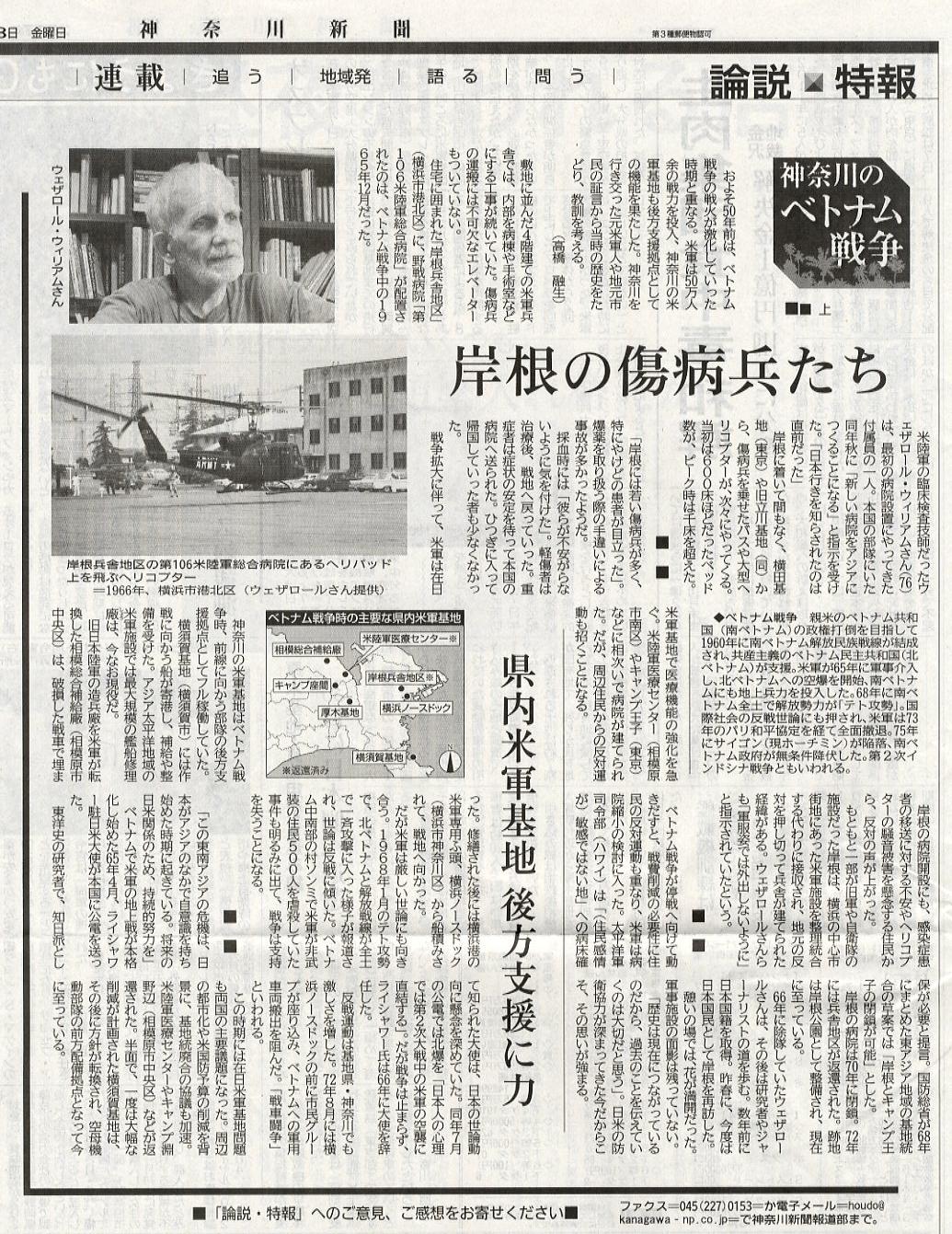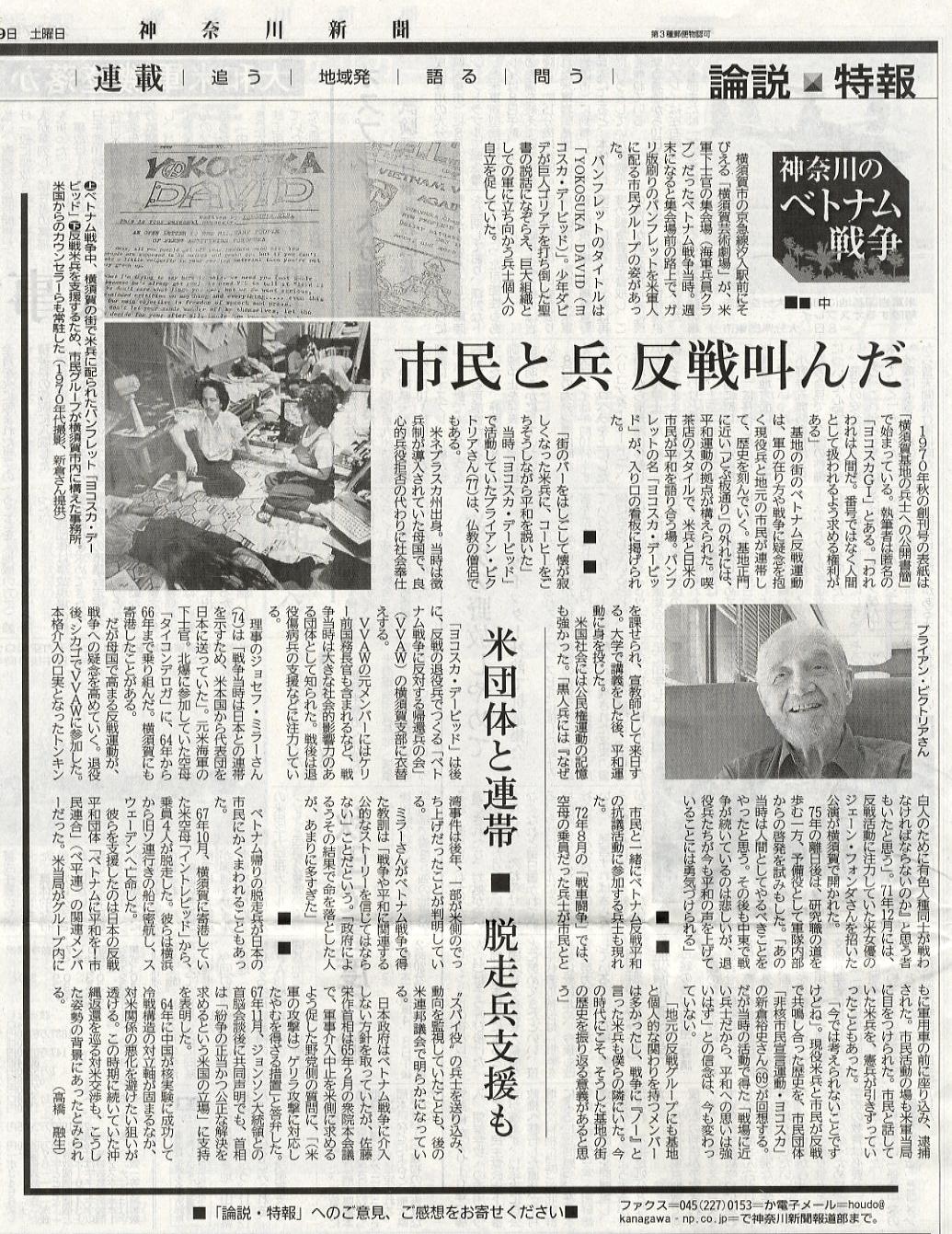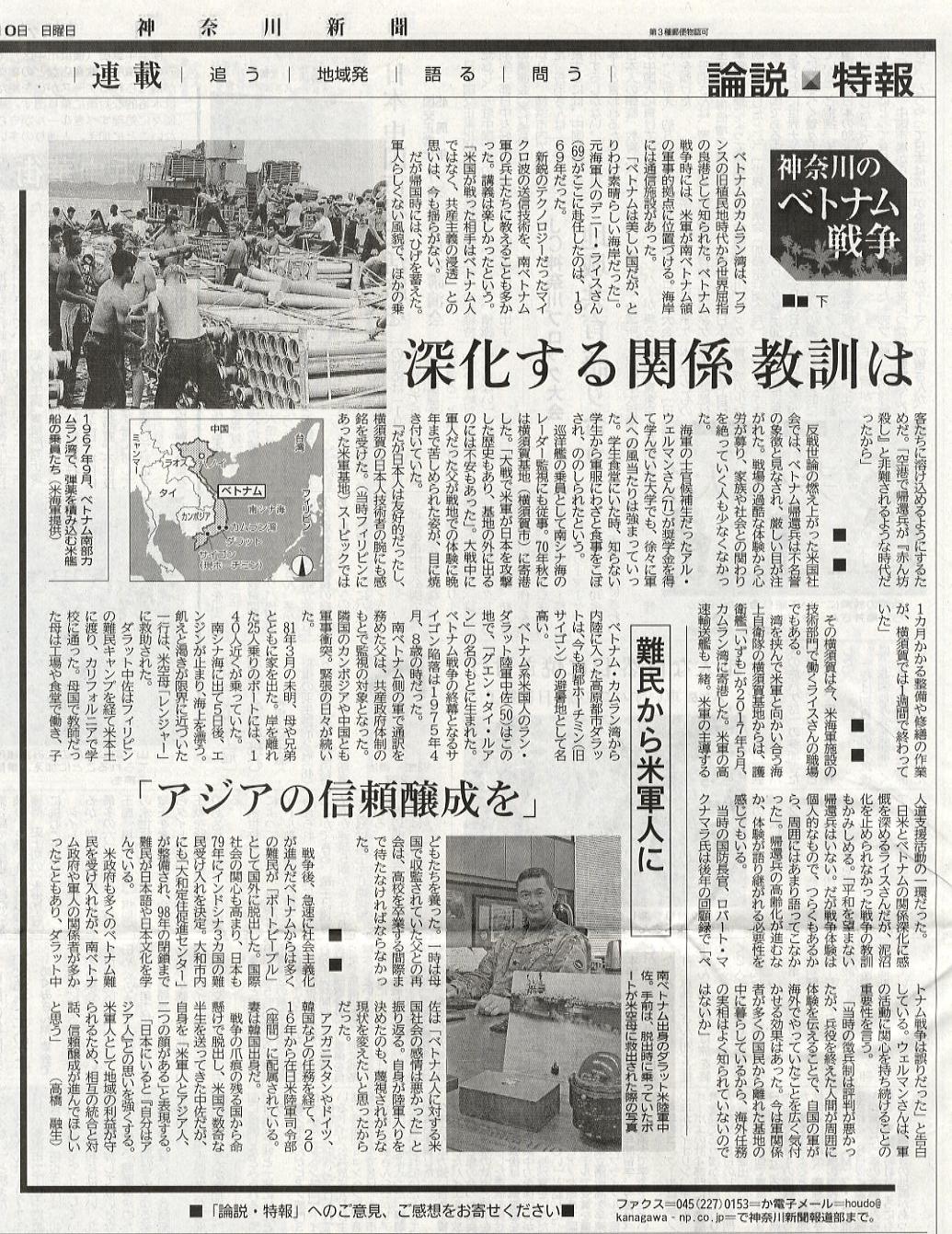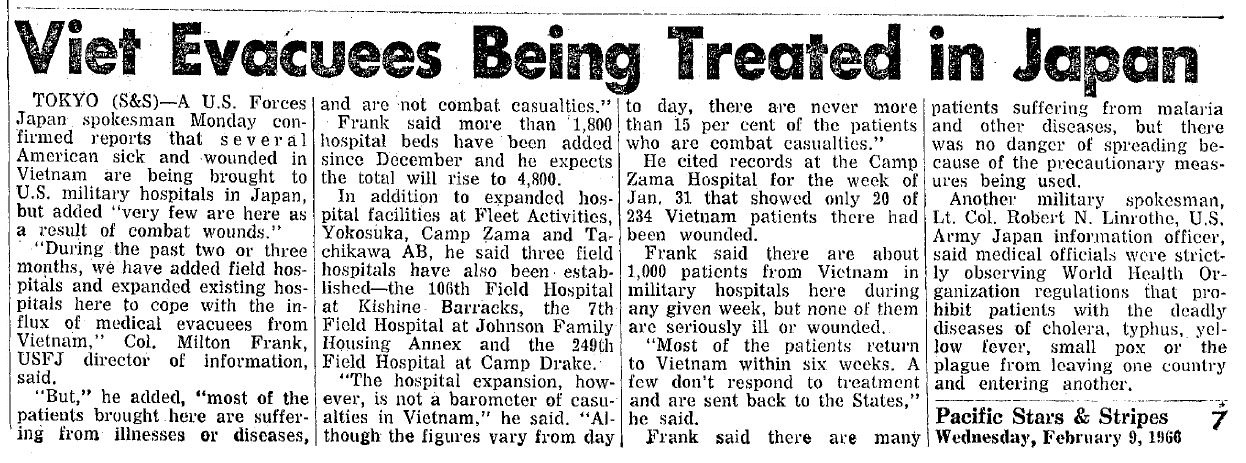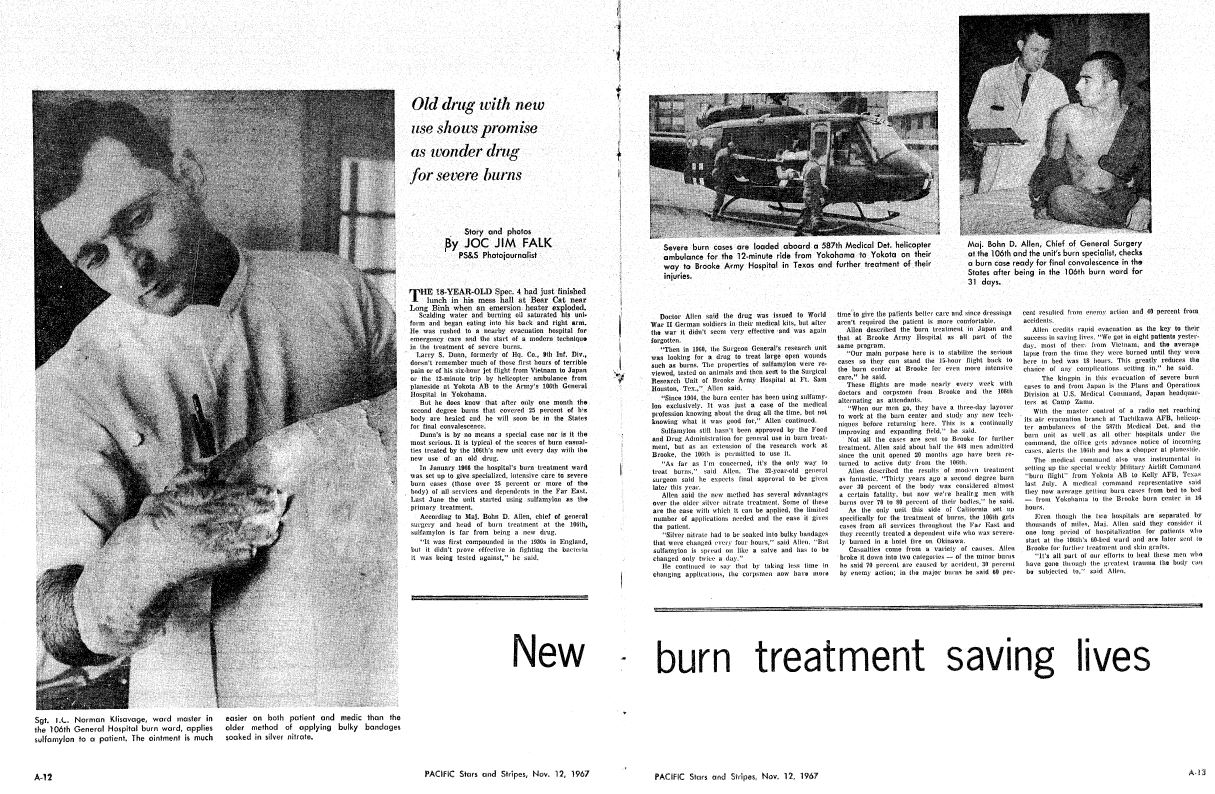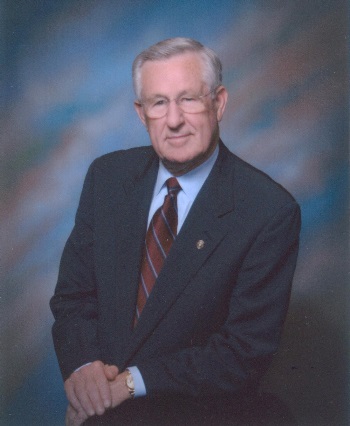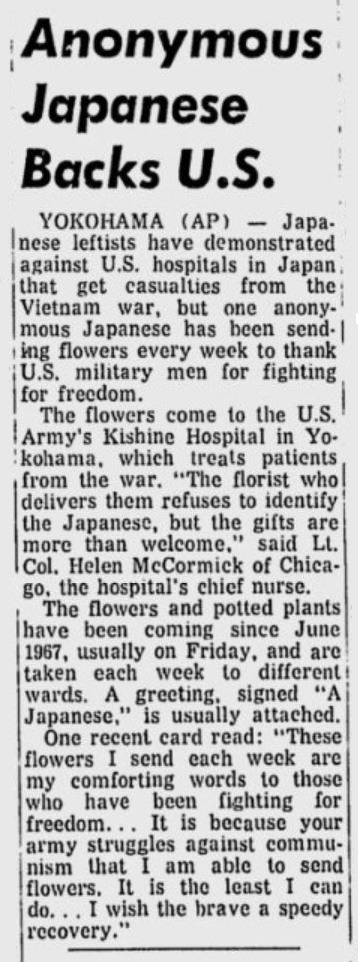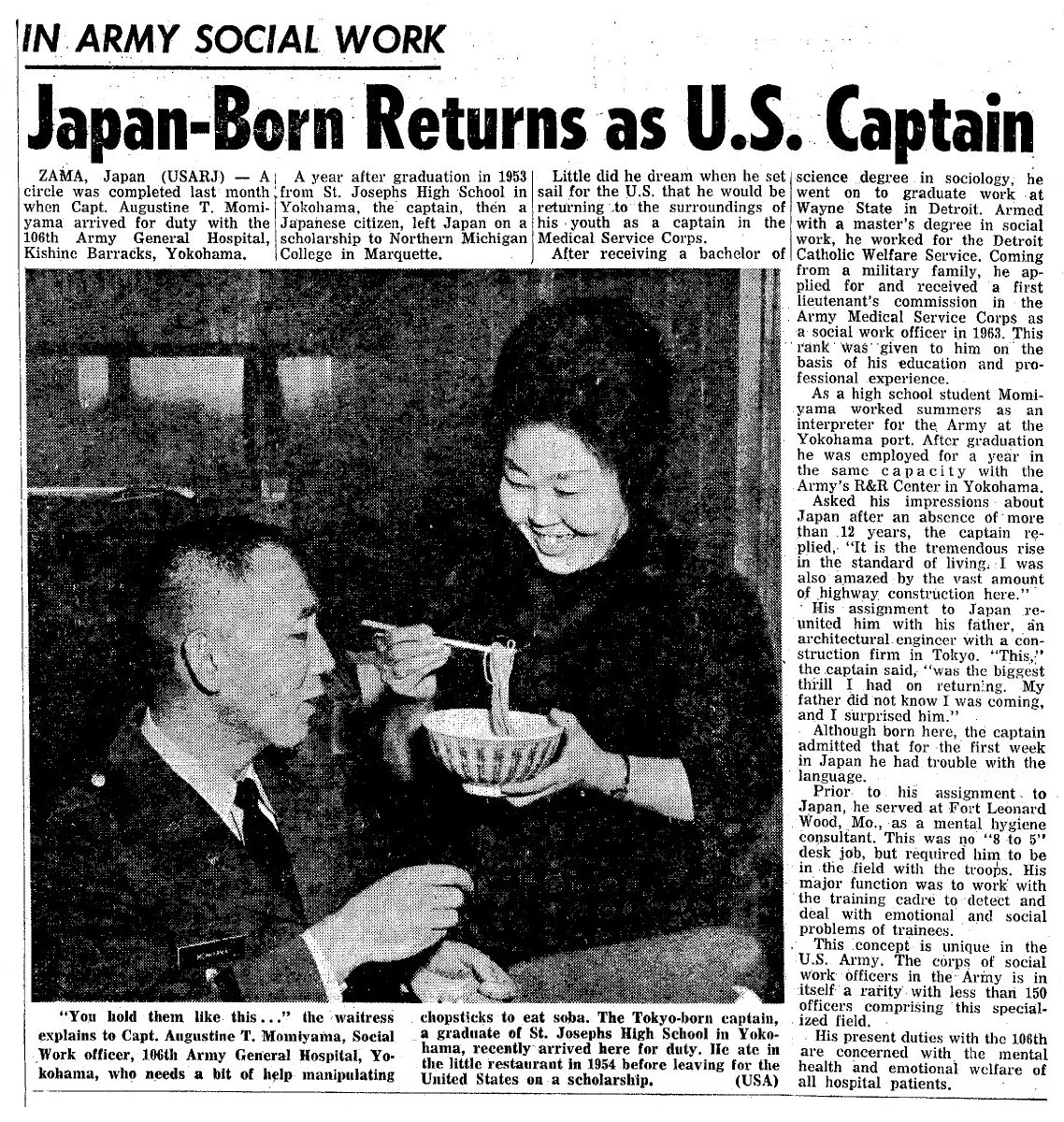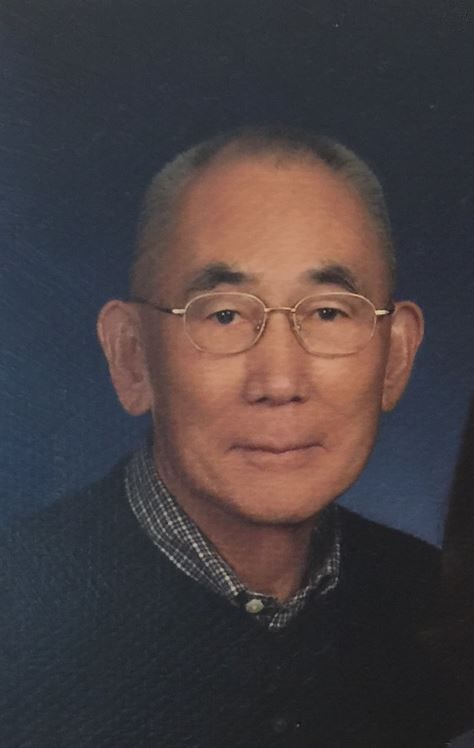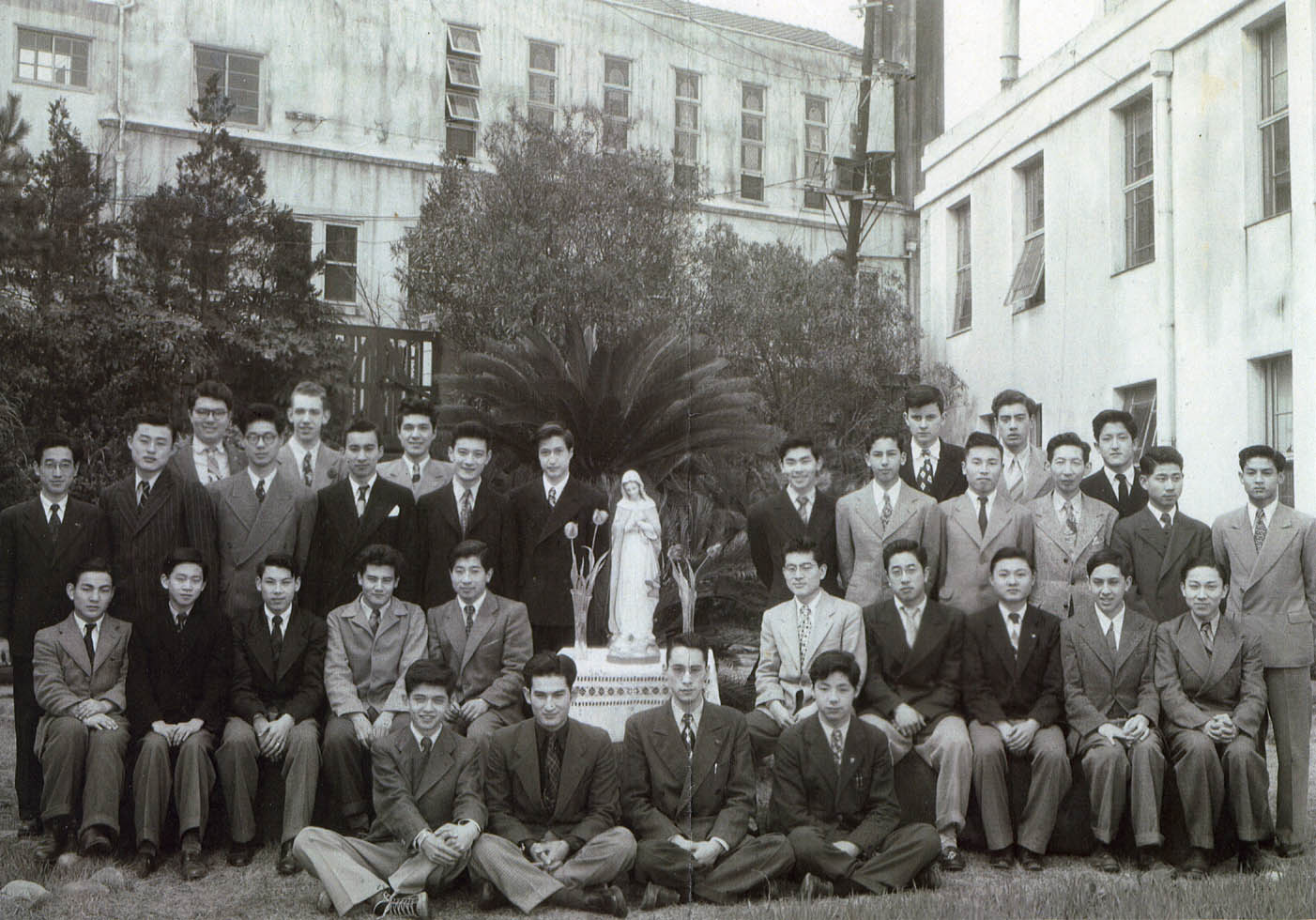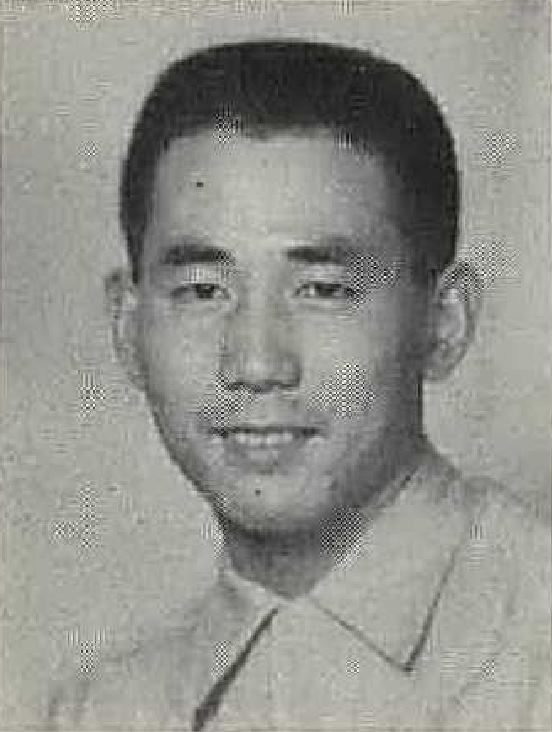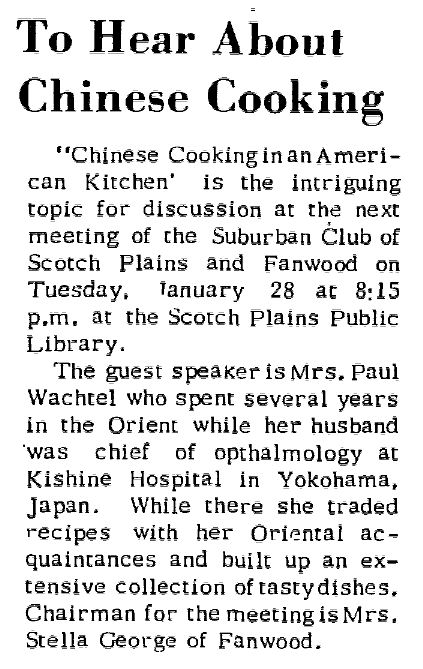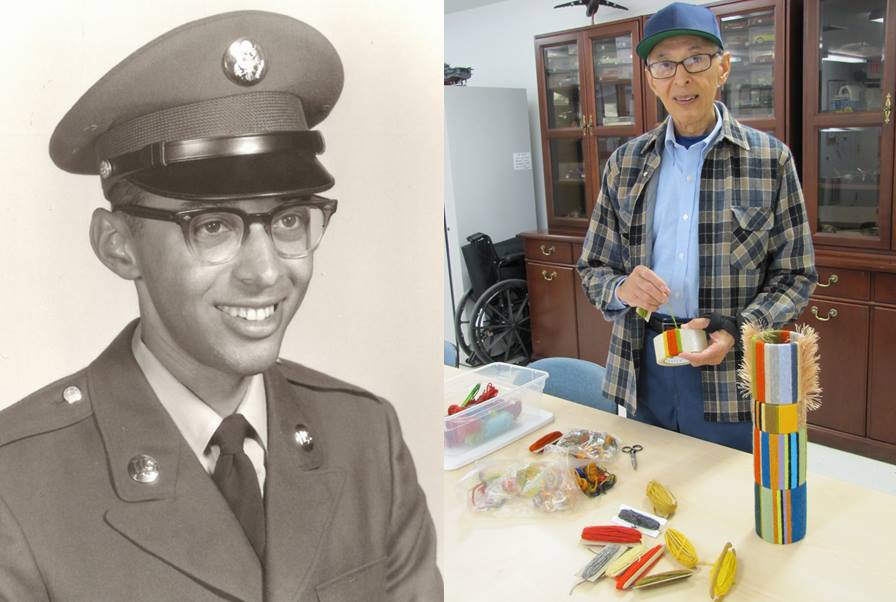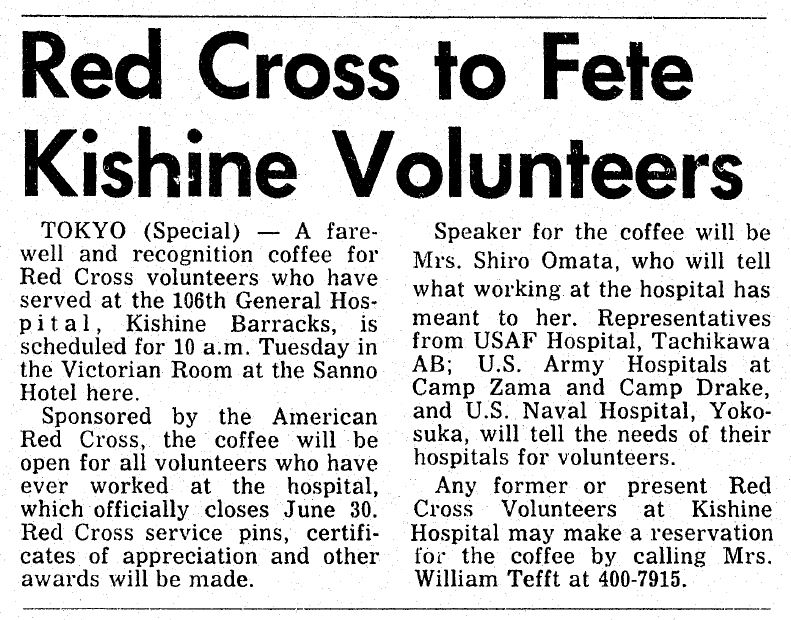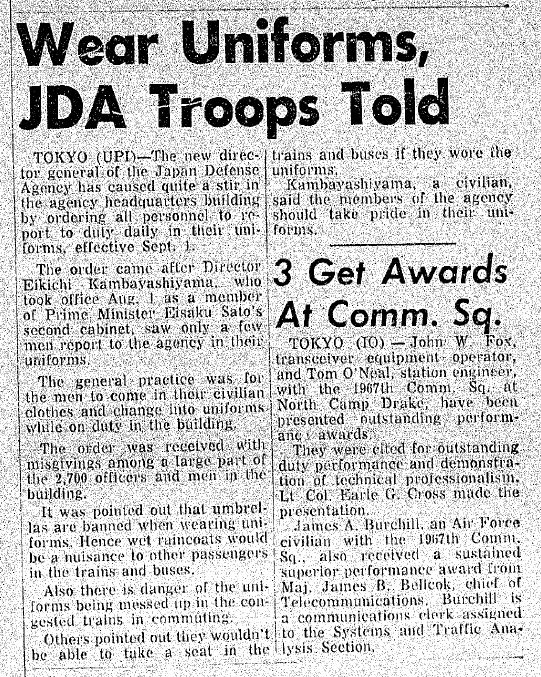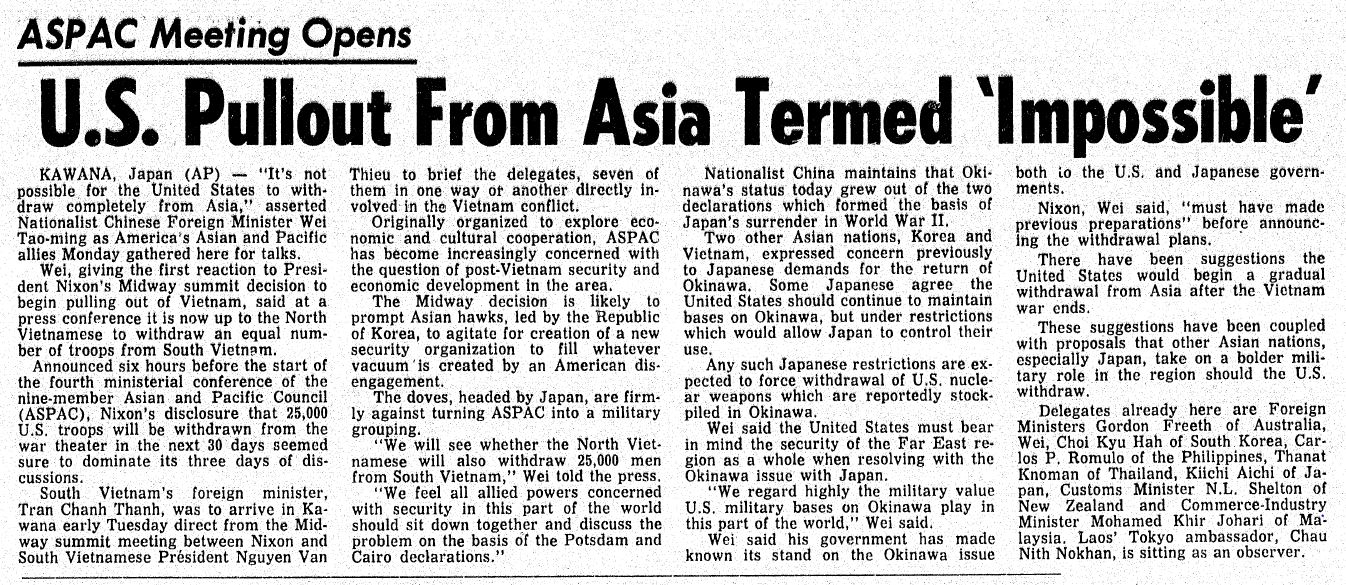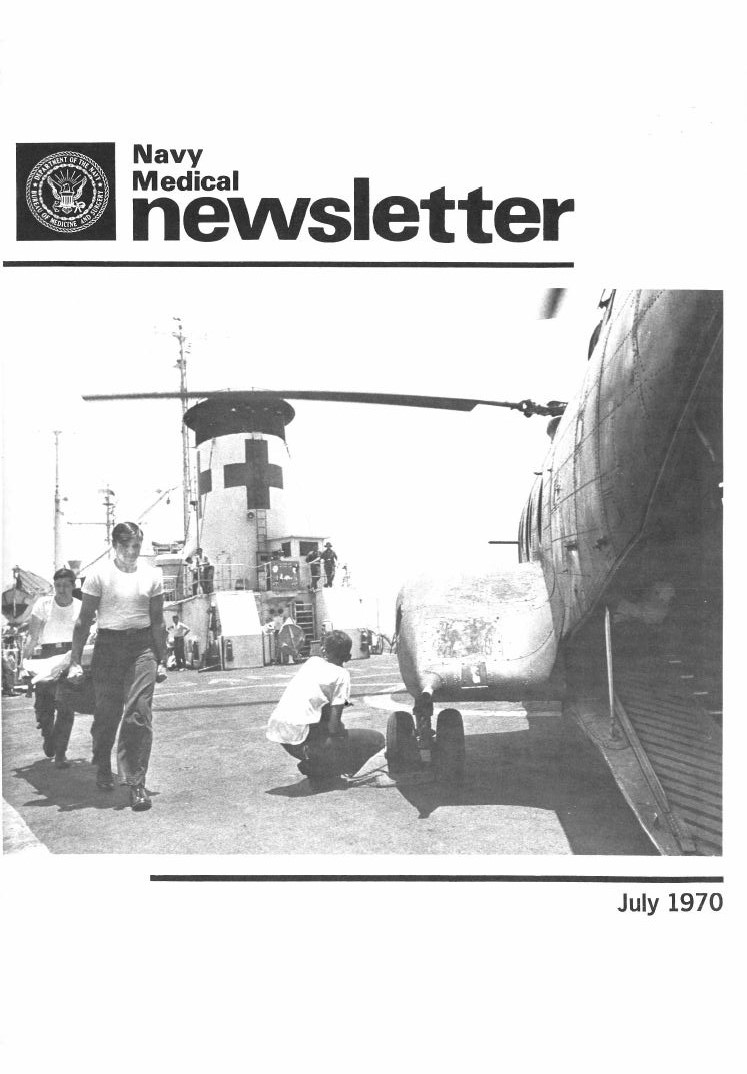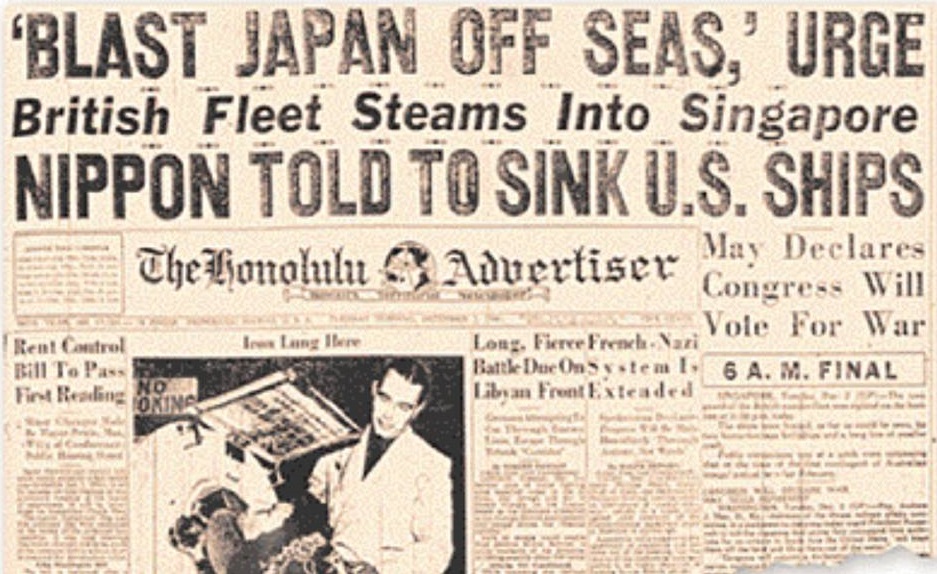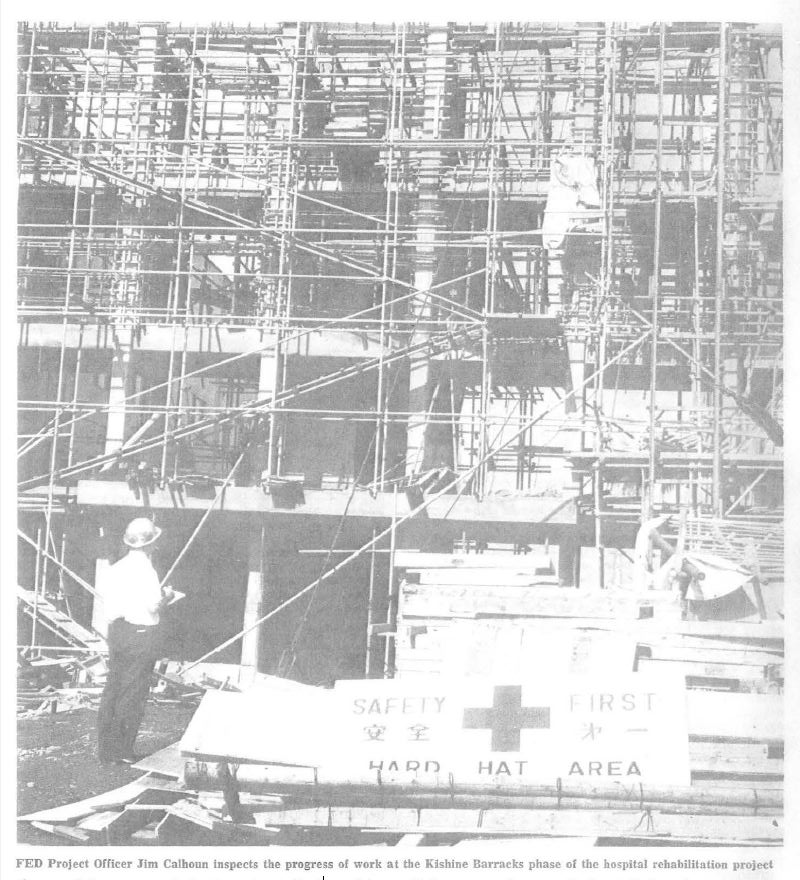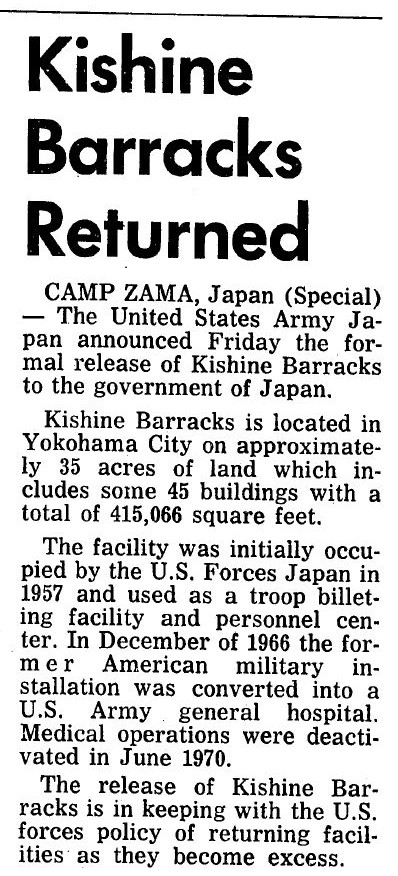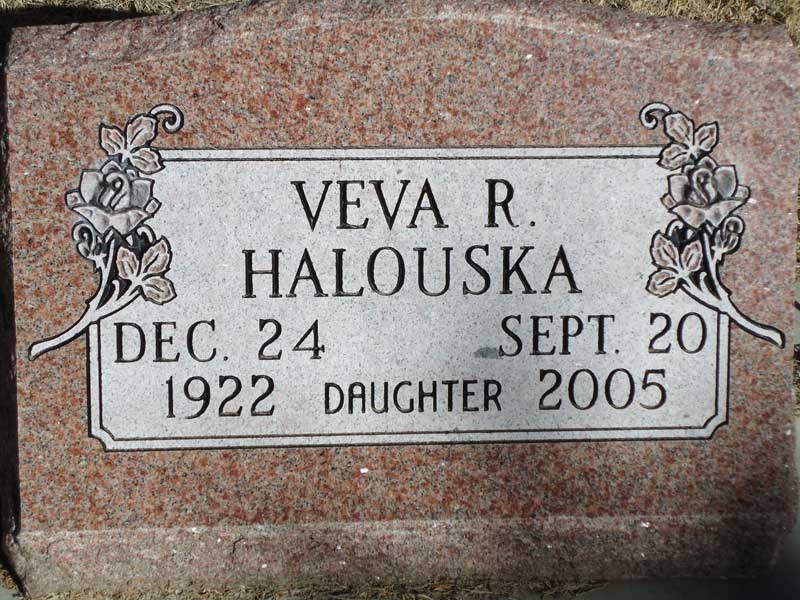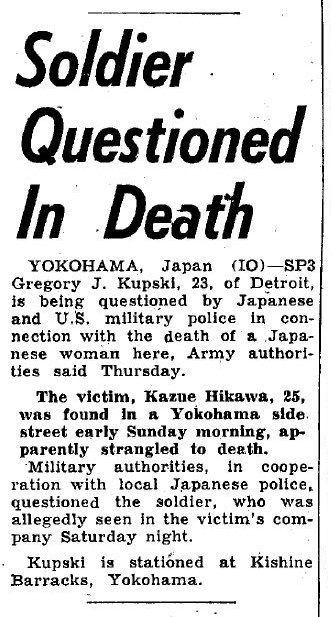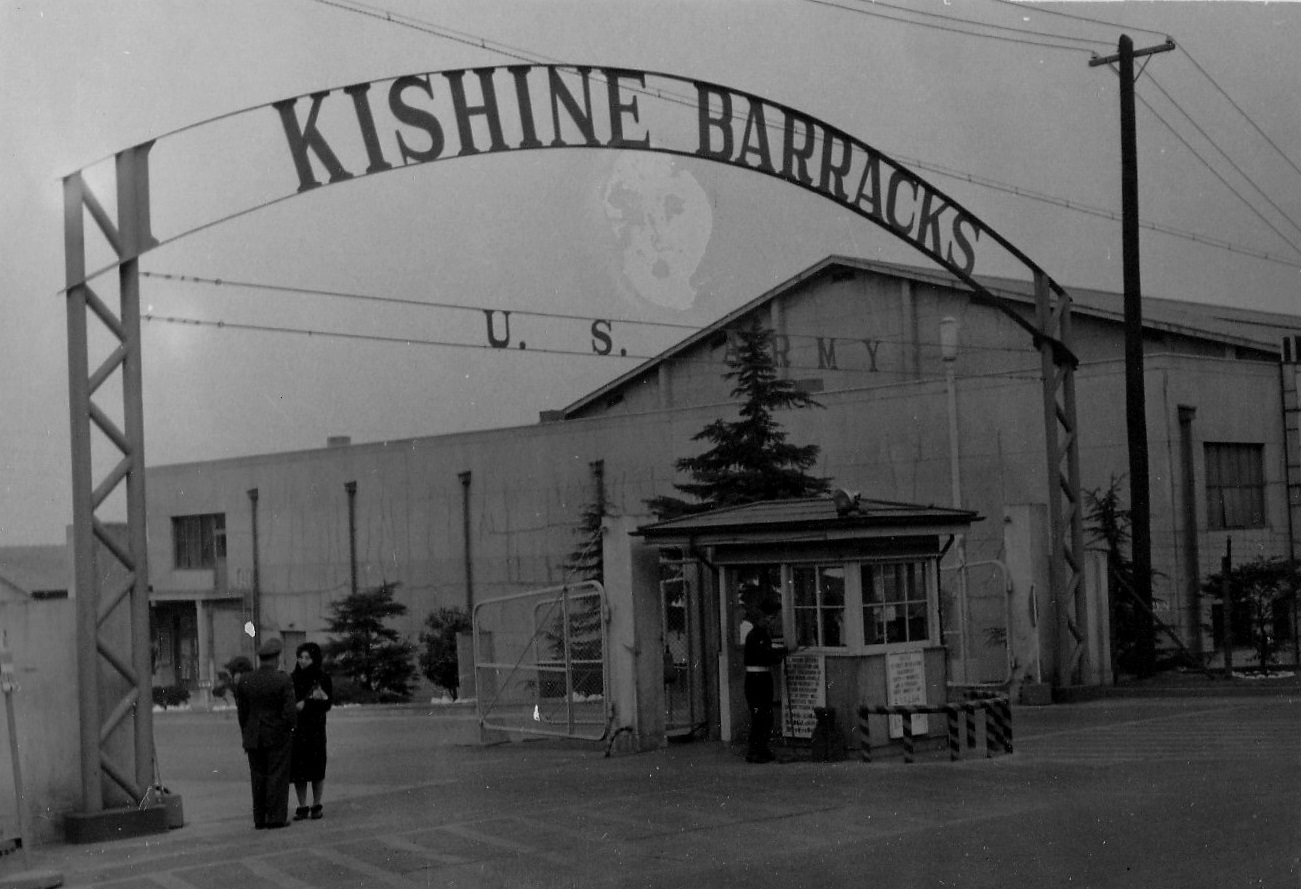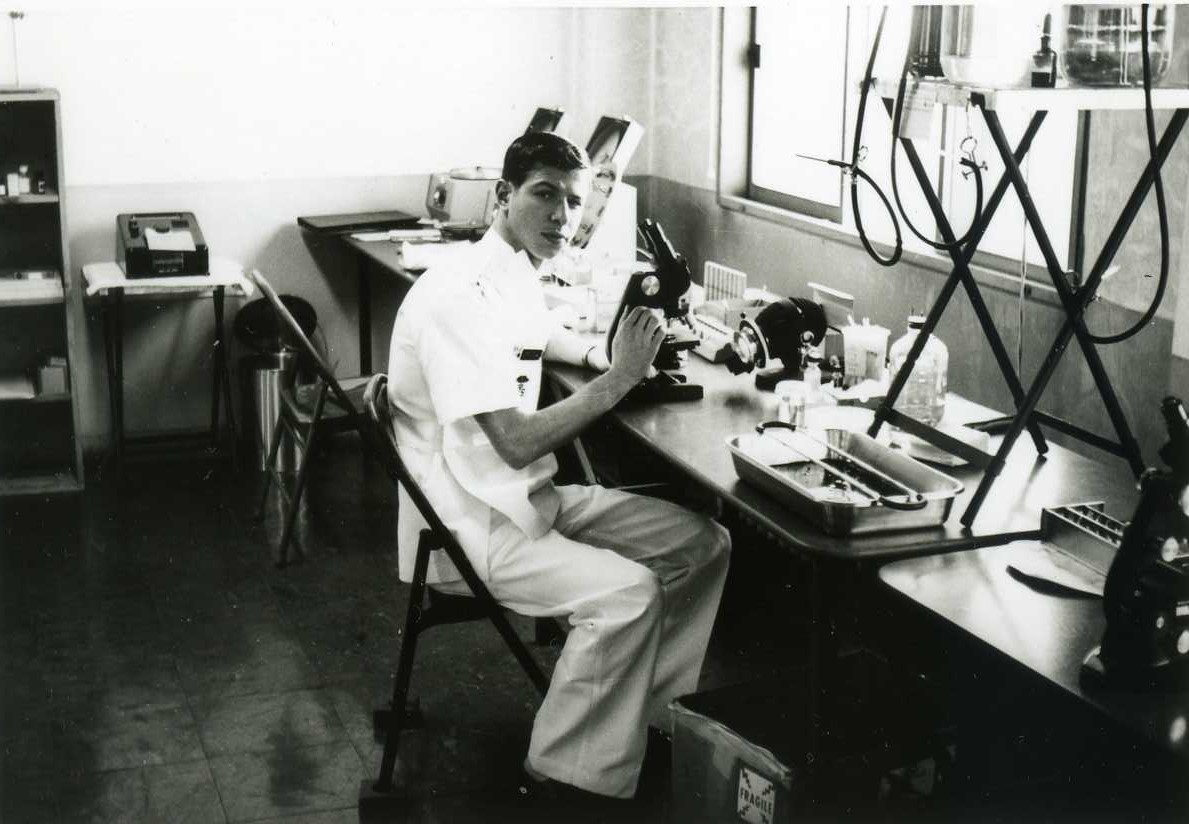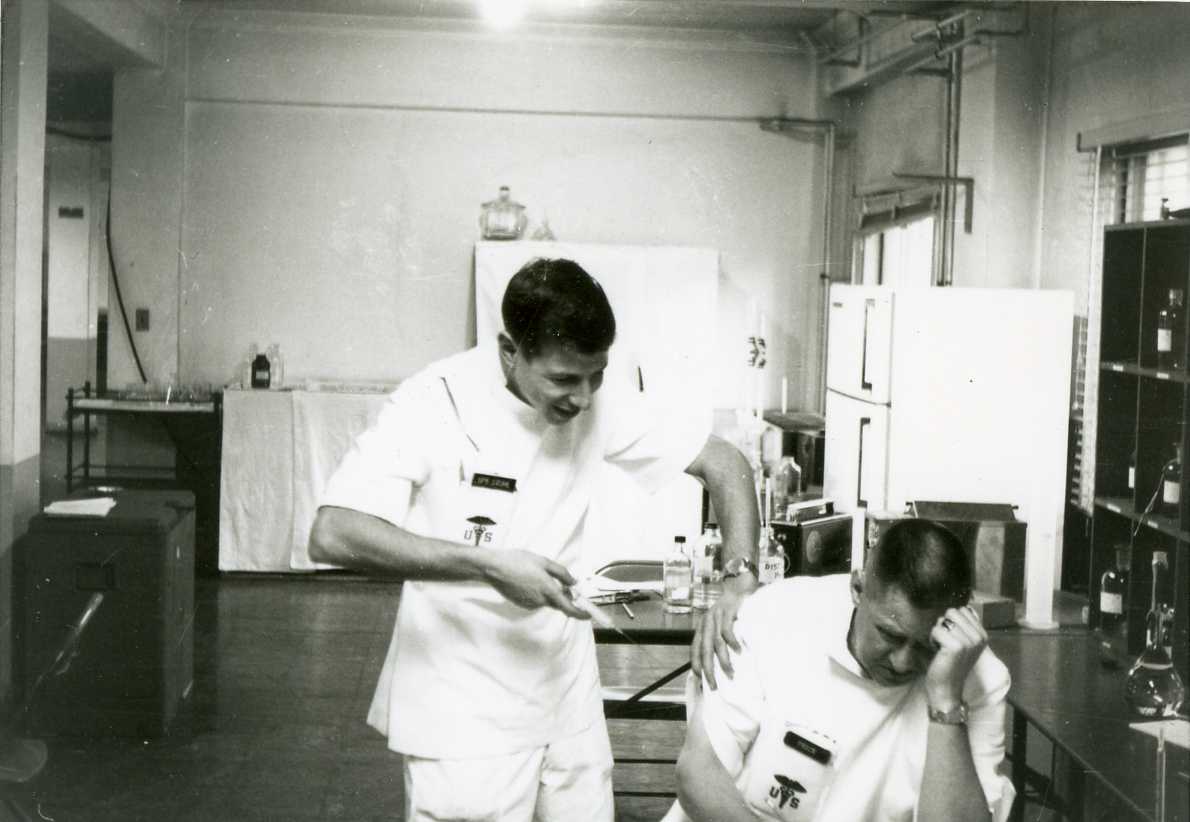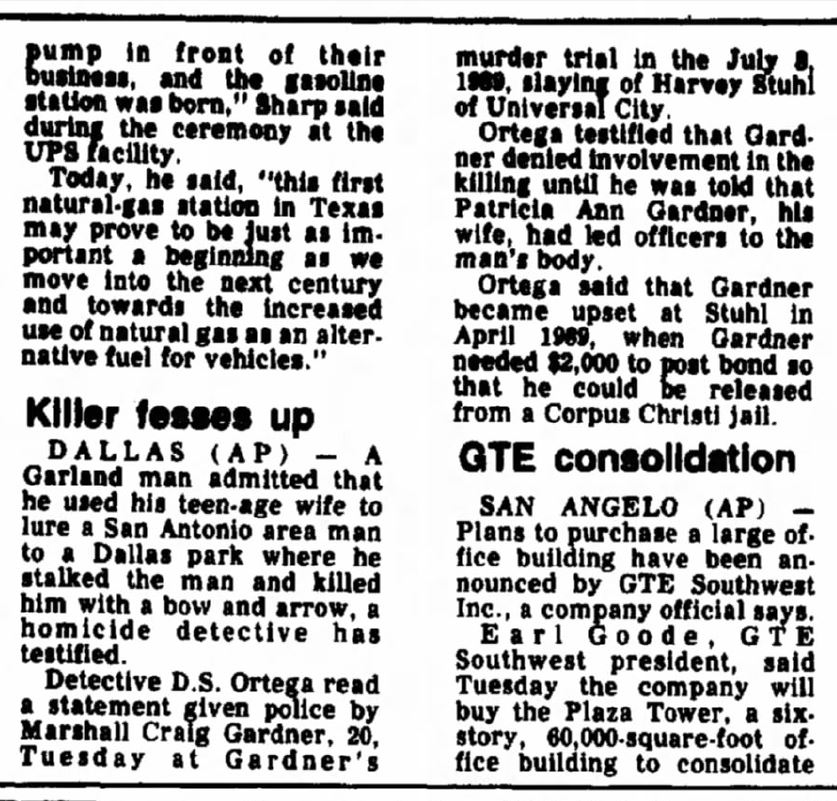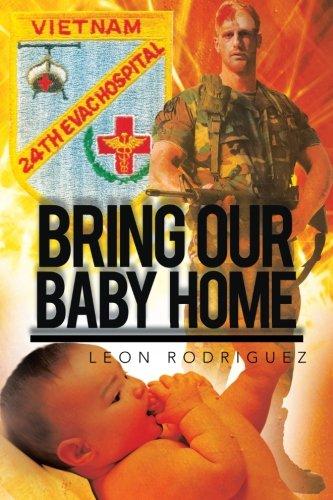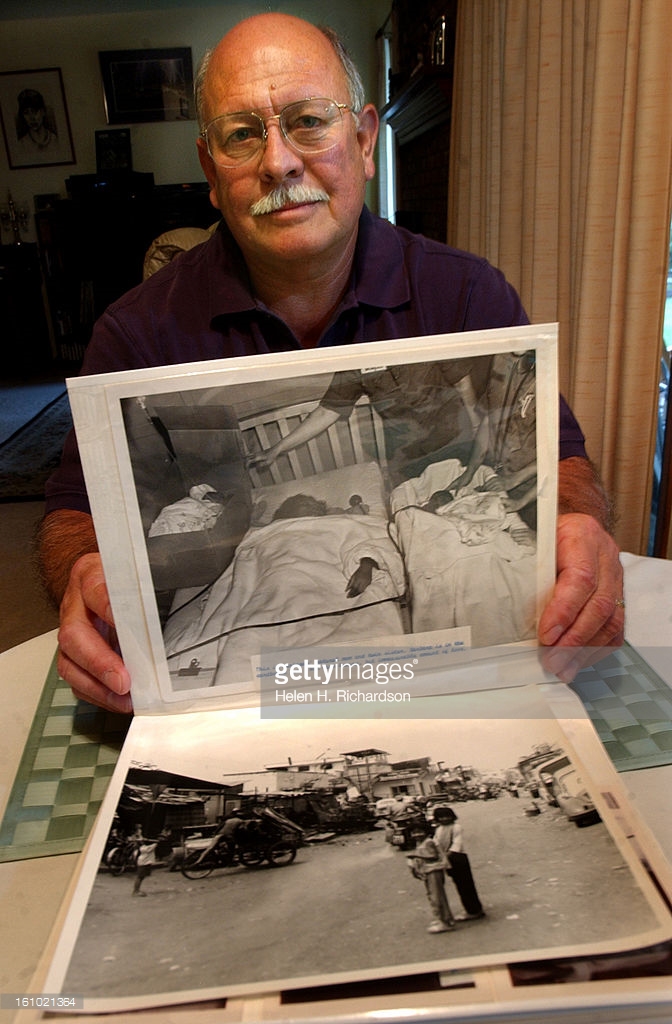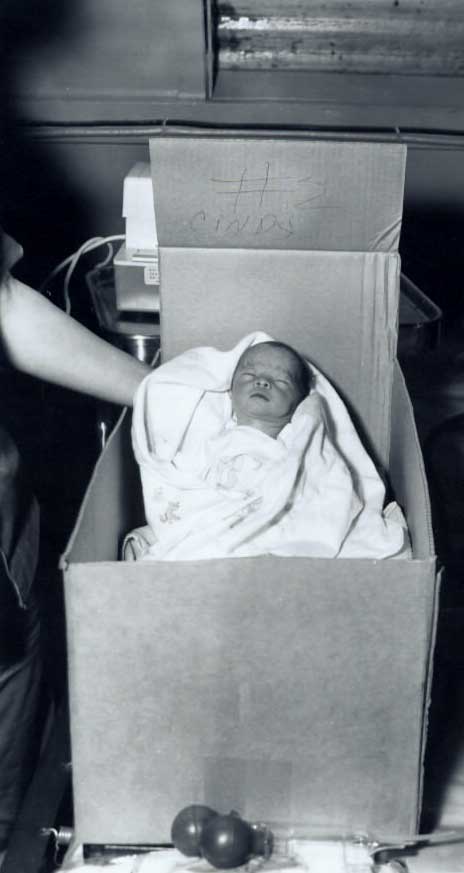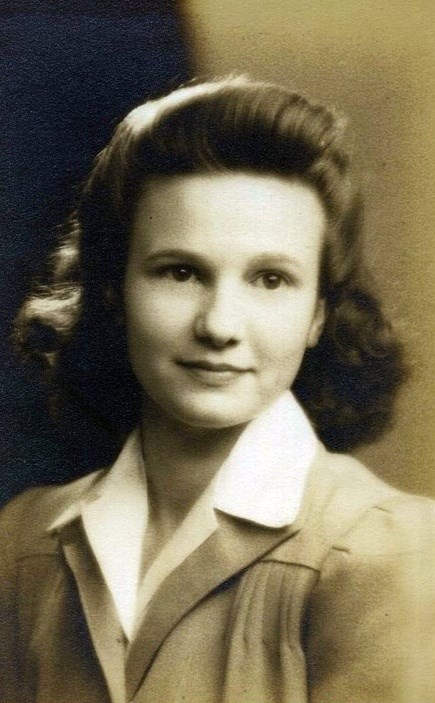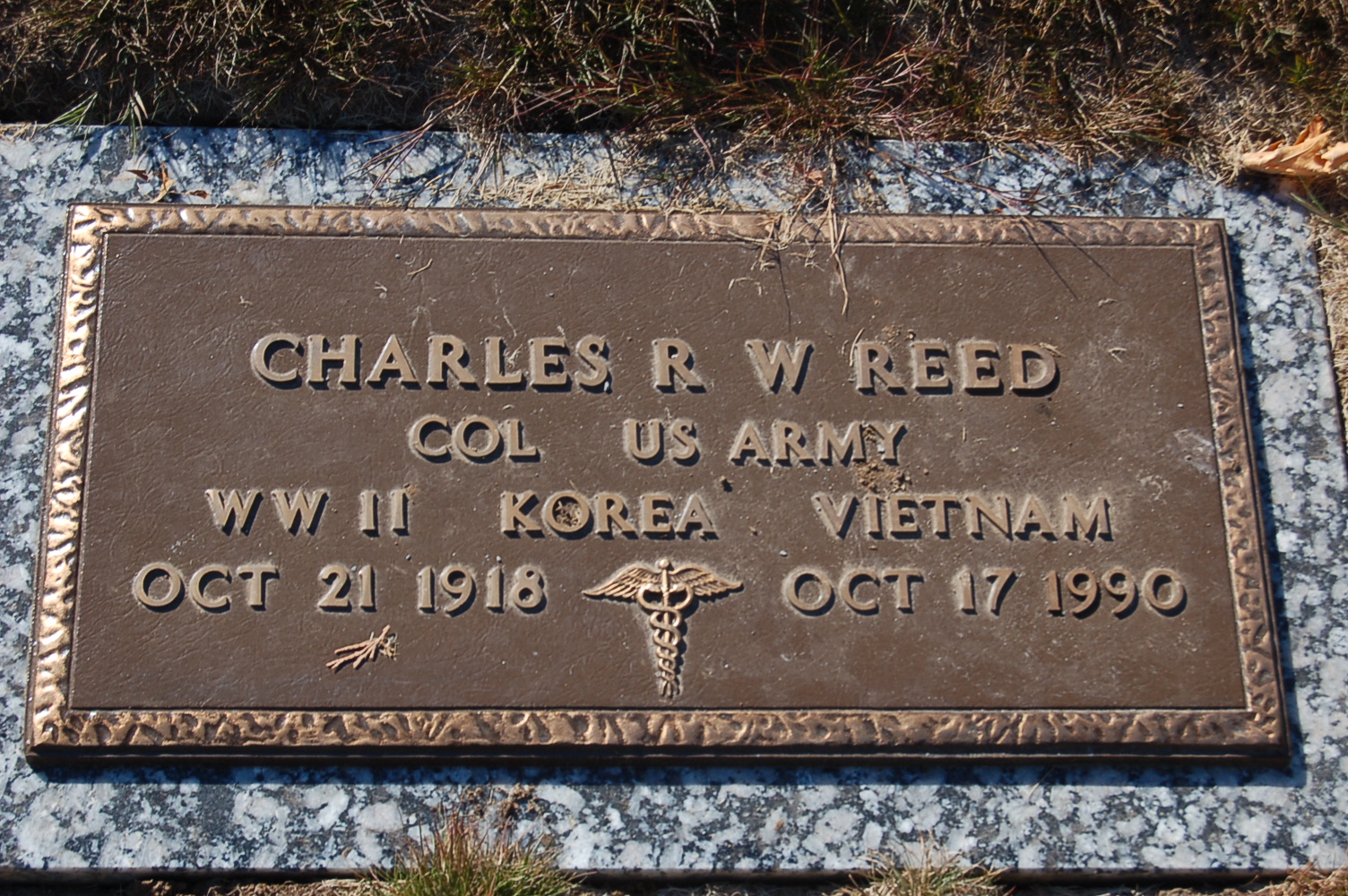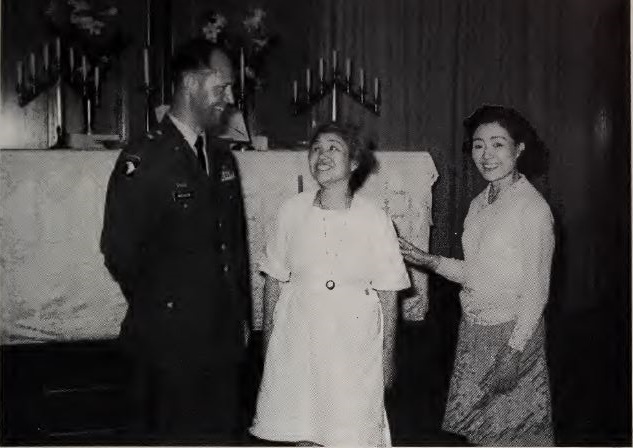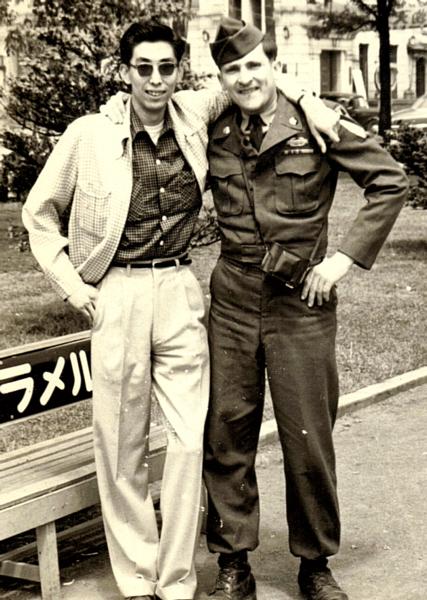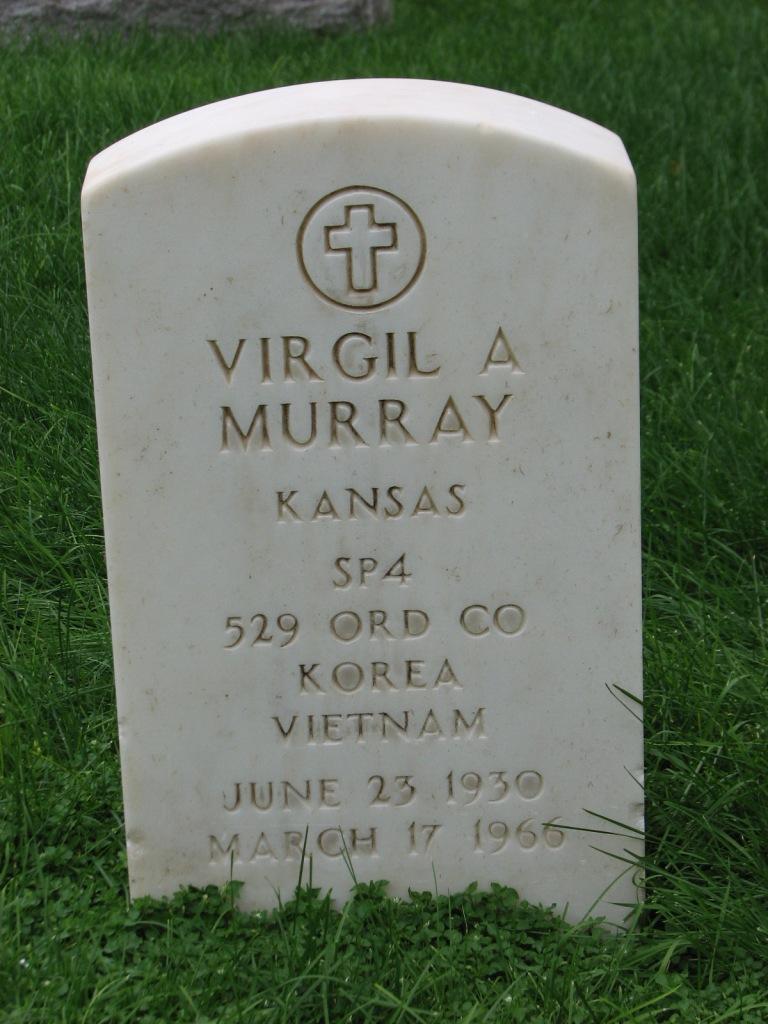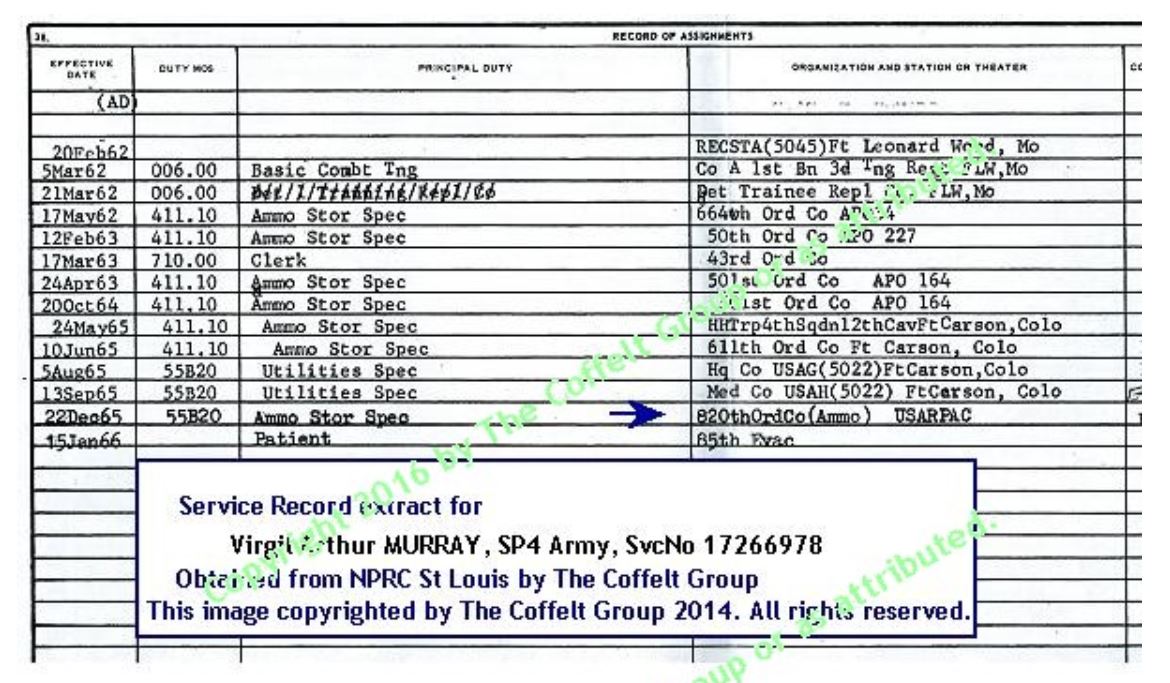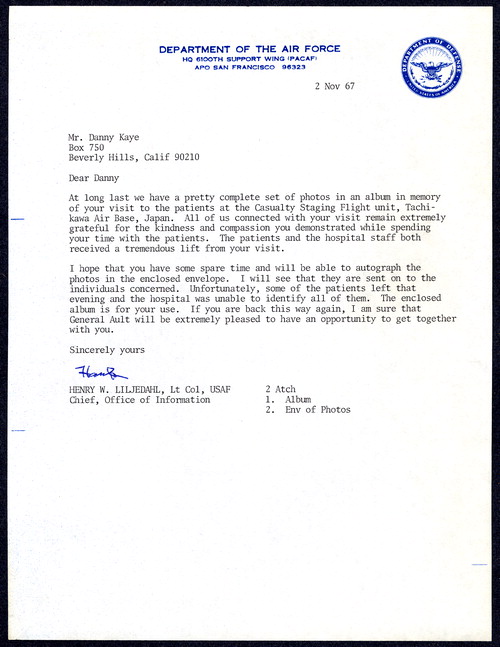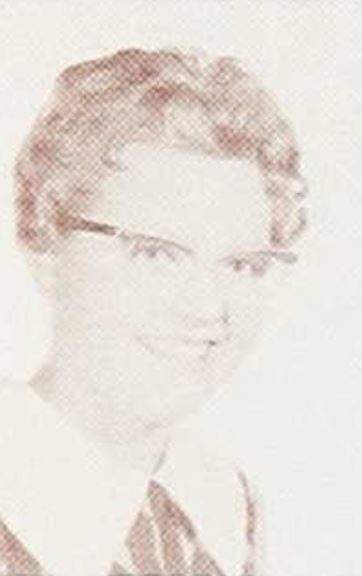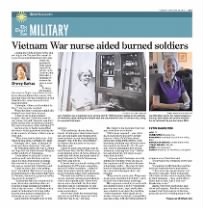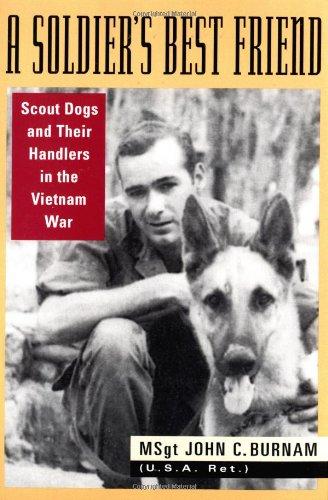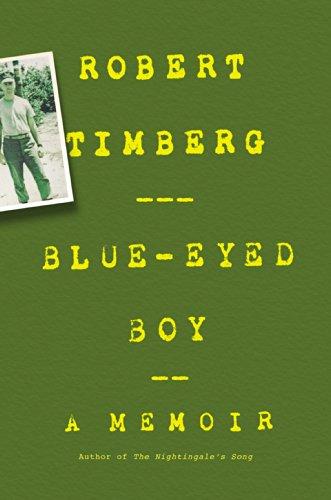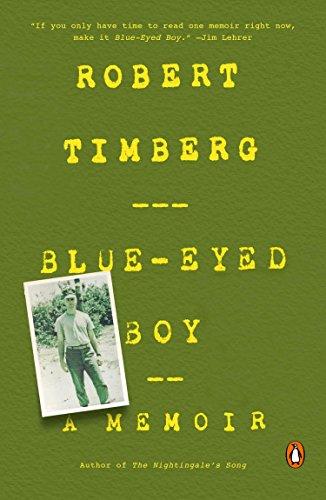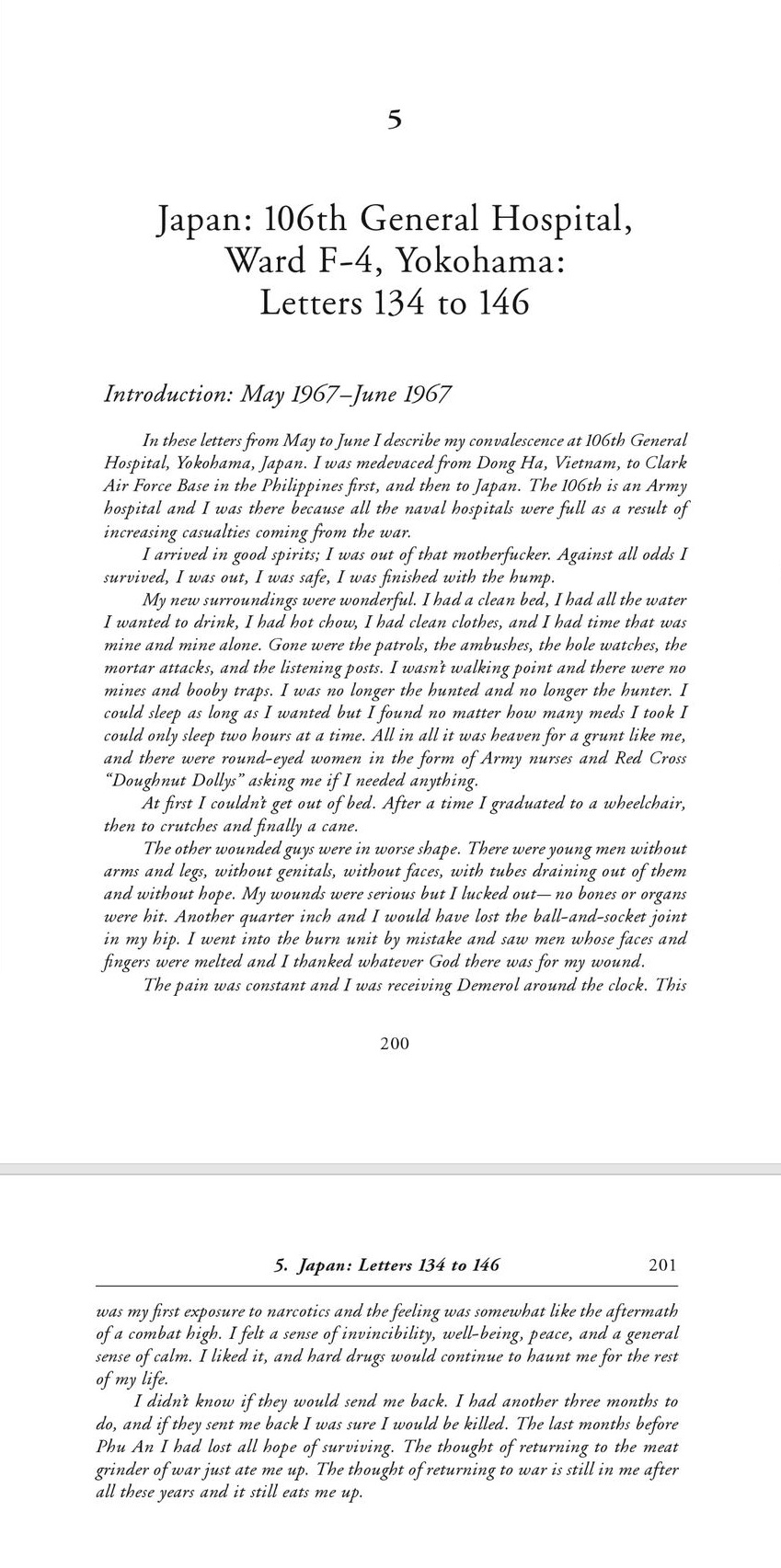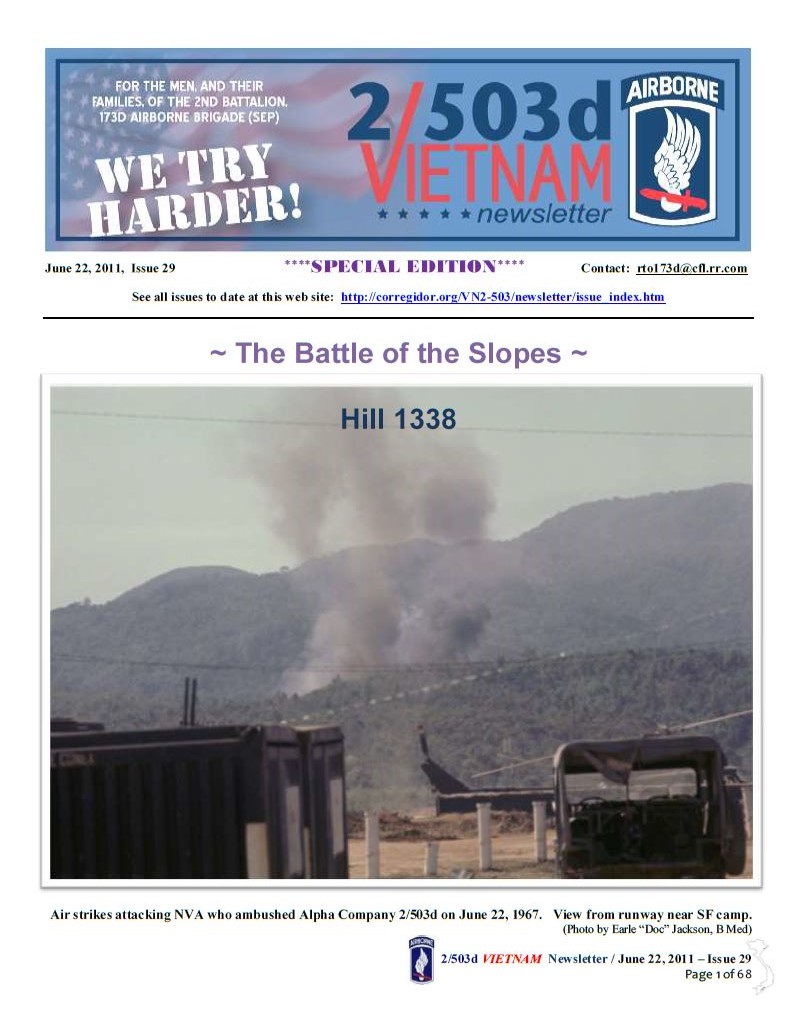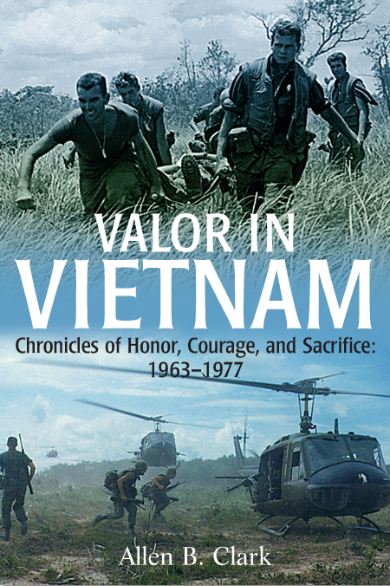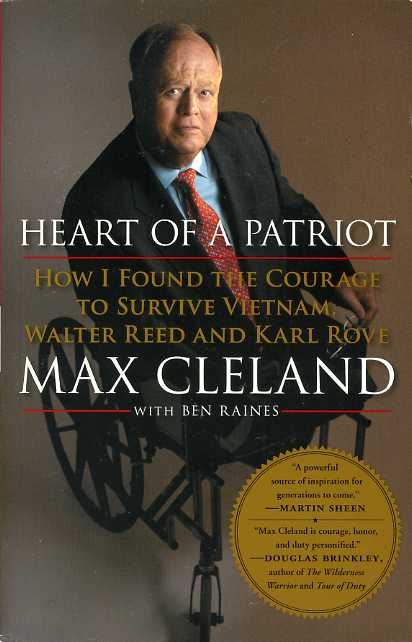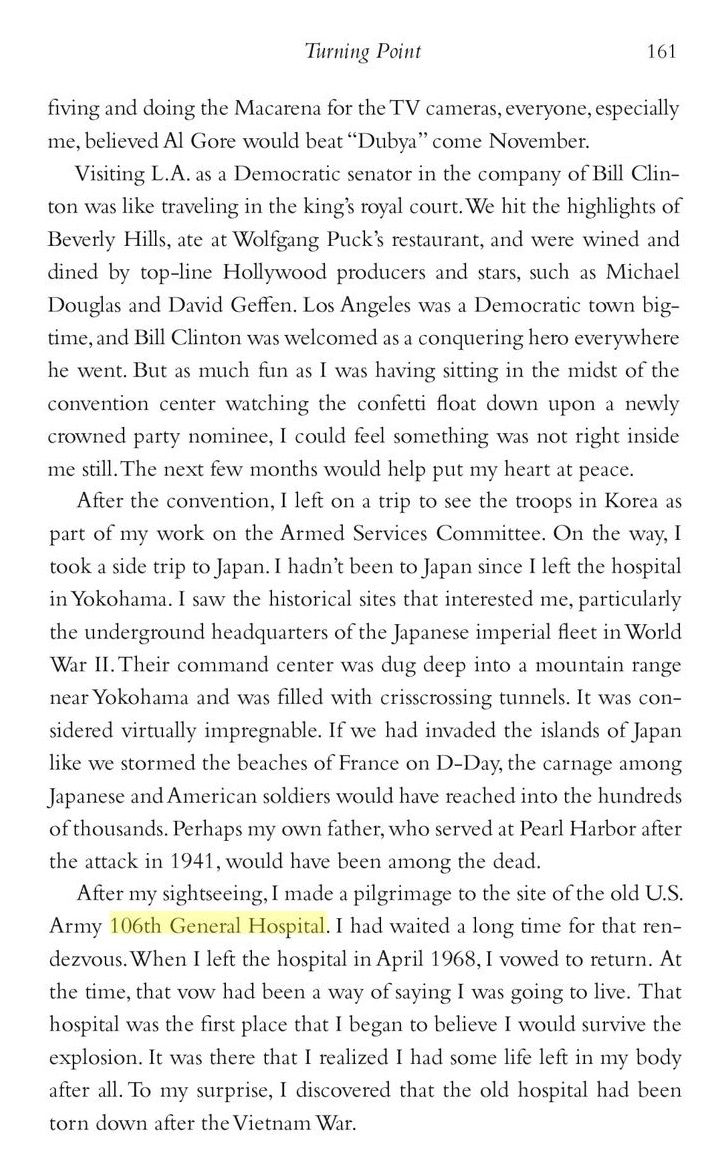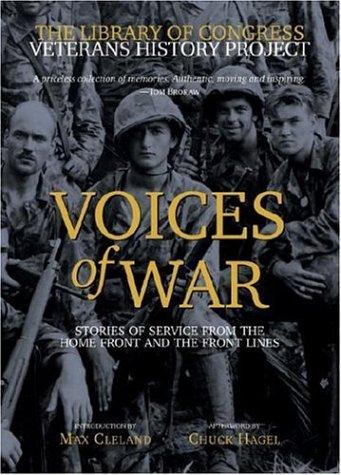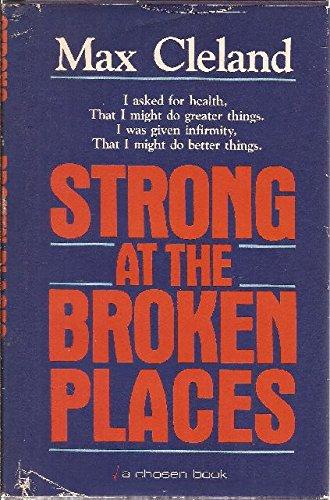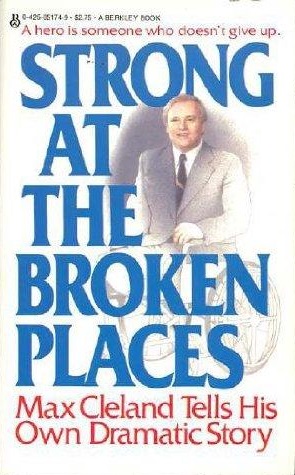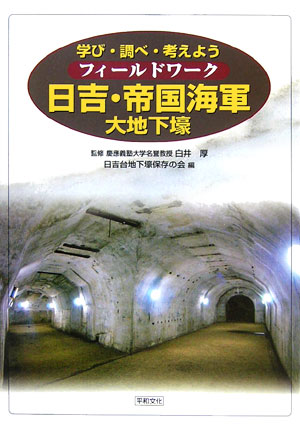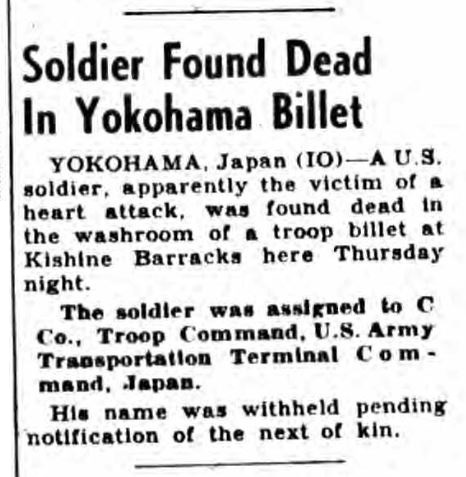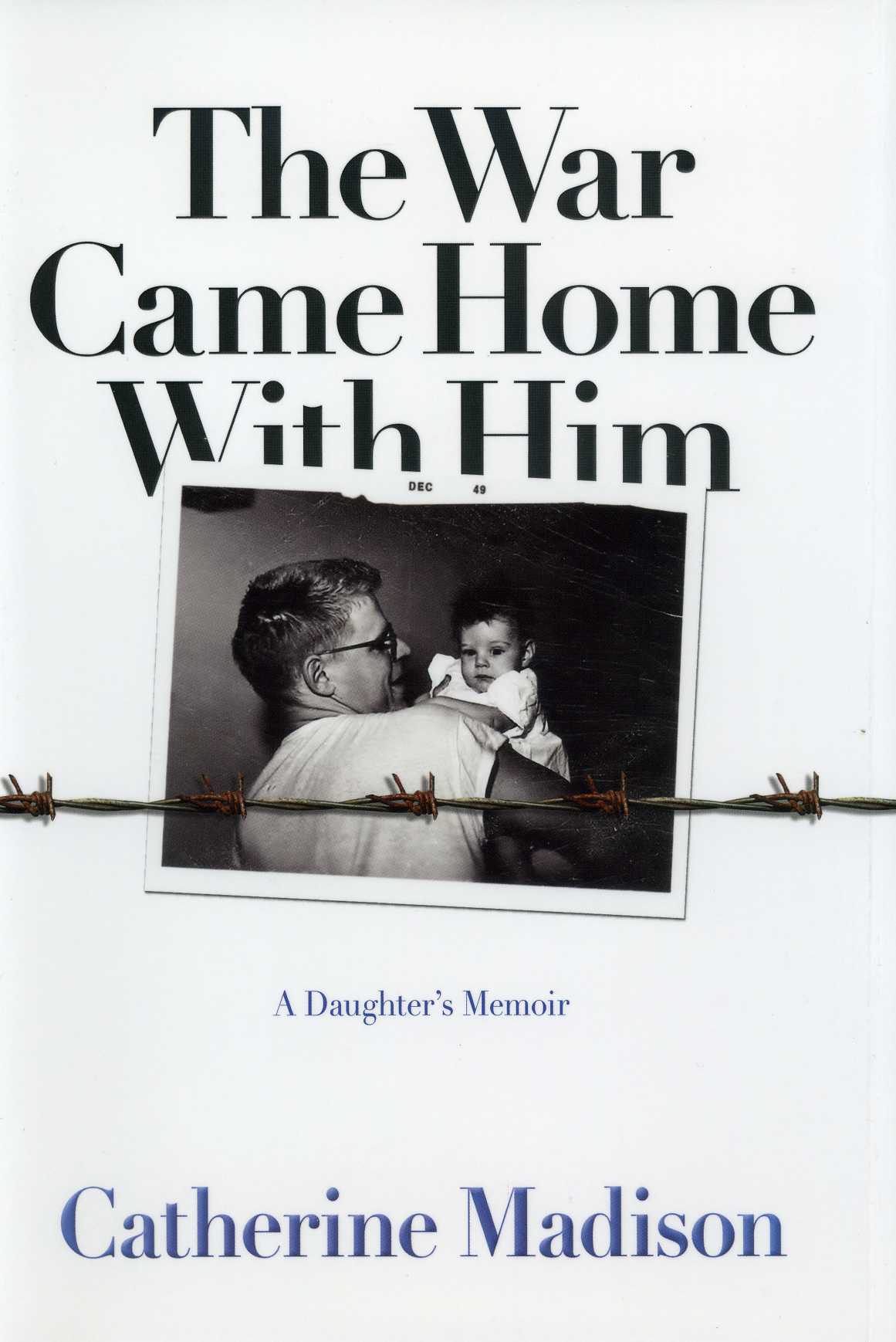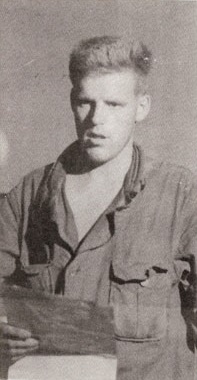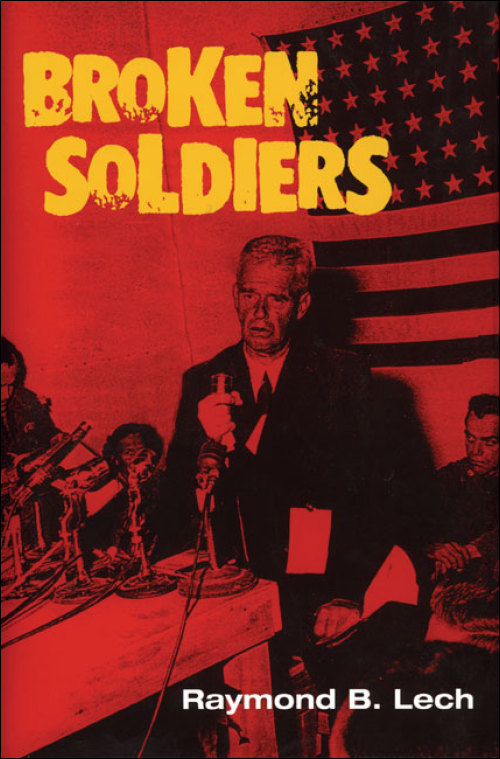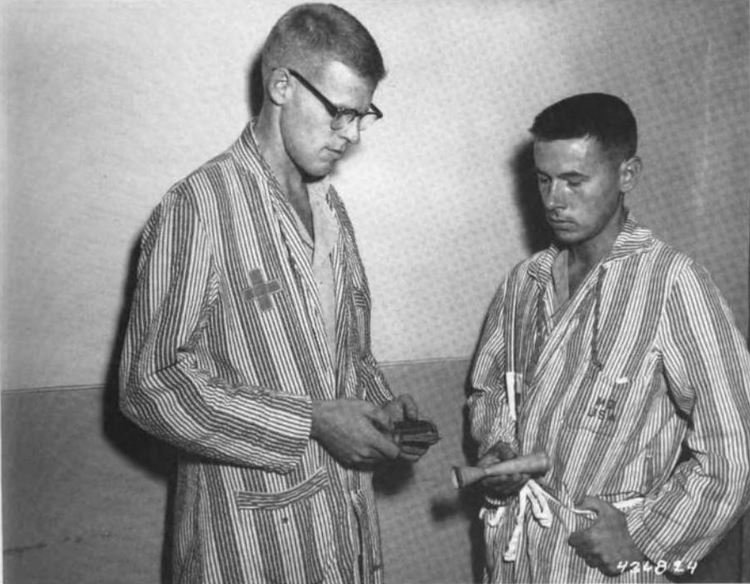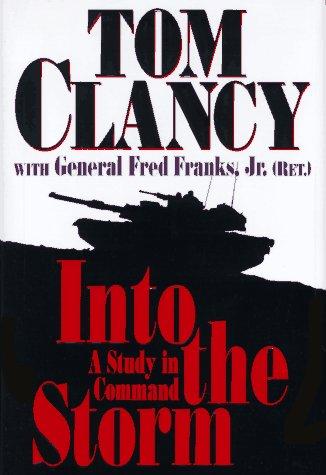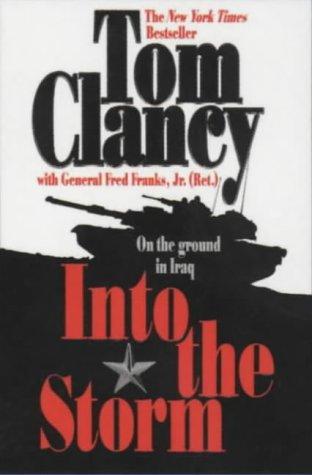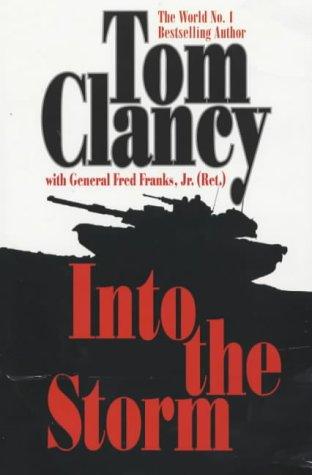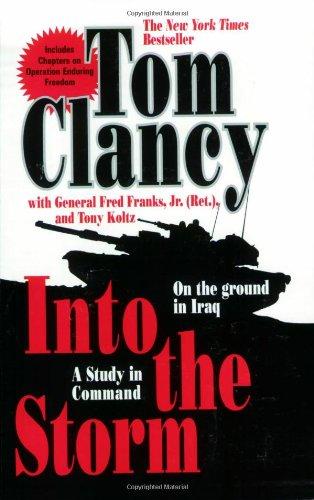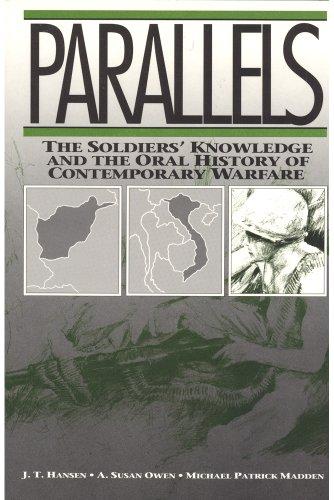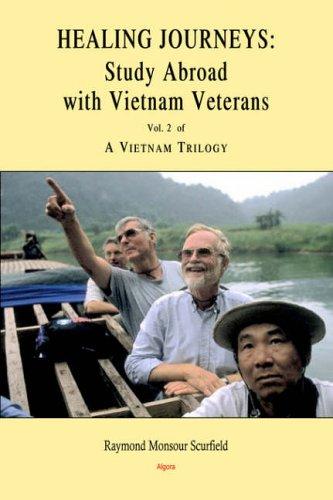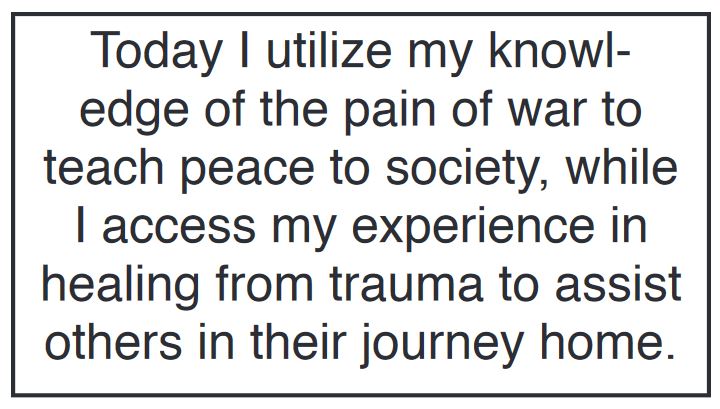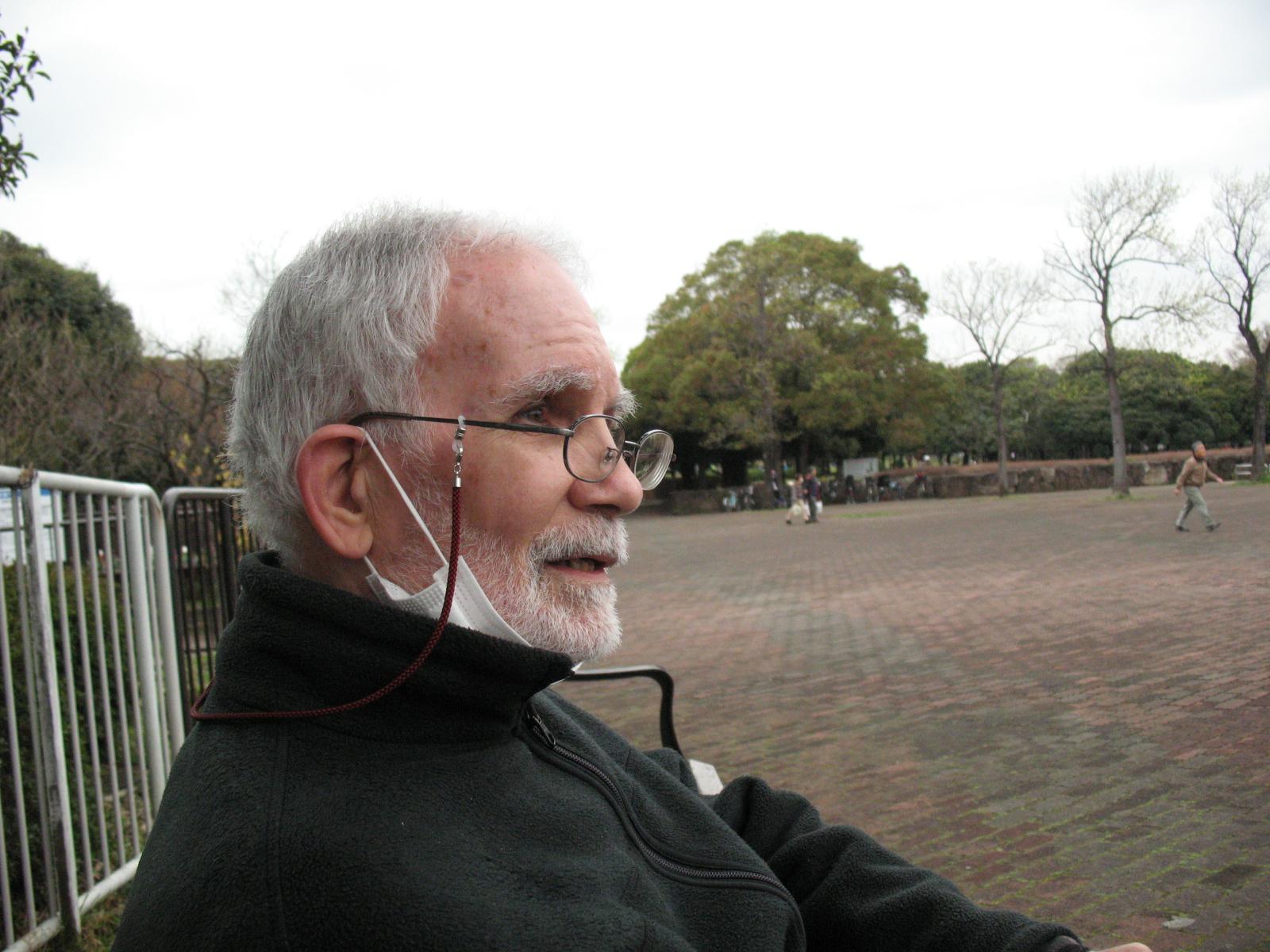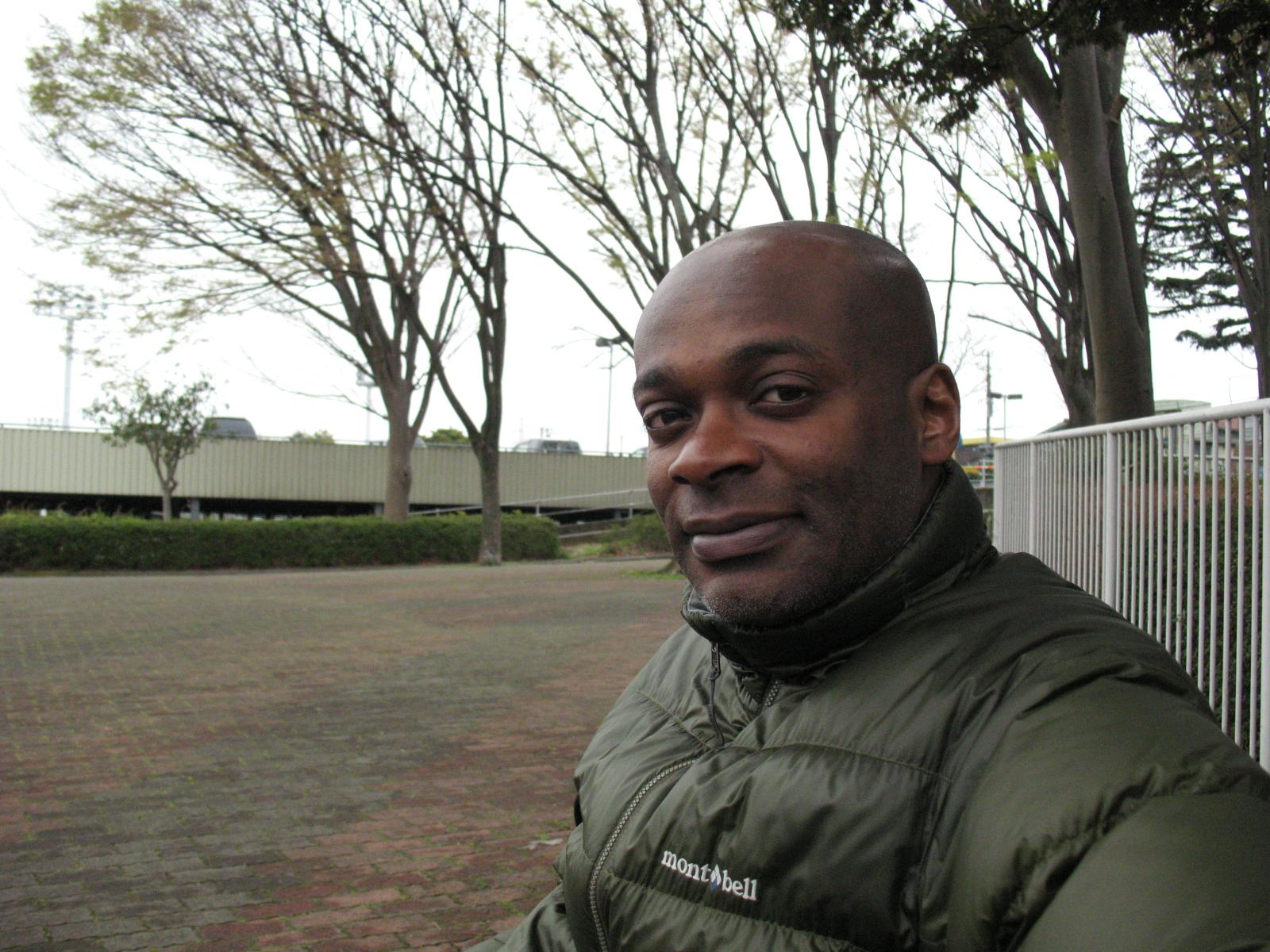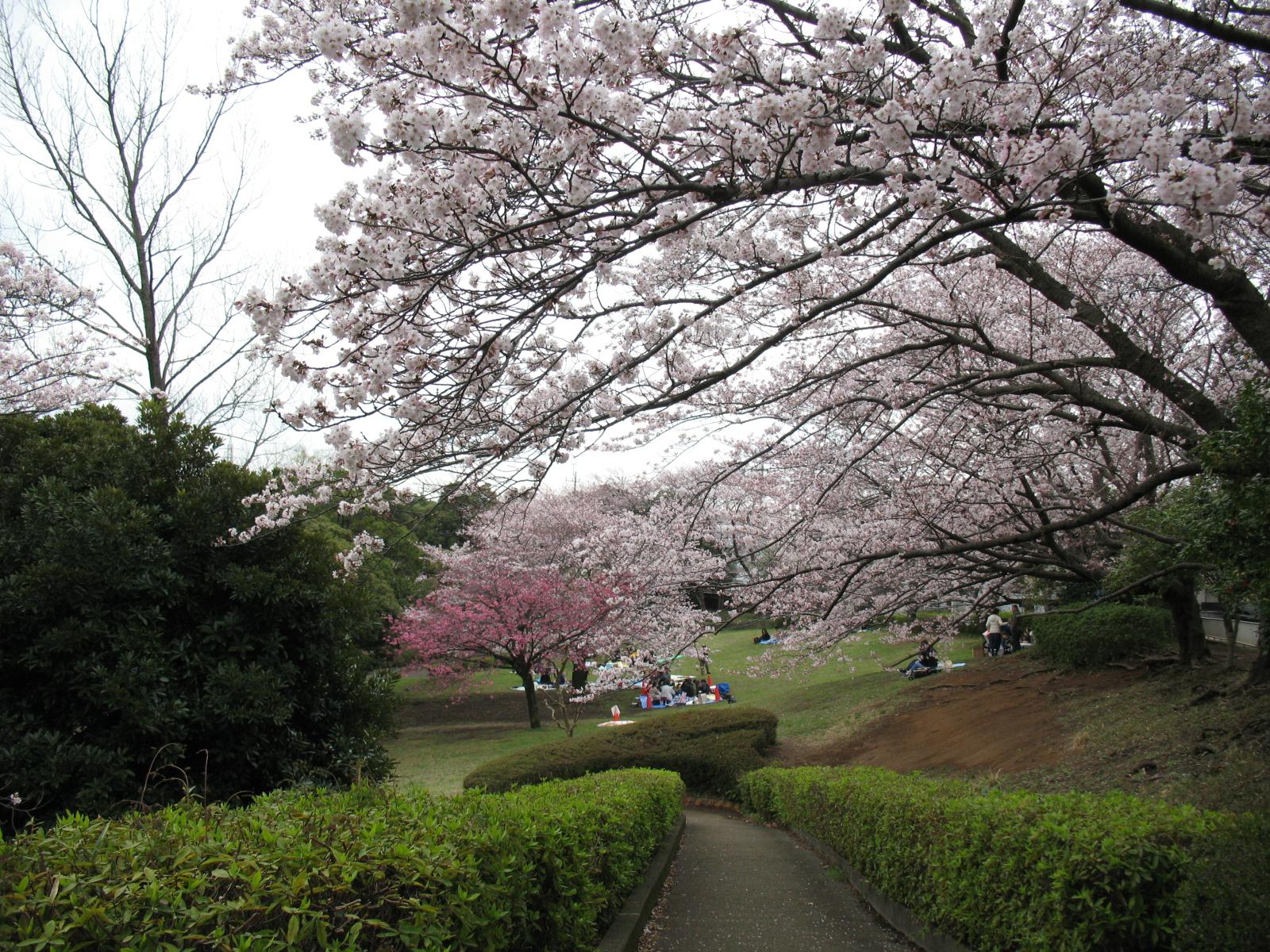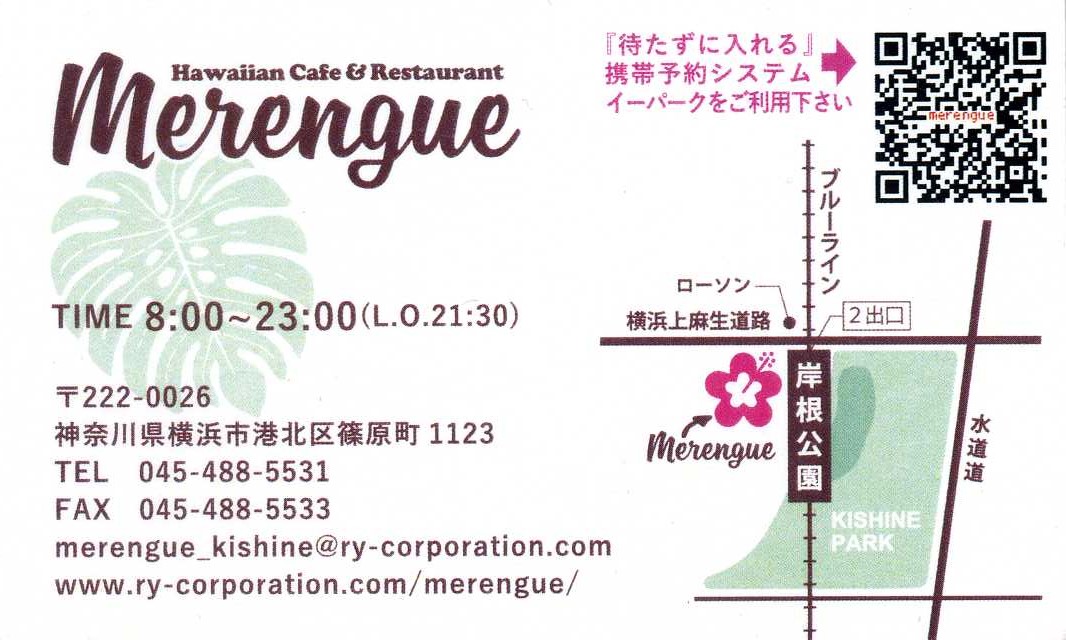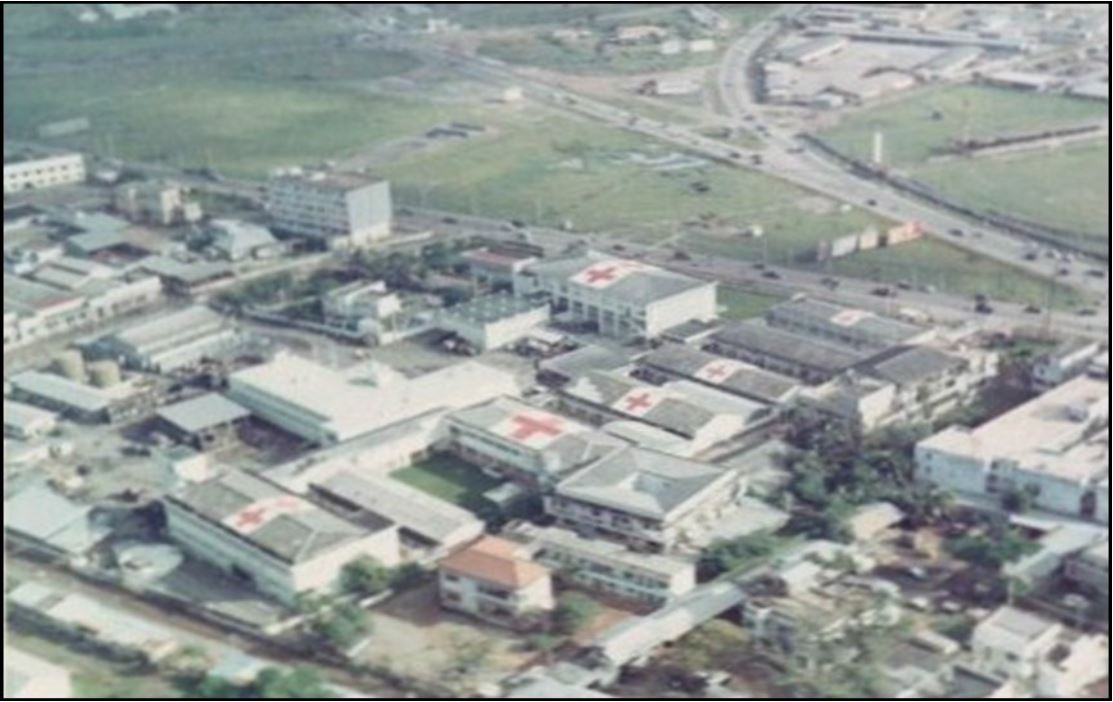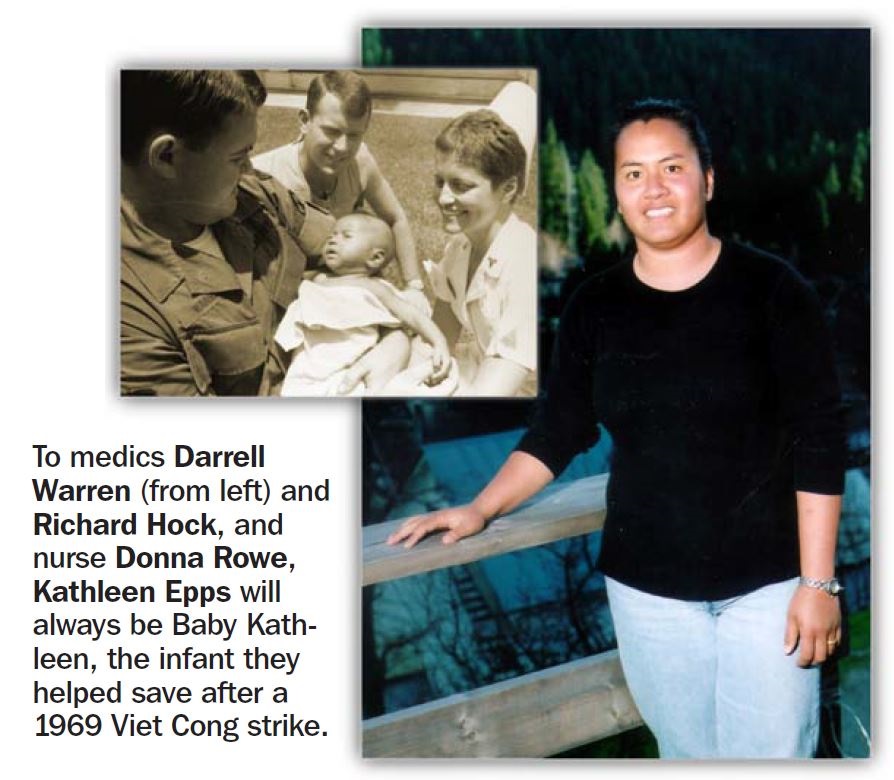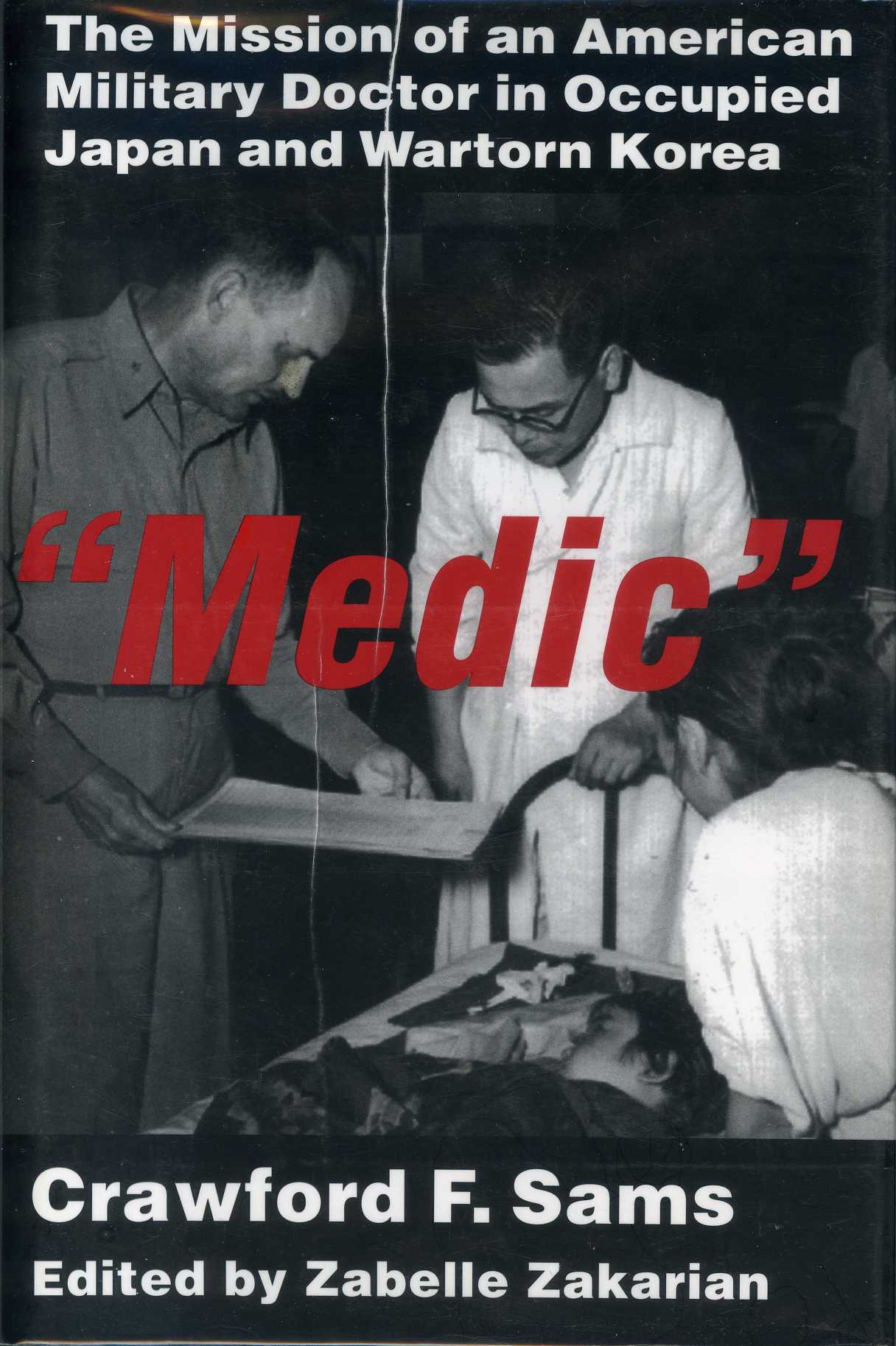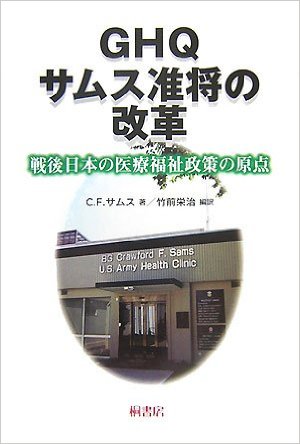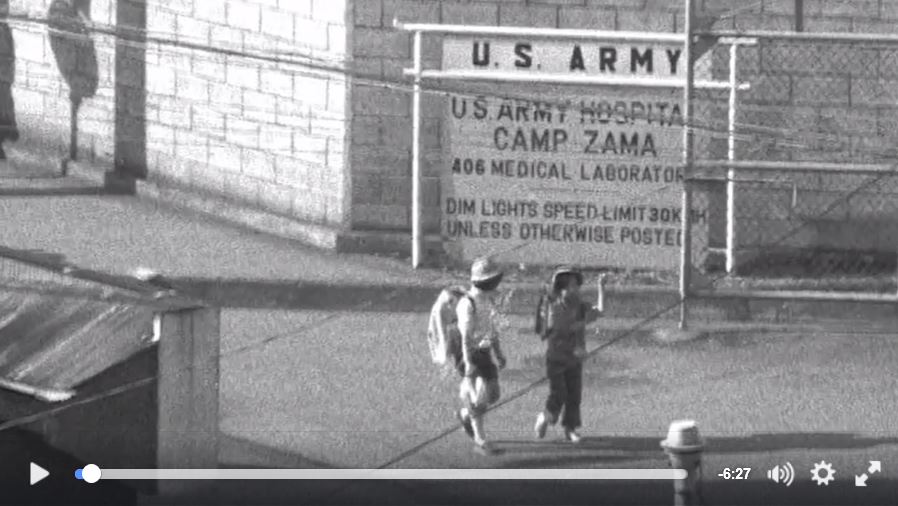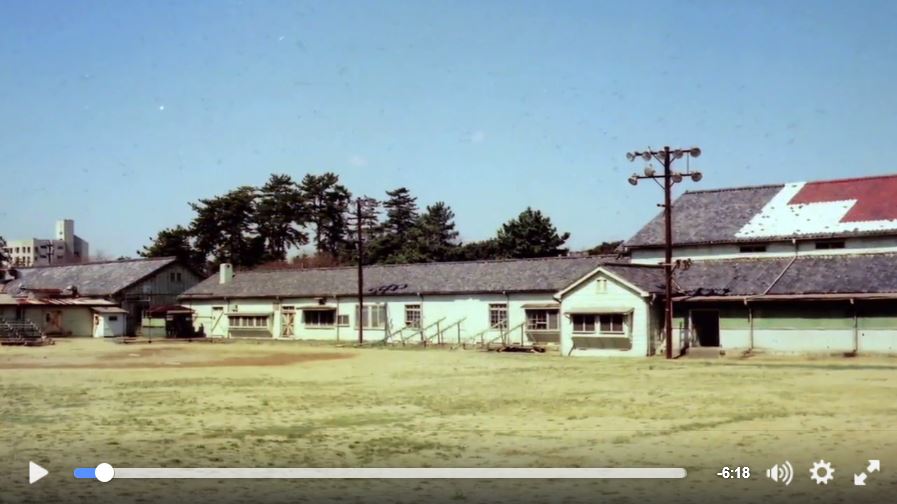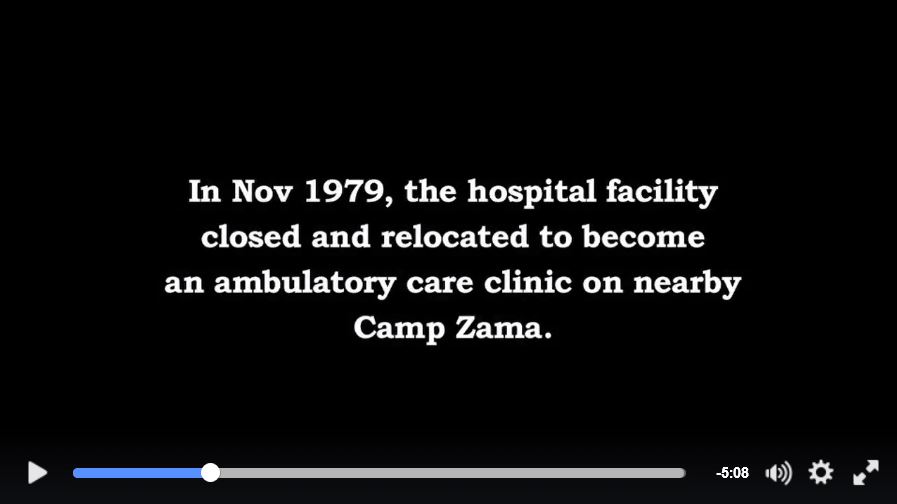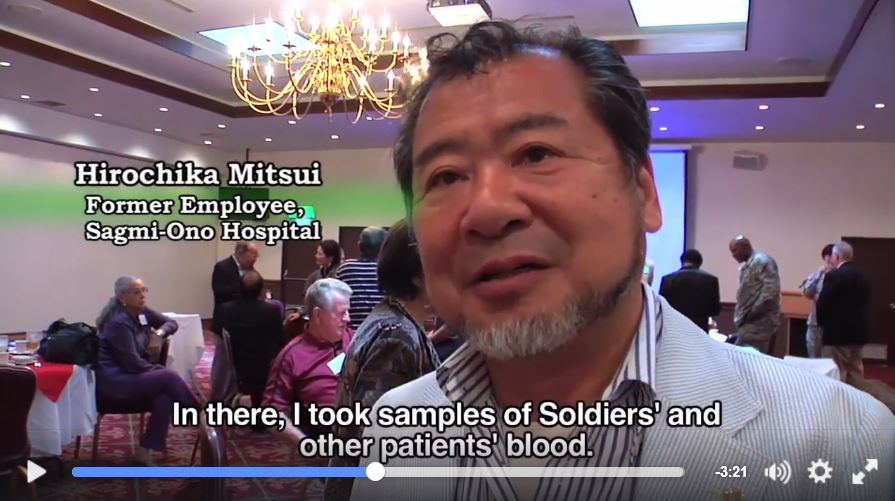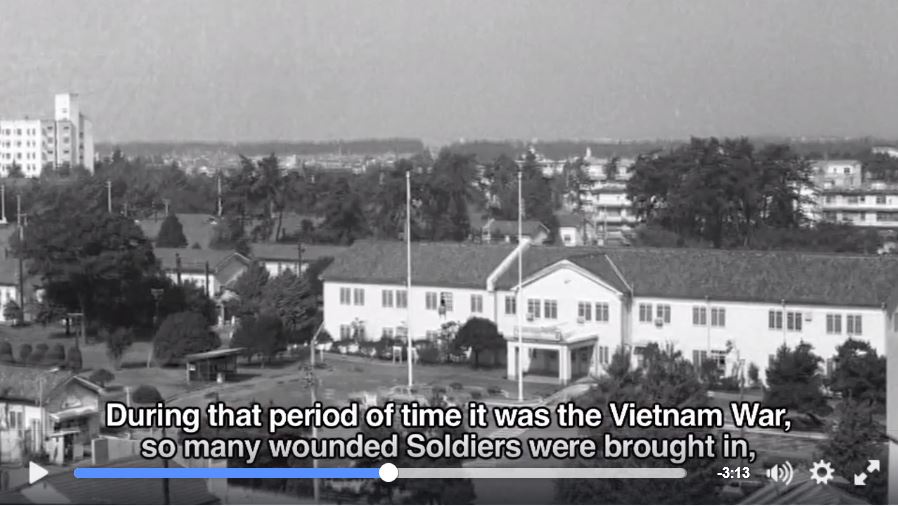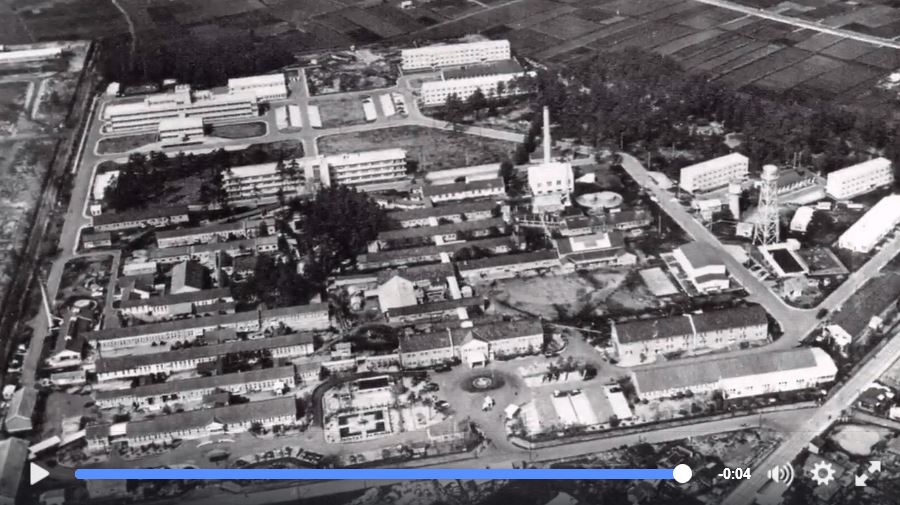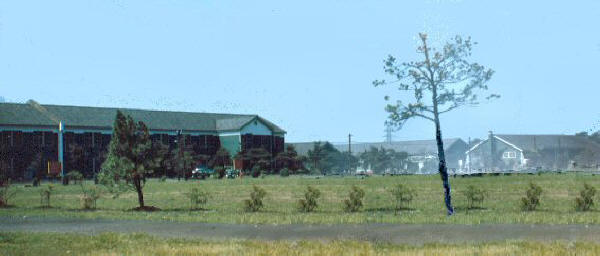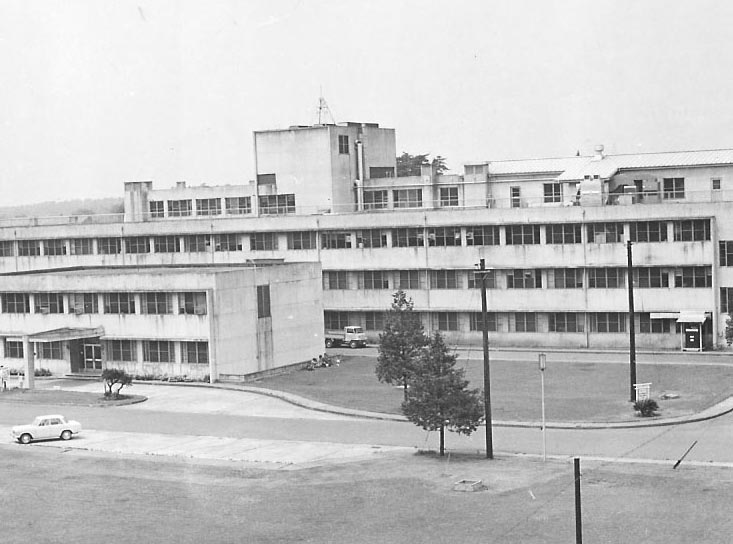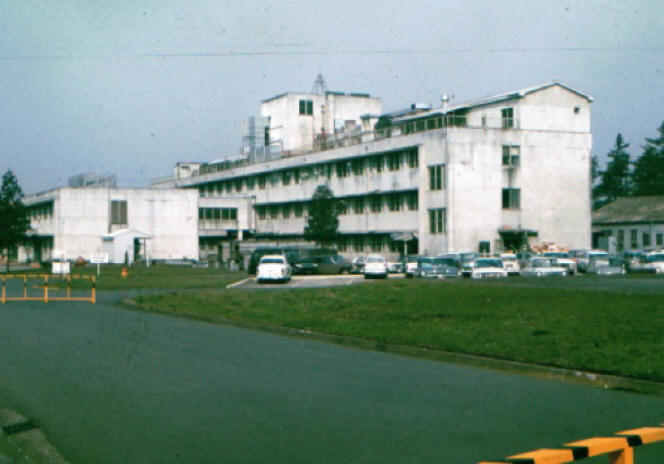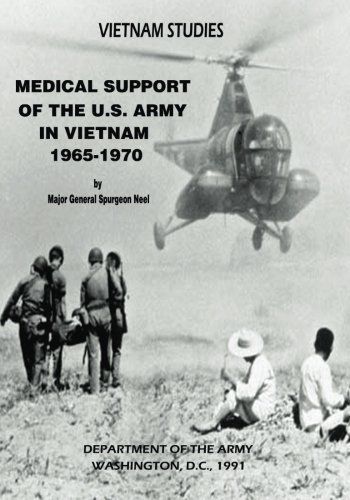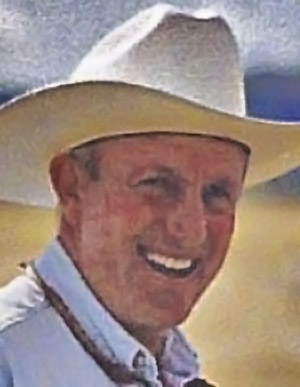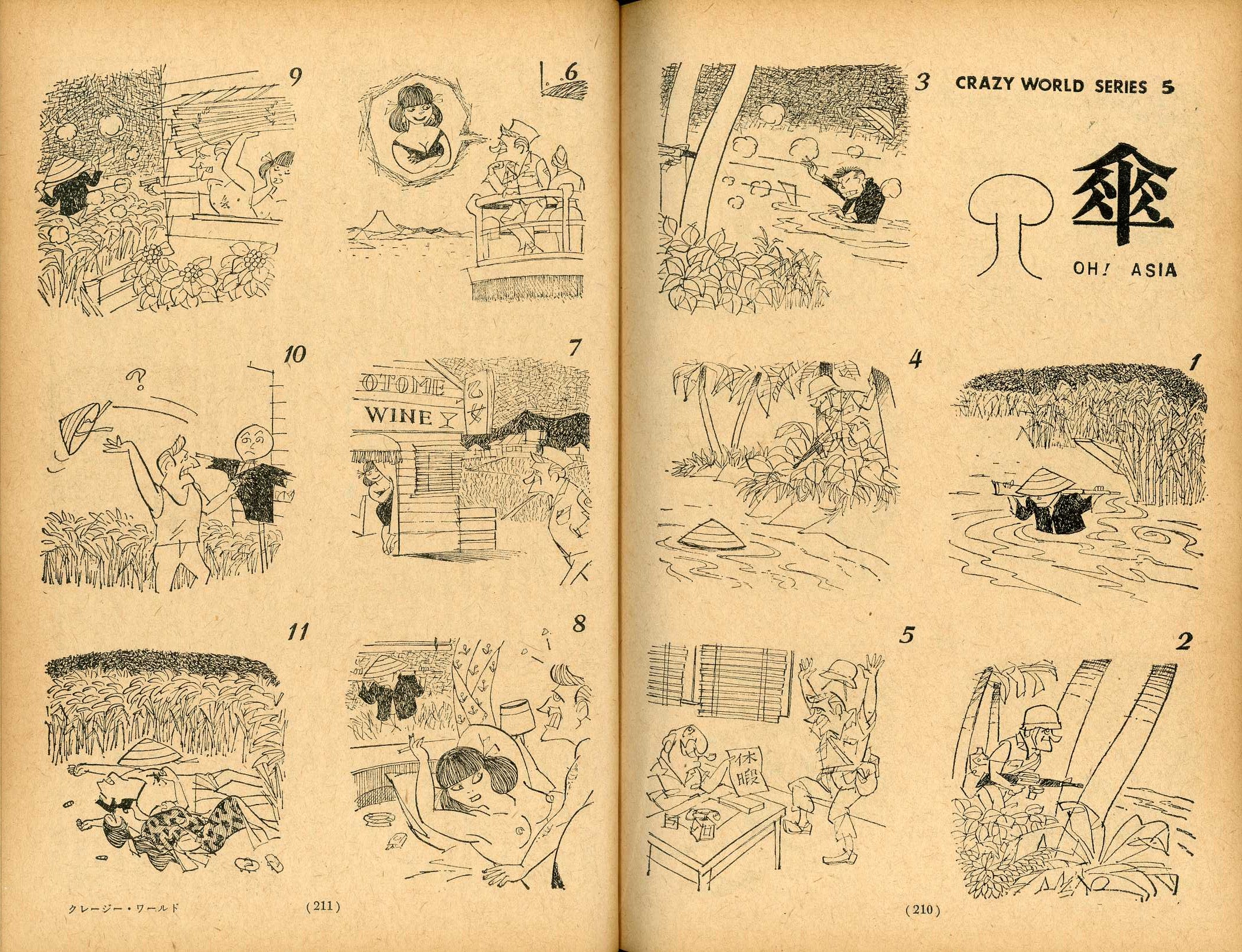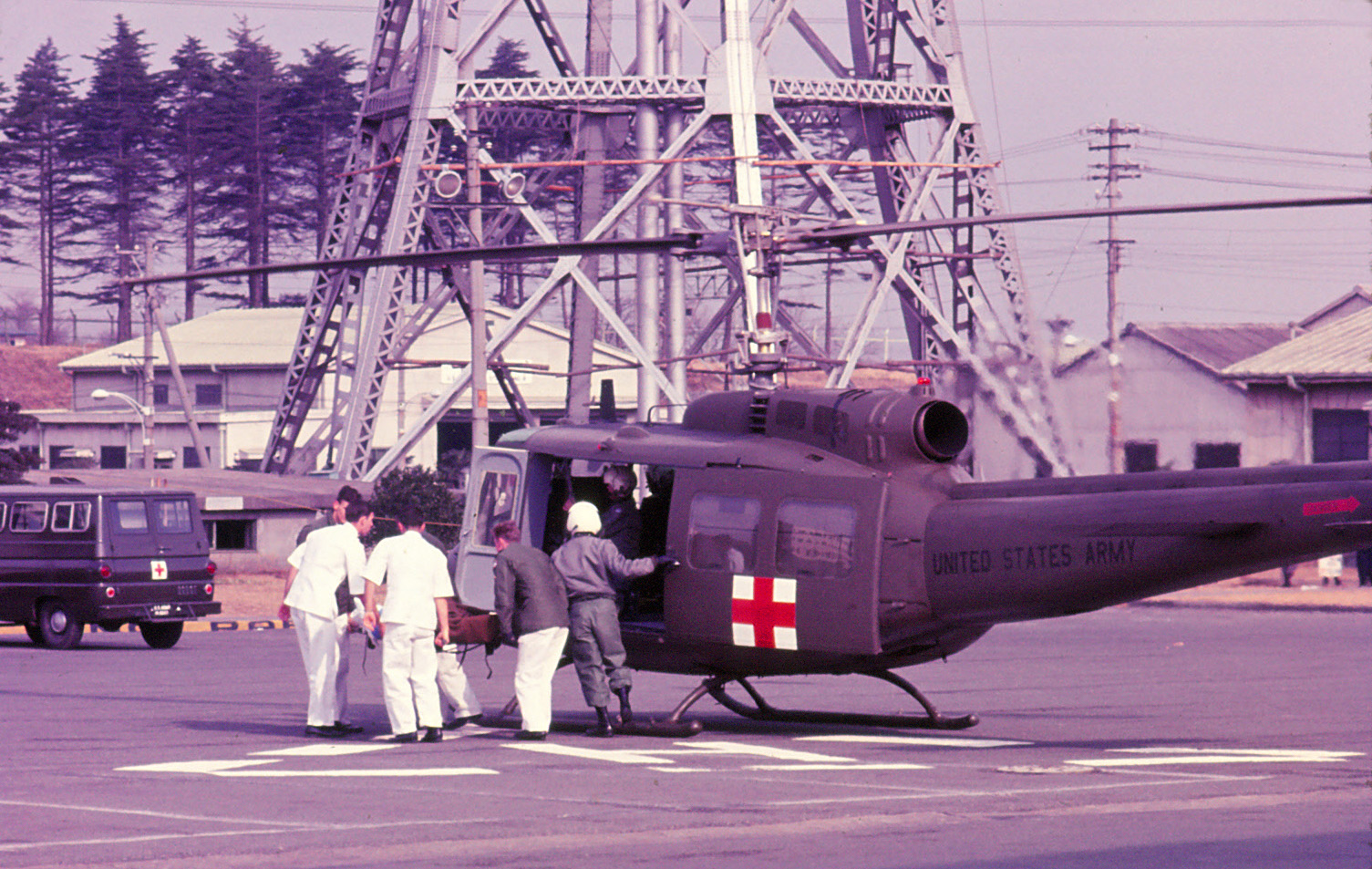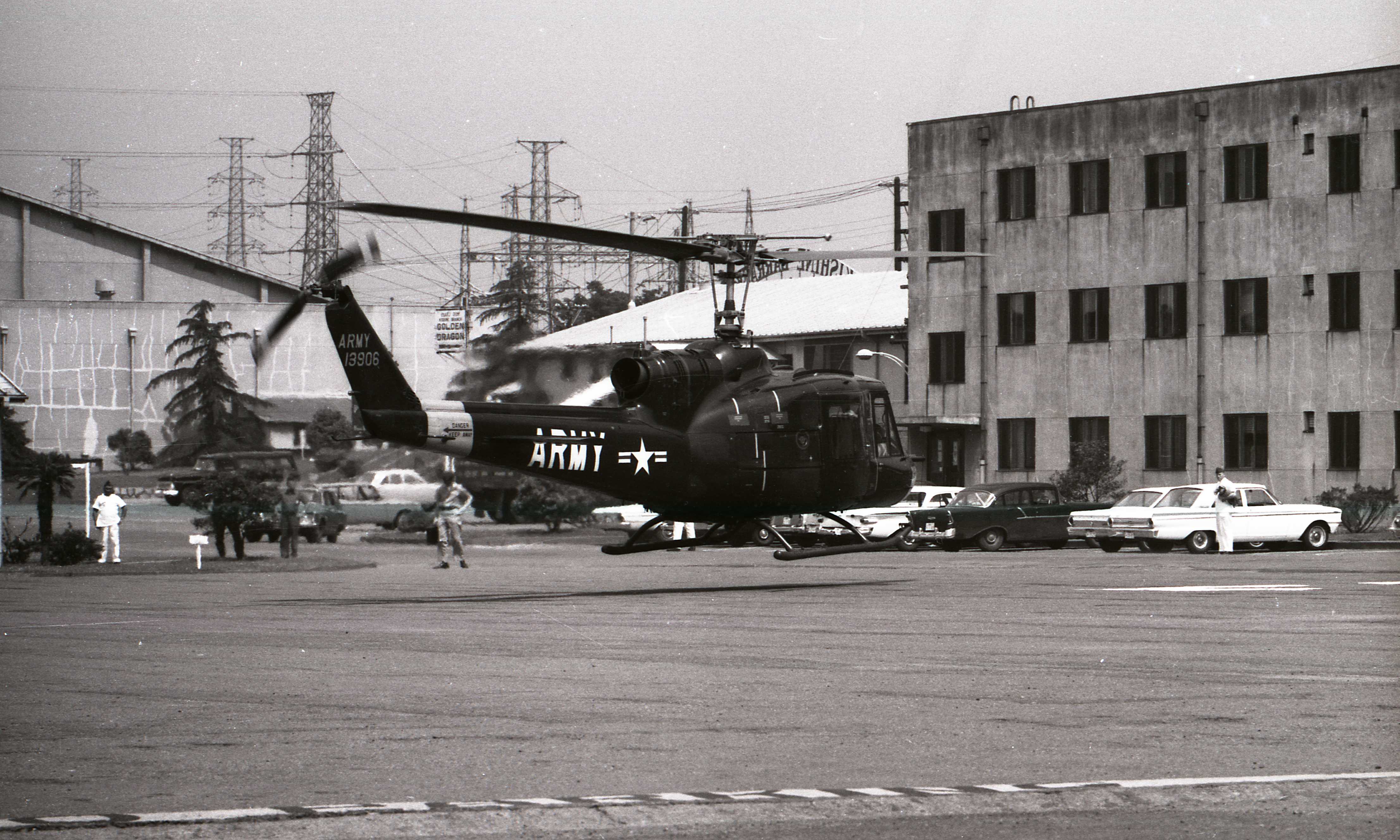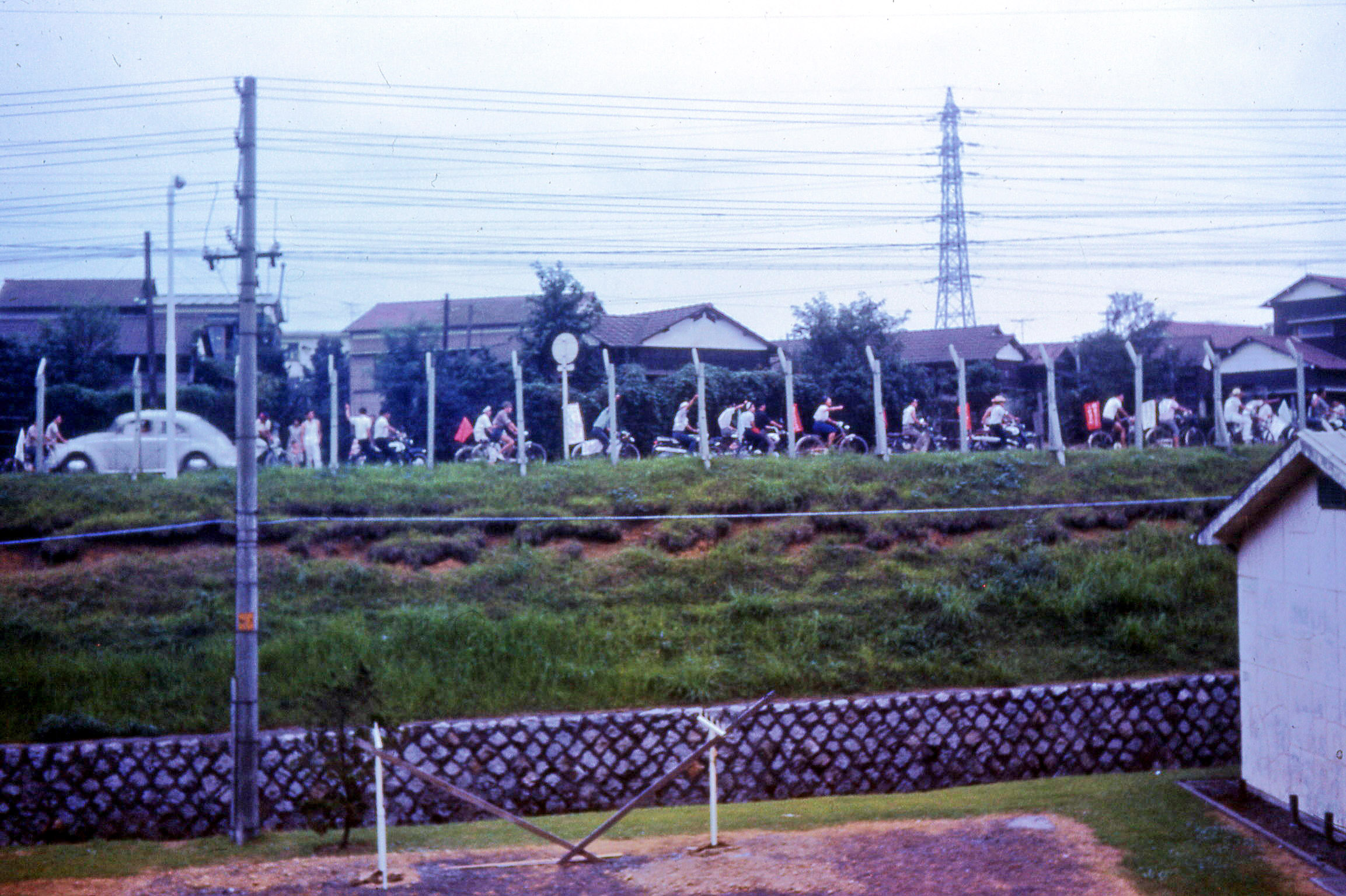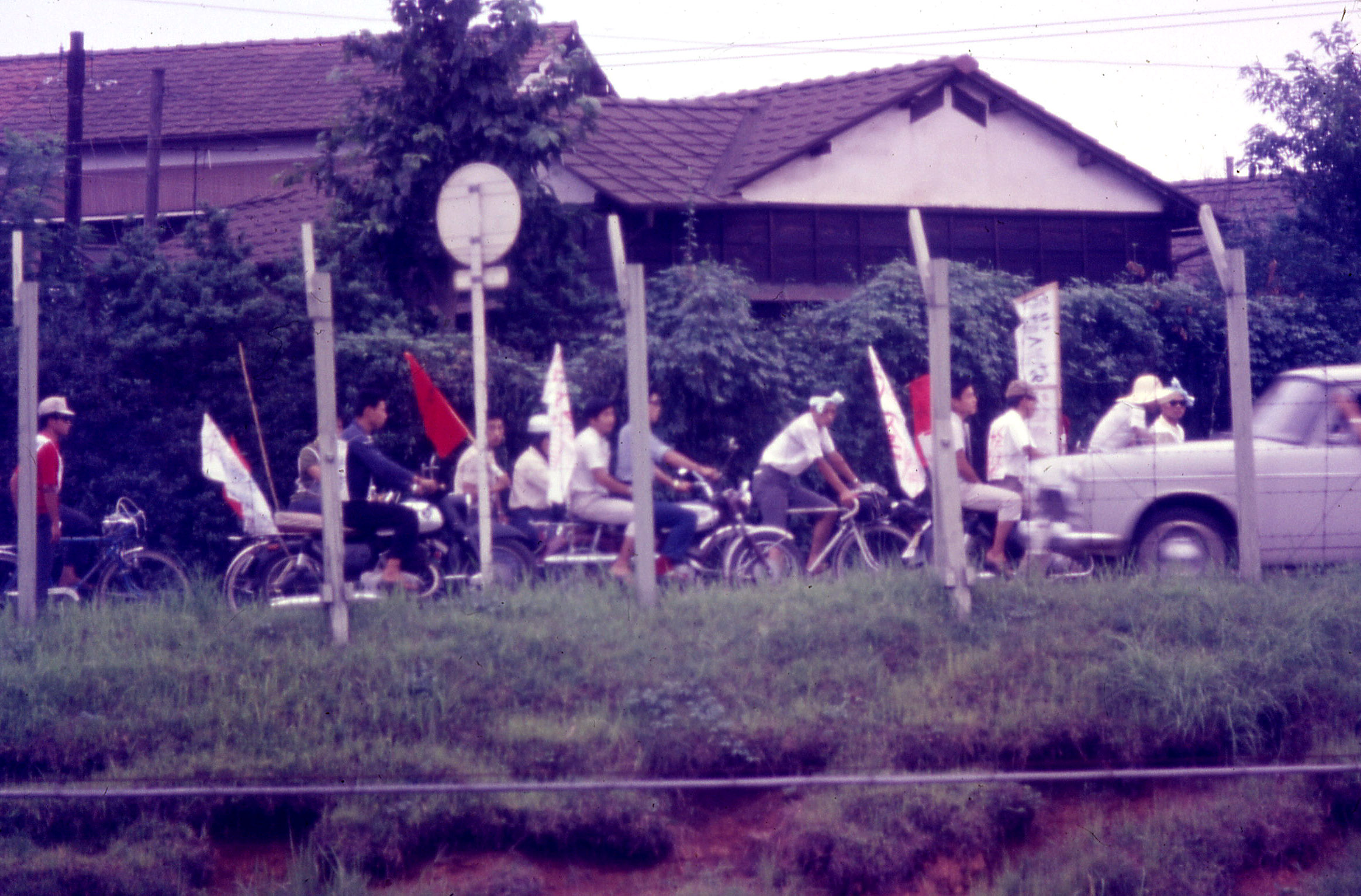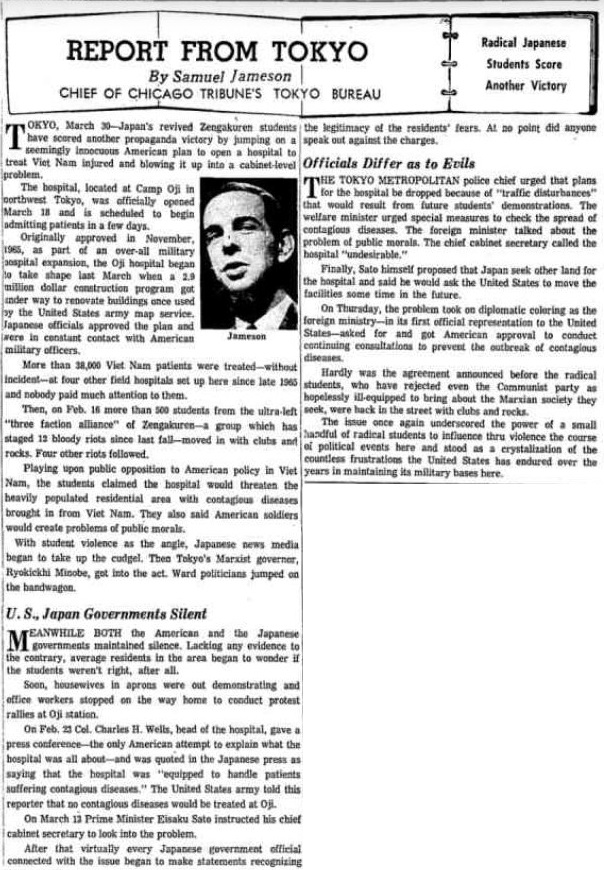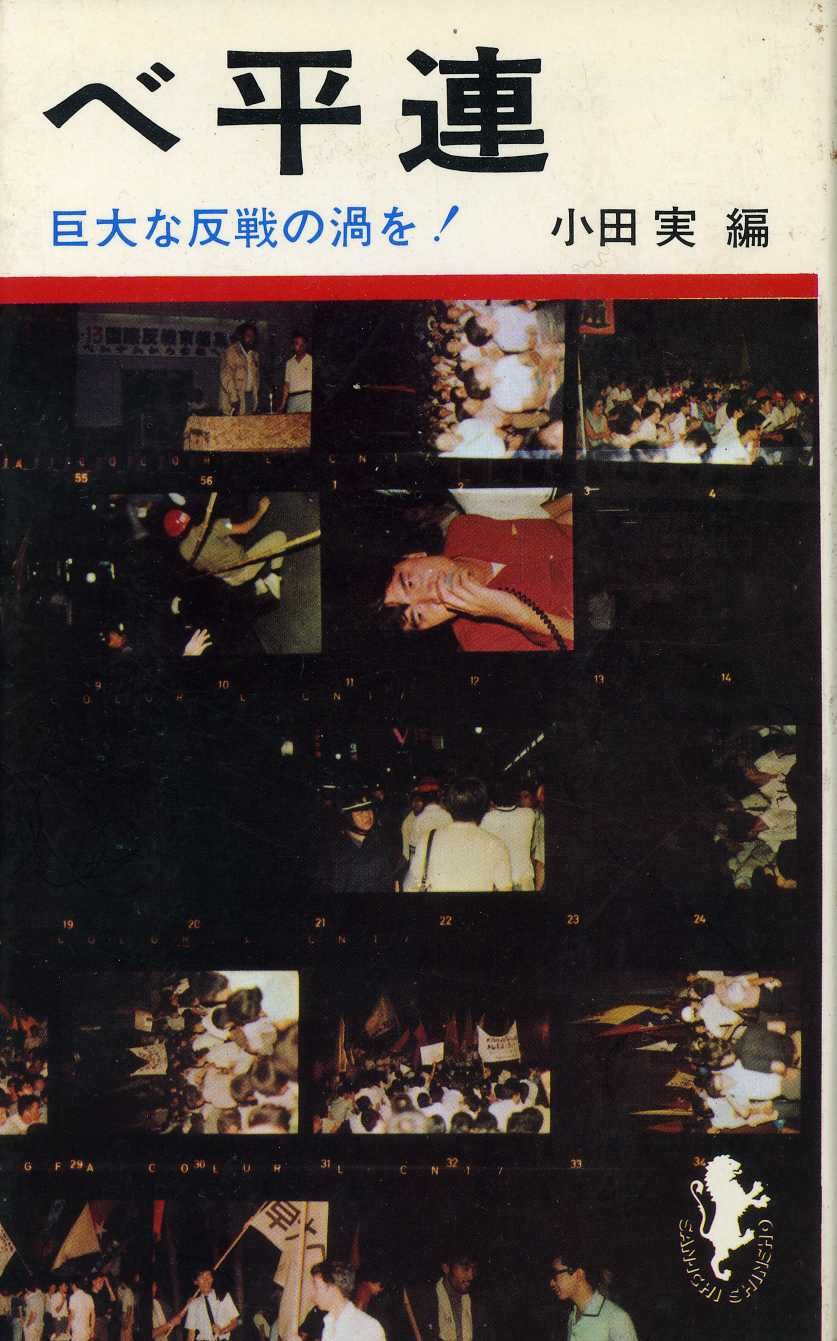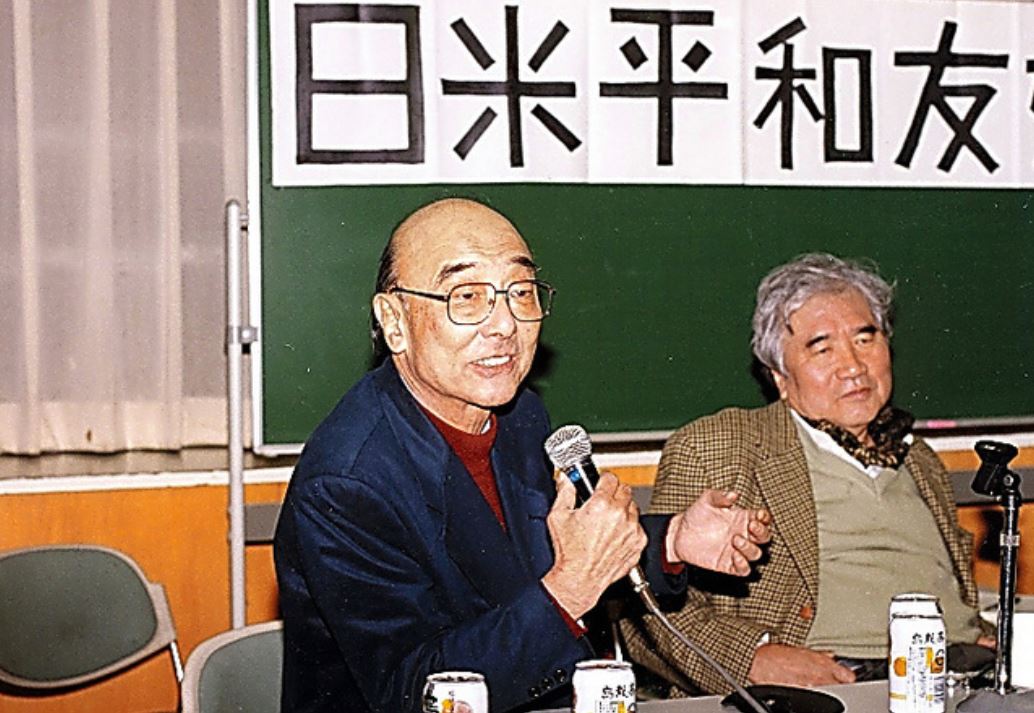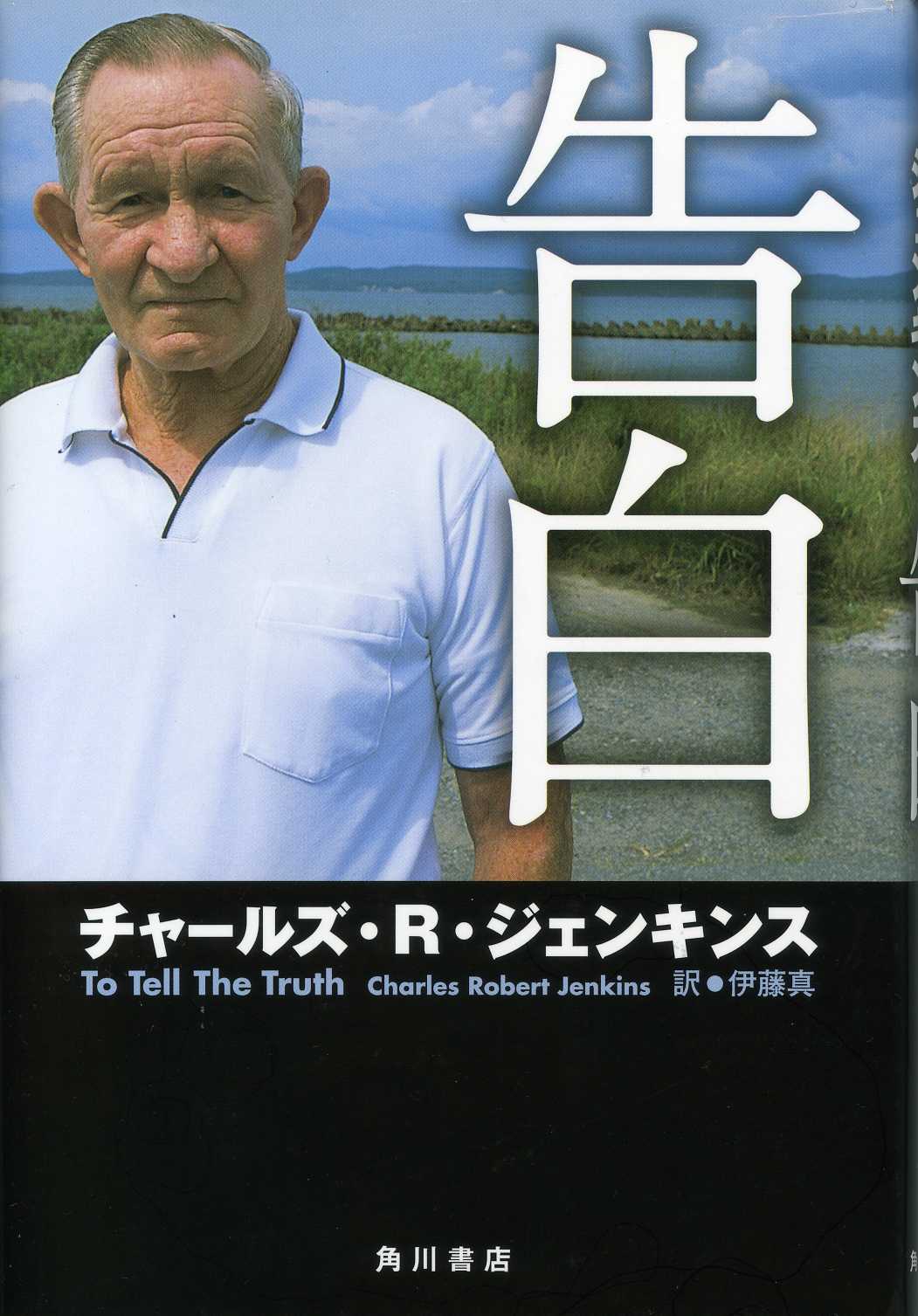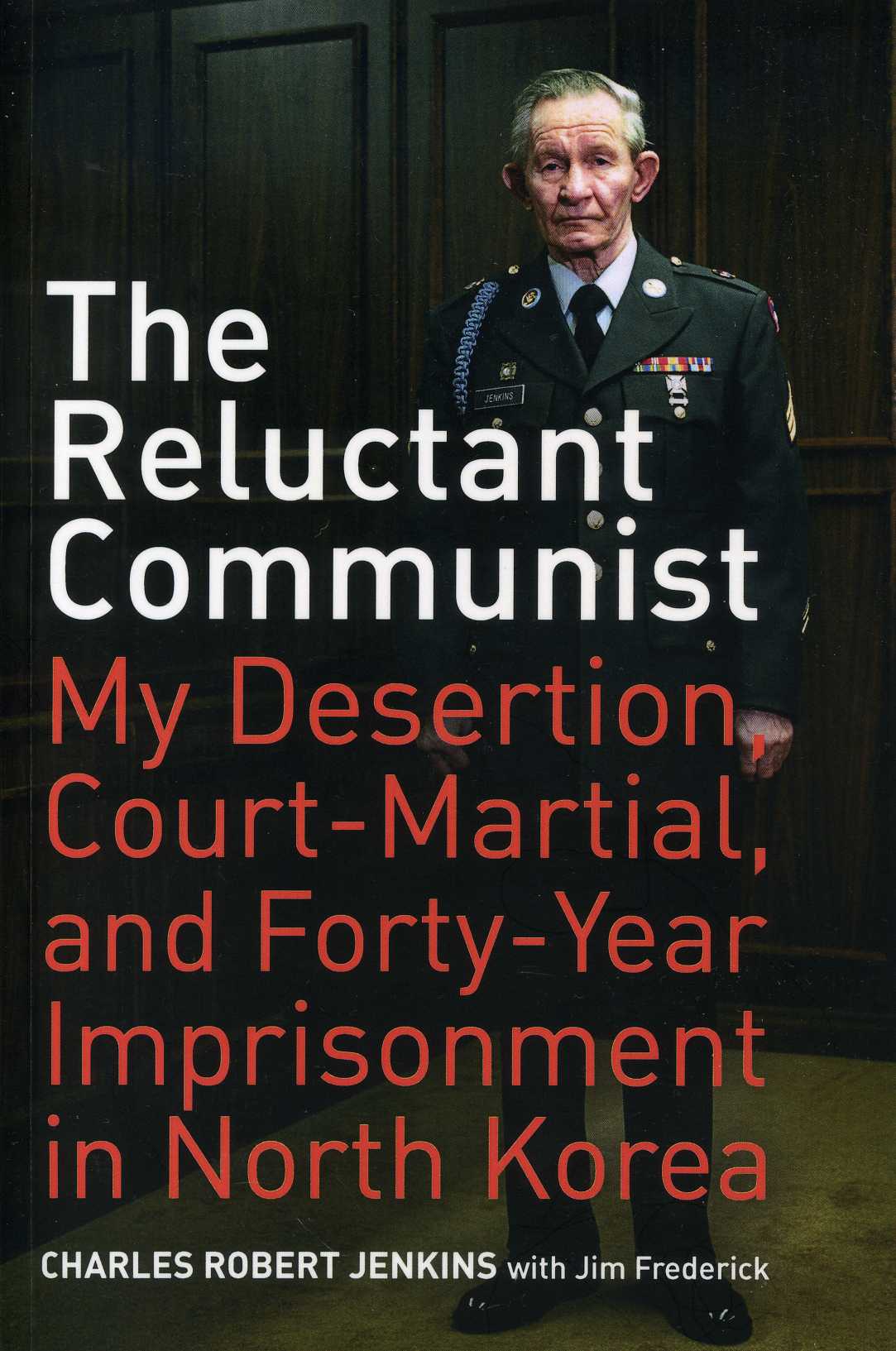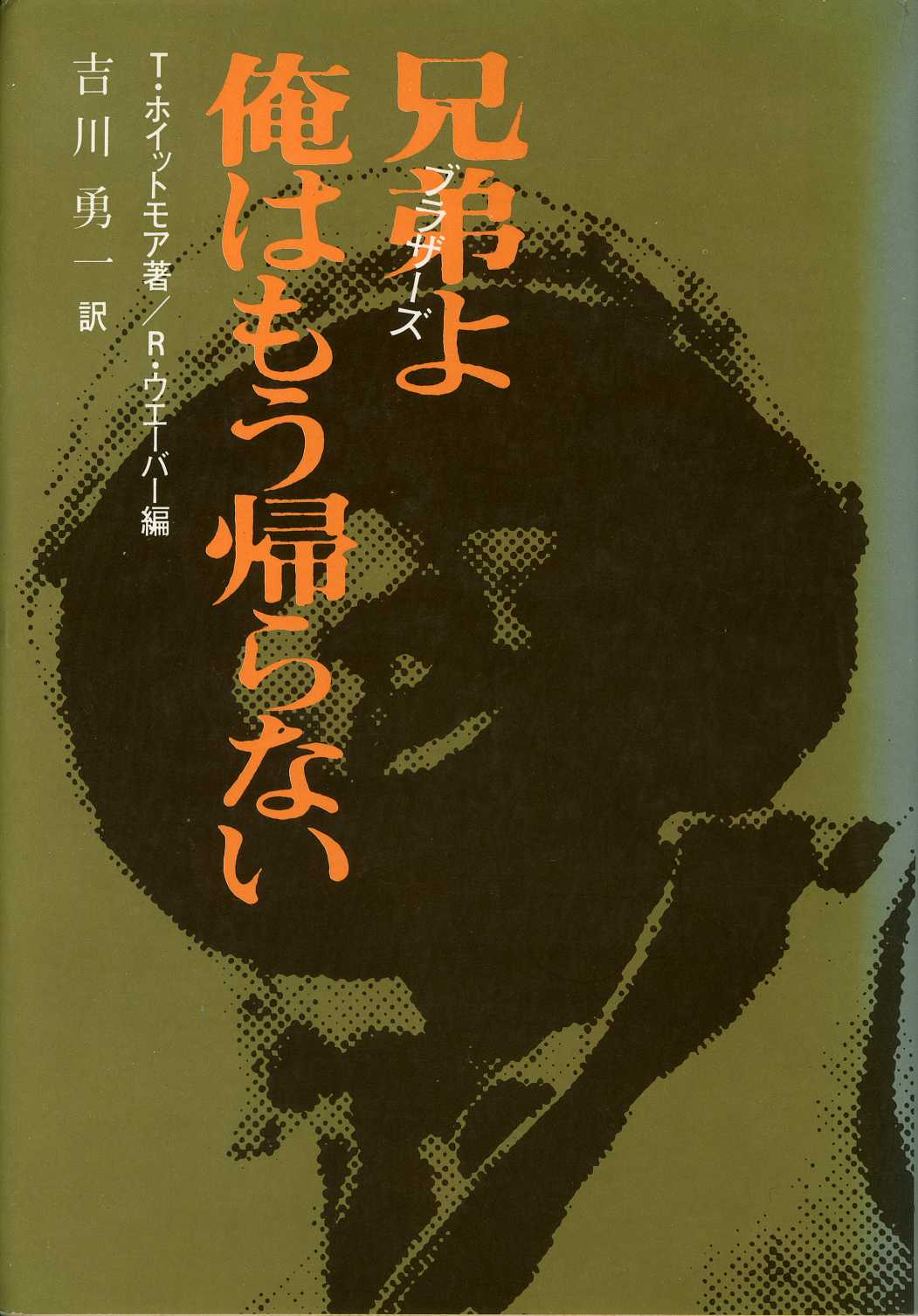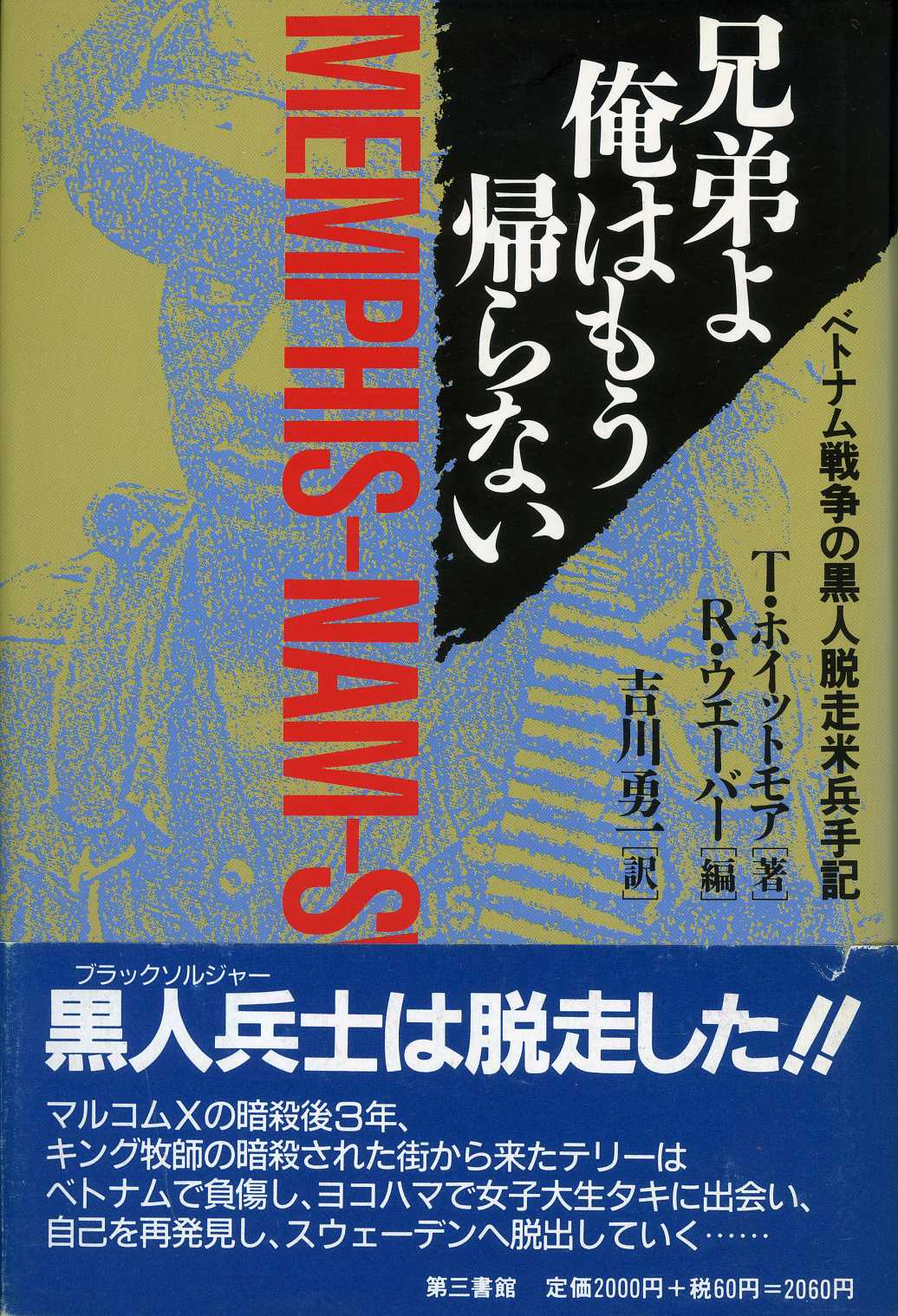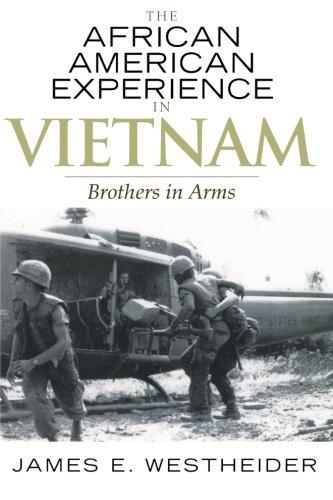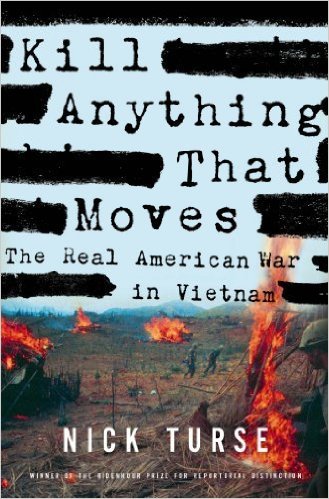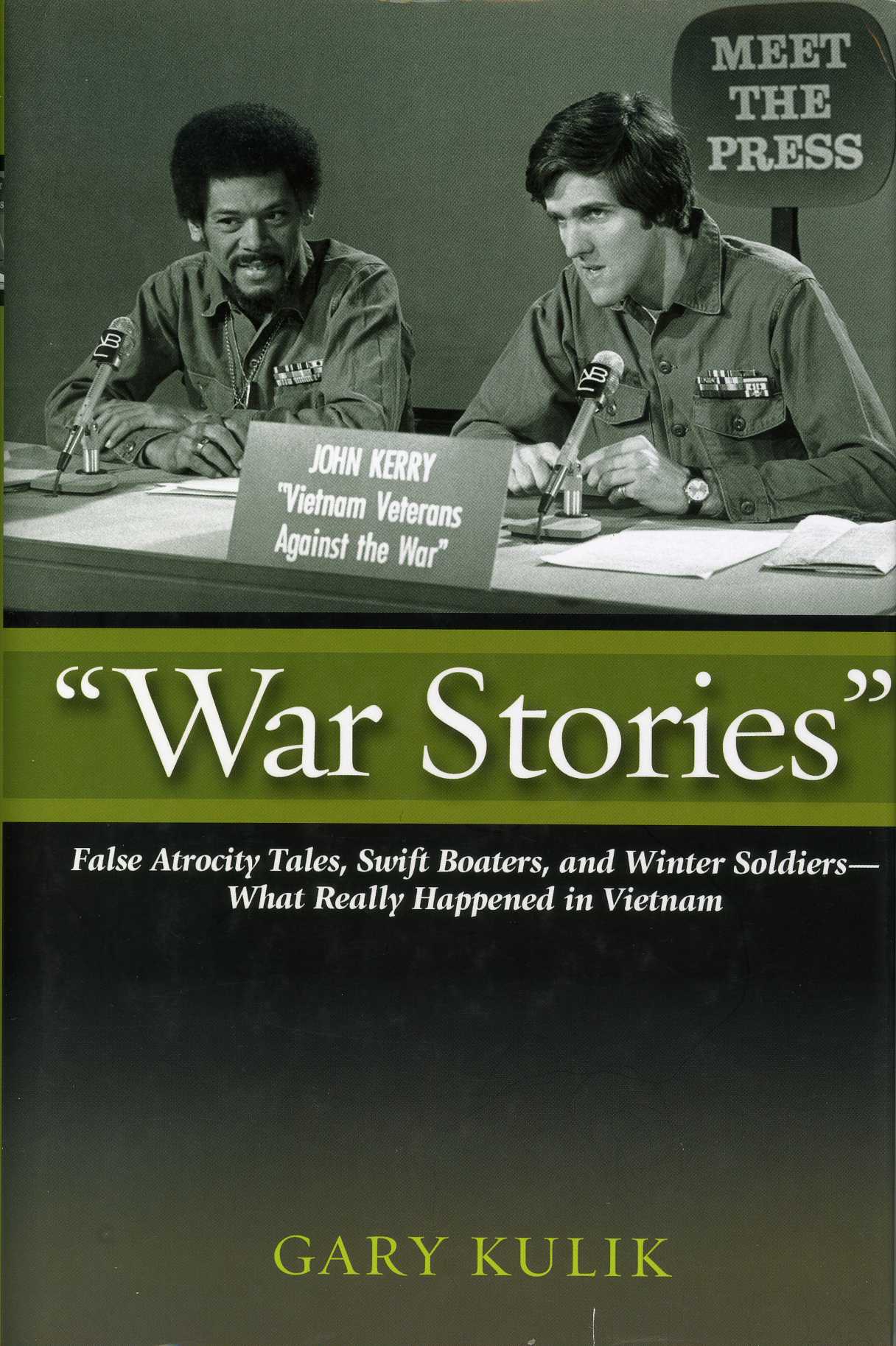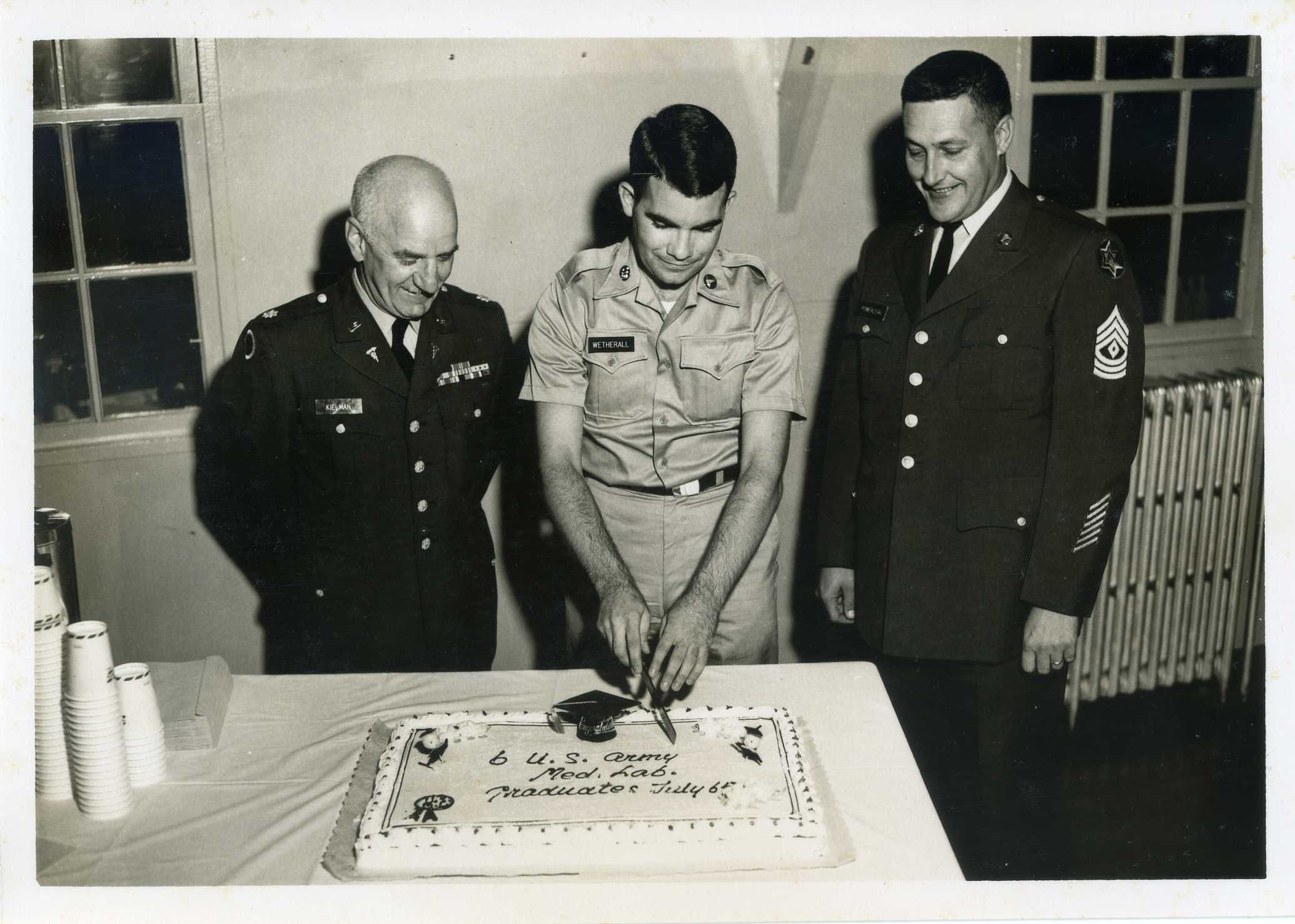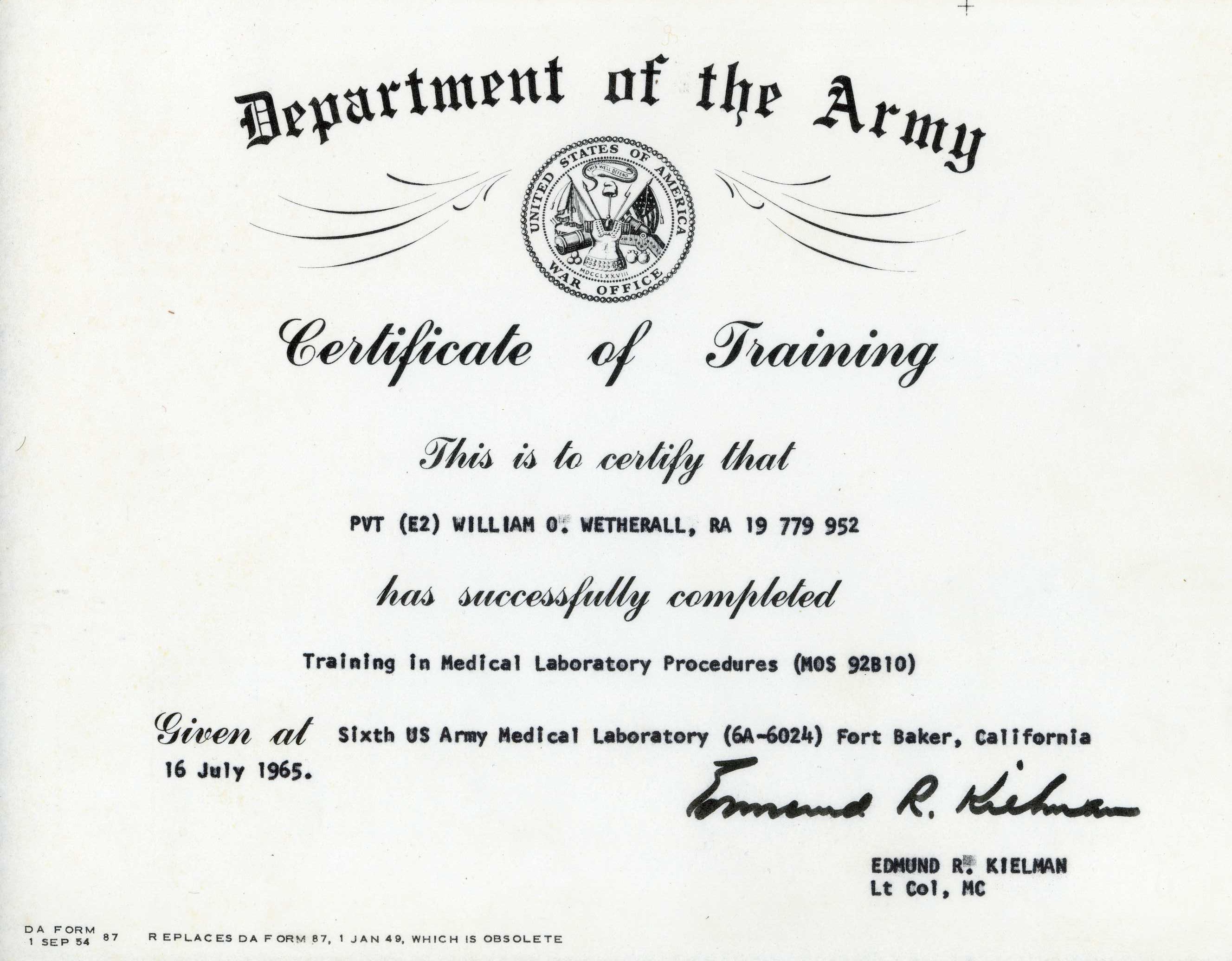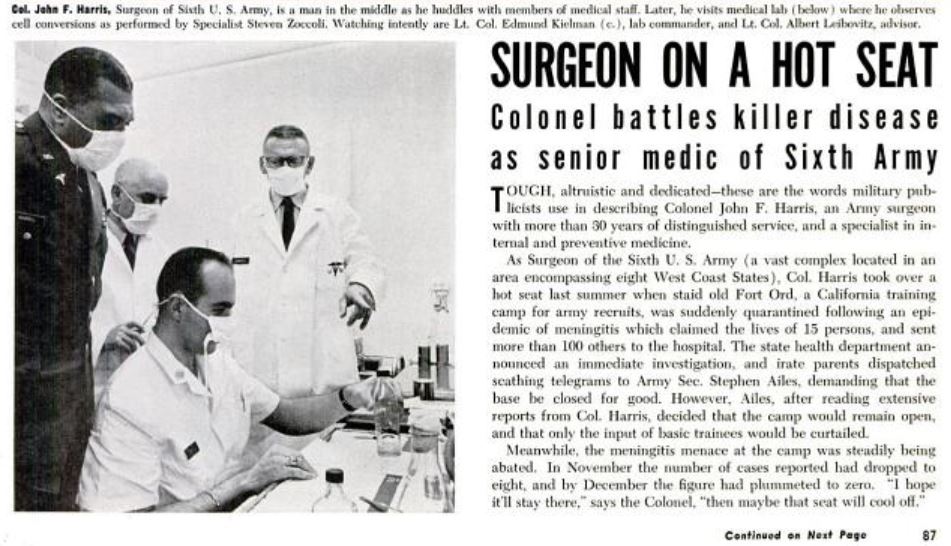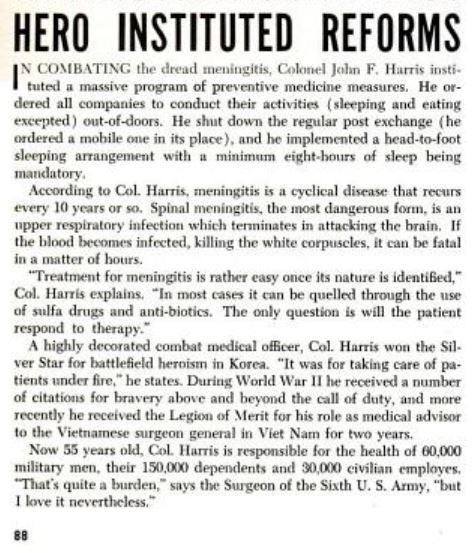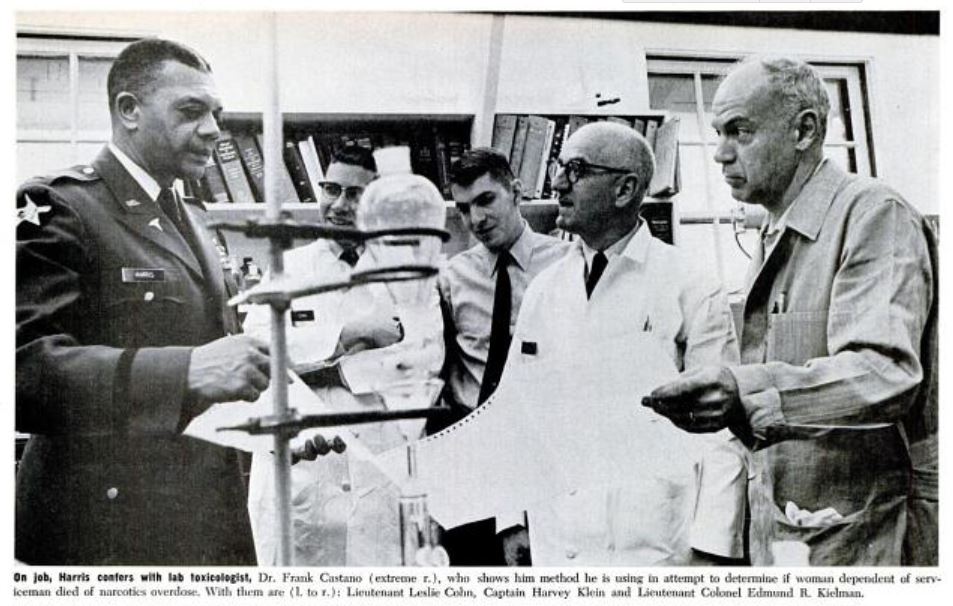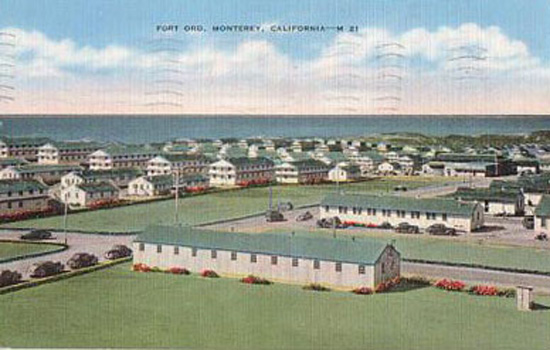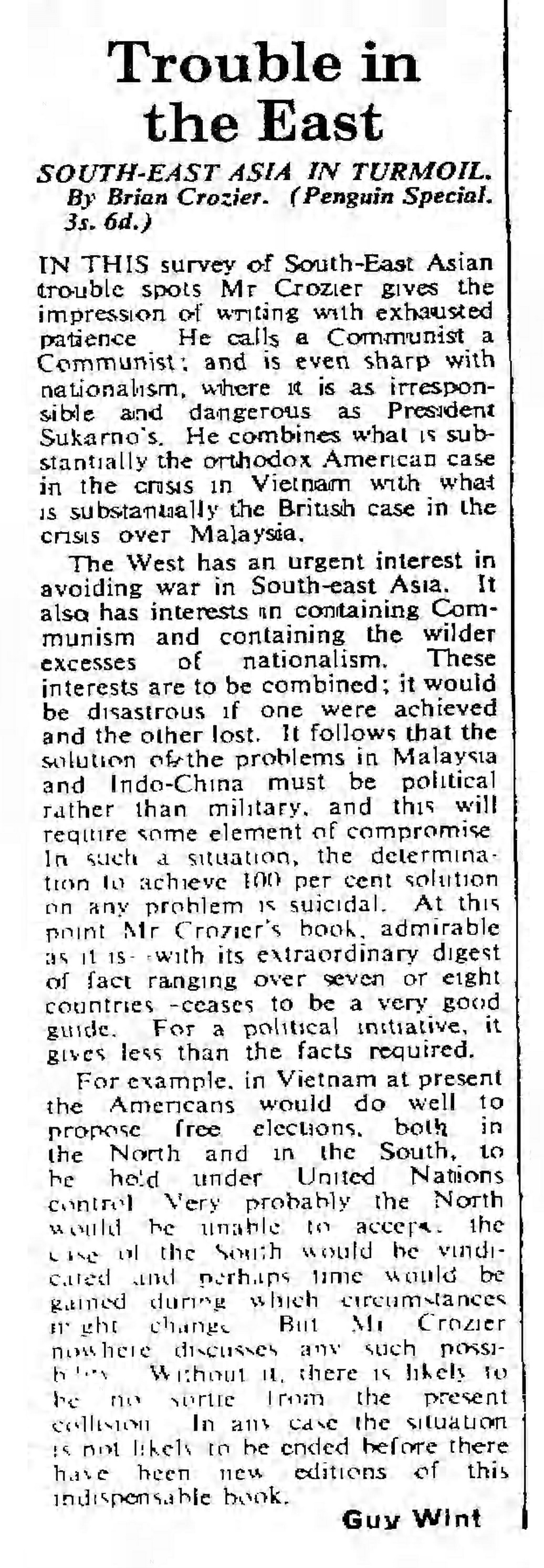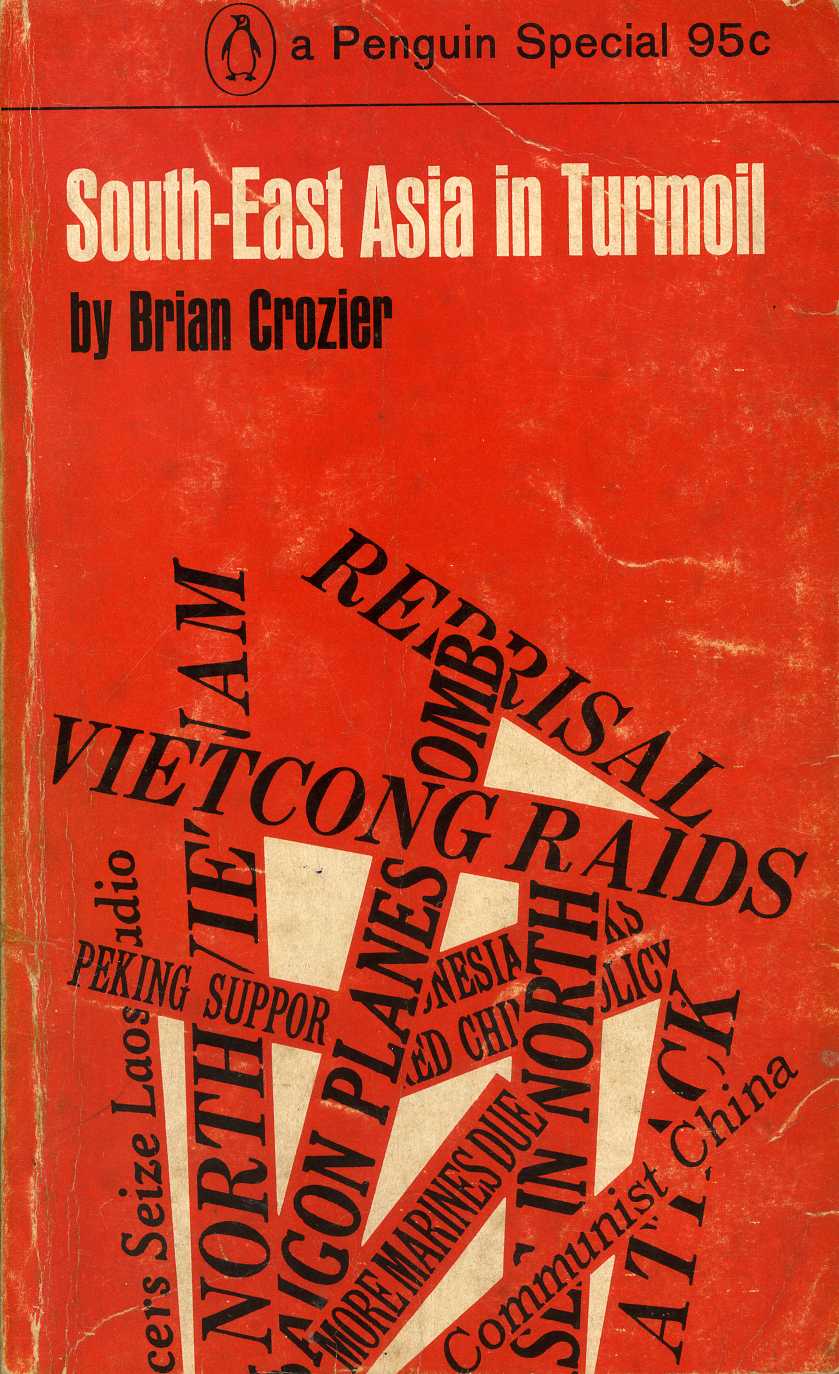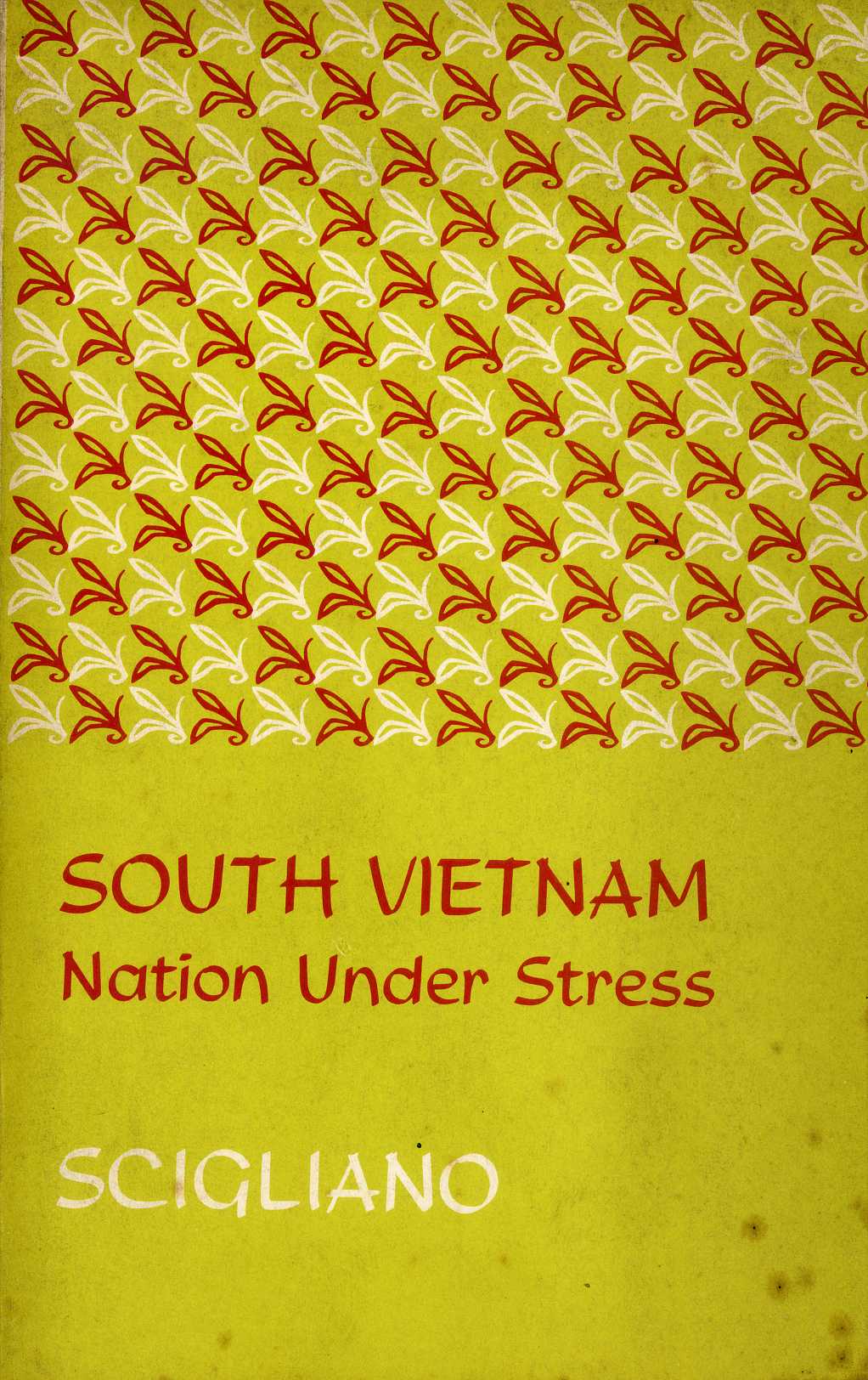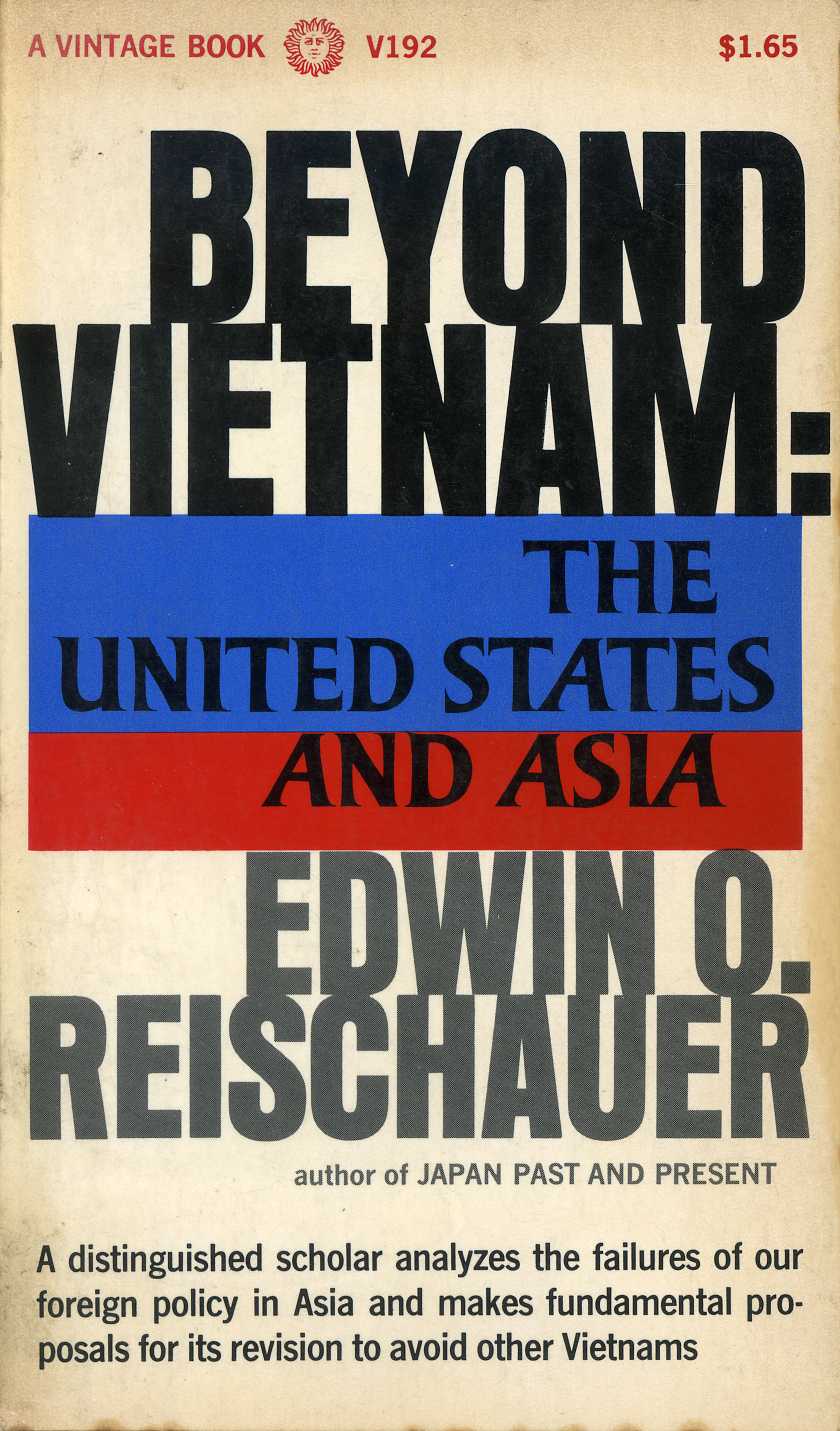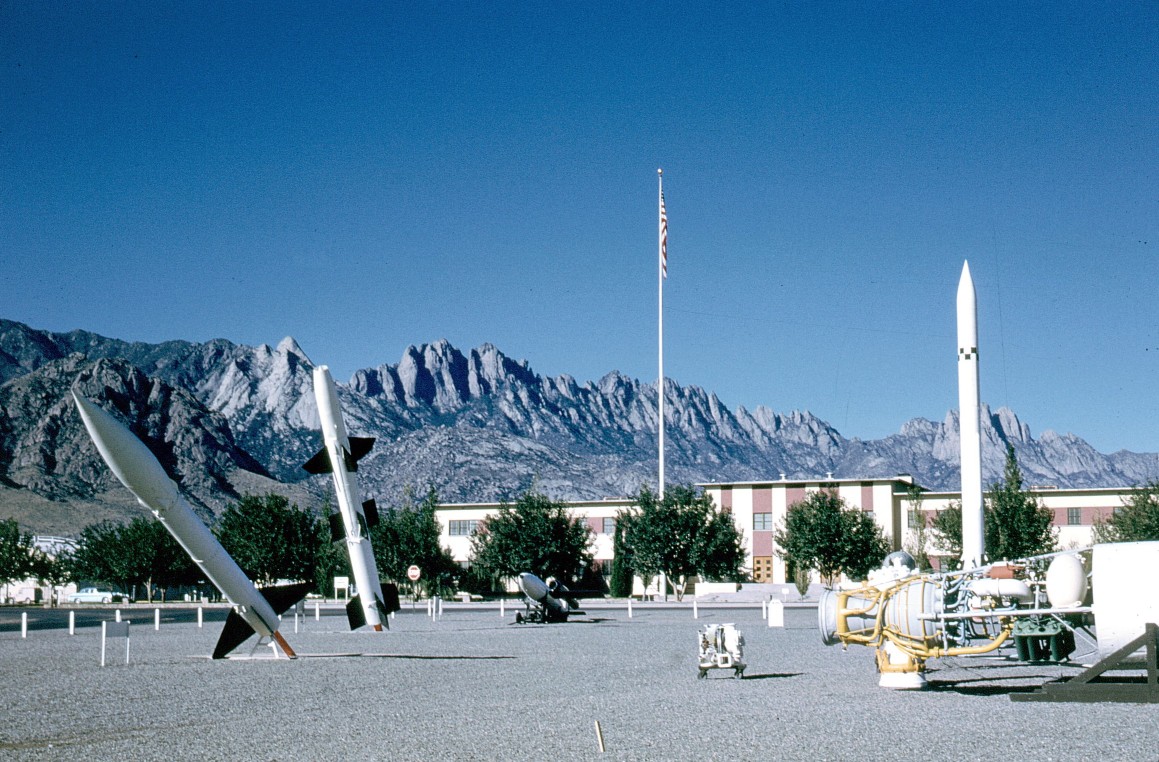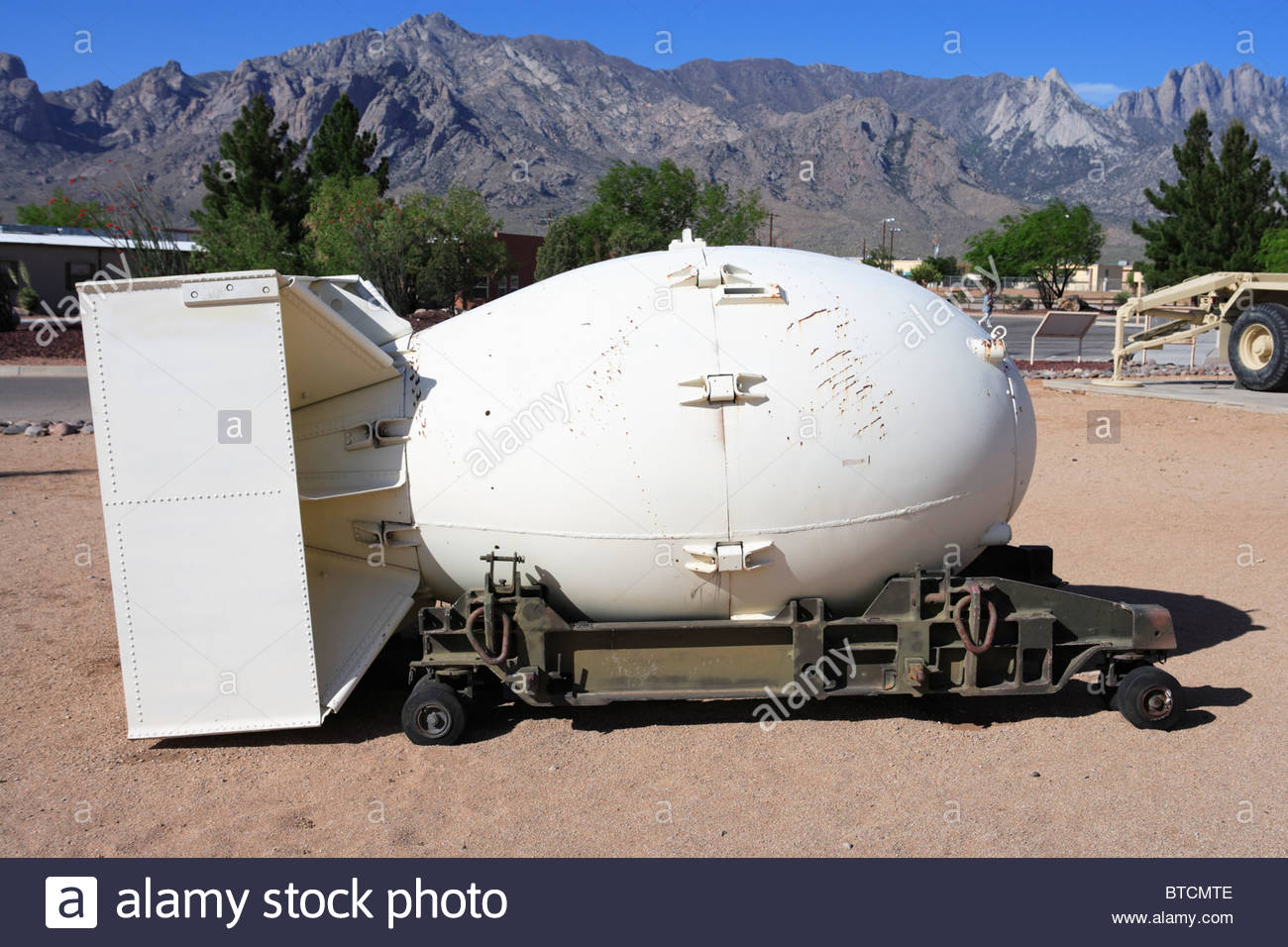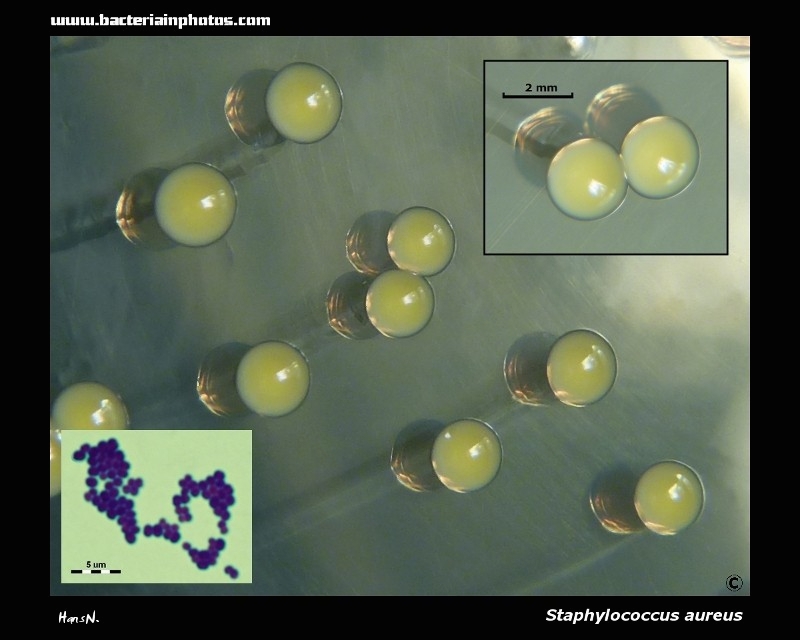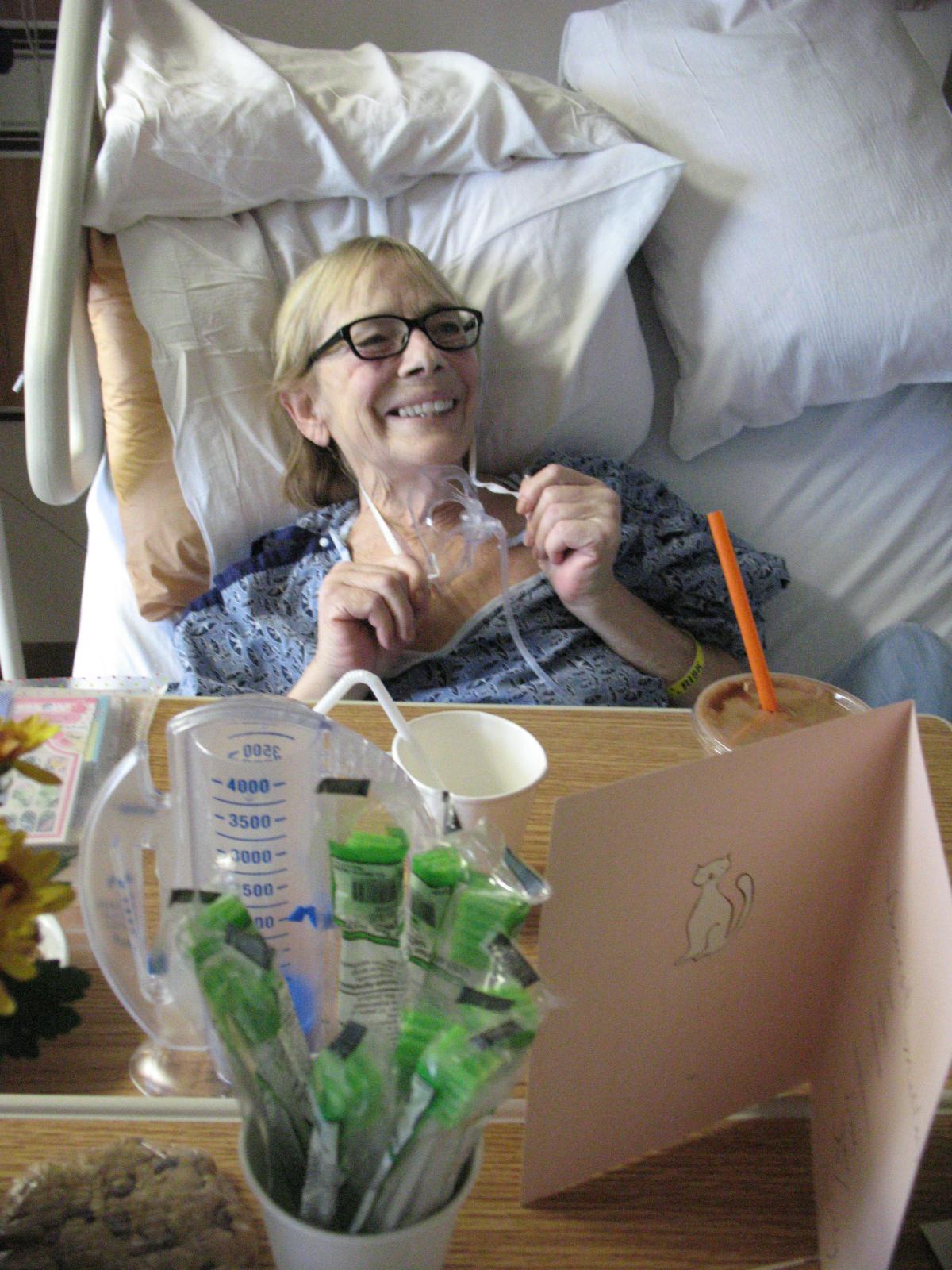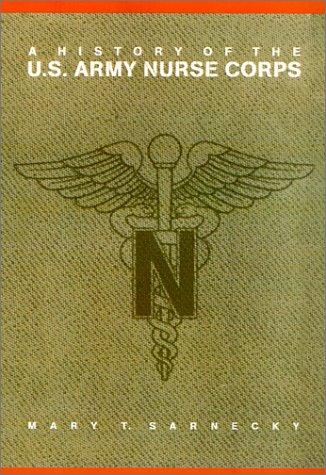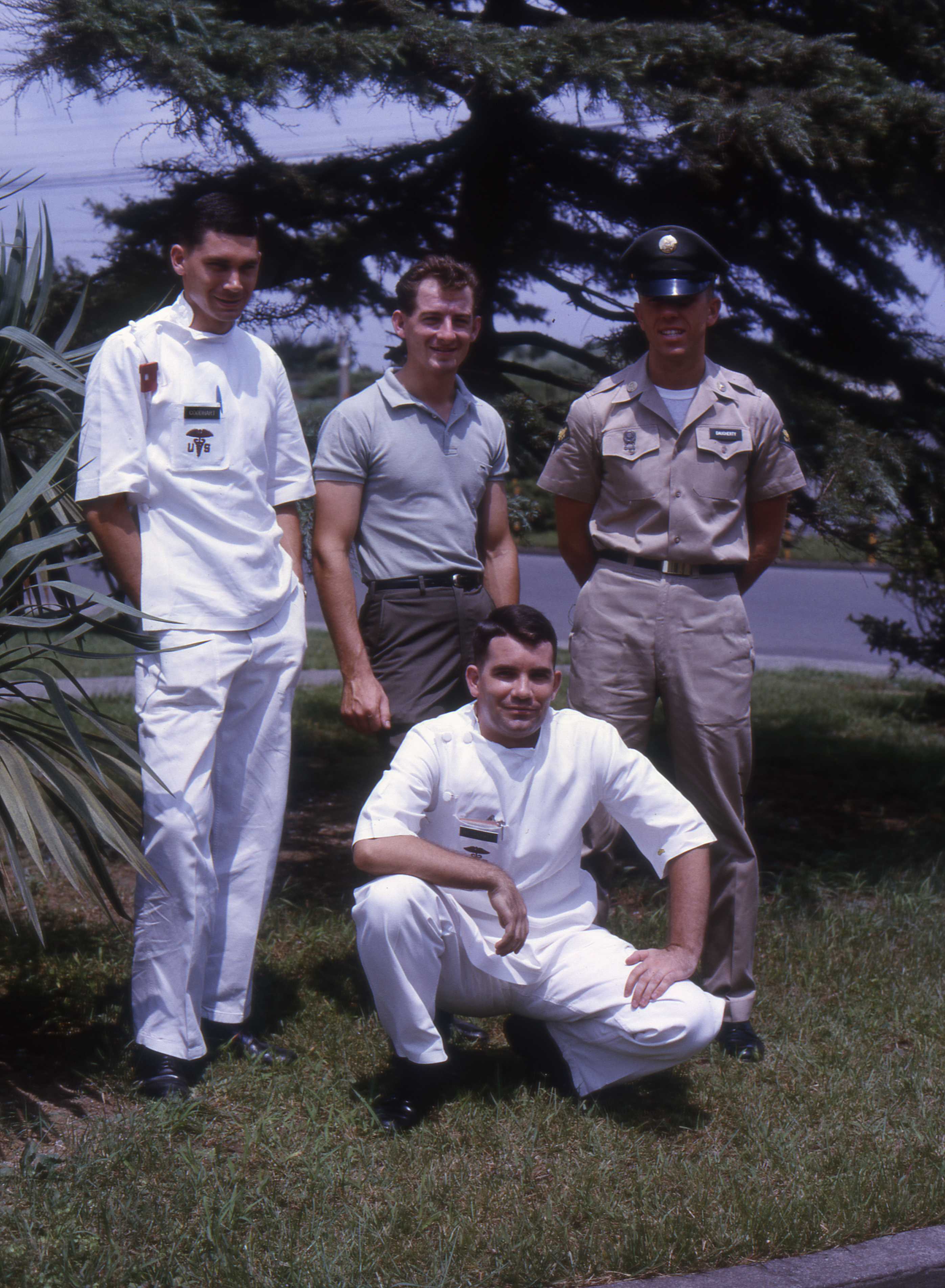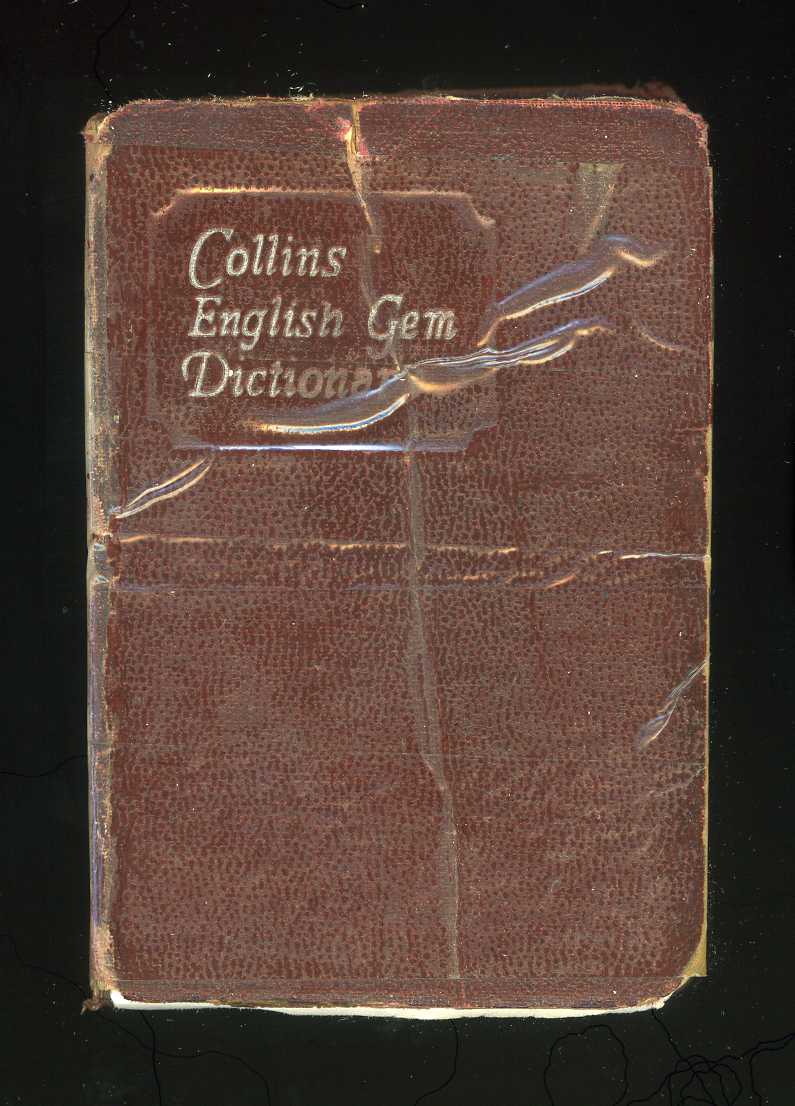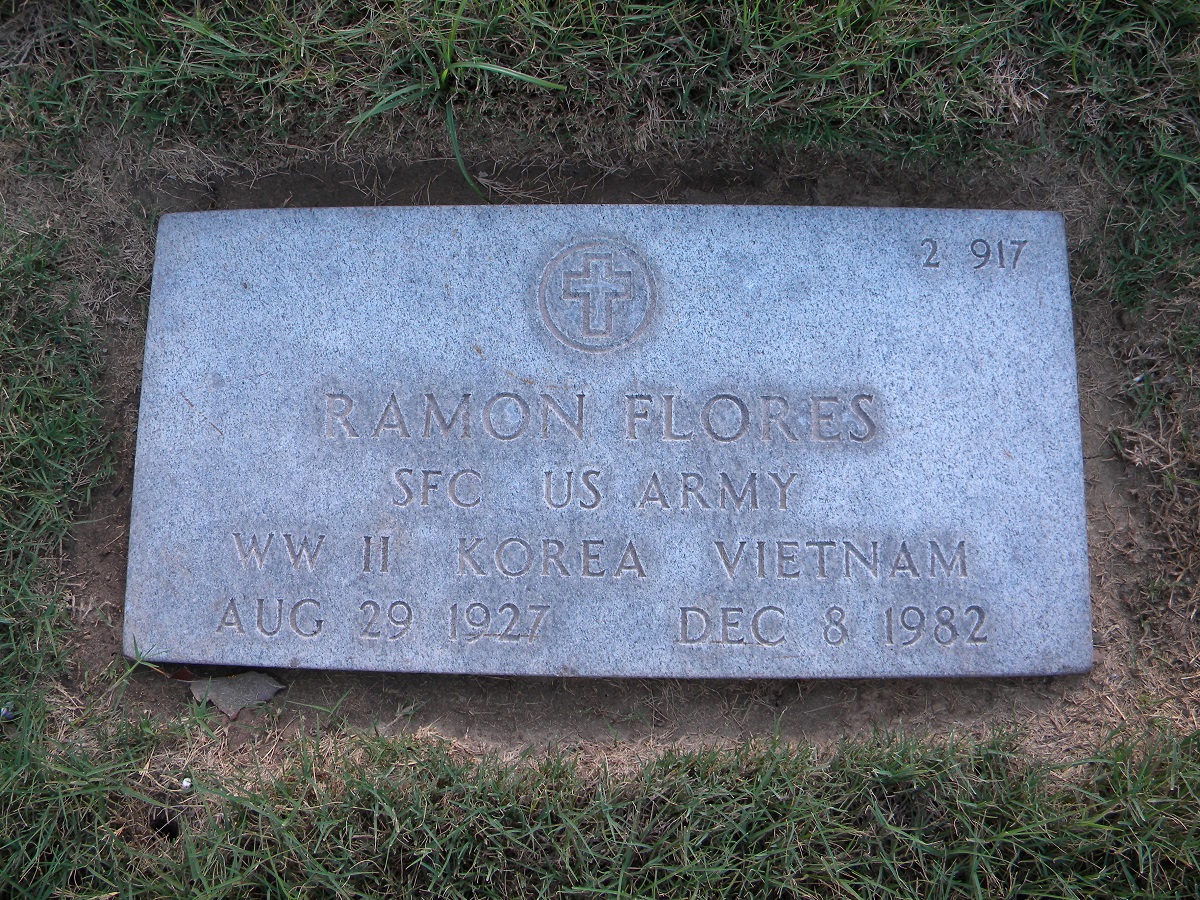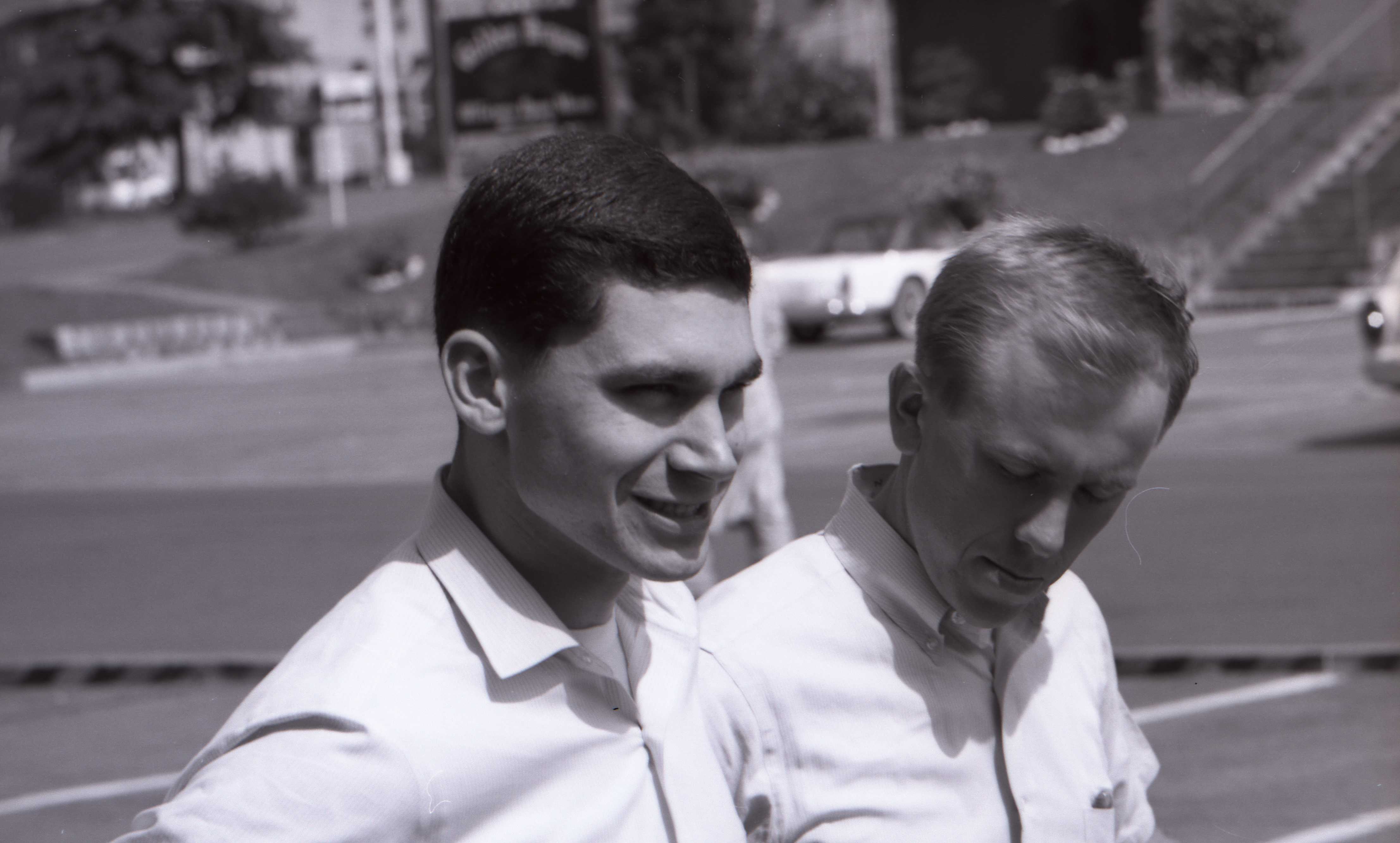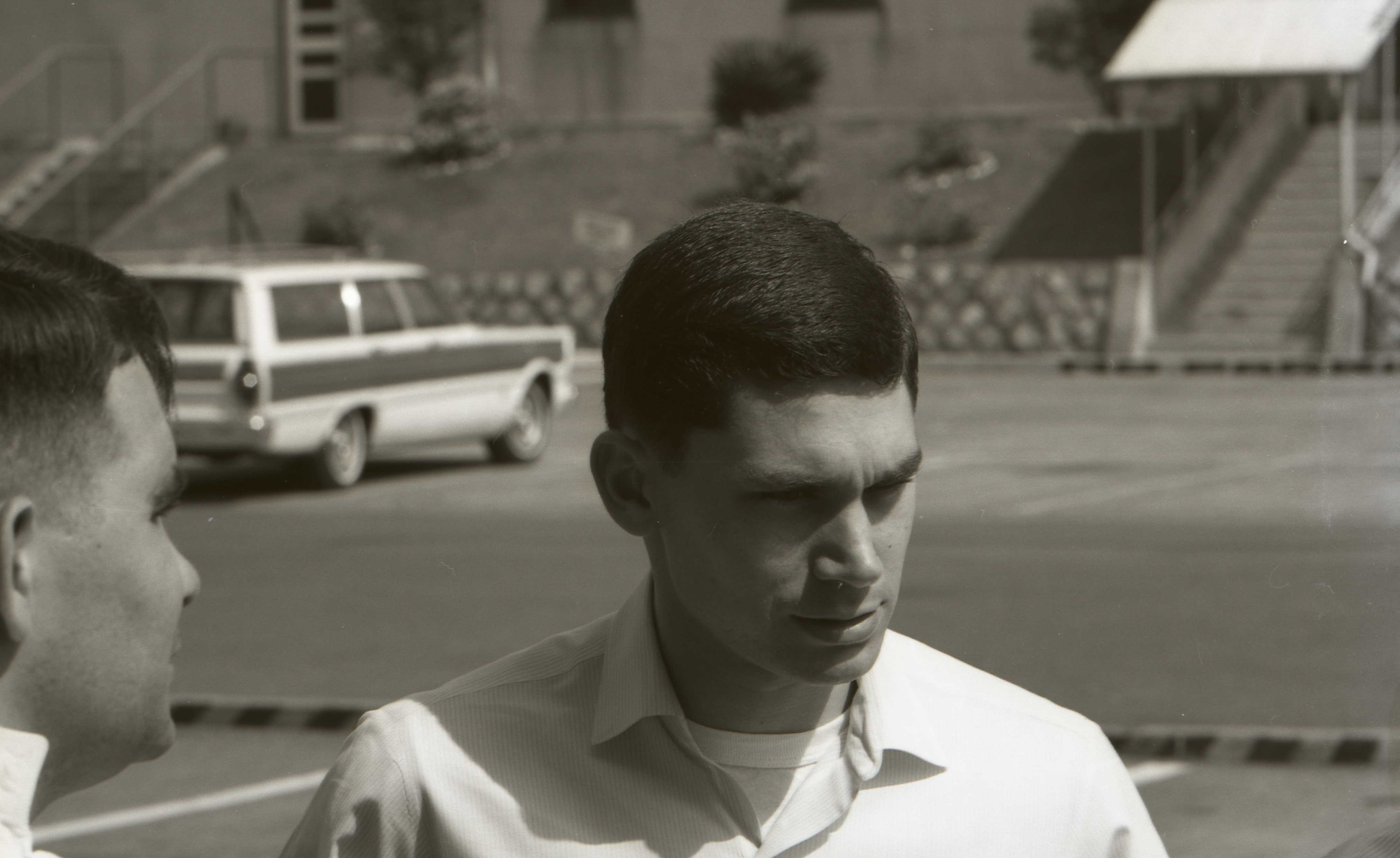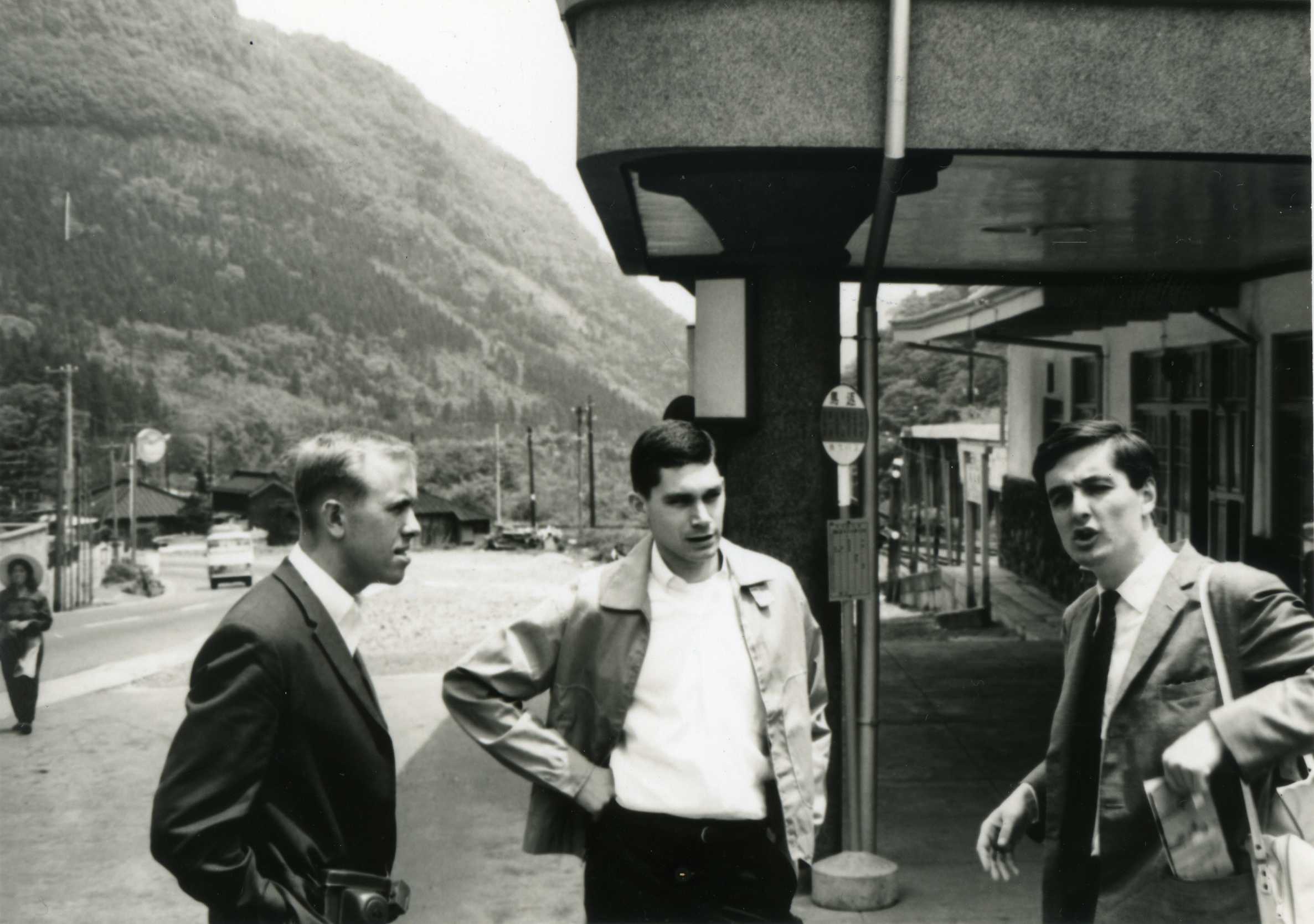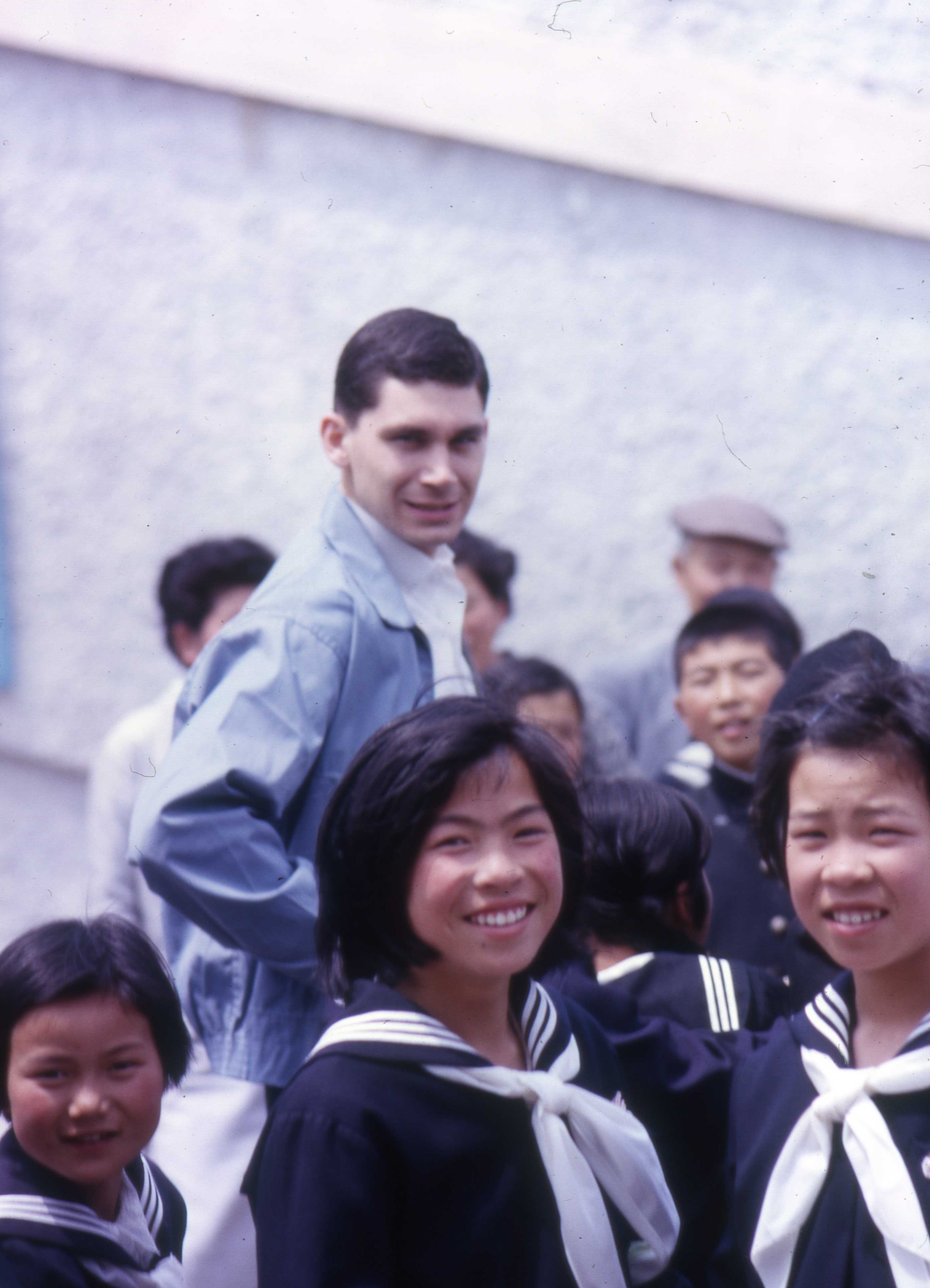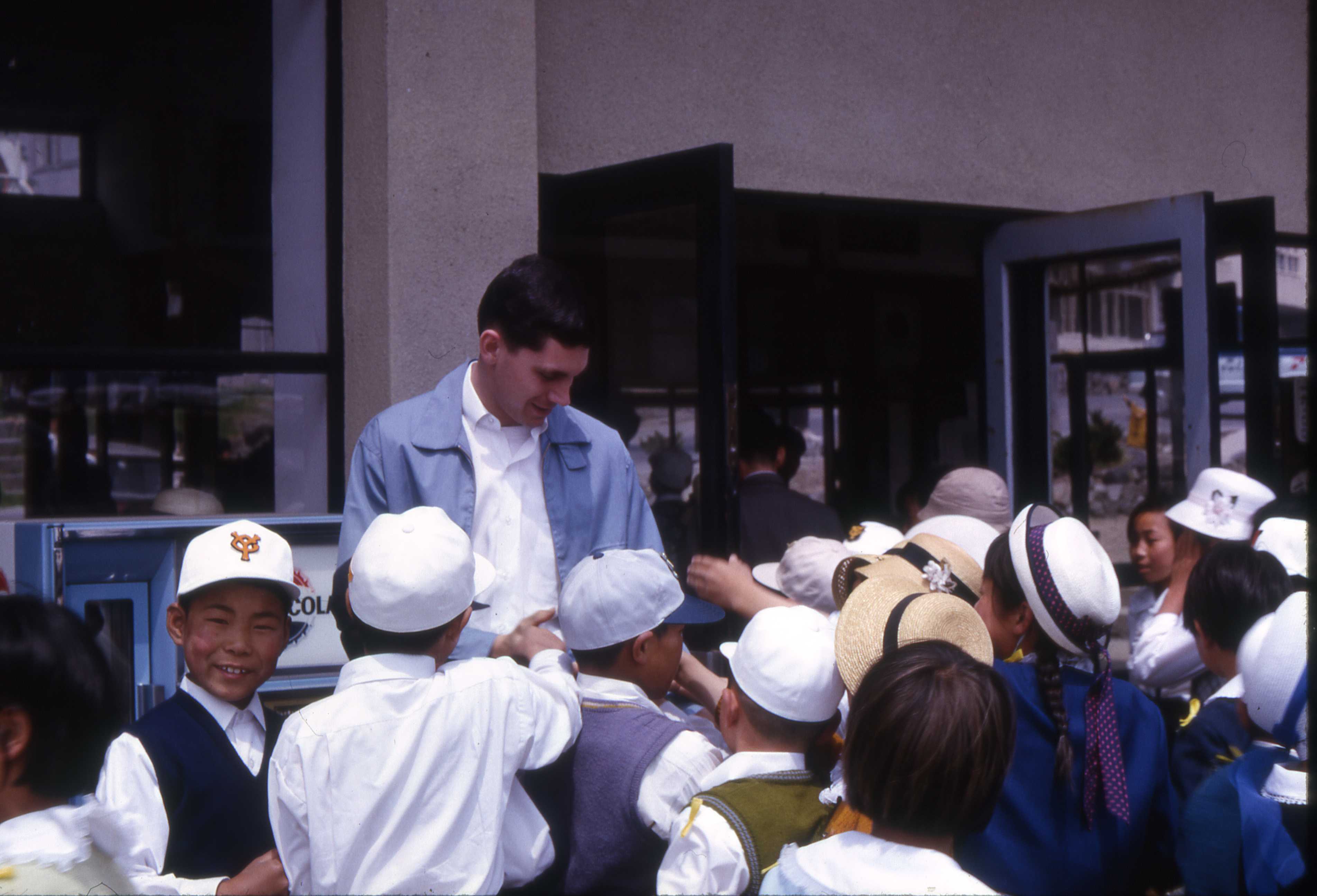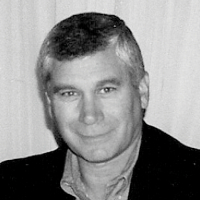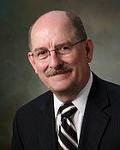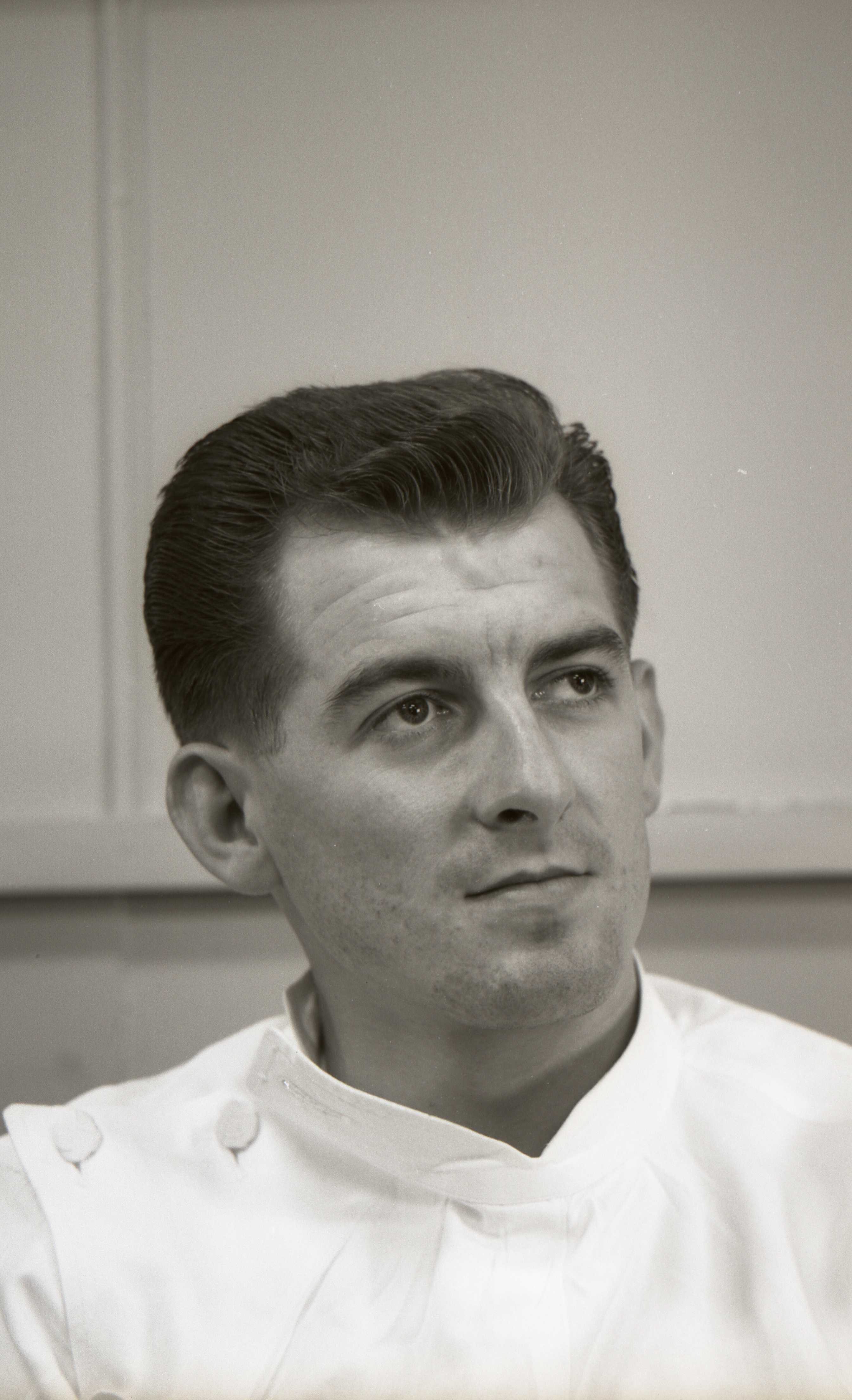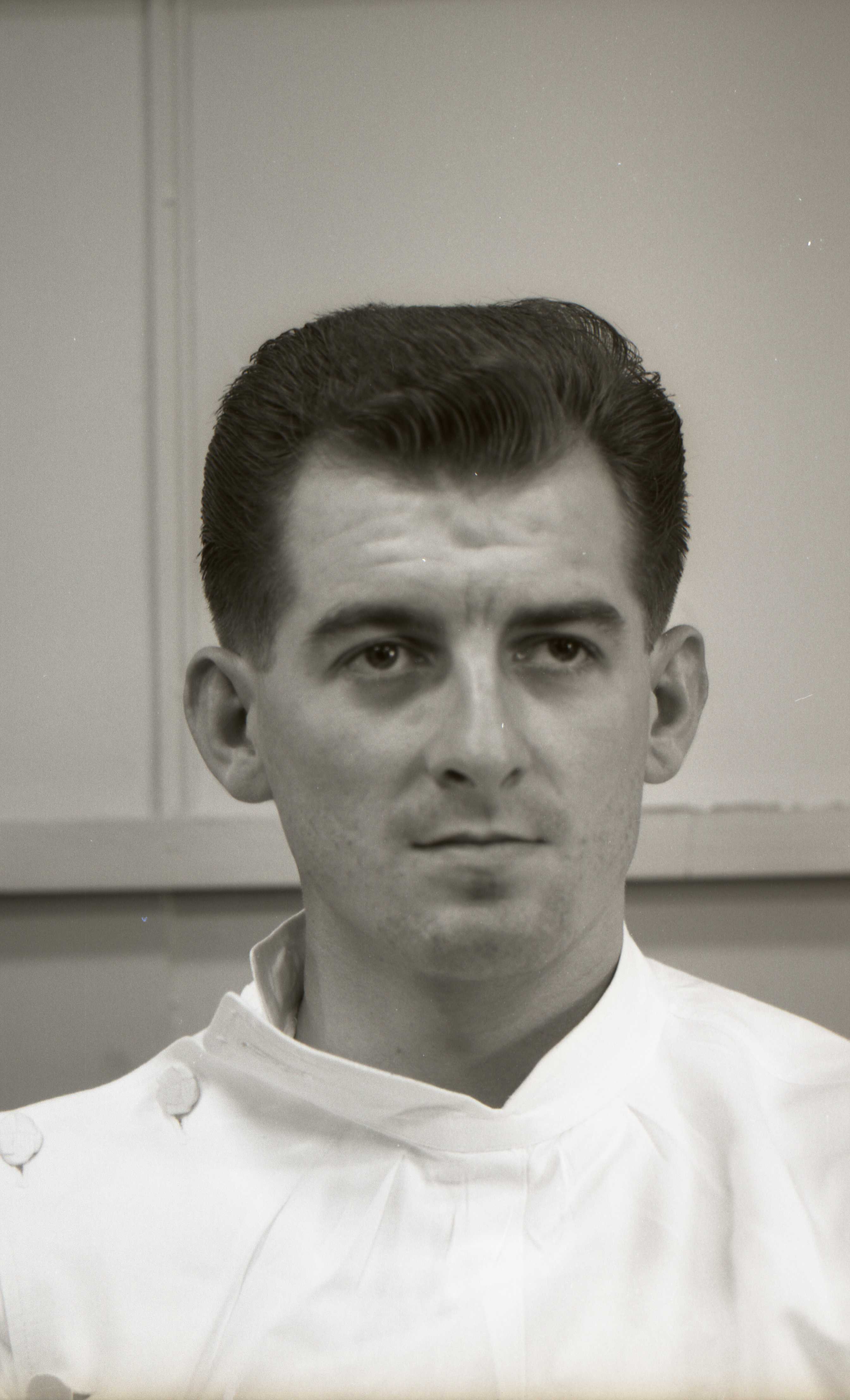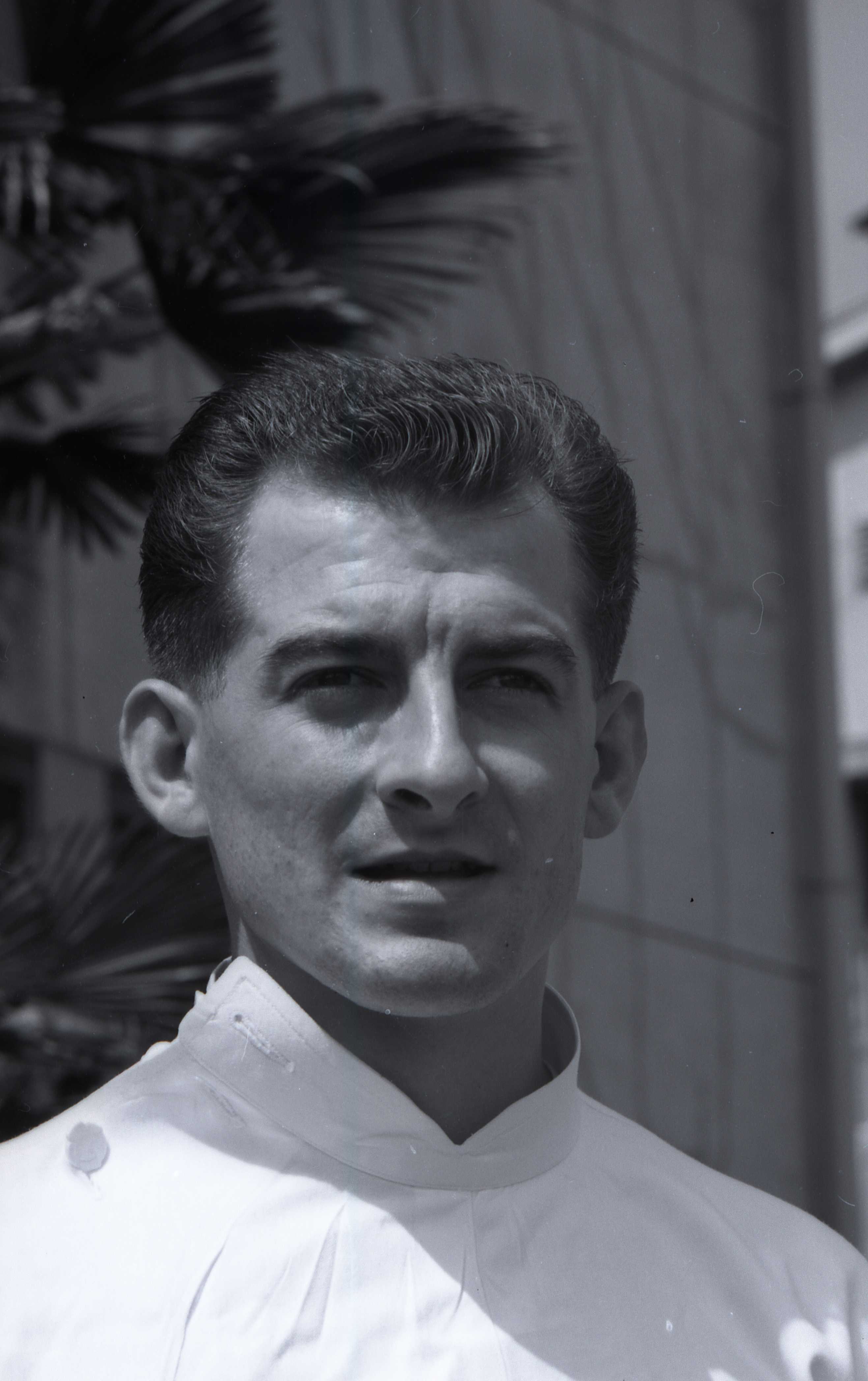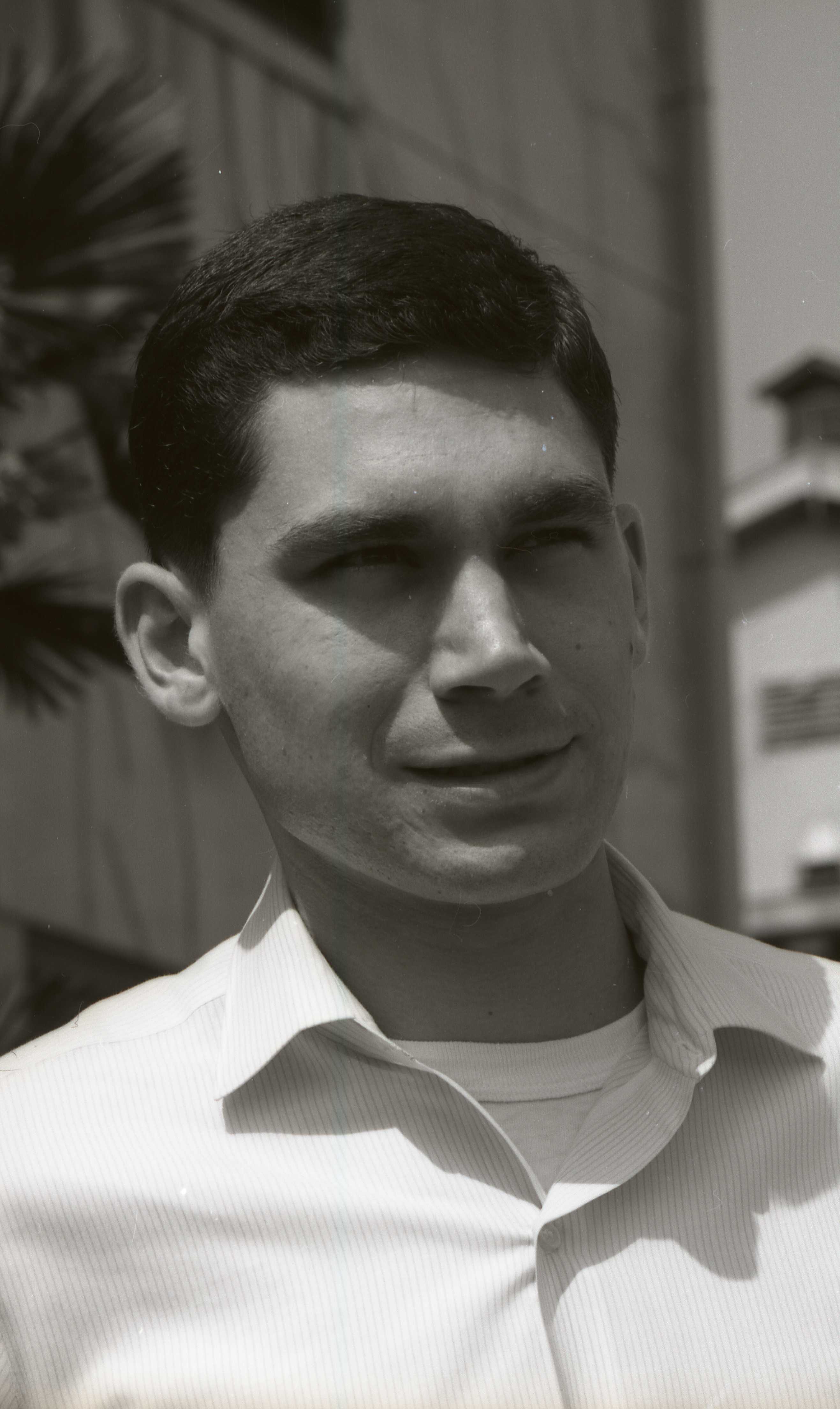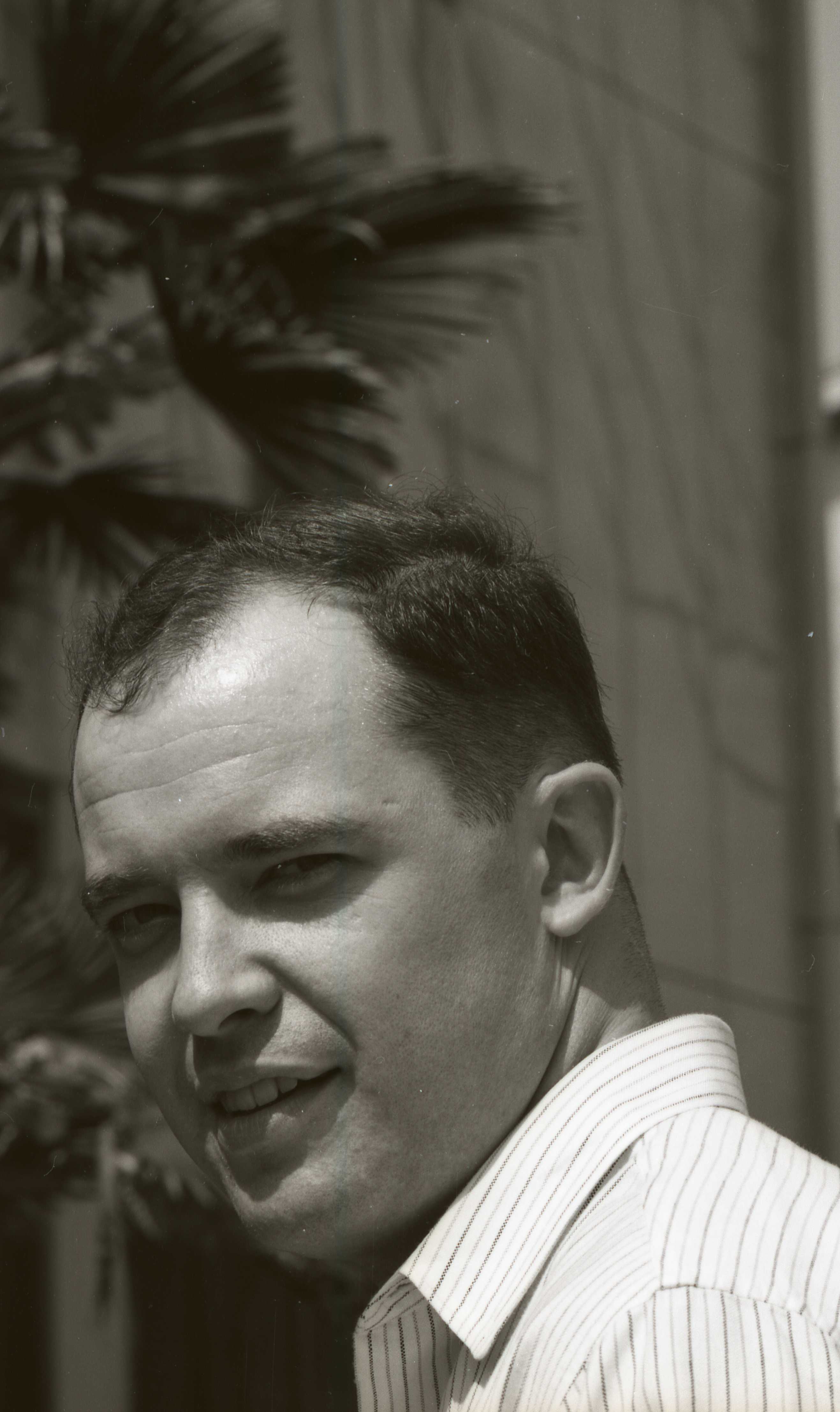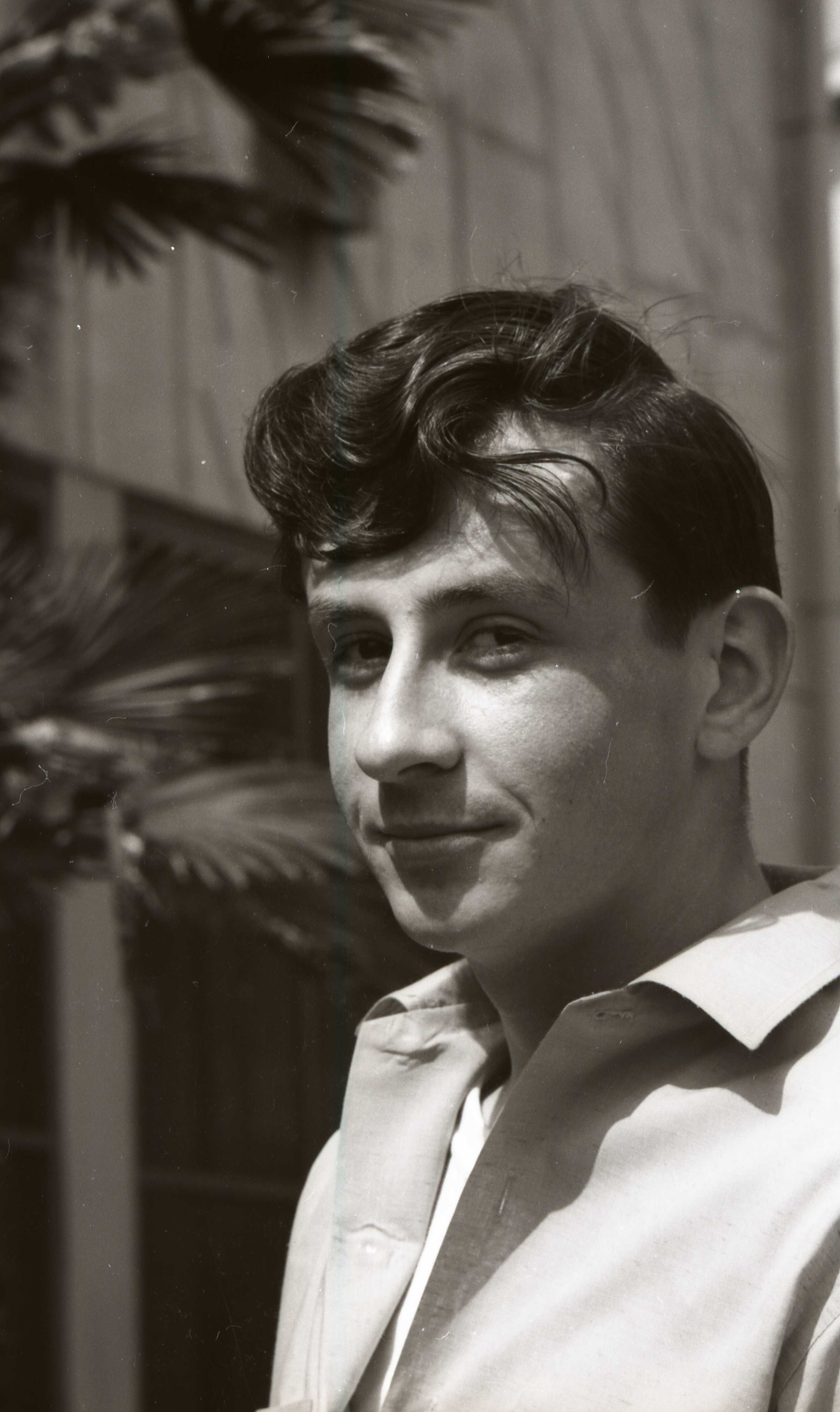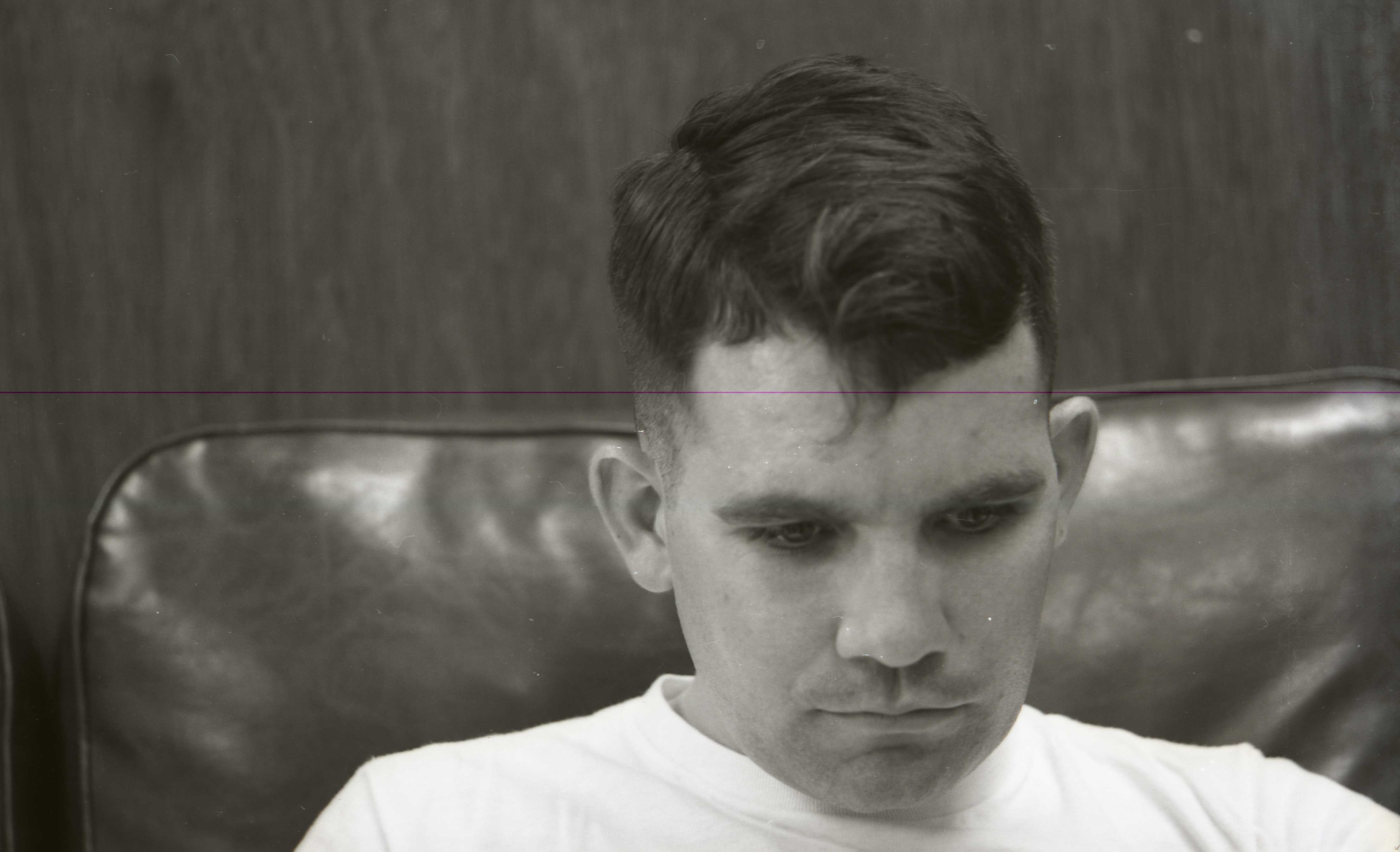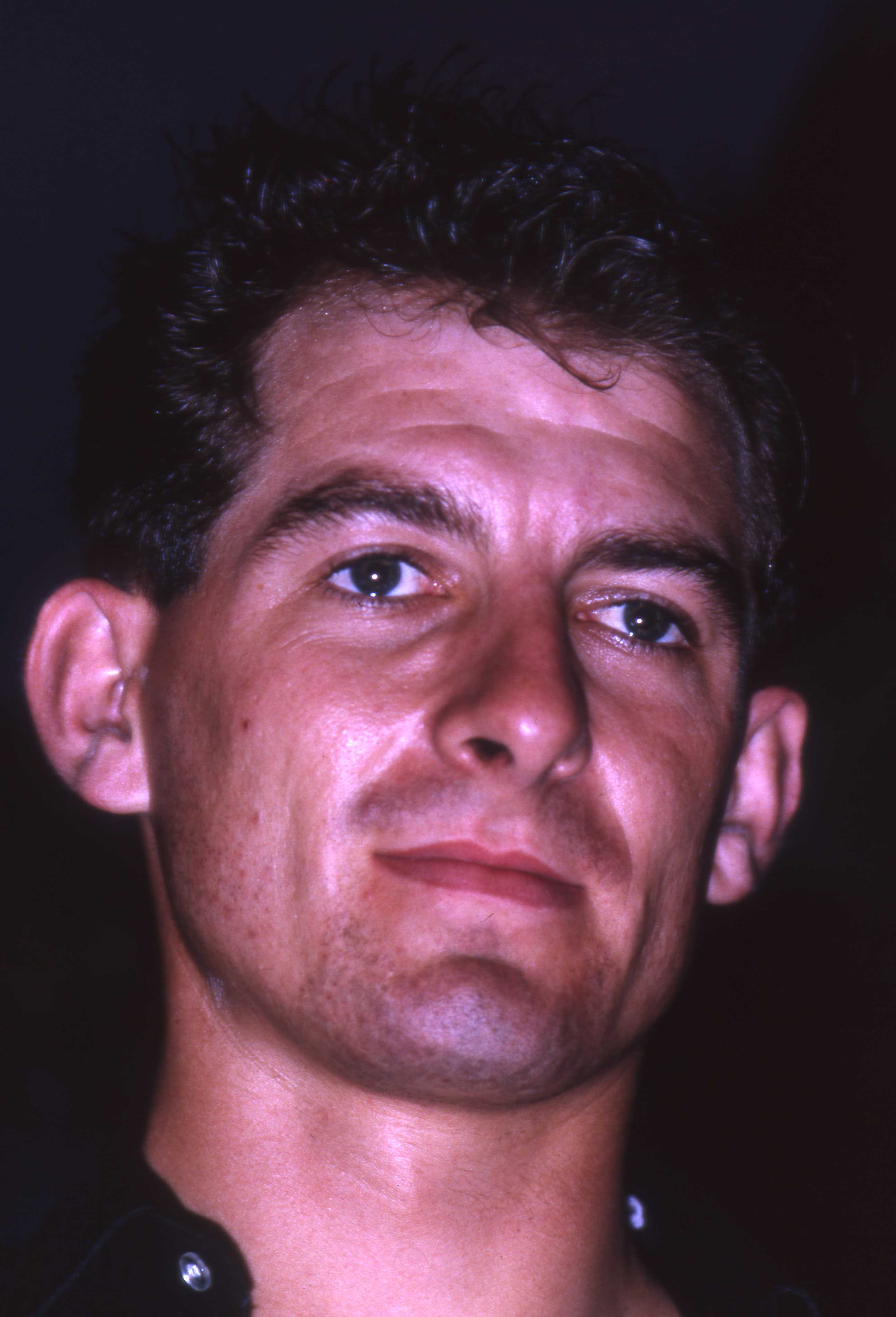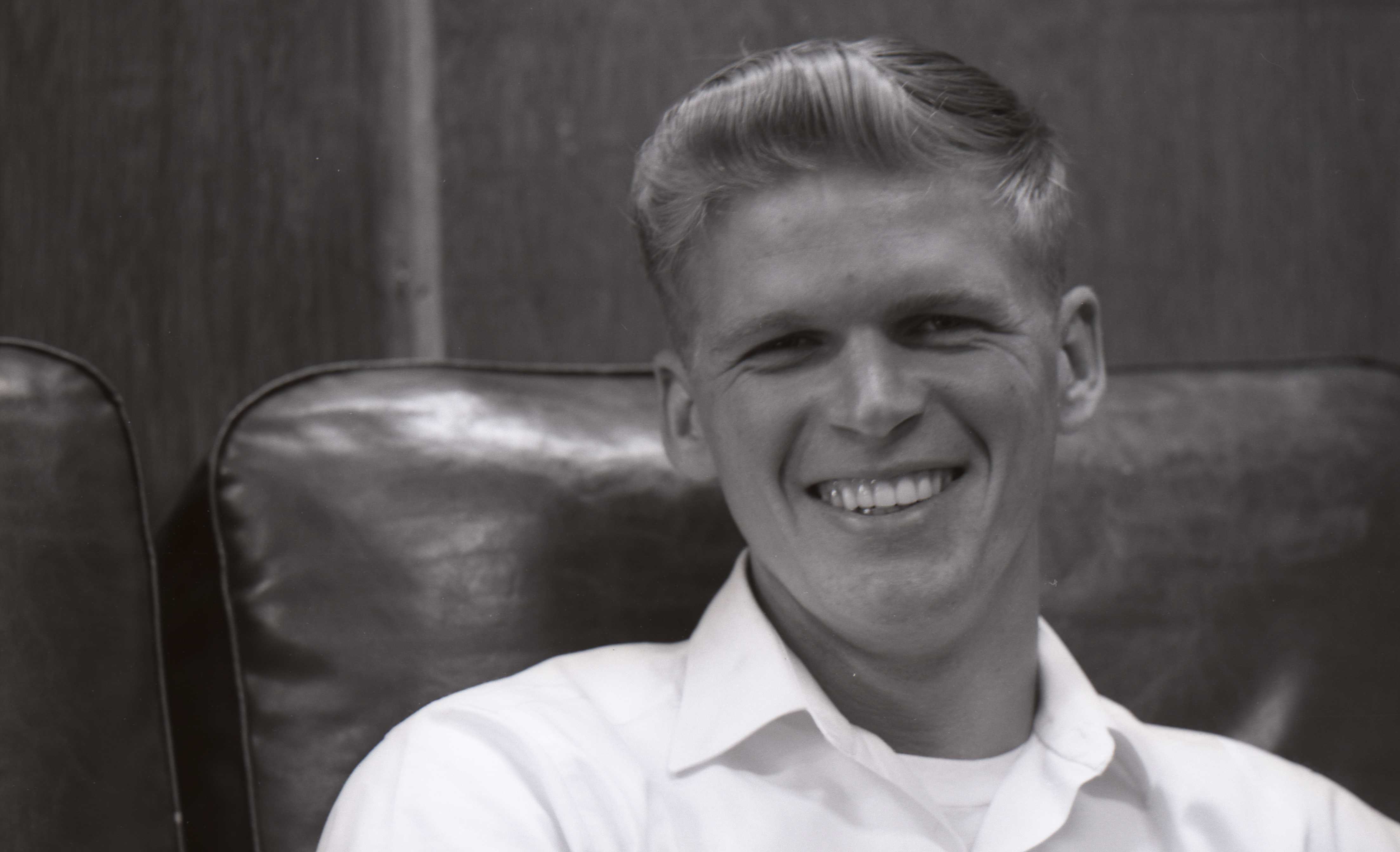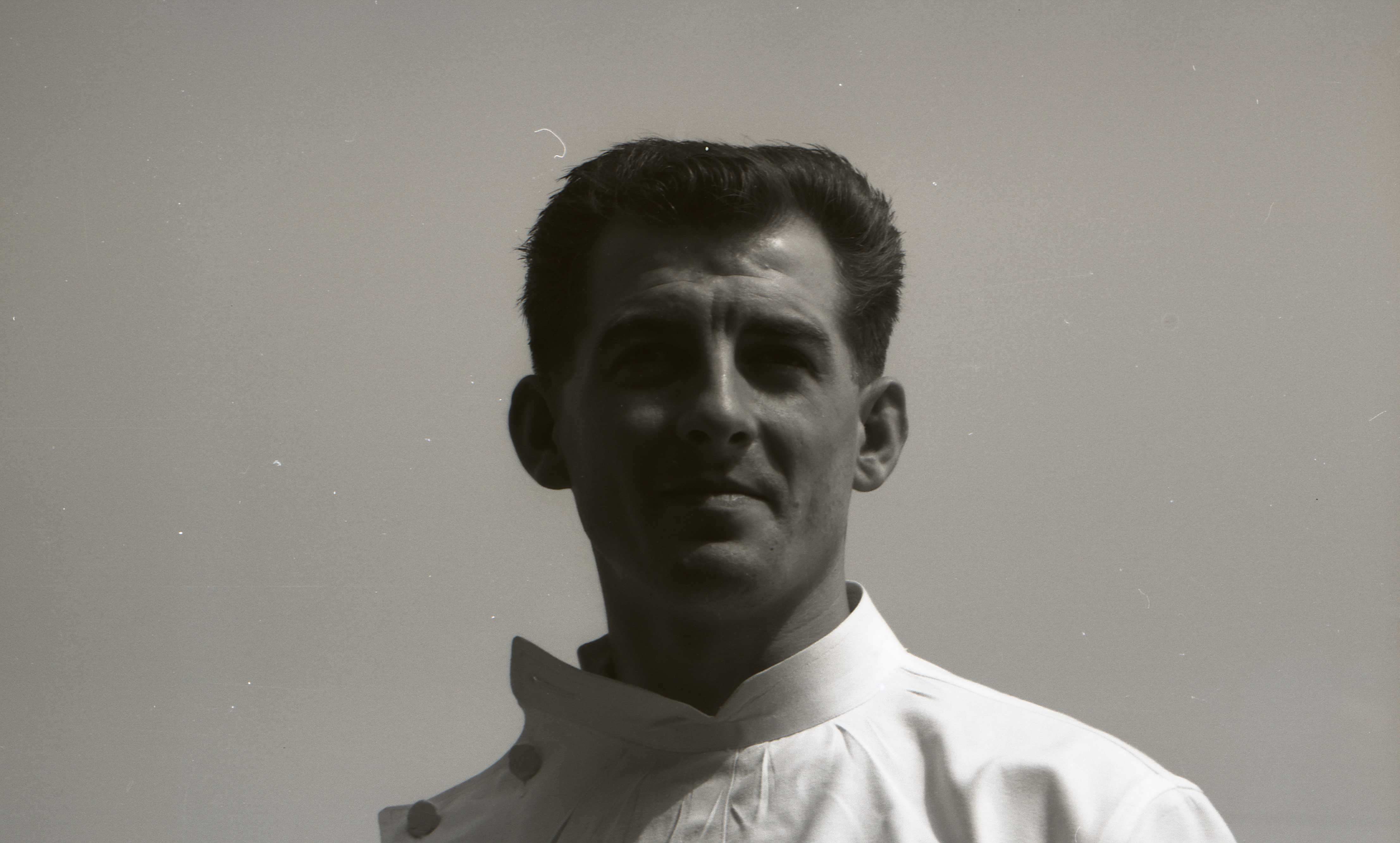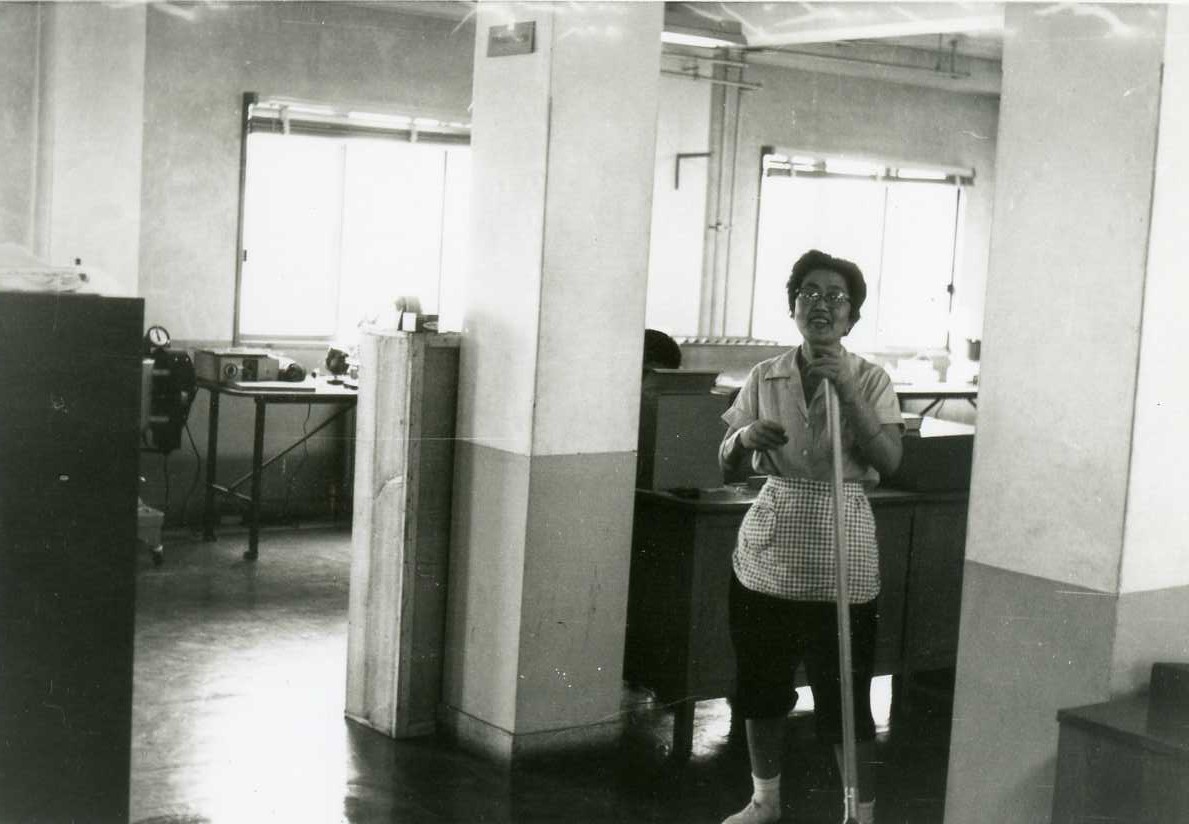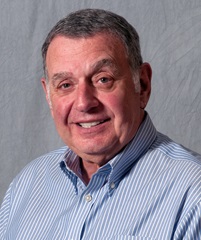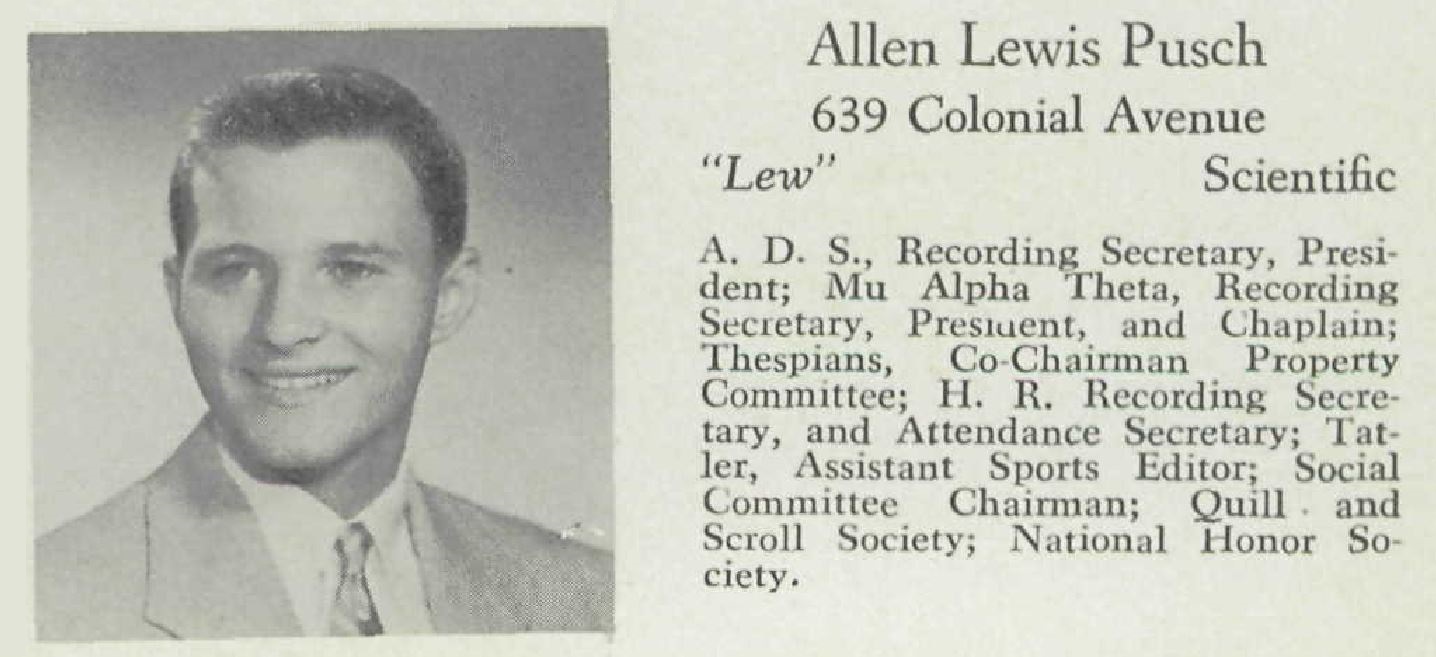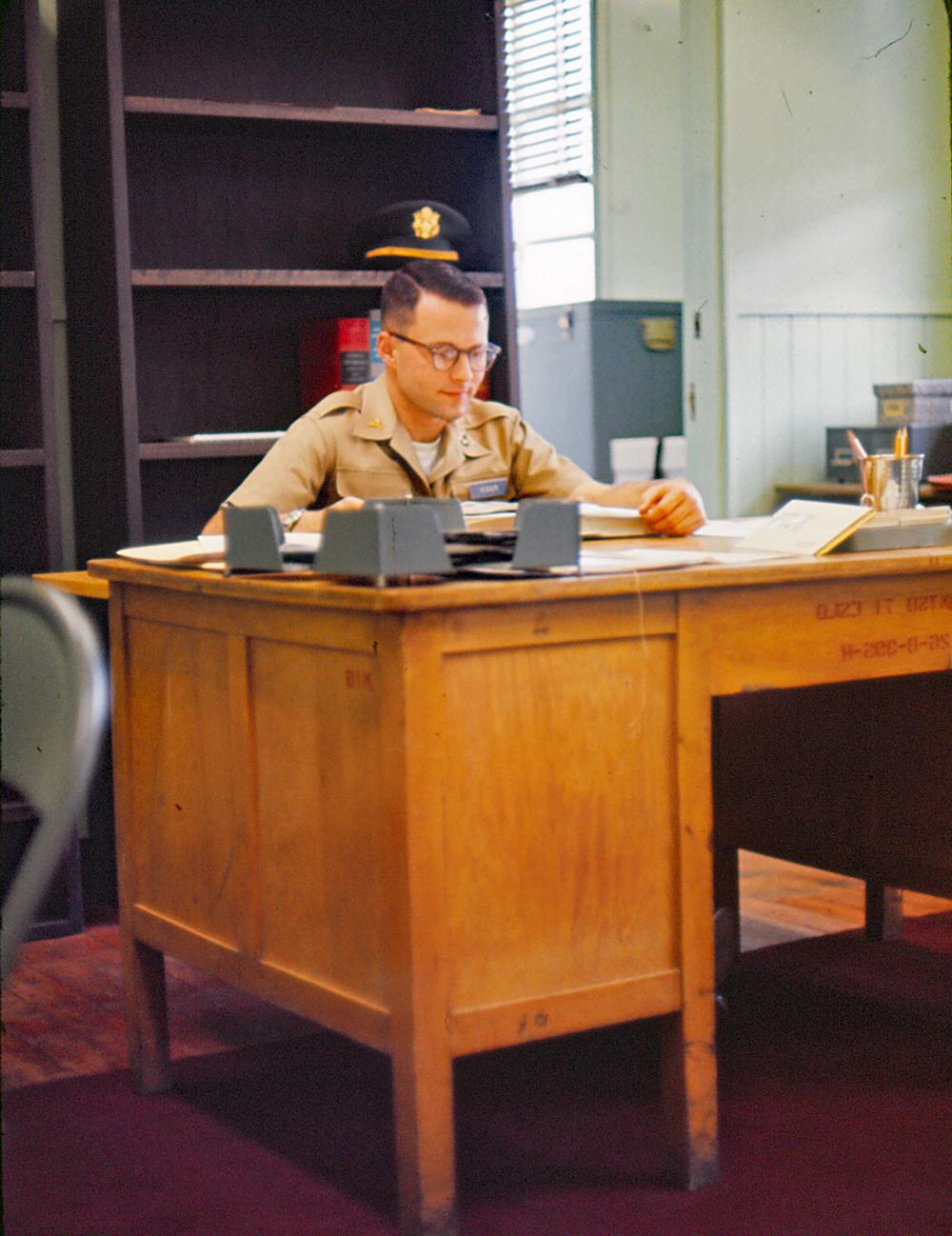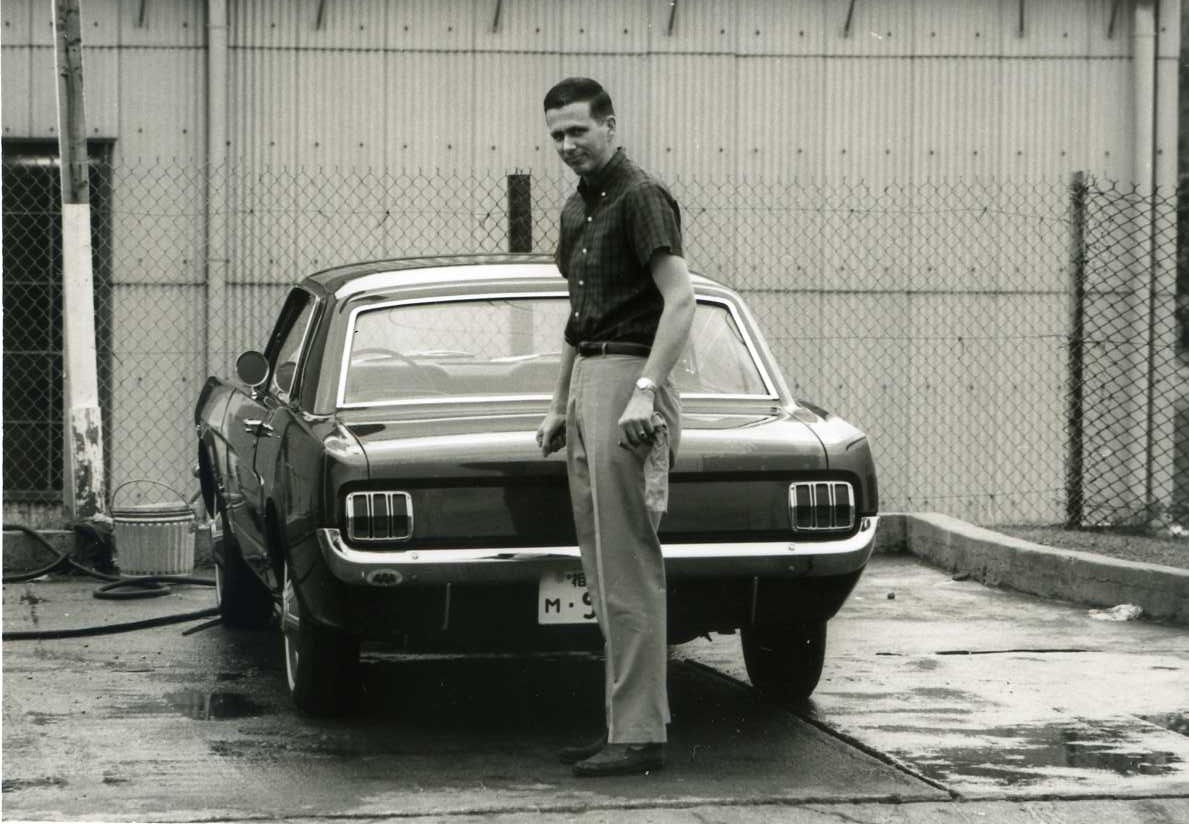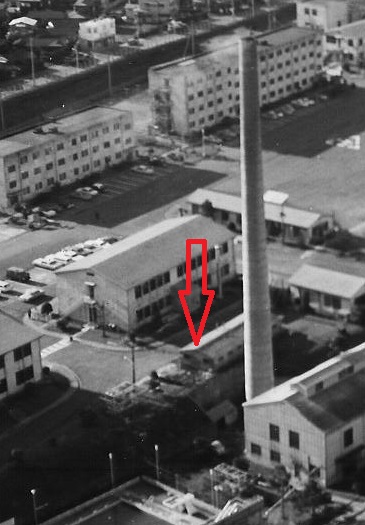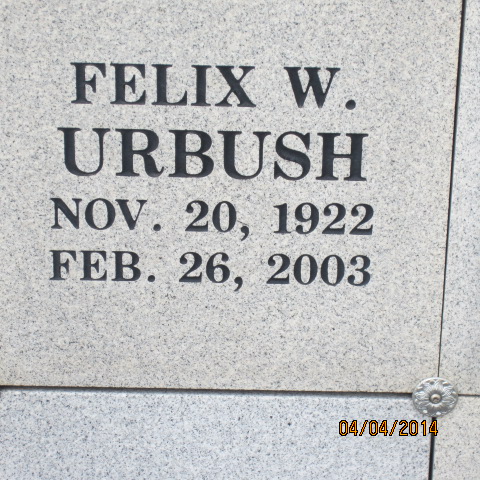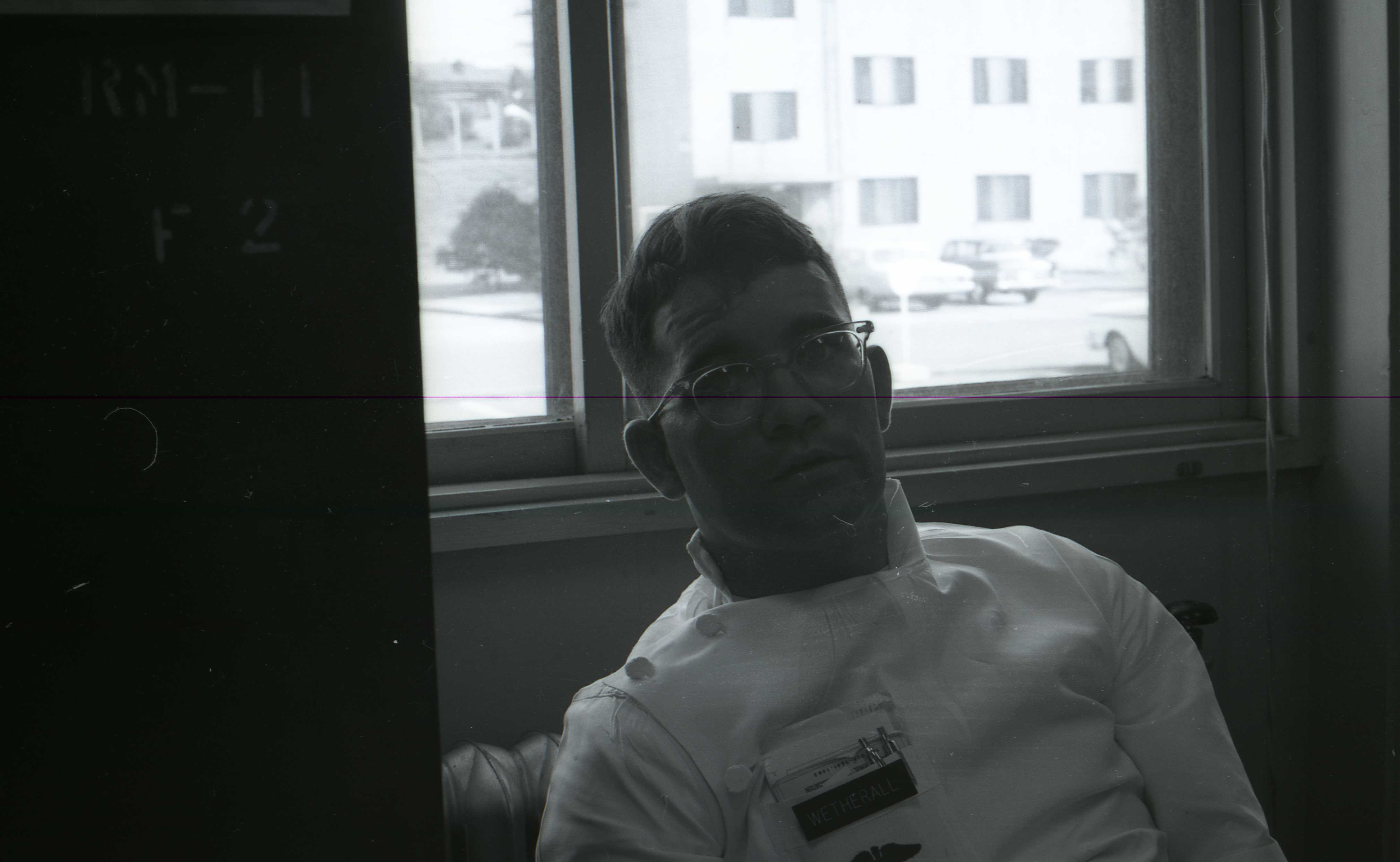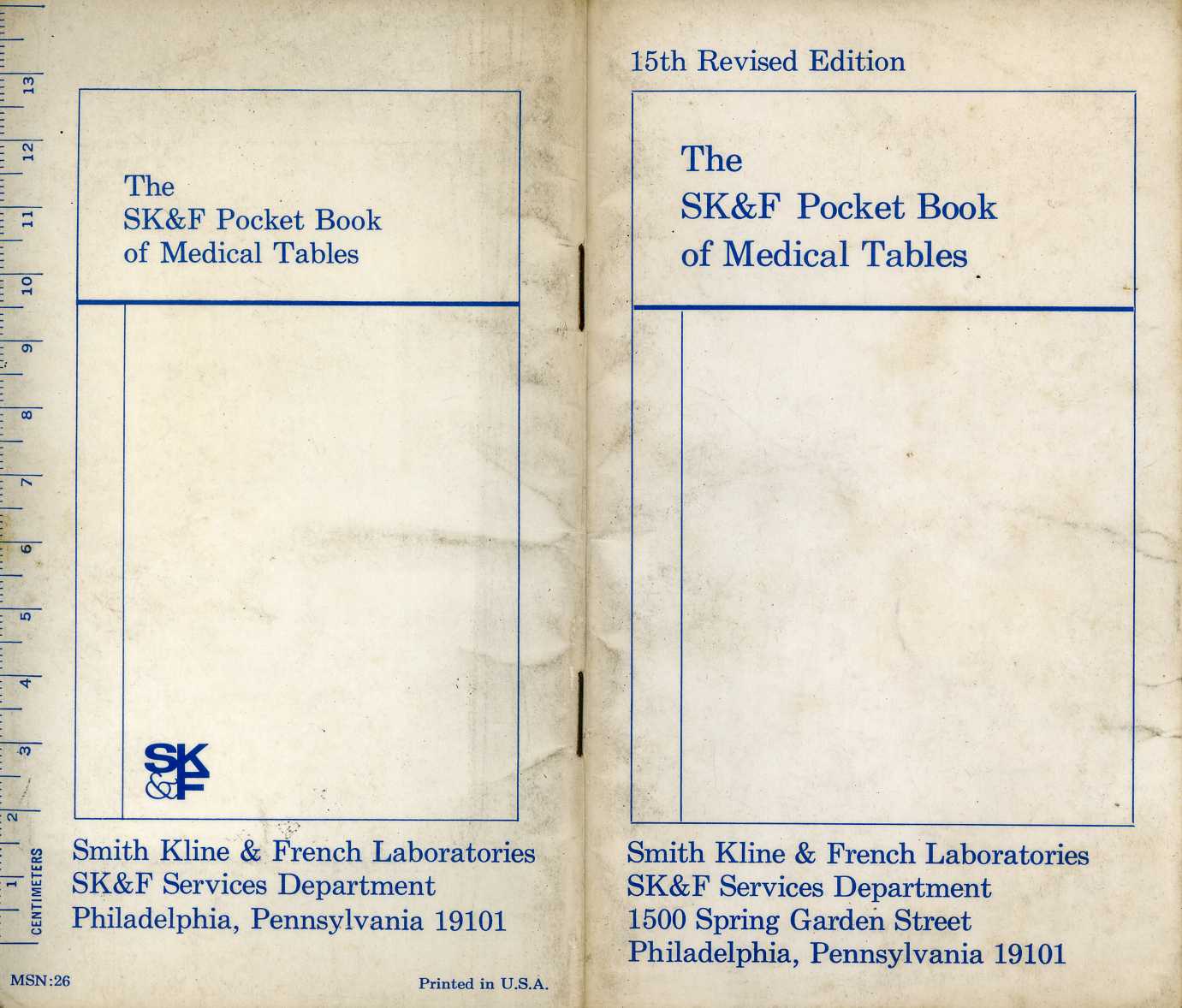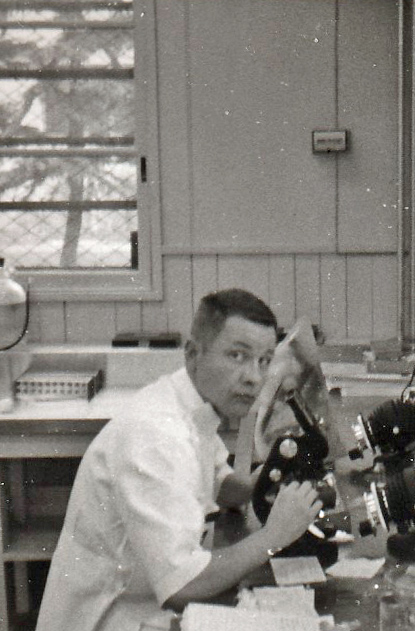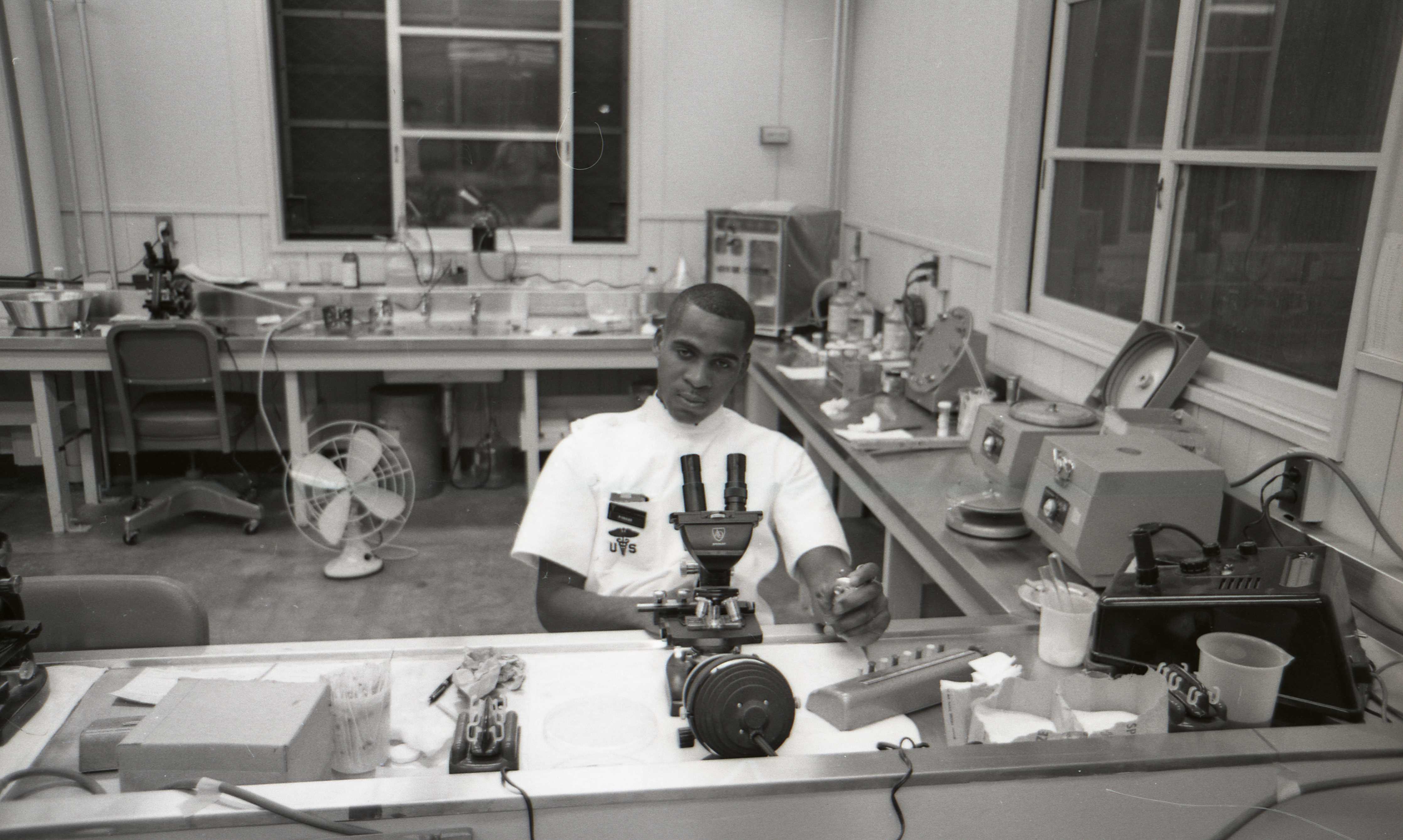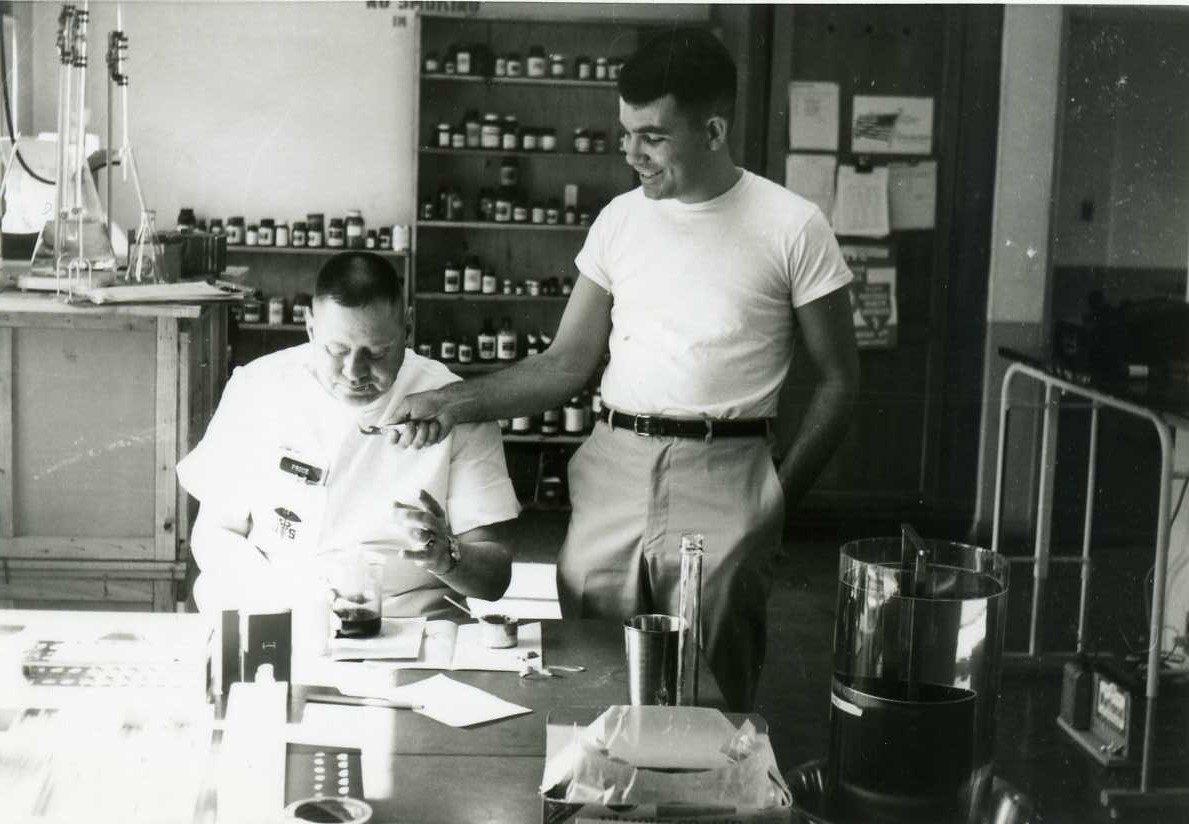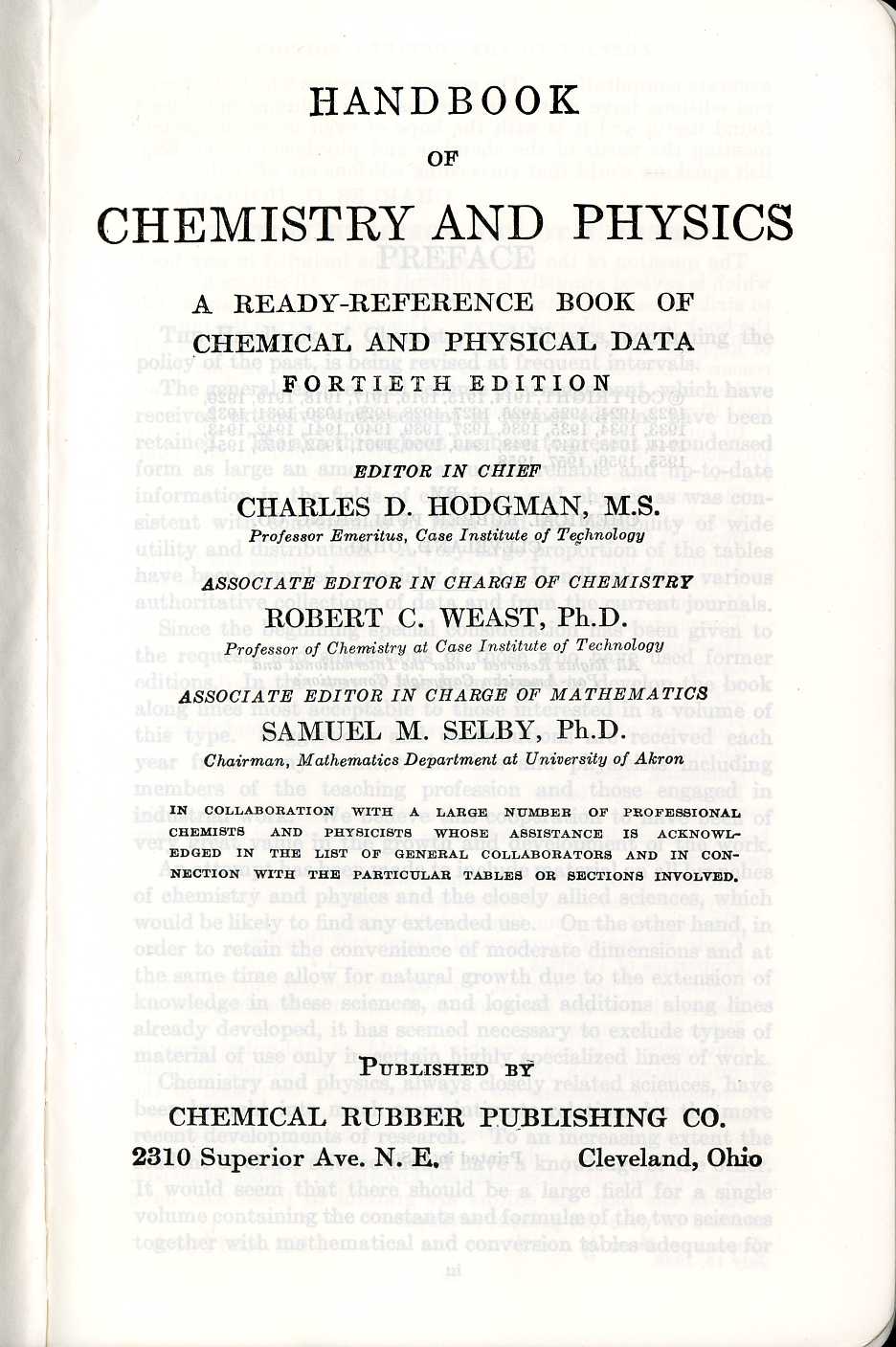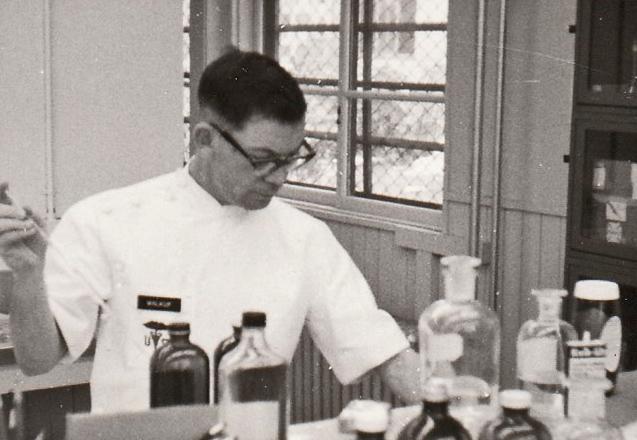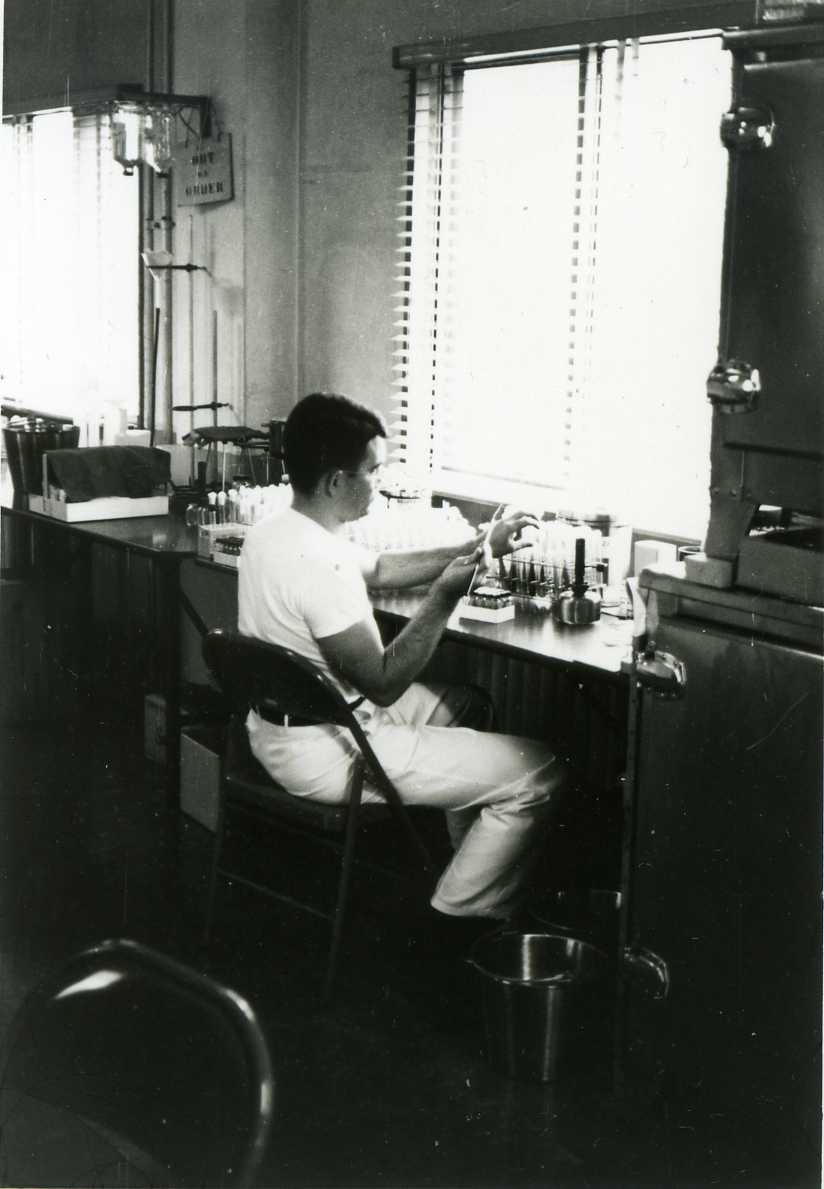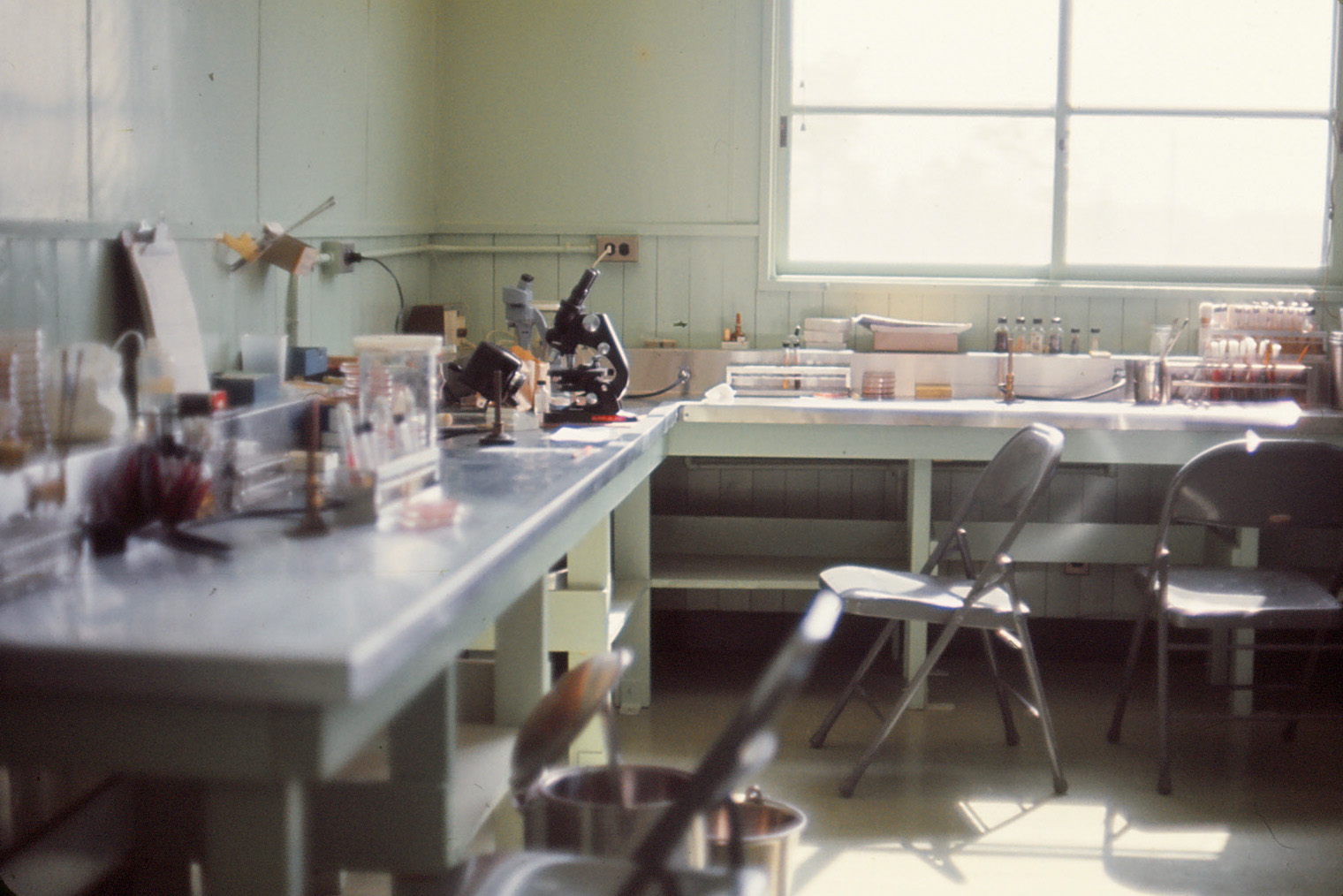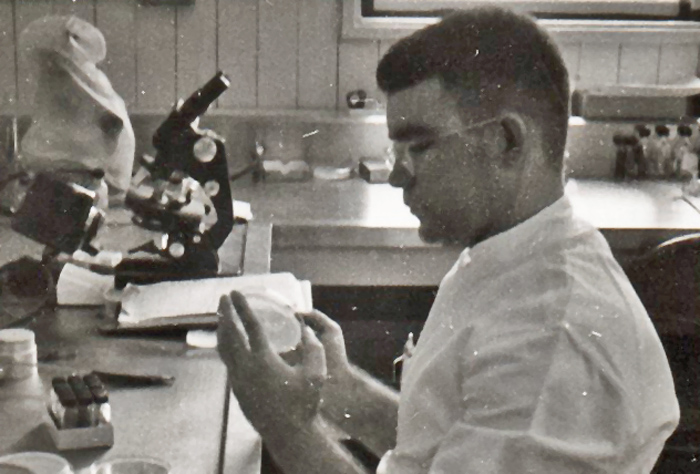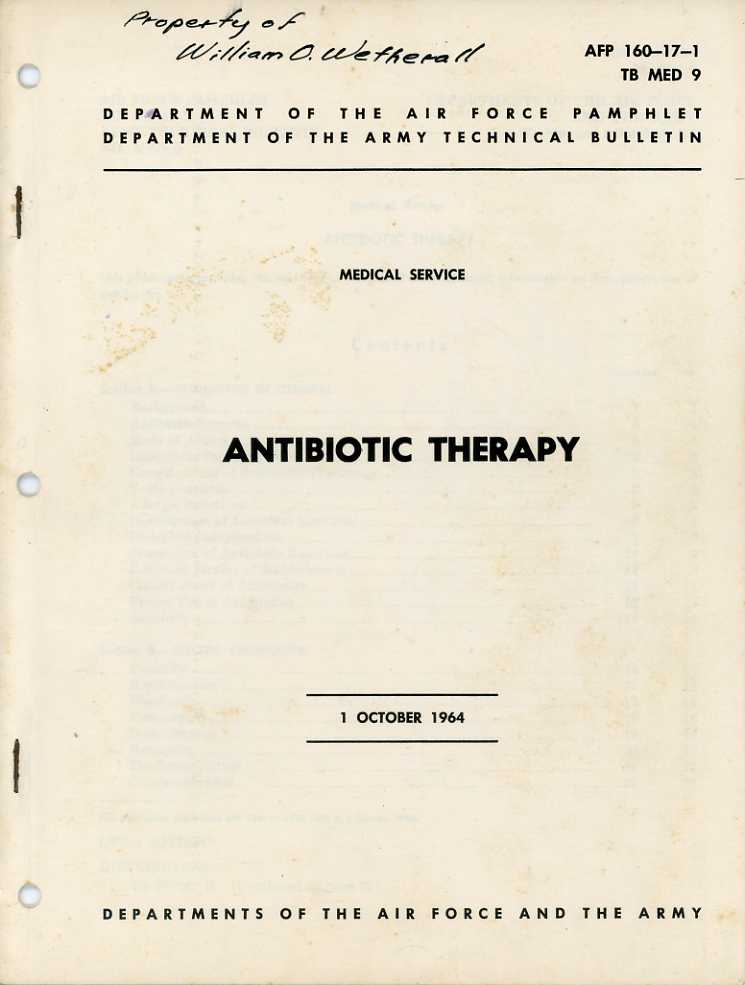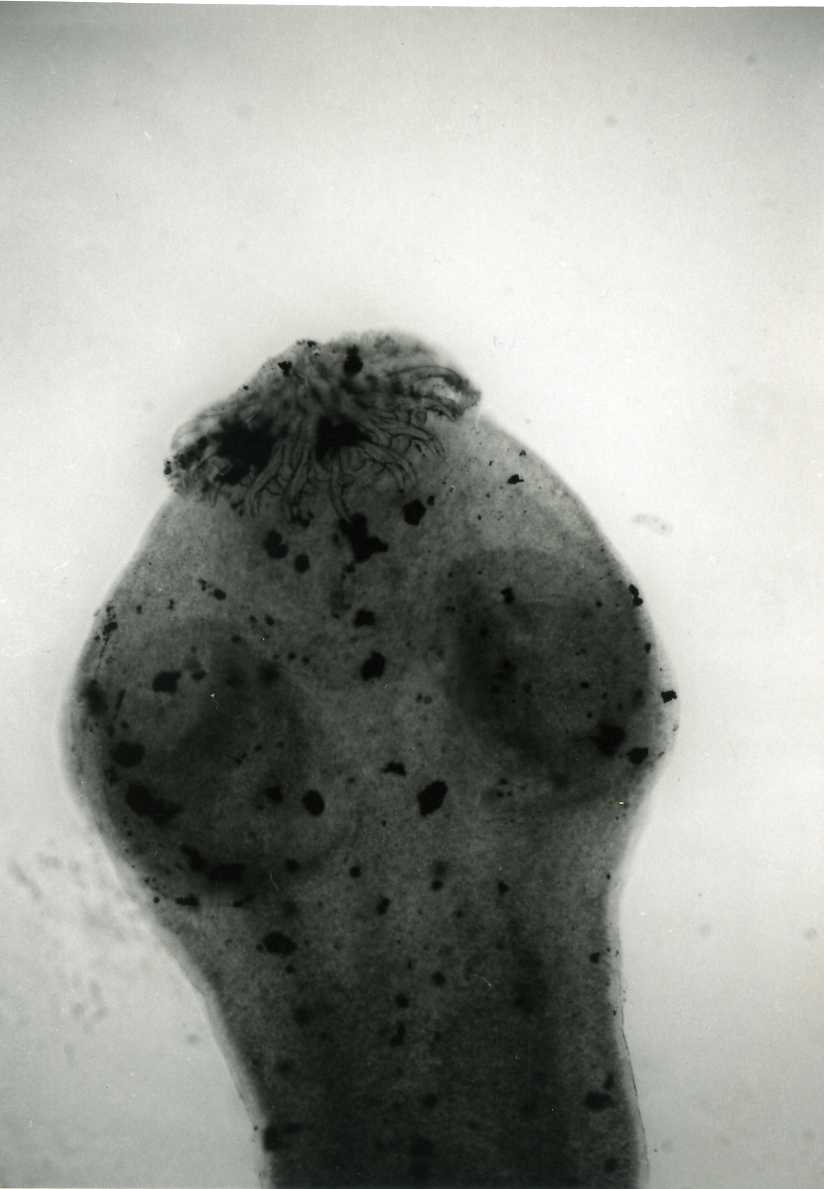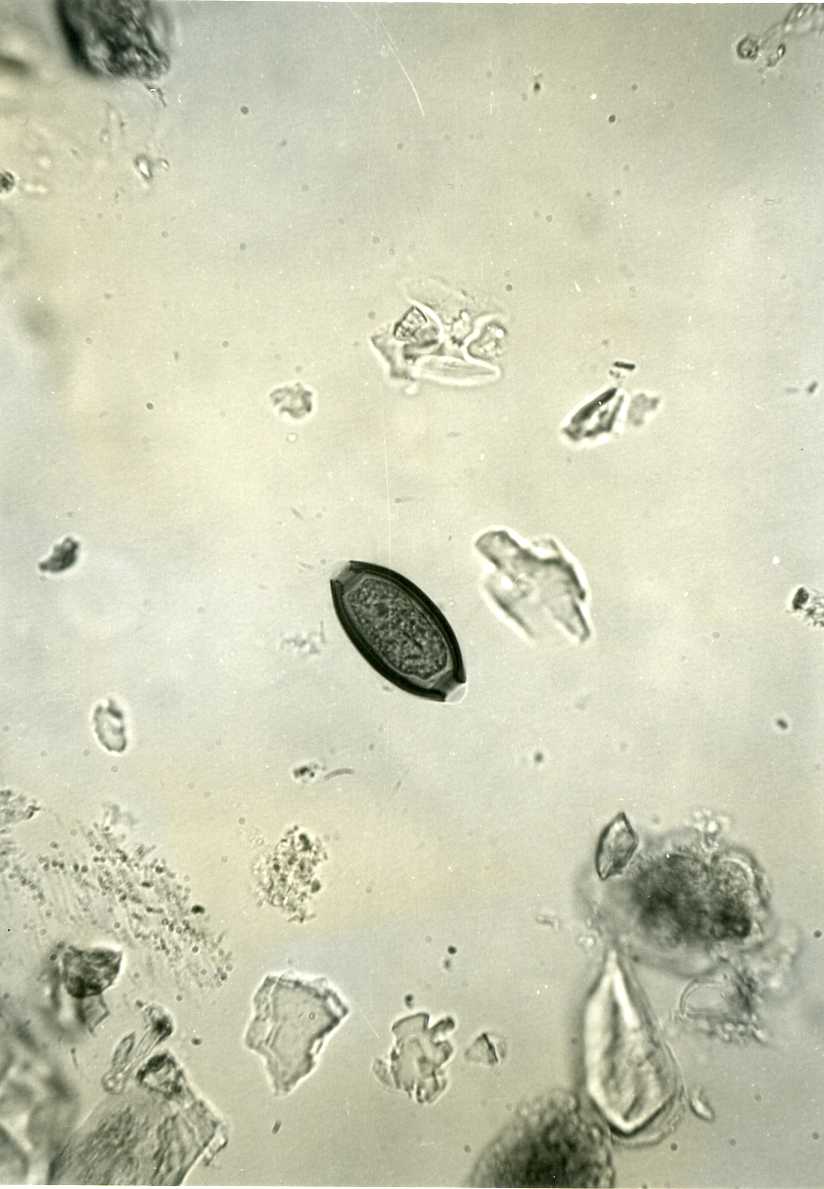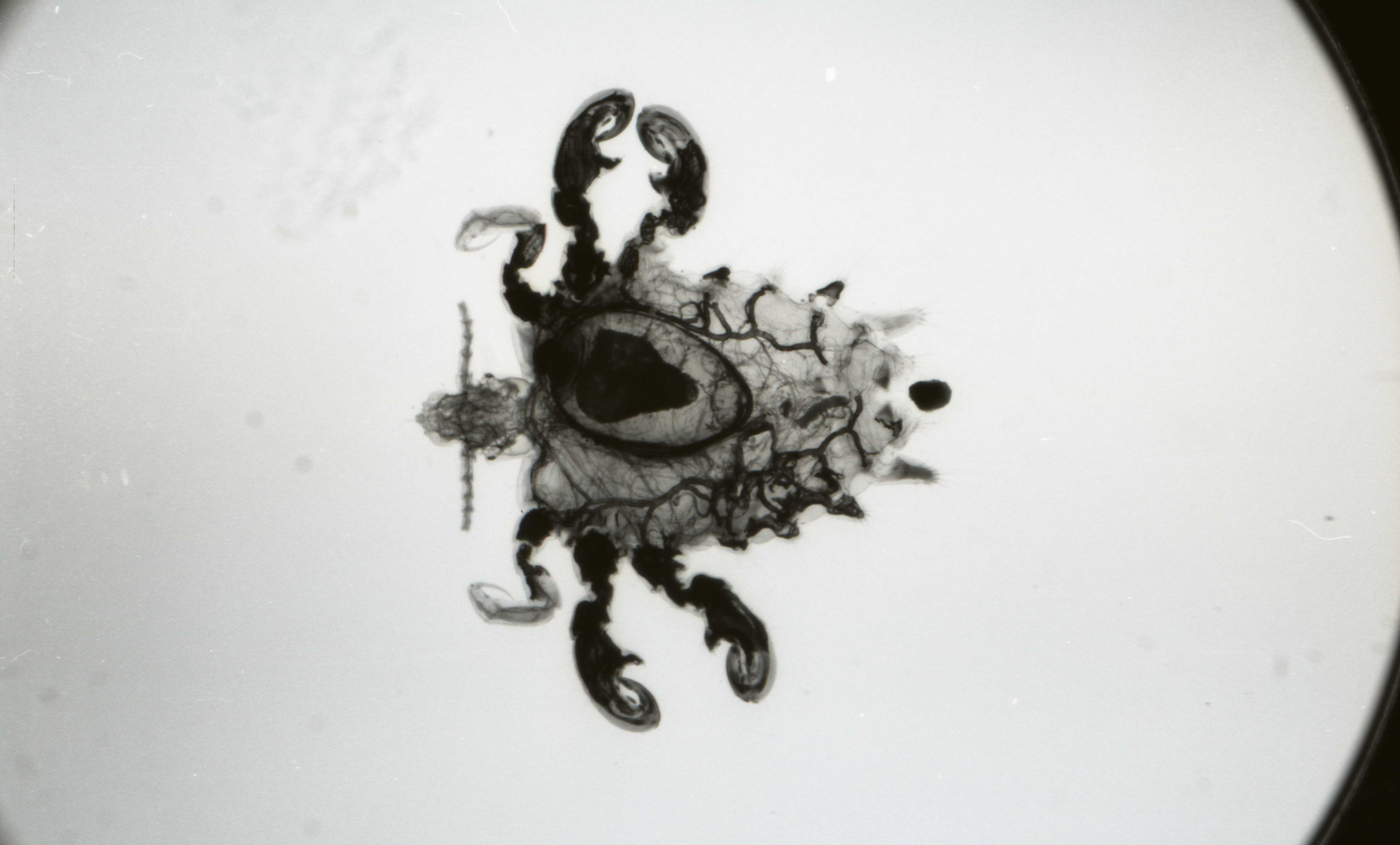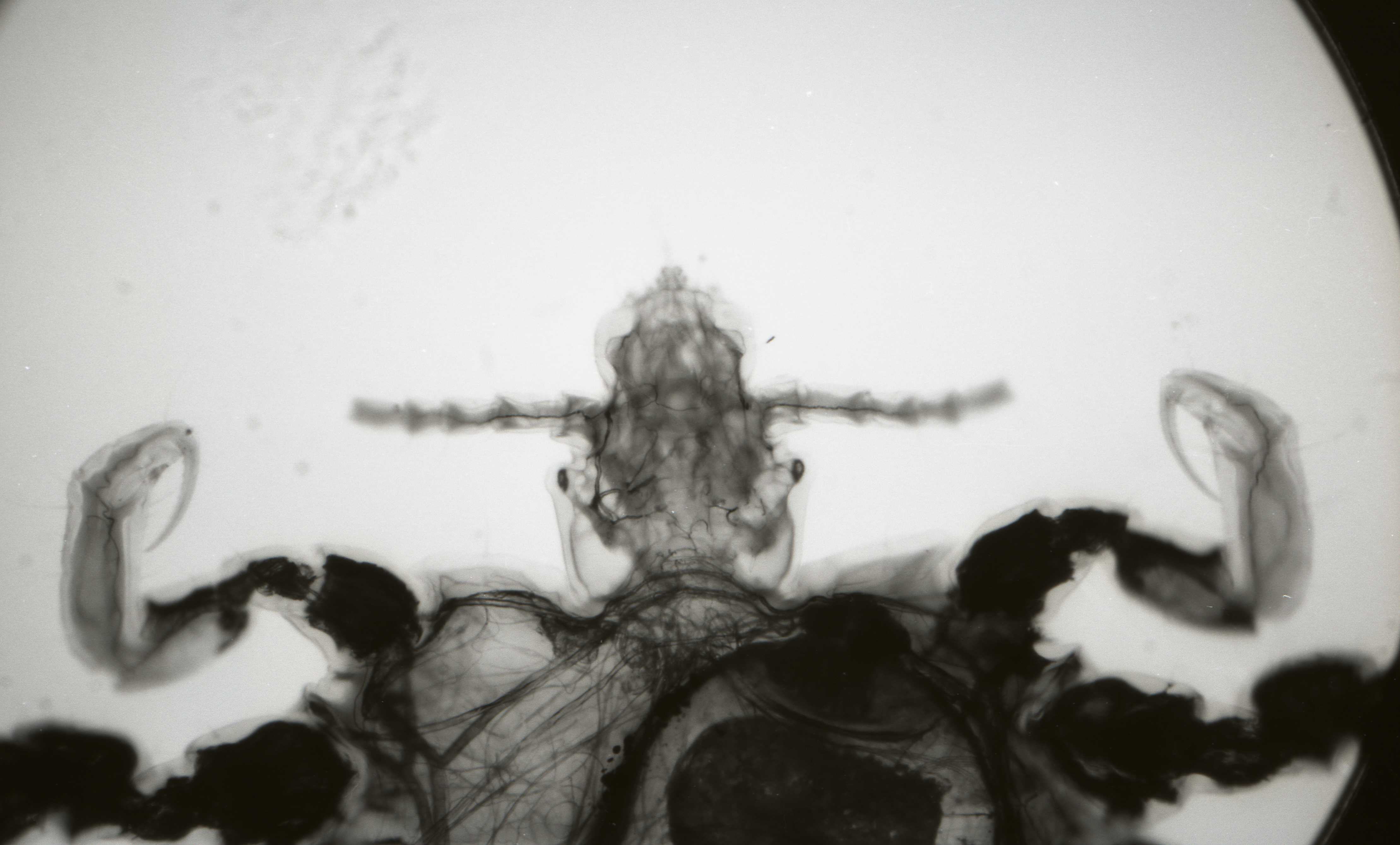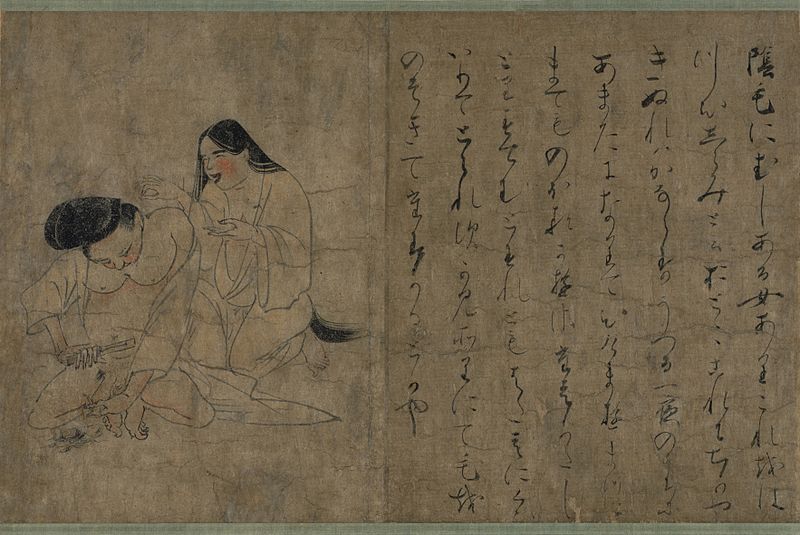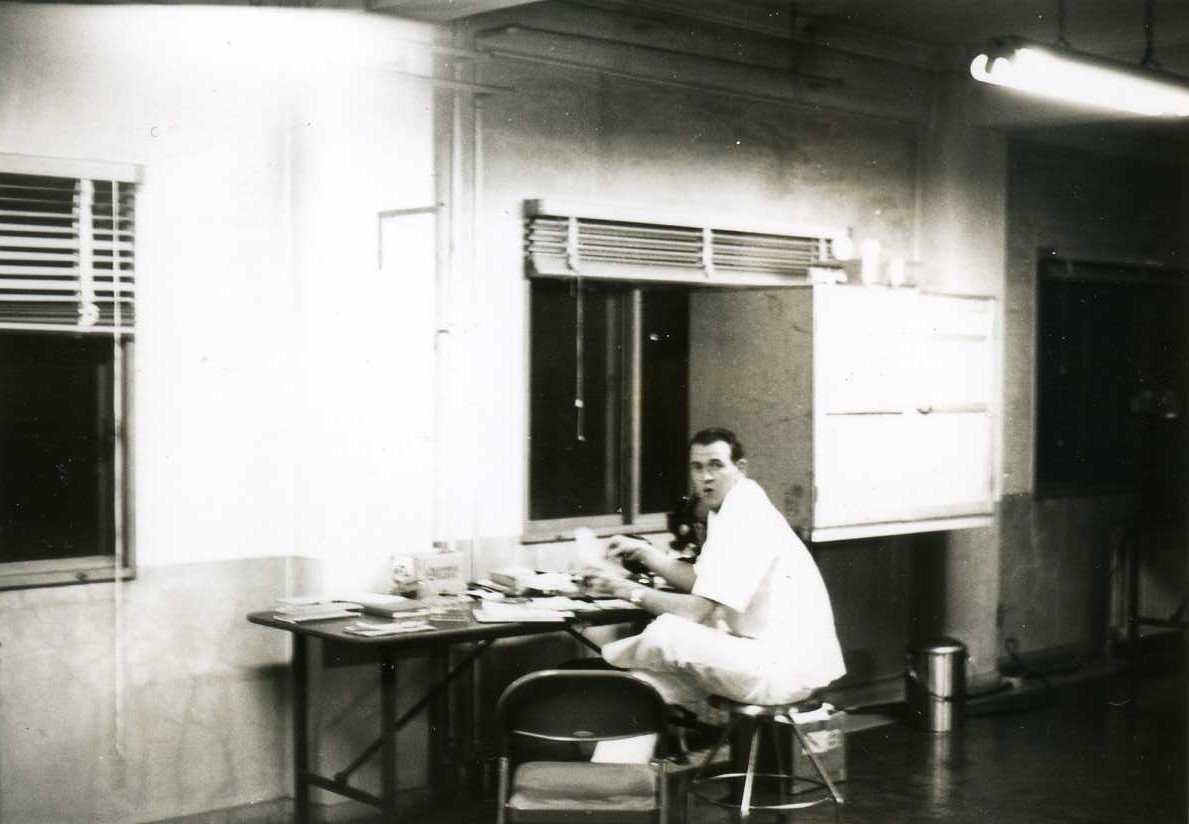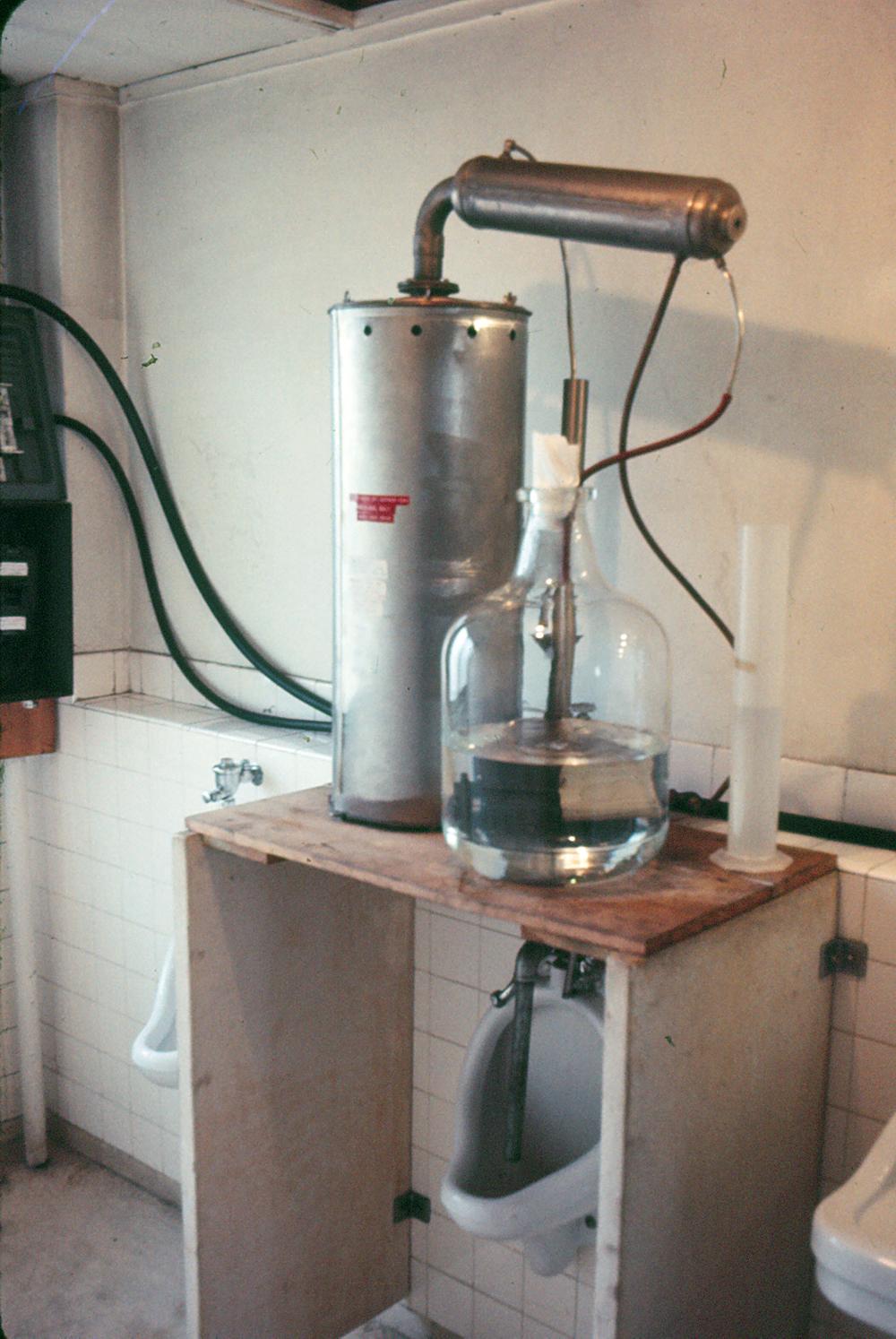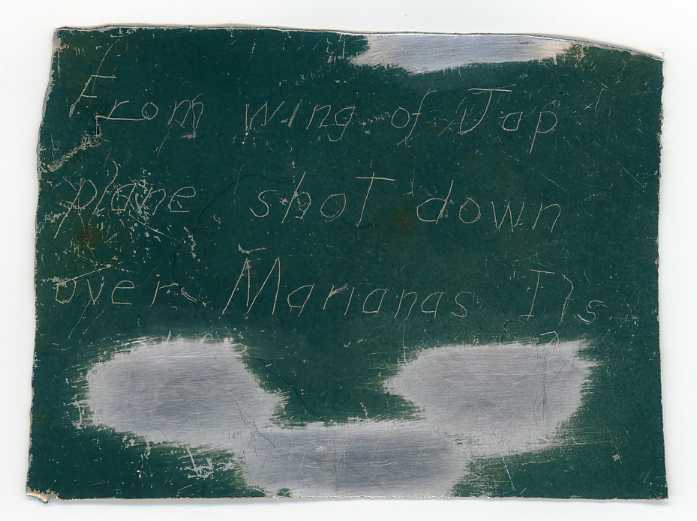Kishine Barracks and the 106th General Hospital
Life and death in the Vietnam War medical communications zone in Japan
By William Wetherall
First posted 18 December 2015
Last updated 10 May 2022
Kishine and the 106th
Purpose
•
Sources
•
Memory
•
Fact checking
•
Editing
•
Corrections
•
Abbreviations
•
Japanese terms
2017 Kanagawa News article
106th General Hospital (1969)
Unit history
•
Installation
•
Mission
•
Officers
•
Organization
•
Operation
•
Hospitalization
•
Burns
•
Personnel
•
Map
•
Buildings
•
Photographs
106th in Stars and Stripes
Viet evacuees
•
Hospitals
•
Doctors
•
Nurses
•
Other staff
•
Patients
•
Medals and awards
•
Red Cross
•
Sports
•
Celebrities
•
Milieu
106th medical reports
Abdominal injuries
•
Bacteria in wounds
•
Bacteremia
•
Burns report
•
Fat embolism
•
Pulmonary insufficiency
•
Septic phlebitis
•
Vascular injuries
•
Amputations
•
Head wounds
Kishine history
Aerial photos
•
Geography
•
Before wars
•
China and Pacific Wars
•
Allied Occupation
•
Post-Occupation
•
Vietnam War
•
Renovations
•
Reversion
•
Kishine Park
Kishine images
Then and now
•
Photos
•
Suido street
•
Area maps
•
Satellite views
•
Street views
Park access
Park guides
Park vs Barracks
Kishine stories
Tales by or about some of the people who were there for whatever reason
Other stories
PTSD appellants
•
MUC claims
•
Reunion
•
Wheeler
•
Zengaku
•
Air crashes
•
SDF sub-camp
•
Tower jumper
Other hospitals
Sagami-Ono Hospital
•
7th Field Hospital
•
249th General Hospital
•
406th Medical Laboratory
•
Hospitals in Vietnam
•
Evacuation
Other perspectives
Marriages
•
Crime
•
Vietnam and Japan
•
Rest & Recuperation
•
Helicopters
•
Community protests
•
Urban legends
•
Demonstrations
•
Beheiren
Other directions
Veterans on desertion
•
Charles Jenkins
•
Kim Tonghui and Kim Hyungsung
•
Terry Whitmore
•
Kenneth Briggs aka Kim Jinsu
•
Shimizu Tetsuo
Early posts and training
Basic training (Ft. Ord)
•
Medical corpsman training (Ft. Sam Houston)
•
561st Ambulance Company (Ft. Ord)
•
Lab tech training (Ft. Baker)
Lab tech posts
USAH (Ft. Ord)
•
106th General Hospital (WBGH Ft. Bliss)
•
McAfee Army Hospital (WSMR)
•
106th General Hospital (Kishine Barracks)
People I knew
Clinical pathology
Hematology
•
Serology
•
Urinalysis
•
Blood chemistry
•
Bacteriology
•
Parisitology
•
Histology
Making do
The small box from Japan
Looking back
Crossing the tees and dotting the eyes of a life half lived half a century ago
Kishine Barracks and the 106th General HospitalWar, protest, and urban legends in
|
|||||||||||||||||||||||||||||||||||||||
|
File Unit: Combat Area Casualties Current File, 6/8/1956 - 1/21/1998 Brief Scope: This series contains records of U.S. military officers and soldiers who died as a result of either a hostile or nonhostile occurrence or who were missing in action or prisoners of war in the Southeast Asian combat area during the Vietnam War, including casualties that occurred in Cambodia, China, Laos, North Vietnam, South Vietnam, and Thailand. Frequently Asked Questions (FAQ)Record Group 330 What information is in these records? Why were these records created? [ . . . ] Well, what was it? A "war" or a "conflict"? And whichever it was, was it a "Vietnam" or a "Vietnamese" event? In Vietnam, it is apt to be called the "Chiến tranh My quốc" ("America War" 米国戦争) or the "Kháng chiến chống My" ("Resistance War Against America" 対米抗戦). "Conflict" doesn't quite capture the scope and the scale of the violence. And "civil war" -- never mind that this expression is an oxymoron -- doesn't account for the extent that the war was so Americanized. |
Coffelt Database
The Coffelt Database (CDB) of Vietnam casualities is the brain child, and the fruit of the labor of love, of Richard Coffelt and others. The CDB website describes him as "the first person to make a dedicated effort to identify the unit assignments of the Army's Vietnam dead, and did so with only the assistance of his wife Jo Ann Jennings until the late 1990s." From 1998, others, practically all veterans like himself, have joined him in compiling massive quantities of data on Vietnam veterans from various public records and other sources.
CDB and CACCF have many fields in common, but a few fields are unique to each. See Three soldiers in two casualty databases for a comparison of the kinds of information they contain. Two of the soldiers died at the 106th General Hospital. The third was a brother of a doctor at the 106th, who according to one account had visited the 106th on an R&R.
The strongest feature of the CDB website is the links it has to scans of primary records for not a few of the "casualties" in the database.
The Coffelt Database is also accessible through the above NARA AAD portal. The manner in which the returned data is presented, however, is somewhat different.
Genealogy databases
In research on historical figures, and on my own family history, I have made extensive use of Ancestry.com, a commercial subscription-based genealogy resource. Ancestry's databases include scans or transcriptions of all manner of public records, from national censuses and birth, death, marriage, and divorce records, to draft registration cards, passenger manifests, naturalization records, and other civil records, as well as newspapers, city directories, high school and college albums, and other publications that allow one to compile an enormous amount of information about some -- but not all -- individuals and families.
The amount and quality of the information available through Ancestry.com will heavily depend on when and where a person lived, as states considerably vary in their laws and policies regarding making public files available on the Internet. Moreover, the availability of information compiled by U.S. government also varies with period.
None of the information available through services like Ancestry.com is privileged. All of it is available to anyone who walks into the office of the competent state or federal agency, or the controlling county or municipal registrar, or a cemetery.
The development of computers, database software, and electronic image scanning -- and of course the Internet, which mediates access to an increasing percentage of all available information -- makes it possible for to collect and collate, in just one day, information that would have take months of expensive travel and labor-intensive thumb searching and manual transcribing of the kind I remember doing when a college student before the age of personal computers and the Internet.
Even through portals like Ancestry.com, however, information does not fall from virtual trees. You have to learn how to query their databases to find what might -- possibly -- be related to whoever you are looking for. It's easy to spend an hour or two and come up with nothing.
You need at least a family name, and a birth or death date, just to begin to get nothing. Even if your spelling is a bit off, or a date is wrong by a year or two, you might stumble across the person you're looking for. Perfect matches are nice, but you have to rule out the possibility that it might be someone else with the same or similar specs -- hopefully with independent information, even if only a fragment from your or someone's memory.
Memory
Memory is always a problem when talking about the past, even if only 5 hours ago, to say nothing of 5 decades. Some things I remember with great confidence because I have never not remembered them. Other things have faded in and out of my memory, though not always in the same manner. And many things I have entirely forgotten.
There are moments when I feel I have recalled names or experiences I thought I had forgotten. At times they appear without stimulation from related thoughts. Other times they float into my mind only after I have had related thoughts. The dilemma of memory is that you can neither ignore such recollections nor take their veracity for granted.
Murray
I clearly remember "Murray" as the name of the first patient who died at the 106th General Hospital. How could I forget his name? He died on my watch so to speak, in the spring of 1966. I had drawn his blood, including -- shortly before he died -- at least one blood culture.
The name "Murray" is deeply etched into my memory, also because he was autopsied at another hospital by -- or with the assistance of -- Dr. Pusch, who was the head of the pathology laboratory where I worked. Dr. Pusch brought Murray's brain back to the lab and dissected it in an impromptu anatomy lesson.
I worked mainly in bacteriology but was a histopathology junkie. I obtained a set of Murray's tissue slides, which were among other slides I had collected while working at the lab and took with me when I left. The slides were in my possession until very recently. "Murray" was clearly written on the labels of autopsy slides, which had "106th Gen Hosp" printed on them.
Yet, by the time I got around to writing this history, I couldn't remember Murray's personal name or other things I had once known about him. Was it Geoffrey or Jeffry? Or another name enirely? I was fairly sure, but couldn't have sworn, that he wasn't a draftee. He wasn't old but he was older and had been in the Army awhile.
But I knew with certainly the year and place Murray died. And this, eventually, allowed me to find the Murray I had known, in the vast sea of Murrays who have died while in the miltary.
In many other respects, though, my reconstruction of Murray's difficulties at the 106th General Hospital continues to be plagued by a number of fascinating memory dilemmas, which are evident in my closer look at Virgil Murray (1966) (below).
Fact checking
The most tedious challenge when writing a history like this is "fact checking" or so it is called. This entails determining the factuality of everything you write -- not only of things based on your own or someone else's memory, but of information found in putatively reliable sources, from birth certificates to the most authoritative dictionaries.
The keyword in fact checking is skepticism. No matter how reputed the source of some information, the factuality of the information should never be taken for granted. A lot of information that passes for "fact" turns out, when closely scrutinized, to be someone's "impression" or "opinion" or "bad memory" if not "imagination".
Not only are memories tricky, but official records, and official and academic histories and other reports, can be full of misinformation. Misspellings, wrong dates, faulty descriptions, untrue allegations, and misleading or biased commentary are all "natural fauna" in the jungle of bureacratic, historigraphic, and biographical writing.
In writing this history, I have spent a lot of time trying to confirm the accuracy of the names, dates, and other matters I have written about. My resources, though, are limited, partly by the fact that I am unable to spend years doing the sort of footwork required to examine original records and personally interrogate the people I have written about or their survivors.
As it is, this history relies more on Internet sources than anything else I have written of comparable length and scope. In fact, even ten years ago it would have been impossible to write and illustrate this report as I have. In just the past decade, the Internet has exponentially swelled with data in the form of blogs and vanity sites created by veterans and unit organizations, and government records and newspapers are being scanned and uploaded to servers at accelerating rates.
Fact checking is reaching the point that, if you can't confirm the factuality of something on-line, a relatively efficient process in terms of time consumption and material outlay, you face the diminishing returns of physically exploring actual libraries, archives, and records the "old fashioned" way, with prospects of spending huge amounts of time and money to discover little of earth-shaking value.
The quality of the most carefully confirmed facts, however, can be corrupted by poor editing (next).
Editing
All texts in yellow boxes are Citations and texts in green boxes are Comments. All boxed comments, and [bracketed remarks] in cited texts, are mine. Unbracketed ellipses . . . are as received, but bracketed ellipses [ . . . ] are mine.
I have not corrected or otherwise altered the text of any citations. When necessary (and perhaps also in some cases when not really necessary), I have [brackted corrections] in the form "incorrect [sic = correct]". In some cases I have shown just [sic] to stress that the word or phrase it follows is as received and not a transcription or scanning error.
Transcripted and scanned texts
Some citations are my transcriptions of printed texts or images of such. I have endeavored to check that my transcriptions are accurate but there is always the possibility that I overlooked an error of my own making. Numbers are especially problematic.
I have also checked all citations of texts I generated with on-line OCR (optical character reader) image scanning services. When scanning pages of printed text to create electronic text, you have to check the results for scanning errors, no matter how clear the original text.
Certain letters and numbers, and combinations thereof, can be corrupted by even the better optical character reader (OCR) software.
The combination "rm", for example, often comes out "m", and sometimes with amusing consequences. Many instances of "burn" and "burns" came out "bum" and "bums" -- which spelling checkers can't detect, and even the naked eye can miss unless you read very carefully.
The number "1" and lower case "l" and upper case "I" are commonly corrupted. Numbers "3" and "5" and "8" are easily confused and need to be checked when transcribing or scanning texts. "6" and "9" are also subject to visual confusion.
I habitually compute sums and percents of all received statistics in order to confirm that I have transcribed or scanned them accurately. In the process, I sometimes find errors in the received data.
Frankly, I have less confidence in screen editing than in the sort of hard-copy editing I grew up and even old with. Today, when reading printed or electronic publications, I spot more errors than in the past -- errors that have the characteristics of what I call "word processing errors" -- by which I mean errors created by people using word processors to write and then check their writing on a monitor. Occasionally I find such errors in my own writing -- traces of phrases I intended to delete, undetected auto-correction errors, inadvertent spelling checker errors.
Spelling checkers have to be used with care. Grammar checkers are to be turned off. Writing rules are meant to be broken, though with discretion, and always with the ear, not the eye.
In the vetting process, my eyes cross and invariably I miss things. I trust everyone will forgive me, and laugh just as I did, when I first encountered expressions like "bum center" and "bum patients" and "3rd-degree bums" in scanned texts.
Corrections
I have taken the liberty of weaving the stories of many people into what is ultimately my own story. I have cited numerous public sources, but have also used personal materials, including photographs taken with my camera and letters received from correspondents, without consulting with the people they involve, some with whom I am no longer in touch, others who have passed away.
I have also depended heavily on my memory, which is not always clear, and even when clear cannot always be confirmed by independent objective evidence. No memoir of this scope is free of error, and errors will run the gamut from slight variations in spellings and dates, to confusions of names and places, and otherwise incorrect descriptions and allegations -- on my part, or on the the part of others whose errors I overlooked or was unable to detect.
I welcome all comments, suggestions, and corrections, and will honor requests for deletions of personal information, or of citations or use of any material, that related parties find unacceptable.
Please send your remarks or requests to me through the Contact form and I will reply as soon as I can.
Abbreviations of medical, military, and other terminology
Some reports and records cited in this story of Kishine Barracks contain from several to many military terms and their abbreviations. Some are common to military organizations and operations generally. Some are limited to a particular military branch such as the U.S. Army, or to a specific field su. Some are common also to military organizations in other countries where English is officially used. Many, though, are specific to a particular service, and a few are specific to a particular period or war.
I have listed here, for reference purposes, abbreviations that appear in this story of Kishine Barracks and some related terms of interest.
Abbreviations of medical, military, and other terminology |
||||||||||||||||||||||||||||||||||
|
|
|
||||||||||||||||||||||||||||||||
Japanese temrs
This history of Kishine Barracks and the 106th General Hospital is lightly sprinkled with Japanese words and expressions, but some Vietnamese terms, and a few Korean and Chinese terms, also appear. Here I will focus on Japanese, but at the end I will also comment on Vietnamese, Korean, and Chinese in relation to Japanese (though linguistically only Japanese and Korean are possibly related).
Japanese sources
I have cited a number of sources that are written in Japanese. All English translations from such sources are mine.
Japanese sources are likely to be faulty for the same reasons that English sources are faulty -- unconfirmed memory or hearsay, failure to check facts, unintended ambiguity, impulses to censure or slant or embellish, and over generalize. Hence I take everything I hear and read in Japanese, beginning with street directions from local residents, with the same sense of caution that I take everything I hear and read in English.
Blind faith in the accuracy of what you are told or taught or learn may get you lost. Researching this history of Kishine and the 106th has been an adventure in finding myself somewhere I didn't expect to be. At times I worried if I'd ever get to where I hoped to be, only to discover that where I hoped to be didn't exist. There were few signs. And for every sign pointing down the right road, there was one pointing down the wrong road, and one pointing into the wilderness.
Japanese words and expressions
When citing a Japanese word or expression, I have generally shown how it would be written in Japanese script and/or Chinese (Sinific, Sino-Japanese) graphs, as well as how it would usually be romanized (alphabetized). I have also of course shown its approximate meaning in English. I have glossed some of the more important words or expressions in greater detail.
Japanese as a language
Japanese is the native language of practically everyone who lives in Japan. My life in Japan, and my life of writing as a journalist and researcher, would have been impossible without learning Japanese.
A lot of people in other countries have gotten the impression that Japanese is a difficult language. But as my first college teacher of Japanese put it on the first day of class, all people in Japan speak Japanese, and half of them are stupid, so it couldn't be that difficult. Well, yes and no. But his point was well made. Linguistically it is not at all difficult. Graphically, most people who are learning Japanese as a foreign or second language have work at the writing and reading. But even that is not as difficult as it may seem at first glance.
"Kishine"
Everyone at the 106th, who stepped outside Kishine's gate, quickly realized that they had crossed a linguistic divide. Phrasebooks were common, but they didn't get one very far.
"Kishine" in some ways represents the language -- which, I would point out, is what is spoken and heard, not what is written or read. Scripts -- alphabetic and other symbols -- respresent sounds, but they don't pronounce themselves.
Linguistically, "Kishine" consists of 3 morae -- "ki-shi-ne" -- pronounced roughly "key-she-neh" if representing the sounds in aphabetic script most speakers of English will probably pronounce the way most speakers of Japanese will probably pronounce Japanese moraeic script (kana) -- きしね (hiragana) or キシネ (katakana) -- or 岸根 (kanji), as the word or name would be written in Chinese script.
In English-based aphabetic representations (romanizations), the name is written "Kishine" (Hepburn system) or "Kisine" (Kunrei system). In Japan, the Ministry of Foreign Affairs generally uses the Hepburn system, while the Ministry of Education generally uses the Kunrei system. However, the Hepburn system is more popular internationally and more familiar in academic and journalistic writing.
The Japanese placename 岸根 -- read きしね or "ki-s(h)i-ne" -- is written 키시네 -- not 기시네 -- in Korean hangŭl. The former would be alphabatized as either "K'isine" (academic or phonemic McCune-Reischauer) or "K'ishine" (popular or phonetic McCune-Reischauer) -- or as "Kishine" (Revised Romanization of Korean, ROK Ministry of Culture standard) -- or as "Khisiney" (Yale). The latter would be romanized "Kis(h)ine" (McCune-Reishauer), Gisine (ROK), or Kisiney (Yale). But who would want to do this?
The IPA (International Phonetic Alphabet) representations used by some linguists, Kishine would be written "ki-ɕi-ne". The approximate English values are as follows.
k k as in skate i ee as in meet ------------------ ɕ sh as in sheep i ee as in meet ------------------ n n as in not e e as in met
However, some people who passed through Kishine Barracks or the 106th General Hospital have spelled Kishine in various ways -- including Kishini, Kishina, Kashine, Kashina, and even Kashini -- apparently in accordance with how they remembered hearing the word. It's a chicken-egg question.
There is only one Google return for "Kisine Barracks", on the Facebook page of a "Bud Schofield", who states under "Life Events" that he "Moved to Yokohama, Japan / January 10, 1960 / Kisine Barracks USMC". On the surface, he would appear to have been in the U.S. Marine Corps, which contributes to the developing image of Kishine Barracks as a multi-service Army facility.
So when doing on-line research for on the history of "Kishine", I Googled all of the above "variations" just to be sure I wasn't missing anything. Most likely, though, somewhere out there in cyberspace, there's a truly odd spelling that slipped through my imagination.
Some people have remembered "Camp Kishini Barracks Hospital" as being at "Yokuska Naval". Yokohama, Yokota, and Camp Zama sometimes come out Yokahama, Yakota, and Camp Zuma, among other spellings. A few have placed Kishine in Tokyo, and one writer has located "Kashini Barracks" in Korea.
The linguistic origins of spelling corruptions
"Yokoska" is an unconventional spelling but it reflects a good ear. As spelling corruptions, "Kishini", "Yokahama", "Yakota", and "Zuma" and the like reflect bad ears or bad memories.
Native speakers master the sounds of a language before they learn how to represent it in script. One can grow up and die of old age, never having learned to read, much less write, and be a totally competent speaker of the language. As I say, writing is not language.
Non-native speakers who flirt with a language whose sounds they have not mastered through the ear, to the point that they can immediately recognize off-key or odd pronunciations, and local dialects and foreign accents, and who develop the habit of learning and maintaining the language through alphabetic script, are apt to visualize the sounds in terms of the script. And when they internalize or recall odd pronunciations of a word, they are likely to "spell" the word oddly. Hence some of the odd spellings in printed and web sources.
Some reasons some speakers of English have trouble with some Japanese words
English is notorious for its resistance to the repetition of some vowels but especially "o" (oh). Hence "Yokohama" and "Yokota" commonly come out "Yokahama" and "Yokata" or even "Yakota" in the mouths of natives speakers of English who are not familiar with Japanese.
English speakers have less trouble repeating "ah", hence the shift of "oh" to "ah". Japanese "kimono" -- key-moh-noh -- has so commonly been anglicized (accented or corrupted by English) as "kimona" that this spelling appears in some dictionaries and in the fashion industry. However, English speakers usually don't have a lot of difficulty with "yukata" (you-kah-tah) or "katakana" (kah-tah-kah-nah) because English is kinder to repetitions of "a". English speakers unfamiliar with Japanese segmentation, however, are likely to syllablize "hiragana" as "HERE-rah-GA-nah" rather than "hee-rah-gah-nah".
Japanese sounds
A non-native speaker of Japanese with a good ear -- who can memorize and write in diction the kana script (hiragana and katakana) used to represent the 46 standard mora, and the limited number of ways in which they are combined to create other sounds, which requires only a few days -- can correctly write whatever Japanese words he or she clearly hears. The only "spelling bees" in Japanese involve the writing of Chinese characters or graphs.
Spelling English words is a challenge to native speakers and non-native learners of English alike, for they have to learn multiple possible spellings of each sound, and memorize the specific spellings of each word.
Japanese sounds -- vowels and consonants -- are easy, and sound combinations are very regular. Unlike English, a syncopated stess-based language, Japanese is practically metronomic. Whereas English gives more time to stressed styllables (with full vowels) and less time to unstressed syllables (with reduced vowels), Japanese allocates about the same amount of time to each mora, meaning a vowel (V), consonant-vowel (CV), or terminal consonant (-C). Stress (emphasis by strengh) as a linguistic (rather than emotional) quality is important in English, whereas pitch (level or frequency) is more characteristic of Japanese.
Both "Toyota" and "Nikon" in Japanese are 3-morae words -- "to-yo-ta" pronounced "toe-yo-tah" and "ni-ko-n" pronounced "knee-koh-ng" or "knee-kohng" (not "knee-cone"). In English, though, these words are anglicized (syllablized and stressed) as "toy-OH-tah" and "NIGH-con" -- "nigh" as in "high" and "con" as in "convict".
The 5 vowels in Japanese are a-i-u-e-o pronounced ah-ee-oo-eh-oh -- approximately "a" as in "awe" and "saw", "i" as in "he" and "she", "u" as in "you" and "sue", "e" as in "met" and "set", and "o" as in "boat" and "so" -- but all short and crisp whether alone or following a consonant. When long they are doubled. Pitch and stress are different matters.
The consonants k/g, s/z, t/d, h/p/b, n, m, and r appear initially before all the vowels a, i, u, e, and o -- ka, ga . . . ra -- ko, go . . . ro.
The consonant y used today only with a, u, and o. In the past, it was also used with e, and may be found in fossilized romanizations like "yen" and "Inouye".
The consonant w is today limited to a and o. Historically, it was also used with i and o, and is sometimes found in fossilized romanizations. Just as older spellings of English words can be used to "antique" a word, ye, wi, and we are sometimes used, along with other historical forms, to create the illusion of older language.
The pronunciation of terminal -n is "-ng" but it will be "-n" or "-m" if followed by "t" or "m" -- hence "wangan" (gulf) will be wang-gang, "wantan" (wanton soup) will be wan-tang, and wanman (one man) will be wam-mang, while "wanman basu" (one-man bus, i.e., a bus with only a driver and no conductor) will be wam-mam-ba-su. Think of how the "n" in the negative prefix "in-" assimilates with the following sound in English -- "regular" (irregular), "legal" (illegal), "possible" (impossible).
Japanese "su" is reduced in some words in some dialects, hence "desu" is "de-su" in Kyoto and "des" in Tokyo. "Suki desu" (I like [something]) is "Ski des" in Tokyo but "Su-ki de-su" (or "su-ki do-su") in Kyoto. "Yo-ko-su-ka" is usually "Yokoska" in the Kanto (Tokyo-Yokohama) area, hence the tendency of some English speakers to spell it this way, while people in the Kansai (Kyoto-Osaka) area who haven't learned the place name through the ear may read 横須賀 (横 yoko 須 su 賀 ka) (よ yo こ ko す su か ka) as 4 morae.
Other linguistic effects in Japanese result in the doubling of some consonants -- kk, ss, tt, pp. A few other sounds also shift in specific environments. On the whole, such effects are fairly predictable.
The "f" in the Hepburn romanization of "h" as in "ha, hi, fu, he, ho" is labial (between opposed lips), not dental-labial (upper teeth on lower lip). Hence the "f" of "Fuji" is not like the "f" of "fool" but more like "who" made with the lips.
Some originally non-Japanese consonants have been accommodated by Japanese orthography. The best example is the increasing use of "v", which until recently was represented by "b".
Vietnamese, Korean, and Chinese
In this history of Kishine and the 106th, I have sometimes shown Vietnamese, Korean, and Chinese words or phrases in various scripts. These 3 languages have something in common in that none are linguistically related to Chinese.
Among these 4 languages, including Chinese, only Japanese and Korean are possibly related to each other linguistically. However, Japanese, Korean, and Vietnamese are commonly related to Chinese through their histories of extensive borrowings from Chinese, and their use of Chinese writing before they developed native or other writing systems.
Chinese
Chinese is written in Chinese graphs, which I generally represent in the Wage-Giles or Pinyin systems of romanization, depending on the source.
Korean
Korean today is written mainly in hangul, a phonetic (nearly phonemic) script, but may include a few Chinese (Sino-Korean) graphs. In the past, Korean writing was a heavy mixure of hangul and Chinese graphs, just as Japanese today continues to make extensive use of Chinese (Sino-Japanese) graphs along with moraic kana (both hiragana and katakana) script. I have generally represented Korean words in the McCune-Reischauer system of romanization.
Vietnamese
Vietnamese is today entirely represented in an alphabetic script first introduced in the 17th century, then more fully developed and implemented in the late 19th and early 20th centuries. Until then, Vietnamese was written in Chinese graphs, comparable to the way Korean and Japanese made use of Chinese graphs, both to represent Chinese words in Vietnamese, and to represent the sounds of Vietnamese words.
Like Korean and Japanese, Vietnamese is linguistically unrelated to Chinese, but like Korea and Japan, Vietnam came under the influence of China and Chinese writing, long before it had a writing system of its own. Hence, historically, the use of Chinese (Sino-Vietnamese) graphs in what is sometimes call "Siniform" writing but which I call "Sinific" writing.
In this history, mostly from my own interest, I have shown the Chinese (Sino-Vietnamese) graphs for some Vietnamese personal names, place names, and formal expressions. I do not speak, and cannot read or write, or otherwise understand Vietnamese. But some Sinific Vietnamese words and expressions make sense as Sinific words and expressions.
"Vietnam" (越南) means a country "south (南 nam) of Viet (越)" -- "Viet" being a country that existed in the southern part of early China, immediately north of the present border between Vietnam and China. Migrations south from China resulted in Chinese influence and even control over the northern part of what is now Vietnam, similar to the influence and control that China excercised over Korea at times in its long and convoluted history.
"Vietnam" did not emerge as a name until around the 16th century. Before that, the names of the northern area of what is now Vietnam were Annam (安南), which goes back to the 7th century, and Tonkin (東京), which was an alternate name of the area, and of the capital city that later became Hanoi (河內). Depending on the period of history, and the government or governments in control of the area that became Vietnam, "Annam" has also referred to its central part, its central and southern parts, and even its entirety.
During the Tang dynasty (618-907), the northern part of what is now Vietnam was a province of China called Annam (安南). During the 10th century, Annam broke away from China but remained closely influenced by China, which attempted at times to reclaim the area as a province.
The name of the capital of ancient Annam was at times Tonkin (東京), which some people used to refer to Annam itself. Tonkin -- also Tonking, Tongking, and Dong Kinh -- is the Sino-Vietnamese pronuciation of 東京, which means "eastern capital". In Sino-Japanese, the name can be read Tōkyō or Tōkei, or even Tōkin.
The imperial capital of Japan for over a millennium, from the Heian period (794-1185), which overlapped with the Tang period and China, to the end of Tokugawa era (1603-1868), was Kyōto (京都). In 1868, the city of Edo (江戸) became the capital, and Edo was graphically renamed 東京, which some people read Tōkyō and others Tōkei. Both names appear in kana representations (such as furigana on woodblock prints) and alphabetic representations (such as postal frankings), but Tōkyō quickly became the standard name of the city.
Because 東京 was historically associated with Vietnam, some publishers in Japan graphed the name of the new capital of Japan 東亰 instead of 東京, using 亰 instead of 京. See Tonichi mastheads: The character of calligraphy for details.
Chinese characters were still evident in Vietnam at the time of the Vietnam War. I specifically ask a friend of mine who was then in Army and serving in Vietnam as an interrogator. See Andy Fountain (below) for his observations of Chinese calligraphy.
Cultural stereotypes
Don't expect a lot of talk about "Japanese culture" in my telling of the history of Kishine and the 106th in Yokohama. What little I say about life in Japan is intended only to clarify the meaning of something that comes up in one of my stories.
My understanding of "culture" is not what most people think of when they use the word. In my view, there is really no such thing as "a" culture in any country. "Japanese culture" is a figment of "culturalist" imagination that feeds "cultural determinism" -- the belief that a nation of people "are" whatever they are perceived to be "because" they are products of a "common heritage".
"Heritage" is ultimately a personal matter and comes mostly from family and other very local communal experiences. No humans share a heritage so "common" that they aren't first humans and second individuals. "Cultural" sharing is relatively limited, especially in a country as geographically large and diverse as Japan.
Everyone born and raised in Japan -- and everyone who has just recently stepped off the boat or deboarded a plane from another country in Japan -- shares exposure to whatever elements of life they encounter and experience in Japan -- individually. Whether or not, and to what extent, a person is affected by what he or she experiences will depend on all manner of personal factors which may or may not be shared with others. Everyone in the same family can be, and usually will be, different in many ways -- never mind their exposure to a common environment. In real life, I find I have little use for cultural stereotypes.
In the end, you mediate only what you absorb and express. As you get older, the process of becoming acquainted with something new is a bit more conscious. Awareness of everything that has already become part of you inhibits spontaneous acceptance of something new. The old and the new become rivals for mediation.
Take, for example, shaking hands, or hi-fiving, or bowing. If you're used to making decisions about whether and how to shake hands, and whether and how to execute a hi-five or other such greeting or parting or acknowledgment, but not used to bowing, then bowing will probably require conscious effort. Should you shake hands or bow? Or both? At some point, though, such decisions become reflexive.
Until your responses to new conditions become second nature, you will find yourself negotiating between new and old choices and endeavoring to avoid being awkward in situations that you are not used to -- not yet "accustomed" or "acculturated" to. Eventually, though, the "new" becomes as familiar as the "old" and you accommodate the new as appropriately as the old.
After becoming reflexively "bicultural" with respect to social behaviors like "handshaking" and "bowing" -- each of which involves choices of the kind or degree of handshaking and/or bowing -- you will still have to deal with the different ways that others will approach or react to you, on a case-by-case, one-on-one basis. For in the real world, there is no such thing as a pervasive one-size-fits-all "Japanese culture" or "Japanese way" -- but only individuals who may be nationals of Japan but are first and foremost humans with personalities and idiosyncrasies before they are "Japanese".
Not all Japanese dance to the same music. And those who do dance to the same music are likely to do so differently for personal reasons. Hence you will notice that I do not speak of things like "the Japanese", because there are roughly 125 million Japanese, including myself. If you live here, and know a lot of people who have lived here all or most of their lives (which I prefer to "life"), you will recognize that everyone is an individual, and that individuality matters when it comes to things that matter -- like friendships, partnerships, and rivalries.
I can't think of a single thing that Japanese collectively do in such unison that they can properly be thought of as "the Japanese" -- or otherwise be the subject of declarations like "Japanese people love nature". This sort of grammar is typical of generalizations that undermine the ability to recognize the diversity and variety that one ought, from the start, to expect of a country of 125 million people. Even a population of 125 or a group of 12 or 13 Japanese would defy collective "they are" generalizations other than those like "They are nationals of Japan" in which you can be sure that everyone in the class in fact shares the same trait -- in this case, possession of Japan's nationality.
So my descriptions of Japan and Japanese are full of nuancing qualifications like most, many, some, a few, few -- and I eschew the temptation to reduce the complexities of life in Japan to lock-step, all-hearts-beat-to-the-same-drummer superlatives like "all" or "no one". I reserve global cut-and-dry, black-and-white generalizations and superlatives for the very rare occasions when they might actually be warranted. I drive editors who want to keep things simple and save words crazy.
Basically, I am not especially interested in what most people consider "culture". My settling in Japan, and my acquisition of Japanese nationality, were not motivated by a desire to learn more than a survivalist minimum about Japanese foods, Japanese religions, Japanese festivals, Japanese music and dance, temples and shrines, fashions and arts, and the myriad other "things Japanese" that consume the attention of many people, Japanese and foreigners alike, and have inspired tens-of-thousands of books in Japanese and thousands in English and other languages. I take "things Japanese" in stride -- as part of my daily background and occasionally my foreground.
What little I have learned about such things has been through the agency of curiosity about the human condition in Japan -- what motivates ordinary people, as living beings, in their struggle to make sense of their lives as individuals and social animals, blessed or cursed with the capacities and qualities we call "human" in order to differentiate ourselves from monkeys, mice, millipedes, and monsters.
People ask me if I get along with my "Japanese neighbors" or if I have a "Japanese wife" or "mixed kids". I say I have neighbors -- everyone who lives in a neighborhood anywhere in the world has neighbors -- and most of my neighbors are Japanese. But I have no "Japanese" neighbors. I have only neighbors. And of course I get along with them. Isn't that what neighbors are for? To get along with? Some people then say, "I meant do they accept you?" To which I say, "I accept them, and that's all that matters to me. Whether someone accepts me is their business."
I had a wife -- a female spouse, which because we were legally married made her my wife, which is not to say that I possessed her. And she happened to be Japanese. But she was just a woman, just my wife, just the mother of our -- her and my -- children. We were just another couple, just another family.
My children, like every child ever born between two parents, are mixtures of their parental genes. I'm a mixture of my mother's and father's genes. Their mother is a mixture of her mother's and father's genes. They are thus mixtures of the genes of 4 grandparents, 8 great grandparents, 16 great-great grandparents, and 32 great-great-great grandparents. So, yes, my kids are definitely very mixed.
Journalists and scholars -- I used to say "even scholars" but along the way I realized there is no reason why scholars should know better -- from America or Germany or Korea have asked me my views of "Japanese suicide", having gotten the impression of things I've written that I am an "expert" on the subject. I quickly clarify that I have been only a "student" of suicide generally -- "human suicide" including "suicide in Japan" -- but not of "Japanese suicide". There is no such thing as "Japanese" suicide for all the reasons I have suggested in my writing on suicidal behaviors. All suicidal acts are different. All are motivated by personal human factors. Most writing on suicide as something determined by "culture" are not about suicide as a behavior, but about how people who don't commit suicide deal with suicide. Japan is far from being the only country in the world in which some dramas, films, and novels have depicted suicide as an alternative to remaining alive come what may. Such representations of suicide are in fact fairly universal. Moreover, entertainment and other media in Japan have also, over the centuries, presented suicide as something that one should not resort to. Other than in cases where "self-execution" was a prescribed punishment for members of the warrior caste who violated laws that applied to them, taking ones own life in Japan has always been a personal choice -- even when done in desperation or when under duress.
I didn't used to think this way. It took me a few years to rid myself of the "national character" stereotypes that were common in my own education half a century ago, and which most teachers in schools everywhere are still spreading. Stereotypes have the single merit of keeping things simple so you don't have to think. Belief that national "culture" or "blood" determine character is a thought-terminating concept -- if such thinking can be dignified as a "concept". Expecting that someone who happens to be Japanese knows something about "tea ceremony" or "kabuki" or "anime" or "Buddhism" -- or has an interest in such things -- is to risk being disappointed -- as disappointed as a zealous Japanese student of English literature will be to learn that their American seatmate on a trans-Pacific flight has never seen a Shakespeare play and may not even know where Shakespeare lived, or recall what they read by Hemingway. And they might not know, or care to know, about why there are U.S. military bases in Japan.
The sort of allegations I have made here fly in the face of "conventional wisdom" practically everywhere. I will humor "culture" talk to be polite, but not for long. I take advantage of, or create, openings in which I can get down to the business of warning people coming to Japan that people in Japan are no different from people anywhere. They love and kill each other, themselves, and others, and eat or starve, and laugh or cry, for essentially the same reasons that, say, British, Germans, Chinese, Nigerians, Filipinos, and Americans do -- and for the same reason, that they are human -- and no two Japanese, no two humans, are the same.
Wars like the Pacific War, the Korean War, and the Vietnam War should be proof enough that the only issues that really divide nations are the same issues that divide members of the same family or neighborhood -- territorial and economic greed and jealousy, exacerbated by the propensity to dehumanize each other. And dehumanization begins with "group-think" stereotypes.
2017 Kanagawa News article on Kishine Barracks and 106th General HospitalIn July 2017 I received email from Yuuki Takahashi (Takahashi Yūki 高橋融生), an editor with Kanagawa News (Kanagawa shinbun 神奈川新聞), stating that he had seen my webpage on Kishine Barracks (the original shorter version of this expanded edition) and wanted to interview me for an article in a series he was writing on the impact of the Vietnam War on Kanagawa prefecture and the continuing effects of the presence of U.S. Forces in Japan on the prefecture. He came to my home, he ask me questions about my military service and experiences at Kishine, my views of the Vietnam War, and my opinions about a number of political issues related to how wars are remembered, and whether or not Kishine's role in the Vietnam War should be remembered. The article was published as the first of three from 8 September 2017. Mr. Takahashi shared the galleys with me to solicit corrections and other feedback, which he incorporated into the final copy. The photograph he took of me at my home was featured with the article, which also ran one of my photos of a helicopter lifting off the pad at Kishine. The article concluded with the observation that 50 years after I had been at Kishine Park as an American, I had visited Kishine Park as a Japanese national. See William Wetherall (1965-1966, 2016): "What war, what barracks, what hospital?". |
106th General Hospital official report (1969)The following texts and tables are reproduced from a copy of an official guide to the 106th General Hospital, compiled in 1968 and early 1969 and published in 1969. Most of the data is from 1968, but the personnel data is dated 9 January 1969. From paper to hypertextThe received report had 13 pages in addition to a cover. I produced the html versions shown below by first making jpg scans of each page and then creating text files by scanning the jpg images with OCR software. I then formatted the text in html and edited the text against the text of the the original report. All [bracketed remarks], information highlighted in red, and boxed comments are mine. Illegible text is represented by bracketed ellipses [ . . . ]. AcknowledgmentsI received a copy of the report from Michael Caines, who had been a burn patient at the 106th. He had received his copy from Harold Rubin, who received an original copy at the time it was issued, when he was in charge of the 106th's Pharmaeceutial Services I came across Michael's name on an Internet forum in which he stated that he had a copy of the report. I contacted him by email, and he sent me a copy and put me in touch with Harold. I am grateful to both men for sharing their time and experiences with me. Both Michael and Harold arrived after I left, and I have met them only through email. Michael had left before Harold arrived, but the two men later crossed paths and remain friends. As a laboratory technician whose rounds at times included the burn ward, I would probably have drawn Michael's blood had I been there when he was. Even if Harold had been there when I was there, I would not have had reason to make his acquiantance, for the medical librarian I liked didn't move with the medical library, from the laboratory building to the Hospital Clinic building, where the pharmacy was located, until after I left. See Michael Caines (1967-1968) and Harold Rubin (1968-1970) below for more about their service and experiences. |
Unit history
106th GENERAL HOSPITAL
UNIT HISTORY STATEMENT
The 106th General Hospital was originally activated at New Oreleans [sic = Orleans], Louisiana, on 15 July 1943, as the 286th Station Hospital. The unit was activated at 500 beds, expanded to 750 beds in ten days, and had 1,000 beds by December 1943. On 23 December 1943, the unit was redesignated the 106th General Hospital. The hospital underwent basic unit training at Fort McClellan, Alabama through June of 1944, at which time it was deployed to Britain where it was stationed outside London. The unit actively supported the European Theater during the Second World War, handling a balanced load of medical and surgical cases with a specialty in neurosurgery. The unit was returned to the United States in August 1945, and assigned to Camp Sibert, Alabama, where it was deactivated on 4 October 1945.
The unit was allocated to the Regular Army on 17 November 1959, and reactivated on 1 December 1959 at William Beaumont General Hospital, El Paso, Texas. During the period from activation until it was alerted for overseas movement, the unit underwent parallel training with William Beaumont. From 1959 through 1965, the hospital underwent several T0&E [Table of Organization and Equipment] reorganizations and changes and STRAF [Strategic Army Force] re-classifications. On 2 September 1965, the unit was allerted [sic = alerted] for deployment to an overseas area. The personnel of the hospital traveled from El Paso to Yokohama on four aircraft during the period from 12 through 16 December 1965. On 15 December 1965, the medical assemblage arrived at North Pier, Yokohama. The hospital was operational 72 hours later on 18 December.
During the first two and one-half years of operation the hospital has admitted and treated over 16,000 patients evacuated from Vietnam. The primary workload of the hospital has been surgical with a specialty as the Burn Center of the Far East.
Meritorious Unit Commendation On 2 December 1969, a few months after the 106th published its report, the Department of the Army awarded the 106th General Hospital a Meritorious Unit Commendation in recognition of the services it provided "in support of medical care for patients evacuated from the Republic of Vietnam during the period December 1965 to December 1968." Similar commendations were also given to the 249th General Hospital and 406th Medical Laboratory. See Department of the Army, General Orders No. 75, 2 December 1969 for the full citations.
Installation
INSTALLATION INFORMATION
KISHINE BARRACKS -- YOKOHAMA, JAPAN
HISTORY: Kishine Barracks was constructed in 1956 and 1957 on farmland owned by the Japanese Government. The installation was transfered [sic = transferred] to the U.S. Army on 1 June 1967 in exchange for some U.S. Forces property in the Tokyo area. It was originally occupied by Troop Command, Army Transportation Terminal Command, Japan and U.S. Army Personnel Center, Far East. On 15 December 1965 the 106th General Hospital replaced the Personnel Center, which moved to Camp Zama.
LOCATION: Kishine Barracks is located in Kanagawa Prefecture approximately 4 miles north of Yokohama and 17 miles south of Tokyo. The installation is 35 acres, triangular in shape, 0.37 miles wide and 0.18 miles long. National Highway #1 extends along the southeastern portion and National Highway #16 extends along the southwestern portion of the installation.
Latitude 35 29' N
Longitude 139 37' E
BUILDINGS: The installation consists of 18 permanent building with 325,865 square feet, and 20 semi-permanent buildings with 77,979 square feet. There are 2 temporary buildings with 167 square feet. Estimated replacement cost of land and buildings is $27,274,000. Annual maintenance and support cost is $276,300.
|
The description of the LOCATION is a bit odd. Kishine Barracks was in Yokohama -- in Kōhoku ward in the northern part of the city. The "Yokohama" that is said to be 4 miles south of Kishine refers to the older part of Yokohama along the central part of the waterfront. The "Tokyo" that is said to be 17 miles north of Kishine refers to the nearest border of Tokyo prefecture. The heart of the city is considerably farther. National Routes 1 and 16 do not extend along any portion of the Kishine area. They pass through the far-flung general area around Kishine and intersect with prefectural roads that approach Kishine. The road that climbed the hill in front of the entrance was then and is still commonly known as Suidō-michi (水道道) [waterway street] or Suidō-dōro (水道道路) [waterway road]. The name reflects the history of the road along an old water course. This is the name of the local stretch of what is more formally called Yokohama City Road Route 85 / Tsurumi-station -- Mitsuzawa line (横浜市主要地方道85号鶴見駅三ツ沢線). The road intersects at the bottom of the hill with a stretch of Kanagawa Prefecture Route 12 (神奈川県道12号) known as Yokohama Kamiasao Line (横浜上麻生線). The intersection is known as Nishi-Kishine (西岸根交差点). |
Mission
106TH GENERAL HOSPITAL
MISSION STATEMENT
1. To maintain and operate 1000 hospital beds for definitive inpatient treatment, to include medical and surgical care in support of military personnel evacuated from SEA and local Army personnel assigned to Kishine Barracks and North Pier, Yokohama under a 60-day evacuation policy.
2. To provide outpatient medical, surgical, and dental care for authorized personnel assigned to North Pier, Yokohama and Kishine Barracks.
3. To operate an intermediate burn center.
4. To provide consultation service covering the various medical and surgical specialties, as requested or directed.
5. To accomplish physical examinations (less flight physicals) for personnel authorized primary medical support.
6. To provide only emergency treatment to authorized dependents. Make such arrangements as necessary to transfer or refer such patients requiring such treatment to the US Army Hospital, Camp Zama or other appropriate militaryPathology (hematology, urinalysis) facilities.
7. To provide medical instruction and training support to USARJ [United States Army Japan] non-medical units in the Yokohama vicinity as requested.
8. To perform the functions of installation commander for the CG [Commanding General], USAMCJ [United States Army Medical Corps] as outlined in USARJ Regulation 10-1.
9. To provide such other medical support as may be directed.
Officers
|
106TH GENERAL HOSPITAL KEY PERSONNEL |
||
|
COL Alexander M. Boysen, MC COL Paul A. LaVault, MSC CPT David D. Gibson, MSC COL Harry B. Burkett, MC LTC Raymond J. Bagg Jr., MC MAJ Jerry D. Ballard, MC LTC Helen L. McCormick, ANC LTC James L. Andrews, DC CPT Henri C. Theodore, MC CPT John J. Gisvold, MC CPT Harold Rubin, MSC LTC Joe B. Gipson MAJ William M. Collyer, MSC LTC Lyman Blakesley, MSC MAJ Dorothy Mount, AMSC LTC Hugh J. McKenna, CHC CSM Robert C. Dalehite |
Commandlng Officer Executive Officer Adjutant C, Prof Svc C, Surg Svc C, Med Svc C, Nurs Svc C, Dental Svc C, Path Svc C, Rad Svc C, Pharm Svc C, Pers Div C, Reg Div C, S&S Div C, Food Svc C, Chaplain Command Sergeant Major |
RANKS, CORPS, AND TITLES COL Colonel LTC Lieutenant Colonel MAJ Major CPT Captain CSM Command Sergeant Major MC Medical Corps DC Dental Corps ANC Army Nursing Corps MSC Medical Service Corps AMSC Army Medical Service Corps C Chief |
Organization
|
106TH GENERAL HOSPITAL |
||||||
|
COMMANDING OFFICER EXECUTIVE OFFICER |
||||||
|
SPEC STAFF CHAPLAINS |
ADJUTANT | |||||
|
CHIEF PROF SVCS |
CHIEF ADMIN SVCS |
|||||
|
DEPT OF MED SERVICES: General Med Dermatology Gastro Chest & Comm Disease Neurology Psychiatry Cli Psych Social Work Cardiology Hospital Clinic |
DEPT OF SURG
SERVICES: General Surg Opthamo Otolaryn Orthopedic Neurosurgery Thorac Surg Urology Anes & Opr Physical Med |
RADIOLOGY SVC
SECTIONS: Diagnostic |
MGT SVC OFC
BRANCHES: None |
PERSONNEL DIV
BRANCHES: Mil Pers. Medical Co. Med Hold Co. Welfare & Recreation |
REGISTRAR DIV
BRANCHES: A & B Med Records & Reports Hosp Treas. |
|
|
NURSING SVC
SECTIONS: Medical Surgical Hosp Clinic CMS OR Nursing Anes Nursing |
PATHOLOGY SVC
SECTIONS: Anatomical Clinical |
DENTAL SVC
SECTIONS: Oral Dg Periodontia Restorative Dentistry Oral Surgery Prosthodontia |
SUP & SVC DIV
BRANCHES: Property Mgt Service Supply |
PLAN & Tng Div
BRANCHES: Plans Training |
FOOD SVC DIV
Diet Therapy Production & Service |
|
|
PHARMACY SVC
SECTIONS: Dispensing Manufacturing |
||||||
Operation
106TH GENERAL HOSPITAL
OPERATIONAL DATA
THROUGH 31 Dec 68
AVERAGE DAILY BASIS
Everyday during the past year the 106th General Hospital has:
Admitted 37 patients from Vietnam of which 30 were surgical cases and 7 were medical. 23 of these patients were injured as a result of hostile action. Each patient was hospitalized 21.9 days. The hospital discharged 37 patients of which 28 were Army and 9 were Navy/Marine. 29 of these patients were transferred to CONUS [Continental United States] hospitals and 8 were returned to duty. In treating these patients, 30 Operating Room procedures were performed, 258 X-rays were taken, 2014 Lab procedures were performed, and 33 units of blood were prepared. The Dental Clinic treated 44 patients, and the mess hall served 2261 meals. 4487 pieces of mail were delivered and 38 personnel records were received and processed. $2335.00 was sent [sic = spent] on consumable medical supplies and $604.00 was invested in medical equipment. In providing this service 5395 permanent party man-hours were expended.
I found this especially interesting. I would never have thought of comparing the number of lab procedures performed every day to the number of meals the mess hall served. Judging from the variety and volume of work that was done at the pathology lab when I was there in 1966, I would guess that most of the lab procedures in 1968 were also related to blood work. A request to draw blood would typically call for several procedures -- from routine blood cell counts, and differentials and hematocrits, to one or more specific blood chemistry tests. The number of meals served seems low -- considering that the report says the operating strength was 649 military personnel and 258 civilians, and an undisclosed average number of patients on any given day. Presumably the civilians packed their own lunches. But surely the patients, and most of the military personnel, ate on base, and I would think they most likely ate food prepared by the mess hall.
Hospitalization
|
106TH GENERAL HOSPITAL LENGTH OF HOSPITALIZATION, SELECTED CASES 1 Jan - 31 Oct 68 |
||||||
| DIAGNOSIS |
PATIENTS |
AVERAGE LENGTH OF STAY |
TOTAL DAYS LOST |
ABBREVIATIONS |
||
|
MAJ AMP (Lower Extrem) Fx Femur Fx Tibia Thoracic Wds ABD Wds W/Gu Involvement ABD Wds W/Colostomy ABD Wds W/Liver Inj Craniotomy Malaria Hepatitis Psychiatry Maj Vascular Inj Maj Burns Maxillo-Facial Inj Totals |
365 252 377 416 193 222 147 201 214 221 304 112 298 129 3,451 |
12.76 32.50 19.02 15.21 15.34 15.52 13.88 12.37 21.70 26.94 21.09 16.85 8.69 20.81 18.12 |
4656 8189 7169 6326 2961 3546 2040 2487 5643 5953 6411 1887 2591 2685 62,544 |
|
||
Labor costs: Consumables but not expendablesThe red figures are mine. I calculate an overall average of 18.12 "days lost" per patient (65,544 total days lost / 3,451 total patients). At face value this would seem to mean about 2.5 weeks of hospitalization per patient. The "days lost" metaphor suggests that Army statisticians view soldiers as employees who provide labor in return for pay -- which, in a sense, they are. What is not reflected in such figures is the "days lost" in the name of the labor required to evacuate and care for the sick, injured, and wounded. Presumably this cost is higher than the average per-capita cost of maintaining an average soldier in the war zone. The costs of providing the long-term, even life-long care that the seriously injured and wounded have require is of course another "cost factor" that government bean counters and fund allocators have to consider. Soldiers and veterans may still be "consumables" but they are no longer "expendables". The more serious the conditions, the shorter the stayNotice that the hospitalizations of malaria, hepatitis, and psychiatry patients -- all medical rather than surgical admissions -- are longer than all of the surgical conditions except fractured femurs. Patients that presented more difficult conditions, that would require longer periods of convalescence and rehabilitation, tended to have the shortest hospitalizations at Kishine. |
Burns
 106th General Hospital burn statistics
106th General Hospital burn statistics1966, 1967, and 1968 through June Page 8 of 1969 report as scanned |
|
Treatment ● "Tx" means "treatment". At the time, the two most common approaches to controlling infections in open burns were silver nitrate (AGNO3), a more traditional treatment, and sulfamylon (mafenide acetate), which had been more recently introduced. Both were topically applied in various ways -- silver nitrate in the form of soaks, in which gauze soaked with silver nitrate was placed directly on an exposed burn -- and sulfamylon in the form of an antimicrobial cream. "Open Tx" was just that -- leaving the burn exposed with no topical treatment. Disposition ● More burn patients were evacuated from the 106th to facilities in the United States than were returned to duty. Deaths ● 101 of the 106th's 1,407 major burn patients died -- 76 at the 106th, 23 at Brooke General Hospital (BGH) at Fort Sam Houston in San Antonio, and 2 at Tachikawa Airbase presumably en route to BGH. Evacuation ● 411 or 29.2 percent of the 106th's 1,407 major burn patients were evacuated to the Surgical Research Unit (SRU) at Brooke Army Hospital (BGH), which amounted to 49.8 percent of all patients evacuated from the 106th. The Surgical Research Unit (SRU) at Brooke General Hospital (BGH) treated patients with infected burns and other wounds on a special ward. This evolved into today's U.S. Army Burn Center at the U.S. Army Institute of Surgical Research at Brooke Army Medical Center at Fort Sam Houston (L.C. Cancio and S.E. Wolf, "A History of Burn Care", in Marc G. Jeschke et al., editors, Handbook of Burns: Volume 1: Acute Burn Care, New York: Springer-Wien, 2012, page 8). Causes ● That more major burns in Vietnam were caused by accidents than by "injury resulting from hostile action" (IRHA) has often been cited as an example of the tragedy of war zone injuries that could have been prevented. See other reports (below). Among the causes of IRHAs, "RPG" refers to "rocket-propelled grenades". |
|
U.S. Army reports on medical support in Vietnam made the following observations about the role of the 106th General Hospital concerning "secondary care" for surgery patients, especially those that required orthopedic surgery, and "burns" [bracketed remarks mine].
|
Confessions of a vampire on the burn wardThough I ended up working mainly in the microbiology (bacteriology and parasitology) section of the lab, I did my share of rounds drawing blood, on all wards, including the burn ward. When I was at the 106th in 1966, the burn ward -- as I recall -- was on the 2nd floor of Building C, just a few steps across the way from the lab, which occupied the small building between B and C after provisionally setting up in Building B. Every ward presented different challenges in terms of the types of patients. All patients were the same, though, when it came to the first rule of drawing blood -- to make the patient feel at ease, especially if we were meeting for the first time. Second and subsequent draws were easier if the first draw left the patient feeling that I could be trusted to do relatively painless work. What's different about burn patients is, of course, the burns -- "thermal injuries" to body tissue caused by heat or chemicals. I'm not talking about the minor burns you get touching a hot kettle, spilling boiling water, or getting a sleeve too close to a flame. I'm talking about burns caused by explosives, ignited fuels and chemicals, the kind you get from incendiary weapons, white phosphorus munitions, napalm, gasoline, jet fuel -- major burns that cover substantial parts of your body, all the worse if they also involve your head and face. Before I could begin to try to make a patient feel at ease with a stranger wielding a needle, though, I had to make myself feel at ease with the patient. After the 106th began operating, I quickly enough got used to the commonality of the mangled bodies that occupied many of its beds. The sights were very different from those I'd seen in the surgery and recovery wards of the hospitals where I'd worked in the United States. While located in the peaceful suburbs of a country that was several thousand miles from Vietnam, the 106th was nonetheless a battlefield hospital. The most difficult challenge for me, at Kishine, was to tame my natural curiosity about not only a patient's medical condition, but the conditions that caused the injuries or wounds -- in this case the burns. If the patient volunteered to tell his story, fine. If not, then I would hesitate to ask unless I saw signs that the patient might actually like to talk about what happened. Some patients did, and some didn't, voluntarily related what had happened to them. At times a ward nurse or corpsman would intercept me and alert me as to which patients were having emotional difficulties on top of their physical injuries. These included patients who had been involved in severe combat and were unable to get any information about other men in their unit -- how their wounded buddis were doing, who had been killed. These also included patients who, in addition to their extreme pain and discomfort, were dwelling on certain or probable prospects of lifelong disfigurement. I hated saying things like "How are we doing today?" to patients who were obviously miserable. I was more apt to say something like "You don't look like you're having fun" -- in a way that would be taken as a sincere acknowledgement of the patient's difficulties. I was generally good at what I did, but some patients were tired of being pin cushions. Some had experienced failed attempts by others -- a lab tech, corpsman, nurse, or doctor -- who were having a bad day or were careless or unskilled. But no matter how much confidence I had in my own abilities and tried not to show occasional doubts, there were times when I couldn't guarantee that it wouldn't hurt -- or that I wouldn't bungle an attempt to hit a vein. There's a saying in Japanese -- "Even monkeys fall from trees" (Saru mo ki kara ochiru 猿も木から落ちる) -- and yours truly considers himself just another monkey. Bananas happen to be -- I'm not kidding -- the Wetherall "family fruit". The point is, though, I always went into a vein with an awareness of a small but real probability of failure. I was supposed to remain calm and give the patient the impression I knew what I was doing. But sometimes I'd joke about it. "Don't worry. I'm as nervous as you are." And take it from there. It could go in all manner of directions. Some patients called phlebotomists vampires. "I've got to draw some more blood." "Is it that good?" "Some post-op tests and another blood culture. I hear your surgery went well." "They gave me some blood. And now you want to take it back." "From the blood bank, right? "Right." "You can keep the blood, but you gotta pay interest." Most vampire jokes are of the kind you can tell your mother and not get your mouth washed out with soap. Two blood cells loved in vein. A red cell asks another for a date, and the other says, "Sorry, you're not my type." A psychiatrist tells a B- blood cell suffering from depression to be more positive. Artistic vampires are good at drawing blood. Vampires go fishing in the blood stream. Sometimes I did have to fish for a vein, or fish around inside one. The arms of some patients were so badly injured that I couldn't draw blood from a conventional vein. Or the conventional veins were intact but had collapsed from excessive punctures. An alternate site might be indicated on the patient's chart. Or a nurse might bring such a site to my attention. If I didn't immediately spot a suitable vein, I'd look for one. I might ask, "Where have they been drawing your blood?" Or I might look at a bunch of puncture marks and joke, "Do you have any good veins left?" -- while meeting the patient's eyes, which invariably would be watching me, most likely with considerable anxiety. When I found a possible site, I'd prepare the needle and tubes, while talking to the patient about anything other than something I thought might upset him. I resorted to light humor if possible. But some patients were in no mood for levity. Or they were burned or otherwise injured in such ways that made smiling or laughing painful or even impossible. Drawing from veins that could not clearly be seen or palpitated increased the likelihood of failure. Obesity increased the likelihood of having to go for a vein I suspected (or hoped) was there but couldn't actual feel. Unlike some of the patients I had drawn at stateside Army hospitals, which also treat dependants, patients from Vietnam were rarely fat. Even with lean patients, however, some sticks are harder than others. I sometimes sought advice, and was always prepared to admit defeat, but I never encountered a patient whose peripheral blood I couldn't somehow draw. At times I had to draw from a vein on the back of a hand, or leg, ankle, or foot. Such draws can be painful even for the person wielding the needle, who vicariously experiences being in the patient's skin. If no one is able to draw blood using conventional methods of venipuncture, then a doctor has to perform a venous cutdown. I have never witnessed one. As much as I sometimes wanted to, there wasn't a lot of time to linger and talk with patients. When especially busy, I had no choice but to minimize conversation. And even when there was time to talk, there were times when I concluded that the kindest I could be to a patient was to go about my work in silence. |
Personnel
|
106TH GENERAL HOSPITAL PERSONNEL DATA 9 January 1969 |
||||
| CATAGORY | AUTH STRENGTH |
OPERATING STRENGTH |
ABBREVIATIONS | |
| OFFICERS | ||||
|
MC DC MSC AMSC ANC CHC WO TOTAL OFFICERS TOTAL E.M. TOTAL MILITARY |
42 4 18 11 92 3 1 171 405 576 |
43 4 19 12 85 3 1 167 482 649 |
MC DC MSC AMSC ANC CHC WO EM |
Medical Corps Dental Corps Medical Service Corps Army Medical Service Corps Army Nursing Corps Chaplain Corps Warrant Officer Enlisted Men |
| CIVILIAN | ||||
|
RN (Part Time) JN DAC TOTAL CIVILIAN |
12 268 12 292 |
10 239 10 259 |
RN JN DAC |
Registered Nurse Japanese National Department of the Army Civilian |
Map
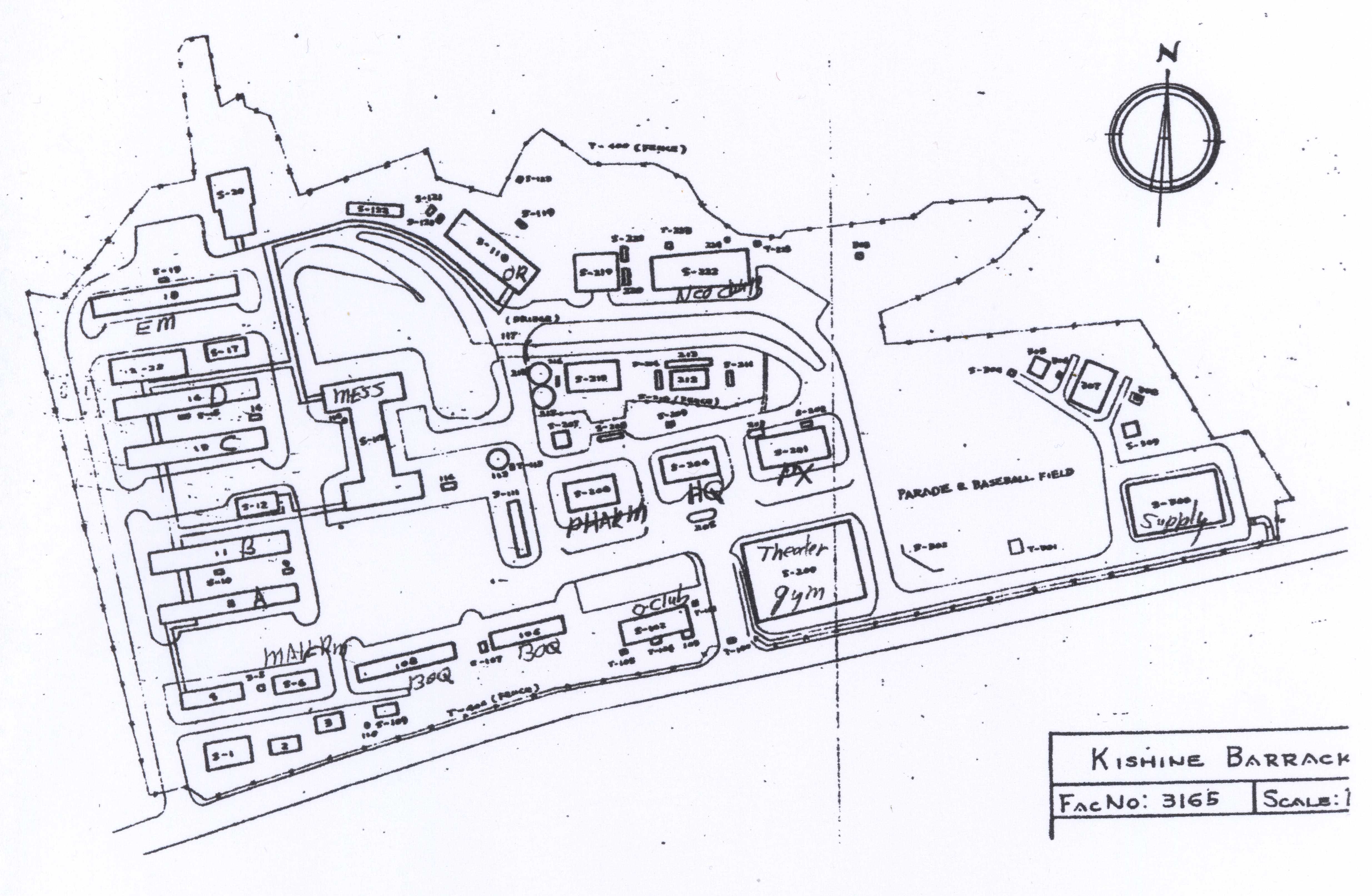 Click image to enlarge
Click image to enlargeMap of 106th General Hospital installations Page 10 of 1969 report as scanned |
The numbers of the buildings on the above map are explained in key on the following page. The numbers are difficult to read but some can be better made out by enlarging the image. The scan is 600dpi -- the highest definition that was meaningful. The handwritten information is as marked on the received map.
Buildings
|
106TH GENERAL HOSPITAL INSTALLATION MAP KEY TO MAJOR BUILDINGS |
|||
| BUILDING NUMBER |
CONTENTS |
ABBREVIATIONS |
|
|
4 S-6 8 11 S-12 13 16 S-17 18 S-20 S-23 S-102 106 108 S-111 S-115 S-118 S-122 S-200 S-201 S-204 S-206 S-207 S-208 212 S-215 S-219 S-222 S-300 303 307 |
Registrar and BEQ Mail Room, APO, Linnen Exchange, and Unit Supply "A" Wards "B" Wards Pathology "C" Wards "D" Wards Radiology Enlisted Billets Chapel Baggage Room Officer's Club [sic = Officers Club] BOQ BOQ Dental Clinic Mess Hall Operating Room and Recovery Room Central Material Supply Theater and Gymnasium Post Exchange, Snack Bar, Barber, Tailor and Bowling Alley Headquarters, Personnel, Finance Hospital Clinic, Pharmacy, Medical Library, EENT Clinic, and Education Center Telephone Exchange Local National Dispensary and Snack Bar Swimming Pool Power Plant Fire Station and Security Guard NCO Club Supply and Service Ammunition Bunker Sewage Plant |
BEQ APO BOQ EENT NCO EM OR HQ PX |
Bachelor Enlisted Men's Quarters Army Post Office Bachelor Officer [Officers] Quarters Eye(s), Ear(s), Nose, and Throat Non-Commissioned Officers Enlisted Men Operating Room(s) Headquarters Post Exchange |
Photographs

|

|
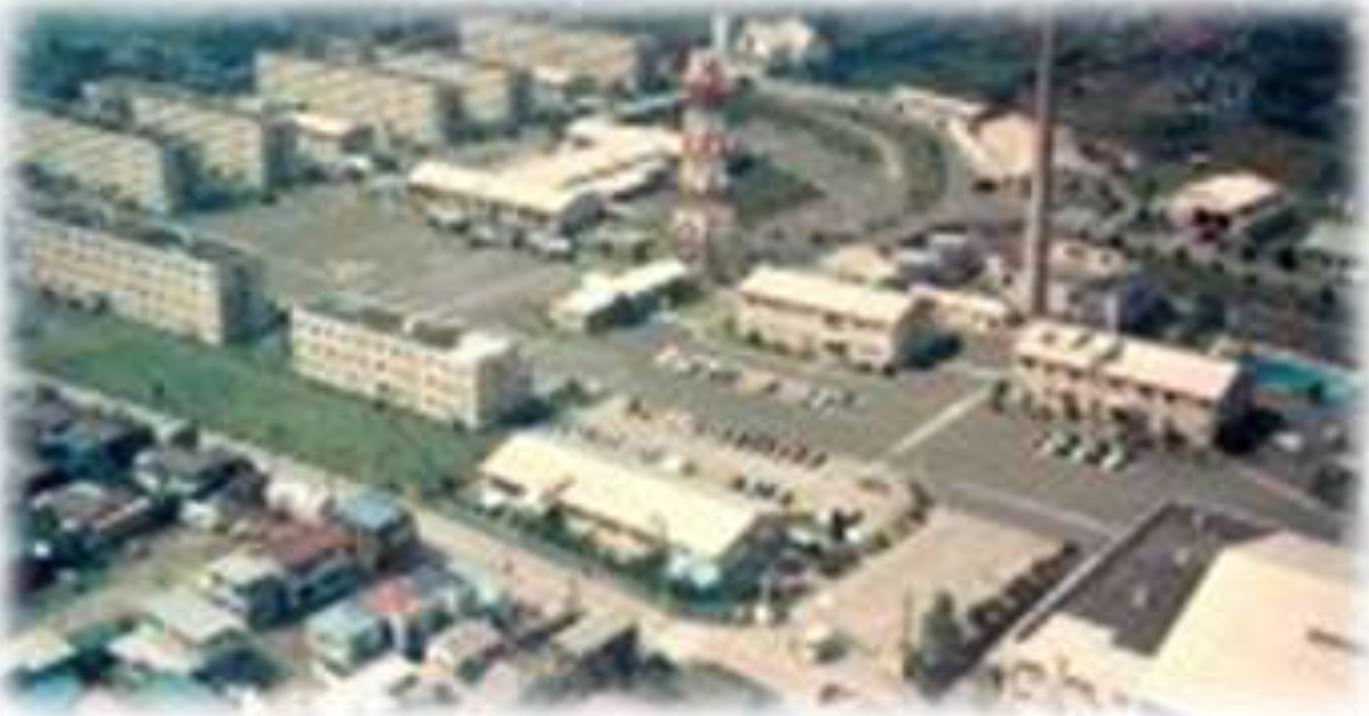
|
|
Click on images to enlarge Aerial views of Kishine Barracks from southeast Scans from copies of pages 12 and 13 of 1969 report as received. Dates and photographers unknown. Probably around 1968. Compare with similar photgraph to right. |
Click on image to enlarge Aerial view of Kishine Barracks from southeast Date and photographer unknown. Probably around 1967. The water tower has been painted white and red. See Tenney (1967) for details. |
|
The black-and-white photographs on the left came at the end of the received 1969 report on the 106th General Hospital. The darker second photo to the right appears to be a crop from the first photo. The baseball field is in the lower right corner. The large building to its left is the theater and gymnasium. The entrance gate is just to their left, and just to its right is the Officers Club. The white building top and center is the chapel.
The color photograph to the right was taken from almost the same aspect as the black-and-white photograph but a bit further to the west (left), which made the tower and chimney appear more to the east (right) of the view. See Tenney (1967) below for story that this picture was attached to by a soldier who was evacuated to the hosptial from Vietnam.
The 106th General Hospital in the Pacific Stars and Stripes
The Pacific Stars and Stripes is the most logical source of reports about Kishine Barracks the 106th General Hospital during its deployment there. I have integrated reports about Kishine Barracks -- from its start in 1957 to the arrival of the 106th General Hospital in 1965, and from the departure of the 106th in 1970 to the reversion of Kishine Barracks to Japan in 1972 -- in the "History of Kishine Barracks" section (below). Here I have organized selected clippings of reports about the 106th under several broad categories that taken together seem to cover all the "bases" as it were.
Viet evacueesThe arrival of the 106th General Hospital at Kishine Barracks does not seem to have been a particularly newsworthy event. I have no idea whether this was the result of policy not to publicize the arrivals of any of the newly deployed hospitals in the area -- or a lack of full awareness until later of the developing medical capacity of the region -- or a reflection of both knowing and being free to report about the hospitals, but waiting until there was something else to report other than just their arrival. The Pacific Stars and Stripes featured 3 photo-illustrated stories about the 106th General Hospital in late January and early February 1966, a month after it had arrived and begun operating. All the first 3 articles were human interest stories having nothing to do with the hospital's mission but more to do with the peculiarities of certain of its staff -- Japan-born Captain Augustine Momiyama (27 January) being able to see his father for the first time in a number of years, identical twin nurses Captains Ella and Dorothy Williams (31 January), and the reunion of two Japanese nurses who had trained together but hadn't seen each other for 30 years Fuku Ebizuka and Yasuko Otake (7 February). Only then, on 9 February 1966, did the Pacific Stars and Stripes get around to "confirming reports" that some soldiers wounded in Vietnam were had been evacuated to Japan, and that there had been a virtual invasion of general hospitals to accommodate Vietnam War causalities. The source of confirmation was the "director of information" of U.S. Forces Japan (USFJ), as though everything had been state secret. Everyone who was been involved in the evacuation of war casualties to Japan, and their transportation and treatment within Japan, had to have known at least a part of the larger picture. And perhaps rumors spread to the Pacific Stars and Stripes but the paper was not in the position to report anything that was no official. "not a barometer of casualties in Vietnam"We see here the utter disingenuousness of officialese. It is one thing for the military to treat the deployment of so many large-capacity field hospitals in the same manner that it treats other troop movements, especially in wartime -- quietly if not with secrecy. It is quite another thing, though, to insult the public's intelligence with a denial of the only reason for such a massive deployment -- the military fully expects there to be a lot more casualties. But don't expect the information officer to volunteer or otherwise admit the truth. Such verbal slight of hand would characterize a lot of official reports on the development of the Vietnam War -- glossing over harsh realities, if not outright lying. |
Hospitals
This section shows some basic information about other major military hospitals and medical facilities that in one way or another were related to, or supported, the 106th General Hospital during the Vietnam War, and are therefore part of its story.
Sagami-Ono Hospital [U.S. Army Medical Center] -- Sagamihara city in Kanagawa
7th Field Hospital, Johnson Air Base --Sayama and Iruma cities in Saitama
Becomes U.S. Army Hospital at Camp Oji -- Kita ward, Tokyo
249th General Hospital, North Camp Drake -- Asaka city in Saitama
406th Medical Laboratory, Camp Zama -- Zama and Sagamihara cities in Kanagawa
587th Medical Detachment (Hel Amb), Camp Zama -- Zama and Sagamihara cities in Kanagawa
Hospitals in Vietnam -- Surgical, field, evac, and other hospitals
Evacuation -- Hospitalization and evacuation in Vietnam and Japan
Hospital expansion program begins
The following article -- published a year after the first confirmation of the arrival Viet evacuees (9 Februrary 1966) -- includes following overview of the history of the on-going development of U.S. military medical facilities in the Tokyo-Yokohama area during the Vietnam War.
Viet Casualties Help Dedicate Hospital ChapelNORTH CAMP DRAKE, Japan (S&S) -- The new Camp Drake hospital chapel was dedicated Sunday with commanders of the 249th General Hospital, their families and several Vietnam casualty patients present. Maj. Cen. Lloyd E. Fellenz, commanding general of U.S. Army Japan, gave a short talk. Three men sat at the back of the I8O-seat chapel in wheelchairs while two others were brought in on stretchers to attend services. [ Omission ] Fellenz' talk outlined a huge expansion project for military hospital facilities in Japan now nearing completion. "When I got here in July of 1965," he said, "we had one small dispensary at Sagami, capable of taking care of about 80 patients." Fellenz said a huge influx of medical evacuees overloaded the Japan medical facility at one point to 650 patients, "and our people held on with guts and a strong devotion to duty". Then, he said, the expansion program began. First to arrive was the 7th Field Hospital, operating at Johnson AS, near Tokyo. The 249th General Hospital moved into Camp Drake late in 1965, and began a $2.8 million buildup, of which the new chapel is a part. The 106th General Hospital went to Kishine Barracks later in 1966, and Fellenz said a new hospital is being readied at Camp Oji. Total Japan capacity will be around 3,800 beds, he said, but this is a cutback from the original figure of 10,000 planned by the Army. About 1,000 beds will be installed in converted warehouses, extra wings of a sprawling communications center and in new buildings when the Drake buildup is completed, Fellenz indicated. He said that 13,355 Vietnam casualties have been treated in Japan since January, 1966. "It isn't often that a commander can start a project this large and see it brought to a successful completion within the span of his own command," Fellenz said "I'll always remember the determination and drive which is making the hospital buildup program a success." |
|
|
"later in 1966" The quality of the reporting could have been better. The Pacific Stars and Stripes often misreported the date from which the 106th General Hospital arrived and began operating at Kishine Barracks. And the language is vague. Does "later in 1966" mean "not in 1965" or "later rather than earlier in 1966"? "a new hospital" The phrase "a new hospital" could give the impression that an additional hospital was then being built. But the facilities at Camp Oji were being readied for the 7th Field Hospital, which had been stationed at Johnson Air Station only temporarily. |
Doctors
As of 9 January 1969 -- about 14 months after the above article appeared and a year after the Tet Offensive, when U.S. forces in Vietnam numbers of casulaties -- there were 43 medical doctors at the 106th General Hospital (see Personnel section of 1969 report, above). Dr. Bohn D. AllenOne of most notable physician at the 106th, in terms of the publicity generated by its position as the regional Burn Center and his role as its resident burn specialist -- was Dr. Bohn D. Allen, who is pictured in the upper right corner of the article when he was a Major. By the time he began authoring and co-authoring medical reports related to burns and other injuries and wounds at the 106th, he had become a Lieutenant Colonel. See examples of some of his reports under Medical reports below. After completing his tour of duty, Dr. Allen returned to Texas, where he had received his medical education and been licensed in 1961, and became a staff surgeon at the Texas Health Arlington Memorial Hospital. On 1 June 2012, The University of Texas Medical Branch, School of Medicine Alumni Association, honored him, among a few other graduates, with an Ashbel Smith Distinguished Alumnus (ASDA) Award, as follows, according to a November 2012 ASDA news feature posted by UTMB's School of Medicine Alumni Association. |
Bohn D. Allen, MD, FACS -- Class of 1961Dr. Allen attended the University of Texas in Austin and graduated from the University of Texas Medical Branch in 1961. He served an internship at Fitzsimmons General Hospital in Denver, Colorado, a residency in general and vascular surgery at Madigan General Hospital in Tacoma, Washington and a fellowship in burns at the Institute of Surgical Research Burn Unit at Brooke Army Medical Center in San Antonio. Dr. Allen is past president of the Arlington Medical Society, Tarrant County Medical Society and Fort Worth Surgical Society. He is past president of the Texas Medical Association (TMA), having served various positions on TMA boards, councils and committees. He was a delegate to the American Medical Association from Texas for sixteen years, and he is a past president of the Texas Surgical Society. Dr. Allen is chairman of the Board of Trustees of Arlington Memorial Hospital and serves on the Board of Trustees of the Texas Health Resources hospital system. Dr. Allen was in private practice in Arlington, Texas for thirty-two years. He now serves as the physician director of the Outpatient Surgery Clinic at John Peter Smith Hospital in Fort Worth, Texas, teaching surgical residents and medical students. |
Nurses
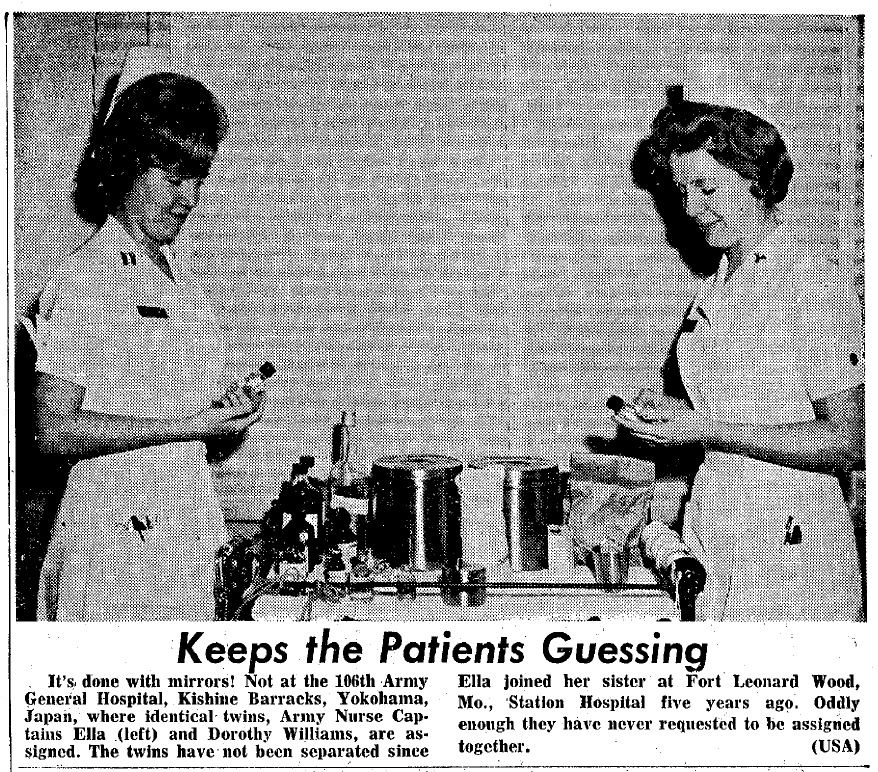 Pacific Stars and Stripes
Pacific Stars and Stripes31 January 1966, page 17 |
 Pacific Stars and Stripes
Pacific Stars and Stripes22 September 1966, page 17 |
 Pacific Stars and Stripes
Pacific Stars and Stripes7 February 1966, page 7 |
Beauty vs. sentimentI don't know who picked up the phone first -- a Stars and Stripes reporter looking for a story, or a public relations official at the 106th General Hospital Headquarters who had some stories and was looking for a publicist. Nothing trumps two pairs of beautiful nurses . . . Captains Ella and Dorothy Williams (top left) were billed as identical twins, and the photographs appear to bear that out. 1st Lieutenants Marie and Precilla Alire (top right) were said to be just look-alike sisters, but one could be forgiven for thinking that they were twins. Both sisters ran for queen (Albuquerque Journal, 23 April 1965, page 40) but Marie took the crown (right). The Alire sisters, from Dulce, New Mexico, enrolled in Regina School of Nursing at St. Joseph Hospital in Albuquerque, New Mexico, in September 1962 (The Albuquerque Tribune, 11 September 1962, page B-3). They enlisted in the Army Student Nurse Corps during their 3rd year and were commissioned 2nd Lieutenants when they graduated (Alamogordo Daily News, 13 October 1964, page 8). . . . except a 30-year reunion of a pair of nurses. The back stories to the story of the reunion of Fuku Ebizuka and Yasuko Otake would seem to be the relationships between the two Japanese nurses and the ANC nurses at Kishine. Maybe the original story was longer and got cut in the editing. A picture of the four nurses would also have been nice. |
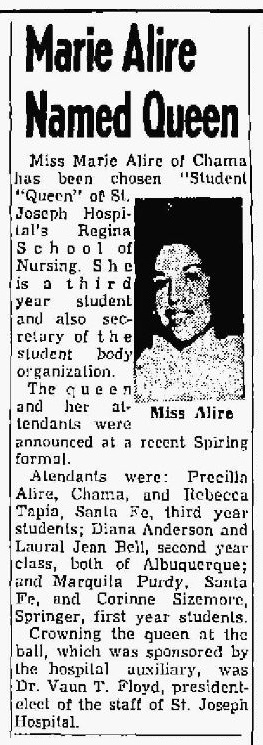 The Albuquerque Tribune
The Albuquerque Tribune28 April 1965, page A9 |

 U.S. Army Register, Volume 1: United States Army Active and Retired List
U.S. Army Register, Volume 1: United States Army Active and Retired List1961 (top), 1966 (bottom), United States Government Printing Office (Captured from Ancestry.com) |
Colonel Helen Louise McCormick, ANC
The 106th General Hospital report published in early 1969 lists Lt. Col. Helen L. McCormick, ANC, as the Chief of Nursing Services. She appeared in a number of newspaper article reporting concerning her both while and after she was at Kishine Barracks.
U.S. Army registers show that she was born on 13 June 1920 and enlisted in the Army in 25 May 1943. She was promoted to Lt. Col. on 8 October 1965, a couple of year before she came to Kishine.
During the height of some rather disruptive radical student protests against U.S. military hospitals in Japan (see Community protests below), which were widely reported in the United States. A number of papers also carried the following Associated Press (AP) article datelined Yokohama, about a Japanese who anonymously sent flowers to the "Kishine Hospital".
The headlines in the text and image versions are different as they are from different newspapers, and papers are generally responsible for writing the headlines of wire-service reports. Other headlines include "Japanese Sends Flowers To GI's" --
Tuesday, August 6, 1968 Flowers SentYOKOHAMA (AP) -- Japanese leftists have demonstrated against U.S. hospitals in Japan that get casualties from the Vietnam war, but one anonymous Japanese has been sending flowers every week to thank U.S. military men for fighting for freedom. The flowers come to the U.S. Army's Kishine Hospital in Yokohama, which treats patients from the war. "The florist who delivers them refuses to identify the Japanese, but the gifts are more than welcome." said Lt. Col. Helen McCormick of Chicago, the hospital's chief nurse. The flowers and potted plants have been coming since June 1967, usually on Friday, and are taken each week to different wards. A greeting, signed "A Japanese," is usually attached. One recent card read: "These flowers I send each week are my comforting words to those who have been fighting for freedom. . . It is because your army struggles against communism that I am able to send flowers. It is the least I can do. . . I wish the brave a speedy recovery." |
By June 1972, two years after she had left Japan, McCormick had been promoted to Colonel at Ft. Sill, where she had been posted before being sent to the 106th General Hospital in 1968. A local Lawton paper reported the promotion ceremony, with a biographical overview of her career, as follows.
|
Wednesday, June 14, 1972 Reynolds Nurse Gets Eagles[Fort] Sill's chief of Nursing Service received what she termed her "nicest and most long lasting birthday anniversary present ever hosted by the staff at Reynolds Army Hospital. THE SURPRISE was a promotion for Col. Helen L. McConnick. Two shiny eagles, symbols of her new rank of colonel, were pinned to her nurse's uniform by Maj. Gen. Roderick Wetherill, post commander, who was assisted by her mother, Mrs. Helen McCormick of Lawton. Afterwards the general gave a congratulatory kiss to the only woman at the field artillery post to hold the rank of colonel. "I have known for some time that I would be promoted," she beamed, "but I had no idea when, so this was a very happy "birthday surprise." Col. McCormick, who has headed the Nursing Service at Reynolds Hospital the last two and one-half years, first entered the Army Nurse Corps in 1943 after graduation from the South Shore Hospital School of Nursing in Chicago, Il. "There was all out war then," she said, "and serving in the Army was really just the thing to do. As a nurse I didn't see that I had any other choice but to help my country. "I suppose that may sound corny now," she continued, "but there was a totally different atmosphere at that time." FOLLOWING the war, Col. McCormick left active service to work with the Veterans Administration but remained with the Army Reserve. Then in 1951 as a result of the Korean Conflict, she was recalled to active duty and that time decided to remain. "I don't know that I have advanced more rapidly in the Army than I could have in a civilian career," she commented, "but I have enjoyed what I have done, and I have very good assignments! "Actually. I can't think of any further goals for myself in the Army except to keep trying to stay up with the many changes in nursing that are coming about and to improve the service we give. "I'm not aiming to become a general," she smiled. "I never even thought I'd be made a colonel." DURING her 24 years of active service, Col. McCormick has had four overseas tours, two each in Europe and Japan. Prior to coming to Fort Sill she served as the chief of Nursing services from 1968 to 1970 at the 106th General Hospital in Japan. "That was one of my most different assignments," she said, "because we had so many casualties from Vietnam to treat. Thank goodness that number has been cut back now." Among the awards she has received during her career are the Meritorious Service Medal, the European Asian Middle East Campaign Medal and the World War II Victory Medal. |
Other staff
Dental techs and aides
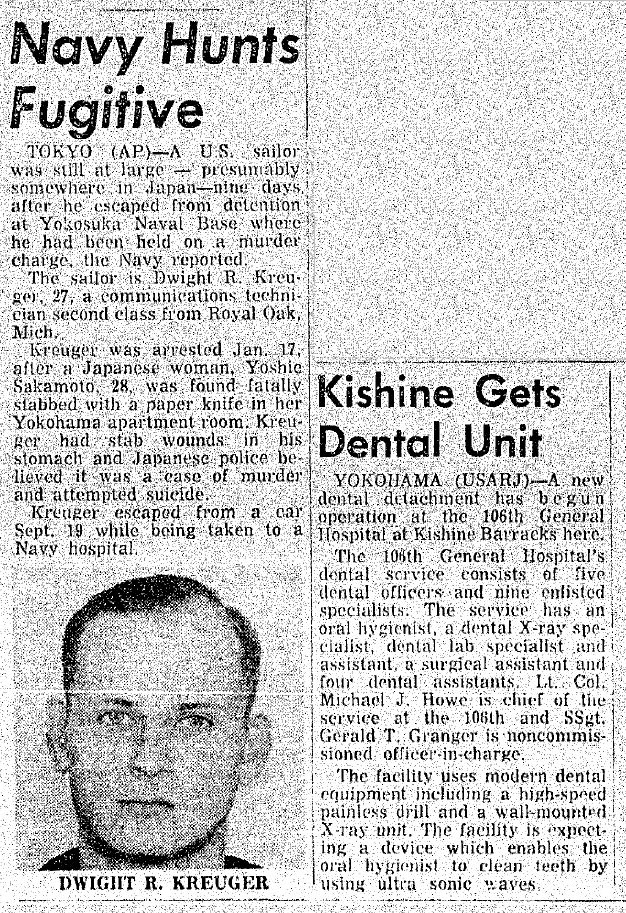
Pacific Stars and Stripes |
Dental assistants Murder-suicide |
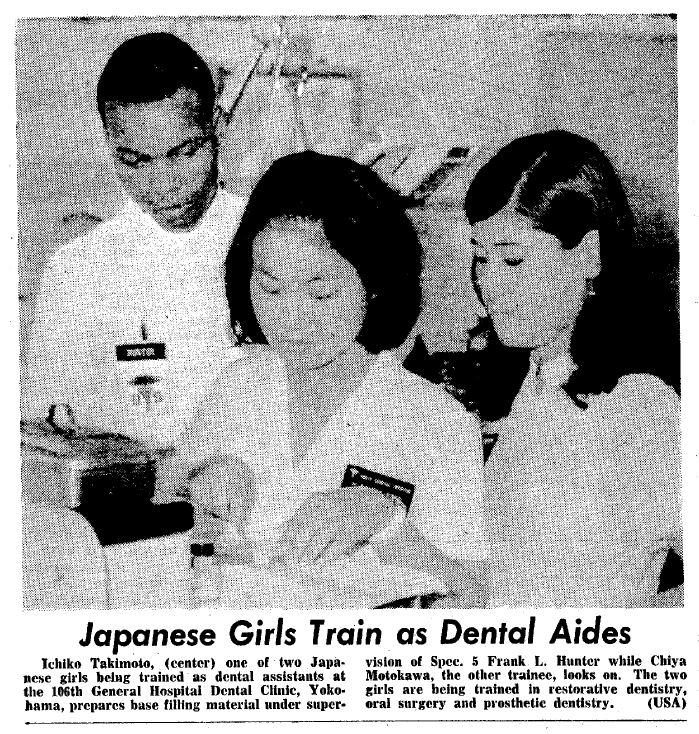
Pacific Stars and Stripes |
|
Social workers
Augustine Tadahiko MomiyamaThe first major Pacific Stars and Stripes story about the 106th General Hospital at Kishine Barracks featured an officer who was arguably the hospital's most unusual staff member -- Captain Augustine T. Momiyama. He was born, raised, and educated in Japan through high school, then went to the United States in 1954 for college, graduated and married in 1958, completed graduate school and naturalized in 1960, joined the U.S. Army Medical Service Corps in 1962, and returned to Japan for the first time in 11 years with the 106th General Hospital in 1965. Momiyama mastered English as a high school student at St. Joseph College in Yokohama, and after graduating in 1953, he continued to polish his English at the U.S. Army R&R Center in Yokohama. Kishine Barracks, built a couple of years after Momiyama left Japan, become the main R&R facility in the Tokyo-Yokohama area until the arrival of the 106th General Hospital. I knew of and saw Captain Momiyama at Kishine Barracks but do not recall having a conversation with him. He was the chief of the Psychological Social Work section, and Patrick Metoyer, a mess hall friend with whom I also went hiking, was a specialist in Momiyama's unit. Augustine "Auggie" Momiyama was born Tadahiko Momiyama on 3 January 1933 in Fujisawa in Kanagawa prefecture (or in Urawa in Saitama prefecture) in Japan. He died on 20 December 2015 in Lorton, Virginia, where he had been residing in retirement. 1972 military records state that his service in the Regular Army began on 26 September 1962. He was promoted to the temporary rank of major on 13 May 1968, and his former rank of captain became permanent on 26 September 1969. (U.S. Army Register, 1972, Volume 1) The Fall 2001 issue of Horizons, the Northern Michigan University alumni journal, remarks that Augustine Momiyama, Class of 1958, BS, Class of 60, MA, of Tokyo, Japan, "is a senior linguist at Defense Attache, United States Embassy in Tokyo. He served as an Army social worker for 23 years, did a combat tour in Vietnam, and retired in 1985 as a lieutenant colonel" and gives his email address as "momiyama@hpo.net" (page 22). Civilian, Augustine Momiyama served as the Director of Social Services at St. Francis Medical Center in Honolulu from 1986 to 1988, and from 1988 began working for the Department of Defense as a Senior Social Worker and Senior Language Specialist. From 1991 to 1994 he served as the Chief Social Worker of Medically Related Services at the U.S. Navy Hospital in Yokosuka. And from 1994 to his retirement in 2004, he served in a variety of posts, including a stint at the U.S. Embassy in Tokyo, as a translator and interpretor. Momiyama retired in Lorton, Virginia, where he lived with his 2nd wife until his death in 2015. He was the father of 3 children by his 1st wife. |
Momiyama through classmate's eyesVictor S. Lavrov, born in 1935 in Karafuto -- then part of Japan, now the southern part of Sakhalin in Russia -- was raised and educated mostly in Yokohama, including high school at St. Joseph College, where he was one of Momiyama's classmates. In his 2015 memoirs, Lavrov caricaturized all 23 graduates of the class of 1953 in a first person voice on the day of graduation, including the following back-to-back takes of himself and Momiyama (pages 159-160).
Momiyama's obituary
Find a Grave memorialA Find a Grave memorial states that LTC Augustine Tadahiko Momiyama was born on 3 January 1933, died on 20 December 2015 at age 82, and was interred at Arlington National Cemetery in Virginia on 20 April 2016 (Plot Section 55, Grave 1835). The memorial states that his tombstone bears the inscription "Lieutenant Colonel U.S. Air Force". In principle, Find a Grave memorials include a photograph of the deceased's grave marker or columbarium plaque. But Momiyama's memorial has no photograph, hence I am unable to confirm the reported inscription. Is the inscription, or the report of the inscription, wrong? All accounts of his life say he served 23 years in the U.S. Army commencing in 1962 and ending in 1985. Momiyama's family lifeFor a chronology of Augustine T. Momiyama's life, including details about his marriages and children, see Momiyama Tadahiko on the "Couples" page in the "People" section of the Konketsuji website. Momiyama's brotherAugustine Tadahiko Momiyama's older brother, Thomas Sadahiko Momiyama (b1931), came to America a year before Augustine and became one of America's leading naval aeronautical engineers. Many stories have been written about him, including Thomas S. Momiyama, U.S. SES (Smithsonian National Air and Space Museum), and Turning a boyhood dream to fly into a naval aviation career (Donna Cipolloni, 30 September 2016). I have integrated some details about Thomas's Sadahiko's life in the chronology of life of Momiyama Tadahiko on the "Couples" page in the "People" section of the Konketsuji website. |
|||||||||
"I was there"At the 106th General Hospital, ophthalmology was under the Department of Surgery, and for a while at least its chief was Paul Wachtel. Wachtel's wife -- Mrs. Paul Wachtel (what else?) -- got more publicity than he did, if the brief to the right, which appeared on the society page of the Thursday, 23 January 1975 edition of The Times (page 15), is any indication. This is not The New York Times, or the Los Angeles Times, much less The Times in London, however. Rather -- as it bills itself -- it is merely the "Only Newspaper With Complete Scotch Plains - Fanwood [New Jersey] News". Civilian dependents who accompany U.S. military personnel to foreign countries -- usually wives and children -- inevitably live somewhat extraordinary lives, even if they spend most of their time in dependant housing facilities with post or base exchanges and American schools. Children will be exposed to local national employees including possibly domestic servants. Wives are likely to become involved in cultural activities. When returning to the United States, dependants will take their familiarity with the foreign country with them. The living rooms of families that have been in Japan are likely to be mini museums of Japanese folk crafts and art works, and their gardens will probably have a stone lantern (which are fairly common in Japanese gardens) or a Buddha or two (which are rarely seen in Japanese gardens or homes). Dependent children will tap their experiences and artifacts for show-and-tell themes. Adults will be regarded as Japan experts, and some -- like Mrs. Wachtel -- will find themselves invited to share if not market their knowledge and skills at local social and cultural events. |
Patients
 Click on image for readable pdf file
Click on image for readable pdf filePacific Stars and Stripes 8 November 1967, page 9 |
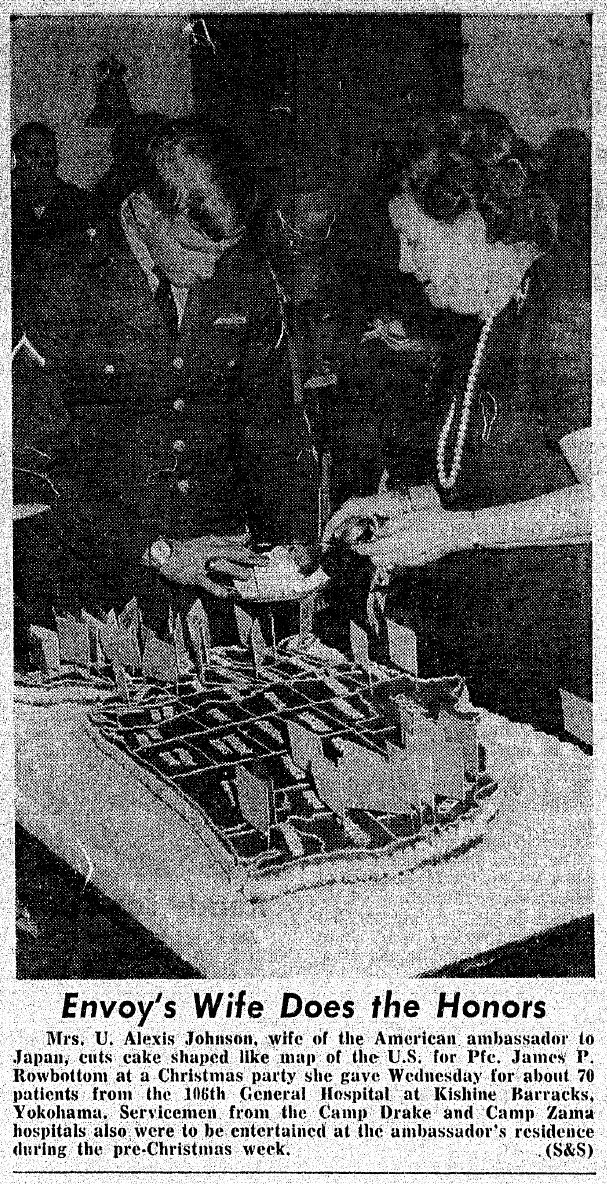 Pacific Stars and Stripes
Pacific Stars and Stripes25 December 1967, page 23 |
Therapeutic effect of art and Chrismas cake
All manner of civilians traipsed through the 106th General Hospital to attempt to make its patients feel better about their condition. Mrs. Carroll Aument (left) visited the 106th once a week to sketch portraits of patients. Mrs. U. Alexis Johnson (right), the wife of America's ambassador to japan, made the rounds of area hospitals to help some of their patients celebrate Christmas.
Medals and awards
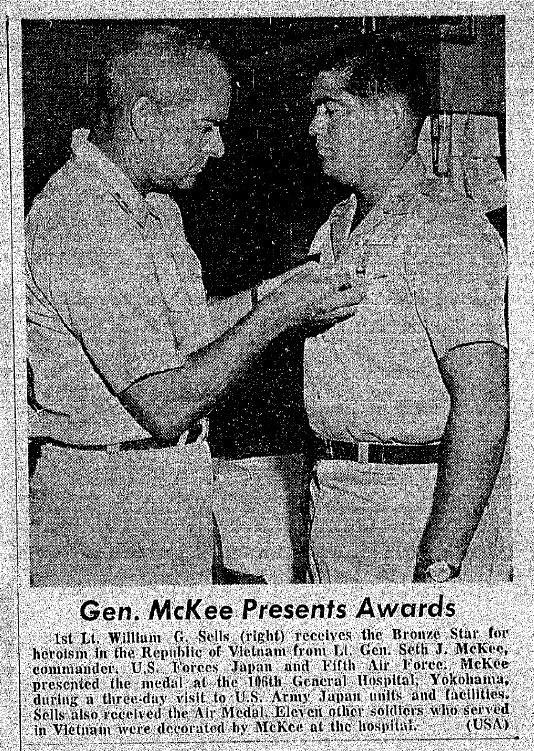 Pacific Stars and Stripes
Pacific Stars and Stripes31 August 1966, page 17 |
 Pacific Stars and Stripes
Pacific Stars and Stripes7 February 1967, page 17 |
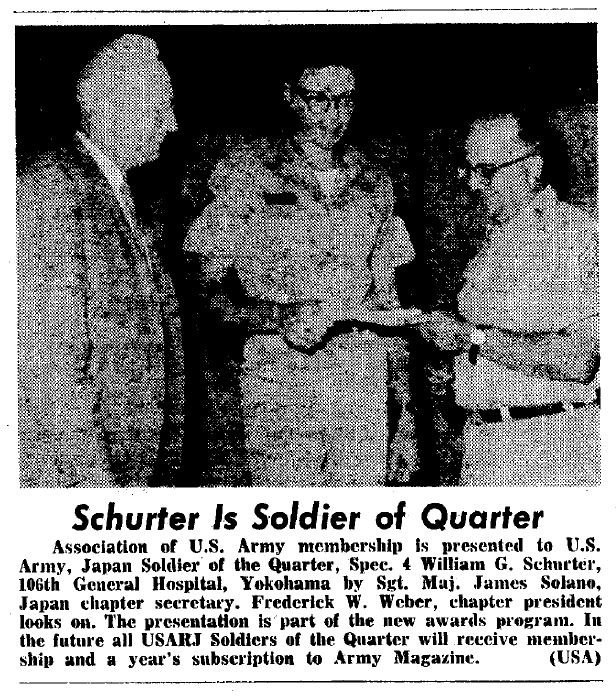 Pacific Stars and Stripes
Pacific Stars and Stripes22 August 1967, page 7 |
Medals and awards for extraordinary service
Many patients at the 106th General Hospital, such as William Sells (left), received combat medals while at Kishine Barracks. But some hospital personnel were also cited for their work, including Patrick Metoyer (center) and William Schurter (right), who were named the Soldier of the Quarter in the U.S. Army Japan command in 1967.
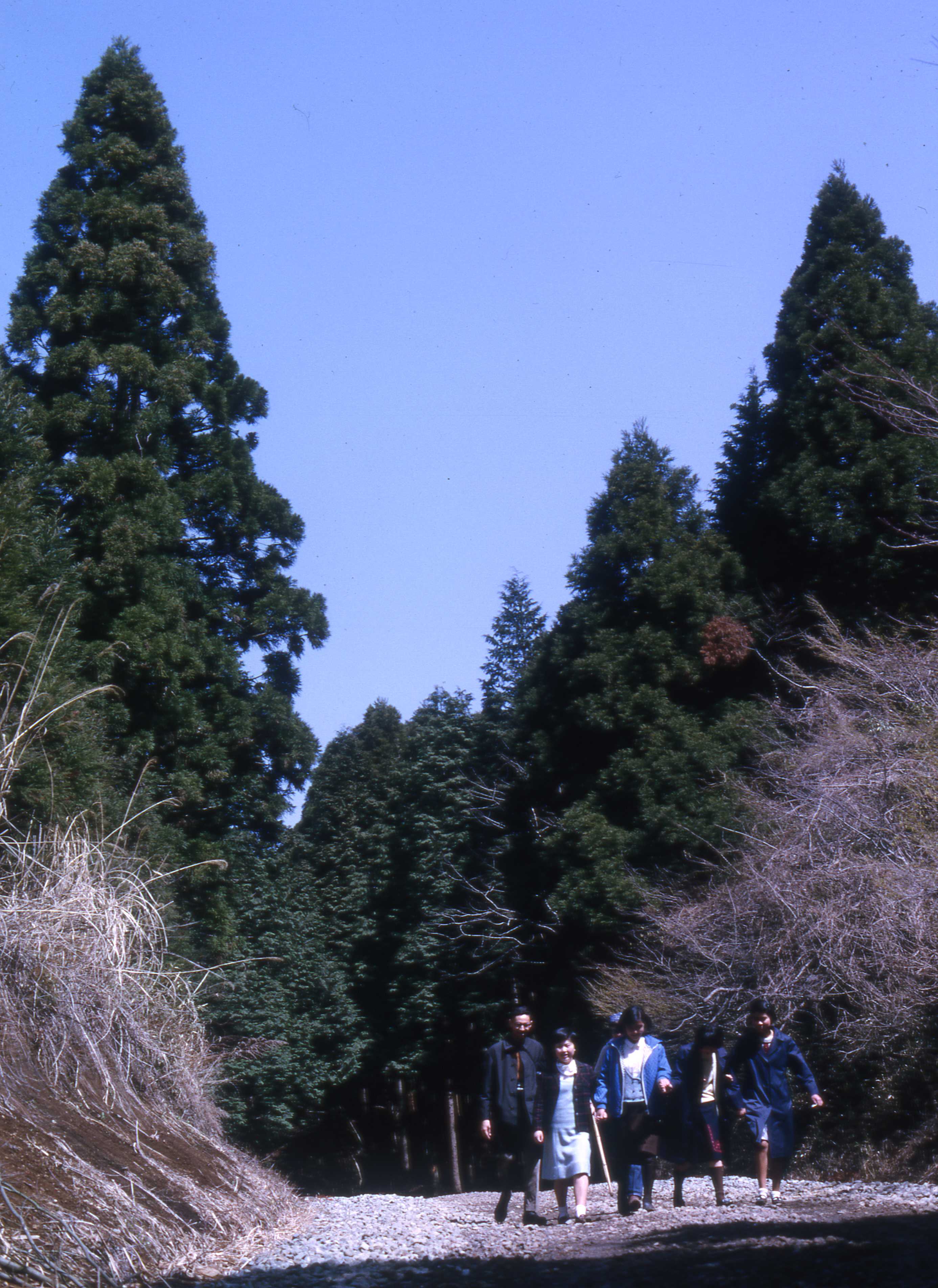 Click image to enlarge
Click image to enlargePatrick Metoyer with orphans at Tanzawa Photograph by William Wetherall, circa April 1966 |
Patrick Metoyer: From Soldier of the Quarter (1967) to Veteran of the Day (2014)
Patrick Gerald Metoyer (b1943) was a member of the original complement of 106th General Hospital personnel deployed to Kishine Barracks from Ft. Bliss in December 1965. He was a social work specialist and I was a lab tech, so we worked in different sections, but we often engaged in serious conversations at the mess hall.
I didn't stay in touch with Patrick and would not reconnect with him until 2016. But I thought of him whenever my days at Kishine crossed my mind -- and whenever, in my files, I encountered the copy of an article on the Shin-Tokaido Bullet Train which he had loaned me, shortly before I left Kishine, which I had promised to return but didn't.
Patrick Metoyer told me in email that the photograph of him receiving the Soldier of the Quarter award was probably taken by Jay Jaffe (see below), another member of the original party.
Patrick organized some hiking trips to Tanzawa, a mountain range in the northwest of Kanagawa prefecture on its borders with Shizuoka and Yamanashi prefectures, with orphans from a Catholic home in Yokohama. The hikes were conceived as a volunteer activity which gave 106th personnel an opportunity to get out and mix with the Japanese community. I went on a couple of these hikes, which were joined by a few enlisted men and officers from the 106th, with children from the orphange and one or two of the fathers (one was Father Valentine). We all got to stretch our legs, and the orphans got to practice their English if they weren't too shy.
Drafted in 1965, Patrick left the army after completely his tour of duty with the 106th in 1967. With a background in education, he became a teacher, and in 1985 he moved to Grand Junction, Colorado, where he began to pursue a growing interest in art. A serious bout of illness that stretched over several years led him to understand the therapeutic value of artistic activities, and be began to share his time and energy working with veterans.
In 1990, Patrick served as the co-chair of NAMI Veterans Network, which was linked with the National Alliance on Mental Illness (NAMI) and the Department of Veterans Affairs (DVA). The network reached out to veterans and families of veterans in need of psychiatric and other assistance.
Since 1998, Patrick has been participating in both the performance and visual arts divisions of National Veterans Creative Arts Festival (NVCAF) competitions, and over the years he has won a number of awards in this and other competitions. NVCAF works closely with medical facilities that use creative arts to facilitate the rehabilitation of veterans who continue to deal with physical and emotional difficulties.
By 2008, Patrick had won a prize for a poem he created out of the prose of another veteran who had passed through the 106th General Hospital at Kishine, as told in the following story by Grand Junction Free Press writer Darralee Coba, and published in the Post Independent / Citizen Telegram, a merger of the Post Independent in Glenwood Springs and "The Citizen Telegram in Rifle, Colorado.
Grand Junction veteran honored for his artBy Darralee Coba November 10, 2008 GRAND JUNCTION, Colo. -- U.S. Army veteran Patrick Metoyer won a gold medal in the drama category of Solo Patriotic Prose at the local Veterans Art Competition at the Grand Junction VA Medical Center. That honor earned him a trip to the 2008 National Veterans Creative Arts Festival in Riverside, Calif., for his dramatic reading of "Greetings." Metoyer, a Vietnam-era veteran, earned a Therapeutic Arts Scholarship to the festival. This is the first year the scholarship was offered. Metoyer was one of 130 veterans from across the nation who were invited to the event. "Winning a gold medal at our local creative arts competition has allowed me to achieve one of my artistic goals," he said. "That has motivated me to continue working toward other long-term goals." The reading was an excerpt from a 2007 Internet posting by another veteran, Ronald Wheatley, called "War and Peace Corps, Elusive Dreams." Elusive Dreams Metoyer edited the piece for time and dramatic effect. "It was a challenge to select a passage which would fit the three minute limit of the dramatic reading," Metoyer said. "I was able to identify with several aspects of Wheatley's experience. I am thrilled that his writings helped me earn a national gold medal." Wheatley had been a Peace Corps volunteer in Nigeria from 1963 to 1965 and worked for a year as a teacher before enlisting in 1967. Come to find out, Wheatley was moved from Vietnam to the U.S. Army 106th General Hospital in Yokohama, Japan, just after Metoyer had completed his service there in 1967. Metoyer was a social work technician at the hospital in Yokohama from December 1965 to June 1967; one of his jobs "was to assist the medical staff to help soldiers burned in Vietnam adapt to their situation." "Our team afforded the patients the opportunity to ventilate the range of emotions they were experiencing," he said. "This process helped the soldiers accept their condition and usually prevented inappropriate acting out and sabotaging their medical treatment." Wheatley, now an attorney near Boston, said, "I was just as thrilled as Patrick to hear of his award, and was honored that he had chosen a selection from something I had written." In addition to performing his dramatic reading, Metoyer was part of a 70-member chorus that rehearsed and staged a variety show in less than a week. In the opening medley, Metoyer took the part of the Tin Man from "Wizard of Oz," accompanied by Dorothy, the Cowardly Lion and the Scarecrow. The festival is sponsored by the Department of Veterans Affairs, Help Hospitalized Veterans and The American Legion Auxiliary. |
Patrick also began to participate in the National Veterans Creative Arts Festival (NVCAF), which medical facilities use the creative arts as one form of rehabilitative treatment to help Veterans recover from and cope with physical and emotional disabilities. Across the country each year, Veterans treated at VA facilities compete for festival awards.
He can be heard talking about his work in a 2014 interview by American Legion Auxillary HQ posted at Soundcloud.
The U.S. Department of Veterans Affairs named him Veteran of the Day on 2 November 2014 as announced on Facebook and Twitter.
U.S. Department of Veterans AffairsNovember 2, 2014 Today's Veteran of the Day is Patrick Metoyer. Patrick served in the U.S. Army and now resides in Colorado. He is currently attending the 2014 National Veterans Creative Arts Festival in Milwaukee, Wisconsin after winning a gold medal for his Fiber Art design called "Leaning Tower." Over the past 20 years, Patrick has found art therapy as a personal source of healing and relaxation and says that "the arts are a welcome distraction from life's challenges." |
Recent links
2015 Americal Legion Auxiliary (ALA) Soundcloud talk
Interview with Patrick Metoyer, 2014 NVCAF Participant
Interview with Partick Metoyer, gold medalist in Original Design in Fiber Arts, Art Division, from Grand Junction, Colorado
22 April 2019 Mesa County Oral History Project interview
Local History Thursday: How U.S. Veteran Patrick Metoyer Became An Activist For Mental Health
Mesa County Libraries video interview by Noel Kalenian
2 MP4 video files (39:18, 25:35) and transcripts
Posted by Noel on 23 January 2020 on website of
Mesa County Libraries, Colorado
From about 23:00 to 29:00 in the 1st video file, Patrick tells part of his own "war story" -- from the perspective of his service as an Army social worker at the 106th General Hospital from 1966-1967. His story embraces the stories of men like Richard Sisk (1968), Roger Jacobs (1967), and Robert Timberg (1967) (see their stories below). Patrick puts it poetically like this.
Three marines turned journalists
Three who lived to write and tell three war stories
Aside from their membership as Marine frat brothers
Each made his way to the US Army 106th General Hospital, in Yokohama, Japan
My duty station from 1965 to 1967 . . . .
Red CrossThe Red Cross is everywhere a symbol of medical care but also of good will. What is known today as the International Committee of the Red Cross (ICRC) originated in Switzerland, but there are numerous national and other groups that share the common Red Cross or Red Crescent mission of providing humanitarian aid and relief to people, and carrying out vaccination and blood donation work, not only in times of war but under peaceful conditions, and of course also in response to natural disasters. Red Cross organizations are nominally charitable entities, but at the same time they are businesses with salaried officers and employees and at times political interests. The American Red Cross (ARC), for example, has been involved in a number of law suits and scandals concerning its operations. At a grass roots level, however, most people -- including patients at the 106th General Hospital -- know the Red Cross as mainly female volunteers who perform various kinds of social work and participate in recreational activities. Like all charitable organizations, the Red Cross invests a considerable amount of its human and financial resources in public relations and funding campaigns, and in building camaraderie among its members and awarding them for their service -- which is mainly what the articles shown here are about. Yohi volunteersOne of the articles (above right) refers to the 106th General Hospital as Kishine Hospital. Many people who have written about their experiences at the hospital, in fact, remember its name as "Kishine". Janet Bready arrived with her Army family in Japan on 2 September 1966. The family was supposed to live at Camp Zama but ended up residing in Negishi in Yokohama. She attended Yokohama American High School and would have graduated with the class of 1970 but returned to the United States in August 1969. The tells this story on the Yohi Devils alumni site. As President of the [Yohi] Red Cross I was able to attend a Red Cross youth camp one summer at the foot of Mt Fuji. I attended with other military brats from all different bases in Japan. That did give me the opportunity to see more of Japan than just our general base area. Also being involved in the Red Cross we went to Kishine hospital monthly and always had some kind of activities for the wounded servicemen. I remember one Christmas Eve going to the hospital and having a Christmas party for them and it was so touching. The guys could not believe that a bunch of 14-15 year old girls cared enough to give up their time to visit them and to try and make their Christmas a little nicer. |
Celebrities
 Pacific Stars and Stripes
Pacific Stars and Stripes5 May 1967, page 7 |
 Pacific Stars and Stripes
Pacific Stars and Stripes3 November 1966, page 19 |
 Pacific Stars and Stripes
Pacific Stars and Stripes28 January 1968, page 17 |
Medals and awards for extraordinary service
All manner to well-known and lessor-known singers, comedians, dancers, and other performers made the rounds of military bases in Japan, especially the hospitals, during the Vietnam War, some before, others after, swinging through Vietnam. Bob Hope visited Kishine Barracks in 1967, and Alan Pierce (below), who at the time of Hope's visit was holding down a public information post at the 106th, lived to tell about it.
MilieuThe Pacific Stars and Stripes gave quite a bit of space to political and social issues in Japan, in addition to its focus on U.S. and world news. There is no end to the list of interesting and at times amusing briefs that helped relieve the tedium of ordinary incident reports. Japan Defense Agency uniformsAs someone who has done his share of commuting by train into Tokyo from various residences mostly outside the city, I can testify to never having seen anyone commute in a Self-Defense Force or even police uniform. Uniformed airlines personnel are also rarely seen on trains, even near airports. Middle school and high school students wear uniforms to and from school. Older students who want to play after school at places where they are not supposed to play, such as at game centers or other places where a uniform would make them conspicuous, will change into other clothes before hitting the entertainment quarters. People who need to wear uniforms at work almost invariably commute in street clothes and change at their offices or factories. Jokes about janitors commuting in business suites with briefcases so neighbors will think they have a high status job are funny because they have elements of truth. EncephalitisAll mosquito-borne diseases were a potential threat in Japan in the 1960s when the 106th General Hospital was at Kishine Barracks. The malaria ward took strict measures to make sure that mosquitoes did not cross the thresholds ward doors, either in the air or on clothing or in hair or other objects. Special care was taken when drawing and handling blood specimens of patients being treated for malaria or other diseases that could be transmitted through contaminated blood. The main concerns were being pricked with a contaminated needle, or contaminated blood coming into contact with an open sore. In those days, we did not generally wear protective gloves when handling blood or other routine specimens. Nor did we wear protective goggles or masks when performing routine chemistry and bacteriology procedures. We had hoods but rarely had to use them. We were just careful. And of course we used lots of PHisoHex and wore freshly laundered whites every day. I got in the habit of using PHisoHex to wash my face, and I continued to buy it in drug stores after returning to civilian life. I was disappointed when one day I found only PHisoDerm, and then it too disappeared from the shelves. Both trade names are back but the product lines are different. And the green plastic bottles are history -- except for a couple I still have, which are still full. |
Security issues in the late 1960s and early 1970sBy 1968, when the United States began pulling some combat units out of Vietnam, PRC was in the throes of the Cultural Revolution. Both the United States and Japan would have liked to normalize their relations with PRC, but the political instability on the mainland, and its siding with the Democratic Republic of Vietnam (North Vietnam) in the Vietnam War, made it difficult to include PRC in regional talks initiated mainly by non-Communist states. In many respects, Southeast Asia was a minor security problem. From a regional security point of view, the United States should never have become involved in Vietnam's civil wars in the first place, but let the natural selection take its political course and establish friendly relations with which ever government, north or south, emerged the winner. But far more important for the United States were the problems that had developed in China and Korea after the Pacific War. Not only did these problems remain unsettled, but Okinawa came to be seen as the strategic heart of America's Northeast Asian security operations. The continued instability in East and Northeast Asia provoked considerable controversy in the United States, among people concerned about security in the Western Pacific, as to whether and under what conditions America should return Okinawa to Japan. While the United States did return Okinawa, it did so under conditions that allowed it to continue to maintain its virtual extraterritorial military bases on the islands, which remain today, nearly half a century later. The instability of the region today is no longer domestic but nationalistic, as fairly strong regimes confront one another over old and new territorial issues. And as before, the presence of U.S. forces in Japan, the Republic of Korea, and the Philippines and elsewhere, are not necessarily stabilizing factors. Security issues in the late 1940s and early 1950sAnyone following news about today's confrontations between the United States and the People's Republic of China (PRC) and the Democratic People's Republic Korea (DPRK) -- and the continuing conflicts Japan has with Russia and the Republic of Korea (ROK), as well as with PRC and DPRK -- all go back to post-World War II territorial issues that emerged in China and Korea (Chosen) when both of these entities divided into rival states. PRC emerged in 1949 and drove ROC into exile on Taiwan, which had been part of Japan between 1895 and 1945. ROK and DPRK had been established in 1948 on the divided Korean (Chosen) peninsula, which had been part of Japan from 1910 to 1945. Legally, Japan didn't formally renounce its sovereignty over Taiwan and Chosen until 1952 when the San Francisco Peace Treaty came into effect, but ROC had occupied Taiwan after Japan surrendered in 1945, and the Soviet Union and the United States had occupied Chosen north and south of the 38th parallel. The civil war between communist and nationalist forces in China had started long before Japan invaded China in 1937. Japan's invasion inspired both sides to suspend their hostilities against each other in order to resist Japan, which had driven the nationalist government into exile in Chungking and engaged communist forces in northern China. After the return of the nationalist ROC government to Nanking (Nanjing) in September 1945, the civil war resumed, with both sides better armed than before, and some Japanese stragglers in the north joined the communists. By October 1949, the communists had formed a new government (PRC) in Peking (Beijing), and the People's Liberation Army drove the nationalists into exile on Taiwan. Then on 25 June 1950, the following year, DPRK, which claimed the entire Korean (Chosen) peninsula, invaded ROK, which also claimed the entire peninsula. DPRK took advantage of the withdrawal by then of most of the U.S. military forces which had occupied the southern part of Chosen, as well as many of the combat units that had occupied Japan's prefectures in 1945. Had DPRK waited another year or so, its invasion forces would easily have pushed what little remained of U.S. forces off the peninsula, and it is highly unlikely that the United States would have attempted to recapture the south as it did with its counter invasion at Inchon in September 1950. In 1950, the United States was more concerned about the continuing hostilities between PRC and ROC across the Taiwan Straits, than about the possibility of war in Korea. Whether to defend ROK in the event of an invasion from DPRK was controversial in Washington, where a certain ambivalency or complacency about the Korean peninsula prevailed, hence the sort of "let ROK defend itself" or "who cares" attitudes behind the withdrawal of U.S. forces from the south as well as from Japan. American military bases would probably not have remained in Japan after 1952 had Korea (Chosen) -- which had been part of Japan and was supposed to regain independence as a single state -- not been divided into two regimes that went to war in 1950. To some extent, the start of the Korean War, and the involvement PRC's commitment of PLA forces to the war, relieved the pressure PRC had been putting on ROC across the Taiwan Straits. The United States was as much opposed to PRC's threat's against ROC, as to ROC's ambitions to launch attacks against PRC in an attempt to regain its control of the continent. The stationing of U.S. naval forces in the Taiwan Straits actually had the effect of alleviating PRC's fears of an invasion from ROC. While PRC flooded the Korean peninsula with its forces, ROC was allowed not allowed to contribute combat units to the United Nations forces in Korea. As of the early 1960s, the 1953 armistice in the Korean (Chosen) War was still fragile, but the standoff between PRC and ROC across the Taiwan Straits had ceased to a huge worry for the United States. Until the start of the Vietnam War in 1964, practically all U.S. military bases still in Japan were there to support U.S. troops in the Republic of Korea. All that, of course, quickly changed, as the United States scampered to turn Japan into a major support base for U.S. forces in Vietnam. |
||
Medical reportsThe medical profession both thrives and survives on sharing experience in the form case histories and research findings. Sharing experiences becomes even more important in times of war when doctors in the field face unprecedented conditions and challenges. The Vietnam War was no exception. And it was well before the electronic age we live in today when arguably it is much easier than in the past to convene conferences and publish papers, and opportunities and motivation to contribute are probably greater. All of the following 8 reports were made by MC (medical corps) and MSC (medical service corps) specialists at the 106th General Hospital. One of the reports is in-depth study of burn patients. 6 of the 8 reports are digests of papers presented at "The Commander-in-Chief Pacific Fourth Conference on War Surgery" convened at the Sanno Hotel in Tokyo, Japan, from 16 to 19 February 1970. The digests were published with the digests of a few other reports by doctors at other military hospitals under the title "Highlights of CINCPAC Fourth Conference on War Surgery" in the July 1970 issue of Navy Medical Newsletter (U.S. Navy, Bureau of Medicine and Surgery, Vol. 56, No. 1, pages 8-10). The digests were compiled by three USN MC conference attendees. The special report on burns, also published in the above newsletter (pages 10-13), was not a digest but a reproduction of the full report as published in the proceedings of the same CINCPAC Fourth Conference on War Surgery. "Bacteremia due to Serratia marcescens" was published in Trauma, The Journal of Trauma, Injury, Infection & Critical Care, May 1971, Volume II, Number 5, pages 417-421, which is available from Lippincott Williams & Wilkins (LWW) @ Wolters Kluwer Health, Inc. By February 1970, when most of these reports were made, the 106th General Hospital was already beginning to phase out its operations in preporation for demobilization and return of the site of Kishine Barracks to Yokohama city. |
Penetrating Injuries of the Abdomen
Lieutenant Colonel Bohn D. AllenU.S. Navy, Bureau of Medicine and Surgery
|
Bacteremia Due to Serratia Marcescens
Edward Y. Henjyoji, Captain, MC, Theodore C. Whitson, Major, MC,
David K. Ohashi, Captain, MSC, and and Bohn D. Allen, LTC, MC
Trauma
The Journal of Trauma, Injury, Infection & Critical Care
May 1971, Volume II, Number 5, pages 417-421
(Copyright © 1971 by The Williams & Wilkins Co.)
The following journal article (first page only) is of special interest to me because it reports a study of Serratia marcescens infections. Serratia marcescens, the culprit in such infections, was encountered in the bacteriology section of the pathology laboratory at the 106th General Hospital at the time I was part of this section (see Bacteriology below). Captain Ohashi, the MSC officer who participated in the study, succeeded Captain James Terry, my immediate supervisor (see letters from Dr. Pusch below).
Only the first page of "Bacteremia Due to Serratia Marcescens" is shown here. For the full article, see
Lippincott Williams & Wilkins (LWW) @ Wolters Kluwer Health, Inc.
|
Trauma BACTEREMIA DUE TO SERRATIA MARCESCENS
EDWARD Y. HENJYOJI, Captain, MC, THEODORE C. WHITSON, Major, MC,* From 106th General Hospital, Yokohama, Japan In the past several years, infections due to Serratia marcescens have been recognized more frequently. This Gram-negative bacillus of the species Enterobacteriaceace had generally been considered a nonpathogen for man. Recently, S. marcescens has been identified as the causative organism of clinical sepsis in various clinical conditions in which diminished host resistance and mechanical or hormonal predisposition to bacterial infections exist. These clinical conditions include prolonged systemic steroid or antibiotic therapy, use of intravenous and intraperitoneal catheterization, urinary tract malformations and obstructions, bronchietasis, and diabetes mellitus. The previous scarcity of S. marcescens bacteremia in burned patients is documented by the data from Brooke General Hospital. S. marcescens bacteremia occurred in only one burned patient in the years 1954-1959 (19) and in three burned patients in the years 1963-1967 (11-13). However, there is evidence of increasing prevalence and pathogenicity of this organism. We have previously reported that in a Sulfamylon®-treated group of fatal burns, Serratia marcescens was the most prevalent organism found in positive blood cultures (6 out of 17 bacteremias) followed by Pseudomonas aeruginosa (4 out of 17).† Most of the earlier reports were concerned with the strains of S. marcescens producing the red pigment, prodigiosin. In fact, the organism is still referred to by some as Bacillus prodigiosus. However, biochemical and scrotyping methods have shown that the majority of strains do not produce red pigment (8). Their identification and separation from the paracolon bacilli have been well outlined by Edwards and Ewing (5, 7). This report includes the clinical and bacteriologic features of 35 episodes of Serratia marcescens bacteremia documented in American military casualties at the 106th General Hospital in Yokohama, Japan in the years 1966 to February 1969. MATERIALS AND METHODS PATIENTS The records of all patients with blood cultures positive for S. marcescens were reviewed. The presence of intravenous polyethelyene catheters, Foley catheters, tracheostomies, thoracostomies, open wounds, and burn wounds was noted. Cultures from these catheters, tubes, and wounds, and the results of all other bacteriologic cultures taken from these patients during their hospitalization were tabulated. BACTERIOLOGIC METHODS The laboratory identification of the S. marcescens was based on colonial morphology on blood agar and eosin-methylene blue agar and appropriate biochemical tests (5). All blood cultures were subcultured to broth and solid media at 1, 3, and 10 days. Iso- . . . [ continued on next page ] The views and opinions expressed herein do not necessarily represent those of the Surgeon General, the Department of the Army, or the Department of Defense. * Present address and address for reprints: Theodore C. Whitson, M.D., Division of Plastic Surgery, Department of Surgery, College of Medicine, University of Florida, Gainesville, Florida 32601. † E. Y. Henjyoji, T. C. Whitson, and B. D. Allen: Clinical and pathological correlations in 101 fatal burns. Presented at at Association of Military Surgeons, Yokosuka, Japan, 1968. |
Bacterial Flora in Wounds
Captain D. K. Ohashi
U.S. Navy, Bureau of Medicine and Surgery
Navy Medical Newsletter
July 1970, Vol. 56, No. 1, pages 8-9
This report focuses mainly on the bacteriology of infections. The above multi-authored report, published the following year, is more from a medical viewpoint, as reflected by the line-up of MC contributors. Captain Ohashi, an MSC, replaced Captain Terry, the MSC who headed the bacteriology section, and as such was my immediate supervisor (see Bacteriology below for details.
|
"The Bacterial Flora in Wounds of U.S. Armed Forces Patients Evacuated from Vietnam to PACOM [Pacific Command] Hospitals" was presented by CPT D. K. Ohashi, MSC, USA, 106th General Hospital, Kishine, Japan. Klebsiella and Aerobacter were most frequently grown on cultures from burn wounds; Klebsiella and Escherichia were most frequently found in patients with non-burn wounds. From traumatic wounds unassociated with burns, Pseudomonas, Staphylococcus and E. coli were commonly cultured. Cultures obtained from intravenous cannula tips (plastic intra-catheters) removed after 48 hours or more were positive for Klebsiella, Pseudomonas and/or Escherichia in 68.6% of the cases. Sensitivity studies generally revealed Klebsiella to be sensitive to Keflin and Pseudomonas sensitive to kanamycin. Best results in sensitivity studies were achieved by the tube dilution method. |
Special report on "Burns" centering on cases at the 106th General Hospital
Lieutenant Colonel Bohn D. Allen
U.S. Navy, Bureau of Medicine and Surgery
Navy Medical Newsletter
July 1970, Vol. 56, No. 1, pages 10-12
Most of the main body of this report has been omitted here. For the full article, see
U.S. Navy, Bureau of Medicine and Surgery Navy Medical Newsletter, July 1970, Vol. 56, No. 1, pages 10-12.
BURNS ** Taken from proceedings of CINCPAC Fourth Conference on War Surgery, February 1970.1. General Burned casualties in RVN (Republic of Vietnam) have increased in numbers and are requiring more and more attention. These burns at the present time are usually reaching a definitive treatment facility by helicopter in less than 40 minutes from the time of injury. These patients are resuscitated and definitive debridement is carried out at this echelon before the patient is evacuated to a PACOM hospital. Most severe burns are reaching the Burn Center in Japan within 48 to 72 hours after being burned. At the present time the majority of burns from RVN are evacuated to the Burn Center at the 106th General Hospital in Japan. This Burn Center was established in February of 1967 and since that time has received a majority of burns over 20 per cent TBS regardless of service branch. By centralizing the burn patients, a regimen for management which is uniform has been established. Patients can now be better stabilized and the disposition made in a more uniform manner. Those patients with small burns can be treated and returned to duty. Patients with moderate burns that are all partial thickness can be treated and then evacuated to the hospital closest to home. Those patients with more extensive burns associated with full thickness skin loss can be further resuscitated and stabilized. When the patient is stable, he can be safely evacuated back to CONUS [Continental United States]. In general, burns are being treated by resuscitation, debridement and application of Sulfamylon in RVN. After arrival in Japan, Sulfamylon therapy is continued until the patient is evacuated or the burns have healed. [ Omission ] (see above link for full article) 4. Antibiotics All burns other than the small superficial partial thickness bum should receive penicillin for the first seven days post-bum, to eliminate infection by Bhemolytic streptococcus which may occur. After this period antibiotics are discontinued and are only employed when specifically indicated, as in urinary tract infection, pneumonia, and septic phlebitis. [ Omission ] (see above link for full article) Recommendations for Treatment 1. At the first echelon of medical care, all clothing should be removed and lavage with copper sulfate solution should be followed by wet (water or saline) dressings, to prevent re-ignition of phosphrous particles prior to their definitive removal in a hospital. 2. Resuscitation in conformity with the standard principles for management of a burned patient. 3. Top priority debridement of the areas of phosphrous burns with total removal of phosphrous particles. Removed phosphrous particles should be placed under water to prevent operating room fire. 4. Continued evaluation of hemolysis and hepatotoxicity of uncomplicated phosphrous burns regardless of percentage of total body surface burned. 5. Management of acute renal failure by conventional methods. 6. Routine measurement of 24-hour urine, copper and blood ceruloplasmin when copper sulfate is used in initial treatment together with search for previous exposure to other known oxidants. 7. Serial calcium and phosphate studies should be obtained along with frequent or constant ECG monitoring. Hypocalcemia with hyperphosphatemia may result and lead to cardiac arrhythmia. This may be managed by adequate oxygenation together with infusion of 0.1% xylocaine and IV calcium sufficient to correct the hypocalcemia. Notes of Caution 1. Anesthesia: Caution is necessary in administering a general anesthetic to a burn patient (See Anesthesia Section); Anectine + hyperkalemia = death! 2. Sulfamylon treatment: In the event of significant acidosis, the Sulfamylon cream should be removed and therapy resumed 24 hours later. 3. Urine output: If urine output falls after the third to fourth day, furosemide or ethacrynic acid shoul4 be relied upon rather than excessive volumes of sodium bicarbonate, Plasmanate or mannitol, to reduce the risk of acute pulmonary insufficiency. |
Fat Embolism
Lieutenant Colonel H. G. Williamson
U.S. Navy, Bureau of Medicine and Surgery
Navy Medical Newsletter
July 1970, Vol. 56, No. 1, page 9
|
"Fat Embolism: A Questionable Clinical Diagnosis" was presented by LCOL H. G. Williamson, MC, USA, 106th General Hospital. Out of 40,000 admissions to the 106th General Hospital, six cases of fat embolism with a 50% mortality rate had been encountered by the orthopedic service. Four of the six cases occurred in patients who presented multiple fractures; the remaining two cases involved patients with minor fractures. Their clinical courses were characterized by progressive respiratory insufficiency with hyperpyrexia, tachycardia, tachypnea and elevated blood pressure. Although infarction is considered the end result of a true embolus, infarction was not found in the involved organs (lung, brain and kidney) of these patients. Pathological findings included perivascular edema and capillary ruptures with multiple areas of interstitial hemorrhage wherein globules of fat were noted. It was considered that capillary flow sludging led to associated injury of the capillaries, local and systemic anoxia, extravasation of fatty acids into adjacent interstitial tissue, and vascularitis. In the end result, local tissue hypoxia progressed to a systemic hypoxemia. The primary objective of therapy was best directed toward treatment of local and systemic hypoxemia, was the general concensus. |
Acute Pulmonary Insufficiency
Lieutenant Colonel Bohn D. Allen
U.S. Navy, Bureau of Medicine and Surgery
Navy Medical Newsletter
July 1970, Vol. 56, No. 1, page 8
|
"Acute Pulmonary Insufficiency" by LCOL Bohn D. Allen, MC, USA, 106th General Hospital, Kishine, Japan was based upon experience in treatment of over 3,000 burn patients at the latter hospital. Sulfamylon therapy has reduced burn sepsis to a minimum, but an increase in deaths from acute pulmonary insufficiency has been noted. Excluding patients with significant associated trauma, practically no mortality in patients with 40% third degree burns or less had occurred. In the case of .patients with 40-60% third degree burns, deaths were primarily attributed to acute pulmonary insufficiency. No survivals were reported among patients with more than 80% third degree burns. Pulmonary insufficiency patients presented persistent and progressive tachycardia and hyperpnea with associated progressive hypoxemia. Chest X-rays revealed diffuse exudates which then become confluent; concomitant decrease in P0 2 and pH with a rise in PCO a were characteristic. The following etiological factors were reviewed: prolonged hyperventilation; prolonged anoxemia; release of toxins; low pulmonary blood flow status; overinfusion with fluids low in colloids and high in sodium; surfactant abnormality; decreased pulmonary vascular tone; congestive atelectasis with abnormalities in the microcirculation; oxygen toxicity leading to hyaline membrane formation, and; disseminated intravascular coagulation and thromboembolism. Increased release of tissue thromboplastin, associated decrease in Factors II, V, VI, VIII, and X, with fibrinolysin abnormality, were encountered in thromboembolic cases. Dr. Allen detected no significant difference in pulmonary insufficiency encountered in burn cases as compared to pulmonary insufficiency presented by patients in septic or hemorrhagic shock or in cases of severe non-thoracic trauma. Similarly, pathophysiological changes in the kidney, liver and brain resembled those seen in the lungs of patients with acute pulmonary insufficiency of traumatic origin; these changes were most compatible with a disseminated intravascular clotting abnormality and the associated thromboembolic phenomenon seen under these conditions. |
Septic Phlebitis and Its Management
Lieutenant Colonel Bohn D. Allen
U.S. Navy, Bureau of Medicine and Surgery
Navy Medical Newsletter
July 1970, Vol. 56, No. 1, page 9
|
"Septic Phlebitis and Its Management" was presented by LCOL Bohn D. Allen, MC, USA, 106th General Hospital. He urged that a large central vein be employed in projected long term intravenous fluid therapy. The condition was reported to develop much more frequently when indwelling plastic catheters were positioned in small veins such as those in the lower extremity, hand, forearm and neck. The important clinical features cited were induration and cellulitis over the course of the involved vein with expression of cloudy serum or frank pus upon milking the vein toward the entrance of the catheter. The recommended treatment was total excision of the involved vein following proximal ligation of the vein to prevent systemic dissemination, with delayed primary closure of the wound. Consideration of a return to the use of needles for intravenous fluid therapy (rather than continued use of plastic catheters in small veins) was advised. |
Treatment of Vascular Injuries
Colonel Jackie Jacobs
U.S. Navy, Bureau of Medicine and Surgery
Navy Medical Newsletter
July 1970, Vol. 56, No. 1, pages 9-10
|
"The Anatomic and Physiologic Basis for Treatment of Vascular Injuries -- a Review of 480 Cases at the 106th General Hospital" was presented by COL Jackie Jacobs, MC, USA. Assuring an adequate closing pressure, which reflects an adequate flow, is essential in vascular repairs. To insure patency, the critical closing arterial pressure is 20 mm Hg; pressures below this level are associated with a minimal flow rate and occlusions following arterial repair under these conditions are common. Most vascular repairs from war trauma can be accomplished by excising the damaged area and performing an end-to-end anastomosis. If excessive tension is anticipated however, a vein graft is warranted. Fasciotomies of all significant distal compartments was recommended. Following an approximation or graft, if there is minimal flow but a viable extremity as evidenced by satisfactory capillary flow, or if an anastomotic leak develops from an anastomotic disruption , treatment by ligation of the vessel is recommended, to preserve the collaterals and frequently the extremity. Results of arterial ligation have been superior to those obtained where second grafting procedures have been attempted in an infected field. Collateral vessels are often disrupted by an attempt to insert a second graft, further compromising distal circulation to the extremity. End-to-end anastomosis or a vein graft was considered superior to patch grafting in injuries resulting from penetrating wounds. |
(a) Longitudinal study of cases from 106th General Hospital (1966-1970)
Raymond J. Bagg Jr.
(b) Longitudinal survey of 169 RVN amputees created (1978)
Gerald W. Mayfield and Raymond J. Bagg Jr.
(a) cited by Colonel William E. Burkhalter, MC USA (Ret.)
(b) cited by Colonel Gerald W. Mayfield, MC, USA (Ret.)
In Chapters 3 and 7 in Colonel William E. Burkhalter, MC USA (Ret.), editor
Orthopedic Surgery in Vietnam
Medical Department, United States Army, Surgery in Vietnam, Orthopedic Surgery
Office of the Surgeon General and Center of Military History
United States Army, Washington, D.C., 1994
The Medical Department of the United States Army describes this volume as follows.
The volumes comprising the official history of the Medical Department of the United States Army in Vietnam are prepared by the U.S. Army Center of Military History and published under the direction of the Surgeon General and the Chief of Military History. These volumes are divided into two groups, (1) the professional, or clinical and technical, and (2) medically related subjects. This is the third volume of the former group; the first two volumes are entitled "Skin Diseases in Vietnam, 1965-72," and "General Medicine and Infectious Diseases."
The following citations from the above source are slightly reformated versions of the chapters published on the Internet by the U.S. Army Medical Department, Office of Medical History. See Orthopedic Surgery in Vietnam, and Chapter 3 and Chapter 7, for full texts.
|
[ Page 39 ] Chapter 3 PENETRATING WOUNDS OF THE LEG WITH ASSOCIATED FRACTURES OF THE TIBIAColonel William E. Burkhalter, MC, USA (Ret.) HISTORICAL BACKGROUND [ . . . ] [ Page 40 ] TREATMENT IN VIETNAM [ Page 44 ] TREATMENT AFTER VIETNAM [ Page 47 ] [ . . . ] In a series of 200 tibial fractures that were treated at the 106th General Hospital in Japan and were followed by record in two hospitals in the United States (Bagg 1966-70), thirteen extremities required some type of amputation, either before or after arrival at the 106th or in a follow-up hospital. The most common cause for these amputations was failure to control sepsis. This was previously reported by Schmitt and Armstrong (1970) from the U.S. Air Force Hospital, Clark Air Base, in the Philippines, for the period 1965 through 1967. Ten of the amputations in the 106th General Hospital series were below the knee and three were above the knee or disarticulations of the knee. Five of the patients were lost to follow-up before a definitive decision was made regarding function of the leg and union of the bone. [Note to Figure 1, page 41] Raymond Bagg, M. D. (Col., MC, USA, Ret.), unpublished records of a longitudinal study of cases from 106th General Hospital (1966-1970). William E. Burkhalter, M.D., (Col., MC, USA, Ret.) and D. Reich, M.D. Deep posterior compartment syndrome in the lower extremity. Bagg's figures -- "13 of 200 tibia fractures require amputation, 10 below knee and three above knee" -- continue to be cited in amputation studies. See Traumatic Amputation and Prosthetics (Independent Study Course, May 2002, Department of Veterans Affairs, Employee Education System) for a short, clear, and comprehensive overview of the fateful choice surgeons and patients face, as to whether to amputate or attempt to salvage a severely traumatized limb. [ Page 131] Chapter 7 VIETNAM WAR AMPUTEESColonel Gerald W. Mayfield, MC, USA (Ret.) WOUNDS AND WOUNDING AGENTS Wounding agents during the Vietnam War differed from those in previous conflicts. In World Wars I and II, and in Korea, artillery had been the greatest threat to the soldier. In World War II, land mines and shell fragments caused a majority of the wounds that resulted in amputation and were responsible for an increase to 5.3 percent of troops suffering major amputations from the 2 percent from World War I (Cleveland and Shands 1970). Vietnam saw a significant shift in both the characteristics and the management of those wounds which caused the loss of a limb. The enemy had few heavy weapons, and, as a result, most casualties were caused by rifle and machine gun fires, mines, and booby traps. Such weapons had inherently greater destructive potential than shell fragments and made the proportion of limb-threatening wounds greater. Of these, mines and booby traps, weapons that exploded at very close range, caused the greatest trauma and accounted for approximately 55 percent of all amputations in one series. On the other hand, gunshot wounds caused only 8 percent of the amputations in the same series. Although the proportion of limb-threatening wounds was greater in the Vietnam War than in previous conflicts, rapid helicopter evacuation from the wounding site to a surgical facility that could resuscitate and treat all wounds expeditiously saved many apparently fatally wounded soldiers. Ironically, this success also dramatically increased the proportion of survivors with multiple amputations. Soldiers with more than one extremity amputated had accounted for 2 percent of the wounded in World War I and 5 percent in World War II. But during the Vietnam War multiple extremity amputations rose to 19 percent in one series of 415 amputee patients and to 18 percent in a longitudinal survey of 169 amputees. Many of these ablations were the result of inadequate vascular flow to the distal portion of the extremity. Even in cases of multiple system injuries, surgeons made every effort to save an extremity. Many facets of the patient's condition were considered before making the decision to amputate. Decisions were easy if the soldier arrived from the battlefield with a completely nonviable limb attached to the proximal segment by a few strands of tissue, or if there was complete absence of the distal portion. In contrast, decisions were difficult if the patient had a proximal wound with varying degrees of structural instability, tissue viability, infection, and altered states of nerve and vascular supply to the distal part. American surgeons usually practiced a conservative approach to amputation, believing that the World War II experience demonstrated that reconstruction of severely injured extremities could be accomplished if surgeons provided proper initial debridement, meticulous wound care, and appropriate fracture management. [ Page 132 ] In general, management paralleled guidelines listed in the NATO Handbook, Emergency War Surgery(1958). However, deviations inevitably evolved. These deviations and their implications will be discussed in the following sections on management of amputees in different regional zones of treatment. MANAGEMENT OF PATIENTS WITH AMPUTATIONS Treatment in Vietnam Complete information concerning the management of Vietnam War amputees in the United States Armed Forces, from the time of injury to some subsequent stable point, is not available. The following narrative concerning amputee management is a composite of information gathered from published materials written by other orthopedic surgeons, a review of hospital records, and personal observations by surgeons from a number of medical facilities, including the 106th General Hospital in Yokohama, Japan; Valley Forge General Hospital in Pennsylvania; and Fitzsimons General Hospital, Denver, Colorado. Geographic factors, combined with fluctuating patient loads from changing tactical situations in Vietnam, had a direct effect on the continuity of optimum management of the amputee. Most commonly a helicopter evacuated the patient from the battlefield to a hospital for evaluation of the extremity and wound assessment. If any distal portion of the extremity remained, the decision to amputate was made by or under the guidance of an orthopedic surgeon. Subsequent to the amputation, the amputee was evacuated from Vietnam to a PACOM hospital within a few (three to ten) days. The time span depended on his general condition and the efficiency of the evacuation system. After an intermediate stage of evaluation and treatment in a PACOM [Pacific Command] hospital, where the average stay was fourteen days, the patient was evacuated to CONUS. One of the most difficult decisions in the field of trauma surgery was whether to amputate an intact extremity with massive loss of bone, muscle, tendon, and nerve and with a compromised circulation. However, amputating at a preconceived "ideal" level was also discouraged. The ultimate course of treatment in the difficult-decision cases concerning amputation usually reflected, at least in the later stages of the evacuation chain, a joint patient-physician agreement. Amputation for life-threatening infections was performed occasionally. However, their incidence was lower in Vietnam than in previous conflicts. Amputation for established gas gangrene was rarely required. Col. Raymond Bagg reported in 1977 that hyperbaric oxygen was used successfully to avoid amputation in two cases of clostridial myofascitis at the 106th General Hospital in Japan. Replantation of a sharply severed extremity was popular in civilian practice during the late 1960s and early 1970s, but replantation was apparently never attempted in the Vietnam War. Replantation may not be feasible even in future wars because of the devastating effects of wounding agents, nonavailability of an appropriate team and facilities, and the potential necessity for rapid evacuation. In the Vietnam combat zone, open amputation was usually recommended. It was performed at the most distal point feasible, without regard to the "site of election." Surgeons emphasized debridement of all nonviable tissue and tried, if possi- [ Page 133 ] ble, to leave viable flaps. Frequently these flaps were irregular in contour and unsupported by underlying skeletal tissue. Appropriate support of these flaps with dressings and well-applied skin traction was necessary to preserve the viability of the flap. A notable exception was the failure of many primary Syme's-type amputations, because of necrosis of the heel pad portion of the stump. [References, page 1952] Mayfield, G. W., and Bagg, R. 1978. Longitudinal survey of 169 RVN amputees created. (Unpublished data) 106th General Hospital (Japan). [ . . . ] |
Early complications following penetrating wounds of the brain
Ralph E. Hagan, M.D.
Ralph E. Hagan, M.D.
Early complications following penetrating wounds of the brain
Journal of Neurosurgery
February 1971 (Volume 34, Number 2, Part 1), pages 132-141
The following absract of the above journal report is a slightly reformated version of the abstract as it was posted by the Journal of Neurosurgery, which see if you wish to read the entire article.
Early complications following penetrating wounds of the brainRalph E. Hagan, M.D. Neurosurgical Service, U.S. Army 106th General Hospital, Yokohama, Japan Abstract The experience of an evacuation hospital in Japan in treating 506 consecutive patients from Vietnam with penetrating wounds of the brain is reported with particular reference to early complications. Sixty-eight patients were operated on for still retained intracranial foreign bodies. Thirty-five of the 62 patients with retained intracranial bone fragments had positive microbial cultures of the fragment, which in 63% showed Staphylococcus epidermis. All of the metallic fragments cultured revealed microbial growth. Superficial infections were noted in 32 patients. Superficial plus deep infections were found in eight patients with no retained bone fragments. Eighteen patients had meningitis proven by culture, while an additional 12 patients with CSF [cerebral spinal fluid] sugars of less than 40 mg% were assumed to have meningitis. Twelve patients developed CSF leaks requiring surgery. Twenty-three patients (4.54%) died as a result of their wounds. The neurosurgical treatment recommended for these patients is described. Address reprint requests to: Ralph E. Hagan, M.D., Suite 100, 1717 Bellevue Avenue, Richmond, Virginia 23227. By Keywords: brain abscess, brain injury, head injuries, intracranial foreign bodies, missile wound, retained bone fragments, Vietnam |
History of Kishine and Kishine Barracks
The history of Kishine Barracks is bound up with the history of the Kishine area, which it occupied to the extent of nearly 30 percent, and of neighboring areas, all in relationship to the history of Yokohama city, and of Kanagawa prefecture, and ultimately of Japan and the rest of the world. This history is political more than social.
The story of Kishine Barracks could, of course, be told from a purely social perspective, through the personal experiences of those who were there, without reference to the political forces that created Kishine Barracks in the late 1950s, occasioned the deployment of the 106th General Hospital there in the mid 1960s. and caused the closure of the hospital and the barracks in the early 1970s. However, the social history of Kishine Barracks is better understood if unfolded in the context of its political history, which involves the way the Pacific War was settled -- or rather not settled, for the aftermaths of the war continue today.
Kishine Barracks originated after the Korean War, which was set into motion by the way the Allied Powers divided the peninsula, which had been part of the Empire of Japan. The barracks were built partly because, after the Korean War, the peninsula remained militarily unstable, and partly because Japan had become in all but name a military protectorate of the United States.
The deployment of the 106th General Hospital at the barracks, however, was an effect of the Vietnam War, which was also set into motion in the wake of the Pacific War. The demobilization of the 106th, and the return of the land to the city of Yokohama, were the consequences of troop reductions in Vietnam and alternative arrangements for supporting U.S. troops in Korea.
What I experienced at Kishine Barracks through the sometimes tense relationships with others who were at the 106th General Hospital, including military personnel and local staff, in the pursuit of our shared medical mission -- and what I learned through travel and personal intercourse with people outside the gates of the hospital -- are of course the most vital elements of the story of Kishine for me as an individual. Had I never been there, or known anyone who had been there, I would never have been motivated to write this. Yet in the course of writing my own story, I encountered the stories of others -- including those of the parliamentarians who debated the fate of Kishine in the chambers of the Japanese Diet, and those of Kishine residents relating half a century later their childhood memories of the mysterious barbed-wire enclave they associated with noise, pollution, and death.

|

|
|
Click on image to enlarge Aerial photograph of Kishine Barracks from southwest The surrounding neighborhoods are Sanmai lower left (west), Rokkakubashi lower right (south), and Shinohara upper right (east). The train station in the upper left (northeast) is Shin-Yokohama on the Shinkansen or Bullet Train line. The H-shaped building in the center is the mess hall. The 4 large 4-story barracks immediately in front of the mess hall are the medical wards. Facing the wards from the mess hall are Buildings A-B to the left and Buildings C-D to the right. A and B, and C and D, are connected by 4-story enclosed bridges. B and C are connected by only a ground bridge. The bridges were built in early 1966 after the 106th General Hospital arrived in December 1965 and started operations. The pathology laboratory occupied the small building close to Building B between B and C. The radiology lab was in the corresponding building close to Building D between D and the enlisted men's barracks (the 4-story barracks to the far right viewed from the mess hall). The building behind the EM barracks is the chapel. |
Click on image to enlarge Aerial photograph of Kishine Barracks from northwest The surrounding neighborhoods are Sanmai upper right (west) and Rokkakubashi upper left (south). The H-shaped building in the center is the mess hall. The 4 large 4-story barracks immediately in front of the mess hall are the medical wards. Facing the wards from the mess hall (looking toward the upper right or west) are wards A-B to the left and wards C-D to the right. A and B, and C and D, are connected by 4-story enclosed bridges. B and C are connected by only a ground bridge. The bridges were built in early 1966 after the 106th General Hospital arrived in December 1965 and started operations. The pathology laboratory occupied the small building close to B between B and C. The radiology lab was in the corresponding building close to D between D and the enlisted men's barracks (the 4-story barracks to the far right). The chimney in the lower left marks the power plant and incinerator. To the lower left of the chimney is the swimming pool. The large long building in the lower right is the Non-Commissioned Officers Club. The smaller buildings to the right of the NCO Club are the operating and recovery rooms. Central Material Supply (not shown in photograph) is to the right of the OR building. The OR and CMS buildings, and the covered walkways connecting them and the NCO Club with the wards, were built in 1966 after the arrival of the 106th General Hospital. Until then, OR and CMS were in C. |
Kishine Geography
"Kishine Barracks" (Kishine barakku 岸根バラック, Kishine heisha 岸根兵舎) takes its name from the neighborhood in Yokohama where the barracks were located. "Kishine kyanpu" (岸根キャンプ "Kishine camp") or "Kishine kichi" (岸根基地 "Kishine base"), as it is also called in Japanese, occupied the southernmost part of Kishine-chō (岸根町) in the southern part of Yokohama's Kōhoku ward (港北区), which as its name implies is "north (kita, hoku 北) of the port (minato, kō 港) that defines Yokohama city (Yokohama-shi 横浜市).
Meaning of "chō"
As a municipal classification, "chō" (町) means "town" -- an administrative entity smaller than a "city" (shi 市) and larger than a "village" (mura 村). Some large metropolises, such as Yokohama city, are divided into "wards" (ku 区), which are increasing called cities in English, although as cities within cities they are more like boroughs. Such municipalities (ku-shi-chō-son 区市町村) constitute the local governments that make up Japan's prefectures (to-dō-fu-ken 都道府県).
As used in Kishine-chō, however, "chō" is the most common suffix in Japanese for what in English would be called a neighborhood or area if not a district, quarter, or even block. Historically, "chō" was a unit of area of land or of distance. But it also came to be used to denote a locality consisting of fields and other cultivated and inhabited lands and related woods and waterways. The name of a locality, whether or not it is suffixed with "chō" (or "machi" as 町 is also read), often reflects the locality's geography or history, though at times the etymology of the name may be not be clear.
Neighborhood associations
Local communities within municipalities, whether or not their names end in "chō", will probably have a "neighborhood association" (chōnaikai 町内会 "association within the chō"), which deal with matters of local interest. Most associations have by-laws, go through the motions of self-government, and liaison with the municipal government having jurisdiction over the neighborhood.
Their activities center on keeping residential areas clean and safe, preventing fires, and preparing for natural disasters and calamities. They cooperate with local police, fire departments, health departments, and school. Most collect a very nominal dues to cover stationery and other out-of-pocket costs. Some earn money through local events. They may also earn money from recycling activities they facilitate on behalf of waste collection companies.
Neighborhood association officers are generally volunteers. Membership and participation is also in principle voluntary, though most people feel compelled to at least pay dues and participate in the door-to-door, neighbor-to-neighbor circulation of association bulletins and other information.
In the past, neighborhood associations, especially those in small villages, were commonly involved in local marriages and funerals, but today their involvement, if any, is limited to mutual help. Under the policing system in Imperial Japan, before the reforms that were made after the Pacific War, neighborhood associations were instrumental in anti-subversive and other surveillance activities that today would be considered invasions of privacy and snooping for the state.
Size
Kishine-chō squats on a mere 182,000 tsubo (0.602 square kilometers, 0.2324 square miles, 148.8 acres) of land averaging 5 meters (16 feet) above see level. It's population as of 2012 was 1,875 people.
Kishine Barracks occupied about 51,000 tsubo (0.1686 square kilometers, 0.0651 square miles, 41.66 acres) or roughly 28 percent of the area of Kishine-chō.
Land, lot, building, and room measurements
Japan generally uses the metric system often along with traditional units. Today, the areas of large tracts of land, such as fields or villages or other neighborhoods, are generally specified in hectares (10,000 square meters) or square kilometers (1,000,000 square meters), but "tsubo" (坪) -- as I have used it here -- is also sometimes used. The size of a lot and the floor space of a building are usually specified in both square meters and tsubo.
The area of 1 tsubo is equivalent to 1x1 ken or 1 square ken, hence 2 jō A "ken" (間) is roughly 182 centimeters (6 feet), so 1 tsubo is about 3.31 square meters (36 square feet). A "jō" (畳) is the area of a standard tatami mat, hence 1/2x1 ken or 1/2 tsubo, thus 91x182 centimeters (1.65 sq m) or 3x6 ft (18 sq ft). A ken is the most widely used unit of modularity in home and building design.
While areas of lots and building footprints are usually specified in square meters or tsubo, areas of rooms are most commonly given in mats or jō, even if the room has a wooden or concrete floor. The three most common sizes of rooms in homes are 4.5 mats (4.5 jō, 9x9 ft, 81 sq ft), 6 mats (6 jō, 9x12 ft, 108 sq ft), and 8 mats (8 jō, 12x12 ft, 144 sq ft). 3-, 10-, 12-, and 15-mat rooms are less common. Larger and even smaller spaces are defined in "mat" or "jō" units. Closets, toilets, washrooms, and baths, for example, may be 1/2, 1, or 2 mats.
Surrounding streets
The roads that bound the east, south, and west sides of Kishine Barracks mark the boundaries between Kishine-chō and neighboring Shinohara-chō (篠原町) to the east, Rokkakubashi (六角橋) to the south, and Sanmai-chō (三枚町) to the west. Suidō-michi (水道道) -- the street that climbed to the main gate from its intersection with Route 12 at the bottom of the hill -- marks the boundary between Kōhoku ward (Kōhoku-ku 港北区), which includes Kishine, Shinohara, and Sanmai -- and Kanagawa ward (Kanagawa-ku 神奈川区), which includes Rokkakubashi. Route 12 -- the larger street at the bottom of the hill, that ran along the east side of camp -- marks the boundary between Kishine and Shinohara north of its intersection with Suidō-michi. South of the intersection, it runs through Kanagawa wardto Higashi Kanagawa station near the waterfront.
Rokkakubashi
Rokkakubashi -- formally Rokukakubashi -- begins immediately across Suidō-michi from the entrance side of Kishine Barracks, now Kishine Park. At the bottom of the hill, going to left (east) down Suidō-michi, is the intersection with Route 12. Going to right (south) down Route 12, toward Higashi Hakuraku station and beyond that Higashi Kanagawa station, about halfway you reach the Rokkakubashi intersection. From there a narrow shopping street takes off to the left (east) towards the Yokohama Rokkakubashi Post Office and Hakuraku station. At the entrance to this street, and at intervals along the street, are arches announcing its name -- Rokkakubashi Shōtengai (六角橋商店街) or "Rokkakubashi shopping street" -- as shown on the photograph to the right, which I took in 1966.
During the Occupation of Japan, this street was home to a black market. It still has the stripes of an older commercial-cum-entertainment district of the kind that can be found in practically all congested mixed residential-business districts in Japan -- usually but not always near train stations, which are the hubs of many local communities. Hakuraku station, one of the older stations in the area, was such a station. The location of the post office just off the street, halfway between the intersection on Route 12 and Hakuraku station, is also a vestige of the centrality of the area in older times. The area is a buffer zone between Rokkakubashi and Hakuraku, as the names of buildings and other facilities in the area suggest.
Kishine's ruralness
Kishine-chō is still green, but not nearly as green as it was when it was home to Kishine Barracks. And it was greener when the barracks began to be constructed in 1955 than it was when the facility was returned to Yokohama in 1972.
The area that was occupied by Kishine Barracks is now part of a city park. The park's greenery is that of a landscaped and groomed public facility. Most of the open spaces that characterized the surrounding areas in the past -- the rice paddies, vegetable fields, and small woods -- and older homes, some with thatched roofs and hedges in village-like settings -- are gone. Practically no single-story bungalows survive. Most older 2-story wooden structures have been replaced by newer 2-story and 3-story buildings.
In the 1950s and 1960s, a few -- but not many -- 4-story buildings could be seen in the vicinity between Kishine Barracks and the waterfront. Today even 5-, 6-, and 7-story ferro-concrete apartments, condominiums, and office buildings can be seen along the main streets and larger side streets. But on the whole, there are not many high-rise buildings in the area.
Kishine's modernness
In some sense, Kishine Barracks was ahead of its time. 4-story and 5-story apartment blocks, called "danchi" (団地), some of them as large as the 4-story barracks at Kishine, were then coming into vogue in Japan's suburbs. Like Kishine's 4-story barracks, most 4- and 5-story danchi had no elevators.
By spring or so of 1966, however, the barracks at Kishine that were converted into hospital wards were connected by passageways. Buildings A and B, and buildings C and D, were connected by 4-story enclosed passageways that had an elevator midway between the buildings. Only the ground floors of B and C were connected by a passageway.
The exterior walls of the buildings had to be knocked out where the passageways connected with the buildings, but no structural elements of the buildings were effected.
Blue Line subway
The segment of the Blue Line subway line that runs between Yokohama and Shin-Yokohama stations cuts directly under the Kishine Park. Completed in 1985, one of its stations -- Kishine Kōen eki (岸根公園駅 "Kishine Park station") -- is immediately under the northeast corner of the park and exits by Shinohara Pond (Shinohara-ike 篠原池).
Geographically, the area on that side of the park was a narrow and shallow valley of the kind that was ideal for the construction of rice paddies that could be flooded with water from a creek or spring in the valley. Shinohara pond had been a reservoir of spring water that was used to irrigate paddies in the area. It also supplied water to farms in the Shinohara-chō area toward Shin-Yokohama, east of Kishine-chō.
Kishine-chō's ruralness was still very picturesque at the time I was there in in 1966. Its relative distance from the heart of Yokohama, however, was instrumental in its nomination as a site for Kishine Barracks. Its openness made it vulnerable to the politics of the more urban parts of Yokohama, large swathes of which were requisitioned by U.S. Forces during the Allied Occupation of Japan.
Kishine up to the China and Pacific Wars (1868-1937)
During the Tokugawa period, which ended in 1868, Kanagawa (神奈川) was part of Musashi province (Musashi-no-kuni 武蔵国). It included Yokohama village and other port towns in the cusp of what is now Yokohama bay, and was overseen by a magistrate (bugyō 奉行).
Kishine was then Kishinone village (Kishi-no-ne-mura 岸之根村) in the Tachibana district (Tachibana-no-koori 橘樹郡) of Kanagawa. In 1871, when the provinces were prefecturized -- some become prefectures, others were broken up or merged into prefectures -- Kanagawa became a prefecture. At this time, "Kishi-no-ne" -- meaning "the root of a bank" as in the origin or base of the shore of a waterway -- became simply "Kishine" or "bank root" village in Tachibana county (Tachibana-gun 橘樹郡). In the process of prefecturizing the provinces, the graph 群, meaning "district" or "county", came to be read "gun" in Sino-Japanese rather than "koori" in Yamato.
Negishi
Note the similarity between "Kishine" (岸根) and "Negishi" (根岸), a better-known Yokohama neighborhood, south of the waterfront. Unlike "kishine", "negishi" is an established expression that is used in some localities to refer to land along the foot of a mountain or hill -- which in fact characterizes the flatter part of Negishi between the bay and the hills in the neighborhood.
During the Occupation of Japan, U.S. Forces requisitioned much of the land in the Negishi area, as they did large swaths of land adjacent to the waterfront centering on the Port of Yokohama. Most 106th General Hospital personnel became acquainted the Navy Exchange and other facilities in Negishi. Some lived in U.S. Naval housing in the area.
From village in county to neighborhood in city ward
In 1889 Kishine and several other villages were merged into Kozukue village (Kozukue-mura 小机村) in Tachibana county, and in 1902 Kozukue village was renamed Shirosato village (城郷村). The village was integrated into Yokohama city as part of Kanagawa ward in 1927. As a result of its affiliation with Kanagawa ward, Shirasato's village appellation, and its affiliation with Tachibana county, ended. Then in 1939, the three most northern components of what had been Shirosato village were separated from Kanagawa ward into a new ward -- Kōhoku -- as Kozukue, Toriyama, and Kishine neighborhoods (chō 町).
Municipal mergers
Many kinds of mergers are possible. Villages may be merged into other villages, or into cities, or become towns, and towns may be merged into cities, or become cities. among other examples. Cities may also grow to the point that they are subdivided into wards. Upgrading from village to town, and town to city, and breaking up into wards, is usually a usually based on population. Mergers are usually motivated by a desire to create larger communities that pool the resources of smaller communities.
Prefectures are divided into cities including wards, and counties which consist of towns and villages. All towns and villages are therefore associated with a county, while all cities are separate entities. Cities (and wards as cities within cities) are considered more urban than counties. Villages that are merged into cities, and towns that are merged into cities or become cities, are separated from the county.
Urbanization
Kishine is thus an example of a village that was merged into another village, which was later merged into a city. As such it is also an example of how sprawling metropolises like Yokohama come to include semi-rural or rural areas within their urban perimeters. Or, to put it differently, Kishine is an example of urbanization.
As soon as smaller municipalities are merged into or absorbed by larger ones, they become subject to the sort of urban planning that incorporates them into the urban road and railway, including subway, systems. The stretch between Kishine and Shin-Yokohama station on the Shinkansen (Bullet Train) line out of Tokyo, which included lots of open space in the 1960s, is now practically all built up, and roads not then paved are now paved and otherwise improved to accommodate a level of automobile traffic that was unimaginable in the 1960s, when not that many people had cars.
Kishine-chō during the 1930s
Hirai Seiji (平井誠二), the director of research at the Okura Institute for the Study of Spiritual Culture (Ōkura Seishin Bunka Kenkyūjo 大倉精神文化研究所) in Yokohama, is among the handful of people who have published histories of Kishine on the Internet. In the following newsletter, written in August 2011, he presented one of the most ambitious summaries I have seen of the history of Kishine Park from the 1930s to the present.
Shiriizu Wagamachi Kōhoku
Dai 15 kai, Heisei 23-nen 8-gatsu gō genkō
Shūsen hiwa, Sono 14
Kishine Kōen no sesshū
シリーズ わがまち港北
第152回、平成23年8月号原稿
終戦秘話その14
岸根公園の接収
Series Our town Kōhoku
No. 152, August 2011 manuscript
Secret history of end of war, Part 14
Requisition of Kishine Park
The following paragraph is a paraphase of what Hirai wrote regarding Kishine during the 1930s, before World War II. His report contains the usual variations in figures and dates that one finds in oral and written accounts. Some of Hirai's details I have no choice but to accept at face value since I have not seen independent accounts of the same events. Other details I modified in accordance with more accurate independent accounts. For example, he had written 1941 rather than 1940 as the date of the Olympic Games. He also stated that the 106th General Hospital arrived at Kishine Barracks in December 1966, though in fact it came in December 1965.
Sometime during the 1930s -- [apparently after Tokyo was designated the site of the 1940 Olympic Games, and before Japan forfeited its nomination in mid 1938] -- the city of Yokohama bought about 14.3 hectares [43,000 tsubo, 35 acres] of private land, on which to build a public park that could also be used as an air-defense park. The city planned to construct a general athletic field, anticipating the 1940 celebration of the 2,600th year of the founding of Japan by Emperor Jinmu in 600 BC, and the 1940 Olympic Games in Tokyo.
Kishine during China and Pacific Wars (1937-1945)Before looking at wartime develops in Kishine, I would like to summarize the build-up of hostilities in East Asia, and the deterioration of Japan's relationships with United States and European powers. Japan in the 1930s and early 1940sIn 1931, in Manchuria, Japan initiated military actions it considered essential to bring order to what Japan regarded as a practically lawless territory which China claimed but was unable to control. The following year, Japan helped establish Manchoukuo as an independent state. The League of Nations, however censured Japan's actions in Manchuria, and considered Manchoukuo a puppet state. Japan was so alienated by this criticism that it withdrew from the League in 1933. Despite the widespread displeasure on the part of the United States and major European powers with Japan's actions in Manchuria and its withdrawal from the League of Nations, in 1936 the International Olympic Committee awarded the 1940 Olympic Games to Tokyo. 1940 also marked the 2600th anniversary of the legendary founding of the Empire of Japan by Emperor Jinmu in 600 BC. The China War (1937-1945)As of late 1936 and early 1937, the Imperial Japan was considering ways of celebrating the two 1940 events. Then in 1937, after an incident involving Chinese troops and a Japanese garrison outside Peiping, in northern Japan, Japan invaded and occupied a number of parts of China, including Shanghai, and then Nanjing and other lower Yangtze river cities in the south. Japan's rationale, again, was to impose order on what it considered to be an irresponsible government. The conflict in China escalated in 1938 to the point that the government of China, including its president, Chiang Kai-shek, who also commanded China's military forces, went took refuge in the western provinces of China. By 1938, Japan -- which had already started mobilizing all of its industrial and human resources for a long engagement in China -- unilaterally announced that it would not be able to host the 1940 Olympic Games.
The Pacific War (1941-1945)Then in 1939, war broke out in Europe. In the fall of 1940 Japan signed a pact with Germany and Italy, thus supporting these two states in their war against the Allied Powers in Europe and Northern Africa. And in the spring of 1941, already facing American, British, and Dutch naval blockades in support of China's exiled government, and American economic sanctions, Japan signed a neutrality pact with the Soviet Union, an Allied Power in the European war. By that time, Japan was planning the attacks it would make in December 1941 on Pearl Harbor, and on American, British, and Dutch territories in Southeast Asia. China's government in exile joined the United States in its declaration of war against Japan immediately the day after the attack on Pearl Harbor. And in early 1942 the United Nations, better known as the Allied Powers, declared total war against Japan, Germany, and Italy, thereby extending World War II to East Asia and the Pacific. China and the Pacific WarJapan, in its eyes, was never at war with China. Chiang's government joined the United States in its declaration of war against Japan the day after Japan attacked Pearl Harbor. But Japan had stopped recognizing Chiang's government and turned to rivals who had not joined him in exile. In 1940, one such rival, Wang Jinwei, installed a new government that was willing to cooperate with Japan's mission of reforming China. And Wang's government declared war on the Allied Powers in 1943. However, under the terms of surrender it signed in 1945, Japan accepted the terms of the 1945 Potsdam Declaration, which embedded the terms of the 1943 Cairo Declaration, both of which were signed by featured Chiang, representing China as a major power in the United Nations (i.e., Allied Powers) war against Japan. Japan thus had to accept Chiang Kai-shek's nationalist government as the legitimate government of China. And in 1952 Japan signed a peace treaty with the Republic of China. In the meantime, Chiang's government prosecuted many and executed some Chinese who had, in its opinion, committed treason by "collaborating" with Japan. The impact of World War II on KishineWhat, against the background of this international drama, was happening in Kishine-chō? World War II -- according to Hirai Seiji (op cit., Hirai 2011) -- forced Yokohama to discontinue its park plans. Instead, part of the area set aside for the park became the site of anti-aircraft guns (kōshahō 高射砲). The flak station consisted of 7 guns, which were located in the vicinity of the Boys Baseball Field (Shōnen yakyūjō 少年野球場) and the West Square (Nishi hiroba 西広場) in the extreme northwest corner of today's Kishine Park (Kishine kōen 岸根公園). This land, just north of the chapel at Kishine Barracks, was not part of the U.S. Army facility. Hirai added that the land now occupied by Kishine Nursery School, immediately north of the anti-aircraft guns, was the site of 2 or 3 twin-anti-aircraft batteries, and that north of them were two radars. In other words, the anti-aircraft facilities were concentrated on a strip of land on the Kishine side of the road that marks the border between Kishine-chō and Sanmai-chō -- the road that ran along the fence immediately to the west of the barracks that became the wards of the 106th General Hospital. When I was there in 1966, the road was unpaved. I may have walked down it. I frankly can't remember. I didn't do much snooping around the neighborhood. I now wish I had done more. |
Kishine during the Allied Occupation (1945-1952)Japan surrendered to the Allied Powers in 1945, after which practically all of its prefectural Interior was occupied by Allied military forces and subjected to the authority of the Supreme Commander for the Allied Powers (SCAP), beginning and practically ending with General Douglas MacArthur. Though formally an Allied Occupation, by the time war broke out on the Korean peninsula in 1950, the Occupation was dominated by American military officers and civilians at SCAP's General Headquarters in Tokyo. When the United Nations agreed to support the Republic of Korea in the south against the Democratic People's Republic of Korea in the North, MacArthur was appointed the commander of U.N. Forces in Korea, which of course included U.S. Forces, most of them deployed from Japan. In 1951, however, he was dismissed, and his replacement oversaw the last year of the Allied Occupation, which ended when the San Francisco Peace Treaty came into effect in 1952. Anti-aircraft facilities at KishineSometime during the Occupation of Japan, the Imperial Army anti-aircraft facilities in Kishine-chō were dismantled. I have no idea when or by whom. Most likely, as soon as physically possible after their arrival in Japan, a U.S. Army demobilization unit confiscated whatever munitions remained, rendered the guns inoperational, and ordered their removal and recyling as scrap. Requisitions in YokohamaNumerous areas in the heart of Yokohama and throughout Kanagawa prefectures were requisioned by U.S. Forces. Former Imperial Army and Navy military bases were of course taken over by Allied Forces, but many privately owned buildings and land were requisioned for use by Occupation Forces, including civilian officials, and the civilian dependants of military personnel. Several large tracts of land in the heart of Yokohama, along the waterfront, were sites for the building of military barracks and dependant housing and all manner of facilities, including air strips, motor pools, supply depots, and hospitals and schools. Much of Yokohama had been totally destroyed by air raids, but some waterfront and other facilities had been largely spared, in anticipation of their postwar use. Kishine requisitionsThe city of Yokohama has published a number of reports on requisitions (sesshū 接収) and releases (kaijo 解除) of Japanese properties by U.S. Forces in Japan, both during the Occupation of Japan under the authority of GHQ/SCAP, and after the Occupation under provisions of the U.S.-Japan Mutual Security Treaty. These reports show the following dates for Kishine-chō property (my titles and translations).
The received data states that the location of the anti-aircraft station was requistioned on 1 April 1951. April 1 corresponds to the start of Japan's fiscal year. 1951 marked the height of the Korean War in terms of the reversal of MacArthur's earlier successes and his dismissal for stepping beyond his authority. I have shown the above information as received. The anti-aircraft station is listed along with Kishine Barracks as though it too were a U.S. Army facility. However, some Internet sources conveying remarks by local informants suggest that the station was an SDF operation (see more about this below). U.S. Forces responsible for Japan's defenseShortly after the start of the Korean conflict in 1950, the Allied Powers -- having refused to permit Japan to maintain its own military forces -- authorized the creation of a military-like National Police Reserve in 1950. This evolved into the Self-Defense Forces in 1954, after the Occupation, when Japan was free to create its own defense policy, mindful of the 1947 Constitution, Article 9 of which (1) "forever renounce[s] war as a sovereign right of the nation and the threat or use of force as means of settling international disputes, and (2) provides that, to this end, "land, sea, and air forces, as well as other war potential, will never be maintained" and that "The right of belligerency of the state will not be recognized." The Japanese government today maintains significant land, sea, and air forces, which train and exercise with their American counterparts under a considerably more elaborate mutual security arrangment. As all critics of Japan's build-up of military forces argue, Japan is obviously interpreting Article 9 to mean other than what it appears to mean. This be what it may, the United States is still, today, committed to come to Japan's defense. I say "still" because, in 1951, a year before Japan regained its sovereignty and independence, Allied Occupation Forces -- in particuarly U.S. Forces -- were totally responsible for Japan's defense. So it is entirely possible that the GHQ/SCAP felt the need to build contingencies against the possibility of rouge air attacks from a belligerent country -- namely the Soviet Union, which was providing air support for the People's Liberation Army and the Chosŏ People's Army against United Nations Forces in Korea, and had the capability of attacking U.S. military bases in Japan. This is all material for an alternative history of the hottest of the hot wars that the United States fought during the cold war -- not withstanding the Vietnam War. Defense measures taken in YokohamaIshimaru Yasuzo, in "The Korean War and Japanese Ports: Support for the UN Forces and Its Influences" (NIDS [The National Institute for Defense Studies, Ministry of Defense] Security Reports, No. 8, December 2007, pages 55-70), makes these interesting observations concerning (1) the takeover and return of properties in Yokohama, which became the most important staging area for the support both U.S. Forces and other U.N. Forces in Korea, and (2) the U.S. 8th Army's response to the threats that the Korean conflict posed for Japan's defense (pages 60-62).
Japan Self-Defense Forces unit at KishineMy own recollection is that, when arriving at Kishine Barracks with the 106th General Hospital in December 1965, we were told that there was a small SDF facility beside Kishine Barracks. I have no visual memory of it, but my memories of a number of experiences at Kishine Barracks, especially brief encounters that had no relation to my on-base work and off-base interests, are dim. Patrick Metoyer, a member of the original party who became a friend, reported the following memory to me (email, 27 March 2016). One memory I have retained is an early one. Periodically. we would interact with the Japanese Self-defense Forces personnel next to our hospital. I remember exchanging -- or giving away -- our silver coins. Sure would like to have some of those back. Regarding the Self-Defense Forces component at Kishine, my impression is that the U.S. Army, having taken over the anti-aircraft batteries that the Japanese Imperial Army had situated at Kishine, built an anti-aircraft facility on the same site in 1951, during the Korean War, then released the facility to Japan during the demobilization of United Nations Forces that followed the Armistice in Korea in 1953. The demobilization of U.S. Forces in Japan was part of the background that led Japan to establish the Ground Self-Defense Forces in 1954 and allow the U.S. Army to build Kishine Barracks in 1955 and 1956. It appears that Japan began to phase out the anti-aircraft facility in December 1955, some 8 months after the U.S. Army is said to have requisitioned the adjacent land for Kishine Barracks, the construction of which began the same year. The flak station was of course gone by the end of March 1966 when the land it had occupied was returned to Yokohama. The guns and related structures may already have been dismantled and removed by the time the 106th General Hospital arrived in December 1965. I don't recall seeing them -- but neither did I go out of my way to observe the SDF facilities. Kishine-cho sub-campThe Self-Defence Forces (SDF) unit at Kishine was called "Kishine-chō sub-camp" (Kishine-chō buntonchi 岸根町分屯地). The sub-camp was part of the Japan Ground Self-Defence Forces (JGSDF) Camp Yokohama (Yokohama tonchi 横浜屯地). It was by, not in, Kishine Barracks, which was a U.S. Army facility. The sub-camp was established in 1955 and closed in 1966. It originated in 20-22 December 1955 when The U.S. Army returned the anti-aircraft station (kōshahō jinchi 高射砲陣地) it had maintained on the site after taking over the anti-aircraft batteries that had been esbalished there by the Imperial Japanese Army. The municipal property was then leased to SDF. It was closed on 29 March 1966 consequential to the development of ground-to-air missles (chi-tai-kū misairu 地対空ミサイル). See 岸根町分屯地 (Japanese Wikipedia article) for Yokohama city history (2000) and GSDF chronology (1971) sources. The U.S. Army took over the Kishine anti-aircraft station site on 1 April 1951. The site was released on 22 December 1955 and closed on 29 March 1966 according to a Yokohama report on U.S. military facilities in the city during the Occupation (pdf file). |
|||||||||||||||||||||
Kishine after the OccupationMany descriptions of the origin of Kishine Barracks, in Japanese as well as in English, are misleading or incorrect. Contrary to the most common genesis stories, Kishine Barracks was not built (1) during the Korean War or because of the war, or (2) as a R&R (Rest and Recreation) facility. The barracks were authorized, when their construction was budgeted in 1954, as a way to consolidate a number of military camps and other facilities in the heart of Yokohama, to a single location on the outskirts of the city, in order to expedite the return of land the Allied Powers, in particularly the United States, had requisitioned for their use. Kishine was slated to absorb the remnants of the following military facilties.
Camp McNelly Kishine Barracks is variously known in Japanese as Kishine barakku (バラック "barracks"), Kishine heisha (兵舎 "soldiers quarters"), Kishine kyampu (キャンプ "camp"), and Kishine kichi (基地 "base"). Yokohama formally made the land available to U.S. Forces in Japan on 12 April 1955, and the lad was formally returned to Yokohama on 25 August 1972. The land was originally used to consolidate, in a more rural part of Yokohama, a number of billets and other facilities that, during the Allied Occupation of Japan (1945-1952) and the Korean War (1950-1953) and for a number of years afterward, had been located in various parts of Yokohama's commercial neighborhoods. The Korean War concluded in an armistice, and some combat units were pulled out of Korea, but Japan continued to be a potential staging area in the event that the truce on the peninsula failed. By the late 1950s, however, many U.S. military units that had been based in Japan were withdrawn or deactivated, and the United States began to return some bases and other facilities to Japan. 15 March 1957 Bugetary Committee meetingAt the 18th Meeting of the Bugetary Committee of the 26th Session of the Diet, convened in the afternoon of 15 March 1957, committee members, including the Minister of Defense, discussed the plans to relocate a number of U.S. military units from the center to the outskirts of Yokohama, namely to Kishine. The gist of the problem was that about 1.3 billion yen was allocated in the 1954 budget for the relocation, but construction had made little progress on account of considerable opposition from local residents, farmers, citizens, workers, youth, and women. Some 0.16 billion yen had been paid in advance, which raised the problem of overpayment. Moreover, regarding Camp Coe, the first facility scheduled to be moved, and 4 other facilties, they are not being moved to Kishine, which at present is not close to completion, but are moving to other places. So why are we continuing to construct the barracks, ignoring the opposition of so many people, the people of Japan, when the original plans have changed, and we don't know how they are going to be used? 31 August 1960 Cabinet Committee meetingThe disposition of Kishine Barracks came up at the meeting of the 3rd session of the Cabinet Committee of the 35th Diet, convened on the afternoon of 31 August 1960 in Tokyo. A committee member observed that Yokohama citizens had been opposing the base called Kishine in Yokohama for the past 3 years. He added that Kishine was actually more a dormitory than a base. An official in the Ministry of Defense reported that Kishine Barracks had been built about three years ago to open up -- i.e., consolidate -- several billets and other facilities around Yokohama, and so American troops had been stationed there. However, during the past year or two, combat troops have been withdrawn, and so fewer troops were permantly stationed there. However, the official pointed out, in February last year Kishine had been designated for use as a United Nations facility, and so it was also being used by UN troops enroute to and from Chosen (Chōsen 朝鮮). The official did not have specific data at hand, but felt it would be difficult to obtain the return of Kishine Barracks at that time. Therein lies the problem, the committee member who raised the issue asserted. The Kishine facility was built on Yokohama city land, which the city had acquired from its owners. The city permitted its use by the United States in order to relocate U.S. military facilities that had been scattered in the heart of the city's commercial area. Kishine was thus intended for use by American troops. If it is no longer needed for American troops, then it ought to be returned to Yokohama. Its use by UN troops was not part of the deal. The government of Japan should make different arrangements for UN troops. Yokohama needs the money it spends to subsidize Kishine for schools and hospitals. "Chosen" (Chōsen 朝鮮) refers to what most speakers of English would call "Korea" meaning "South Korea" or the "Republic of Korea" (ROK), which in Japanese is "Kankoku" (韓国). Japan and ROK did not sign a basic treaty establishing normal diplomatic relations until 1965. In fact, the treaty was ratified in December, the very month the 106th General Hospital arrived at Kishine Barracks. Until then, most Japanese referred to the peninsula as Chosen, its name as part of Japan from 1910 to 1945 (acceptance of Potsdam Declaration) and 1952 (effectuation of San Francisco Peace Treaty). As of this writing in 2015, Japan and the Democratic People's Republic of Korea (DPRK) continue to be diplomatically estranged. Most Japanese call the northern regime "North Chosen" (Kita Chōsen 北朝鮮) -- a legacy geographical rather than contemporary political name for the northern part of the peninsula. Camp Coe and MASHCamp Coe sprawled out in a neighborhood parallel to the main street of Isezakichō. The camp billited many personnel, men and women, who commuted to assignments at other facilities. Men especially found the location convenient, the Isezakichō's side streets were lined with bars, cabarets, and hotels that catered to foreign merchant seaman and military personnel. When war broke out in Korea on 25 June 1950, top priority was given to mobilizing and deploying medical units in Japan. Camp Coe became a staging area for the creation and deployment of many Army units to the peninsula, including 3 new MASH (Mobile Army Surgical Hospital) units created under the command of the 8th Army and the Yokohama Medical Depot, hence their numbers -- the 8055th, the 8063rd, and the 8076th. The units were activated on respecively 1, 7, and 17 July - all within a month of the start of the war. The 8055th sailed on 6 [or 8] July from Sasebo to Pusan, and immediately began supporting the 24th Infantry Division, which had been forced to retreat south to a perimeter around Pusan. This first MASH unit inspired Mash the novel (1968), in which the 8055th is fictionalized as the 4077th. The novel inspired the film (1970), and the film inspired the TV drama (1972-1983). |
Kishine during the Vietnam WarThe Vietnam War (1964-1975) embroiled more than one generation of Americans and others in military and civilian operations supporting the essentially American cause in opposing the spread of communist regimes in Southeast Asia. I was stationed with the 561st Ambulance Company at Fort Ord when the Tonkin Gulf incident in early August 1964 was reported in news media. The Congressional Tonkin Gulf Resolution of 7 August gave President Lyndon B. Johnson the authority to order U.S. military support of any Southeast Asian government that appeared to be endangered by communist aggression. Over a decade after red-scare McCarthy era that coincided with the communist revolution in China in the late 1940s, and the Korean War in the early 1950s (1950-1953), the fear of communist takeovers of East and Southeast Asian governments was will strong. The 1954 communist victory in the Democratic Republic of Vietnam (North Vietnam) against France's efforts to reinstate its former colonial control over the region was followed by American support for the nominally non-communist regime of the Republic of Vietnam (South Vietnam), never mind how corrupt and dictatorial it was. By the Tonkin Gulf Incident, there were already quite a few American military and civilian advisers in South Vietnam, and some had been killed by Viet Cong forces operating in South Vietnam with the support of North Vietnam. My knowledge of the geography of the region, and of its political history, were practically zero. By the beginning of 1965, when I was sent to Fort Baker for training as a medical laboratory technician, I was reading books on the history of Vietnam, and quickly coming to the conclusion that the United States was in for another Korean War or worse. In my reading, I also gained an understanding, which I had never had before, of the dynamics of the failure of America's support of the Republic of China against the People's Liberation Army that forced ROC to take refuge on Taiwan in 1949, and the strategic failures of the U.S.-led United Nations Forces in Korea. I quickly became a very cynical and pacifist young man. It was not that I would have opposed a quick and successful action to repel the takeover of a functioning government by a truly evil force. I simply could not conclude that North Vietnam's regime was more evil than South Vietnam's regime. In fact, North Vietnam was founded through repelling France's attempt to regain colonial control over Vietnam. That made the government in Hanoi at least as legitimate as the government in Saigon. I favored the idea of leaving what had all the appearances of a civil war -- partly territorial, partly ideological -- to the people of the country. They would get it over with in their own way. Outside interference would almost certainly double or quadruple the death and destruction, as it did in Korea, with no certainty of gaining more than a stalemate, as happened in Korea. In the end, would life under communists like Ho Chi Minh (胡志明 1890-1969) be worse than life under nationalists like Nyugen Van Thieu (阮文紹 1923-2001) and Nguyen Cao Ky (阮高祺 1930-2011)? Many of the people I worked with in the 106th General Hospital at Kishine Barracks felt like this. Our hearts were there for the wounded, and we were prepared to do our very best to help them heal and recover. But our hearts weren't with the politicians who were calling the shots in Washington. |
Water tower jumperThe most distinguishing landmark at Kishine Barracks was its water tower. The tower was one of the first objects of focus in the viewfinder of my first single-lens reflex Pentax Spotmatic I purchased in early 1966 a few weeks after arriving in Japan without the non-SLR 35mm camera I had been using since 1962 (see Photographic stories: Composing moments in life). The tower not only boosted the pressure of a certain amount of water with roughly 25 meters of gravity, but served as a mast for radio antennas and a beacon for helicopters. Sometime after I shot the tower, helicopter ambulance flights sharply increased, and the tower was painted red and white in the manner of an airport beacon. Towers, like bridges and cliffs, and window ledges, balconies, and rooftops, attract people with suicidal thoughts. And predictably, Kishine's water tower would eventually invite a despondent soldier to climb its ladder and consider his options in life from a higher vantage point. A member of the original party that arrived with the 106th General Hospital in December 1965, who had worked in supply, told me the following story (email, 6 January 2005). I think that there was an incident while you were still there at the 106th wherein a Spc5 from Surgery had to be talked down from the water tower to keep him from jumping. It seems he was dumped by a female 2nd Lt nurse. The writer, who I probably knew of while at Kishine but didn't personally know and couldn't recall, added that he had later dated the nurse. I don't recall the incident, but a lot of things happened that I was not aware of. Or I knew about it at the time but have forgotten it. Or it may have happened shortly after I left. More recently, a fellow pathology lab tech in the original party -- who of course I knew, worked with, and remembered -- shared the following comment (email, 29 July 2018). Looked over the Kashine [sic] article for several hours last night, funny you mentioned the water tower incident. The night it happened, Jim Terry [pathology lab MC in charge of bacterioloy] and I were walking back to the lab after getting out of the movie and I saw something move in the sky, we were in the helicopter pad area. I looked up and this guy was on the water tower. With the movie just letting out there was a lot of people standing around, and people started yelling jump. I guess the COQ [Commanding Officer's Quarters] called Col. Reed and he came out. To make a long story short, he got the fire dept to bring a ladder truck out and he got on it and they lifted him up to the level where he was standing and he talked him down. Needless to say he was shipped back to the states. The nurse he was messing around went on her merry way, She wasn't much to look at and the guy was a medic, Hispanic I think. |
Renovations and new construction at Kishine BarracksWhen arriving at Kishine Barracks in December 1965, we had to set up the 106th General Hospital and get it operating in facilities that had not yet been renovated for hospital use. In other words, we set up the hospital using mainly the field equipment which had been shipped ahead. The only things that weren't shipped were the tents and other items that would have been needed only if we had set up in a cow pasture. Renovations of the buildings, the construction of connecting passageways and elevators to permit the movement of non-ambulatory patients from floor to floor and building to building, would not be completed until late spring or early summer if my memory serves me correctly. A number of smaller buildings and other facilities were newly constructed to accommodate the hospital's growth. The 4 barracks that were used for wards -- called A, B, C, and D -- underwent a lot of remodeling, inside and out, to accommodate the specific medical needs of the various kinds of wards. Ground and elevated passageways with elevators were constructed between A and B and between C and D, and a ground passageway was constructed between B and C. The passageways and elevators enabled the movement of patients on gurneys between floors and buildings without having to carry patients or gurneys on stairs or expose patients to the elements. They were not completed until spring, however, so that first winter at Kishine was rough on both patients and medical personnel. Ambulatory patients could walk, but others had to be carried from floor to floor, and were exposed to the elements when moved on gurneys from building to building. The passageways were built by Japanese construction crews under the supervision of a man who I gathered was an American civilian. He gave orders and otherwise spoke to the workers in fluent Japanese, which inspired me to doubt the rumors that Japanese was difficult. I once greeted him when passing the construction area between Buildings B and C. If I ever heard his name, I've forgotten it. He could have Jim Calhaun, the supervisor described in the following extract from the following publication.
Earl Whitmore The U.S. Army Corps of Engineers, Far East District, was located in Seoul in the Republic of Korea. The following text is an OCR scan and edit of a jpg image I captured from a pdf file of the above book at Far East District U.S. Army Corps of Engineers website (pages 50-52).
|
ReversionThe return of Kishine Barracks to Yokohama city on Friday 25 August 1972 (right) was not an isolated event . Many other properties that had been used by U.S. Forces in Japan were returned during the early 1970s. The return of such properties, which had been either commandeered during the Allied Occupation of Japan (1945-1952), or leased from Japan or from local governments during or after the Occupation, underscored the decision by the United States to withdraw substantial forces from Vietnam and downsize the scale of support facilities in Japan. Peace talks had started in 1968, but the Paris Peace Accords would not be concluded until 27 January 1973. Direct U.S. involvement in principle ended by the end 1973, but some U.S. forces remained until the fall of Saigon (柴棍) on 30 April 1975, which resulted in the unification of Vietnam under the Hanoi (河內) government and the renaming of Saigon as Ho Chi Minh City (Thanh pho Ho Chi Minh 城舗胡志明). So when the 106th General Hospital was closed in 1970, there were much fewer casualties than there had been during the peak years in 1967-1968. Though the war was far from over, it had settled into a quiescent stage characterized by sporadic skirmishes and few major battles. OkinawaMost people in Japan barely noticed the return of small, isolated, and generally unfamiliar facilities like Kishine Barracks. "Where's that?" all but the most informed people would have asked. The media's attention was all but on the return on 15 May 1972 of Okinawa, which had been under American control and jurisdiction since the United States invaded and captured the prefecture during the final year of the Pacific War. Japan's media had focused on the return of Okinawa since the late 1960s, when Japan began pressing the United States to return the islands. And it continued until well after their return in the spring of 1972, as economic relations between Okinawa and the other prefectures developed and popular singers and others from Okinawa became nationally known. People on the main islands also took an interest in the sort of curious changes which Okinawa had to under go after it rejoined Japan. Examples include the change from American to Japanese money, and driving rules. One day Okinawans are driving on the right American style, and the next they have to drive on the left Japanese style -- which requires changing all the signals and signage, but more importantly, developing new reflexes about lane changing and turning. See Security issues in late 1960s and early 1970s (above) for more about the political and military milieu in which Kishine Barracks and other military installations were returned to Japan. |
||||
Kishine ParkSee the entire Then and now feature below for photographs, maps, guides, and comments on the park that was built on the site of Kishine Barracks after its return to Yokohama. |
Kishine images
This section is devoted to photographs and other images of the Kishine area past and present. Most of the images have been copped and sometimes cropped from images found on the Internet. A few are mine. I have credited all borrowed photographers and other images to their originators and/or contributors when such information was clearly provided. My thanks to everyone whose work I have reproduced here and my apologies to those who may not have been sufficiently acknowleged.
Kishine then and now
 Main gate and guard house from southwest before arrival of 106th General Hospital
Main gate and guard house from southwest before arrival of 106th General HospitalTaken February 1962 by Jim Szabo while on R&R from Korea Szabo stayed in one of the buildings called "R&R Hotel" |
 Main gate and guard house after closing of 106th General Hospital
Main gate and guard house after closing of 106th General HospitalDate and photographer unknown. No earlier than late spring 1970 |
|
The Above left photograph was taken before the December 1965 arrival of the 106th General Hospital at Kishine Barracks. The Above right photograph was taken after Kishine Barracks was returned to the city of Yokohama. The buildings behind the guard house are the movie theater and gymnasium. In the later photo, the gates are closed and a barbed wire barrier has been placed across the entrance. The entrance is also blocked by a common metal storage shed. Both signs on the guardhouse in the older photo are on the front of guardhouse in the later photo. The are no floodlights on the lateral supports in the older photo. The later photo shows a sign reading U.S. Army Hosital / Kishine / APO 96503 below the Kishine Barracks banner. |
2015 entrance to Kishine Park and parking lot 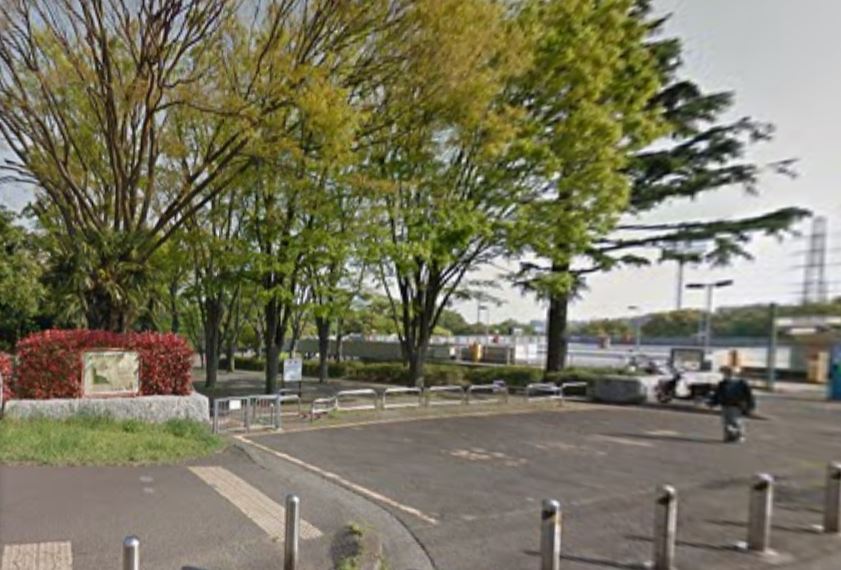
|
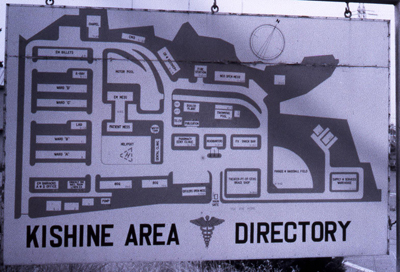 Directory to Kishine Barracks and 106th General Hospital
Directory to Kishine Barracks and 106th General HospitalDate and photographer unknown Probably around 1967 |
 Directory to Kishine Park at southeast entrance (lower left)
Directory to Kishine Park at southeast entrance (lower left)Copped from Wikipedia 13 November 2015 Posted 30 April 2009 by Captain76 |
|
The Kishine Area Directory Above left is dated circa 1967 with the proviso that it was taken no earlier than spring or early summer 1966, since the lab and X-ray services, and a couple of other sections, were not located in the buildings where they are shown to be on this map before then. Note that the map does not show the passageways between the ward buildings and other new structures (see details on another representation of the same photograph below). The park directory Above right is oriented to show the layout of the park from the vantage point of its entrance at the Rokkakubashi Middle School Entrance Intersection (Rokkakubashi-Chū Iriguchi Kōsaten 六角橋中入口交差点) intersection at the top of the hill up the street by the main park entrance, which used to be the entrance to Kishine Barracks. You can see the "You are here" arrow in the bottom corner where the power station was located. |
|
 Circa February 1963, children by barbed-wire fence
Circa February 1963, children by barbed-wire fence
|
 30 April 2009, southwest entrance to Kishine Park
30 April 2009, southwest entrance to Kishine Park
|
|
The Above photograph of children playing by the fence was taken around February 1963 from the southwest corner at the top of hill up Suido-michi at the intersection of Suido-michi and the cross street on which children are playing. The intersection, called Rokkakubashi-Chu Iriguchi, is so named because the cross street leads to Rokkakubashi Middle School (chū-gakkō), a short distance to the south, in the direction the children are walking. The photo was copped from touyoko-ensen.com (とうよこ沿線), which credits it to Matsumoto Kōhei (松本幸平) of Rokkakubashi. The Above right photograph shows the plaza of the southeast entrance to Kishine Park, taken from the Rokkakubashi Middle School Entrance Intersection at the very top of Suidō-michi. The plaza cuts through the site of the barracks which the 106th General Hospital used as medical wards. The street along the western perimeter of the park corresponds to the road on which the children are playing in the picture to the left. The 2009 photograph on the right was copped from Wikipedia, which attributed it to Captain76. |
|
Vintage photos
The following photographs are copped from various websites. They are not of very high quality, and the kind and extent of the information accompanying them considerably varies with the source.
The photographs are shown in chronological order. All dates are based on the received descriptions, except the date of the closing ceremony, which was given as 1973 but was actually 1972.
I have credited the sources only when photo attributions were specific. The descriptions and comments in the captions are mine, but parts of the comments are translations or paraphrasings of the received descriptions.
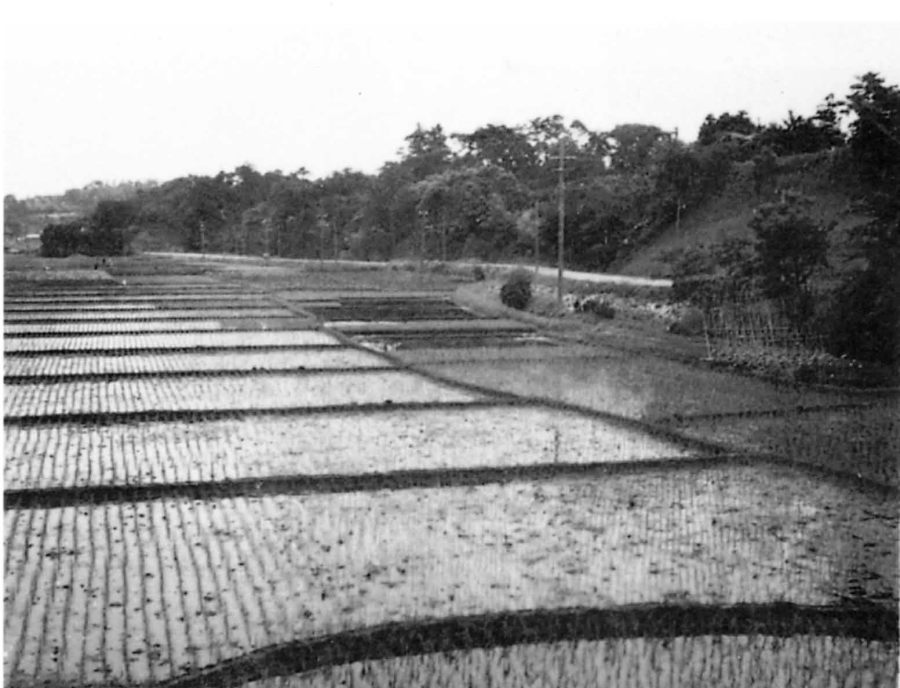 Circa 1953, road from Kishine along paddies in Shinohara
Circa 1953, road from Kishine along paddies in ShinoharaShinohara Kindergarten (Shinohara Yōchien しのはら幼稚園), about 300 meters down the road between present-day Kishine Park and Shin-Yokohama stations on the Blue Line subway, sits on the rice paddies in the foreground. The subway very roughly follows the road in the background, which was known as Bōgayato (坊海道). The name survives in the area, as in "Shinohara-chō Bōgayato Kōen" (篠原町坊海道公園), the name of a park (kōen 公園) in Shinhara-chō, north of Kishine Park. The paddies were filled, and the hills and flats are now buried in homes. The photo was copped from touyoko-ensen.com (とうよこ沿線), which credits it to Itō Yoshio (伊藤義雄) of Kishine-chō. |
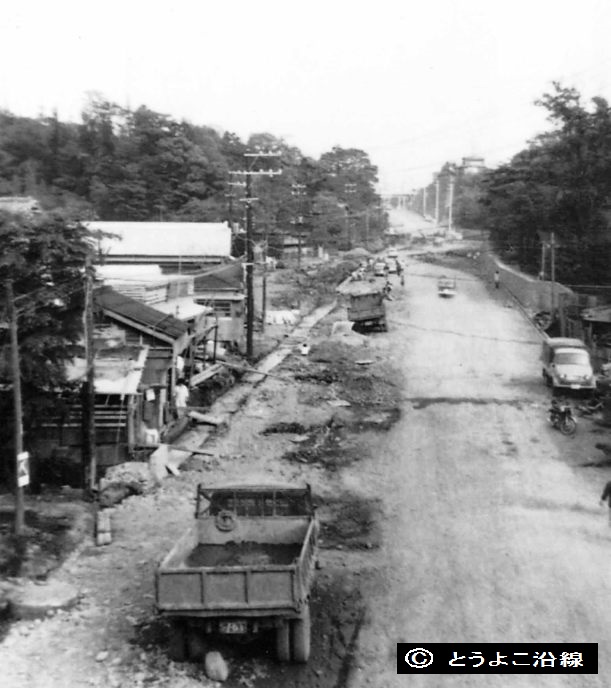 Circa 1963, road construction on Route 12 near barracks
Circa 1963, road construction on Route 12 near barracksNew construction of Kamiasao stretch of Route 12, looking north, away from the intersection with Suidō-michi. Kishine barracks is immediately to the left. The Aoya (藍屋) restaurant near the woods on the left marks the site of today's Kishine Park Station on the Blue Line. The photo was copped from touyoko-ensen.com (とうよこ沿線), which credits it to Takahashi Minoru (高橋稔) of Kishine-chō |
|
The compound 海道 in the Sino-Japanese expression 坊海道 (bōgayato) would usually be read "kaidō" and mean either "sea road" or "seaside provinces" -- as in "Tōkaidō" (東海道), which figures in so much of the history between the Kansai and Kantō regions and survives as the name of train lines that connect cities along the original route or through the same terrain. Here, though, the graphs 坊海道 are used to represent the expression "bō-ga-yato" or "valley of monks". A "yato" is a long stretch of wetland between rises on eiher side. When developing such land for rice cultivation, a trail or road would be built along one side of the low valley for access. The word "yato" is found mainly in the Kantō area and is especially common in parts of Kanagawa prefecture. Some linguists think it may be of Ainu origin. The genitive marker "ga" in "bō-ga-yato" is not graphically represented in 坊海道. The place name could graphed 坊ヶ谷戸 (bō ga yato), in which ヶ or "ke" ordinarily represents が or "ga". The variety of ways in which Japanese is graphically represented is what makes the writing and reading of the language interesting. Language is what is spoken and heard, and graphs don't pronounce themselves. The likelihood of a non-local person correctly pronouncing 坊海道 without having heard how locals pronounce it is practically zero. Understanding exactly what it refers to poses another problem. But this is true of all words. You either know how a word is pronounced, and what it refers to, or you don't. Nothing beats hearing a word and seeing or otherwise experiencing what it means. |
|

|

|
|
Above Circa March 1958, one year after opening Above right Mid 1966 or later, chapel and EM quarters (Building E) Right 25 August 1972, children attending return ceremony |
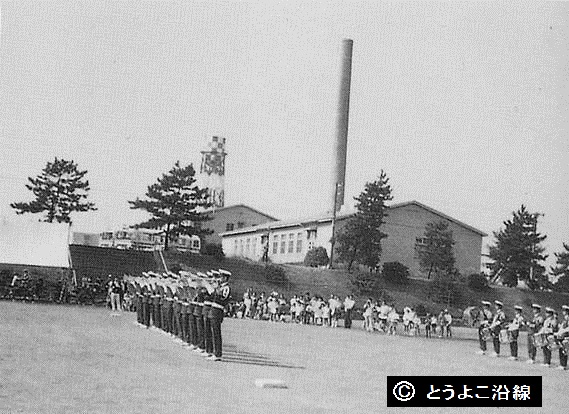
|
Suido street along Kishine Park
The following images are from a 2011 Yokohama city presentation related to a long-term project to widen the street called Tsurumi-Mitsuzawa Line (Tsurumi-Mitsuzawa-sen 鶴見三ツ沢線). Much of this street is more commonly called Suido Street (Suidō-michi 水道道), since it follows a major "waterway" (suidō) or water main.
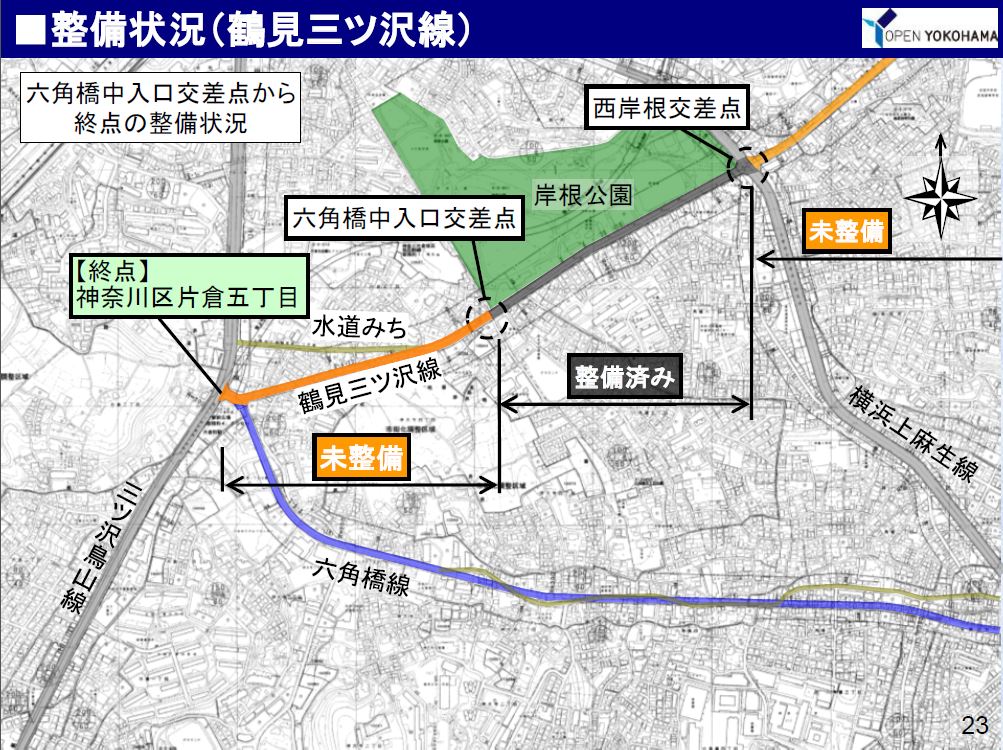 Suidō-michi street work
Suidō-michi street workThe stretch along Kishine Park (dark gray) has been completed. The stretches on either side (orange) are slated for widening. |
 Views of completed street work
Views of completed street work(1) View of Suidō-michi from top of hill toward Tsurumi. (2) View of Suidō-michi from bottom of hill toward Mitsuzawa. |
Both images highlight the stretch of Suidō-michi along Kishine Park between Nishi-Kishine Intersection (Nishi-Kishine Kōsaten 西岸根交差点) at the bottom of the hill (to the right) and Rokkakubashi Middle School Entrance Intersection (Rokkakubashi-Chū Iriguchi Kōsaten 六角橋中入口交差点) at the top of the hill (to the left).
In the image to the left, the work on the street by the park is marked as completed (seibi-zumi 整備済み). The image to the right shows views of the completed work -- two traffic lanes, and wide sidewalks with curbs, rain gutters, and covered sewers.
The work involved widening the street in compliance with new standards to improve ability to safely handle two-way traffic and pedestsrians. In this case, the street was also provided with curbed sidewalks with rain gutters as well as covered sewers.
Facilitation of the land as a park began in 1940 but was interrupted by the war when the area became the site of anti-aircraft batteries. After the war, the area came under the control of U.S. forces, which had been the major part of the Allied Occupation forces, and it remained under U.S. Army control after the Occupation under the auspices of the U.S.-Japan security agreement.
Facilitation of the area as a park resumed in 1970 when the 106th General Hospital left and Kishine Barracks was closed. Parts of the area, in particular the baseball field and adjacent grounds in the southeast corner, were opened for public use in April 1971. In 1973, the rest of the area, including some private land which had been acquired for park use, was publicly opened as a park.
By 1980, the stretch of Suidō-michi in front of the park, shown in the above images, had been widened and provided with pedestrian walks and other features to bring it up to more recent standards. A prefectural Budōkan (武道館) -- a martial arts dōjō (道場) -- was built on the eastern part of the park in 1982. The Blue Line subway was extended under the park, and Kishine-Kōen Station -- straddling Kishine and Shinohara on Route 12 -- was opened in 1985. A direct exit on the northeast corner of the park, near Shinohara Pond (Shinohara-ike 篠原池), made access much easier.
Since the late 1980s, parts of the park, especially around Shinohara Pond near the subway station, and the western parts of the grounds at the top of Suidō-michi, have undergone more landscaping and reconstruction to provide new recreation facilities.
Area maps

|
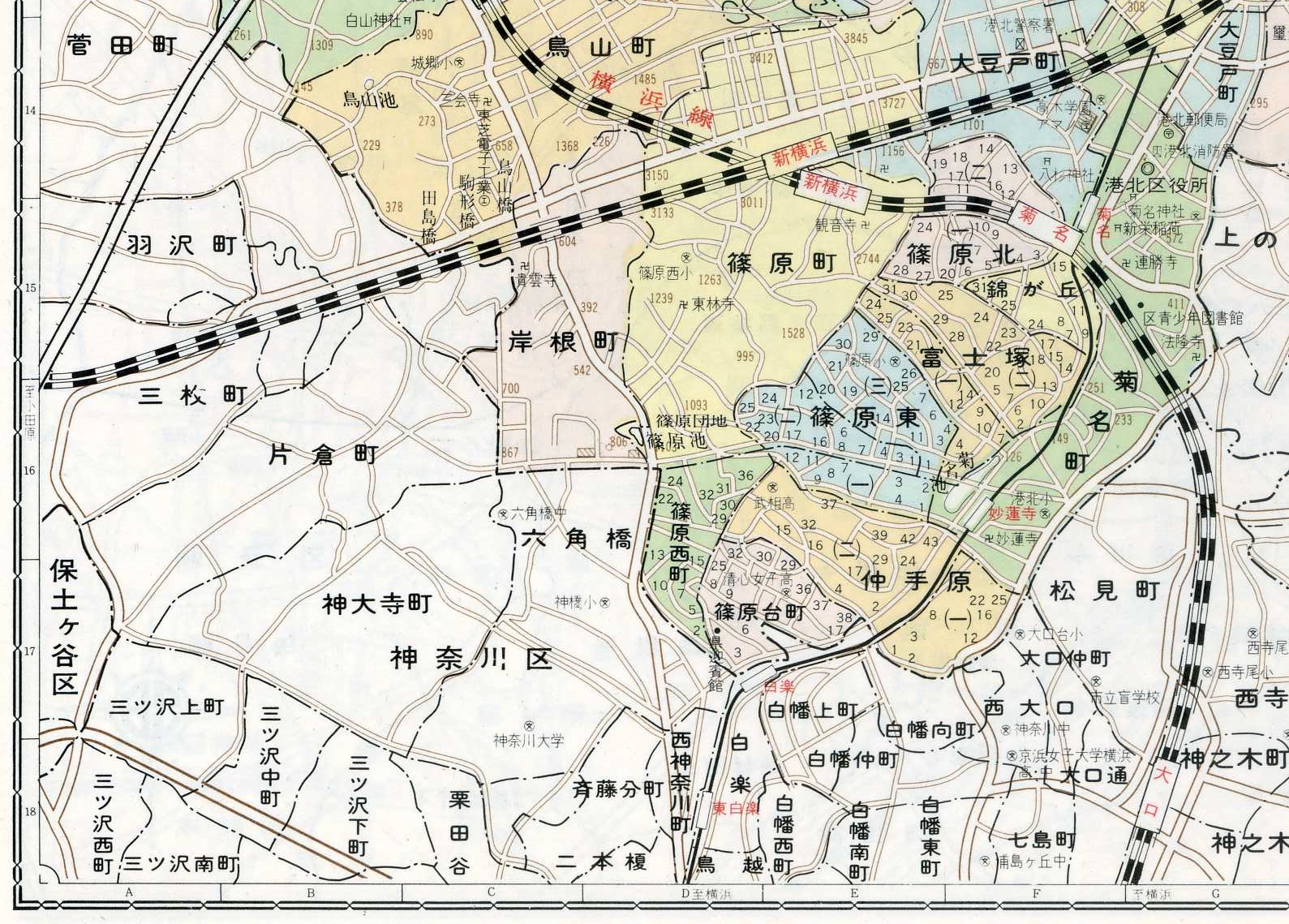
Click on images to enlarge
↑ 1975 map showing Kishine area
← June 1965 map showing Kishine Barracks |
|
Kishine Barracks on 1965 mapThe shape of the green area marked KISHINE BARRACKS (U.S.ARMY) on the map to the left, and the red representations of its buildings, appear to be very approximate or purely schematic, rather than based on direct observation and mapping of the site. Of interest are the identifications of the GOLDEN DRAGON, U.S. NAVY, FEES KISHINE, 'P.X, and FEES PERIODICALS. Some of the typography -- "U.S.ARMY" and "'P.X" rather than "U.S. ARMY" and "P.X." -- can be seen in alphabetic representations in Japanese texts edited by people unfamiliar with English conventions, hence the omission of spaces between some words, and not marking the last letter of an abbreviation with a period. The GOLDEN DRAGON was the officers club, and it was located just to the left of the entrance gate, immediately by the 2 BOQs -- bachelor officers quarters. I suppose the proximity of the club to the quarters was intended to save the military money, for if the club was more than a few steps from their quarters, some officers would have wanted a jeep with a driver. I cannot confirm the meaning of "FEES", but judging from reports concerning people from various branches of the military, some of whom were living elsewhere in the area but attended short training programs at Kishine, I would guess that it might mean something like "Far East Education Services". Kishine area on 1975 mapThis map is a puzzle. It shows, in the middle of the south side, what corresponds to the entrance to the Kishine Barracks area, and a building to the left of the entrance, which would be the officers club. But in the southwest corner, it shows blocks corresponding to where the 4-story barracks were located, with streets connecting to the streets along the south and west perimeters. Moreover, it shows numbers like those assigned to blocks of land in other areas to facilitate identification of smaller lots within the blocks -- as though the area corresponding to the site of Kishine Barracks was just another part of the surrounding neighborhood. By 1975, it had already become a park, though most of park was still under construction. |
||
Yokohama City Maps, August 1949 |
|||
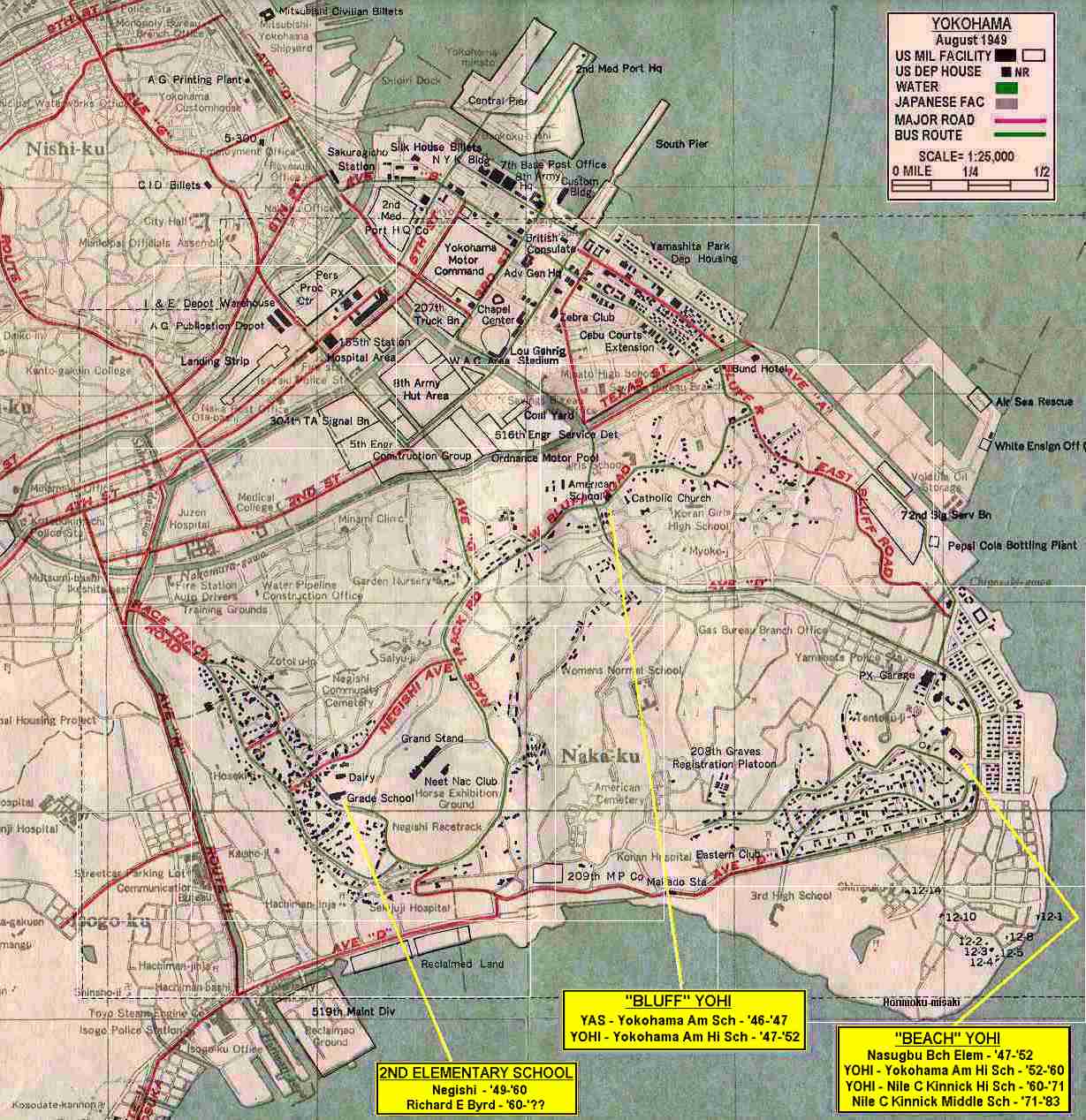 Heart of 8th US Army in Occupied Yokohama
Heart of 8th US Army in Occupied YokohamaNishi and Naka wards, old Yokohama waterfront |
 Yokohama station and North Pier
Yokohama station and North PierKanagawa ward, old Kanagawa waterfront |
||
|
Click on images to enlarge the above maps, which were copped from Yo-Hi Devils, the home page of Yokohama High School and other regional American school alumni. See Maps for Kanto area maps and links to other maps, and More Maps for Yokohama area maps and an interactive version of the map on the left showing high-resolution images of selected areas. |
|||
August 1949 Occupation-era mapsThe two above maps are part of a much larger "City Map of Yokohama" dated August 1949. The map was printed for use by Allied military forces and dependents in Yokohama. It shows major streets and locations of Allied installations and dependent housing in the Yokohama area, all clearly labeled in English. Map users were asked to bring omissions or errors to the attention of the "Intelligence Division, Engineer Office [Office of the Engineer], GHQ [General Headquarters], FEC [Far East Command], 4th Floor, Mitsubishi Shoji Building, Telephone 26-5090". The Mitsubishi Shoji Building (Mitsubishi Shōji Birudingu 三菱商事ビルディング) was in Tokyo. Allied Occupation Forces commandeered the building for use as offices by a number of sections of GHQ/SCAP (General Headquarters, Supreme Commander for the Allied Powers), including the Diplomatic Section (DS/SCAP), which proxied Japan's foreign affairs. Old Yokohama and 8th U.S. Army HeadquartersThe map to the left centers on the southern part of Yokohama's waterfront, associated with Nishi-ku (西区) or "west ward", and Naka-ku (中区) or "center ward", both south of Yokohama station. The flatter Nishi-ku -- in the upper half of the map -- includes the heart of Old Yokohama, in the days of the extraterritorial Foreign Settlement along the bay during the latter half of the 19th century, then Chinatown and the older entertainment and red-light districts. The hillier Naka-ku -- in the lower half of the map -- includes the Bluff and the Negishi and Honmoku areas. Off the mapYokohama station, in Kanagawa-ku (神奈川区), or "Kanagawa river ward", is just off the map directly north of the A.G. [Adjutant General] Printing Plant in the upper left corner of the map. North Pier, now known as North Dock, is east of Yokohama station and north of Central Pier. Kishine is in Kōhoku-ku (港北区), or "north-of-harbor ward", directly north of Yokohama station. North Dock and U.S. Army Transportation Terminal"North Dock" will be a nostalgic name for anyone stationed at the 106th General Hospital who had to ship anything to the United States when mustering out of the Army or being reassigned stateside. The following paragraphs, from a longer history of North Dock posted at GlobalSecurity.org, includes references to the U.S.
|
|||
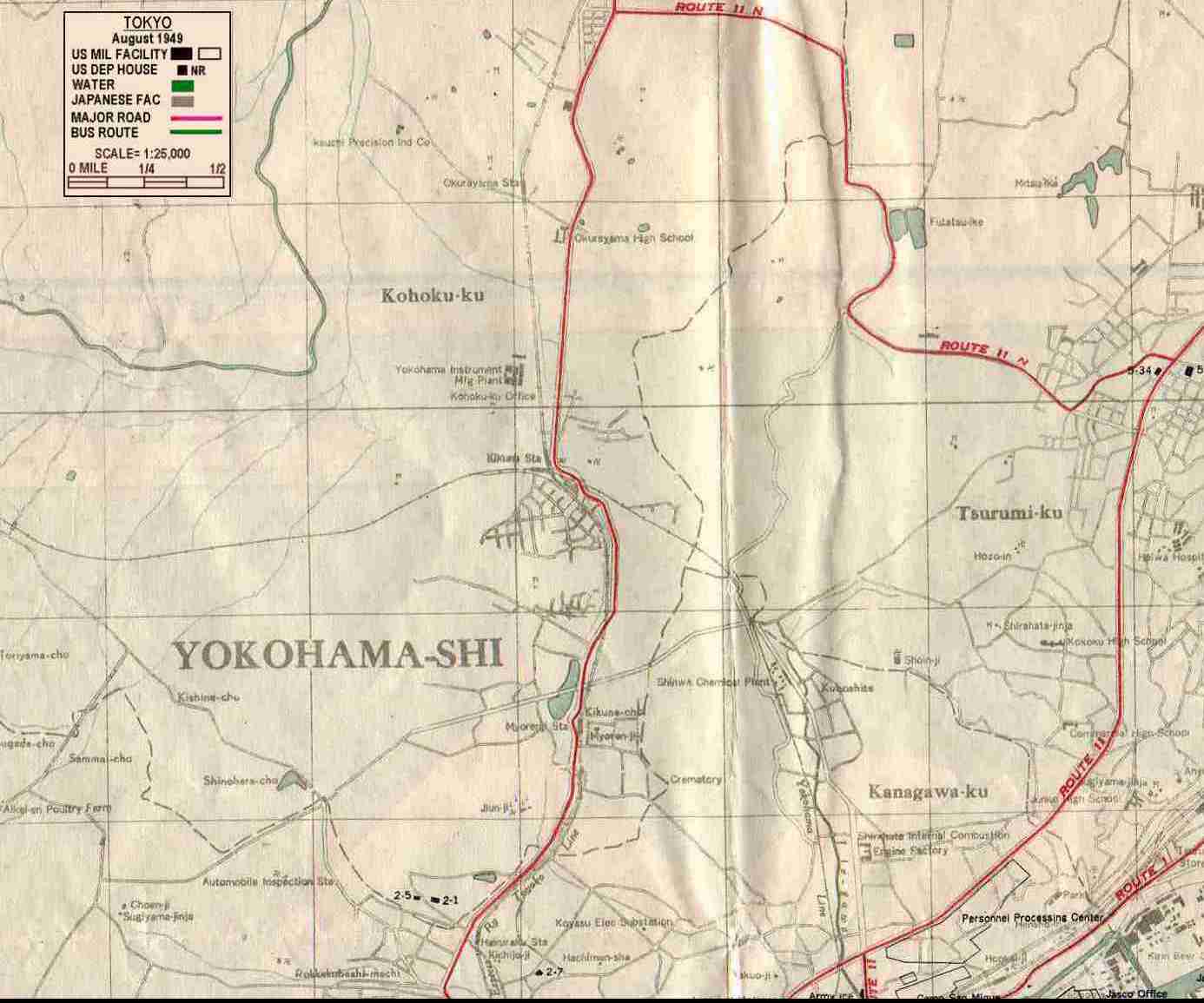 Kohoku ward, north-of-harbor Yokohama
Kohoku ward, north-of-harbor Yokohama |
 Kanto road map centuring on Tokyo and Yokohama
Kanto road map centuring on Tokyo and Yokohama |
Google maps of Kishine Park
 Google Map centering on Kishine Park
Google Map centering on Kishine ParkComposite of several screen shots copped from Google Maps. The thin broken red line is the route of the Blue Line subway. The thick red line marks the boundary between Kōhoku ward (top right) and Kanagawa ward (bottom left). The cluster of yellow buildings bottem center, below the southwest corner of the park, is Rokkakubashi Middle School. Some people who were students there when the 106th General Hospital was operation have blogged their memories of the period. The broken black line remains a mystery. It does not correspond with any surface feature visible on satellite or street views but ties in with railway yards at its extremes. a |
Satellite views of Kishine Park
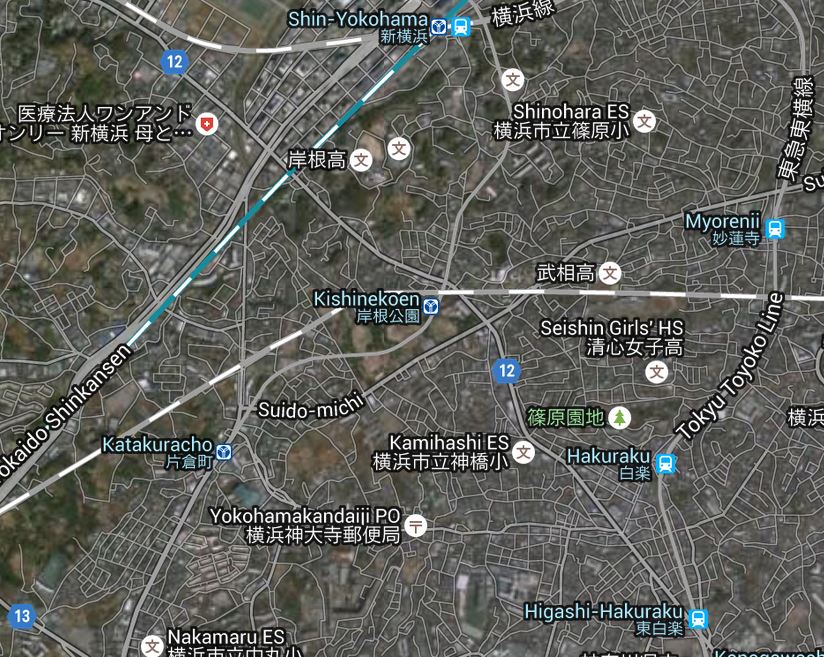
|
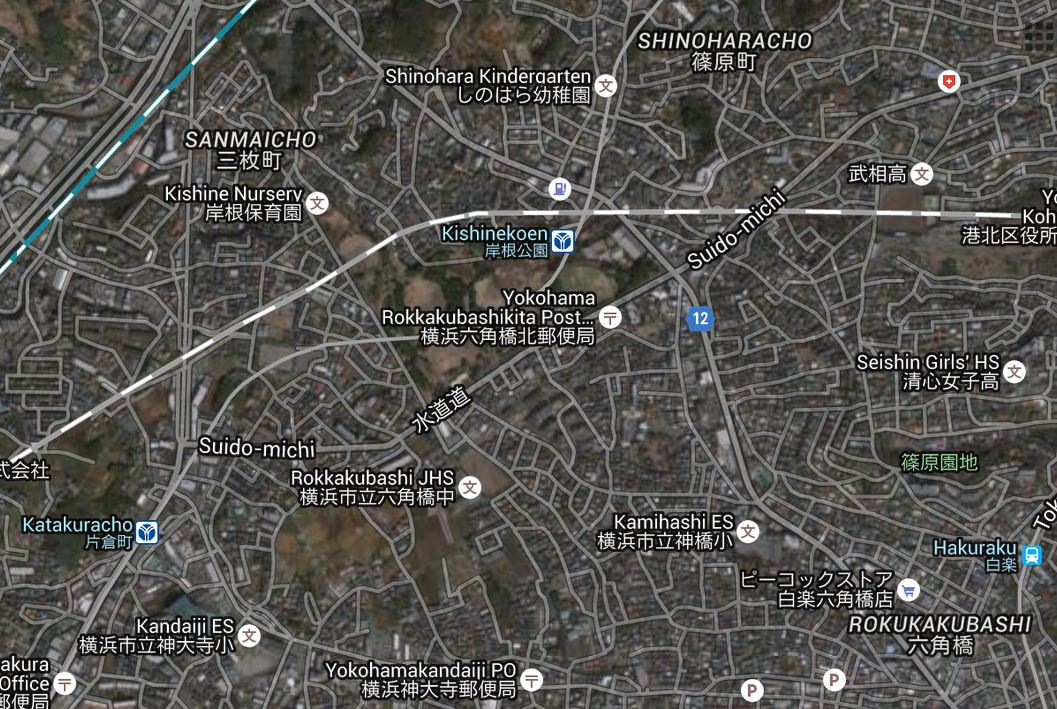
|
|
Views of Kishine Park area from higher/boarder (top left and right) to lower/narrower (bottom) persepectives |
|

|
Street views of Kishine Park (April 2015)
The following images are screen shots copped from Google Maps.
The captured shots begin looking west up Suidō-michi at its intersection with Route 12 and end looking down Suidō-michi from the Rokkakubashi-Chū-Iriguchi intersection at the top.
The Street View footage was taken in April 2015.
 At Nishi-Kishine Intersection
At Nishi-Kishine IntersectionOn Suidō-michi, looking west across Route 12. Kishine Park is where all the trees are, straight up the street on the right. Rokkakubashi Intersection, Hakuraku and Higashi Hakuraku stations, and Higashi Kanagawa station and the Yokohama waterfront, are down route 12 to the left. |
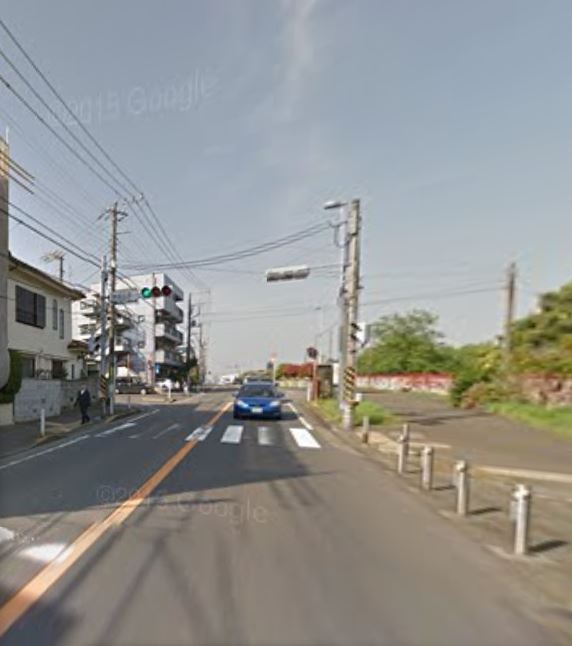 By main entrance of Kishine Park
By main entrance of Kishine ParkHalfway up Suidōmichi, looking west toward the top of the hill. The entrance is immediately to the right. Notice the signal and crosswalk. The street was widened and provided with curbed sidewalks and other safety features at the time the park was built in the mid and late 1970s. |
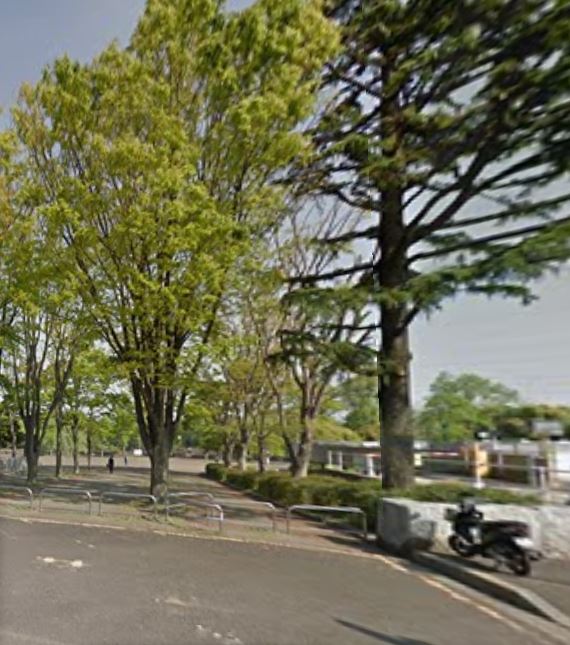 Main entrance to Kishine Park
Main entrance to Kishine ParkLooking north into the entrance. This is about where the gates and guard house of Kishine Barracks were located. The plaza inside the entrance corresponds to the open space in front of the headquarters building at Kishine Barracks. The park administration building is immediately to the left inside the entrance, about where the Officers Club was located. The parking to the right was built on the site of the theater and gymnasium. |
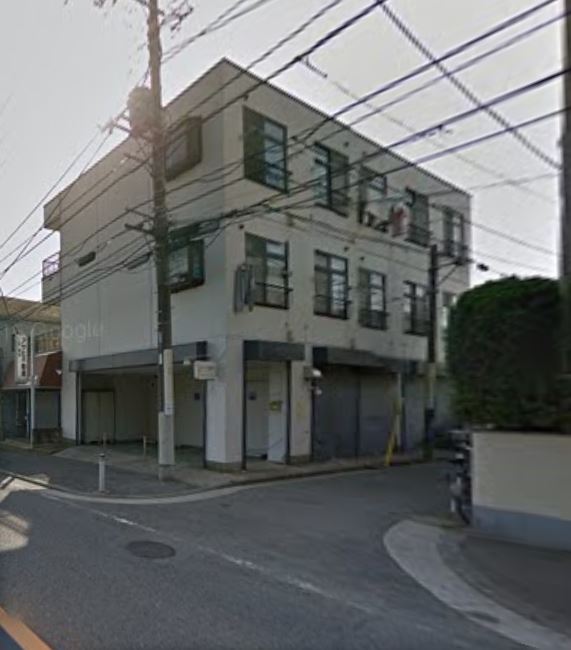 Rokkakubashi neighborhood across from entrance
Rokkakubashi neighborhood across from entranceLooking southeast from the entrance of Kishine Park at the Rokkakubashi neighborhood across Suidō-michi. The Nishi-Kishine Intersection on Route 12 is at the foot of Suidō-michi to the left. The older wooden buildings that characterized Rokkakubashi are gone. In their place are 2-story homes, and 3-story and 4-story apartment buildings, some with stores on the ground level. |
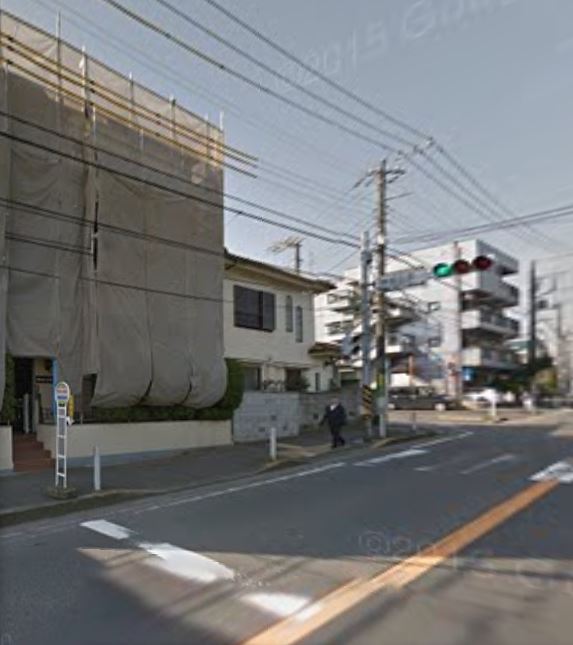 Rokkakubashi neighborhood across from entrance
Rokkakubashi neighborhood across from entranceLooking southwest from the entrance of Kishine Park at the Rokkakubashi neighborhood across Suidō-michi. The Rokkakubashi Middle School Entrance Intersection is at the top of Suidōbashi to the right. The building across the street is surrounded by scaffolding enclosed with tarps to facilitate repairs and repainting. To its west is a 2-story home and a 4-story apartment building. |
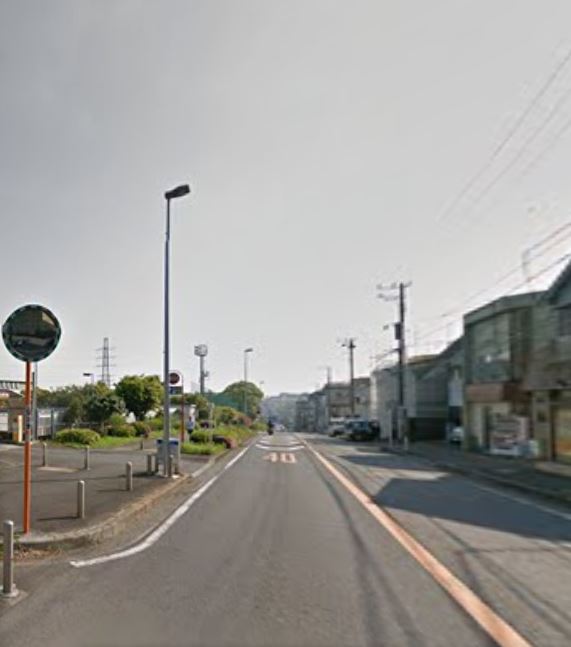 At Rokkakubashi-Chū Iriguchi intersection
At Rokkakubashi-Chū Iriguchi intersectionLooking down Suidōbashi toward the Nishi-Kishine Intersection on Route 12, from the top of hill at Rokkakubashi Middle School Entrance Intersection. The cross street runs along the west side of the park to the left. Rokkakubashi Middle School is about 100 meters down this street to the right. The park can also be entered from this corner. The mirror allows people on one street to see traffic on the other. |
Other views of Kishine Park and vicinity
26 August 2015 photographs by cyclist
The following images are copped from several posted by a cyclist who biked from Shin-Yokohama station, via Route 12 to the Nishi-Kishine Intersection at Suidō-michi, then up Suidō-michi passed Kishine Park to the juncture of Shidō-michi with Shimokōchi (下耕地), and south on Shin-Yokohama Dōri (新横浜通り) to Mitsusawa Park (Mitsusawa Kōen 三ツ沢公園).
The images are dated 26 August 2015. See Mackey Town Blog -- Tokyo Environs Bicycle Course Guide (マッキータウンぶろぐ 〜 東京近郊自転車コースガイド) for a photographic record of the entire course.
Riding alongside automobiles and trucks is not my idea of fun cycling. I prefer the quieter roads along the fields and paddies in my semi-rural suburban neck of the woods.
 "Nishi-Kishine Intersection 300-meters ahead"
"Nishi-Kishine Intersection 300-meters ahead"Sign on Route 12 proceeding south in direction of Higashi-Kanagawa station near Yokohama waterfront. Mitsusawa is to right on Suidō-michi along front of Kishine Park. Tsurumi is to left on Suidō-michi through Shinohara and other neighborhoods. |
 On Route 12 at Nishi-Kishine Intersection
On Route 12 at Nishi-Kishine IntersectionIntersection of Route 12 where it is crosseds by Suidō-michi. Lower (west) part of Kishine Park is immediately to the right. |
 On Suidō-michi at bottom of the hill
On Suidō-michi at bottom of the hillAfter turning right off Route 12 at Nishi-Kishine Intersection. The hill climbs by Kishine Park immediately to the right. Except on exceptionally wide sidewalks, cyclists are required to use the left lanes the same as cars. |
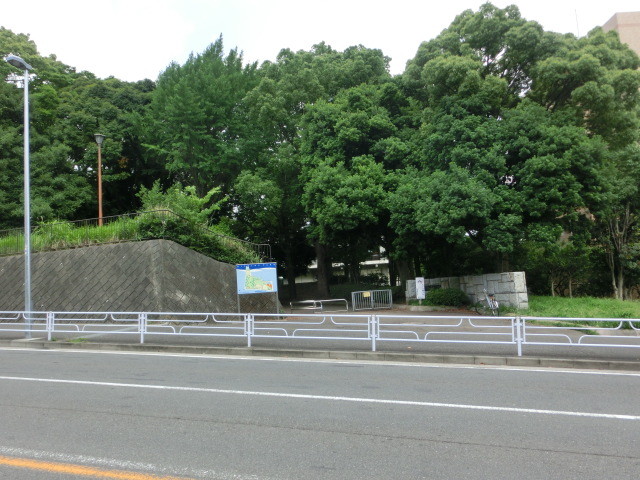 Entrance to Kishine Park at bottom of hill
Entrance to Kishine Park at bottom of hillThis entrance is on the southeast corner of the park at the northwest corner of Nishi-Kishine Intersection. The entrance leads directly to the Budōkan, baseball field, and Shinohara Pond. |
|
Drainage sewers run under the concrete slaps along the curb. You can see the gratings of at intervals along the sewer. In older times these were open. In some neighborhoods the slabs are short and can be lifted to clean the sewers. Curbed sidewalks are a more recent innovation in the few neighborhoods that have them. This stretch of Suidō-michi got a head start on account of the building of the park. |
|
Kishine Park access
The easiest way to get to Kishine Park from Yokohama station is on the Blue Line (Buruu Rain ブルーライン) municipal subway. Kishine Park station (Kishine Kōen eki 岸根公園駅), numbered B24 on maps, is only 4 stations from Yokohama, which is numbered B20. See Transferring to Blue Line from JR Yokohama below.
Kishine Park station straddles the Kishine and Shinohara sides of Route 12. Most of the station is immediately under the northeast corner of the park. The closest exit -- Exit 2 -- comes out by the Shinohara Pond (Shinohara-ike 篠原池) entrance to the park.
Though called Shinohara, the pond is in Kishine-chō. Though part of the park, it was not part of Kishine Barracks. Though not part of Kishine Barracks, there rumors that the pond was polluted by waste and even blood from the 106th General Hospital.
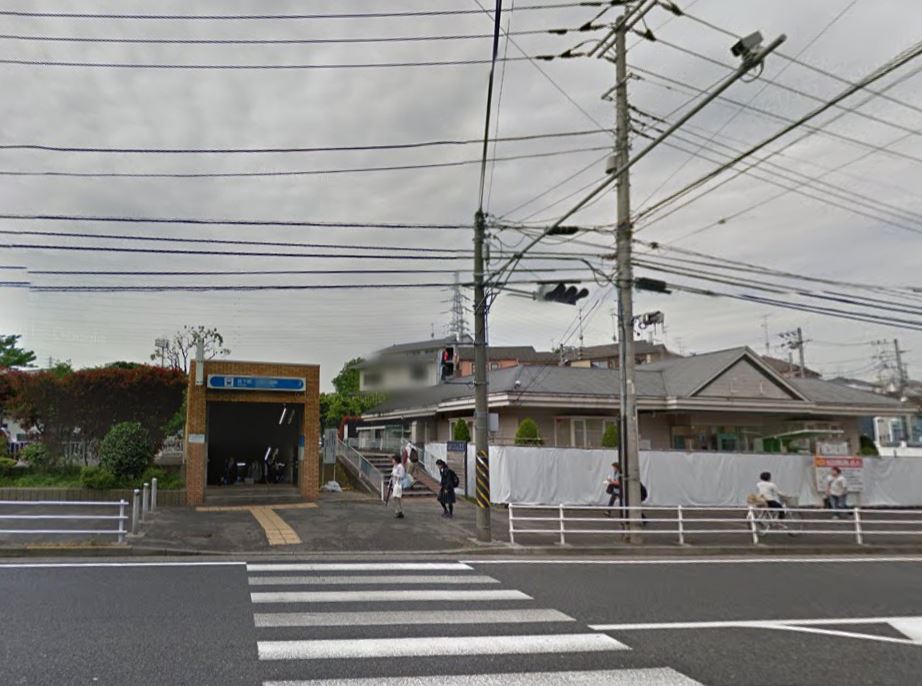 Exit 2 of Kishine Kō subway station and vicinity
Exit 2 of Kishine Kō subway station and vicinityLooking west from the Shinohara side of Route 12. Park to left. Family restaurant to right. Screen shot copped from Street Views in Google Maps. |
 Exit 2 of Kishine Kō subway station
Exit 2 of Kishine Kō subway stationThe subway platforms are 3 floors down. 27 March 2008 photograph by LERK from Wikipedia. |
 Schematic image of structure of Kishine Park Station
Schematic image of structure of Kishine Park StationPlatforms are 3 stories down. Exit 1 is elevator shaft near Exit 2. Platform 1 (Ichi-ban-sen 1番線) is line on top with arrow to right. Copped from Yokohama city website. |
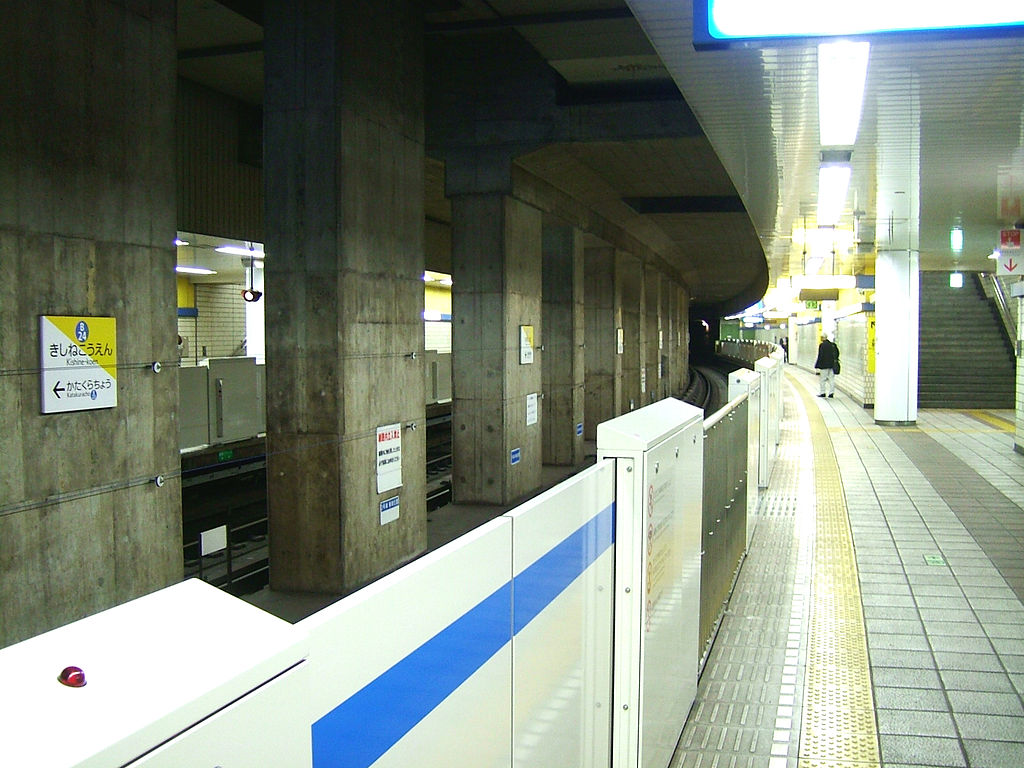 Kishine Kōen subway station platform
Kishine Kōen subway station platformPlatform 1 of Kishine Park station for trains coming from Shin-Yokohama and continuing to Katakurachō. 27 March 2008 photograph by LERK copped from Wikipedia. |
 Map of Blue Line and Green Line subways
Map of Blue Line and Green Line subways
|
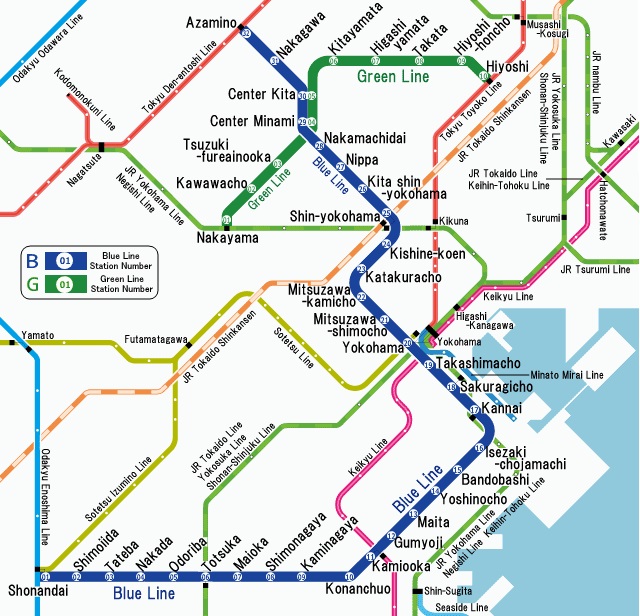 English map of Blue Line and Green Line subways
English map of Blue Line and Green Line subways
|
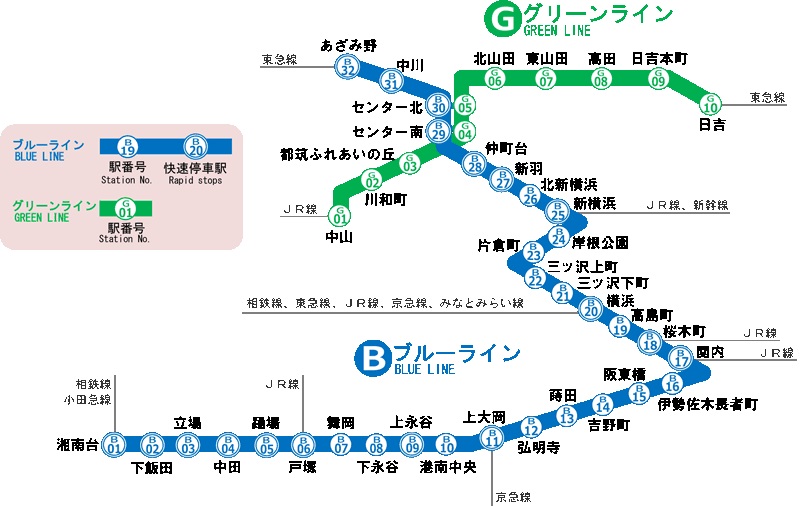 Subway map marking rapid service stops (double concentric circles)
Subway map marking rapid service stops (double concentric circles)
|
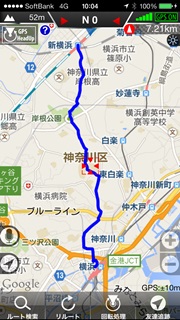 Walking to Kishine Park
Walking to Kishine Park
|
Blue Line subwayKishine Kōen (岸根公園) station is number 24 (B24) of the 32 stations on the Blue Line, counting from Shōnandai (湘南台) station (B01) in lower left of the above map. Yokohama (横浜) station is number 20 (B24). Kishine Kōen is 9 minutes (5.4 kilometers) from Yokohama. The three stations between Yokohama and Kishine Kōen stations are Mitsuzawa-shimochō (三ツ沢下町), Mitsuzawa-kamichō (三ツ沢上町), and Katakurachō (片倉町). Transferring to Blue Line from JR YokohamaIf arriving by JR [Japan Railway] trains at Yokohama station from the direction of Tokyo (which is north of Yokohama), go down the stairs at the very front (south end) of the platform and follow the flow of people and signs to the South Entrance (Minami kaisatsu 南改札) [South wickets (ticket gates)]. When outside the gates, veer to the right and follow the flow of signs in the passageways to the stairs and escalators that lead to the Blue Line gates. After descending to the Blue Line platform, board a train bound for Azamino (あざみ野) in the direction of Shin-Yokohama (新横浜). Be aware, however, that there are two kinds of trains -- local (kakueki 各駅) trains which stop at every station, and semi-express or rapid service (kaisoku 快速) trains, which skip smaller stations, including Kishine Park. The above (lower-left) subway map shows the express stops in concentric circles. The nearest rapid service stops, on either side of Kishine Park, are Yokohama (横浜) (B20) and Shin-Yokohama (新横浜) (B25). During the main hours of the day, there is at least one train every 7 to 8 minutes. From mid morning to early evening, there are typically 8 local trains and 2 express trains per hour. |
Walking from Shin-Yokohama to Kishine ParkThe walk from Shin-Yokohama is only about 1.5 kilometers through Shinohara, which should take only 20 minutes or so if you know the route, 30 minutes if you have to stop now and then to confirm directions, longer if you pause to take in the now very suburban sites. The map on the right shows a walkable route from Shin-Yokohama to Yokohama stations, via Kishine Park, taking back streets through residential neighborhoods rather than the more roundabout though easier-to-follow main roads. I copped the map from a blogger named Tasone_99, who did the walk on 5 November 2013. The blogger walked from Shin-Yokohama station to the west exit (nishiguchi 西?) of Yokohama station, via Kishine Kōen and Kanagawa University (Kanagawa Daigaku 神奈川大学). He said the distance was 5.7 kilometers and required 70 minutes. That's about 800 meters/10 minutes, which is a bit (but not a lot) faster than average. This implies a normal speed and gait, maintained without pausing to study a map. Someone not familiar with the streets would need to take more time. The image the blogger posted of the route suggests he relied on a smart phone with GPS navigation which very likely audibly told him where and when to turn. |
Bus access
 Access map to Kishine park showing streets, stations, and bus stops
Access map to Kishine park showing streets, stations, and bus stopsMap copped from Yokohama Greenery Foundation (Kōeki Zaidan Hōjin Yokohama-shi Midori no Kyōkai). |
Yokohama city bus linesA few Yokohama city bus lines have stops in the immediate vicinity of Kishine Park. No. 38 stops at "Rokkakubashi North Town" (Rokkakubashi Kitamachi 六角橋北町). The bus runs between the west exit of Yokohama station (Yokohama-eki nishiguchi 横浜駅西口) and Tsurumi station (Tsurumi-eki 鶴見駅) by way of Route 12 and Suidō-michi (水道道). There are only about 2 buses per hour. No. 39 stops at both "Rokkakubashi North Town" (Rokkakubashi Kitamachi 六角橋北町) and at "Front of Shinohara Pond" (Shinohara-ike-mae 篠原池前). The bus runs between the west exit of Yokohama station (Yokohama-eki nishiguchi 横浜駅西口) and "Nakayama station" (Nakayama-eki-mae 中山駅前) along Route 12. This is a heavily travelled route, and there are at least 5 buses per hour between morning and evening. This is probably your best choice for bus transportation from Yokohama station. No. 291 stops at "Front of Rokkakubashi Middle School" (Rokkakubashi Chūgakkō Mae 六角橋中学校前) and "Front of Kishine Park" (Kishine Kōen Mae 岸根公園前) on Suidōmichi, right in front of the park. The bus runs along a less-travelled local circuit route between the west exit of Yokohama station (Yokohama-eki nishiguchi 横浜駅西口) and "Front of Ōguchi station" (Ōguchi-eki-mae 大口駅前). There is only one bus per hour. |
Highway access
 Map of highway and expressway access to vicinity of Kishine Park
Map of highway and expressway access to vicinity of Kishine ParkKishine Park (岸根公園) is the green area at the green tack in the center. Yokohama station (横浜) is bottom center, Tsurumi station (鶴見) is to the right. The map is a screenshot of a Navitime image. |
Highway accessThe pink roads are National Routes 1, 14, 15, and 16. They are not freeways but streets with intersections and signals. If proceeding on National Route 1 (Kokudō Ichi-gō-sen 国道1号線) from Yokohama and Kanagawa, turn left at "West Kanagawa" (西神奈川) onto the Yokohama Kami Asao Line (横浜上麻生線) aka as Kanagawa Prefecture Route 12, and proceed west to the West Kishine Intersection (Nishi-Kishine Kōsaten 西岸根交差点) at Suidō-michi (水道道) -- about 2.4 kilometers from Route 1. The thick blue road is the 3rd Tokyo-Yokohama Road (Daisan Keihin dōro 第三京浜道路), aka as National Route 466 (Kokudō Yon-roku-roku-gō-sen 国道466号線). It runs as an expressway -- insterspersed with on-off ramps (de-iri-guchi 出入口), interchanges (IC), junctures (JCT), and parking areas (PA) -- between Setagaya ward in Tokyo and Kanagawa ward in Yokohama, via of Kawasaki. The yellow roads are prefectural roads such as Route 12. |
Vintage access

|
Tōyoko Railway stations from Yokohama bay to Tama river (circa 1930)Stations along Yokohama-Shinmaruko stretch of Tōyoko Railway (Tōyoko Dentetsu 東横電鉄), which is now part of Tōkyū Tōyoko line (Tōkyū Tōyoko Sen 東急東横線) that runs between Yokohama station in Kanagawa prefecture and Shibuya station in Tokyo. The stretch shown here runs from Yokohama bay lower left, across the Tsurumi river (Tsurumigawa 鶴見川) center, to the Tama river (Tamagawa 玉川) right, which marks the boundary between Kanagawa and Tokyo prefectures. A couple of stations no longer exist, a couple have been renamed or are new, and all which have survived have been rebuilt. The stations most closely related to the Kishine are, from left to right, Yokohama (横浜), Kanagawa (神奈川) [no longer exists on this line], Tammachi (Tanmachi 反町), Higashi Hakuraku (東白楽), and Hakuraku (白楽). The latter two stations are along Route 12 between Suidō-michi -- the street which fronted Kishine Barracks -- and the Yokohama waterfront. The image was copped from touyoko-ensen.com, which credits it to the Okura Institute for the Study of Spiritual Culture (Ōkura Seishin Bunka Kenkyūjo 大倉精神文化研究所). |
Kishine Park guides
 Directory to Kishine Park at southeast entrance (lower left)
Directory to Kishine Park at southeast entrance (lower left)Copped from Wikipedia 13 November 2015 Posted 30 April 2009 by Captain76 |
Kishine Park Guide MapShinohara Pond (Shinohara-ike 篠原池), in the upper-right (northeast) corner, was there long before the advent of Kishine Barracks in the mid 1950s, but was not part of the Kishine Barracks property. The small plaza, baseball field, and playground in the upper-left (northwest) corner were built on the site of the anti-aircraft batteries that were operated by the Imperial Japanese Army until demobilized by the U.S. Army after World War II. Kishine Barracks did not include this land, either. |
 Interactive guide to Kishine Park features
Interactive guide to Kishine Park featuresGuide copped from Yokohama Greenery Foundation (Kōeki Zaidan Hōjin Yokohama-shi Midori no Kyōkai 公益財団法人横浜市緑の協会). Click on the map for the original interactive Internet version. |
Park vs Barracks
Relating Kishine Park's major features to facilities at Kishine Barracks
|
The value of the above interactive guide map is the color-coding of the park's major features. The following table shows the corresponding features of Kishine Barracks. I have represented the names of features as shown on the above map, and on the Key to Major Building page in the 1969 report on the 106th General Hospital (at top of this page) In the table, I have translated "hiroba" (広場) as "square" just to be consistent. The expression refers to a "wide [expansive] place" that could be a plaza or simply an open space. Other translations are also my own. There are no official English versions. The names of some "squares" of are mostly metaphors for peace and enjoyment. The "gourd" (hyōtan ひょうたん 瓢箪) of "Gourd field" refers to the shape of the field. |
|
Comparison of Kishine Park and Kishine Barracks |
|||
| Location | Kishine Park | Kishine Barracks | |
| Japanese | English | ||
| Left top | 西広場 Nishi hiroba |
West square | Outside Kishine Barracks Imperial Army anti-aircraft batteries |
| Left top | 少年野球所 Shōnen yakyūjō |
Boys baseball field | Outside Kishine Barracks Imperial Army anti-aircraft batteries |
| Left top | ゆうゆう広場 Yūyū hiroba |
Quiet square | Outside Kishine Barracks West of chapel North of EM quarters |
| Left | ひょうたん原っぱ Hyōtan harappa |
Gourd field | Medical wards Mess hall Helicopter port |
| Center top | 展望広場 Tenbō hiroba |
Observation square | Ammunition Storage Point (north of CMS and OR) |
| Center middle | 忍者とりで Ninja toride |
Ninja fortress | Between OR and power plant |
| Center middle | せせらぎ広場 Seseragi hiroba |
Murmuring square | Motor pool Power plant Swimming pool |
| Bottom left | 管理センター Kanri sentaa |
Administration center | Officers club |
| Bottom middle | 中央広場 Chūō hiroba |
Central square | Entrance gate Headquarters |
| Bottom right | 駐車場 Chūshajō |
Parking lot | Movie theater Gymnasium |
| Right top | 篠原池 Shinohara-ike |
Shinohara pond | Outside Kishine Barracks |
| Right middle | 武道館 Budōkan |
Martial way [arts] hall | Sewage plant Ammunition bunker Supply |
| Right bottom | 野球場 Yakyūjō |
Baseball field | Parade and baseball field |
Kishine stories
Everyone who passed through Kishine Barracks, before and after the arrival of the 106th General Hospital, has a story to tell. Many of the stories will be similiar, and some will be utterly trivial, but all represent the experiences of those who there for whatever reason.
The following stories are taken from books, journals, newsletters, Internet forums, blogs, and other media. As always, I have cited their sources liberally while inviting readers to pursue the original sources when available and possible. Unless otherwise noted, [bracketed], boxed, and other remarks and comments are mine.
The WAC detachment at Camp Kishine (1957)
Use of girdles and falsies to improve figures military secret
1957 America was abuzz with news about topics like Little Rock, Arkansas and Sayonara, Hollywood's dramatization of James Michener's 1954 novel about romance beween American soldiers and Japanese women.
In Japan, the Korean War was four years over and there had been massive demobilization of U.S. troops. The renewal of the U.S.-Japan Mutual Security Treaty, and the civil wars it triggered between mostly leftist student protesters and police, was three years off. As though to assure that they wouldn't be bored, the Great Spirit of journalism gave foreign correspondents in Japan two stories they couldn't ignore or resist.
The story they couldn't ignore involved the shooting of a Japanese woman by William S. Girard, an American soldier, during a firing exercise at Camp Weir in Gunma prefecture on 30 January 1957 (see Gregory J. Kupski (1957), below, for a brief account of the Girard case, and The Girard and Kupski cases: Extraterritoriality and jurisdiction in post-Occupation Japan for detailed reports on both cases and others). The story they could have ignored, but couldn't resist, centered on an inspection of a detachment of WACs at Camp Kishine on 12 October 1957. Both stories were widely reported in American papers. Sometimes they went out on the wires on the same day and some papers printed them on the same page.
Camp Kishine had just been opened that June in Yokohama to consolidate a number of other facilities that had to be closed. WACs -- not one, or 2 or 3, or half a dozen -- or 1, 2, or even 4 dozen -- but 8 dozen WACs -- 96 genuine members of the Women's Army Corps -- were billeted at Kishine, where they had to stand inspection to make sure they were properly uniformed.
The Camp Kishine WAC stories were cranked out by two major wire services -- Associated Press (AP) and United Press (UP) -- both before and after the inspection. The stories were picked up by numerous American newspapers, most of which heavily depend on wire-service copy for their non-local news. Even Time magazine could not resist the comic relief.
Time magazine report
The 21 October 1957 issue of Time Magazine, which featured Britain's Prince Philip on its cover, carried the following report about the WAC detachment inspection at Camp Kishine. I have copied and pasted the start of story below. See Time for access to full story.
|
Time Magazine Monday, Oct. 21, 1957 ARMED FORCES: Uplift for Sad SagsThe 96 troops stood at broomstick-straight attention as the lieutenant eyed them severely. Checking up and down the lines, the lieutenant observed that the uniformed contingent was not all it should be. Chins tucked in? Yes. Stomachs sucked in? Yes, sort of. Chests out? Well, hardly. So the lieutenant, Jeane Wolcott, 28, head of a detachment of U.S. WACs on duty at Camp Kishine in Yokohama, had a heart-to-heart talk with her girls. "Some of the young ladies who are not too gifted in some ways," she explained later, "were told that they could make improvements. For a few who . . . Contemporary readers would have easily picked up on the "Sad Sags" title, which alluded to the popular World War II comic strip "Sad Sack", about a hapless soldier in the U.S. Army for whom nothing ever goes quite right. The strip continued after the war, and even embraced the Korean War. Newspaper syndication ceased in 1957, but it lived on in other media until the mid 1970s. |
Kishine Barracks was not, as is so often claimed, a Korean War R&R facility. It was built to consolidate facilities that remained scattered around Yokohama after demobilization following the Allied Occupation of Japan, which ended in 1952, and the Korean War, which by then had reached a stalemate and would end in an armistice in 1953. It was scheduled to begin construction in 1955, but construction did not seriously get under way until 1956, and after a series of delays it was finally opened -- though not yet really completed -- in 1957.
The barracks at Camp Kinshine could accommodate fairly large units, and also individuals who needed quarters while attending training programs at the facility, while in transit between posts including posts in Korea, or while in Japan on R&R most likely from Korea. As a facility built for the purpose of quartering military personnel, it makes perfect sense that a detachment of WACs arriving in Yokohama would be billeted there -- at least temporally.
AP and UP wire service reports
The Time article, as are virtually all Time articles, was written by Time writers. It may, of course, have been partly sourced by other reports, such as those created by major wire services.
Both wire services put out stories on the WAC detachment before and after its inspection. AP reports generally carried a "Yokohama, Japan" dateline, while UP reports usually stated "Camp Kishine, Japan" as the place of the report. AP's early reports refer only to a "regional camp" in Yokohama, whereas later reports specify "Camp Kishine".
Wire service reports come signed and unsigned -- i.e., with and without a "byline". Some of UP's Camp Kishine reports are signed by John Zimmermann (or Zimmerman), who also reported on the Girard case for UP.
I am unable to confirm the writer's name or otherwise identify him. John Gerald Zimmerman (1927-2002) was a photographer for Time and Life in the 1950s is listed as such in numerous credits. He is best remembered for his covers on Sports Illustrated, a Time-Life magazine, for whom he began shooting in 1956. The "Zimmermann" spelling is most common in the UP bylines, and so I presume that this is not the photographer. And I can't think of a reason a photographer of John G. Zimmerman's reputation would be sent to Japan to cover the Girard trial and coincidentally pick up the WAC detachment story. So I would take "John Zimmermann" to be exactly as he is described in his UP bylines -- "United Press Staff Correspondent".
As with most wire service reports, subscribing newspapers are fairly free to edit the received copy to fit its content needs and space limitations. Wire copy -- meaning text which came over the wire by telegraphy, literally "writing at a distance" -- had simple unflavored headings that identified the stories. Newspapers in principle had to write their own headlines, which depended on space and the column-width of the article and what the newspaper wanted to make of the story. Hence 10 versions of the same wire report will probably be somewhat differently worded and may be of different length, but will almost certaintly have different headlines.
The flow of different versions of the same report, however, will probably be the same. Most reports are composed in what is called an "inverted pyramid" style that allows for easy cutting from the end of the copy without harming the "integrity" of what remains above the cut. This makes it easier for editors to chop a long wire service report down to size to fit a given amount of space.
Sampling of Camp Kishine WAC detachment headlines and stories
The following list is a sample of the AP and UP articles that reported first the preliminaries and then the results of the inspection of the WAC detachment at Camp Kishine on Saturday, 12 October 1957. Some of the articles are shown to the right. Parts of others are transcribed below.

 U.S. Army Register, Volume 1: United States Army Active and Retired List
U.S. Army Register, Volume 1: United States Army Active and Retired List1 January 1961, United States Government Printing Office (Captured from Ancestry.com) |
Personna dramatis
Lt. Col. Frederick G. Ward
Lt. Col. Frederick George Ward, born in Maine on 8 June 1909, was the newly appointed head of the Yokohama Troop Command at Camp Kishine. Before coming to Yokohama, he had been the Deputy Commanding Officer at Fort Story, Virginia. He appears to have served in the Cavalry Reserve from 1933-1936 after getting a BS in chemistry. In 1941 he got an MA in education, then in 1942, shortly after the start of the Pacific War, he joined the Regular Army. He held posts in the Quartermaster Corps, and then in the Transportation Corps, for which he had received advanced officer school training. His post at Kishine was essentially related to troop movements.
Lt. Jeane Wolcott
Lt. Jeane Marie Wolcott, born in Ohio on 20 September 1929, was the head of the newly arrived 96-woman WAC detachment assigned to duties at the Army Transportation Terminal and at the regional camp at Kishine. She enlisted on 6 September 1949 and served in the ranks until 1954, when she graduated from WAC basic officer school and was commissioned as a 2nd lieutenant. She became a 1st lieutenant in 1957 before coming to Kishine. Data from the 1972 issue of the U.S. Army Register shows gained temporary rank of Lieutenant Colonel on 22 December 1969 and permanent rank of Major on 29 June 1970, civilian education level 5, military education level 6.
|
Wire service reports on Camp Kishine WAC detachment inspection (10-16 October 1957) |
||||||||||||
|
Scources All of the following information has been culled and composed from images and copy sources such as news.google.com and www.newspapers.com. The lower quality images of entire pages are as downloaded. The higher quality readable clippings are my own screen captures of selected parts of a scan. Replications of or excerpts from selected articles are either my transcriptions of readable scans or my edits of often garbled OCR copy. Please visit the above websites for full higher quality scans of the articles. [Bracketed remarks] and most ellipses ( . . . ), and all comments, are mine. |
||||||||||||
Thursday, 10 October 1957WACs Are Told To Shape Up WAC Officer In Japan Tries To Whip Outfit Into Shape Girdle Order WAC Detachment Is Told To 'Shape Up.' WAC Officer Tells Girls To 'Shape Up' Some Wacs Don't Fit Bill, Are Ordered to Shape Up WACs in Yokohama Advised to Shape Up WAC Detachment In Japan Told To Shape Up See image to right. WAC Officer Tells Girls To Shape Up, See image to right. Shape Up! WACs In Japan Are Told Friday, 11 October 1957Shape Up, Girls! See image to right. This page ran the photograph of Lt. Wolcott with the caption citing her mother (see The Gettysburg Times above), along with the 10 October AP report from Japan. The same page also featured an article and photograph on the Girard shooting case (see below). Lt. Jeane Walcott (AP Wirephoto) The article in the 10 October edition of The Gettysburg Times (above) was the full report generated by AP in Japan. The article in this 11 October edition was a brief generated by AP in the United States as a caption to accompany a photograph of Lt. Wolcott, which AP had obtained from her mother, whose comments about her now famous daughter are cited in the caption. The photograph and the caption were sometimes run along with the AP article from Japan, as in the 11 October edition of The Cincinnati Enquirer (see above).
New CO Says: See image to right. Saturday, 12 October 1957This was the day of the inspection at Camp Kishine. But most of 12 October in Japan was still 11 October in America. Americans remember Pearl Harbor on 7 December but Japanese remember it on 8 December. Because Japan time is 14 (or 13) hours ahead of Eastern Standard Time and 17 (or 16) hours ahead of Pacific Standard Time, WAC inspection reports wired by the evening of the 12th could appear in some American papers dated the same day. Restacked WACs Rate Raves
Sunday, 13 October 1957WAC Detachment Wins Battle Of "Bulges" Company Is All 'Dream Girls' Yokohama WAC Detachment Wins "Battle Of The Bulge" WAC Detachment In Japan Wins Its Battle Of Bulge See image to right. WAC Outfit Is Victor In Bulge Battle WACS, BRACED BY GIRDLES, FALSIES, PASS INSPECTION New Girdles, Bras Help WACs Win 'Credit to Army' Rating
Unit Of WAC's Shapes Up For "Bulge Battle" WAC Detachment Rated Excellent Monday, 14 October 1957FILLED UNIFORMS See image to right. As shown in the image to the right of the the Monday, 14 October 1957 edition of Valley Morning Star in Harlingen, Texas, this article was run as a caption under a large 4-column photograph featured in practically in center of the front page, above the fold, showing a profile of a younger enlisted woman in uniform on the right facing an older male officer on left with another woman in uniform in the middle looking on. The caption read as follows (the quality of the received scan is poor and I cannot confirm all the names).
Veva Halouska See image to right. The Monday, 14 October 1957 edition of the El Paso Herald-Post carried a 1-column photo brief consisting of a crop from the UP Telephoto photograph showing only the master sergeant WAC who was being scrutinized, over a caption consisting of her rank and name and a brief description of the occasion, which began like this (the quality of the received scan is poor and I cannot confirm all the names).
United Press post-inspection storyWAC Group Wins Battle of Bulge; Officers Pleased
Associated Press post-inspection storyWIN 'BATTLE OF THE BULGE'
Tuesday, 15 October 1957GIRLS IN PRETTY GOOD SHAPE
Wednesday, 16 October 1957WACs Pass "Shape Up" Inspection
|
AP and UP reports on Kishine WACs Before inspection
Before inspectionThursday, October 10, 1957 Ocala Star Banner Sunday, October 13, 1957 After inspection 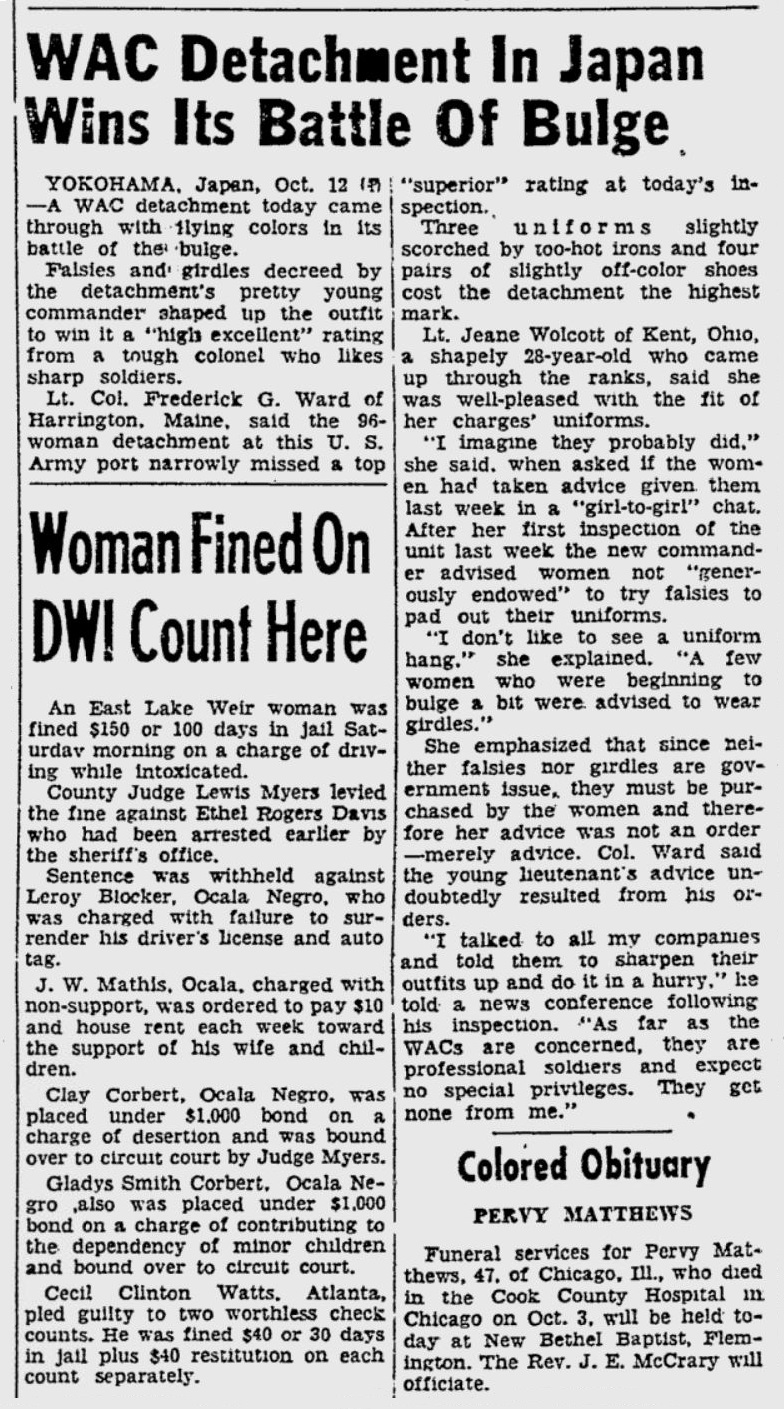 Racism and racialism The "Colored Obituary" (racism) and the "negro" nomenclature (racialism) in the police blotter column characterized the times. Some northern papers also habitually labeled "colored" people. But the segregation of content, while not unknown in the north, was more likely seen in the south.
Racism and racialism The "Colored Obituary" (racism) and the "negro" nomenclature (racialism) in the police blotter column characterized the times. Some northern papers also habitually labeled "colored" people. But the segregation of content, while not unknown in the north, was more likely seen in the south.
 St. Petersburg Times
St. Petersburg TimesFriday, October 11, 1957 WAC detachment double billing Lt. Jeane Walcott Domestic AP wirephoto & Japan AP report Register-Guard Thursday, October 10, 1957 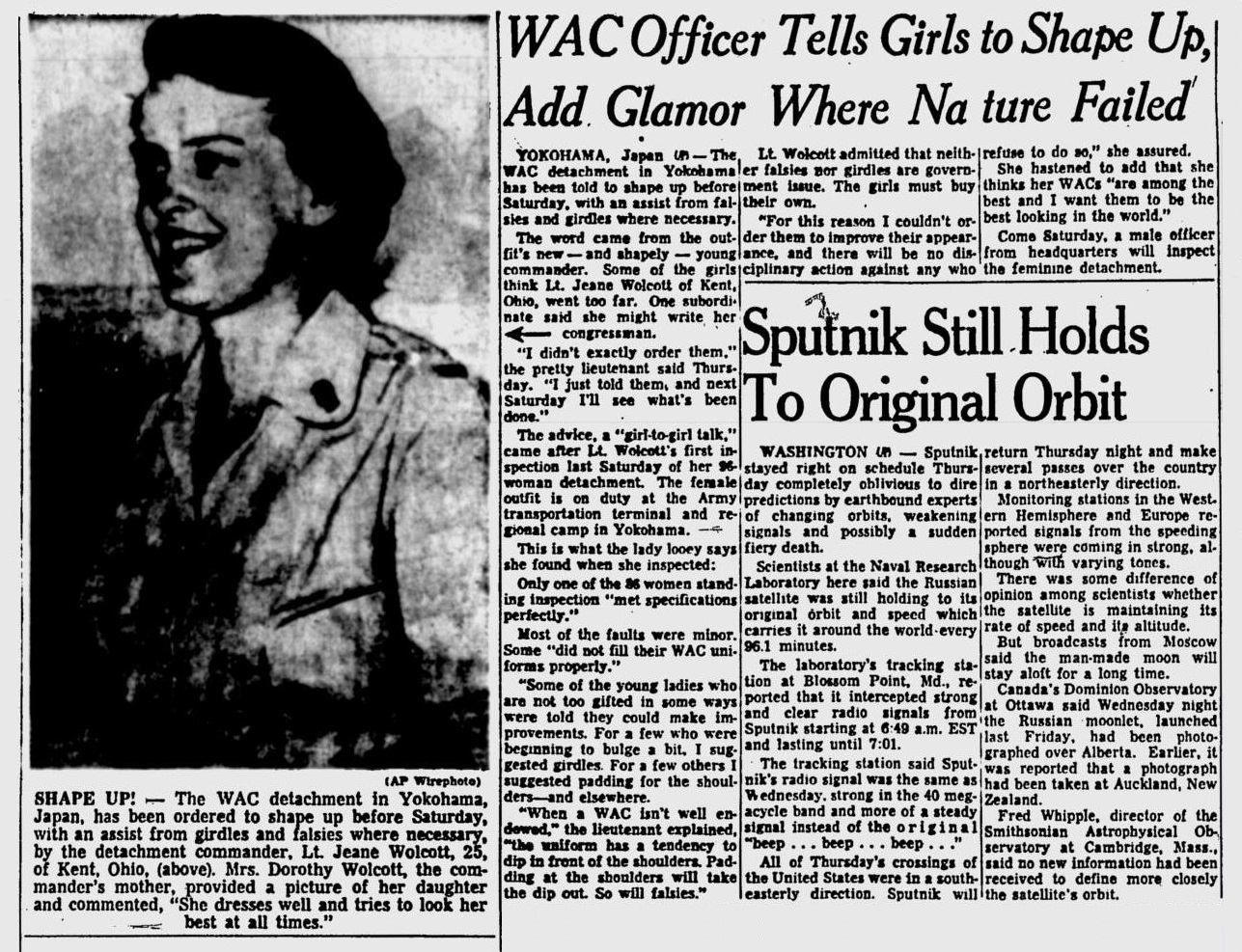 Sputnik I had just begun my junior year in high school and dreamed of being an electronics engineer in the expanding space program. Students like me were in great demand in the "Sputnik generation" as America lagged behind the Soviet Union in rocketry and desperately need more engineers. I was interested in aeuronautics related to space travel, though, not in weapons development -- but the technology was the same, and reaseach and development was driven by military needs.
Sputnik I had just begun my junior year in high school and dreamed of being an electronics engineer in the expanding space program. Students like me were in great demand in the "Sputnik generation" as America lagged behind the Soviet Union in rocketry and desperately need more engineers. I was interested in aeuronautics related to space travel, though, not in weapons development -- but the technology was the same, and reaseach and development was driven by military needs.
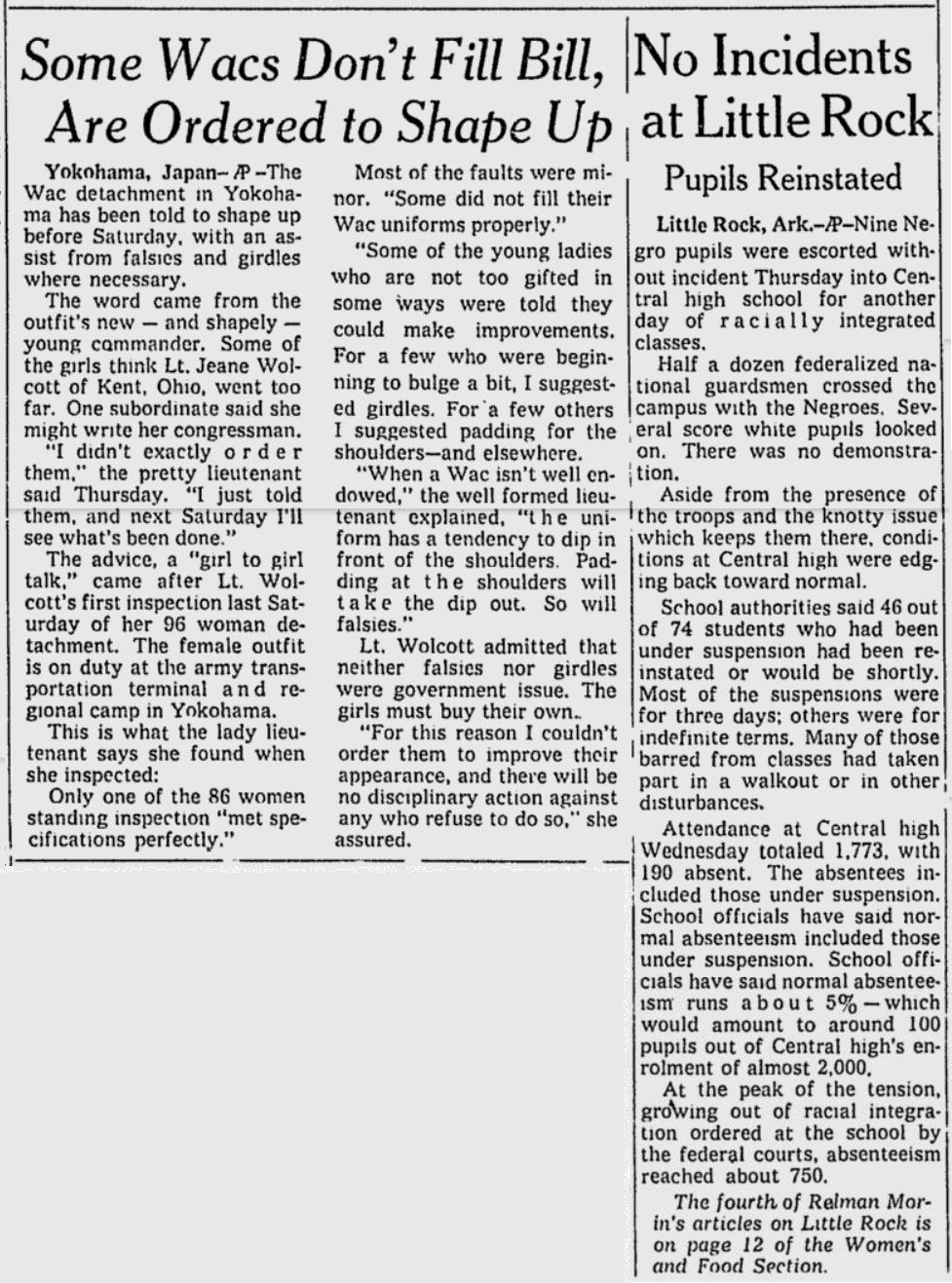 The Milwaukee Journal
The Milwaukee JournalThursday, October 10, 1957 Little Rock Again, the ever important context of the Yokohama story in the age of social unrest as America continued to face the legacy of its age of slavery. As I write this 60 years later, the age of "multiculturalism" has failed to heal the historical wounds, which continue to be aggravated by educationally encouraged racialist identity and race-box-ism in social policy.  Wilkes-Barre Sunday Independent
Wilkes-Barre Sunday IndependentSunday, October 13, 1957 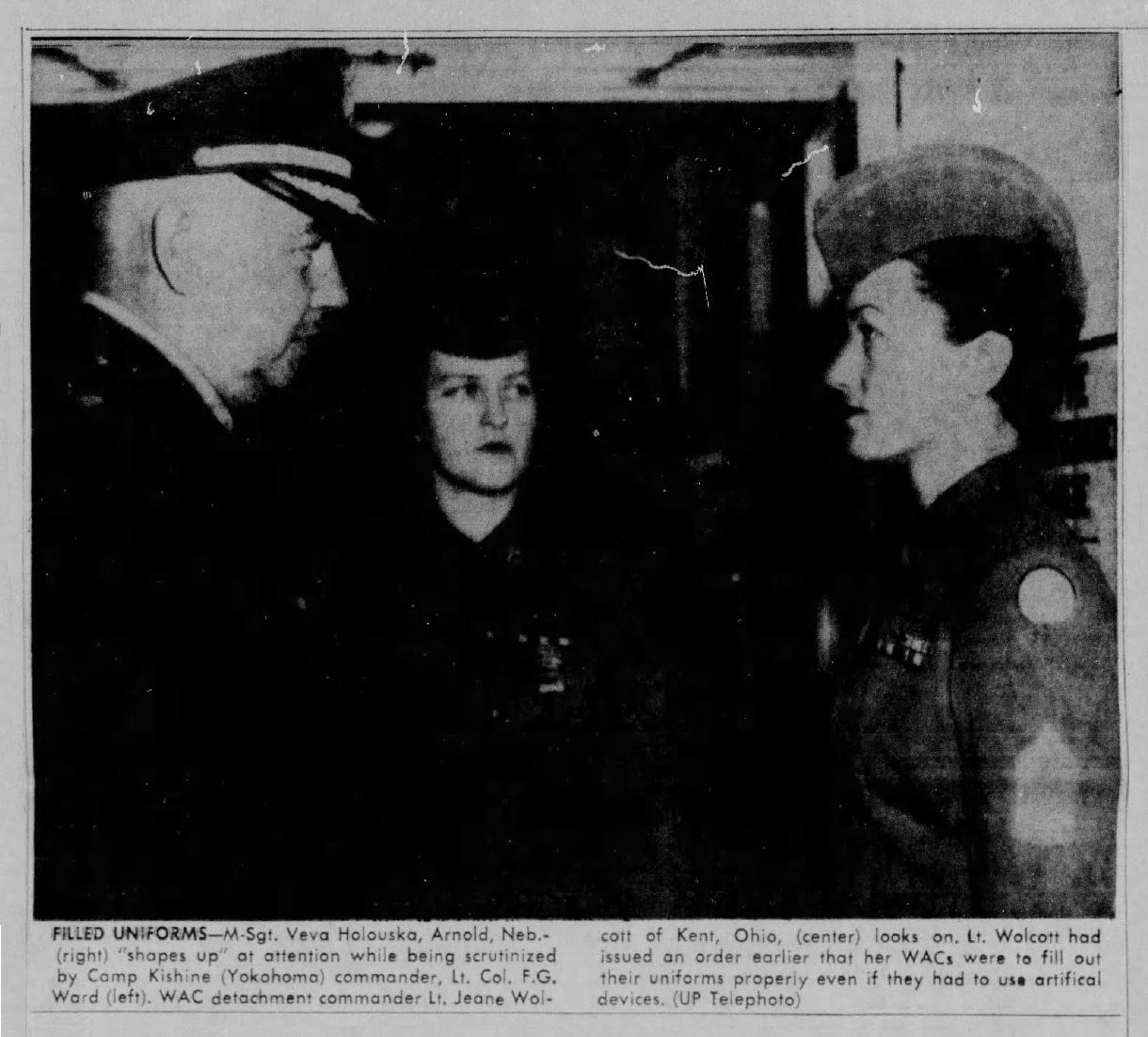 Valley Morning Star
Valley Morning StarMonday, October 14, 1957 UP Wirephoto of Camp Kishine WAC inspection MSgt Veva Halouska 4-column uncropped photo (above) 1-column cropped photo (below) El Paso Herald-Post Monday, October 14, 1957 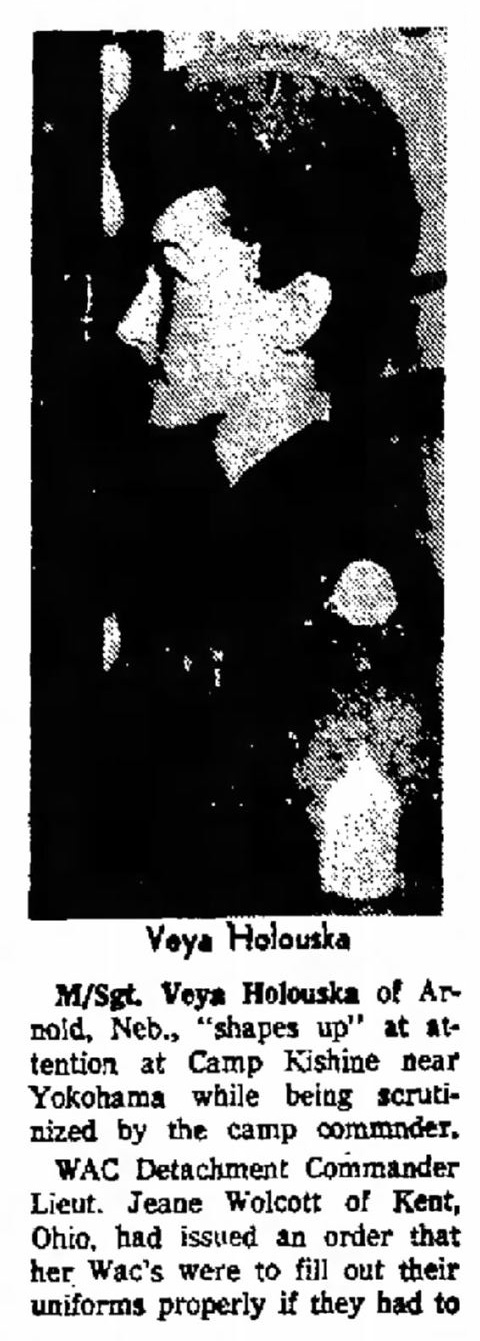
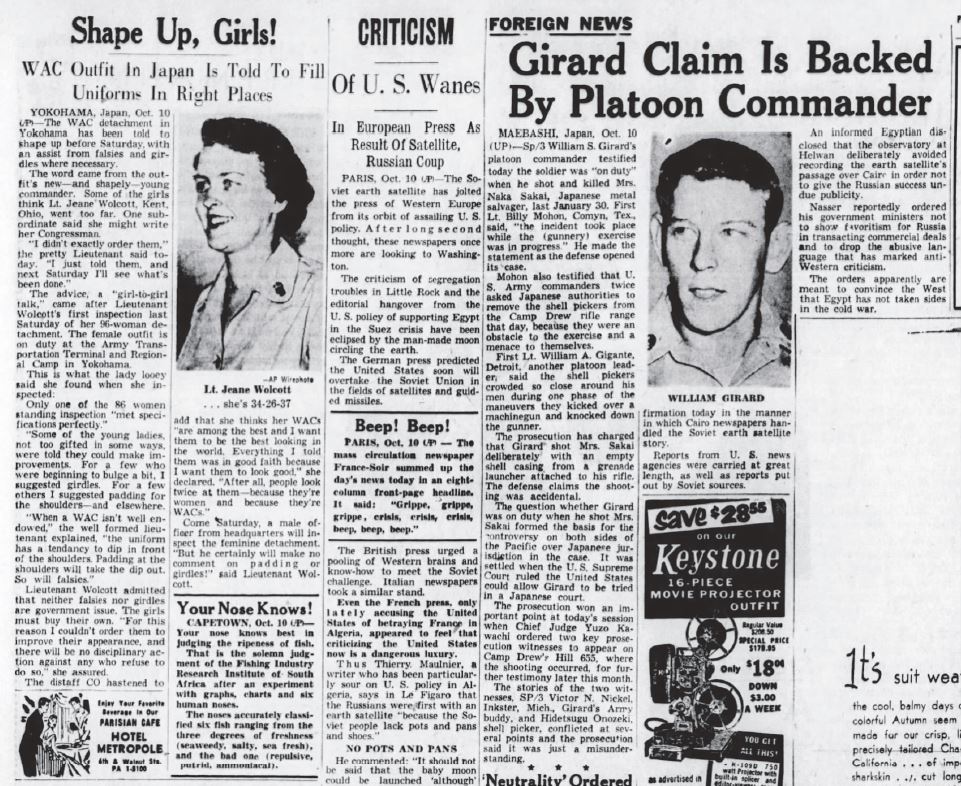 To enlarge click WACs or Girard
To enlarge click WACs or GirardCincinnati Enquirer Friday, 11 October 1957 AP Japan double feature Both the Yokohama WAC detachment story and the Maebashi Girard shooting story appeared on same page with photos of Lt. Wolcott and Sp3 Girard |
|||||||||||
Gregory J. Kupski (1957)Kupski homicide case (1957-1959)A month after Kishine Barracks got its 15 minutes of fame, basking in the glory of the WAC detachment inspection (above), its name was associated with the sort of incident that U.S. Forces public relations officers in Japan despair -- the killing of a Japanese woman by an American soldier. The body of Kazue Eikawa (originally misreported as "Hikawa"), 25, was found in a Yokohama alley on the morning of 17 November 1957, a Sunday. She was nude but for the blouse which had been wrapped around her neck, apparently to strangle her. Her panties had been stuffed into her mouth. 23-year-old Specialist 3rd Class Gregory J. Kupski, who was stationed with the Yokohama Troop Command at Kishine Barracks, was charged with killing the Eikawa, who turned out to be the wife of Aviation Machinist's Mate Petty Officer 1st Class Robert L. Wescott, who at the time was stationed at China Lake Naval Air Station in California. Kupski himself was married to a 21-year-old Japanese woman named Utako. The Army determined that Japan had jurisdiction. By December, the prosecutor of Yokohama was indicting Kupski for murder. By 1958 the Yokohama District Court had tried, convicted, and sentenced Kupski to 6 years in prison with hard labor. Shortly after he lost his appeal in 1959, he escaped with another soldier from the stockade at Tachikawa Air Base, where he was being held, but two days later was captured. Reportage on the Kupski case played out in the daily press like a serialized true crime drama. It followed on the heels of the highly publicized case of 21-year-old Specialist 3rd Class William S. Girard, an infantryman with the 1st Cavalry Division, who early the same year -- on 30 January 1957 -- had shot a woman brass collector on a firing range in Gunma prefecture -- accidentally he claimed, probably truthfully. The victim was Naka Sakai, a 46-year-old wife and mother of 6 children. The question of which country had jurisdiction went all the way to the Supreme Court that spring. By summer Girard was being tried for manslaughter in Maebashi District Court. By the end of the year -- December, 1957, the month after the Kupski case began -- the court had sentenced Girard to 3 years in prison at hard labor but commuted the sentence to 4 years if he behaved himself, and by Christmas he was back home in the United States, with his wife Haru "Candy" Sueyama, who he'd married while waiting to undergo trial. She was 7 years older than Girard and they had known each other before the incident. See The Girard and Kupski cases: Extraterritoriality and jurisdiction in post-Occupation Japan for detailed reports on both of these cases and others. |
Robert Duncan (1960, 1968-1970)
A never ending story
The following story is a pursuit of one man's dream of a reunion. I tell it here to dramatize how not a few people -- not only veterans, but others as well -- get to a point in their life when they wish they could reunite, if only by email, with someone they met in the past for whatever reason -- and for whatever reason parted ways. For the protagonist it is an extremely personal story, and is all the more dramatic because he himself tells it in the "public square" of the wild woolly web.
Military.com
Robert "Bob" W. Duncan attemped several times in messages he posted to the "106th General Hospital" and "106th Surgical Hospital" unit pages at www.military.com to contact people he knew at Kishine Barracks.
106th General Hospital
Duncan posted to both the messages and history sections of the unit page for the 106th General Hospital. He repeatedly asked for a roster or log of staff, EMs and officers, who worked on the medical ward on the 2nd floor of Building A of the 106th. At times he expressed an "ASAP" urgency for such a list.
Duncan reported that he first worked in the dispensary at Kishine in 1960 and had come there from Camp Zama Hopsital. He remarked that at the time "Kishine was a R&R center for people in Korea".
He said he had worked at Kishine again, at the 106th General Hospital, from 1968-1970, on the 2nd floor of the medical ward in Building A, under "Cpt. S. Deems" and "my lady" Cpt. Grace L. Wallace". In a number of messages, he stated that he especially wanted information about Cpt. Grace Wallace. In one posting, he said he had sent a message to David Arrowsmith -- "now a full colonel" -- to find "Lorraine Wallace" but noted that he [Arrowsmith] "was no help at all".
The 1 January 1972 edition of US Army Register (Volume II) shows Grace L. Wallace, U.S. Army Nursing Corps, born 7 July 1945, captain, temporary date of rank 24 September 1969, permanent rank 1st lieutenant, date of rank 24 September 1968, basic pay date of entry not recorded.
The 1 January 1972 edition of US Army Register (Volume I) shows David R. Arrowsmith, Army Nursing Corps, born 5 July 1943, captain, temporary date of rank 31 August 1968, permanent rank 1st lieutenant, no date of rank given, and no basic pay entry date given.
In the history section, Duncan repeated some things he had posted in the messages section. But he also wrote that, after leaving Kishine, he was sent to Ft. Ord in California for a short while and then to Viet Nam. He said that in California he had seen a Jim Hooper and also a Cpt. Murtz and her sister, apparently people he had worked with at the 106th.
"106th Surgical Hospital"
Duncan posted similar yet slightly different contributions to the messages and history sections of the "106th Surgical [sic] Hospital" unit page on www.military.com.
Duncan posted the following two items to the messages section.
|
[ 22 May ] [2009] [ 5 December ] [2009] |
Notice the change in Duncan's email address from columbus.rr.com to insight.rr.com. I have dated the above postings [2009] on the basis of the date of the insight.rr.com address change noted in one of the Fold3 messages (below).
Duncan repeated "Hakaraku [sic = Hakuraku] Mansion" as a heading in reference to an earlier message by George "Wally" Cox, who also lived there. Cox later referred to the place as "Hakuraku Mansion". The upshot of all bulletin board references to the "mansion" in Hakuraku (白楽) is that it was within walking distance of Kishine Barracks, a number of enlisted men and nurses lived there, and they had some serious parties.
"Manshon" (マンション) is commonly used in names of apartment buildings in Japan. It is also widely used to mean a single condominium unit.
Duncan posted the following two items to the history section.
|
[ 9 January ] [2009] [ 3 October ] [2009] |
Notice the change email address from columbus.rr.com to insight.rr.com. I have dated the above postings [2009] on the basis of the date of the insight.rr.com address change noted in one of the Fold3 messages (next).
No one responded to Duncan's query as to whether the "106th Surgical Hospital" used to be the 106th General Hospital. His two messages to the history section are the first of only 3, and there are very postings to the messages section. Some of the other contributors posted items to the 106th General Hospital page. One of the contributors, George "Wally" Cox, was a major participant on the "Yokoahama Navy Exchange was where?" forum at www.japan-guide.com, which has more activity concerning Kishine Barracks and the 106th General Hospital than all other bulltetin boards combined.
army.togetherweserved.com lists 106th Evacuation Hospital (Support Unit), 106th General Hospital (Base/Installation), and 106th Surgical Hospital (Support Unit), but only the 106th General Hospital shows a short list of affiliated members.
Fold3
Perhaps before, perhaps after the above postings, Duncan sent the following two comments to a 26 August 2009 announcement regarding a forthcoming family history expo in Salt Lake City on the official blog for Fold3.
|
Robert W Duncan I am trying to find a Army Nurse She was a Capt. Name Grace Lorraine Wallace> Last Known station was Ft. stewart Ga. 1969-70 ward Head nurse. Home town Moble AL.? Poss.in her 50? She is Cau.5’4″120 Bob Duncan thank you Robert Duncan Please help me find her, She mans more to me than life it,s self. Thank you. and old Soldier. rduncan4@insight.rr.com Bob. |
Fold3 specializes in historical military records, especially related to the Civil War and World War II. The "Comments" column is a standard component of its blog. It is not a venue for social networking, and no one else submitted comments to the family history expo announcement, much less what amounts to a "looking for" post on a people finder sight.
Zaba Search
Duncan addressed even stronger and more direct pleas to "Grace Larraine [sic] Wallace" on Zaba Search, a self-described "People Search. Honestly Free! Search by Name. Find People in the USA. Free People Finder". The year of the following two messages is not clear, but I would guess circa 2009-2010. See grace+wallace on Zaba Search for details.
|
Messages sent Thursday, February 5 2:34 [2009] To: GRACE LARRAINE WALLACE Messages sent Tuesday, August 4 2:19 [2009] To: GRACE LARRAINE WALLACE |
I have dated these Zaba Search messages as [2009] on the basis of the change from columbus.rr.com to insight.rr.com as dated in one of the Fold3 messages (above).
VetFrinds.com
Duncan's profile on VetFriends.com states that he served in the army from 1956 to 1978, partly with the "10th Gen. Hosp. Yokohamah Japan".
"Yokohamah""Yokohamah" is one of the more interesting odd spellings of Yokohama I have seen. What was Duncan thinking when he wrote the final "a" as "ah"? Intentional or not, what could it mean? Duncan's messages have full of errors, and at times it's hard to tell if they are typos or misspellings. But adding the "h" to "o" is an unlikely typo. And as a misspelling, it may have linguistic significance. "Yo-ko-ha-ma" is pronounced roughly "yoh-koh-hah-mah" -- in which the "o" and the "a" are similar to the "o" in "boat" and the "a" in "father". You won't much English-like stressing or destressing of any of the morae, though the pitch will probably rise on "ko" and remain high (or fall on) "ma". So you'll hear something like "yo-KOH-HAH-MAH" (or "yo-KOH-HAH-mah), in which the large letters represent pitch, not stress. Some English speakers, though, will say "YOH-kuh-HAH-muh" -- with secondary stress on "YOH" and primary stress on "HAH" -- which reduces both the second "o" and the second "a" to the unstressed general purpose English vowel called "schwa" (ə), which is roughly pronounced like the unstressed "a" in "sofa" or "adore". Schwa resembles the vowel called "carot" (ʌ), as represented by the "u" in "cut" and "luck". The difference is that while "carot" is a fully valued vowel in its own right, and capable of bearing stress, "schwa" is the result of destressing (reducing) other vowels. A good example in English is "photo" -- which is roughly "FOH-toh". In "photograph", though, it often becomes "FOH-tuh-GRAF". Such reductions typically happen in English, which is dominated by syllabic stress, whereas stress plays practically no role in the pronunciation of Japanese morae. |
In the spring of 2016, I attempted to reach Duncan at both of his Road Runner addresses, but my mail bounced. When checking Road Runner operations, I found that in 2013 Time-Warner Cable acquired Insight, and Insight customers were required to change their insight.rr.com domain addresses to twc.com addresses. But all attempts to combine Duncan's Road Runner email handles with twc.com bounced.
Ancestor.com
Ancestry.com shows numerous Robert W. Duncans who, agewise, could be Kishine's Bob Duncan. But only one was associated with the Columbus, Ohio street address and ZIP code Duncan disclosed in one of his "106th Surgical Hospital" postings.
Kishine's Robert W. Duncan was born on 23 July 1938. He was therefore about 18 when he enlisted in the Army in 1956, and about 40 when he retired in 1978 after about 22 years in the service. Some other data could be related to the same Robert W. Duncan, but I can't make definite connections.
The are also many Grace Wallaces and some Grace L. Wallaces, but all I could find that I could positively relate with the woman Duncan appears to be referring to was the data I cited above from the 1972 US Army Register.
In one of his postings, Duncan writes "Wallace/Dacid" as though "Dacid" might have been Grace's married name. But even "David" ("v" is next to "c") and "Davis" ("s" is next to "d") yield no one that would match Cpt. Grace L. Wallace's 7 July 1945 birthday or anything else close to the person Duncan is looking for.
So there it is. A never ending story, for me.
Perhaps Duncan found her. I will keep looking for both of them.
I might even try to reach Duncan by snail mail.
Larry Rollyson and Richard Greene (1961)
Cook loses head? At Kishine Barracks in Korea?
Cook on way to Korea through Kishine keeps head
Both of the following tales, told by third parties, are about cooks -- one who lost his head at Kishine Barracks in Korea, the other who lost kept his head at Kishine Barracks on his way to Korea -- in 1961.
I'm reminded of a man who, digging in his garden, unearthed a head and brought it to the lost and found department at the local police station, thinking he might get a reward. The officer on duty told him he probably wouldn't, since it was not unlikely that the person who lost it will come looking for it.
But back to the stories about Kishine.
Cook loses head? At Kishine Barracks in Korea?
Larry Rollyson, of Council Bluffs, Iowa, knows the difference between a hurricane and a typhoon. In 2004, he had an opportunity to compare a hurricane that hit the Gulf Coast that year with a tyhpoon he witnessed at Kishine Barracks, in Korea or Japan, wherever it was. The following is cut and pasted from the Daily Nonpareil at Council Bluffs.
Bluffs man weathers numerous stormsTuesday, August 17, 2004 By Tom McMahon Images of motorists creeping along Interstate 275 to escape Hurricane Charley brought back memories of the highway and the storms to Larry Rollyson. "We called that highway the "car strangled spanner," joked Rollyson, noting traffic was snarled even when the weather was good. Rollyson said he's seen his share of tropical storms -- hurricanes that hit both Florida coasts, a typhoon that decapitated a man in Korea, and Hurricane Camille, one of the worst storms to ever hit the Gulf Coast. Images of motorists creeping along Interstate 275 to escape Hurricane Charley brought back memories of the highway and the storms to Larry Rollyson. "We called that highway the "car strangled spanner," joked Rollyson, noting traffic was snarled even when the weather was good. Rollyson said he's seen his share of tropical storms -- hurricanes that hit both Florida coasts, a typhoon that decapitated a man in Korea, and Hurricane Camille, one of the worst storms to ever hit the Gulf Coast. The native West Virginian, who now lives in Council Bluffs, said he likes storms and ranks tornadoes as the worst. "They do a lot worse damage than hurricanes," he said. "I think a lot of the damage from hurricanes comes from tornadoes it spawns." While the 67-year-old has never been harmed in a storm, he has seen his share of destruction. "My most vivid memory is seeing a man beheaded," Rollyson said. That happened in 1961, when he was stationed in Korea. He said he was at the Kashini Barracks when a typhoon hit. "We were digging up wooden sign posts to keep them from being thrown around. I was digging and looked up. A sudden gust of wind tore the roof off a lean-to shed," Rollyson said. "Two guys in white, I think they were cooks, were running, and I saw the roof slice one of their head's off." |
Cook on way to Korea through Kishine keeps head
U.S. Army veteran Rich Greene blogged the following early experience at Kishine Barracks before it became a hospital. In 1960 he had trained at Fort Ord in Monterey in California, as a member of the Army California National Guard in San Francisco. In October 1961 he enlisted as a cook, hoping to go to Japan, but the Army sent him to Korea instead, though via Japan, where he stayed at Kishine Barracks for a week.
Greene's journey began from Travis Air Force Base in California, with stopovers at Hickham Field in Honolulu, and Wake Island.
|
Our next and final stop this trip was Tachikawa AFB Japan, outside Tokyo. . . . I was taken to Kishini Barracks in Yokohama until a flight could be arranged for further air transportation to Korea. I wasn't looking forward to it. So I decided I would make the best of it. It was close to Christmas and I had a few bucks on me. Japan was el cheapo back then. I bought some presents and shipped them via air mail back to the States. I was at Kishini Barracks for a little over a week. I was taken back to Tachikawa AFB and boarded a double decker aircraft -- a C-124 nicknamed "Old Shakey" because of it's rough ride. Still no jets yet. After a few hours we landed at Kimpo AFB just outside of Seoul Korea. Everything looked like the war was just over. Muddy streets, blown away buildings, and bullet holes everywhere. . . . |
Vietnam wounded at Kishine Barracks hospital in spring 1964?
Speaking of tales, this one just came in from someone who represents himself as a disabled Vietnam vet, posting the following on message on a Korean War veteran bulletin board on behalf of a friend of his who he claims was also wounded in Vietnam but is having trouble proving his claim to the Veterans Administration. I have deleted some of the personal information from the original message, which was posted on at 304th Signal Battalion (Operations, Page 3) on 14 April 2006.
|
[ NAME OF FRIEND ] Service or Relationship: FRIEND OF VETERAN Comments: He has gone to VA for help but they keep turning him down saying there is no proof that he was ever in Vietnam. His records were part of thos burnt in 1973. I've seen his wounds, and I know there real. Does anyone remember being sent with Whitney from Co A, 304th to the philippines and Vietnam? He operated the large generators and those that went tdy worked with the advance party of 1st Cav and the Marines. If you know him, please give him a call at [ phone number of friend ] Thank you Keywords: Does anyone remember a [ name of friend ] from Idaho who served with Co A 304 Signal at Camp Conner in 1963-64 then went TDY to the Philipines and from there to Vietnam. He was severely wounded by a mortar round in March 1964. He woke up aboard the USS Hope Hospital Ship and then spent two months in the hospital at Kashini Barracks, Japan. From their he was shipped back to the states (Fort Carson) and finally discharded. |
Where was Kishine Barracks?
At least one report about someone who passed through Kishine Barracks has placed the facility in Korea (Tom McMahon's report about Larry Rollyson, above). Most people who had been there, however, remember it as being in Yokohama. A few have located it in Tokyo, but no has associated the "Kishine Hospital Base" with such an oddly ordered list of historical events as James Freeman (b1956) has done in the following excerpt from My LIfe [sic] in Delightful Decades / A Picaresque Journey Around the Globe with Little to Not-so Little Jimmy Freeman, which he posted 15 January 2013 (0 comments as of 14 March 2016). Freeman describes himself as "The son of an Army Medical Officer ["Cln. James Hedges Freeman" (b1931, Diagnostic Radiologist)] in Med School at MaGill [sic] before and after Korea and a erudite Government Service English Teacher" and was therefore an "Army brat" -- as children of such families, who move with their families from post to post, and rarely stay anywhere long enough to set down roots, commonly call themselves.
We [my began to move every 13 months, courtesy of Uncle Sam, my Mom teaching a new group of third graders every September (including me -- sorry FERPA [Family Educational Rights and Privacy Act]); my Dad a new group of Intern MD.s: Ft. Leavenworth, Kansas; Walter Reed, D.C.; Letterman at Presidio (before the Zodiac); Kishine Hospital Base, Tokyo, Japan before, during and after the Tet offensive (30 January 1968) and during the Pueblo "Incident;" [23 January - 18 December 1968] . . .
Jim Szabo (1962)
Stayed at Kishine during a week of R&R from Korea
The photo, showing the entrance to Kishine Barracks, where an American soldier is talking with a Japanese lady -- I was both surprised and honored to see it, for I was the one who took that picture. If the exact day is not important, it was in February 1962. I am not seeking any compensation for it. Glad to help. I stayed there on R&R from Korea, in one of the buildings called "R&R Hotel" (I have a picture of it).
I thought I would clarify the date of that photo. Best regards, JS
This is the message I received on 29 January 2016 from Jim Szabo through the Contact Form on my website, informing me that he had taken the photograph of the front gate of Kishine Barracks that I have shown at the top of the Kishine Barracks webpage. The photo was the earliest I had been able to find on the Internet, where it was undated and unattributed. I had provisionally dated it "nlt 1965" as it had to have been taken before the arrival of the 106th General Hospital in December 1965. Jim informed me that he had taken it in February 1962 while on R&R from Korea.
Jim and I struck up an exchange of stories about not only Kishine but also our other military experiences and civilian life. He sent me scans of many of the photographs he took during his 2-year stint as a draftee from 1960-1962. Before being drafted, he had working in printing, and he returned to the same job after getting out. He then completed courses at a drafting school and worked until his retirement in 2002 as a drafter and designer.
We talked a lot about printing and drafting. When I was growing up in San Francisco, I picked up an interest in printing from the father of an older boy in the neighborhood who had a printshop in his basement. I had took print shop in the 8th grade at A.P. Gianinni Junior HIgh School in San Francisco, and then worked in a printshop in Nevada City during the summer of 1955 after I graduated from the 8th grade at Union Hill Elementary School near (now in) Grass Valley. I had also studied drafting in high school and college and worked as a drafter in the design department at San Francisco Naval Shipyard during part of 1962 -- the year Jim passed through Kishine. We swapped snapshots of drafting equipment we have kept over the years.
Over a period of several weeks, Jim fed me running accounts of his life in the Army while emailing me related photographs. He wrote clearly, and the sheer commonality of his exerpiences make them interesting. Here I have taken the liberty to cite passages selected from several of his email communications.
29 January 2016
"The great thrill was to eat from a real plate"
. . . I had a Petri 7 camera, which was easily available in the PX in Korea, cost a few cents under $25.00 |
||||
2 February 2016
"the pots and pans hanging from the ceiling started to rattle"
. . . We slept there [at Kishine] on cots, as late as we wanted and did not have to make it up after we got up. Nobody came to inspect anything...
When we first arrived there -- 5 or 6 of us -- we were lead to the mess hall (I could not locate it on the aerial photo), but remember, that the pots and pans hanging from the ceiling started to rattle. We didn't know what to make of it. The cooks told us, it was nothing, just mild earthquake/tremor, normal here...
We hardly went there for breakfast, because the serving time was too early, besides that, we had to pay (25 cents) anyway... We found out soon we could eat at the EM club (where the floor show was at night) for just a little more. Couldn't locate that building either.
If I now think back, I find it amazing how many things I don't remember... On at least 2 occasions I caught the bus at or near the gate to go to the Yokohama train station... I could not tell you the color of the bus, or approx. how long it took to get there or what the station looked like... One thing I do remember; on coming back from Tokyo, at the Yokohama train station I wanted to get on the bus to ride it back to Kishine... One big problem: on every bus the destination was written in Japanese. Somebody (no longer remember, man or woman or who) but was kind enough with some little English to guide me on the correct bus.
2 February 2016
Korea 1st Cav PFC Jim Szabo on Ginza in dress greens
"didn't notice any hostility or resentment"
. . . When we got our orders for Korea, we were told no civilian clothes were allowed to be taken there. That applied to officers as well. The reason behind it, as I found out later, that due to the sanitary -- or lack of it -- conditions there, all clothing had to be impregnated with some sort of pesticide (quartermaster laundry). The attire was relaxed, fatigue uniform or summer uniform without tie, in winter OD shirt and pants when go on local pass (=off post). There were nothing but primitive villages and rice paddies all around us. The greens we wore a few times, and when we got a chance to go on an occasional 3-day pass to Seoul. |
4 February 2016
USO -- "a piece of home"
. . . the USO [souvenir] sheet will explain it all. The place was there on Ginza for all servicemen to drop in, find a piece "of home", cup of coffee, donut, etc.; get any kind of help about the customs, directions, answers to what is where...
4 February 2016
Draft notice and training
"Never volunteer for anything"
. . . It was sometime in 1959 in New Jersey, that I registered with the local Selective Service...
The next time I heard from them, was in June 1960 -- it said GREETINGS in a large envelope... in other words, I got drafted, which meant 2 years. If that was "bad" news, the good news was, that there was PEACE all over the world...
I had to report for induction on July 6, 1960; given the ETS as July 5, 1962. How good this "July 5" was going to affect me, I'll return at a later date.
A bus took us (inductees) to Newark, NJ. After the usual procedures we were driven to Fort Dix, NJ. Stayed there one week and from the adjacent McGuire Air Force base we were flown to Pope Air Force base in North Carolina, then on to Fort Bragg, next door. -- One thing I remember, as a MSG. gave us the orientation speech, he concluded with the advice: Never volunteer for anything...
Fort Bragg -- see 1st picture, I'm on the left. Next picture -- on guard duty, New Years Day, 1961.
April 1961, so many of us got our orders for Korea... With it came an automatic 30 days leave time, plus 13 days travel time, to Oakland Army Terminal, California. To get there, was left to each individual, 6 cents a mile, amounted to nearly $200.00; was more than enough to get there by May 23rd whatever way one chose. My travel agent put me on a non-stop jet the evening before (3rd picture, as I was leaving for New York -- now JFK -- airport). Slept in San Francisco and the next morning took a bus to Oakland and a taxi to the Army Terminal. Signed in one hour before the designated reporting in time...
During your time (=Vietnam), I think troops were flown there; however, we traveled by troop ship. There were 4 of them: the Sultan, Gaffy, Breckenridge and the Mann. I got on the Mann...
5 February 2016
"pictures not so great are better than no pictures"
. . . In Oakland, I was with a former buddy, we knew each other from Fort Bragg; so we hung out together. Stayed in the Army Terminal for about a week, until a shipload of troops came together. Whenever we could, almost daily, went over to San Francisco and roamed around.
On or around Memorial Day was, when we shipped out. The attached first picture will show it. -- Yes, I always had an interest in photography. Took a cheap camara with me, not knowing if it would break or get stolen... I am glad I did, because, pictures not so great are better than no pictures.
7 February 2016
"USS Off-Limits"
. . .So, I arrived in Korea on June 17, 1961; took some 18-19 days... Looking back, compared to the Vietnam situation, there was no urgency, the ship carried -- forgot the exact or approx. numbers -- a couple of thousands, if not three -- soldiers. Cheap, compared to who knows how many flights it would have taken...
Back to the date; my ETS was July 5, 1962. So, they had to get me back by that time, the 13 month tour of duty was tight, to say the least. Then came, the unforseen [sic=unforeseen] Berlin Crisis. It stated, that anybody, whose ETS ends on or before June 30, will be extended by 3 months! I missed it by 5 days -- lucky or what! So, I left the same guys there, who were already there, when I got there. I didn't get on the May 30, 1962 boat, due to a technicality of 1 day, but I got on the very next one on June 10, 1962, which happened to be the USS Mann again...
What do soldiers do on a transport ship? I've heard that they are not the most pleasant ways to travel.
Well, going... As I mentioned, we picked up some 200 sailors in San Diego. But before that, we took on a whole bunch of dependents to be taken to Hawaii, I think. Quite a few of them had pets (dogs). A portion of the deck was reserved for them, where the troops couldn't go -- caused some resentment... Among us, the ship was renamed: USS Off-Limits... To keep us occupied, a large number of us were assigned to the "sweeping detail". Whenever we would relax on the deck, came the call over the loudspeaker -- "Sweepers, man your broom, clean sweepdown about the deck..." -- There was really nothing to sweep, because the constant, everpresent breeze would blow everything off, but, we had to go through the motion, anyway...
It looks like you might be writing a personal history?
I often hear, those who were in the bloody war, don't like to, want to talk about it...
For me, it was far from that, looking back at it as a diversion, experience, that taken, as I did, opened up new horizons... Glad I did it, as I was asked and grateful I came out of it unscathed...
You wrote a lengthy essay about Kishine, so why not me...?
Tell you about the return shipboard experiences next time.
For now, a few pictures already from Korea:
1. Arriving at Inchon. The ship dropped anchor way out, because of the shallow waters. Landing crafts brought us ashore to endless lines of trucks, which took us to a place called Ascom City, which was an orientation camp. From there we moved by train to a camp called 15th Administration Company. It processed incoming or outgoing troops. It was there, that I was sent to the 1st Cavalry Division, more precisely, B-Battery, 31st Field Artillery.
[ . . . ]
10 February 2016
"Okinawa was not even mentioned"
"{Korea] the land God forgot"
. . . Out of the 51 actual weeks I spent in Korea (arrived June 17, 1961. left June 10, 1962) there were only 2 of us, who went on R&R; not even together. This one guy went before me, he may have given me the idea to go. Asked a few guys if they would be interested, but the general answer was something like, no, I want to save my money... It was different earlier, but by my time, it counted against your leave time/furlough. So, when requested, they would give it to you, without any problem, barring some emergency, like outbreak of hostilities. As soon I returned to the States, my time was up anyway and would be separated.
What I don't remember now, if the R&R was for one week or 10 days... By the way, Japan was the only place available, which suited me fine. Okinawa was not even mentioned at all.
Anyway, I got the papers, and someone drove me to the earlier mentioned 15th Administration Company. They were between incoming and outgoing troops, the place was empty, so I could pick my barrack or bunk as pleased. They told me, someone would drive me out to Kimpo Air Base the next morning. Sure enough, a big Army bus came, just for me. At the Air Base I met others bound for Japan. We were told right away, we had the lowest priority on the forthcoming flights, so we should check each time if space was available. We did not care, because the R&R would not start, until checked in a Kishine. Played ping-pong, pool, whatever, ate at the mess hall...
At the end of the day it came to be known, that there would be no more flights till tomorrow. I don't know what the others did, but I took an Army bus and went to Seoul to the USO. There I could rent a cot, had hot showers and slept there. Next morning back to Kimpo by Army bus and the routine repeated. Sometime in the afternoon we got on a flight and flew to Tachikawa Air Force Base. I lost track of how the 4-5 of us continued from there to Kishine. Probably train and bus... Checked in at the orderly room, papers were signed, dated, stamped and then the R&R began...
Must have spent a minimum 7 days in Kishine, possible a day or two more, but not sure...
When the time was up, same orderly room, date, etc. No recollection how we made it back to Tachikawa. What I remember, the plane was a cargo plane. Gave us a wax ball, which we had to stuff in the ear to shut out the noise. Took off in the afternoon, and a few hours later, Korea became visible from the air... Instead of continuing the descent, we kept turning around as if going back. An Air Force sergeant came by and told us, that the plane had radio problem, couldn't transmit to ground station and had to go back to Tachikawa. -- We were issued blankets, etc. and spent the night there. The next day -- don't remember if it was a same plane or not -- started the run for it, but couldn't take off the ground. Back to the barracks and wait. We were not in a hurry, anyway. Don't remember when, same day or next, finally we were on the way. Landed in Korea, but can't recall the details from there. Everything was in order, the papers and getting to my compound. -- Some adventure, but made it safely closer to the time to leave Korea -- as the saying was, "the land, God forgot"...
Interesting, or what?
12 February 2016
"Yasukuni Shrine -- by chance"
. . . Yasukuni Shrine -- I got there by chance, without intending to go there. I had this Petri7 camera, which I bought in the PX in Korea. While I was in Japan, something went wrong with it, couldn't take any more pictures... which was a disaster! Asked the lady at Kishine who assisted R&R guys, if there would be a place nearby, where it could be repaired. I remembered, there was the address of the manufacturer inside the rear cover and showed it to her. There was something like "Ichigaya...". She told me to go there, knew where it was. Wrote it down what transportation (? don't remember) to take. She assured me it was easy to find. So I went there, found it without any problem. Talked to a gentleman in the lobby, saw what the problem was and actually apologized, that it would take "at least an hour" to fix it. Almost laughable... So, I walked around in the vicinity and saw a tall statue. I thought when the camera was done, I take a closer look of it. The camera was repaired without any charge and walked over to that statue; not knowing who it was (Omura who???). As I got closer I saw more and more, great opportunity to take pictures... So this is how I visited the place and glad I did...
I did hear something about the controversy not too long ago, involving Gen. Tojo, but nowadays there is controversy about anything and everything... The world got to be a crazy place.
...transportation between Kishine and Tachikawa was by military bus... olive drab Army vehicle.
The same in Korea; from 15th Admin. Co. to Kimpo, from Kimpo back to Seoul, etc.
[ . . .]
So you got out of the Army after a 2-year term as a draftee, which left 4 years of reserve obligation...
Correct. The following year, we draftees had to put in 2 weeks of reserve training. From my area they assigned us to a National Guard unit from Brooklyn (a borough of New York City) and had to go up to upstate New York, near the Canadian border. The whole thing was a waste, because they did not need us and didn't know what to do with us... After the 2 yrs. active duty came 2 yrs. of "ready reserve", which included the Cuban missile crisis (but did not affect me), and 2 yrs. of "stand-by reserve"... Got my full discharge in 1966.
Worked with a couple of guys in the '70s who served in Vietnam, but didn't talk about it.
Prior to getting drafted I worked in a printing shop (composing room), business forms... When returned from the Army, they had to give my job back. Shortly after, I went to drafting school at night for 2 yrs., got a job and worked as a draftsman/designer (3 different companies) till I retired in 2002.
[ . . . ]
Ellen M. Kruger (1965)Tachikawa Air Force officer in per diem disputeLife at Kishine Barracks did not begin with the arrival of the 106th General Hospital. And long after its arrival, some matters concerning Kishine Barracks before its arrival continued to occupy military and government bureaucrats. While the 106th General Hospital was busy treating a steadily increasing stream of wounded soldiers from battlefields in Vietnam, comptrollers armed with regulations and precedents were fighting over whether to pay a Tachikawa Air Force officer per diem for the two weeks she attended a course of instruction at Kishine Barracks. The triviality of this matter is all the more remarkable because evidence of its existence is preserved in the following ream-length official report for fiscal year 1967, freely and immediately perusable by anyone with access to the Internet, thanks to Google Books. United States, General Accounting Office "addition subsistence expenses incurred incident to
|
||||
Harvey Stuhl (1965-1966)A retirement cut shortHarvey Stuhl was the first of the original complement of lab techs at the 106th General Hospital to leave. To the best of my memory, I was the second. Harvey was in his 2nd enlistment and couldn't wait to get to Vietnam. I couldn't wait for my ETS (Expiration Term of Service). I had more formal science education, but he had more experience in lab work, and he was better and more versatile than all three of the senior NCOs who outranked him, who were not very familiar with bacteriology. Unlike the NCOs and most of the other lab techs, Harvey had worked quite a bit in bacteriology, as I had. We both aspired to be part of the bacteriology section, and it fell to us to help Lt. Terry, the resident bacteriologist, set up the section and get it running. I was also involved in setting up chemistry and histology, but after all the sections were up and running, I settled into bacteriology with Harvey, and so we became both co-workers and rivals. Harvey and I were opposites in many ways. We had little in common but generally got along. The attention to neatness I had learned from my mother had been sharpened by Janet Baker, the bacteriologist at the Sixth U.S. Army Medical Laboratory at Ft. Baker (below), who taught me all I knew about diagnostic bacteriology, and had deeply instilled in me the need to be very careful and meticulous in the handling of contaminated cultural media. I didn't smoke, and while I didn't particularly like smoking, I wasn't opposed to other people smoking -- except in the lab. Harvey was more relaxed about keeping things clean and tidy, and he thought it was okay to smoke wherever he worked in the lab, including the bacteriology section. Having little in common -- outside our shared 106th destinies and lab assignments -- did not stop us from having conversations. He told me lots of stories about his adventures in life, and possibly about his family, although frankly I can't remember anything. All I recall about his family background, from my own memory, was that he was Jewish but didn't appear to be living a religiously Jewish life. While I literally lived in and out of the lab -- I had a bed and locker there -- Harvey spent almost all of his free time off base. He had girl friends, and I met one of them. By this I don't mean that he couldn't have made it in the outside world. It just seemed to me that he liked the opportunities of military batchelorhood in exotic places. Even in Japan, though, he was restless to leave for something more exciting, and as I recall he requested to be sent to Vietnam and left shortly before I did. Harvey was the only other lab tech who both knew enough about bacteriology, and had enough interest, to help set up the bacti section. In this respect we became rivals, but he had more experience, and the need for someone to do parisitology, which was also Lt. Terry's bailiwick, kept Harvey and I from arguing too much over territory. He became the main bacti technician, and I became the sole parisitology technician who sometimes lent a hand in bacteriology, which shared the same wing.
Stuhl's parentsThe 1940 federal census shows Paul Stuhl, 29, an alien born in Romania, married to Clara, 25, a naturalized citizen born in Romania. They have no children, and he is a candy salesman. A Port of Niagara Falls, New York, manifest card dated 8 May 1943 shows Paul Stuhl crossing into the United States from Niagara Falls in Canada. His was born on "3/27/11" [sic = 3/25/11] at "Baia Sprie, Roumania". His "Race" is "Hebrew" and his "Nationality" is "Roumania". He had been in the United States from April 1930 to a date in April 1943, most recently in Pennsylvania. His mother, Regina Stuhl, was in Pennsylvania. He was a salesman, and was 5 ft 7 in tall, had a fair complexion, black hair, and hazel eyes, and wore glasses. In April, a month before, he had been pre-examined [for military induction] in Pittsburg, Pensylvania, pursuant to an authoriziation dated in March. He was said to hold an "Affidavit as to Identity and Nationality dated 11/24/41" and a letter from the American Consul in Niagara Falls, Canada, testifying that his papers were in order. So Paul Stuhl appears to have made a brief trip to Canada after his pre-examination [physical], and was returning to Pennsylvania, where he would be soon be inducted. According to an application to the Commonweath of Pennsylvania, World War II Veterans' Compensation Bureau, dated in 1950, Paul Stuhl was born in Felso Banya, Hungary, on 25 March 1911 (which happens to have been my own father's birthday in Ames, Iowa). The application was for compensation for service between 7 December 1941 and 2 March 1946, which brackets the official period of World War II in the United States. Paul Stuhl claimed 23 months of domestic service and 6 months of foreign service in the U.S. Army from July 1943 to November 1945. His foreign service was from 24 May 1945 to 19 November 1945. The record states that he was awarded $320 ($230 for the domestic service, $90 for the foreign service). The 1950 compensation application lists Paul Stuhl's wife Silvia Stuhl, his children Harvey A. Stuhl, 6, and Pamla F. Stuhl, 2 1/2, and his mother Regina Stuhl. His father is deceased. "Pamla" is apparently "Pamela" (later Eisen). Paul and Silvia had two more children, Janice (later Brody) and Este (later Summers). Clara (nee Rosenfield) in the 1940 census was Paul's first wife. Sylvia (nee Kaplan), his second wife, was Harvey's step-mother, the three girls born between Paul and Silvia were his step-sisters. Clara's death certificate shows she died in the hospital of peritonitis, on 31 December 1943, 4 days after giving birth to Harvey by Ceasarian section. There is conflict in the names of the countries and localities of birth. Romania was part of Hungary between 1940 and 1944. Felso Banya is the Hungarian name of the town known in Romanian as Baia Sprie and in German as Mittelstadt. |
|||||||
Fragments of data on Harvey's life suggest the following biography.
| Harvey Stuhl's biographical chronology (1943-1989) | |
| 27 Dec 1943 | Born Harvey Alan Stuhl in Pittsburgh, Pennsylvania |
| 31 Dec 1962 | Harvey's mother dies of fulminating peritonitis following elective Cesarean section without labor. Her death certificate states that she was born in Russia on 12 April 1916 to Osca Rosenfield (father) and Manuel Zelmachvaleg (mother). JewishGen data, based on synagogue records, states that her Hebrew name is Chiyah Rivha bat Asher, and that she is buried at B'nai Israel Cemetery in Penn Hills, Pennsylvania. |
| 6 Jun 1962 | Enlistment in U.S. Army begins |
| Fall 1965 | 106th General Hospital, Ft. Bliss, El Paso, Texas |
| Dec 1965 | 106th General Hospital, Kishine Barracks, Yokohama, Japan Specialist 5 (SP5, E-5) |
| Summer 1966 | Left 106th General Hospital for tour of duty in Vietnam Specialist 5 (SP5, E-5) |
| Summer 1967 | Presumed end of 1-year tour in Vietnam |
| 24 Nov 1967 | Married Ann Stuhl |
| 1977 | Resided in San Antonio, Texas [stationed at Ft. Sam Houston] |
| 1 Mar 1980 | Step-mother Silvia (Kaplan) Stuhl (b1922) dies, age 58. Buried in Tree of Life Memorial Park in Pittsburg |
| 15 Dec 1981 | Father Paul Stuhl dies, age 70. Buried in Tree of Life Memorial Park in Pittsburg |
| 30 Jun 1982 | Released from U.S. Army (retirement after 20 years of service) Rank at time of retirement apparently Sergeant First Class (SFC, E-7) A typical 20-year NCO rank that would draw a subsistence-level pension |
| 9 June 1983 | Divorced from Ann Stuhl (1 child) |
| 1988 | Resided in San Antonio, Texas |
| 1977 | Resided in Universal City, Texas |
| 9 Jul 1989 | Harvey Stuhl dies, age 45 |
| 14 Jul 1989 | Interred in Ft. Sam Houston National Cemetery, Sec 16 Site 689 |
 Fort Sam Houston National Cemetery, San Antonio (Circa 2003)
Fort Sam Houston National Cemetery, San Antonio (Circa 2003)Find a Grave photo by DonZas |
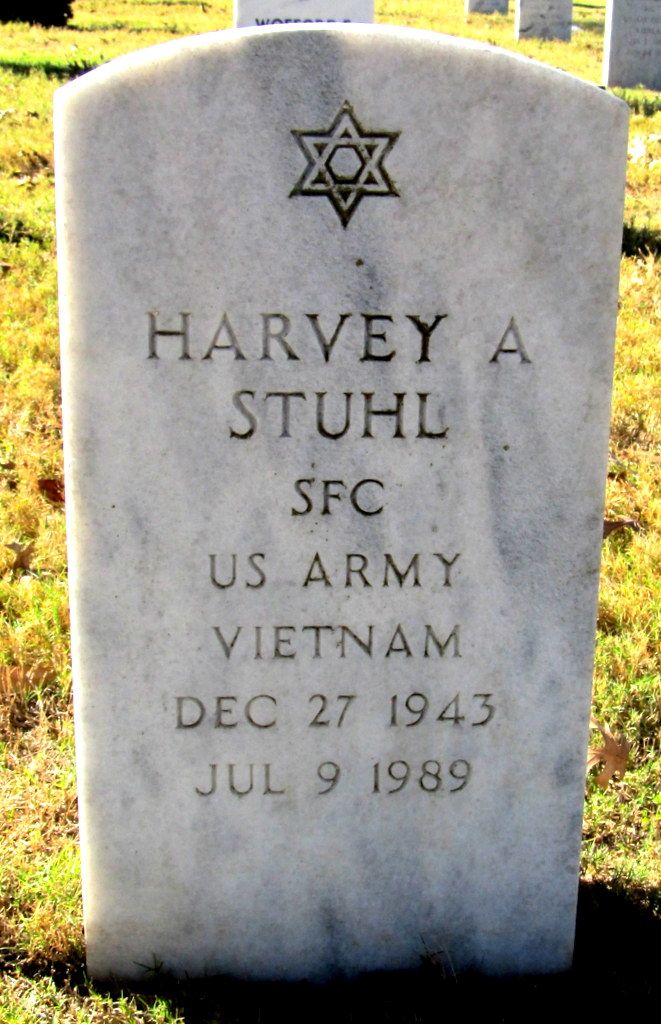 Harvey Stuhl's monument
Harvey Stuhl's monumentFort Sam Houston National Cemetery, May 2018 Find a Grave photo by Kurt Kneeland |
Stuhl's death
The mystery begins here. A death at age 90 or 80 is taken as a matter of course. Knowing the cause of death becomes less important than knowing that death came peacefully.
Curiosity about someone's cause of death increases the younger they die. Deaths at 70 or 60 are not today as common as they were a century ago, and so people are more curious about their cause. A death at 50 or 40, though, is today considered too young, and even people who didn't know the deseased are compelled to wonder why. A fall while sweeping pine needles from the roof? A boating accident while water skiing? An overdose or jealous lover?
- The JewishGen Online Worldwide Burial Registry (JOWBR) states that Harvey A. Stuhl is buried in a San Antonio cemetery.
- The National Cemetery Administration, U.S. Veterans Gravesites, Gravesite Locator database describes Harvey A. Stuhl as "SFC US ARMY / VIETNAM" -- the formulaic inscription on veteran memorial stones and plaques. The database states he was buried in SECTION 16 SITE 689 and has a link to a map of the section, which includes many individual graves and a couple of columbaria.
- The Beneficiary Identification Records Locator Subsystem (BIRLS) Death File, maintained by the U.S. Department of Veterans Affairs, gives the "Cause of death" for "H. Stuhl" as "Natural".
So there we have it. Or do we?
Causes of death
BIRLS's "Cause of death" categories appear to be "unknown, natural, combat, other". "Other" would include accident, suicide, and homicide -- to keep things simple.
Death due to "combat" in military lingo means death resulting from hostile fire under battle conditions. In the civilian world, being killed in combat would constitute a subcategory of "homicide" differentiated from being killed in a criminal offense (murder) or being killed as a form of punishment (execution).
The easiest breakdown of "external" or "instrumental" causes of death is commonly referred to as "NASH" -- natural, accident, suicide, homicide. The underlying "internal" causes of all these "modes" of death, however, are medical. The "external" issue here is whether the "internal" medical causes were created by "natural" causes (illness, disease), or by accident, suicide, or homicide. Cessation of breathing will be the underlying cause of a death regardless of whether the death resulted from the effects of liver cancer, choking on a piece of chicken, a leap from a building, or an arrow in the heart.
So saying that Stuhl died from "natural" causes still begs the question "Why?" Heart failure? Cancer? An infectious disease?
No obituaries . . .
I could find no obituaries . . . at least none as such.
This is not surprising. Most people die without public notification in the form of a newspaper obituary. Few people get more than a name and date-of-death notice, if that, in a local paper.
In any event, many obituaries avoid mention of cause-of-death particulars. Still, even a phrase like "after a long illness" is significant in that it would seem to rule out an accident, suicide, or homicide.
. . . however . . .
. . . Cyberspace has become a bottomless reservoir of searchable information culled from digitized scans of old newspapers. Almost everything gets tossed into a soup of words detached from their phrases and sentences and graphs and contexts, which makes the ideal broth in which to freely search for trivia.
The only downside is that scanners make errors in proportion to the illegibility -- the irregularity, bleeding, or fading -- of the impression. And an OCR (opitical character reader) scan of a page of old newsprint consisting of tiny fonts impressed with cheap ink on cheap pulp paper often yields little more than an alphabet soup in which a few, some, many, or all words are corrupted beyond recognition.
But I finally found the following two articles buried in two local papers.
Report of incident
Tuesday, July 11, 1989 2 Dallas teen-agers held in arrow slayingsAssociated Press DALLAS -- The body of a San Antonio man who police believe may have been slain by a bow and arrow was found near the northeast shore of White Rock Lake Monday [10 July 1989]. An anonymous telephone tip led officials to the east Dallas lake, where police found a 19-year-old man and a I6-year-old girl seated in the dead man's car. The girl led authorities to the body that was stashed in a nearby hole and covered with brush. Police believe the man was killed on Saturday. His name has been withheld, pending notification of relatives. Police arrested Marshall Craig Gardner and the girl on investigative charges in connection with murder. The name of the girl was withheld because of her age. Police say the teen-agers and the man were acquainted and that robbery may have been a motive in the slaying. Deputy Chief Marvin Bullard said the man may have been killed by a bow and arrow. "It's very unique," Bullard told WFAA-TV. "I don't think in my 25 years that I've ever seen a homicide that was committed by a bow and arrow -- and that's not confirmed, but that's the word we have, and there were arrows at the scene." |
|
|
San Antonio is about 274 miles (440 kilometers) driving distance south of Dallas. Fort Sam Houston, where practically all medical corpmen, laboratory technicians, and many other Army medical personnel are trained, is in the city of San Antonio, not in Houston. I received my corpsman training there. Harvey Stuhl most likely received his lab tech training there, and it appears that during the later years of his career he was later stationed there, possibly as a lab tech at the Brooke Army Medical Center, which is at Fort Sam Houston. "White Rock Lake is a 1,015 acre city lake [reservoir] located approximately 5 miles northeast of downtown Dallas. White Rock is one of the most heavily used parks in the Dallas Park system . . ." (www.dallasparks.org). WFAA-TV is a Dallas station viewable on Channel 8. Marshall Craig Gardner was born on 7 December 1969 and at the time of slaying was living Corpus Christi, a coastal city south of San Antonio. Galveston is on the coast east of San Antonio. |
|
Report of trial
Wednesday, October 10, 1990 Killer fesses upDALLAS (AP) -- A Garland man admitted that he used his teen-age wife to lure a San Antonio area man to a Dallas park where he stalked the man and killed him with a bow and arrow, a homicide detective has testified. Detective D.S. Ortega read a statement given police by Marshall Craig Gardner, 20, Tuesday at Gardner's murder trial in the July 9, 1989, slaying of Harvey Stuhl of Universal City. Ortega testified that Gardner denied involvement in the killing until he was told that Patricia Ann Gardner, his wife, had led officers to the man's body. Ortega said that Gardner became upset at Stuhl in April 1989, when Gardner needed $2,000 to post bond so that he could be released from a Corpus Christ jail. |
|
|
Marshall Craig Gardner was sentenced to a life term on 10 October 1990 according to Texas Department of Criminal Justice (TDCJ) data (see below). This is the date of the above newspaper article, which reported recent developments in Gardner's trial. TDCJ data shows that Gardner has been incarcerated in the Huntsville Unit of the Texas prison system. The unit is a 1,705 maximum capacity male prison operated by the Correctional Institutions Division (CID) of TDCJ. It is near downtown Huntsville, which is north of Houston toward Dallas, whereas Galveston is on the coast south of Houston. Gardner's life sentence appears to have been approved for parole, but he appears to still be in prison on account of two offenses of possession of a deadly weapon while in prison, which added additional and consecutive sentences of 12 years (1991 offense sentenced in 1992) and 10 years (1993 offense sentenced in 1994). |
Marshall Craig Gardner
The Texas Department of Criminal Justice (TDCJ) offender data base shows the following status for Marshall Craig Gardner.
SID Number: 03980505
TDCJ Number: 00567238
Name: GARDNER, MARSHALL CRAIG
Race: W
Gender: M
DOB: 1969-12-07
Maximum Sentence Date: LIFE SENTENCE CUMULATIVE OFFENSES
Current Facility: HUNTSVILLE
Projected Release Date: NOT AVAILABLE
Parole Eligibility Date: 2004-07-10
Offender Visitation Eligible: YES
Offense history
The same Texas Department of Criminal Justice (TDCJ) database shows the following table history of offenses for Marshall Craig Gardner (I have reordered them according to the date of the offense).
| Offense Date | Offense | Sentence Date | County | Case No. | Sentence (YY-MM-DD) |
| 1989-07-08 | MURDER W/DEADLY WPN | 1990-10-10 | DALLAS | F-9003684-KH | 9999-99-99 |
| 1991-11-14 | POSS DDLY WPN PENAL INSTI | 1992-10-29 | ANDERSON | 22577 | 12-00-00 |
| 1993-02-11 | DDLY WPN PENAL INSTITUTION | 1994-02-18 | ANDERSON | 23,124 | 10-00-00 |
The Texas Prison Inmates database at The Texas Tribune summarizes the history of offenses as follows (again, I have shown the offenses in chronological order from the original offense). This database includes Gardner's Height (5 ft 9 in), Weight (170 lbs), Hair Color (Brown), and Eye Color (Hazel).
| Crime | Committed On | County | Term | Sentence Began |
| MURDER W/DEADLY WPN | 7/8/1989 | Dallas | Life | 7/10/1989 |
| POSS DDLY WPN PENAL INSTI | 11/14/1991 | Anderson | 12 years | 5/13/1992 |
| DDLY WPN PENAL INSTITUTION | 2/11/1993 | Anderson | 10 years | 10/7/1993 |
The Prison Units database at The Texas Tribune shows the following record for Gardner as an inmate of Huntsville (as of February 2016).
| Name | Age | Main Crime | County | Entered On | Crime Location | Home County |
| Marshall Craig Gardner | 46 | MURDER W/DEADLY WPN | 11/5/1990 | Life | Dallas | Dallas |
Parole decisions
Gardner's parole is controlled by rules that apply to "consecutive or cumulative sentences". Parole boards vote as to whether an offender who is serving one or more sentences should be released, and if released, the conditions of release.
The same TDCJ database showed, as of 15 April 2016, the date of this writing, that the Last Parole Decision regarding Gardner was Approved on 14 March 2016.
The CUFI date was given as June 2016, along with the statement that "Parole was approved under the current sentence but the offender is not eligible for release due to a consecutive sentence. The current sentenced has ceased to operate and the offender has begun serving the subsequent sentence."
"CUFI" refers to cumulative parole approval when eligible. The CUFI date "Designates the date on which an offender serving consecutive or cumulative sentences will satisfy the current sentence and begin to serve the next sentence in the series. The cause number on the approved sentence will be indicated in the vote." (TDCJ glossary). According to the Texas Board of Pardons and Paroles, "Approval for parole on the current sentence in a series; offenders serving consecutive sentences are considered for parole for each individual sentence upon reaching eligibility. The offender must receive parole on or discharge the first sentence to commence serving the next sentence in the series."
Eligibility for parole
Note that that the TDCJ database shows a Parole Eligibility Date of 10 July 2004-07-10. I would guess that this refers to eligibility for parole on the original offense of MURDER W/DEADLY WPN.
A 2011 guide to the Texas parole system published in Austin, Texas by the Parole Division of the Texas Department of Criminal Justice and the Texas Board of Pardons and Paroles charts the changes over the years in Texas penal codes.
Until the late 1960s, the maximum period of eligibility for parole for all offenses was 15 years. It then changed to 20 years, and later a 2-year minimum eligibility rule was applied to cases of Aggravated Kidnapping, Aggravated Robbery, Aggravated Sexual Assault, Any offense with Affirmative finding of Deadly Weapon, and Capital Murder.
However, the 70th Legislature (09/01/1987 - 08/31/1989), which was in session at the time Harvey Stuhl was murdered, dropped the maximum eligibility period for all offenses back to 15 years, and the 2-year minimum still applied to aggravated offenses, offenses with a deadly weapon, and capital murder. The 74th Legislature (09/01/1995 - 08/31/1997) increased the maximum eligibility to 30 years for this class of offenses.
And so Gardener, when sentenced to life for killing Stuhl, had a parole eligibility window of 2-15 years. This meant, in effect, that if the parole board did not approve a conditional release by the end of his 15th year of incarceration, then he would no longer be eligible for parole. In other words, he had to spend at least 2 years in prison, and within 15 years complete all required rehabilitation programs and meet expectations of good behavior ("good time").
Within the first few years of his imprisonment, however, Gardner was twice charged and sentenced for violating a very serious prison rule against possessing anything regarded as a deadly weapon. These offenses add repsectively 12 and 10 years to his life term -- to be served from which point any parole he might be granted for the life term would have started.
Patricia Ann Gardner
I cannot trace Patricia Gardner after her involvement with Marshall Gardner in the slaying of Harvey Stuhl. Her name was suppressed in the initial report on account of her being protected by rules applying to younger offenders.
A Texas divorce index shows that a "Marshall C Gardner" (birth abt 1970) and a "Patricia A Gardner", who had married 10 June 1989, divorced 6 August 2002. A marriage index shows that "Marshall C Gardner" (birth abt 1970) married a "Katy A Engle" (Age 30) [born abt 1973] married 21 March 2003 in Nueces county [county seat is Corpus Christi].
I cannot determine whether these are the same "Patricia A." and "Marshall C." Gardners. The names and initials are not that unusual. Their combination is not highly probable but is possible. Having middle names and precise dates of birth would help rule out or accept the likelihood that these are same people.
Inmate marriages
Until 2013, Texas law allowed persons incarcerated in Texas prisons to marry by proxy. In a proxy marriage, one or both parties are represented by a third-party stand-in. Texas revised its family laws in 2013 to prohibit such marriages except in the case of military personnel stationed overseas. The object of the revision was to reduce fraudulent marriages. However, in 1987 the U.S. Supreme Court ruled that inmates had the right to marry (Turner v. Safley). In 2015, an administrative directive authorized offender marriages within TDCJ's penal institutions.
Leon Rodriguez (1965-1967)Nguyen Thi Mien (aka "Cindy") becomes Barbara Lynn RodriguezMost of the dramatic stories involving Kishine Barracks during the Vietnam War are by people who passed through the 106th General Hospital as wounded soldiers who were evacuated to Japan from Vietnam and lived to tell their tales. Leon Rodriguez, the author of Bring Our Baby Home, was a member of the original party that helped set up the 106th in Yokohama in 1965 and in 1967 became the surgical NCOIC of the 24th Evacuation Hospital in Vietnam.
Leon Rodriguez The 24th Evac was stationed at Long Binh in Bien Hoa (邊和) ward in Dong Nai (同坭) province near Saigon, now Ho Chi Minh, from August 1966 to December 1972. Long Binh Post, the largest U.S. Army base in Vietnam during most of the war, swelled to its peak in 1969, after which U.S. and allied troops began to reduce their strength in the country. The base was tranferred to the Republic of Vietnam (RVN) on 11 November 1972 as a result of the end of direct U.S. involvement in the war with the Democratic Republic of Vietnam (DRV). Rodriguez was born the son of Leon and Ruby Rodriguez in Fruita, Mesa County, Colorado on 17 January 1938, graduated from high school in 1955 and the same year enlisted in the U.S. Army. His overseas service including France, German, Japan, and Vietnam. After retiring from 20 years of military service in 1975, Rodriguez was licensed as a physician's assistant and surgical assistant in Washington. He married Else Heidimarie Muller in Ludwigsburg, Germany on 25 October 1963, and they adopted Nguyen Thi Mien as Barbara Lynn Rodriguez in 1967. (Source: Based on author's provile in Bring Our Baby Home and Ancestry.com) Rodriguez was with the 106th from 1965-1967 and served two terms in Vietnam, the first in 1967-1968 and the second in 1960-1970. Rodriguez's understanding of the origin of "Kishini Barracks" as an "R & R (rest & recuperation) Center left over from the Korean War Era" reflects the most common version of the "urban legend" that had been in circulation for many years before he wrote his book. I frankly can't remember what we were told upon our arrival in December 1965 about the origin and use of the facility I was every bit as guilty as many others have been of taking the factuality of casual accounts for granted. In the early 2000s, when I first attempted to summarize my experiences at the 106th, I described the barracks as having been built during the Korean War for use as an R&R center, but that they had remained unused as such because the war ended before they were finished. I have no idea where I got this notion. It wasn't until I started working on the present project that -- faced with conflicting accounts -- I began looking for reliable data. And the sort of information I found required revisions of practically all handed-down accounts, including some in Japanese. The misinformation was not a language problem, but a problem of hearsay and imagination running amok in a vacuum of facts. Organizational black boxesRodriguez writes in his book that he was sent to Vietnam in June 1967 after he his 3rd request for transfer to Vietnam was finally approved by Colonel Charles Reed, the 106th's first commanding officer (see next). Reeds apparent reluctance to approve Rodriguez's request is understandable in that, even in a hospital was full of skilled medical officers, it was mostly experienced career non-commissioned officers who in many respects ran the show. As Rodriguez tells the story, he generated the medical supply requests that the medical supply officer, a lieutenant colonel, had mostly to rubber stamp. It was not that MC, ANC, and MSC officers were unable to call the shots. But if you wanted to know what was going in any section, you were more likely to learn more, and learn it quicker, by asking the sergeants. It's not for nothing that one of Rodriguez's publicists refers to the "former U.S. Army Medic Sergeant" as a "scrounging-Houdini". The deals were made by the enlisted men. Rodriguez's thin book is worth the price of admission. It is full of anecdotes, including how he scrounged up desperately needed surgical equipment and supplies from the 93rd Evac, which was also based at Long Binh. Both hospitals were routinely provided with a similar mix of supplies. But the 24th Evac, as the neurological surgery center in Vietnam, quickly went through supplies required for operations related to head wounds. So Rodriguez paid a visit to the 93rd and brought back the needed supplies, which the 93th had little use for. Rodriguez did not say so, but I doubt a single sheet of official paper exchanged hands. |
Makeship incubators
Labor Law Talk archived the following article from the Denver Post [original link dead] under "Forum, Family Law Forum, Specific State Family Law, Virginia Family Law". The Denver Post link is dead. The date on the Labor Lat Talk link post is 18 June 2004. The date of the Getty Image photograph, which appears to have accompanied the article, is 16 June 2004. [Bracketed remarks] and highlighted notes are mine.
Ex-GI found a miracle amid terrorBy Diane Carman Leon Rodriguez is haunted by ghosts. If he closes his eyes, they appear as vividly as when he first saw them unloaded from the helicopters at the 24th Evacuation Hospital in Vietnam. He clenches his fists and tries to will them gone, but they never go away. It's why he chooses to focus instead on the miracles. At his southwest Denver home, a flag is hung by the front door and a Kerry-for-president sign is in the yard. On the walls everywhere are photos of his children. They're smiling, happy, each one a miracle. But especially Barbara. Barbara cheated a long, brutal war of one more death. For years, Rodriguez has kept the story of Barbara to himself. But now, he said, people need to hear it. It began about 10:30 p.m. on Sept. 26, 1967. Sgt. Rodriguez was in charge of surgery at the 24th Evac. Barbara's parents and her 6-year-old brother were brought into the hospital after Cambodian insurgents attacked their village on the edge of a rice paddy. Green Berets had rescued them. Barbara's mother was "gut-shot," Rodriguez said, and rushed into surgery. But before the surgeons could save her life, they delivered her tiny twin girls, several weeks premature but hardy and undeniably beautiful. The army nurses scavenged the Quonset hut for two boxes, some blankets, hot water bottles and makeshift clothing. They placed the babies in the closest thing to incubators to be found that near to the front and put the boxes on either side of the mother's bed in the recovery room. Her husband and son curled up and slept on the floor beneath the bed with a small bag containing everything they owned between them. The next day, the larger of the two babies died. Her immature lungs had failed her. The other baby survived by accident. During the night, the blanket protecting her from the hot water bottle had slipped. She touched the bottle and burned her arm. The pain kept her crying -- and breathing -- all night. In his scrapbook, under the picture of the preemie in the cardboard box, Rodriguez wrote about the miracle: "This sweet baby brought joy and hope to members and patients of the 24th Evacuation Hospital." The family stayed in the hospital until the mother had recovered. Then the GIs took them to a refugee camp near Saigon. They left the baby behind. "I have no idea why they abandoned Barbara," Rodriguez said. They were Montagnards, Vietnam's indigenous people. They were known to be superstitious. They had no home. She was so small. Maybe they couldn't take care of her. Rodriguez said nurses, doctors, even patients at the 24th doted on the baby he'd named Barbara. The engineers built her a crib and a highchair. In the midst of mayhem, where the average number of craniotomies -- only one of the many surgical procedures done at the MASH unit [sic = the evacuation hospital] -- was 180 a month, everyone watched out for her. The 24th Evac was a semi-mobile hospital. It was not, however, a MASH (Mobile Army Surgical Hospital) unit. MASH units were smaller, truly mobile, and usually between the battlegrounds and the evac hospitals, which were usually further in the rear. In Vietnam, the rear -- including the sprawling Long Binh base -- was vulnerable to Viet Cong attacks, and at time the 24th Evac also came under fire. By December, the fighting was becoming more intense and casualties were mounting. Rodriguez said orders came down to save every available bed for wounded soldiers. So during inspections, Barbara had to disappear. Nurses and patients would slip her from ward to ward, keeping her quiet and away from the eyes of officers. She was growing more and more healthy and beautiful. Rodriguez had fallen in love with her. Finally, one night he got on the radio to his wife, Else. "She's a baby who needs parents. Over," he said. "We're parents who need a baby. Over." Else's response was immediate. "She would make our family complete. Over." With that, the Byzantine process of adopting a baby at the height of the war began. Rodriguez hired an interpreter and combed the refugee camps searching for the Montagnard family. Unable to find them, he entered negotiations with the South Vietnamese government to get the adoption approved without the parents' permission. By spring, Barbara had her very own Vietnamese passport, a small green, hardcover document with a black-and-white photo of a black-haired, brown-eyed baby girl, and a visa, signed by a U.S. State Department official while the U.S. Embassy in Saigon was under attack. At last in June, after a year at Long Binh, Rodriguez caught an embassy flight back to the world. He held his baby girl in his arms the whole way. Later, when they all were back in the states, Virginia Devine, one of the Army nurses who cared for Barbara, and her husband, Col. Robert Leaver, an army neurosurgeon, were godparents at her baptism. Now, 36 years after celebrating his first Father's Day [1968], Rodriguez is telling the story as if it were yesterday. He remembers the names of the fellow soldiers, the feeling of the sweat running down his back in the operating room, the overwhelming fatigue after weeks on end of 16-hour days spent fighting for life in the theater of death. "A couple of my friends in Vietnam wanted me to write about all this," he said. "It's highly personal. It's never been written." Twelve years ago, the 24th had a reunion at the Mayflower Hotel in Washington. More than 400 people -- surgeons, nurses, corpsmen, even former patients -- came to share old stories. They invited Barbara to speak. "It was wonderful," Rodriguez said. They remembered her and what she meant to the unit. She thanked them. "It was such a thrill for her, for everyone. "War is a constant catastrophe," Rodriguez said. "Most of the time we were overwhelmed, triaging as fast as we could. There was a constant threat. It was hot. We were sweating. Sometimes we'd have to hold the nurses back when a child would arrive on a litter to make sure the patient wasn't rigged to a bomb. "Those are things the chicken hawks have never seen." Rodriguez served 20 years in the Army, two tours in Vietnam. At 66, he still works as a physician's assistant in the operating room. He's still married to Else, still capable of getting all mushy about his kids, still an unabashed patriot. "Maybe now you can see why I'm talking about this after all these years. "I want to do something to protect my kids, something for the future," he said. "People need to understand. No one should be coloring the facts to justify going to war. No one should go to war on superficial evidence. We need to know the truth." The truth, Rodriguez said, is that with all its suffering, its casualties, the deaths, the ghosts and even the occasional blessed miracle, war is not glorious. "It's not a game," he said, his hands clenched into tight fists to keep the ghosts at bay. "It's madness." |
In memorium: Nguyen Thi Mein aka "Cindy" later Barbara Lynn Rodriguez (1967-2015)
The 24th Evacuation Hospital website guestbook includes the following postings by or about Leon Rodriguez, his wife Else, and their adopted daughter Barbara. I have slightly reformated the postings to make them easier to read.
Leon Rodriguez I was the Sergeant that adopted Baby Barbara. Barbara has done beautifully. She has her own family now, with a good husband, a beautiful thirteen year old daughter and a bright eighteen year old son. Barbara is 42 years old and has been married 20 years. As you know, Barbara's name given by her natural parents was Nguyen Thi Mein. There was only one scary time in parenting Barbara. That was in 1970 when the Vietnamese Government sent me rules and reporting requirements for her care. I immediately adopted Barbara in American Court and expedited her US Citizenship. It is interesting to note, that recently there have been many articles about the adoption of Barbara. None of them have much accuracy, but at least talking or writing about Barbara is good for the writer or speaker. Barbara has always been a joy for my wife and I. I have offered Barbara the chance to go back to Vietnam, but she always says, Dad you and Mom are my parents and there is nothing in Vietnam for me to go to. For me, I truly believe I have much more than I deserve. Respectfully, Leon Rodriguez Don Barnett Don (Ole Barn or Barney) Barnett here. Greetings to my friends from the l968 and l969 generation at the dear ole 24th Evac. I was on the committee that prepared the l993 reunion at the Mayflower Hotel in Washington. A few of you have the note about the passing of my wife, JoAnn. She was the heart and soul of the l993 event and managed all of it. Her computer skills made the reunion possible. We have told our friends and family that, aside from the joy of our children and grandchildren, those fours days in the hot summer of l993 were most glorious days of our life since my return from Vietnam about Christmas time in l969. We were married about 1.5 years after I got home. JoAnn had heard all of my stories countless times and felt the spirit of the reunion when good friends from several generations of service met under a friendly flag of friendship and had those wonderful days together. Tears at events like that are a good thing. Baby Barbara (see Leon's latest entry on the web, please) was our keynote speaker and there was not a dry eye in the hotel ballroom. Leon lives about two miles from me on the west side of metro Denver. He was NCOIC [non-commissioned officer in charge] of the OR [operating room] during TET [Vietnamese (Chinese) New Years] in l968. I have dozens of pictures, letters from the attendees, and memories that fill my heart with pride and affection for those who served so well and the patients who suffered so greatly during that war. We had about ten patients who had passed through the hospital join us at the l993 reunion. [ . . . ] Have a wonderful and safe 4th of July. With my affection and respect, Don Barnett Captain, MSC Medical Detachment Commander, l968-69. John N. Baldwin, MD FACS Comments: Several of us recently received sad news from our esteemed Operating Room NCOIC from 68-69, Sgt. Leon Rodriguez and his wife, Else whom we remember from his unselfish actions during TET and other challenging times at the 24th. He adopted the orphaned baby "Barbara" and with persistence and help from Ambassador Henry Cabot Lodge and MACV [Military Assistance Command, Vietnam] forces, brought her home. Else and Leon were wonderful to see at Branson [Missouri] in 2014 [11-14 September], and now they are grieving as Barbara has died. Their email: [ OMITTED] Our thoughts, prayers and memories are with them during this difficult time. |
Colonel Charles R. W. Reed, M.D., U.S. Army Medical Corps
Commander, 106th General Hospital, Kishine Barracks, 1965-1968
The commander of the 106th General Hospital at the time it was deployed to Kishine Barracks from Ft. Bliss in December 1965 was Col. Charles R. W. Reed (1918-1990). It appears that, sometime in 1965, he succeeded Lieut. Col. Robert L. Judy, who around 1964 had succeeded Maj. Harry E. Leake, who then became the hospital's executive officer. I have no further information about Judy or Leake, except as reported the 1964 El Paso newspapers articles cited under 106th General Hospital (Ft. Bliss) (below).
Several years prior to taking command of the 106th General Hospital, which had been been STRAC unit nested with the William Beaumont General Hospital at Ft. Bliss, Reed, who was a surgeon, published the following article in the American Medical Association's surgical journal.
Lieut. Col. Charles R. W. Reed (MC), U.S. Army
Trauma to the Pelvis and Hip
A. M. A. Archives of Surgery
Volume 75, Number 5 (November 1957, pages 736-738
In 1968, Reed passed the command of the 106th to Col. Alexander Boysen (below), and apparently returned to William Beaumont General Hospital at Ft. Bliss, where the 106th had originated, as a colonel. The Tuesday, 4 February 1969 edition of El Paso Herald-Post (page 6) reveals that he was the president of the board of the board of officers who examined Southwestern applicatings for the U.S. Military Academy at West Point.
Point Hopefuls Are ExaminedApplicants for admission to the July, 1969 class of the U.S. Military Academy at West Point, N.Y. are now undergoing examination at William Beaumont General Hospital. They comprise the second group of candidates to he examined at the hospital this winter. The students are from the Southwestern area. The examining board of officers was appointed by Brig. Gen, Kenneth D. Orr, Beaumont commanding general. President of the board is Col. Charles R. W. Reed. Young men interested in a military career with preparation at the Military Academy may write to the Director of Admissions and Registrar, U.S. Military Academy, West Point, N.Y. 10996, for information. |
The following obituary for Reed's wife Bette, published in the Skagit Valley Herald on 10 June 2011, reveals a bit about his life in addition to hers (version below published by both Dignity Memorial (Sunset Hills Memorial Park and Funeral Home) and Find a Grave.
In Memory of Bette June ReedJune 21, 1922 - June 3, 2011 Bette Reed (Gray) passed away peacefully June 3, 2011. Born in Winside, Nebraska in 1922, Bette spent her early years on her father's farm until the early 1930s, when the family moved to Selah, Washington during the Dust Bowl years. She was named Dairy Queen in high school and was the first college graduate in her family, having worked her way through college at Central Washington University, Seattle University, and Western Washington University. While on campus at Seattle University, a young pre-med student asked the dean of women to introduce him to Bette. She married Chuck in 1943, joining him in Louisville, Kentucky, where he graduated from medical school the following year. When the military transferred him to Italy at the end of World War II, Bette returned to her parents' home on a dairy farm near Acme, Washington, where she earned her B.A. in Education from Western Washington University in 1948 and taught at Acme School. She continued teaching as she and Chuck were transferred to military bases in Denver, Georgia, North Carolina, Honolulu, Washington, D.C., and Japan. As a reading specialist, she taught many young children to read. Upon retirement, they resided in Clyde Hill (Bellevue), Washington and on San Juan Island, where Dr. Reed's family had lived from 1908 to 1918. On the island, Bette painstakingly edited and typed onto carbon paper her sister-in-law, Caroline Reed's, memoir of growing up in Friday Harbor and Bellingham. Proceeds from her publication of Underpinning benefit the San Juan Historical Museum and copies are held at both the State of Washington Historical Library and the Bellingham Historical Library. Bette also wrote and published for limited distribution a memoir of growing up in Nebraska and the journey to Washington called Sunflowers and Cockleburs. Living near sister-and-brother-in law, Virginia and Oliver Sandwith, on their beloved San Juan Island from the mid 1970s, Bette and Chuck were avid golfers, aerobic walkers, and readers, were charter members of the Interisland Medical Clinic, and participated in many Audubon annual bird counts. She is a past member of the Audubon Society, San Juan Golf Club, Bellevue Golf Course, the San Juan Historical Museum, Cape San Juan Board, Book Group, and the First Presbyterian Church of Bellevue. Following a stroke, Bette was skillfully and lovingly cared for at the Canyon Park Adult Living Centers, Bothell, Washington. She is survived by her sister, Shirley Webster; daughter, Susan; son, Charles; grandchildren, Lysa, Willis and Heather; daughter-in-law, Page; and 13 nieces and nephews. After graveside services, Bette will be buried next to her beloved husband at Greenacres Cemetery, Ferndale, Washington. In lieu of flowers, donations may be made to the San Juan Historical Museum, P.O. Box 441, Friday Harbor WA 98250. Published in Skagit Valley Herald Publishing Company on June 10, 2011 |
Mitsu Hasegawa (1966-1970)
Understanding and compassion
Hundreds of "local nationals" were employed the 106th General Hospital in various capacities. I have no idea what attracted them to work at Kishine -- the money and other working conditions, a desire to be around military personel perhals to learn English -- or simply because they needed a job.
The local nationals at the pathology lab where I worked were a pleasure be have around. They were diligent and reliable and willing to learn whatever the job required and sometimes more.
The following story is about a woman named Mitsu Hasegawa, who was working in the medical wards at the time I was at Kishine Barracks. The pathology lab was originally located in Building B, where she mainly worked. The labe soon moved into the small building immediately by B. So I probably passed Hasegawa somewhere.
If I passed her I probably saw her. Whether I took more than passing notice of her is another matter. Even if I more than glanced at her, or smiled, or said Konnichi wa, the odds of such encounters making a lasting impression on me were very small.
The following story makes me aware of how much was going on at Kishine that I totally missed. The text and images are from a digitalized scan of the journal in which it appeared, available in several formats at Internet Archive.
By Robert F. Hemphill
"In Loco Parentis"
The Chaplain
A Journal for Chaplains Serving the Armed Forces, Veterans Administration and Civil Air Patrol
May-June 1971, Volume 28, Number 3
Pages 24-27
The contents page of the journal states that "The Chaplain is published bimonthly by The General Commission on Chaplains and Armed Forces Personnel, an official civilian agency of 41 affiliated religious bodies with 60 million members. Washington, D.C.: General Commission on Chaplains and Armed Forces Personnel."
In Loco ParentisBy Robert F. Hemphill THE 106TH U. S. Army General Hospital at Camp Kishine, Yokohama, Japan, is closed now, but hundreds of wounded GI's from Vietnam who were patients there will never forget gentle, amiable Mrs. Mitsu Hasegawa. The hospital opened its doors in December, 1965, and was one of several in Japan which provided medical backup for the U. S. forces in the Vietnam conflict. Through the lifesaving efficiency of military airlift, servicemen of today are plucked from where they fall, given emergency care in field stations, and in a matter of hours carefully delivered to specialists in hospitals hundreds of miles away. The hospital at Camp Kishine was one of those stopovers on the road to recovery. Mitsu Hasegawa, Japanese housewife and mother of two grown children, went to work at Kishine in January, 1966, as a member of the hospital custodial staff. Her work was primarily in Ward B-1, but when she could she circulated through all the wards. She became well and fondly known to patients, staff, and Red Cross volunteers alike. Relying upon her motherly instinct, she knew how to single out the GI who chafed at the slowness of his recuperation and who missed his family an ocean away. Her warm smile and greeting in Japanese -- which few of the patients spoke -- usually brought him around. "Soldiers in a hospital are pretty direct with an unwelcome visitor," observed Chaplain (Captain) Theodore P. Wolcheck, Roman Catholic chaplain at the hospital at the time of its inactivation, "but not so with Mrs. Hasegawa -- they loved her." Her English vocabulary was infinitesimal, but Mitsu Hasegawa's ability to communicate human understanding and compassion was limitless. Says Chaplain Wolcheck, "She manifested kindness but not maudlin curiosity. The troops liked what they saw and they responded to her friendliness." Like most Japanese women, Mrs. Hasegawa has nimble fingers and she likes to keep them busy. Inspired by the Oriental art of origami or paper folding, she devised a special knickknack to distribute during her bedside visits. Using colorful ribbon she fashioned mountains of cheerful, fat fish of many hues and bestowed them, bobbing on threads and fins flapping, upon the patients. "A ward used to look like a decorated Christmas tree after she had passed through," smiled the chaplain. Mitsu Hasegawa reassured many GI patients at the Kishine hospital, and in at least one instance they turned the tables on her. When they discovered that she still grieved for a brother who had died four years earlier, an American volunteered to become her "brother." Among her most precious possessions today are his letters from the United States which begin "Dear Sister." Her days at the hospital weren't always easy. Occasionally her efforts to befriend a ward were rebuffed by a newly-assigned supervisor who hadn't learned of her unique talent for rapport, and this would sadden her. Sometimes she was distressed by visits to the orthopedic wards where amputees were under treatment. She never let them know it, but often her tears flowed freely once she was out of their sight. SHE SUFFERED with the entire hospital staff on October 14, 1966, when Kishine lost its first evacuee patient. It was not surprising that Mitsu Hasegawa had been particularly close to that soldier or that she was deeply moved by his death. The young soldier had been severely wounded in Vietnam and airevacuated to Japan. His case was so serious that his parents had been summoned. They came at once and he improved perceptibly, so much so that in a week they were able to return to the United States. Unaccountably, four days later his condition deteriorated radically and he died. Mrs. Hasegawa remembers that he had been depressed the night of his parents' departure, but by morning had brightened and told her that he would be all right for he realized that he had both an American mother and a Japanese mother, Mitsu Hasegawa -- whose eyes brimmed over. She spent her free time with him, and listened thoughtfully to his special request. Could he please see his Japanese mother in her kimono rather than in the white uniform she wore at the hospital? He could, and did. The fourth day after his parents had left, Mrs. Hasegawa hurried home after work, donned her best kimono, and returned to the hospital to visit her "son." She recalled that he was weak, but smiled at seeing her in a kimono. She told him to rest, and that she would see him in the morning. He died that night. Mitsu Hasegawa, a Buddhist, mourned the American and was concerned about his parents. She had tried to furnish a mother's love in the brief time that had remained to the young man, but now he was gone from them all. How should his memory be honored? Her answer was simple yet profound, for it drew upon her Japanese heritage and her respect for the deceased soldier's Roman Catholic faith. After his death and until the hospital closed in the spring of 1970, on the 14th day of every month she brought an offering to the Blessed Sacrament Chapel. Usually it would be an arrangement of cut flowers, but sometimes she would bring a plant, or in Buddhist tradition, seasonal fruit and rice cakes. As she would place her gift before the altar overlooked by a statue of the Blessed Mother, she would kneel and pray for the deceased American soldier who had adopted her as his Japanese mother. She never failed to mark the monthly anniversary of his death, even when it fell on a holiday or a weekend. Memorializing the young American who had died in the service of his country, far away from his home and his family, and who was about the same age as her own son, was too important an obligation to neglect. Mitsu Hasegawa no longer goes to the Blessed Sacrament Chapel, but she has not forgotten her "son." With the understanding and support of her husband and children, she accomplishes a daily memorial at home. In the Hasegawa house is a "butsudan" or god-shelf utilized in family worship. Early each morning she places on it a container of fresh water for the American and includes him in the family prayers. How does one measure the good Mrs. Mitsu Hasegawa did for the patients at the 106th U. S. Army General Hospital? Those who left Ward B-1 in April, 1970, as the hospital was closing probably did it as well as it can be done. Their farewell letter to her spoke for the many whom she had befriended, including the one who hadn't made it home, as it concluded, "We appreciate your kindness. You really took care of us like our own family. Thank you very much, and we wish happiness for you. The Ward B-1 Patients." END |
Robert F. Hemphill
The Chaplain states that "Robert F. Hemphill, Col, USAF (Ret), now lives in Japan and is a special lecturer at Tokyo Union Theological Seminary. Tokyo, Japan." The photos are also credited to Hemphill.
Robert Frederick Hemphill was born on 18 November 1918 and died on 9 June 2010 at age 91. An obituary states in part as follows.
|
Col. Robert F. Hemphill Sr., 91 He earned his wings and was subsequently commissioned an officer in the Army Air Corps. He saw World War II combat service in the Pacific with the decorated 507th Fighter Group, flying the P-47 fighter. At the end of the war, he elected to remain in what became the U.S. Air Force, serving for more than 26 years as a pilot, judge advocate, operations planner, and diplomat. He held the designation of senior command pilot and flew a wide range of aircraft. He had tours of duty in Palestine with the United Nations under the leadership of Dr. Ralph Bunche during the formation of the State of Israel; the Strategic Air Command (SAC) under the Gen. Curtis B. LeMay; the Fifth Air Force in Japan; the Office of the Air Force Chief of Staff in the Pentagon; and the U.S. Army Command and General Staff College. Fluent in spoken Japanese, he was proudest of his service as Air Attache at the American Embassy in Tokyo, Japan from 1964 to 1967, serving under the leadership of U.S. Ambassador Edwin O. Reischauer. Upon completion of that assignment, he received an award seldom given to foreigners, the Order of the Sacred Treasure, Third Degree, from the government of Japan in recognition of his distinguished service to both countries. He was also the recipient of the Air Medal with oak leaf cluster, the Distinguished Unit Citation, and numerous other military decorations. He was an active member and leader of several church congregations. He authored or co-authored two church histories. He was also a clever and gifted storyteller, and published a book of humorous children's stories. He was also a prolific poet, and compiled a book of poetry. |
Virgil Murray (1966)Kishine's first patient death
For many years I remembered his name as Murray. In 1966, and for several years after that, I could easily have come up with his full name and perhaps more about him. But in time those details vanished under the waves of memory loss. If at times his family name also slipped my mind, my memory of it was refreshed whenever I opened up a box of glass microscope slides I had collected while at the 106th General Hospital and kept when I mustered out of the army. The box included a selection of histology slides from Murray's autopsy. When sectioning tissue for staining, several slides are commonly made from the same specimen for screening purposes, as well as to have copies for official, educational, and personal use. I drew Murray's blood up to the day or two before he died. He was suffering from septicemia following surgery and was not doing well. I felt very sad when I heard he had died. His death was the first, and the last, of a patient I attended. And in my memory, he was the only patient who died during the 9 months or so that I was there. That would soon change as more burn patients were routed to the 106th and it became the regional burn center. Murray had come to the 106th General Hospital for other reasons but then underwent elective surgery for a duodenal ulcer. I followed his progress and regress from the day he was admitted to the preop ward, then to the ICU ward where he died a few days after surgery from acute peritonitis, and finally to the postmortem slides showing the hole the surgeon had left in his stomach. Some writers have cited other deaths as the first, possibly because it would not have been recorded as a death related to war injuries. Nor was it sort of death after investigating its causes. Murray's autopsyOn account of the circumstances of his death -- following what was supposed to have been a routine operation for a duodenal ulcer -- Murray was also the first patient to be autopsied. And it fell to Dr. Pusch (below), the lab chief and resident pathologist, to either perform or witness the autopsy. As I recall, Murray was autopsied at the Army hospital at Johnson Air Station. I did not then know exactly where that was. I vaguely recall that it took some time to get there, and that Dr. Pusch spent a night there. When conducting research for this history of Kishine Barracks, I learned that Johnson Air Station or Air Base was in Iruma in Saitama prefecture just north of Tokyo prefecture. Kishine Barracks were in Yokohama, which is in Kanagawa prefecture just south of Tokyo. The drive in those days could have taken 3 or more hours. I also learned that, at the time, Johnson was the home of the 7th Field Hospital (below), which had about 400 beds. The 7th had been deployed to Japan in November or December 1965 shortly before the 106th arrived at Kishine. By March 1968, it moved to Camp Oji in Kita ward in Tokyo and became the U.S. Army Hospital there. And it faced widely reported riots by radical student groups, supported by local people, who believed the hospital was treating contagious diseases that would spread to the general population. See Radical Japanese Students Score Another Victory (above) for contemporary reports of student and other protests. There were no autopsy facilities at the laboratory, but this would not have prevented Dr. Pusch from doing Murray's autopsy at Kishine. There were all manner of doctors and surgical assistants at the 106th who could have helped him perform an autopsy. I was not aware until 2013 or 2014, when doing the initial research for the Kishine Barracks and 106th web page, that Camp Zama was a hub for routing the remains of military personnel who had died in Japan to their relatives. And not until 2018 did I learn from George Robason, the histology tech at the 106th when I was there, that he accompanied Pusch to Zama to perform autopsies on patients who died at the 106th. When I asked George if he remembered the Murray case, he said that he recalled the 1st death at the hospital but said he couldn't recall anything about the autopsy (see 106th postmortem exams below). I had been to Zama and had never heard of Johnson. But "Johnson" had stuck in my memory as the place where Pusch had gone to participate in Murray's autopsy. I have no idea if Johnson had autopsy facilities as such. But the 7th Field Hospital had a clinical laboratory, and most likely it was overseen by a pathologist. My impression at the time was that the 106th General Hospital was in the position of having to perform the autopsy under conditions that would alleviate any doubt about the objectivity of the autopsy and its findings -- hence at another location, possibly by Dr. Pusch with the assistance of the local pathologist, but more likely by the local pathologist with Dr. Pusch assisting or at least witnessing. Either way would have helped establish the autopsy's independence and credibility. I say this because the circumstances of Murray's death clearly raised suspicions of a surgical mistake. The findings of the autopsy could have serious implications for the surgeon or the surgical team. So the autopsy would have to meet the standards of a thorough forensic postmortem medical examination. This is more speculation on my part, but I would guess that Dr. Pusch did not himself decide all these matters. The doctors concerned with Murray's treatment, and their superiors, must have discussed everything with Col. Reed, and Reed most likely took the matter up with officials higher in the medical chain of command in Japan. There is probably an SOP (standard operating procedure) for autopsies under such conditions, but options would have been constrained by local circumstances, including the availability of facilities and expertise at other hospitals in the area -- which included Camp Zama. In any event, after Murray was autopsied at another military base, at least parts of him were brought back to the Pathology Laboratory at the 106th. Whether his body was temporarily returned to Kishine, I cannot say. But for sure his brain -- not part of his brain, but his entire brain -- came to the lab. And over the years, I have often wondered whether Murray was ever reunited with what was left of his brain, after it was dissected at the lab, or whether he went home without it. I will never forget the day that Dr. Pusch called a few of us over to a corner of the histology section and gave us a lunch-hour lecture on the anatomy of the human brain. Slice by slice, he probed the depths of Murray's gray-pink mind. Until just a few days before, I had been drawing his blood. And now I'm seeing his brain being examined on a dissection table. I have no memory of what happened to the parts of Murray's brain. Did some end up in jars of formaldehyde? Or was everything bagged for incineration? That's what happened to tissue samples at the 6th U.S. Army Medical Laboratory at Ft. Baker after they had gone beyond the date they had to be stored. Immediately outside the histology department was a small incinerator specifically used to reduce leftover tissue specimens to ash. Kishine had a large, general purpose incinerator before the arrival of the 106th. I do not know, however, if the general incinerator was used for incinerating surgically separated human tissue.
Cause of deathOne public record I found gives the cause of Murray's death as "heart attack". Of course his heart stopped, as did his breathing. Such statements on death certificates are practically meaningless. The precipitating cause of the cessation of Murray's heart and lungs had to have been the peritonitis that developed in his abdomen following the surgery for a duodenal ulcer. The object of the postmortem examination was to determine what caused the peritonitis, which is always a risk in abdominal surgery, hence the care surgeons are supposed to take to ensure that intestinal bacteria don't seep into the peritoneum when the abdomen is surgically closed. Antibiotics are routinely administered to prevent the spread of a minor and transient infection following such surgery. But a continuous seepage from the intestines through an improperly closed incision will result in peritonitis. And seepage into the blood stream through blood vessels in the area of the incision will invite septicemia, which will spread the pathogen throughout the body, including the heart and other organs. I did not see Murray's autopsy report. I could have asked to see it, and Dr. Pusch might have let me see it. But I was not in a position to need to see it. And I understood that the autopsy was not to be the object of rumor mongering. At the time, of course, I knew the name of the surgeon who had operated on Murray. Today, though, I cannot recall the name of a single doctor who was at the 106th while I was there -- except Capt. Pusch. "Col. Reed" also survived as the name of the hospital commander, but by the time I began researching the history of Kishine and the 106th in the early 2010s, I had forgotten Reed's personal name and whatever else I might have heard about him at the time. Blood cultureI do, however, recall learning that the autopsy found evidence of a small opening in the sutured area around where the ulcer had been, perhaps close to the diaphragm. Apparently this was where some fluids had seeped into Murray's peritoneum. I vaguely recall -- though again without certainty -- that Murray had also developed septicemia. However, I clearly recall, with certainty, that his doctors ordered at least two blood cultures, because I drew at least one of them. And I am fairly certain it was the first blood culture we did, as bottled media had to made in order to do do it. While I was there, we made our own media. Murray had been on my routine blood-drawing rounds, both pre- and post-surgery. After the surgery, he developed a high fever, and one afternoon the lab was requested to do a blood culture. As I recall, we had not done any blood cultures up to that point. Stools, throat swabs, and swabs or scrapings from open wounds were routinely cultured for evidence of abnormal bacterial flora. Stools and throats normally have bacteria, and open wounds are expected to have bacteria. The only question is what kind and to what extent. And in some cases a doctor needed to know what antibiotics an isolated pathogen was sensitive to. Urine and blood are not supposed to have bacteria. The bladder, though, is vulnerable to bacterial invasion through the urethra. Normal urine is clear, but cloudy urine is often a sign of cystitis. A simple microscopic exam will show whether the cause of the cloudiness is bacteria. If so, then antibiotics may be prescribed if the kind of bacteria can be guessed from the color of odor of the urine. If not -- or if the cystitis persists -- then the urine is cultured to determine the specific bacterial agent and appropriate antibiotic. The blood stream, though, is not ordinarily susceptible to bacterial invasion. Even a cut into a vein or artery will generally not pose a serious risk of vascular infection in a healthy patient if the wound is promptly and properly treated. Never mind the alcohol swabbing when you get a shot or have your blood drawn or finger pricked. Such procedures inevitably introduce some bacteria into the bloodstream -- but not in such amounts that a healthy body's immune system can't handle. MRSA (methicillin resistant Staphylococcus aureus) and other such highly pathogenic strains are another matter, but they are extremely rare. Even 3rd degree burns, if properly cleaned and treated with infection in mind, will not result in septicemia. Extensive and highly contaminated burns pose a serious threat if the body is unable to stop a bacterial invasion. In any event, the request for a blood culture signified the requesting doctor's recognition that Murray's peritonitis did not explain all his signs and symptoms. Finding MurrayWhile "Murray" easily came to mind, his given name, and other things he had told me about himself at the time, gradually eluded me. I had no photographs and could not recall any of his physical features. I vaguely remembered that he was a bit older than most other patients and had been in the Army awhile. But having just his family name, and knowing when and where he died, allowed me not only to confirm who he was, but to learn things about him I would never otherwise have known -- thanks to the methods of Memory confirmation I developed while researching this history of Kishine Barracks and the 106th General Hospital. Over the years, I continued to recall that Murray had undergone surgery for an ulcer, which I believed to have been a duodenal ulcer. I am positive that I drew his blood for the usual hematology and blood chemistry, both pre-op and post-op. I recall that we had developed the sort of vampire-patient rapport that I myself have experienced with nurses and phlebotomists in clinics or hospitals where I have been on the receiving end of a needle. Apparently -- according to my memory -- Murray asked that I be the one to draw the blood culture after he developed peritonitis. I remember him being isolated in a fairly spacious area at the end of the ward. My memory pulls me to believe that the first blood culture was indecisive, which required a second, which was positive. I can't be sure that I drew the second one. Also nagging me is whether the first one might have been positive but we needed to rule out the possibility of contamination, hence had to repeat the culture. When there is doubt about the integrity of the media, two bottles are used -- one for the patient's blood and one for a control. I also dimly recall that these were the first blood cultures we did -- that we didn't have a stock of blood culture bottles so had to first "cook up the media" and prepare several bottles in order to do the cultures. And that would have required consulting the media "cook book". It wasn't a matter of "Blood culture? What's that?" -- but rather a situation of "Anyone remember how to make the stuff?" They are not commonly done, as septicemia is rare. This is what happens to memory after 50 years. Some things are indelible, other things are fleeting or lost. And whatever remains is subject to confusion, corruption, embellishment, suggestion, and pure imagination. There are many similar wrinkles in my memory of Murray (1966) Practically all blood is drawn for hematology and blood chemistry purposes. Blood cultures are the province of bacteriology. Kokutai articleI was first inspired to put my memories of Murray's case into writing in 1995 for a monthly column in KOKUTAI, a medical journal published for students studying for the national exam that would qualify them to become interns. The title of the journal is written in alphabetic script explained below the titles as 医師国試対策 or "Ishi Kokushi Taisaku", which means "measures [for passing] the National Examination for Physicians". "Ishi Kokushi" (医師国試) itself is short for "Ishi Kokka Shiken" (医師国家試験), which in English is known as the National Medical Practitioners Qualifying Examination. Murray was the subject of the 3rd column, titled 吸血鬼 (Kyūketsuki), which means "vampire", which patients commonly dubbed whoever drew their blood. See Vampires for an English version of the article, which was published in Japanese in the June 1995 issue of the journal (Volume 16, Number 5, pages 164-165). Murray's service recordsMurrays service in Vietnam as an ammunition specialist with the 820th Ord Co (Ammo) USARPAC began on 22 December 1965, about a week after the 106th deployed from Ft. Bliss to Kishine Barracks. By 15 January 1966 he had become a patient of the 85th Evac. A scan of Murray's National Archives and Records Administration Form 13164, which Coffelt attributes to NPRC (National Personnel Records Center), shows the following dates of service.
3 May 1949 - 25 Aug 1949 (Active) This means that Murray had 15 years of active service, the last 13 or so continuous. Yet was only a Spec 4 at the time he came to the 106th. On active duty for 2 days after deathThe NARA form shows Murray's Place of Entry into the service as Wichita, KS, and his Place of Separation as CGUSARJ, CPZAMA, JAPAN. Murray's records state that he died on 15 March 1966 at the 106th General Hospital but that his active service officially ended two days later on 17 March 1966 at Camp Zama, the headquarters of the Commanding General US Army Japan, and the "Place of Separation" from service. Apparently he was still "on duty" during his postmortem examination. A scan of an extract of Murray's service record from 1962 to 1966 shows his most recent assignments beginning 20 February 1962 at Ft. Leonard Wood. He began basic combat training on 5 March 1962 and by 15 May 1962 he had been trained as a ammunition storage specialist. With the exception of only a couple of posts, this was his speciality throughout his 8 years in the service. Newspaper and other accounts of Murray's deathMurray did not die in Vietnam. Nor was he common sensically a "victim" of the Vietnam War. Yet a couple of small articles in the Thursday, 24 March 1966 edition of The Kansas City Times, in the upper left corner of page 17, which was otherwise devoted to local ads, carried the following report of Murray's death.
Databases showing the causes of deaths of military personnel associated with the Vietnam War may be neither consistent nor accurate. As a way to illustrate the manner in which the deaths of patients at the 106th General Hospital have been variously treated in databases compiled from official records, I have compared Murray's case with the cases of two other soldiers who didn't survive their treatment.
"Sample Values" of "Cause of Death" field
Accidental Homicide Accidental self-destructionAs one of my specialities has been suicide and other self-destructive behaviors, I was very curious about the the category "accidental self-destruction". The death of Master Sergeant Paul Ames Conroy Jr. (1923-1967), who died as a patient at the 106th General Hospital, was attributed to this cause. Records show that Conroy was born on 30 July 1923 and died on 23 March 1967 while assigned to the Medical Holding Company of the 106th General Hospital. Patients at the 106th were assigned to this company as a matter of keeping track of where they were while they were being treated. The description the circumstances of his death, as posted on the Find a Grave website, along with a photograph of his headstone, reads as follows. WWII and Vietnam Veteran. First enlisted in the Army 25 Mar 1943 in Utica, New York. During the Vietnam War he was assigned to Recon Team Maine (Forward Operating Base-1), CCN, MACV-SOG, 5TH SF GROUP, USARV and detached to C & C Detachment, Kham Duc, Nung Camp, Ops 35, South Vietnam. He was killed when a white phosphorus grenade exploded in his hand during a training exercise. Together We Served similarly states "Killed when a white phosphorus grenade exploded in his hand during a training exercise" but also states "mortally injured 18.3.1967 by WP grenade during training Kham Duc, South Vietnam". The Combat Area Casualties Current File includes the following information. The Coffelt Database of Vietnam Casualties states "Tour Start Date: 15 Aug 1966, CN: Republic of Vietnam (South Vietnam), Unit: MHC 106th GH, Service Occupation: 32Q3U". Casualty Data: Casualty Location: Event: Sources: "CIL" refers to the Central Identification Laborary in Hawaii, where the bodies of deceased soldiers were processed. A scan of Conroy's DA 2496 -- an Army Disposition Form prepared by the Army AG's Office, describes the circumstances of his death as follows. Individ died in Japan as the result of burns which occurred in Vietnam on 18 March 1967 while he was setting up trip wire on white phosphorus grenade and the pin pulled out setting off grenade. So a 5th Special Forces Group 22-year veteran, demonstrating how to set up a trip-wire grenade, makes a mistake, blows himself up, and ends up at the 106th, where he dies of his accidently self-inflicted wounds, |
||||||||||||||||||||||||||||||||||||||||||||||||||||||||||||||||||||||||||||||||||||||||||||||||||||||||||||||||||||||||||||||||||||||||||||||||
Lynn Arrowsmith (1966-1968)"What am I going to do now?"
Lt. Lynn S. Arrowsmith, now Hamilton, happened to be on duty when Danny Kaye (1913-1987) visited the 106th General Hospital during her tour at Kishine Barracks between 1966 and 1968. Kaye first came to Japan to entertain Occupation Forces in October 1945. He made may trips to Japan, including a trip in January 1954, his first of several visits to Asian countries related to his appointment as a UNICEF (United Nations International Children's Emergency Fund) Ambassador at Large. His earliest UNICEF tours involved him in promotions in local food, vaccination, and medical treatment projects in countries like India (malaria, DDT [dichloro-diphenyl-trichloroethane, aka drop-dead-twic] dusting, BCG [Bacille Calmette-Guérin] tuberculosis vaccinations, malnutrition), Japan (polio), Korea (powdered milk), Burma (maternal and child welfare centers, diet and nutrition, smallpox vaccination, malaria), Thailand (yaws, penicillin). Library of Congress archivesThe Library of Congress has a large collection of materials related to Danny Kay and his lyricist-cum-composer wife Sylvia Fine (1913-1991). The photograph collection includes several shots of Kaye with injured or wounded military personnel at the Casualty Staging Flight unit at Tachikawa Air Base. In these photos, he is wearing the same shirt, pants, and belt -- and face -- as he is wearing in the photograph of him with Arrowsmith. Presumably he made a sweep of major U.S. military medical facilities in the Kanto area on the same day, the date of which is not reported on the LOC data. Arrowsmith in her teensArrowsmith was active in grade school and high school as a spelling bee contestant and choir singer. An article on the front page of the Sunday, 7 April 1957 edition of The Harold Times, a Hammond-East Chicago, Indiana paper, reporting the winners of a spelling bee the paper co-sponsored, listed Lynn Arrowsmith of Lanler School among the top three 7th graders after the mispelling of "supersonic" and "pinnacle". This qualified her to compete in the finals. In 1963, after starting college, she was installed in the Gamma Nu Chapter of the Kappa Kappa Kappa (Tri Kappa) sorority, an Indiana philanthropic organization headquartered in Hammond (The Harold Times, 23 June 1963, page E-6). Lynn S. Arrowsmith Hamilton CollectionThe Veterans History Project at American Folklife Center of the Library of Congress lists an oral history contribution called the Lynn S. Arrowsmith Hamilton Collection (AFC/2001/001/98853). The collection consists of a DVD with an 2001 interview of Hamilton, who the library's database shows to have served as a burn unit nurse at the 106th General Hospital in Yokohama, Japan, from 1966-1968, as an officer Army Nursing Corps whose highest rank was 1st Lieutenant, of the during the Vietnam War (officially 1961-1975) |
Desert Sun reportThe following excerpts are from a very long report by Sherry Barkas, based on an interview with Hamilton, titled Vietnam War nurse treated men burned on battlefields. The report was posted in the 19 January 2015 on The Desert Sun, the web-based news site that serves Palm Springs and the Coachella Valley in California. The report, apparently filed on 17 January, originally appeared with different photographs in the Sunday, 18 January 2015 broadsheet edition of the The Desert Sun (page A25), under the shorter and sweeter headline Vietnam War nurse aided burned soldiers (see below). Both versions of the report note that Arrowsmith graduated with a BS in nursing from Washington University in St. Louis in June 1966. The broadsheet version additionally notes that Lynn Hamilton later earned a master's degree in nursing from an undisclosed school.
|
Hepatitis in Vietnam and JapanA soldier, Danny Kaye, and a nurse at the 7th Field HospitalThere are many photographs of celebrities with hospitalized soldiers. They are taken and circulated, of course, for publicity purposes. The response of male soldiers to VIP visitations, and their reactions to the TLC (tender loving care) they received from some of the female nurses, does not necessarily get reported. The reaction of one soldier appears in the 1st of the 13 oral histories published under the title Vietnam Was All Our Lives -- An Oral History by Clark C. Smith on the The Clark Smith Papers website. During the Vietnam War, Smith was an editor of an anti-war newspaper called The Ally: A Newspaper for Servicemen, which was published in Berkeley, California. Smith received a PhD in history from the University of California at Berkeley, and according to his biographical profile, "For some years he was an assistant professor in the Department of Rhetoric at UCB teaching the analysis of American Political Rhetoric, the Rhetoric of European Ideologies and the Rhetoric of Constitutional Discourse." The Ally was published as a tabloid-sized periodical from February 1968 (No. 1) to July/Agust 1972 (No. 41). According to the Smith Collection website, it was "distributed by GI's on military bases in the United States, in Europe and Japan, and among the troops in South Vietnam." After the United States withdrew from Vietnam , Smith began interviwing veterans recently returned from the war. The "interviews are now housed at the Oral History Research Office, Columbia University, and are included in the Clark Smith Papers at the Wisconsin Historical Society", according to Smith Collection website. The following episode dramatizes why military hospitals in Japan also had wards full of medical rather than surgicial patients evacuated from Vietnam. The [bracketed comments] and the titles are as received. The arrangment of the titles and the highlighting are mine.
|
John Burnam (1966-1967)
Evacuees who returned to Vietnam
I know of no surveys of soldiers evacuated from Vietnam to any military hospital regarding whether they wanted to go home or return to Vietnam. I recall a few patients who looked forward to reuniting with their units in Vietnam, but my general impression was that most were not excited about the prospects of being in combat again.
Michael Caines, an informant who himself passed through the 106th with burns severe enough to warrant his transfer back to the United States after his condition had been stabilized, tells me that a good friend of his, with whom he later worked in civilian life, passed through Kishine twice (see below).
John C. Burnam -- another wounded soldier who was evacuated to Kishine -- tells a very different story of how he eventually returned to Vietnam in A Soldier's Best Friend, one of the books he would write about a life in the Army that he never anticipated when he enlisted in 1965. The book includes an entire chapter on his experiences as a patient at the 106th General Hospital in 1966, and what changed his life after his release in January 1967.
John C. Burnam, MSG USA (RET.)
A Soldier's Best Friend: Scout Dogs and Their Handlers in the Vietnam War
New York: Basic Books, 2003
New York: Union Square Press, 2008
Chapter 5 (2003 pages 75-83, 2008 ?-71)
Chapter 6 (2003 pages 84-92, 2008 pages 72-78)
In the following extracts, the [bracketed remarks] and highlighted comments are mine.
A Soldier's Best FriendBy John C. BurnamExcerpts from John C. Burnam, A Soldier's Best Friend Chapter FiveWounded in Action[ From page 67 ] The army shipped me by train from Denver to Fort Leonard, Missouri, for basic training, then to Fort Ord, California, for advanced infantry training, and finally to Fort Benning, Georgia, for paratrooper training. After graduating from paratrooper school in February 1966, I was ordered to Vietnam with no specific unit of assignment listed on my paperwork. I was shocked, as I'd had no idea there was a war going on in Vietnam or where on Earth that country was located. I asked lots of questions, but learned little to satisfy my curiosity. I wouldn't have enlisted had I known I'd be sent off to fight in a war, but it was too late -- I was now a soldier and I belonged to Uncle Sam. Burnam, armed with his own M16 and ammunition, several grenades, and ammunition for an M60 machine gun on an infantry mission as a member of one of three 10-man squads, jumped from a hovering helicopter into some elephant grass, directly onto a punji stick that pierced his right knee, entering below the kneecap and exiting the other side. Eventually he was put on a helicopter with two other wounded soldiers and evacuated to a field hospital in Qui Nhom, from which he says he was evacuated to "a hospital that had better facilities for reconstructive knee surgery." His only recurring thought, he writes, was "Will I survive this wound and walk normally again?" Chapter Six106 General Hospital[ From page 72 ] Feeling relieved to be in a country that wasn't at war, I arrived at the 106 U.S. Army General Hospital in Kashini Barracks [sic = Kishine Barracks], Yokohama, Japan. The hospital was situated in a former World War II Japanese Army installation. Tall barbed-wire fence surrounded the entire compound. Armed U.S. Army military policemen dressed in heavily starched khaki uniforms, and sporting highly polished black boots, were stationed at the entrance and exit to the base. I was assigned to Orthopedic Ward D on the second floor of one of the old buildings. . . . . . . After I got comfortable, a nurse and a doctor came by to give me a complete examination. They introduced themselves as Dr. George Bogumill and Nurse Nancy Jones. . . . [ From pages 76-77 ] Recovered well enough not to need crutches or a cane, I got a liberty pass to Yokohama, the city right outside our military compound. I had to follow the rules and return to the hospital before dark. Civilian clothes weren't authorized for patients, so I was issued a khaki military uniform, a hat, and a pair of shoes. I signed a partial-pay voucher for fifty dollars and suddenly felt rich. No patient was authorized to go off the base alone. We had to use the buddy system, so I teamed up with another patient; we caught a cab outside the gate, and off we went. The Japanese cab driver spoke enough English to ask, "Where to?" "Downtown," we replied. He nodded, and drove to what looked like the main street near a pier full of boats and ships; there was a fish market nearby. The streets of Yokohama were crowded with people going about their usual business. The Japanese women wore colorful kimonos; the men were in street clothes and suites. . . . The Japanese acted as though we weren't there. I guess they were used to seeing American servicemen on the streets. . . . . . . [ From page 78] While in the hospital, I'd written many letters home, mentioning the possibility that I might be discharged. I'd told people to start planning my homecoming party. Now I had to write and tell everyone to put away the party hats. The army was going to keep me on active duty in the Pacific. Even if I wasn't going home, the news that I'd soon be leaving the hospital made me extremely happy. I'd soon leave Japan for an assignment in Okinawa. Little did I know that my new assignment would change my life in a totally unexpected way. I'd soon be meeting my first war dog. [ End Chapter Six ] Burnam was released from the 106th in January 1967 with a Combat Infrantyman Badge and a Purple Heart, and assigned to a chemical company in Okinawa that needed German shepherd sentry dog handlers. Okinawa, which had been captured and occupied by the United States during the Pacific War, was still under U.S. administration, and would not be returned to Japan until 1972. After he was trained as the handler of a scout dog named Clipper, Burnam and Clipper were sent to Vietnam, where Clipper and he led compat patrols, alert for wire-tripped booby traps and other hazards, including enemy soldiers waiting in ambush. |
Edward Lawson (1966-1968)
Many visits since 1st in 1973
"In memory of our patients. 106th Gen Hosp. Kishine, Yokohama, Japan"
Edward Lawson, of Ogden Utah, served as a 1st lieutenant ANC in the infection disease and neurology wards from 31 December 1966 to 31 October 1968. He posted a number of messages on Military.com, including this one, dated 28 April (year uncertain, viewed 2014).
. . . I was at Kishine from 31 Dec '66, to 31 Oct '68. I, too worked briefly in infectious diseases, under Maj. Cunningham and Neuro, under Cpts Williams, and Bosquet. SFC Martinez was our wardmaster. I was an Lt. ANC, and all the things they say about new LTs is true. I was a new Registered Nurse, and a new officer, a most dangerous combination. I have been back to Kishine many times. While stationed there, I met, and married Masako. We have been married for 37 years next month. In one of your narratives, yoiu [sic] spoke of the lack of memorial for what transpired on that hallowed ground. Some years ago, I had a set of dog tags made with the inscription "In memory of our patients. 106th Gen Hosp. Kishine, Yokohama, Japan." I placed it down inside the mechanism of the flagpole that is, oddly enough, pretty near where the old flag poles were. It fell down inside, so I don't think anyone will disturb it. In '89, on our trek to the base of Everest, I placed another dogtag memorial on the summit of Kala Pattar, a small 18,400 foot hill, across from, and 1000 feet above the base camp. In '96, another placement, on the summit of Kilimanjaro, 19,340 ft. And, of course, in '98, on the summit of Fuji-San, at 12,280 ft. The memorials are placed in the rocks, where no one can find, desecrate, or remove them. Rest assured, my friend, that the patients, those who served, and our unit are remembered. My email is: edosan7@yahoo.com I have had contact with Maj. Jim Solo through this site, and still communicate regularly with my best friends from those days, Cpts John Pack and Maurice Sigler. I wish you well, thanks for all you did back then. Who knows? You probablly kept this young (now old) Lt. from making too many mistakes. Arigato, kyodai. Ed Lawson
Robert Timberg (1967)
From Da Nang to Kishine via Clark
Robert Timberg's Blue-Eyed Boy, his account of how he dealt with the disfigurement that resulted from burns he incurred in Vietnam, may be the most widely reviewed and acclaimed book of any written by someone who had been a patient at the 106th General Hospital.
Robert Timberg
Blue-Eyed Boy: A Memoir
New York: Penguin Books, 2014 (hardcover), 2015 (paper cover)
320 pages
Timberg gives many pages to the two months he spent at Kishine, and the manner in which his wife came to Japan, invaded the burn unit, and practically took over his treatment. He describes his wife as someone who was "not, she made clear, a Marine wife but a fully independent and liberated woman who just happened to be married to a Marine."
Timberg's wife, calling from the United States, managed to reach the 106th's burn unit and speak directly with the doctor taking care of him. She had no ear for his request that that she not come to Japan to see him. Within days she was there, and she prevailed on the 106th's commanding officer to let her see her husband. She also insisted, contrary to standard procedure, that she be allowed to see what was left of his face beneath the bandages -- but only after first seeing photographs.
Timberg states that the 106th General Hospital was "widely known as Kishine (pronounced ki-sheenie Barracks". This testifies to the most common misspelling of Kishine as "Kishini" -- which is, as Timberg, says, pronounced "key-she-knee". But "Kishine" is pronounced key-she-na[y] (just the "na" of "nay" or the "ne" of "neigh").
The following text is the promotional blurb on the back of the paper cover edition.
For a recollection of Timberg on the burn ward, and his wife's visit, see Lynn Arrowsmith (1966-1968) above.
Acclaimed journalist Robert Timberg's extraordinary, long-awaited memoir of his struggle to reclaim his life and find his calling after being severely burned as a young Marine lieutenant in Vietnam. In January 1967, Robert Timberg was a short-timer, counting down the days until his combat tour ended. He had thirteen days to go before he got to go back home to his wife in Southern California. That homecoming would eventually happen, but not in thirteen days, and not as the person he once was. The moment his vehicle struck a Vietcong land mine divided his life into before and after. He survived, barely, with third-degree burns over his face and much of his body. It would have been easy to give up. Instead, Robert Timberg began an arduous and uncertain struggle back -- not just to physical recovery, but to a life of meaning. Remarkable as his return to health was -- he endured thirty-five operations, one without anesthesia -- just as remarkable was his decision to reinvent himself as a journalist and enter one of the most public of professions. Blue-Eyed Boy is a gripping, occasionally comic account of what it took for an ambitious man, aware of his frightful appearance but hungry for meaning and accomplishment, to master a new craft amid the pitying stares and shocked reactions of many he encountered on a daily basis. By the 1980s, Timberg had moved into the upper ranks of his profession, having secured a prestigious Nieman Fellowship at Harvard and a job as White House correspondent for The Baltimore Sun. Suddenly his work brought his life full circle: the Iran-Contra scandal broke. At its heart were three fellow Naval Academy graduates and Vietnam-era veterans, Oliver North, Bud McFarlane, and John Poindexter. Timberg's coverage of that story resulted in his first book, The Nightingale's Song, a powerful work of narrative nonfiction that follows these three academy graduates and two others -- John McCain and Jim Webb -- from Annapolis through Vietnam and into the Reagan years. In Blue-Eyed Boy, Timberg relates how he came to know and develop a deep understanding of these five men, and how their stories helped him understand the ways the Vietnam War and the furor that swirled around it continued to haunt him, and the nation as a whole, as they still do even now, nearly four decades after its dismal conclusion. Like others of his generation, Robert Timberg had to travel an unexpectedly hard and at times bitter road. In facing his own life with the same tools of wisdom, human empathy, and storytelling grit he has always brought to his journalism, he has produced one of the most moving and important memoirs of our time. |
Rodger Jacobs (1967)"Never so alive as when fighting death"Rodger Jacobs (b1946) was 20 years old when he enlisted in the United States Marine Corps in the fall of 1966. By spring the following year, he arrived at the 106th General Hospital with a shot-up hip -- via the Third Medical Batallion at Dong Ha in Vietnam and Clark Air Force Base in the Philippines. Jacobs devotes an entire chapter in his book to 12 letters he wrote home between May and June 1967 while a patient at Kishine Barracks. I have shown here an image of the introduction to his letters from the 106th (pages 200-201). The letters not only in this chapter, but throughout the book, and Jacobs' occasional comments looking back on his experiences 45 years later, are very interesting and worth the price of the book. Rodger Jacobs Introduction to Chapter 5 |
Randall Tenney (1967)"the ward looks like a nursery for children"Soldiers reacted to their hospitalization in different ways. Randall Tenney, a forward observer in Alpha Company, 2nd Battalion, 503rd Infantry Regiment (173rd Airborne Brigade), admitted to the orthopedic ward, escaped from the pre-op ward with another patient, went on a rampage at the NCO club, woke up in restraints back in the orthopedic ward, and was slapped with an Article 15 for his escapades but kept his stripes. Tenney was wounded in what was called the Battle of the Slopes, the subject of the 22 June 2011 special edition of the 2/503d VIETNAM Newsletter (Issue 29). He tells his own story on pages 27-30 of the 68-page issue, which can be read in very nicely presented on-line or pdf formats. The newsletter is part of a truly huge archive of material related to "The Heritage Battalion". The 503rd goes back to the European and Pacific theaters of World War II. Its principle website -- http://www.corregidor.org -- takes its name from the unit's role in recapturing Corregidor in 1945 after an airborne invasion of the island. The website bills itself "A clearing house of quality information and historic resources unprecedented in scope, volume and detail, Corregidor.org is not for three-hour tourists" and sees its mission as "Giving the 503d's past a future". Corregidor was called "The Rock", and the 503rd PRCT [Parachute Regimental Combat Team] calls itself "The Rock Regiment". "The Rock" inspired "The Rock Patch", the first of several unofficial 503rd unit insignias. The heraldry of the insignia features an eagle grasping "The Rock" in its talons. Early versions were made by Filipino seamstresses. When the unit was transferred to Japan as part of the Occupation Army, the patches were made by Japanese seamstresses. Later they were made by American insignia companies. The Battle of the SlopesThe date of the special edition of the newsletter marks the 22 June 1967 anniversary of the main part what the "Sky Soldiers" of the 2/503rd Airborne Infantry dubbed "The Battle of the Slopes". One witness wrote "These hills were actually mountains, steep, muddy and leech infested. We were usually under triple canopy jungles which made it appear dark and dreary." The unit had arrived earlier in the month at Dak To in Kon Tum province in the Central Highlands of the Republic of Vietnam near its border with Laos and Cambodia and Laos. The area was a major site of entry into South Vietnam of North Vietnam forces moving south along the so-called Ho Chi Minh Trail, which skirted the DMZ between North and South through Laos and the northeast corner of Cambodia. In November the same year, the area became the site of a series of engagements called the Battle of Dak To. You can read more about the Battle of the Slopes, why many members of the 2/503rd were killed in action, and why Randy Tenney and others were wounded, in the 68-page newsletter. Without further ado, is Tenney's account of his adventures on and off the orthopedic ward at the 106th General Hospital in July and August 1967. |
Randall Tenney, FO, A/2/503dThe U.S. Air Force C-130, four engine turbo-prop was parked on the runway at Pleiku. Its tailgate open, ready to receive the wounded. The C-130 was rigged so it could bear stretchers along both inboard and outboard sides, four rows in all, stretchers piled five high. Once inside the plane, my stretcher strapped and fastened, I thought of the Vietnamese boy at the hospital. The nurse had told me before my departure that the army was trying to have the boy flown to the States for a special operation that may prevent blindness. Without the operation he would surely go blind. I silently prayed that he would make the trip. The forward section of the aircraft was rigged to handle ambulatory patients who now began boarding the aircraft. There were no indications of some of the patients being wounded from their physical appearance. If you looked hard enough and long enough at their faces and eyes, one could detect an inner wound. Those wounds were complex and would take many months longer to heal than mere physical wounds. They were the wounded no one talks about, no purple hearts for these men, they were the psychological wounded. Now remnants of their former selves. Most were silent, sedated, and escorted by the corpsman or nurses who strapped them in their seats. We're off -- a journey that would take its cargo to Yokota AFB, Japan. I remained asleep during the flight. After landing at Yokota, we are carried to waiting army ambulance buses that will transport us to the 106th General Hospital in Yokohama. As we pass through the congested traffic of the large city's streets, I see Japanese businessmen, commuters, pedestrians, and storekeepers, not unlike any large city back home. As I look out the bus window, we pass a Coca-Cola plant. Is this the same country we were at war with 22 years ago? I wonder what the Japanese people think as our wounded pass them, contained in large green buses bearing U.S. Army and displaying large red crosses on their sides. The Japanese have in ways become our benefactors, we become their guests. We now approach the gate guards and the entrance to the 106th. As we pull through the gates I see the hospital as a large complex -- looks more like a base than a hospital. We are soon unloaded, the air feels cool. It's in the 70's but 40 or so degrees cooler than where we came from. They carry us to different wards and different buildings as the nature of our wounds dictate. I'm placed on an orthopedic ward which, from my view, is filled to capacity. The patients on the ward range from the critical to the hopeful and the near well. The men look different from the ones at the field hospital in Vietnam. Most are talking, some laughing, others are playing dominos and cards. They are noticeably much more full of life, most with the expectation of returning home. I'm placed into a real hospital bed, unlike the Army cot at Pleiku M.A.S.H. The floors are even waxed and shining. For a brief moment I almost feel I'm home. Soon a corpsman comes to my bed carrying a tray of tubes, some empty, some full of blood. No explanation was needed, I offered my good arm and he drew the blood. A nurse approaches and tells me I'll be transported to the pre-op ward in the morning, from there I'll go to surgery, recovery, and be taken back to this ward a new man. She then administers some shots, pulls the covers up, says, "See ya later." As I wake up, a corpsman arrives with a gurney; he parks it next to my bed. I'm instructed to roll onto it and away we go. Reaching the pre-op ward, they wheel me in and place me on another bed. The pre-op ward or portion thereof appears to be fully occupied. There are approximately 20 of us there -- ten or so beds along each wall. The nurse's station is at the end of the ward and is enclosed except for a large picture window that faces us. As I look toward the nurse's station, I realize I'm about five beds away from the window and halfway from the door I just entered. Suddenly, someone touches me from behind. As I turn and look I'm taken by surprise. It's Sgt. Hostack! There he stands holding an IV pole with two IV's running, bandaged face and chest, in his hospital gown. Sgt. Hostack looks even shorter than I remember him as he is bent over at the waist where the top of his black crew cut shows more than his face. Sgt. Hostack is as glad to see me as I am to see him. Sgt. Hostack and I are both chain smokers, both of whom have not had a cigarette in a long, long time. Without hesitation, Sgt. Hostack asks if I have a smoke. I inform Sgt. Hostack I do not have any cigarettes, that I am dressed as he and my gown has no pockets to contain cigarettes -- surely a government conspiracy. The suggestion of nicotine has aroused our senses. Normal, rational men now become irrational. Sgt. Hostack's nature has changed from bad to worse. He complains about the conditions of the pre-op ward. He tells me it's too clean, too sterile, no coffee, no smoking -- grown men should not be treated this way. The staff is insensitive to smokers, the ward looks like a nursery for children. The on-duty nurse is compared to a correctional officer. At this time, I look at the warden's windows. She is heavily engaged in paperwork. Sgt. Hostack also observes and suggests we make a break for it! I can't believe what I hear. "Hostack, you've got to be kidding?" "What's the matter, are you chicken?" Now anyone knows from their school days, when someone calls you chicken, you're going to do it. Sgt. Hostack returns to his bed, disconnects his IV's looks toward the warden and makes his break. I'm thinking the old man will collapse without me, and I do the same. Once outside, I catch up to Hostack. He looks strange in his hospital gown tied in back, bent at the waist, holding his belly and shuffling along. I grab him with my left arm, now free of its IV, supporting him as we negotiate unfamiliar territory. It was quite cool, this breeze that crept up our backsides. Still don't believe I'm doing this. Shit, it's cold out here. About this time we are met by two NCOs, apparently assigned to the 106th. I want to run but remain loyal to Hostack, Goddamn him. He asks these NCOs if they have a smoke. They each offer us one. Once lit, the cigarette changes Hostack's disposition, he's almost human again. He carries on a conversation as if nothing has happened and asks the two if they could direct us to the NCO club. Shit, I've got to be dreaming this, what are they shooting us up with anyway? NCOs are NCOs. Medics or patients, they're the same fraternalistic bunch. They'll cover for each other, lie for each other, and in this case, even harbor escaped fugitives from the pre-op ward. Through fate I was a member of this fraternity. As we entered the NCO club, Hostack acted like a kid in a candy shop. A few eyebrows were raised, however no one had us removed. They more than likely thought Hostack and myself shell-shocked and didn't want the hassle. The NCOs who escorted us sat at our same table, with Hostack's consent, of course. We were broke; Hostack tells them of the slopes, they begin to buy the drinks. Two Japanese waitresses carry the assorted drinks to the table. One waitress can carry four drinks; the other accompanies her friend out of curiosity's sake. They are quite taken by our appearance. As they sit on our laps I realize Hostack has a leg wound through his expression and vocabulary. My legs feel fine but I have a tilt in my kilt, so to speak, as the Japanese girl begins to laugh. The night rolls on. Time is no longer of any importance. Drink after drink, my speech becomes impaired, my mouth turns to cotton, my thoughts are a mixture of 881 and the Japanese girl who sat in my lap. I can see Hostack's lips move but no longer hear him speak. I order one last, fatalistic drink.
A waitress approaches cautiously and sets the special mixture of seven exotic layers of straight alcohol contained in a 16 ounce glass. I consume this volcanic delight in seconds. I am no longer a patient, no longer a non-commissioned officer; I am a cross between the Hunchback of Notre Dame and Rocky Marciano. I do not remember arriving at my ward, I don't remember hitting the Captain, or was it a Major? I do remember waking up, my only good arm tied to the bed, my feet attached to the footboard with leather restraints. The patient next to me remarks that I put up one hell of a fight. I'm not proud, only ashamed, confused, hungover and hurt. My head is killing me, my shoulder just barely intact. My guardian angel Hostack arrives, nurse at his side. They tell me not to worry; the alcohol had caused a flashback of the Slopes. Not much consolation to the Captain? Major? Whose condition I did not know. As things go, I was pretty lucky. The Major/Captain was okay; I got an Article 15 disciplinary action, small fine, Sergeant stripes still intact. The surgery was well done at a future date and the Army felt by September I'd be well enough to continue my second tour in Vietnam.
As I had the rest of July and August to attain the physical condition required for further combat, I divided my time between Japanese girls, Japanese spas, Japanese bath houses, Japanese hotels, Japanese bars, and intermittently, the 106th General Hospital. Sgt. Hostack has been flown off to the states and I suddenly feel alone. I'm lying in bed feeling depressed when a corpsman comes up to me and asks if I know a certain machine gunner that told him he was with A Company at the Battle of the Slopes. The corpsman tells me what ward he's on and I go to visit him. As I approached his bed, this Mexican-American and good friend looks my way. He has a turban bandage of gauze around his head. He tells me he was hit early in the battle. A bullet had penetrated the front of his helmet. The bullet had circumnavigated his helmet and liner, opened up his scalp, otherwise leaving his skull intact. He lost consciousness and apparently was hit by several more bullets as he lay there. One of the bullets struck his left arm. When he awoke, only the dead were his company, that is except one other wounded GI and hoards of North Vietnamese soldiers, most of whom were apparently drugged. The NVA began to shoot single shots through the heads of A Company men that showed the remotest sign of life. As this did not satisfy their hunger, they began to strip the dead and remove testicles. He lay there numb, bleeding, in horror of what he saw. He expected the worst. The NVA approached him; he lay still, afraid to let his chest rise or fall. He felt his left arm being raised, there was no pain, his arm and hand swollen, infected. He felt them tug on his wedding band. They couldn't pull it off. He heard what reminded him of chicken bone breaking during preparation for cooking. He felt the wedding band come off, his finger with it. He doesn't remember how long they stayed, he just remembers waking up and they were gone. He says he thought no one would find him; he'd bleed to death slowly. As he's telling me I look at his left arm and hand bandaged, draining blood. He continues and says he did not know there were still men of A Company left and that C Company were just out of reach a couple of hundred meters up the hill. As dawn broke, he heard brush breaking, his M-16 rifle had been left, the NVA preferring their AK's left it behind. He grabs his M-16; he feels they have come back. He resigns to the fact he'll die, he'll take a few with him. A figure steps toward him, he sees an oriental wearing a tiger suit, this oriental wears a GI-type helmet. People speak English behind him; the oriental is the Vietnamese interpreter for Charlie Company. He tells me he started to cry uncontrollably. As he tells me I see tears in his eyes, I have to leave. I go back to my ward. When I get back, it's time for supper. I don't feel like eating. I think of my friends (76) now gone on those slopes. The 40 or so wounded stateside, the others somewhere at Dak To. This is my second tour; I haven't let things get to me until now. I become bitter, angry, resentful, and most of all revengeful. I eagerly await my return. Another day arrives, the doctors have not removed the wire, staple-type, paper clip-sized sutures from my shoulder. I go to the latrine, look in the mirror, and remove them with scissors acquired while the nurse isn't looking. I feel as a boxer preparing for a championship fight. I no longer talk to anyone at the hospital, just the Japanese at Yokohama. Weeks of physical therapy, I enjoy it, my shoulder growing stronger every day. I'll soon be ready. It's late August now, I'm informed I'll need all my overseas immunizations again as the army has no proof I'd had them before. I make my way through the hospital to the clinic. Before arriving, a nurse runs into me screaming, crying, she has just run off the burn ward. A young man, burnt over 80% of his body from napalm has died. The nurse, an RN, was comforting him during his agony and death. She swears his spirit departed in her presence as a haze and floated from his body to parts unknown. I hold her for a minute, her head on my shoulder, and call for help. Soldiers are not wars, only casualties. Upon completion of my injections, I receive my new shot record card. I'm told not to lose it. Another week passes. The anticipation of returning rises to new heights. Not only have I withdrawn from people, I have doubt about my religious beliefs. I see the men go to chapel and have an urge to go. Approaching the chapel, I stop short of entering. An uneasiness comes over me. I know what I must do when I return to Vietnam. I feel out of place at the chapel. Sunday passes, I feel empty, drained from thoughts. Early Monday morning a corpsman wakes me. He tells me to get my gear together, I'm leaving today. Mixed emotions of fear and revenge. Inside the turmoil tells me this time I won't be going home. I'm not afraid anymore, my mind and body seem ready for death, perhaps even desiring it. |
Michael L. Caines (1967-1968)
Witnessing and remembering
According to Michael's own account, he arrived at the 106th General Hospital on Christmas Day 1967 and left for the United States on about the 16th of January 1968. He had been attached to the 198th Light Infantry Brigage, which was part of the Americal Division in Vietnam. On 20 December 1967, he received 2nd and 3rd degree burns on 30 percent of his body. By Christmas he was evacuated to the 106th General Hospital in Japan, and after his condition was stabilized, he was sent to the United States for further treatment and recovery.
Michael inspired all of the content on this site about veterans who came to the 106th from Vietnam, and who after recovering from their injuries returned to Vietnam to live or die another day. Michael's precise words, about a friend who was at the 106th twice, were as follows (email, 11 February 2016).
After the first injury, he was sent back to his unit in Vietnam, but the second time, he stepped on a land mine and blew off his right leg below the knee. I have known him for 50 years, and he has adapted well with his handicap.
Reading Michael's email about his friend, with whom he worked in the same job at a large papermill, led me create the Kishine stories section of this webpage, which I had not originally planned. And in many ways, the stories are the most important legacy of Kishine Barracks.
In a posting to The Wall of Faces (Vietnam Veterans Memorial Fund), Caines paid tribute to a fellow soldier as follows (5 February 2007).
Remembering Monday, Nov. 6, 1967
Posted on 2/5/07 - by Michael L. Caines
I would like to take this opportunity to remember Ira Garner, who on 11-6-67 was taken from a place of war to a better place. I did not know Ira, but I did witness the helicopter crash landing that took his life.
The website of the Vietnam Helicopter Pilots Association (VHPA) posted the following account of the crash, on 1 November 1967, of Boeing Chinook CH-47A helicopter, tail number 66-00083, based out of Di An, about 20 kilometers north of Saigon, now Ho Chi Minh city.
Helicopter CH-47A 66-00083While on a night resupply mission, the sling load hit the ground causing the pilot to turn on the landing light. This revealed he was about to hit a tree. The aircraft hit a tree causing it to crash and burn. |
According to VHPA's database, 2 of the flight's 5 crew members, gunners SP4 Louis Elton Armstead and SP4 Ira L. Garner -- and 2 of its 4 passengers, SP4 Karl Francis Rynearson and Major Charles Edward Weaver -- were "KIA" while the others aboard were "injured".
Technically, "KIA" should be reserved for "killed in action" in combat on a battlefield. But VHPA ambiguously uses it to mean also "killed in accident". Some people would argue that, under the circumstances, the only difference between "action" and "accident" is the spelling. But purple hearts are awarded only for injuries resulting from hostile fire in combat -- not from accidents, nor from hostile fire not in combat.
Garner died on 6 November 1967, 5 days after the accident, presumably of causes related to his burns. He was 20 years old. Some databases classify his death as a "casualty incident". Others call it an "accident" due to a "helicopter crash". KIA or not, Garner is appropriately memorialized on The Wall at 29E 030.
William Lee Mabee and Ichiko Takimoto (1967-1969)
A burn unit nurse and a dental aide exchange vows
The 106th General Hospital was a gated village. Everyone who entered Kishine Barracks -- as stationed military personnel, hired local nationals, or patients -- became a villager, who mingled with other villagers and became involved in the usual range of ordinary and extraordinary human relationships.
People who didn't get along avoided each other, or they argued or fought. Those who enjoyed each other's company formed friendships on and off base. And some romantic flings led to marriages of various durations (see below).
The marriage of Lieutenant William Lee Mabee (1945-2011), a Burn Unit nurse, to Ichiko Takimoto, who worked in the Dental Clinic as a dental aide in training, went the full "til death do us part" distance.
Mabee was born in Sioux Falls, South Dakota on 12 July 1945, died in Hattiesburg, Mississippi on 13 January 2011, and is buried in Rosehill Cemetery in Parker, South Dakota, not far from where his life in this world began.
Mabee was the principle author of the following report on a study he led with two colleagues. Their research centered on a quality assurance program Mabee was developing for the use of computers to collect, analyize, and report anesthesiological data, and facilitating the keeping of medical records and even billing -- in an age when "microcomupters" (today's "personal computuers") were rapidly being applied in all fields of medicine.
William L. Mabee, CRNA, Charles D. Sigwart, PhD, and Russell L. Rogers, BS (Edmore, Michigan)
Microcomputers and anesthesia
Journal of the Association of Nurse Anesthetists
Volume 54, Number 1, February 1986, pages 76-82
 Mabee-Takimoto Vows Exchanged
Mabee-Takimoto Vows ExchangedThe New Era, Parker, South Dakota Front page of 1 January 1970 New Years edition |
William Lee "Bill" MabeeWilliam Lee Mabee died Thursday, Jan. 13, 2011, in Hattiesburg, Miss. Bill had been hospitalized several times in the last two years with complications of coronary artery disease. William Lee Mabee was born July 12, 1945, in Sioux Falls, SD, the son of Lee and Elma (Witte) Mabee. He grew up in Parker, graduating from Parker High School in 1963. After completing his undergraduate training in nursing he was commissioned and entered active duty in the U.S. Army. During his tour on active duty he was stationed at the 106 General Army Burn Unit, Yokohama, Japan, where he met his future wife Ichico Takimoto. After returning to the US, Bill and Ichico were married at Fort Sam, Houston, TX, in December 1969. Upon his discharge they moved to Rochester, MN, to the Mayo Clinic where Bill obtained his master's degree in Anesthesia and began a 32-year career as a Certified Nurse Anesthetist. Bill and Ichico moved their growing family to Houghton, MI, and then to Windom, MN, where Bill provided anesthesia to several area hospitals. The last five years of Bill's practice were spent working "locums" at various hospitals across the US, eventually settling in Picayune, MI. Bill is survived by his wife Ichico, Picayune, MI, two sons, Jason (Christianne), Kansas City, MO, and Judson (Hiroko), Los Angeles, CA; three grandchildren, Maxim, Sofia and Aya; brothers, Robert (Susan) Mabee and Dr. Lee (Donna) Mabee, both of Sioux Falls; and many nieces and nephews in the US and Japan. Bill was preceded in death by his parents. (Obituary text from Find a Grave) |
 (From Ancestry.com)
(From Ancestry.com)
 (Find a Grave photo by
(Find a Grave photo byGene Hammerstrom) |
Max Cleland (1968, 2000)"More parks, less war . . . what the world needs."Born in Atlanta Georgia on 23 August 1942, Joseph Maxell "Max" Cleland lost both legs above the knees and his right forearm in Vietnam in 1968. Three years later he had embarked on a political career that has included the following posts (Wikipedia).
11 Jan 1971 - 13 Jan 1975 Member of the Georgia Senate from the 55th district Cleland was a leading member of the Veterans Administration team that developed the Veterans Centers and the programs they administer today. These programs were inspired by the increasing interest in what came to be called "post-tramatic stress disorder" (PTSD) -- which, for war vets, Cleland calls "post-war disorder". At the beginning of his recent talks, Cleland confesses that he wasn't really wounded in Vietnam. He was duck hunting with Dick Cheney. He stresses the importance of humor in a keynote speech he gave on 5 May 2010 at the Department of Veterans Affairs Readjustment Counseling Service 30th National Training Conference in Reno, Nevada. At the 2010 conference, he was introduced by Steven Tice (1969), who lost his right arm in Vietnam, and like Cleland passed through the 106th General Hospital in the course of his evacuation to the United States. Tice joked that he and Cleland had a lot in common, as both had played basketball, were badly wounded in Veitnam, had master's degrees in history, were advocates of Veterans centers, and were from the south -- Cleland from Georgia, he, Tice, from South California. Cleland has written books for therapeutic as much as political reasons. The title of his first and most widely published book comes from a line in Heminway's Farewell To Arms -- "The world breaks every one and afterward many are strong at the broken places."
Max Cleland His second book publicizes his personal 12-step school of life.
Max Cleland He also wrote contributed to this collection of war stories.
The Library of Congress Veterans History Project, Thomas J. Weiner Years after Karl Rove and other Republican rivals questioned his patriotism, Cleland, a Democrat, wrote his third book to set the record straight.
Max Cleland with Ben Raines In this book, Cleland praises those who never saw combat but had to deal with the wounded, including those who had lost their limbs or whose limbs had to be amputated. PilgrimageIn 2000, when a senator from Georgia, during the Clinton years, and as part of his work on the Armed Services Committee, Cleland visited Amerian troops in Korea. On his way to Korea, he made a "side trip" to Japan. Cleland hadn't been to Japan since leaving the 106th General Hospital in 1968 for recovery and rehabilitation in the United States. And he had vowed, when he left, to someday return, he wrote (page 161). After some sightseeing, which included the underground headquarters of the Japanese Imperial Navy "dug deep into a mountain range near Yokohama" (see Japan's Underground Naval Dugouts below), he visited "the first place that I began to believe I would survive" -- and to his surprise "discovered that the old hospital had been torn down after the Vietnam War." I'm a bit surprised Cleland though that a rather shabby bunch of barracks and related buildings, mostly constructed in the mid and late 1950s, would last much longer than the return of the Kishine to Yokohama in 1972. Japanese buildings of similar construction and vintage had life expectancies of no more than 50 years, and many if not most had been demolished before Cleland's 2000 visit. See also Amputations at the 106th General Hospital (above). |
Glasser on ClelandCleland is one of the best-known veterans of Vietnam. Many other writers about the war, including veterans who served in Vietnam, have touched upon his experiences in their own writings, as he as sometimes touched upon theirs. Ronald Glasser his story about Cleland in the following book. Ronald J. Glasser, M.D. In a 13 September 2011 HistoryNet interview on "Who really pays the price of war?" with Ronald Glasser, author of 365 Days (1971), the following exchange takes place.
Glasser made the following statement in the book that he had just released at the time of the 2011 interview (Broken Bodies, Shattered Minds, page 37).
Under "References and Recommended Reading" Glasser includes this group of sources (Glasser 2011, page 252).
Zama / The Wounded Simple stories? Left arm at the shoulders? Camp Zama?One problem with Glasser's writing is that it is strong on arousing empathy for soldiers injured or wounded in war, and stirring sympathy for his anti-war stance. But at times he is inexplicably unreliable regarding easily confirmable facts. I'm not sure why. In more forgiving moods, I want to believe that, over the years, Glasser has simply forgotten or confused some details. But I am more inclined to conclude, from the sort of liberties he took when writing 365 Days (1971), that he has impulsives to composite and embellish, if not simply imagine, things that didn't happen quite the way he claims or describes. Glasser admits, in 365 Days, that he "changed the names, dates, deployments, and some unit designations" -- but does not explain of some of the people and places. And he tells stories in different ways, as though demonstrating varieties of narrative styles in a creative writing course. He states in the Foreward that "It was a brutal time for them" -- the injured and wounded "boys" he met in the hospital -- and "in fairness" -- presumably to them -- he "changed the names, dates, deployments, and some unit designations" (Glasser 1971, page xi). Glasser would not be the first writer to resort to some degree of fictionalization of facts in the process of novelizing the expreriences of others as related to him in conversations. Such devices are legitimate when acknowledged. And so long as a writer doesn't abuse the license to relate what he has heard and seen in dramatic ways, then it is not lie to claim that "The stories I have tried to tell here are true" (Ibid., page xi). Errors in fact and interpretation that result from carelessness, or failure to check facts, are more difficult to account for, since presumably they were not intentional. While such errors are generally not sufficient reason for not reading or valuing a book, Glasser's questionable claims about Cleland -- one the most famous Vietnam veterans, at least one of whose books Glasser appears to have read -- constitute grounds for wondering what was going on in his head -- what he was thinking or dreaming. Contrary to what Glasser alleges, even rhetorically, Most stories are anything but simple. Cleland's accounts of the grenade incident that resulted in his injuries (which were not wounds inflicted by the enemy) are in fact rather complex. Cleland said so in Heart of a Patriot in 2009 (above). He also said so in a 2002 interview (next). And he said so in Strong at the Shattered Places in 1980 (next to next). "It's absolutely accurate. It's not political. It's just the way it was."These are Glasser's closing words on Ronald J. Glasser: On Writing 365 Days (see below), a 2-minute video clip created to publicize 365 Days and one of his novels. The video clip opens with a scene showing a medevac helicopter arriving at the 106th General Hospital and the offloading of some patients. The clip also shows a helicopter preparing to take off from the 106th. However, Glasser's writing is not "absolutely" accurate. The manner in which he raises questions about one or another war -- whether writing in a reportorial or fictional mode -- is often polemic. The effects are both emotional and political. The "way" it was is how he claims it was, though by his own admission, many of his tales are merely his tellings of other people's stories. |
2002 Cleland interview
Cleland, in his evacuation stories, consistently refers to the 106th General Hospital and does not mention Camp Zama. Here is an excerpt from a long interview for the Veterans History Project at the Library of Congress. I have slightly reformatted the cited text. The [bracketed] information is as received.
Experiencing WarStories from the Veterans History ProjectInterview with Max Cleland [11/20/2002]Edwin M. Perry: Good morning. Today we're here to interview Senator Max Cleland from Georgia. I'm Mike Perry, and with me is David Taylor. This interview is being conducted as part of the Veterans History Project, an effort by the American Folklife Center and the Library of Congress. Sir, we're glad to be here. Max Cleland: Glad you're here. Max Cleland: Because it was Vietnam, they had chopper medevac. And it was a clear day, in the middle of the day, to the division aid station. And within the hour, I was in the air medevaced about -- what? -- 40 miles away maybe to Dong Ha to a -- to a division -- a forward aid station, field hospital. 38th Medical-Surgical, I think. And a team of five doctors saved my life. The fascinating thing about that is that one of -- I heard from one of those doctors, about four orthopedists and one -- I don't know. A guy measures your blood pressure and whatever. Anesthesiologist. Yes. And he said I owe my life to the anesthesiologist because every time my blood pressure would go down, my breathing would stop, he would stop the operation, build up the blood pressure, and they could start again. Then the anesthesiologist would stop it and build it up again. Dah, dah, dah. So I went through like 46 pints of blood in five hours. And they saved my life. But the surgeon who later wrote me, who was working at the VA Hospital when I was head of the VA, said he never -- never dared to come see me because he couldn't -- he couldn't face me. So then there I am again, alone. To face myself, right. Edwin M. Perry: Yeah. Max Cleland: So many Vietnam veterans went through this kind of experience. Edwin M. Perry: The other -- then you're shipped back. You wind up at Walter Reed. Max Cleland: Yeah. And the shipping back was a hellacious thing because I was moved very quickly from the field hospital to -- one night in Da Nang. And I wanted to stay in the Navy hospital because I -- in Da Nang because I knew I was going to get better treatment there. They said, "No. You're an Army guy." So they sent me down to someplace called Tuy Hoa, which was a hellhole northeast of Saigon. And I -- there, I almost -- I was there for seven days. I almost died. Edwin M. Perry: I think -- Max Cleland: Or they almost killed me. Edwin M. Perry: In your book, that's very -- Max Cleland: Unbelievable. I was lucky to survive that place. Edwin M. Perry: Okay. Max Cleland: And then -- then they -- one night in an Air Force hospital in Cam Ranh Bay, then the C-130 to Japan near Yokohama. The 106 General Hospital, which is no longer there. I went back to that ground about two years ago. And it's now a park. And I had a little sense of serenity there about that place because I had come back to life there. And I'm glad that it's a park. It had a certain serenity to it. Hopefully that's a precursor of history in the 21st century there. And less war and more serenity. And then medevaced after seven days C-141. One stop in Anchorage, Alaska to Walter Reed to begin a whole life here. Edwin M. Perry: But you only spent about six months at Walter Reed, and then they discharged you? Max Cleland: About eight months, yeah. Eight months at Walter Reed. I was looked upon as a long-term case. I did not know whether I was mental or physical. (laughter) But I was a long-term case, all right. |
Much earlier than this, while heading Veterans Administration under President Jimmy Carter, Cleland gave Carter a copy of the manuscript of what would soon be published as Strong at the Broken Places. The manuscript is in the Jimmy Carter Library, which has published it in a PDF file associated with Carter's schedule for Friday, 25 July 1980, and a copy of a handwritten letter from Carter to Cleland, bearing the same date, and acknowleding that he, Carter, had read the entire manuscript. See Jimmy Carter Library for a copy of the file (Folder Citation: Collection: Office of Staff Secretary; Series: Presidential Files; Folder: 7/25/8).
The introduction is followed by a citation from the start of Ronald Glasser's 1971 book 365 Days.
The entirety of "Chapter 5: Polar Route" (manuscript, pages 44-52) is devoted to Cleland's arrival at, and departure from, the 106th General Hospital in Yokohama.
The first graphs of the chapter read as follows (manuscript, pages 44-45). The [bracketed remarks] and highlighting are mine.
Strong at the Shattered PlaceChapter 5POLAR ROUTE HOMESome good news at last! I was going to an army hospital in Japan. Seven days in the Thuy Hoa field hospital had seemed like an eternity. By the time my stretcher was lifted onto the big Air Force C-130, I could hardly remember the name of the nurse I had battled or much about the hospital itself. Everything disappeared in a fog of pain and Demerol. My spirits lifted a fraction. Now I just might get out of Vietnam alive. If I could niake it out of here, I reasoned, I could make it anywhere. The C-130 landed near Yokohama, Japan. The rear door went down and I, along with the other stretcher cases, was put on a hospital bus headed for the 106th General Army Hospital just outside the city. As we rolled along, I tried to raise myself up a little to look out the window. I had never seen Japan. But since I could barely move my head, I lay there staring at the tiny holes on the bus' sound absorbent ceiling. At the big, army hospital, I was quickly moved to surgery. In the operating room, the doctors finally closed my leg stumps and my throat "trache." Since the six-inch gash on my right arm stump had not healed enough to close over the exposed bone, it was left open to drain. I soon discovered that the 106th General Army [sic = 106th General Army Hospital = 106th General Hospital = 106th U.S. Army Hospital, Kishine] was a superior hospital in every way, with nurses and ward attendants who cared for us with true compassion. Within a few days I awoke sensing a new spirit within me. The blue sky outside the ward-room [sic = ward, ward room] window seemed especially bright, a nurse hurrying by my bed threw me a cheery hello and I found myself responding with a grin and a wave. Somehow I had managed to turn the corner. I knew that I was going to live. |
Underground Imperial Japanese Navy headquartersThe following English description accompanies a video clip of a tour through the tunnels of the headquarters on www.gettyimages.co.jp (Kyodo News, 23 June 2015, Clip No. 479516288, HD). The English text appears to be an expediant, unpolished translation of the commentary on the video clip, which is in Japanese. I have broken the received text into graphs as would have been done in a newspaper and otherwise slightly reformated the text. The numbers refer to the time on the clock of the 3:19 minute high definition clip.
The Yokohama campus of Keio University (Keiō Gijuku Daigaku 慶應義塾大学) is by Hiyoshi station (Hiyoshi-eki (日吉駅) in Kohoku-ku in Yokohama city in Kanagawa prefecture (神奈川県横浜市港北区). With permission from the university, Hiyoshidai Chika-gō Hozon no Kai (日吉台地下壕保存の会定例見学会) [Society to preserve the underground trenches (dugouts, shelters) at Hiyoshidai], schedules two tours a month. Everything is in Japanese, and the university does not otherwise open the facilities for public access. Hiyoshi is a few kilometers north and a bit east of Kishine, which is also in Kohoku ward. Cleland on Pacific WarIn his story about his side trip to Japan, Cleland wrote -- "If we had invaded the islands of Japan like we stormed the beaches of France on D-Day, the carnage among Japanese and American soldies would have reached into the hundreds of thousands" (page 106). His own father, who had been in the military at the time, might have been among the dead, he said. And a carnage it would truly have been -- in which hundreds of thousands of civilians would also have been slaughtered, literally, if an Allied invasion had been mounted, as planned, from the south and east by mainly U.S. forces, and from the north by Soviet forces. The actual history, which Cleland leaves unspoken, was that Japan surrendered a few days after the United States dropped atomic bombs in Hiroshima and Nagasaki in August 1945, thus averting the land invasions that were already being mobilized from Okinawa and other captured islands, and from the continent in Northeast Asia. The two atomic bombs together killed about 200,000 people. About twice as many people had been killed, and several times more were injured, in American air raids on Japan from November 1944 through July 1945. Some attacks in the spring of 1945, involving hundreds of bombers and fighter escorts, claimed hundreds, thousands, and at times tens of thousands of lives in a single carpeting of a city with thousands of incendiary bombs. While history is not about what might have happened, explaining what happened has to take into account what could have happened if what happened hadn't happened -- and that is what Cleland is doing. I'd have to ask him whether he would defend America's use of atomic bombs to force Japan to its knees. The question begs raising a number of other alternatives to how the war might have been ended before it got to such a desperate stage. What was at stake?In my view, a lot more was at stake than the question of invading Japan. By the "laws" of civilization, including the "right" of colonial powers to defend their colonial interests (I am being a bit sarcastic here), the Allied Powers were justified in forcing Japan to retreat from the countries it had invaded after it attacked Pearl Harbor and declared war against the United States and Great Britain. However, once the Allied Powers had essentially destroyed Japan's navy and air force, and essentially controlled the seas and skies around Japan, was there a strategic need to invade and occupy Japan, or was the demand for unconditional surrender political? Politically, the Allies had determined, in the 1943 Cairo Declaration, to liberate Japan of all parts of its sovereign territories they regarded as not being part of the Japan's eminent domain -- namely, Taiwan (Formosa), Karafuto (Southern Sakhalin) and the Northern Chishimas (Northern Kuriles), and Chosen (Korea). The Allies had also vowed to force Japan out of China and Manchuria, where Japan had set up what the Allies regarded as "puppet states" but Japan viewed them as "independent states" albeit mostly under its political influence if not control. This meant that -- while the Allied Powers had gained control of the Pacific, and to some extent the skies over continental Asia as well as over Japan and the Pacific -- Japan continued to control China and Manchuria, from which it could supply itself with enough food and raw materials to survive an Allied blockade. And any attempt to conquer Japanese forces in China or Manchuria would also have been costly in terms of civilian as well as military lives. In addition such geographical realities, the United States, while allied with the Soviet Union, was wary about extending the war beyond the date that the Soviet Union would be joining the Allies. At the time of the 1943 Cairo Declaration, the Soviet Union was honoring the terms of the Neutrality (Non-Aggression) Treaty (Pact) it had signed with Japan on 13 Apri1940 Japan. The agreement alowed the USSR to deploy all its military forces against Germany on the western front without having to worry about fighting Japan on the eastern front. To be continued. |
David Dulin Dentinger (1969)"Whatever you have left, it's much more than some have."David Dulin told the following story on the website of the 12th Cavalry Regiment Association no earlier than July 2006 (retrieved 2014).
|
Larry Haney (1968)"106 General Hospital" epitaphLarry Wayne Haney is buried in Wrench Cemetery in Hayne, Sampson county, North Carolina. His gravestone states that he was born on 14 May 1948 and died on 16 September 1968, and describes him as "PFC 106 GENERAL HOSPITAL". Data posted on the Find a Grave website states he was the son of Mr. and Mrs. David Neil Haney and adds that "He was a Staff Member at the 106th General Hospital, Kishini [sic] Barracks, Yokohama, Japan." Larry's father David is buried in the same cemetery. His tombstone states that he born 21 November 1920 and died 24 November 1949. David died only 3 days after turning 29 years old and only 18 months after Larry's birth. Larry, who never knew his father, was a few months short of his 21st birthday, thus not yet old enough to vote when he died. The U.S. Army Personnel and Dependent Casualties, 1961-1981 lists Larry W. Haney as a Caucasian male, Casualty Country: Japan, Casualty Category: Non-battle Dead, Casualty Status: Non-hostile Dead: Died Of Wounds/injury (previous), Casualty Date: 16 Sep 1968, Report Date: 16 Sep 1968, Personnel Category: Active Duty Army, Military Class: Enlisted Personnel, Rank: Private First Class. Probate records related to Larry's father's estate show that his mother, Doris Hall Haney, filed papers as the administratrix of the estate, showing $227.62 in receipts for the sale of a horse, house building materials, and a truck, against $796.83 in county and legal fees and material costs related to her husband's burial. Assets included a saw mill, truck, short dog, log skidder, building materials, and horse with a total value of $1,500.00, and two tracts of land valued at $500.00 and $200.00. I imagine Larry Haney's mother received news of his death and buried him. Many people at Kishine at the time must have known about his death and talked about it. Perhaps some of them now and then recall his name and the circumstances. |
William Turner Overcash (1968)Non-hostile burn casualtyConfused Internet reports on place of deathWilliam Turner Overcash is buried in Wesley Chapel United Methodist Church Cemetery, Troutman, Iredell County, North Carolina. His gravestone states that he was born on 11 January 1948 and died on 23 December 1968. His 2st headstone states that he was a Spec 4 in the U.S. Army and had received the Bronze Star Medal (BSM) and the Army Commodation Medal (ARCOM). A newer, erect headstone, describes him only as the son of his parents and states that "The angels called him". Find a Grave postingsOvercash represents a case of injuries sustained as a result of secondary rather than primary effects of an enemy attack. Had he been injuried by the explosion of the rocket that struck his stove, presumably he would have been regarded a battle casualty and his death would have been attributed to the effects of wounds sustained in action. His death, though, was classified as due to a "non-hostile" injury -- as though he was a victim of "collateral damage". According to his Find a Grave memorial, Overcash died in Yokosuka, which implies that he had been sent to the U.S. Navy hospital there as though he had been a Marine. The following remarks, including an obituary, were posted on the memorial as of June 2018 (the horizontal lines between remarks are mine).
Virtual Wall recordVirtual Wall shows the following information about Overcash.
The Virtual Wall & Vietnam Veterans Memorial Wall of Faces recordThe Wall of Faces website hosted by Vietnam Veterans Memorial Fund (VVMF) shows the following information about Overcash.
WILLIAM TURNER OVERCASH Coffelt Database recordCoffelt Database of Vietnam Casualties shows the following record (viewed June 2018, my formating and highlighting).
Central Identification LaboratoryThe "CIL" document in Coffelt Database's record for William Overcash, apparently the authority for the location of Overcash's death at the 106th, refers to the "Central Identification Laboratory" in Hawaii. The laboratory, though established after the United States agreed to pull out of Vietnam, was established from the U.S. Army military mortuaries that operated in Southeast Asia during the war. Presumably CIL also became the repository for morturary records that originated outside Southeast Asia, such as in Japan, where the bodies of wounded soldiers who died while undergoing treatment in Japan were routed through Camp Zama to Hawaii before they were returned to families. Accounting for their personnel at any given time is a constant preoccupation of all military organizations. During wars in which combat personnel and others are killed or go missing in action, or under other circumstances, records are kept to account for recovered and unrecovered bodies. Recovered bodies need to be identified, missing persons need to be found, and recovered and identified remains need to be returned to the families of the deceased. The Army Quartermaster Foundation website descibes CIL was follows (reviewed June 2018).
|
|||||||||||||||||||||||||||||||||||||||||||||||||||||||||||||||||||
Edward Henjyoji (1968-1969)
The saga of an American family
Edward Yoshimasa Henjyoji (b1940) served as a doctor in the Burn Unit of the 106th General Hospital from 1968 to 1969. His family history, such as I have been able to reconstruct it, is at once unusual and ordinary -- unusual in the manner in which the family name came to change, and ordinary in the manner in which the family faced discrimination in federal laws, executive orders, and court decisions that have since been repealed, condemned, and vacated.
In the following sections, I present at length the information I was able to gather about the Henjyoji family. I have tried to minimize repetition, but many of the threads tangle with others, so a few facts appear more than once. My purpose is only to illustrate the complexities of life for a somewhat atypical Japanese American family during a very difficult period of history.
"What kind of name is this?"
When searching for medical articles by 106th General Hospital personnel, I encountered the names "Edward Y. Henjyoji" and "E. Y. Henjyoji" among the co-authors of "Clinical and pathological correlations in 101 fatal burns" (1970) and "Bacteremia Due to Serratia Marcescens" (1971).
The latter article in particular interested me because in 1966, when I was working in the bacteriology section of the pathology lab, we isolated a bacteria which we were unable to identify, and were informed by the Center for Disease Control (CDC) in Atlanta, Georgia that it was Serratia marcescens (see the fuller story of this new (for us) discovery in the Bacteriology section below). I noted that Dr. Henjyoji was a physician in the burn unit, while the other co-authors included the officers who had replaced the officers who had headed the pathology lab and the bacteriology section when I was there.
The name "Henjyoji" intrigued me, though. I literally thought, in Japanese, "Hen-na namae da naa" (What a strange [odd, unusual] name." Linguistically, it struck me as being Japanese. The problem was that, as a Japanese name, it would usually be found as the name of a temple, not of a person. It was possible, though, that the progenitor of the Henjyoji family had been a priest or monk at a temple by that name.
The "jyo" in the name "Henjyoji" is an older alphabetic representation of "jō". Both are simplifed to just "jo" in popular writing. The "y" represents a "y-glide" of the kind that typically follows the "j" in English words like "joe". When found in certain names of Americans of Japanese ancestry, it most likely dates the ancestral migration to before the Pacific War. The "Inoyue" of the late former U.S. senator from Hawaii Daniel Inoyue (1924-2012) would most likely have been "Inoue" had his father migrated to Honolulu after the war. The word "yen" is similarly a linguistic fossilization of the older Japanese orthograpy for "en" (as the word is usually pronounced in Japanese).
After my father died in 2013 at the age of 102, I resumed the work I had begun many years ago on our family history but had put aside to deal with more important matters in life. Now, however, there are on-line resources, and after trying a few, I settled on Ancestor.com, a Latter-day Saints genealogy gateway to numerous primary documents, as the best one-stop service. I also found the service useful to explore the family histories of a number of people whose names popped up in my research on migration between the United States and Japan. And so I have kept my monthly subscription active.
When searching for "Edward Y. Henjyoji" I found that his middle name was "Yoshimasa". This satisfied another hypothesis I had formed about his name -- namely, Japanese American names commonly feature a Japanese-style middle name, and names beginning with "Y" are relatively common in Japanese.
More searching confirmed that Henjyoji's parents were immigrants from Japan and that his father had started what is most commonly called the "Henjyoji Temple" in Portland Oregon. His father was deceased but his mother was still alive. Edward was the oldest of four children, followed by his sister Florence, two brothers, Grant and Howard (born in Minidoko Relocation Center), and younger brother Richard (b1947) and sister Lucy (b1948c). Grant had been killed in Vietnam in 1969. Howard, who had also become a physician (University of Oregon Medical School, 1971, Internship, Long Beach Memorial Hospital), had passed away in 1982.
Finding Edward's website publicizing his practice as a plastic surgeon was a proverbial piece of cake. It took a bit more work, but not much more, to find records which showed that the family name had been "Kimura" when Edward's parents started the temple in Portland. A little more searching and it turned out -- as one would expect when doing family history on Japanese or Japanese American families living in westcoast states when the Pacific War began -- that the Kimuras and Edward and Florance were sent to Minidoka Relocation Center in Idaho, and that both Grant and Howard were born in the camp -- but that none of the children were listed under their "Christian" names on camp records.
Finally, I was able to date the change from "Kikura" to "Henjyoji" to the mid 1950s. The children's "Christian" first names also seem to date from this time.
Henjyoji's parents
Edward Y. Henjyoji was born Yoshimasa Kimura on 15 December 1940 in Portland, Oregon, the son of Gikan Yoshihiro Kimura, later Daiyu Yoshihiro Henjyoji (1908-2006), and Kazuko Kimura, later Kazuko Wako Henjyoji (b1920). Both of his parents were non-citizen immigrants from Japan at the time of his birth. He, of course, having been born in the United States, was a natural citizen.
Henjyoji's father was born on 25 February 1908 in Arisa (有佐) in Kumamoto (熊本) prefecture in Japan and died on 4 July 2006 in Oregon. Henjyoji's mother, Kazuko Wako Henjyoji, was born on 26 August 1920, and she is still connected with the operation of what is now called the Buddhist Henjyoji Temple or Buddhist Daihonzan Henjyoji Temple in Portland.
Yoshihiro seems to have left and returned to the United States a number of times after his immigration. Four re-entry permits issued at Blaine, Washington, are dated 19 August 1940, 13 November 1940, 20 January 1941, and 19 July 1941. The permits show Yoshihiro's "Occupation" as "priest" or "minister", his "Race" as "Japanese" or "Jap", and his "Nationality" as "Japan" or "Jap". The permits also state that he originally entered the United States on 30 May 1936 aboard the Asama Maru at the port of San Pedro (S.P.) in California.
Asama Maru (1929-1944)The Asama Maru was one of three sister ships "built for the NYK Line (Nippon Yusen Kaisha) for service between the Far East [and] the United States. Their interior design had a very period British style, Japanese influences were held to a minimum. Principal ports visited included Hong Kong, Shanghai, Kobe, Yokohama, Honolulu, Los Angeles [and] San Francisco. The Yokohama - San Francisco crossing would take about fifteen days, by the end of the 1930's such a trip would cost US$190 for 2nd Class or US$315 for 1st Class." The Asama Maru, the 1st passenger liner in Japan to be propelled by diesel engines, embarked from Kobe on its maiden voyage for San Francisco, via Yokohama and Honolulu, on 7 October 1929. Its many voyages included on that embarked from Hong Kong for San Francisco on 6 May 1936. The ship is also said to have made occasional port calls at Hong Kong, Shanghai, Kobe, and Los Angeles -- i.e., San Pedro. So a 30 May 1936 arrival at San Pedro, with Yoshihiro Kimura aboard, is perfectly feasible. In July 1942, the Asama Maru was involved in exchanges of civilians between Japan and Allied countries at the Portuguese East African port of Lourenco Marques. During the rest of the war, usually as part of an escorted convey, it transported Allied POWs and Japanese military personnel. Before dawn on the morning of 1 November 1944, it targeted by the USS Atule (SS-403), took a total of 4 torpedoes, and disappeared vertically. 474 members of its 1,874 crew, gunners, and military personnel were lost. Some survivors, including its captain were landed on Takao in Taiwan (Formosa), which was part of Japan. |
Yoshihiro was born on 25 February 1908. If the San Pedro entry date is that of his immigration, then he would 28 at the time. Kazuko was born on 26 August 1920, and their first child, Yoshimasa (Edward), was born on 15 December 1940. So she was still 19 years old on 19 August 1940 when he is shown to have re-entered the United States. And she would have been about 5 months pregnant. When and where she and Yoshihiro married is unclear. She would have been 15, going on 16, when he emigrated to the United State's from Japan.
At the time when came to the United States the quota for immigration visas from Japan (which included Chosen), China, and other such Asian countries was zero, non-quota immigration visas were issued to Japanese and other "Orientals" who qualified as clergy. Some Japanese (including Chosenese) Christian ministers and their families were issued non-quota immigrant visas in the 1930s. Whether the religious qualification extended to Buddhist clergy is not clear.
Henjyoji's father's father and mother were Kando Kimura and Hideko Tanaka according to Social Security records. This suggested that Henjyoji's original family name was Kimura, and it became Henjyoji when his father adopted the name Daiyu Yoshihiro Henjyoji, a Buddhist monk, probably at the time he naturalized, presumably in the 1950s. "Daiyu" (大融) means "great fusion", and I would guess that Yoshihiro adopted (or acquired) this name as a reglious "first name" while keeping Yoshihiro as a middle name.
The names of Japanese nationals legally have only two components -- a family name followed by a personal name. When becoming Japanese, I gave up my middle name "Owen" to become simply "Wetherall William" on my Japanese family register and passport. I could have called myself "Williamowen" but that would have been awkward. Most people in Japan do not change their birth names, but religious clergy, like some entertainers, writers, and artists, may adopt one, sometimes more, other names in the course of their lives. The "Yosha" (sheepshed) on the name of my primary website is a translation of "Wetherall" (sheepshed) and an occasional pen name.
Henjyoji's mother's Buddhist name is Hoin Wakou Henjyoji. She is also known as Reverend Wako Henjyoji.
"Wakou" would be written "Wakō" in the Hepburn system of representing Japanese sounds in alphabetic script. Both are simplified to just "Wako" in popular representation. "Wakō" may have been Kazuko's maiden name.
Kohyasan Henjyoji Temple
Henjyoji's father was "Kimura, Gaeyu Y" -- the "pastor" of "Khoyasan Henjyoji Temple" -- according to the 1950 Portland, Oregon phone directory. The directory parenthetically notes "Kazuko" as Kimura's wife. American phone books at the time commonly showed "housewives" this way.
 "Gaeyu" appears to be Yoshihiro Kimura's adopted Buddhist name between Gikan and Daiyu
"Gaeyu" appears to be Yoshihiro Kimura's adopted Buddhist name between Gikan and Daiyu"Khoyasan" precedes the names of many Shingon (including Henjoji) temples in Japan. |
"Khoyasan" is an older popular variety of "Kohyasan", itself a popular representation of "Kōyasan" (高野山), the mountain in Wakayama prefecture where the priest Kūkai (空海 774-835), known posthumously as Kōbō Daishi (弘法大師), established a monestary and founded the Shingon (真言) or "true word" school of esoteric Buddhism after returning from studies in China in the early 9th century. Kōyasan is now the home of numerous monestaries along trails and roads well-travelled by pilgrims and tourists.
"Henjyoji" denotes the name of a "temple" (ji, tera 寺) of "universal illumination" (henjō 遍照) or "light that illuminates all that it reaches". The name has been adopted by several Buddhist sects. The temple in Edward Henjyoji's family represents the Shingon sect (Shingon shū 真言宗).
The Henjyoji Temple in Portland has also been called the "Daihonzan Henjyoji Temple". The "Daihonzan" (大本山) appellation signifies that the temple derives directly from the "great original mountain" -- namely, Kōyasan". The appellation suggests that the temple has been designated a higher, more exalted or authoritative status in the heirarcy of Shingoin temples.
Cultural activities
Edward Henjyoji's father established the Henjyoji temple in 1940, the year Edward was born. From its start, however, the temple has been more than merely a place for religious activities.
Henjyoji's father also established a chapter of the Saga Goryu (Saga Goryū 嵯峨御流), one of the oldest schools of ikebana (生け花), the art of flower arranging. The flower arrangement activites are not unrelated to the religious activities. The Saga Goryū school is headquartered at the Daikakuji (大覚寺), originally a residence of the Emperor Saga (786-842, reigned 809-823), a Shingon temple in Kyoto. Henjyoji's wife Wako, who joined him teaching ikebana around 1950, continued teaching after his death in 2006. Today the temple is the venue of many ikebana exhibitions and other such cultural events.
Henjyoji's sister Florance was influenced by her parents' flower arrangement activities. The 1966 issue of Viking, the yearbook of Oregon State University, states that "The ancient and modern faces of Japan was the theme of the 1966 Festival of the Arts in May" and says that "Forms of expression basic to the Japanese heritage were exhibited in flower arranging by Florance Henjyoji, . . ." (Ancestry.com)
Buddhist Henjyoji Temple's website www.shingonpdx.org (PDX is localese for "Portland") publicizes the Japanese Cultural Academy, which the temple operates on its premises. The academy offers courses and other experiences related to the Saga Goryu school of Ikebana (生花 "flower arrangement"), Chadō (茶道 "The Way of Tea"), Shodō (書道 "The Way of Calligraphy"), and Goeika Wasan (御詠歌 和讃 "Poetry Song", and Budō (武道 "martial way"), and Sumi-e (墨絵風 "Ink Painting Style"). All such activities are promoted as ways to culturally and physically express the spiritual and ethical values and principles of Shingon Buddhism.
In this sense, Buddhist Henjyoji Temple is very much an American enterprise as it seeks to support itself through a wide range of "community" and "educational" activities that appeal to the "new wave" curiosity that many people in America have toward "things Japanese" and "things Oriental".
Buddhist Henjyoji Temple has also established a "Buddhist Henjyoji Temple Art Award" for students interested in "Tradition Japanese Arts" (or "Japanese Traditional Arts"), who reside in Clackamas, Multnomah, or Washington Counties in Oregon or Clark County in Washington. All of these counties center on Portland.
Applicants must submit a "Personal Statement" answering the question "What would you do to make the Japanese Traditional Arts relevant to the younger generation of Asian Americans?" and list "all community and Asian American community involvement" and involvement, if any, in sponsoring organizations -- Buddhist Henjyoji Temple, Epworth United Methodist Church, Gresham-Troutdale JACL, Japanese Ancestral Society (Nikkei Jinkai), Japanese Women's Society (Nikkei Fujinkai), Nichiren Buddhist Temple, Oregon Buddhist Temple, Oregon Nisei Veterans, Portland JACL, Shokookai and Veleda.
Kimura family in Minidoka Relocation Center
The following composite of the heading and family data from the Final Accountability Roster of the Minidoka Relocation Center dated October 1945 shows the status of the Kimuras and their children at the time of their departure from the camp (National Archives and Records Service, General Services Administration, Washington, D. C.: 1956).
 The Kimuras were interned from 9 September 1942 to 20 October 1945 and two children were born in the camp.
The Kimuras were interned from 9 September 1942 to 20 October 1945 and two children were born in the camp.Their internment lasted about 37 months, from 9 months after Pearl Harbor to 2 months after the war ended. M = married S = single A = alien C = citizen PrAC = Portland Assembly Center B = Birth Click on image to enlarge |
Name changes
Some time after their release from the Minidoka camp, probably at the time they naturalized, Gikan Yoshihiro Kimura became Daiyu Yoshihiro Henjyoji and Kazuko became Kazuko Wako Henjoji (Wako may have been her maiden name).
The Minidoka records show the Henjyoji children with Japanese-style first names. Most Japanese who immigrated to the United States gave their American-born children "Christian" first names and Japanese middle names. It appears the Henjyoji children adopted "Christian" first names, and relegated their Japanese given names to middle names, after the family was released from Minidoka. And I would guess they did so before their parents naturalized.
Yoshimasa became Edward Yoshimasa (b1940), Mitsuko became Florence "Flo" Mitsuko (b1942), Hiroaki became Grant Hiroaki (1943-1969), and Shinjyo became Howard Shinjyo (Shinjo) Henjyoji (1945-1982).
The two youngest children, who were born after the Kimura family left Minidoka, are Lucy Teruko Henjyoji (b1946) and Richard "Rich" Kenshu Henjyoji (1947-2013).
Records from the Probate Department of the Circuit Court of the State of Oregon, County of Multnomah, which includes Portland, show that a Luci T. Batchelor was appointed as the personal representative of Richard's estate on 10 January 2014. "Lucy" changed her name to Luci. Her oldest child and first son was born in 1972. His middle name is Grant.
Naturalization
I cannot find naturalization records for Edward Henjyoji's parents. But an 8 May 1961 flight manifest filed by a plane arriving at Anchorage, presumably from Japan, shows "Henjyoji Kazuko W" as a citizen of U.S.A. with a U.S. passport number and a Portland address. And Grant appears in a 1959 high school yearbook as "Zenjyoji". So I would guess that Yoshihiro and Kazuko naturalized during the 1950s.
From their inception in 1791, U.S. naturalization (nationality) laws generally forbade the naturalization of immigrants from the Orient, and there were few exceptions. But in 1943, during the Pacific War, because the Republic of China was a major ally in the campaign against Japan, Congress repealed Chinese exclusion laws, raised the annual quota of Chinese immigrants from zero to about 100, and allowed Chinese immigrants to naturalize. All racial cum national origin barriers to naturalization were eliminated in 1952. I would therefore narrow the window of naturalization for Edward Henjyoji's parents to the mid 1950s.
Family of wrestlers
Grant Henjyoji was a champion wrestler at University of Oregon (Class of 1967), and after his death in 1969 the university established a memorial trophy in his name.
Grant's 1st younger brother, Howard "Howie" Henjyoji, also made a name for himself as a grappler at Harvard University (Class of 1967). From Harvard, Howard went to the University of Oregon Medical School (Class of 1971) and became a pediatrician.
The youngest of the 4 Henjyoji brothers, Richard, also competed on high school and college wrestling teams. The Porland Interscholastic League (PIL) Hall of Fame states "High School Honors: Wrestling four-year letter winner; Four-time PIL Champion (98 lb, 106 lb, 123 lb twice); State Champion at 106 lb; State Runner-up at 123 lb; State of Oregon Greco-Roman Champion; State of Oregon Freestyle Champion" and "Post High School Career: Four-year letter winner at Oklahoma State University".
Cleveland High School
All six Henjyoji children graduated from Cleveland High School in Portland. All were active in school activities. Most were National Honor Society students and served in various class officer posts.
Dr. Henjyoji as plastic surgeon
Dr. Henjyoji introduces his professional services as a plastic surgeon, on his promotional www.drhenjyoji.com website, as follows.
|
Dr. Henjyoji is a Board Certified plastic and reconstructive surgeon who specializes in liposuction and cosmetic procedures for the face, nose and breasts. Dr. Henjyoji received his B.A. and M.D. degrees at Johns Hopkins University and his plastic surgery training at Stanford University Medical Center. He has been in practice in California since 1971 and he was certified by the American Board of Plastic Surgery in 1974. |
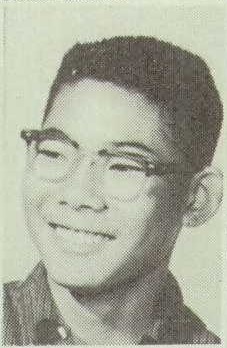
|
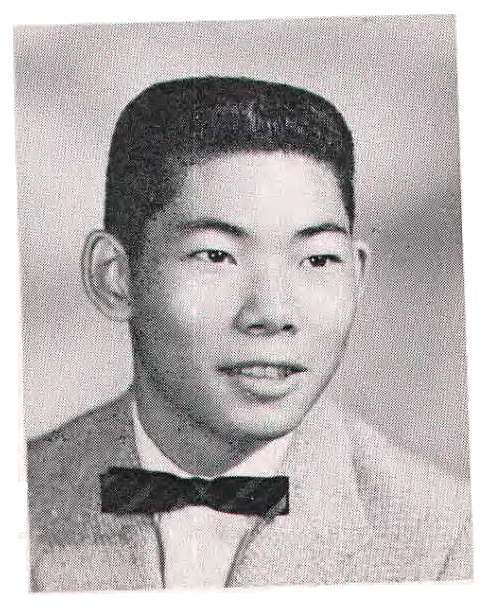
|
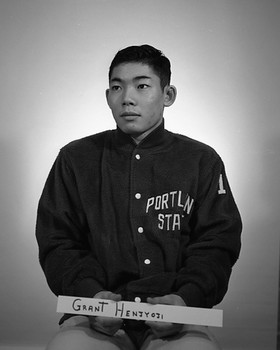
|
|
Top left
1st Lt. Grant Henjyoji, U.S. Army |

|

|
Grant Hiroaki Henjyoji (1943-1969)
KIA at LZ Grant
Edward Henjyoji's kid brother, U.S. Army 1st Lieutenant Grant Hikoaki Henjyoji, while serving at LZ Grant, aka FSB Grant, with Delta Company, 2nd Battalion, 12th U.S. Cavalry, 1st Cavalry Division, was killed in action from small arms fire in Lai Chau, South Vietnam, on 8 March 1969. The landing zone, or forward support base, was named after the commanding officer who had set it up.
The perimter around LZ Grant was established on 22 February 1969. Some miliary records describe the main assualts on the base between 7 and 11 March 1969 as the "Defense of LZ Grant". The main attack came early in the morning of 8 March, during which Grant Henjyoji was killed. Several Oregon papers carried AP reports of the deaths of Oregon soldiers including Henjyoji.
Find a Grave profile (viewed June 2018)
1st Lt Henjyoji #05716432
MOS:1542 Infantry Unit Commander
Grant was serving with the US Army Reserves while living in Portland,before going into
active duty.
He arrived in Vietnam 16 October 1968 and was assigned to D Company, 2nd Battalion, 11th Calvary, 1st Calvary Division, USARV. Grant died from hostile gunshot wounds during a hostile attack at FSB Grant, 11 kilometers east northeast of Nui Ba Den Mountain.
Survived by his parents, Rev & Mrs Datyu Y Henjyoji of 2622 S East 12th Ave, Portland, OR.
Faces from the Wall, Oregon and the Vietnam War
Newspaper reports
The 14 March 1969 edition of Eugene Register-Guard, for example, reported as follows (Oregon Genealogical Society).
Another Vietnam casualty reported Thursday was a 1967 graduate of the University of Oregon. Killed in action was 1st Lt. Grant Henjyoji, 25, the son of the Rev. and Mrs. Daiyu Henjyoji, of Portland. Young Henjyoji was born in a relocation camp for Japanese-Americans in Idaho during WWII. Henjyoji served with the Reserves Officers Training Corps while at the university.
The 29 January 1995 edition of The Baltimore Sun carred a long article by Tom Bowman, entitled "A Lasting Legacy", about the endeavors of some veterans of the Vietnam War, in both the United States and Vietnam, to locate the remains of Democratic Republic of Vietnam soldiers who were killed in the 8 March 1969 attack on LZ Grant and buried in a mass grave by American soldiers after the attack, which left many Americans and 95 North Vietnamese soldiers dead. The following account of the battle represents only about one-forth of the article. The entire article can be read here if the link is still active (viewed 2015).
A Lasting LegacyBy Tom Bowman January 29, 1995 [ . . . ] BY THE SPRING OF 1969, the war had entered a brutal phase: American troop numbers rose to a peak of 543,000. President Nixon, just entering office, expanded the fighting into Laos and Cambodia and the North Vietnamese mounted a counteroffensive. Corporal Kapucinski had a strange feeling the night of March 8, 1969. He was gearing up for guard duty at LZ Grant, an American military outpost near the somber silhouette of Black Virgin Mountain. Suddenly in the woods he saw a bizarre sight about 50 yards out: beams of light. An enemy famed for its stealth was heading toward him with -- flashlights! The thought was swept away by thunderous explosions. Torpedoes and mortars ripped through the concertina wire. A regiment of the First North Vietnamese Army surged forward. The soldier who lit the cigarette turned and ran, while the Louisiana man was stunned by a mortar round, his face grimy with dirt. Corporal Kapucinski fired at the darting enemy, illuminated by flares and mortars. One mortar round smashed into the command post just behind him, killing several officers. Corporal Kapucinski was stung in the hand by shrapnel but kept shooting his M-79. Just before dawn U.S. jets roared overhead and dropped napalm. The first load landed squarely on the enemy. The second on the Americans. If was difficult for Corporal Kapucinski to tell if the running figures bathed in flames were his comrades or the North Vietnamese. The sun rose through the haze and smoke. Dead and dying littered LZ Grant. The wounded stumbled about, numb with shock. A U.S. soldier emerged from the woods, smiling at his luck in surviving the battle at a lookout post in the trees. But the man was mistaken for the enemy; his own troops cut him down with machine-gun fire. Ponchos were draped over the 17 American dead. Corporal Kapucinski noticed a pair of black, horn-rimmed glasses in the dirt next to one covered corpse. He thought of the officer who once wore them. Soldiers began to load the enemy dead on a small trailer hitched to a Jeep. But they didn't bury them right away. They left them in a row outside the wire, as a warning to the enemy. Soon the members of 95 C Regiment of the First North Vietnamese Army were assembled in a shallow grave. Corporal Kapucinksi spent a year in Vietnam with the 1st Cavalry Division, returning home to Bay Village, Ohio, with a Bronze Star and a Purple Heart. That wasn't all. He carried a raging bitterness toward the U.S. government, convinced it had treated him and his friends as "cannon fodder." And deep inside was an overwhelming guilt for the lives he took. He quietly spoke of his troubles to a Catholic priest and later a counselor. Other than that, he was not one to tell war stories. Mr. Kapucinski got a job at the Bay Barber Shop, married, joined several veterans' organizations and settled in for life in his small Midwestern town, set by the shore of Lake Erie. Then early in 1994 he got a letter from the Vietnam Veterans of America, asking for help in something called the Veterans Initiative. He remembered something in one of his scrapbooks, a photo he had taken from a helicopter as it hovered several hundred feet above LZ Grant. [ . . . ] |
Killed in action at LZ Grant
The men who died at LZ Grant, in the action that killed Grant Henjyoji, were as follows (Virtual Wall).
2nd Bn, 12th Cavalry:
LTC Peter L. Gorvad, Oakland, CA, HQ Company (Bn CO)
CPT William R. Black, Newbern, TN, D Company
CPT John P. Emrath, Lexington, KY, HQ Company
1LT Grant H. Henjyoji, Portland, OR, D Company
1LT Peter L. Tripp, Greenwich, CT, HQ Company
SGT Walter B. Hoxworth, Struthers, OH, C Company
CPL Larry E. Evans, Van Wert, OH, D Company
CPL Vincent F. Guerrero, Sinajana, GU, E Company
SP4 John R. Hornsby, Paducah, KY, E Company
PFC Charles D. Snyder, St Clair Shores, MI, D Company
1st Bn, 30th Artillery:
SP4 Thomas J. Roach, Royal Oak, MI, A Battery (Bronze Star "V")
PFC Glenn R. Stair, Akron, OH, A Battery (Bronze Star "V")
PFC Roy D. Wimmer, Whitewood, VA, A Battery (Bronze Star "V")
1st Bn, 77th Artillery:
SP4 Gordon C. Murray, Greenacres City, FL, HQ Battery
Together We Served
The Together We Served website features the following overview of the life of 1st Lieutenant Grant Hiroaki Henjyoji.
Henjyoji, Grant Hiroaki, 1LTGrant Henjyogi [sic = Henjyoji] was born in Camp Minidoka, a Japanese-American relocation camp near Hunt, Idaho during WWII. His childhood name was Hiroaki Kimura. He was a wrestler in high school and college, even trying out for the Olympic Team. He served with the Reserves Officers Training Corps while at the University of Oregon, graduating in 1967. Initially, he served as an administrator in the Adjutant General's Corps. He was stationed at Fort Lewis prior to going to Vietnam. In Vietnam, he served with Delta Company, 2nd Battalion, 12th US Cavalry, 1st Cavalry Division at LZ Grant, about 15 miles northeast of Tay Ninh City. He was killed during a night battle when LZ Grant was mortared and attacked by NVA forces. He was interred in Arlington National Cemetery, Section 34, Grave 326A. |
Comrades
The Wall of Faces memorial for Grant Hiroaki Henjyoji, posted on the website of the Vietnam Veterans Memorial Fund, includes the following message from a fellow soldier who was there with him.
A Thank You,
Posted on 6/3/01
To a soldier who gave me his personnel weapon when I went into a tunnel for the first time, Thank You. To a soldier who seen that I was in need of help and he asked me to carry my Backpack when I was compass man and we had to walk all night to get to a place where another company was pinned down in a firefight and was taking in heavy casualties, Thank You. To a Soldier whom I remember, when I was on the ground wounded on that night of March 8, 1969 and was told at daylight that you were gone. You were on my mind and will never be forgotten. My prayers are with you friend and may you rest in peace.
Funeral services
The Wednesday, 26 March 1969 edition of The Daily Chronicle, a Centralia, Washington paper, carried the following brief on Grant Henjyoji's funeral service (page 8).
Henjyoji Rites SaidPORTLAND (AP) -- Chimes and gongs and burning incense accompanied the funeral of Grant H. Henjyoji in Portland Tuesday. Henjyoji was an Army lieutenant. He was also a Buddhist. His birthplace was a Japanese internment camp at Minidoka, Idaho. Conducting the service was his father, Bishop Daiyu Henjyoji. The bishop wore gold and purple robes and an ancestral headdress. At his right was a Samurai sword, symbolizing courage and bravery. At his left were white Chrysanthemums, for beauty and spirit. The aisles of the Buddhist temple were lined with stone lanterns and rhododendron trees lined the walls. But the casket was with an American flag draped. And the color guard was from Ft. Lewis, Wash. U. Henjyoji will be buried Friday, with full military honors, in Arlington National Cemetery in Virginia. |
Racialization
The Kimuras/Henjyojis were victims of the sort of racialism and racism that, contrary to the opinion of some people, are still very much part of the fabric of federal, state, and municipal laws and policies in the United States. Everyone was, and continues to be, a victim the entrenched belief, now stronger than ever, that "race boxes" play a useful and even essential role in American life. Even in death, Grant Henjyoji was unable to escape the tentacles of the Army's racial labels.
US military race boxesMy service in the US Army ended the year before Grant Henjyoji's service began. When enlisting in 1963 I was a "CAU" for "Caucasian". When discharged in 1966 I was "NA" for "Non applicable". The standalone box called "7. RACE" on my DA FORM 20 "Enlisted Qualification Record" says "CAU". Contemporary Army regulations required that one "Enter the first three letters of one of the following: Caucasian, Negroid, Mongolian, Indian (American), or Malayan. Example: Caucasian will be entered as Cau." My DA FORM 214 "Report of Transfer or Discharge" -- which honorably released me, in 1966, from my 3-year enlistment in the United States Army in 1963 -- has a race box called "7a. RACE". On the form, the "RACE" appears as an unreadable black bar and "NA" is typed in the box. "b. SEX" says "MALE" and c, d, e, and f are COLOR HAIR, COLOR EYES, HEIGHT, and WEIGHT. Race, in other words, had been the highest order of physical trait on this form. I didn't think much about races boxes then. Today, when confronted with a race box, I either ignore it, cross it out, or write NOYB -- "none of your business" -- or optionally NOYFB. There is nothing more insideous in this world than a race box. Races boxes have proliferated in the United States, which is one of the most race-in-your-face states in the world. See the Race section of my Yosha Bunko site, especially Race boxes on US military records, for a look at the politics of "race" in America. |
U.S. Army Personnel and Dependent Casualties
|
Ronald J. Glasser (Camp Zama Hospital, 1968-1969)
Dramatizations of misinformation about Kishine
Many popular accounts of hospitals in Japan during the Vietnam war -- most, I would say -- are full of small errors that seem to have evaded "fact checking", as though no one bothered to confirm spellings and dates and at times even more substantial details. The following account comes from Ronald Glasser's 365 Days (1971), which has been periodically published and remains in print.
|
Zama, where I was assigned in September 1968, was a 700-bed hospital with a small pediatric unit of five beds and a nursery. It was the only general Army hospital in Japan. There were internists, anesthesiologists, ophthalmologists, obstetricians, gynecologists, oral surgeons, dermatologists, plastic surgeons, ENT specialists, thoracic surgeons, vascular surgeons, and even an allergist. We have four Army hospitals scattered about the plains -- Drake, Ojiie [sic = Oji], Kishine, and Zama. It's hard to know what they've told you about Tet, but over here, the operating rooms never stopped. The internists and obstetricians did minor surgery, and the surgeons lived in the OR. But even when there are no offensives we're busy. We don't just get the Herberts -- we get them all: the burns, the head wounds, the cords, the tumors. Medicine is always busy, too. The medical wards are full of patients with hepatitis, malaria, pneumonia, and kidney failure. It is something of an achievement that we're able to do so much. In 1966 there was only one 90-bed Army dispensary in Japan; in fact, there was little else in the rest of Asia. When President Johnson chose to listen to his military advisers and send in ground troops, the Army had the choice of expanding the existing medical facilities here in Japan, building up those in the Philippines, or starting from scratch in Okinawa. Okinawa was too expensive -- something about cost plus and American-type labor unions. The Philippines looked a bit too unstable, and so, despite Okinawa being four hours closer to Nam, and the Philippines having more available land, the Army chose Japan. [ . . . ] Everything was put here into the Kanto Plains and clustered around the Air Force bases at Tachikawa and Yokota. The Air Force brings our patients in over the mountains in their C-141's. They stay at Yokota overnight at the 20th casualty staging area, where they're stabilized. A lot of them have already been operated on -- some massively -- and it's a long trip here. So they rest a while; they are checked again, and, if necessary, rehydrated. Nam's hot, 110 degrees in the shade, and these kids were carrying sixty and seventy pounds of equipment and ammunition when they got hit. Some of them, too, have been humping it like that for days if not weeks. They're dehydrated, every one of them. The fluids they get at the 20th give them a bit of an edge. If they're very critical, though, very seriously ill, and can't wait, they're med evac'ed by chopper as soon as they get off the C-141's to one of our four hospitals. |
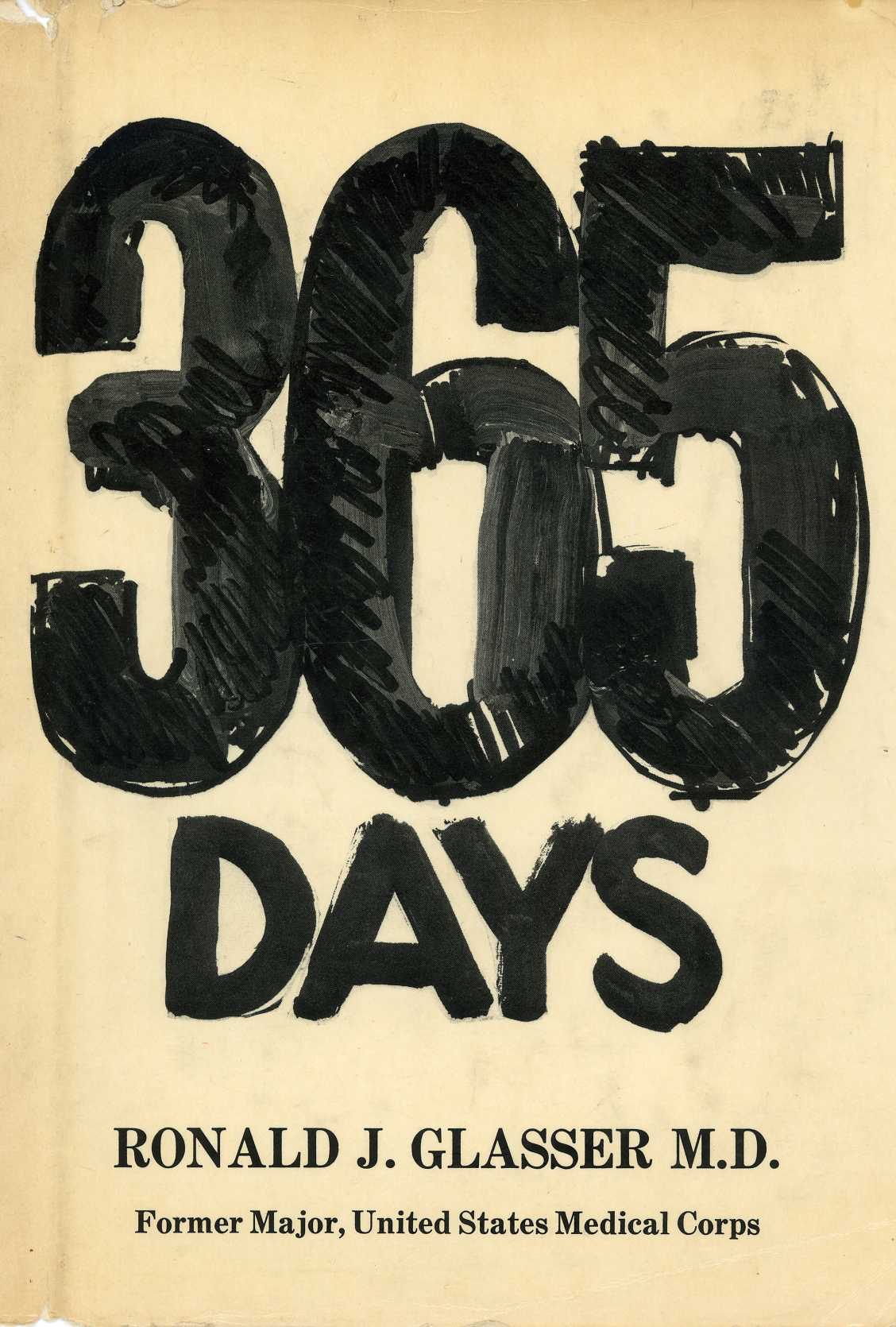 1971 George Braziller (New York)
1971 George Braziller (New York)Hardcover edition |
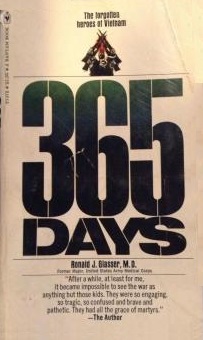 1972 Bantam Books
1972 Bantam BooksPaperback edition |
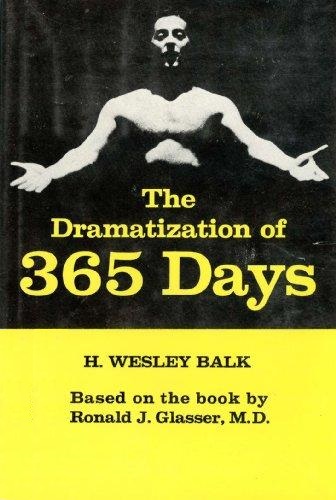 1972 Dramatization by Balk
1972 Dramatization by BalkUniversity of Minnesota Press |
 1973 Corgi Childrens (London)
1973 Corgi Childrens (London)Paperback edition |
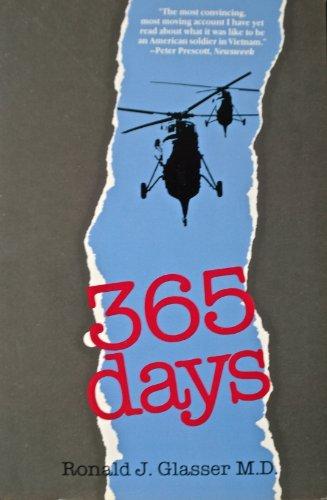 1980 George Braziller (New York)
1980 George Braziller (New York)Hardcover edition |
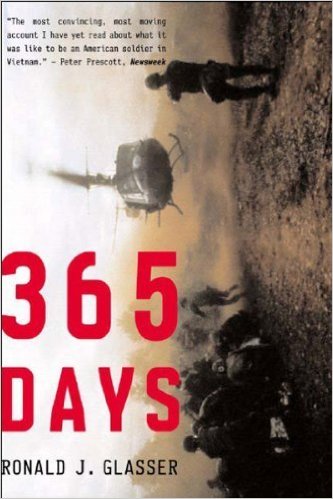 1980 George Braziller (New York)
1980 George Braziller (New York)Paper cover edition |
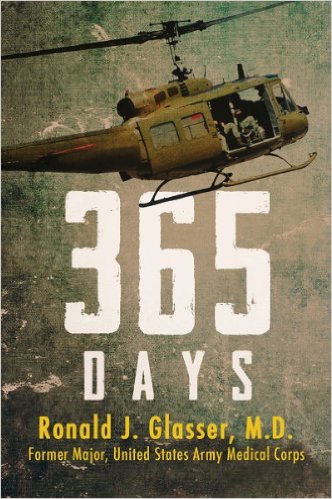 2014 George Braziller (New York)
2014 George Braziller (New York)Paper cover edition |
 2014 Open Road Media
2014 Open Road MediaEbook edition |
Wahlberg's interview with Glasser
On 15 January 2013, Adam Wahlberg, founder of Think Piece Publishing, posted The Think Piece Interview: Dr. Ron Glasser, who over forty years earlier had published 365 Days. The book, which became a minor bestseller in the early 1970s while the Vietnam War was still going on, has been reprinted a number of times by various publishers and remains in print. Glasser became the most prolific medical writer to come out of the Vietnam era.
365 Days includes a story inspired by Edward Y. Henjyoji, a physician in the Burn Unit at the 106th General Hospital. In Wahlberg's interview, Glasser reveals that Dr. Henjyoji happened to be a classmate of his at The Johns Hopkins University.
Year books confirm that the two men were not just medical school classmates. The list of students graduating with Bachehor of Arts degrees from The Johns Hopkins University in June 1961, at the end of the university's 85th year, includes Ronald Joel Glasser of Chicago, Illinois, and Edward Yoshimasa Henjyoji of Portland, Oregon.
Wahlberg's interview of Glasser includes the following parts, relevant to the 106th General Hospital and Dr. Henjyoji, which I have extracted from the much longer interview, which focuses on Glasser's view of PTSD and Vietnam veterans -- a highly controversial issue regarding which Glasser strongly advocates on the pro-PTSD side. "Predictably" I would would add, given the tone of 365 Days, which he wrote while stationed during the late 1960s while working as a pediatrician at the U.S. Army Hospital at Camp Zama while Henjyoji was at Kishine.
The Think Piece Interview: Dr. Ron Glasser15 Jan 2013 Written by Adam Wahlberg In 1971, Minneapolis physician Ron Glasser shook the literary world and the foreign policy establishment with his groundbreaking work, 365 Days, which documented his time as a physician during the Vietnam war. He interviewed soldiers as he treated them, wrote down their stories, saw them as they struggled with mental health challenges such as PTSD, and forever changed the way we view war. We sat down with him in Minneapolis recently to talk about the writing of his masterwork, the impact of war on the mental condition of soldiers, and why The Naked and the Dead is overrated. TP: How long did you serve overseas? RG: Two years, at Camp Zama, Japan. TP: Did you write the manuscript when you got back to Minnesota? RG: No, I wrote it while I was over there. It took me three months. TP: How did you find the time? RG: There was nothing else to do. Listen, let me just tell you, this artistic nonsense about being a writer where you have to be set, things have to be quiet, people have to leave you alone, it's a bunch of shit. I mean, it's just so stupid. You just have to write an hour a day. Then you think about it all day. That's it. [ . . . ] TP: And your solution was to do multiple narratives? RG: Yes. We just divided it into the major units. We needed helicopters. In the burn ward, there was so much of that. I met people in the military I hadn't seen since kindergarten. We all got drafted at the same time. We went through grammar school, high school, medical school, internship, residency; I had met people since I had honest to god not seen since kindergarten. They were in the military or they were physicians or they were at Zama, and Ed Henjyoji was someone I had gone to medical school with. He was in the burn ward in Koshini [sic = Kishine], which was 20 miles from Zama, and I had got a call from Richard Frankel, who I had gone to grammar school with. He had gone to the University of Illinois, I had gone to Hopkins, and we had talked and he had known about Ed Henjyoji. He was a pathologist at the mortuary, and he called me in and asked, Did Ed have any relatives in Vietnam? I said, Yeah, he has a brother, Grant, who's in the Marines, and he says, He's dead. And I called Ed and said Grant's been killed and he's at the mortuary . . . [pauses, tears up] . . . well, it creeps up on you . . . Ed made the mistake of taking the body home, so when I came back, I went to Koshini [sic = Kishine] and I said, Look, Ed, what was it like to take the body home? And I sat there and just wrote it down. TP: Was yours the first war book written by a physician? RG: It was. And it was the first book that was published that became a best seller while the war was on. It was published in 1971. The first one. I mean The Red Badge of Courage was 1895. Stephen Crane wasn't even in the Civil War. [ . . . ] -- This interview has been edited and condensed for publication. |
"The Burn Ward"
365 Days was reviewed in The New York Times by Michael G. Michaelson on 26 September 1971 (Book Review section, page BR40). Ed Henjyoji is the model for "Edwards" in the final story -- "I Don't Want to Go Home Alone" (pages 256-288).
The 17 June 1971 issue of The Harvard Crimson, Harvard University's student newspaper -- possibly before the release of the book -- published a version of its final story under the title "The Burn Ward" and the byline "Former Major". The Crimson version is practically the same as the version in book.
The Crimson ran "The Burn Unit" for reasons its student editors disclose in the italicized preface to the story. They were clearly opposed to the then still-raging but gradually slowing war.
I have taken the liberty to cite several parts of "The Burn Ward" including especially the parts related to Kishine Barracks -- which Glasser accurately names -- and the 106th General Hospital -- which Glasser either intentionally fictionalizes, or unwittingly misidentifies, as the "109th General Hospital". His descriptions of the hospital are rather odd.
The Burn WardBy Former Major, June 17, 1971We publish this article not as any sort of analysis, but simply as the most impressive reminder we could find of the slaughter this country continues -- and the price she is paying -- as Harvard parties through Commencement Week. As a reminder of the price the Vietnamese are paying for our trespasses, we include Dieter Ludwig's photographs for Distpatch [sic = Dispatch] News Service. You cried at Love Story? Wait 'til you read this Dispatch News Service, founded in 1968 by a few very young journalists who were covering mainly the Vietnam War. DNS, and one of its reporters, received the Pulitzer Prize for International Reporting in 1969 for breaking the story of the massacre at My Lai. In 1970, one of its founders, Michael D. Morrow, then 24, who had come to Vietnam in 1967, was fluent in Vietnamese and had married a Vietnam-born woman, was expelled by Vietnam for allegedly being involved in its internal affairs (The Courier-Journal, Louisville, Kentucky, Sunday, 22 November 1970, page 14). "Love Story" -- the 1970 movie starring Ali MacGraw and Ryan O'Neal -- featured a romance between a Harvard student from an upper-class family and a Radcliffe College student from a low-class family. Edwards picked up the stethoscope from his desk. "Look," he said, "You can say what you want about the Army and its problems, but I learned this much from going home: the Army treats you better dead than alive. I know," he added quickly to keep the captain from talking. "I know, it was my fault. I shouldn't have got involved with taking the body back. But I did." "It's coming," the corpsman said, stepping away from the window. Edwards stuffed the stethoscope into his back pocket. "OK. Tell the ward master. Better fill the whirlpools. I'll be down at the landing pad." He pushed open the double doors to the burn unit. The huge overhead lights were off, leaving only the night lights to flicker feebly across the shiny, tiled floor. He walked quietly down the center aisle of the ward, his footsteps echoing lightly ahead of him. The beds lining the wall were barely visible, the patients no more than lumps against the frames. From the far end of the ward came the faint mechanical hissing of a respirator. He stopped a moment near one of the steel-arched Stryker frames to listen. The machines slow regular rhythm was almost soothing. How many times he'd heard it before. Someone had once said he'd signed more death certificates than any other doctor in Japan. Probably right, he thought, continuing on his way. At Kishine, the respirator was the sound of death, not life; in all his time there, he could not think of one patient who had got off the thing. [ . . . ] As he walked away, Edwards could hear Crowley drawing the curtains closed behind him. The stairwell was empty and he walked slowly down to the first floor and out onto the concrete walkway. It was summer outside and the night was as warm as indoors. He cut across the empty silent field separating the hospital's squat buildings from the helipad. where the red lights of the landing strip flickered softly in the misty dark. Far away he heard the muffled dull thudding of the chopper whopping its way through the heavy air, and suddenly he felt alone and desperately tired. [ . . . Flashback . . . ] Grimly, with the chopper coming nearer-louder-Edwards walked up a slight rise, past a small, dimly lit sign: KISHINE BARRACKS I can't think of good reason for fictionalizing "106th" as "109th" -- especially in view of the fact that "Kishine Barracks" is clearly specified. It makes more sense to think that Glasser just made a mistake. [ . . . Flashback . . . ] By the time he reached the evac area, the floodlights were on and the chopper had landed. Coming in from the dark around the back of the evac guiding [sic = building] Edwards was dazzled by the sudden lights. The Huey, low and glistening, its rotors still whirling, sat like a toy exactly in the middle of the arc lights. Its crew chief and co-pilot were already in the open hatchway unstrapping the litters from their carrying hooks. Edwards watched unseen while the corpsmen hurried out to the chopper to off-load the patients. The choppers usually came in about 10 in the morning, but when a bad burn was evac'd [sic = evac'ed] to Japan, they were born in the same night. Burns are a very special kind of wound, and no physician anywhere wants the responsibility of caring for them, not even for a little while. For openers, burns look bad and the patients die. I have no recollection of an "evacuation building" at the 106th General Hospital when I was there from December 1965 through September 1966. Patients were brought directly to the wards where they would need to be to receive treatment specific to their condition. None of the wards were very far from the heliport. The conditions of the patients -- the reasons they were being evacuated to the hospital -- were generally anticipated before their arrival. Even in the lab we usually knew when a load of burn patients were coming in, so we would expect stat orders for electrolytes and blood gas, among other tests more specific to the treatment of severe burns. There were not a lot of surprises. [ . . . Flashback . . . ] [ . . . ] Edwards watched the corpsman wheel the boy out of the evac area, and then left the area himself to go to the neurosurgey ward. It was a long walk. Like all army hospitals, Kishine is fantastically spread out, its buildings and wards acres apart so that no one shell or bomb can get it all. By the time he got to the ward, the neurosurgeon was already in the treatment room. The patient, partially hidden by the nurse and doctor, was lying naked on the treatment table. There were blood-soaked clothes and bandages all over the floor. Cramer turned his head for a moment, looked at Edwards and went back to work. Glasser's imagination is running amok here. Kishine Barracks was known as an unusually compact facility -- unlike older bases like Camp Zama, where he was posted. One large bomb on the Pathology Laboratory, where I worked, between Buildings B and C, in front of the Mess Hall, would have crippled the 106th General Hospital. Surgery, CIU, and CMS were originally set up in Building C. A few months later, in order to accommodate more beds, long single-story buidings were erected northeast of the Mess Hall for surgery, CIU, and CMS. This required the construction of covered walkways between the 4-story buildings, where the wards were located, to faciliate the gurneying of patients between the wards and the building housing the operating and recovery rooms. Even in Vietnam, field hospitals were set up to more-or-less minimize the distance between wards and specialized facilities. [ . . . ] |
Glasser's other publications
Glasser went on to author a number of other books about medical practices and conditions in military and civilian hospitals and also a couple of medical novels.
Broken Bodies, Shattered Minds (2011)
The Iraq War inspired him to return to questions he had often raised about the changing nature of the wounds that battlefield survivors and their families have to live with. Broken Bodies, Shattered Minds was published in 2011.
The following text is a cut and paste of the publicity that appears on both the publisher's and the author's websites.
Ronald J. Glasser, M.D. Told in the narrative, and from personal experience, author traces changing nature of warfare from jungles of Vietnam to streets and mountains of Iraq and Afghanistan and the physical and psychological damage of wounds to troops in U.S. Army and Marine Corps. And what it has come to realize. The efficiency of evacuation units has led to quick treatment of IED-caused wounds resulting in life-saving amputation,most since American Civil War. Amputation on women soldiers and their difficulty using prosthetics designed for male soldiers is examined and, large scale concussive cerebral damage, a new phenomenon in military medical treatment requiring lifetime care of the wounded, is examined and the escalating, hidden costs of lifetime care put into perspective. New, previously unpublished studies on the concussive effects on the brain are presented. Something also relative to NFL interest. Using narrative vignettes,the rising medical and sociological costs of the Afghan War are clearly defined and the escalating hidden costs of long term medical care are put into projection. Lt. General Harold Moore wrote the Foreword. |
Broken Bodies, Shattered Minds makes problematic references to Max Cleland. Glasser claims he saw Cleland at Camp Zama and otherwise associates him with Camp Zama. Cleland has always stated, in his books and interviews, that he was medevaced through the 106th General Hospital. See Glasser 2011 above for excerpts and other details.
Glasser's novels
There is no novel in Nam, there is not enough for a plot, nor is there really any character development. If you survive 365 days without getting killed or wounded you simply go home and take up again where you left off.
Glasser wrote in his foreword to 365 Days (1971, page xii). If he intended these statements as self-evident truths, then 365 Days is pure irony. For the stories Glasser tells between the covers of 365 Days are all about plot and character development. Even his own character developed to the point that, though not killed or wounded, he was unable to simply go home and take up where he had left off.
Even while still in the Army, Glasser began to turn his wartime experiences in Japan into what became, for him, a second profession, as a writer of attention grabbing semi-novelistic non-fiction, as well as semi-non-fictional novels.
As I write this in 2016 (and review it in 2018), three of what appear to be his favorite works are available through Open Road Media, Amazon, AbeBooks, and other distributors in 2014 Kindle and POD editions -- 365 Days (1971), and two novels, Ward 402 (1973) and Another War, Another Peace (1985).
Ward 402 (1973)
Glasser's first novel, Ward 402 (1973), came out on the heels of 365 Days (1971) and rode its wave to minor popularity that included a Book of the Month Club edition. The novel is a semi-autobiographical story about an intern who has to make life-death decisions on a pediatric ward.
 1973 George Braziller (New York)
1973 George Braziller (New York)Hardcover edition |
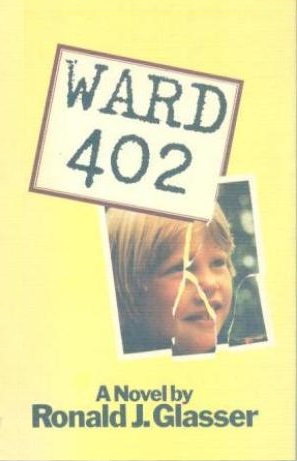 1974 Garnstone Press (London)
1974 Garnstone Press (London)Hardcover edition |
 1974 Pocket Books
1974 Pocket BooksPaperback edition |
 2014 Open Road Media
2014 Open Road MediaEbook and POD edition |
Glasser's website describes Ward 402 as follows.
|
New York Times Best Seller List WARD 402: Published in 1973 by George Braziller, Inc., it is it [sic] is the story of an intern on the children's ward of a great hospital who is confronted by the angry parents of a dying child as extraordinary means are used to keep her alive. The experience teaches him much more about the human body and spirit than any anatomy class. The book raises many questions pertinent to issues confronting us today, including euthanasia and the need for health car [sic = care] reform. WARD 402 is preeminently a book for our time, a story that touches the lives of all of us today, and that only a dedicated physician is equipped to tell. WARD 402 was optioned for a made for television movie. |
Another War, Another Peace (1985)
Glasser's second novel, Another War, Another Peace (1985), came out a decade after the war ended in 1975, as memoirs, novels, and memoirs about the war were coming into vogue. The story is about two soldiers who bond as friends while assigned to MEDCAP (Medical Civic Assistance Program) duties.
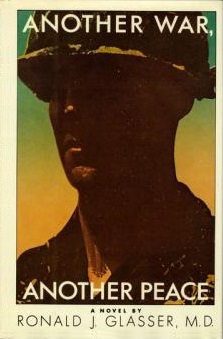 1985 Summit Books (Simon &
1985 Summit Books (Simon &Schuster) Hardcover edition |
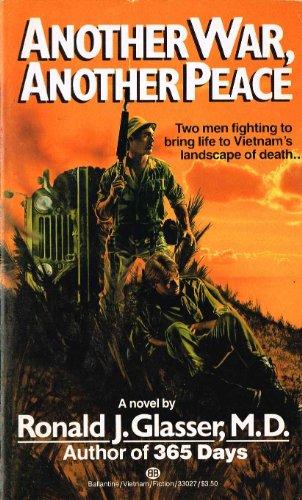 1986 Ballantine Books
1986 Ballantine BooksPaperback edition |
 2014 Open Road Media
2014 Open Road MediaEbook and POD edition |
Glasser's website describes Another War, Another Peace as follows.
Another War, Another Peace: Hardcover published in 1984 by Simon & Schuster, Inc., and paperback published in 1986 by Ballentine Books, by arrangement with Simon & Schuster, Inc., this [sic] is the poignant story of one man's passage from ignorance to cynicism in the Vietnam War. Sharply focused and painfully truthful, the novel is a chapter of the Vietnam War that illuminates the entire saga. A novel of the Vietnam war.
Colonel Alexander M. Boysen, M.D., U.S. Army Medical CorpsCommander, 106th General Hospital, Kishine Barracks, 1968-1970Alexander Marius Boysen (1923-2002) was the second of the 106th General Hospital's two commanding officers during its deployment at Kishine Barracks. He succeeded the first commander, Colonel Charles Reed, in 1968, and remained in command until the 106th was closed in 1970. Boysen was born on 25 December 1923 in Pelican Rapids, Minnesota. He was living in Oconee, Georgia, when he passed away on 25 March 2002. He and his wife, Margaret LeVan Boysen (1926-1995), were interred in Arlington National Cemetery on 2 August 2002. His Veteran Service Dates show he served from 9 September 1944 to 1 October 1973. The couple had already married an started their family by December 1948, when Margaret received a BS degree in nursing from the College of Medical Sciences of University of Minnesota. The Monday, 20 December 1948 edition of The Morning Herald, a Hagerstown, Maryland paper, carried a brief on its society page that reported her graduation and noted that she was the daughter of Dr. and Mrs. Gerald W. LeVan of Boonsboro, which is also in Maryland, and that the LeVans had been guests of their son-in-law and daughter while in Minneapolis to attend the graduation ceremony (page 7). Boysen's unique story"Boysen had his own unique story, having been captured during the Korean War, spending 3 years as a POW in North Korea," Harold Rubin related to me in email (March 2016). "I always seek books about Korean War POWs and have found several references about him." Rubin served under Boysen as the Chief of the Pharmacy Service at the 106th General Hospital. Both men arrived at the 106th in 1968 and witnessed its closing in 1970. Boysen became the commander of the U.S. Army Hospital at Camp Zama and all other U.S. Army medical units in Japan, while Rubin, a captain in the Medical Service Corp, became the Chief of the Pharmacy Service at USAH Camp Zama The following obituary was published in the Tuesday, 2 April 2002 edition the Athens Banner-Herald, and was posted the same day on the paper's Online Athens website.
Boysen's daughter's storyBoysen's return from to the United States from captivity was reported in the Friday, 18 September 1953 edition of The Daily Mail, a Hagerstown, Maryland paper, as follows (page 3).
A decade after Boysen died in 2002, his daughter, Cathy Madison (b1949), born a year before he went to Yokohama in 1950, wrote the following memoir of what it was like to grow up with her father after his return.
Korean WarAlexander Boysen's adventures in Korea frame the Korean War. The war -- originally a "conflict", and never a "total war", as the belligerents generally confined their military actions to the peninsula -- began on 25 June 1950 when the Democractic People's Republic of Korea (DPRK) invaded the Republic of Korea (ROK). It ended when the two Korean states and their allies signed an armistice on 27 July 1953 at Panmunjom (板門店). By 30 June 1950, the United States, at first reluctant to join what would otherwise have been a civil war, had decided to commmit U.S. ground forces to the defense of ROK (South Korea). The first units were grouped under what was called "Task Force Smith", named after Lieutenant Colonel Charles B. Smith (1916-2004), the commander the groups main unit, the 1st Battalion of the 21st Regiment of the 24th Division of the 8th U.S. Army. On 1 July, Boysen was flown with the 1st Battalion to Pusan (釜山) from Itazuke Air Base (板付基地) in Japan, DPRK (North Korea) forces were pushing south toward the city, which practically defines the southern tip of the peninsula. Itazuke Air Base is now Fukuoka Airport (福岡空港). The port of Fukuoka has historically been main port serving shipping and ferry service between Japan and the Korean (Chosen) peninsula, and much of the ferry service plys between Fukuoka and Pusan, which are sister cities. General Douglas MacArthur (1880-1964), the Supreme Commander for the Allied Powers in Occupied Japan, also oversaw all U.S. military forces in the theater. These forces included the 8th U.S. Army, which had come to Japan with MacArthur from the Philippines in August and September 1945. After the 1st year of the Occupation, many U.S. military units began to be withdrawn, but 8th U.S. Army was left in Japan to serve as the main U.S. military force for the duration of the Occupation. Many of its original units were demobilized or redeployed elsewhere in preparation for ending the Occupation, and by 1948, when General Walton Walker (1889-1950) assumed command, it had been reduced to the 24th Infantry Division. Only the 1st Battalion of the 21st Regiment of the 24th Infantry could be airlifted to Pusan for immediate deployment in Korea in on 1 July 1950. The rest of the units, which had to be ferried by boat arrived 3 days later. This was the unit Boysen was attached to in June 1950 when reporting for duty in Japan. Boysen's experiences in POW campsBoysen and other medical officers who became POWs in the Korean War shared their experiences in the following journal article. Clarence L. Anderson, Alexander M. Boysen, Sidney Esensten, Gene N. Lam, William R. Shadish, (MC), U.S. Army Anderson was actually an MSC officer, according to the following account in Col. Richard V. N. [Van Ness] Ginn, History of the U.S. Army Medical Service Corps, Office of Medical History, U.S. Army Medical Department (Office off the Surgeon General and Center of Military History, United States Army, Washington, D.C., 2008).
Lech on ordeals of Korean War POWsBoysen and other captees released in September 1953 were evacuated to Japan, where they were treated and debriefed at the Tokyo Army Hospital, aka as the 8167th U.S. Army Hospital Tokyo, in Sumida ward. Some sources refer to "Interrogation of Returned Prisoner of War Alexander M. Boysen, folder, B2, box 1, Entry 183, Operation Big Switch Interrogation Reports, Record Group (RG) 153, Records of the Office of the Judge Advocate General of the Army, National Archives at College Park, Md. (NACP)".
In Broken Soldiers (University of Illinois Press, 2000), Raymond B. Lech (b1941) writes that surrender during the Korean War was not uncommon, especially during the first nine months. "7,130 Americans laid down their arms rather than their lives" he ways, of whom some three thousand died in POW camps and "the remaining four thousand who returned home from Chinese camps along the Manchurian border bore emotional scars that would never heal" (Introdution, pages 1-2). The insinuation that the "emotional scars" of none of the Korean War POW returnees would heal has overtones of the sweeping statements some people have made about all Vietnam veterans suffering PTSD for life. For certain it is not possible for a sentient being not to be influenced by war and POW-camp experiences. But the "scars" of such experiences generally represent healing. To the extent that memories persist and the scars of experience don't vanish, survivors may be "scarred" for life. However, "bearing scars" does not mean that wounds are not healed. For some the wounds may fester and never fully close. But most survivors seem to go on with life. And some even turn their ordeals into a livelihood. Lech -- the author of All the Drowned Sailors (New York: Military Heritage Press, 1982, and many later editions), about "The cover-up of America's greatest wartime disaster at sea, the sinking of the Indianapolis with the loss of 880 lives because of the incompetence of admirals, officers, and gentlemen" -- examines the lives in captivity of numerous POWs who survived to tell their stories, some in court martials
Adams on medical units in Task Force SmithThe Office of Medical History, in the U.S. Army Medical Department, conducted interviews with a number of survivors of Task Force Smith. The following remarks are cited from notes which Samuel Milner, an historian in the Korea War project, took during an interview with then Lieutenant Colonel Raymond E. "Bodie" Adams, a Medical Service Corps officer in Task Force Smith, on 16 June and 22 July 1965.
Latham's overview of Korean War POW survivorsPart of Boysen's story is embedded in "Ordeal of the Survivors" by William C. Latham Jr. in the Spring 2010 issue of Military History (PB 20-10-2 (No. 75) Washington, D.C.). Largely because of these miscalculations [by U.S. military officials regarding the readiness of U.S. forces in Japan and the ability of North Korean forces], early battles between Americans and North Koreans produced a disturbing series of calamities. Beginning with the destruction of a small U.S. task force (Task Force Smith) south of Seoul on 5 July, advancing North Korean forces, led by their hulking [Soviet] T34 tanks, brushed aside a series of U.S. defensive positions along the highway leading southeast from Seoul toward the port of Pusan. In their first three weeks of fighting, tthe Americans withdrew more than one hundred miles while losing several thousand killed, wounded, or missing in action. Many of the missing became prisoners of war, including a division commander, Maj. Gen. William F. Dean, who became separated from a small group of U.S. soldiers and survived behind enemy lines for five weeks before his capture. Garrett on where the buck stopsThe blame for the failure of Task Force Smith to accomplish its mission has been swatted back and forth across the net of accountability that divides the headquarters and units. Major John Garrett, in his study, Task Force Smith, the Lesson Never Learned, questions the conventional view that the task force failed because it was unprepared for combat. Garrett's conducted his study while training at the School of Advanced Military Studies, United States Army Command and General Staff College, Fort Leavenworth, Kansas, Second Term AY 1999/2000, 19 September 2000.
|
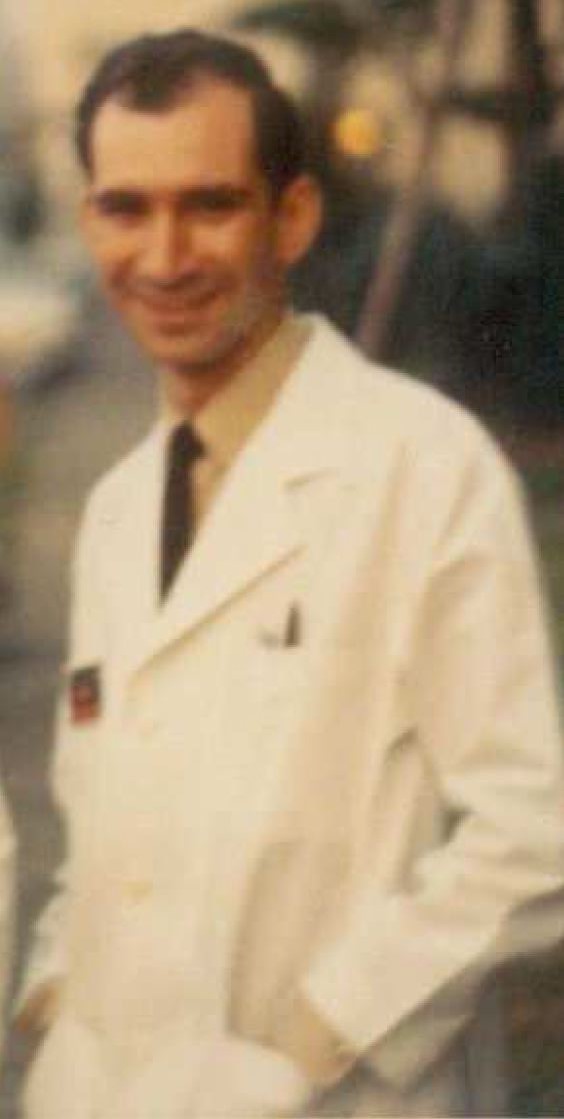 Dr. Jeff Malka, 1968-1970
Dr. Jeff Malka, 1968-1970(Cropped from Malka, "War Surgeon" 4-page undated pdf file, page 4) [ Personal communication ] |
 Major Jeff Malka, 1968-1970
Major Jeff Malka, 1968-1970(Cropped from Malka, "War Surgeon" 4-page undated pdf file, page 4) [ Personal communication ] |
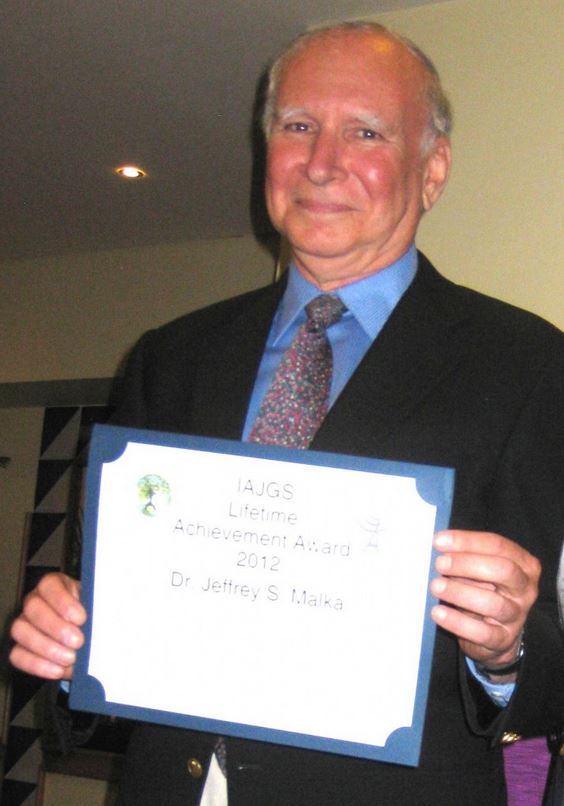 Jeff Malka receiving 2012 IAJGS award
Jeff Malka receiving 2012 IAJGS awardfor his pioneering Sephardic genealogical studies (Copped from International Association of Jewish Genealogical Societies) |
Jeff Malka (1968-1970)
"just one of the thousands of faces"
In May 2016, I received communication from a familiar name -- Jeff Malka -- through the "Contact" page of my Yosha Bunko websites (email, 17 May 2016, [bracketed] remarks mine).
I think you had already left Japan before I got there. I was at the 106th from late 1968 to 1970 and overlapped for 3 months with Ray Bagg. I'm an orthopod [surgeon] too and we got along great with each other. (Not so much with the guy who replaced him). Boysen was the hospital CO during my time there. Too much of a regular army guy for me. None of the 2 year docs liked him and he was later drummed out of the army. When the Vietnam war started slowing down I spent a few months at Camp Zama. I also spent a few weeks at the 249th [249th General Hospital at North Camp Drake in Asaka city in Saitama prefecture] to allow someone there to go on leave.
Jeff said he had written "some stuff" for his grandchildren and attached a 4-page unpaginated pdf file of a very polished, readable, and moving story called "War Surgeon" -- with some photographs and a few footnotes -- clearly a chapter in an autobiography.
Jeff's wife, too, spent 2 years in Japan and he said they intended to visit Japan that fall, for the first time since being stationed there. Unfortunately, we did not meet at that time.
"You may be interested to know that I was not a US citizen when I was drafted," Jeff also wrote, as though he had noted my interest in nationality. "As such I could have refused to go but elected to accept because I definitely wanted to become a US citizen - which I later became in Hawaii." (Email, 17 May 2016).
Jeffrey S. Malka began his life in Switzerland. The passenger manifest dated 23 April 1957, for a Trans World Airlines flight originating from Zurich and bound for various destinations including New York, lists a "Malka S." Malka filed petition for naturaliztion in the U.S. District Court in Hawaii on 16 June 1969. (Ancestry.com)
Jeffry S. Malka, M.D., retired
On his own professional website, Orthohelp.com, Jeff declares that he is now retired, but he continues to post a brief biographical profile (last viewed June 2018).
| Medical Degree | - University of Geneva, Switzerland |
| Residency | - Mt. Sinai Hospital, New York City |
| Board Certification | - American Board Of Orthopaedic Surgery |
| Other | - Fellow of the American College of Surgeons, Fellow American Academy of Orthopaedic Surgeons |
| Interests | - joint replacements, sports injuries and arthroscopic surgery |
| Faculty Appointment | - Clinical Associate Professor, Georgetown University |
| Chairman Department of Orthopaedic Surgery, Fairfax Hospital | |
The text of an "Office Brochure" includes the following reference to Jeff's work at the 106th General Hospital (last viewed June 2018).
|
ABOUT DR MALKA Dr Malka is an Orthopaedic Surgeon. That means he is trained in the treatment, surgery and reconstruction of injuries and illnesses of bones, joints, muscles and the spine. He graduated in 1963 first in his class in medical school at the University of Geneva, Switzerland. Dr Malka trained in Orthopaedics at The Mount Sinai Hospital, in New York City. He did 2 additional years of Orthopaedic training (in addition to full residency) in the care of fractures and joint surgery. During the Vietnam War he was Assistant Chief of Orthopaedics at the 106 General Hospital, US Army, in Japan, where the more severely wounded were evacuated from Vietnam for their care. Over the years he has developed a special interest and expertise in:
• Arthroscopic Surgery, incl Laser Dr Malka is Board Certified by the American Board of Orthopaedic Surgery (1973), a Fellow of the American Academy of Orthopaedic Surgeons (1976), and a Fellow of the American College of Surgeons (1975) as well as an Associate Professor of Orthopaedics at Georgetown University Medical Center. |
War Surgeon
"one of the thousands of faces"
Jeffry Malka, writing "some stuff" for his grand kids. so they will know a bit more about his chapter of the family history than they would find through the yellow pages, summarized his 2-years at the 106th in a 4-page chapter called simply "War Surgeon". The final paragraphs relate how Dr. Jeff Malka became the "Dr. Jeff Malke" in Tom Clancy's Into the Storm with General Fred Franks, Jr. -- who was a major when wounded in Vietnam and brought to Camp Zama for treatment (pdf file, received from Malka on 17 May 2016, [bracketed] remarks mine).
|
I spent most of my time in the operating rooms [at the 106th General Hospital from 1968-1970, and at Camp Zama in 1970]. It was not fancy surgery. By their very nature, war wounds are dirty and contaminated and need repeated visits to the OR for cleaning and removal of dead tissues. Life-saving amputations done in Vietnam needed revising and redebriding. Sometimes, on removing bandages in the operating room the wound would be filled with maggots from flies that had laid their eggs in the wound. Maggots are said to be good for wounds because they only eat dead tissues and therefore help clean the wound. I did not care. Masses of white maggots crawling in a wound was one thing I could not stand. Fortunately they washed away easily. The faces and images [of my patients] blurred. Hundreds of young and some not so young faces. Officers were in a separate ward, B1 [at the 106th], not otherwise different from the others. In Tom Clancy's book "Into the Storm" he writes about General Freddie Franks, Jr. when he was a major in Vietnam. [Note 9] Towards the end of the war, Franks was injured. He asked several of his surgeons in Vietnam whether he might lose his leg and was repeatedly told he was not. At his last hospital in Nam he again asked his doctor in Lon Binh: "Am I going to lose my foot?" Six months later, at Valley Forge army hospital, after a discussion with the chief of orthopedics, he asked to have the leg removed below the knee. We only met briefly yet he remembered me. I did not. He was just one of the thousands of faces that came and went. 9 Clancy, Tom. Into the Storm: A Study in Command. Putnam, 1997. General Frederick Franks, Jr. commanded the armor and infantry (VII Corps), the main coalition force that broke the back of Iraq's Republican Guard during the Gulf war. He retired as a four-star general. 10 By then the war was winding down and I had been transferred to [the U.S. Army Hospital at Camp] Zama. 11 Clancy, Into the Storm, p.63-64. |
General Frederick M. Franks, Jr.
Clancy's book with General Franks has been published in the following and other editions.
Tom Clancy with General Fred [Frederick M.] Franks, Jr. (Ret)
Into the Storm: A Study in Command [On the Ground in Iraq]
New York: G. P. Putnam's Sons, 1997, hardcover, 551 pages
New York: Putnam, 1997, Book Club edition, hardcover, 551 pages
New York: Penguin Putman, 1998, xii, 562 pages
London: Sidgwick and Jackson Ltd, 2000, paperback, 531 [557] pages
London: PAN, 2001, paperback, 576 pages
New York: Penguin Putnam [Berkley Books], 2004, paperback, updated edition, 720 pages
New York: Berkley Trade, 2007, paperback, xi, 750 pages
3. CAMBODIA [ Page 63 ] Thirty minutes after Franks was lifted out of Snoul, he was at the aid station at Quan Loi, near the 11th ACR base camp. The aid station was a triage area. They decided which of the wounded they could fix up there and which had to be medevaced back to Long Binh. Franks was clearly evacuation material. When the doctor at Quan Loi looked him over, Franks asked him, "Am I going to lose my foot?" "Nah,"he said. "You'll be OK. Don'nt worry about it." They always underestimate combat wounds.... A medevac took him to the 93rd Evacuation Hospital at Long Binh. When he arrived, they rushed him into surgery. And during the next two days, he was in surgery again, more than once. How many operations he had then, he doesn'nt know. He was pretty much out of it during that time. He asked a doctor at Long Binh: "Doc, am I going to lose my foot?" "Nah," he said. Six months and you'll be up and around doing duty." On 7 May, they flew him to Camp Zama Hospital in Japan. He was there for a week. [ . . . ] [ Page 64 ] He asked a doctor at Zama, Dr. Jeff Malke, "Doc, am I going to lose my foot?" "You don't want to hear this," Malke answered, "but six months from now, you're going to decide you'd be better off without that foot. But you're probably going to have to go through a battle to decide that yourself. You're not going to get around well on that leg. Major, that is just not a good-looking leg and foot." Dr. Malke was a wise man, but Fred Franks did not want to hear such wisdom just then. He said to himself, The hell with that. He doesn't know what he's talking about. I'm going to beat this thing. I haven't met a hurdle yet I can't get over. It was not, in truth, a good-looking leg and foot. The entire ankle was shattered, dislocated. The bones of the ankle and foot were splintered or crushed, and part of the lower leg had serious damage. The war was over for Franks. Little did he realize that his, and the Army's, biggest battles lay ahead.
FRED Franks tells what happened next. [ . . . ] 4. VALLEY FORGE [ . . . ] [ Page 66 ] VALLEY FORGE GENERAL HOSPITAL Valley Forge General Hospital, just outside Phoenixville, Pennsylvania, is forty-five minutes by medevac helicopter from the hospital at Fort Dix, New Jersey. I had spent the night there after a long, C-141 medevac trip from Camp Zama hospital in Japan. It was the Army's policy to place long-term-care soldiers as close to home as possible, and Phoenixville was about an hour's drive for Denise each way, mostly on two-lane roads. On 18 May 1970, the helicopter landed on the asphalt Maltese Cross landing pad at Valley Forge. Though it was great to be back in the U.S.A., I was beginning to grow concerned about my leg. Since Td been wounded on 5 May, I had undergone surgery in a string of hospitals. Each time, the doctors had been less and less optimistic. [ . . . ] [ Page 70 ] VALLEY FORGE GENERAL HOSPITAL JANUARY 1971 "Doctor, I've made the choice. I want you to amputate my leg." The surgery took place later in January, the morning after the Super Bowl. I watched the game from my bed in Ward 3B the night before. The morning of the surgery, just for the hell of it, with my cane, I struggled on the leg I was about to have amputated down the hall to the common latrine to shave. Then I came back and they wheeled me to surgery. I would not look back. [ . . . ] |
"every other step I take"
General Frederick Franks was the commander of VII Corps in Iraq. In a PBS Frontline oral history interview dated NLT 2014, Franks described VII Corps like this.
|
Q: What sort of forces did you have, I mean I don't know if there's a Second World War analogy or something, but what is a corps, what did you have in Corps? Franks: We had in 7 Corps, we had 146,000 American and British soldiers, we had 5 divisions, essentially 5 armoured divisions, although one was a mechanised infantry division and one was a cavalry division, essentially 5 armoured divisions. We had close to 1600 tanks, American and British, a sizeable force, a lot of moving parts, we consumed well over 2 million gallons of fuel a day, we had a support command, vital logistics support command of over 26,000 soldiers, we had 15 hospitals, we had over 800 helicopters, a sizeable force, a lot of moving parts. |
A later edition of Into the Storm was updated with some Iraq stories. In the PBS interview, Franks remarked about how memories of Vietnam affected his mission in Iraq (Ibid).
|
Q: Was there ever a day you didn't think about Vietnam when you were out there? Franks: No .. constantly in my mind. Memories of Vietnam are very sharp, clear to me, I mean with every other step I take I'm reminded of Vietnam and I remember the great soldiers that I was privileged to serve with there, those that I was in the hospital with at Valley Forge General Hospital, I remember those whose names are on the Vietnam memorial here in Washington .. no, never .. never far from my mind and especially during the Gulf War, we didn't say it to each other but I think we all felt that we're going to do it right this time. |
 Jeffrey S. Malka, Sephardic genealogy
Jeffrey S. Malka, Sephardic genealogy2003 printing of 2002 1st edition |
 Jeffrey S. Malka, Sephardic genealogy
Jeffrey S. Malka, Sephardic genealogy2009 2nd edition |
Sephardic genealogy
In addition to his career as an orthopedic surgeon, Jeffry S. Malka has distinuished himself as a pioneer in the field of Sephardic genealogy. He writes the history of his own family name, Some Malkas in History, on his own Sephardicgen website.
In the narrowest sense, "Sephardic Jews" refers to Jews who trace their descent to Jews who had settled on the Iberian Peninsula. Today, however, the term is commonly used to mean most Jews who are not Ashkenazic Jews, which broadly refers to Jews who settled and lived in Christian Europe (as opposed to Iberia). Malka's research and writing, and his reference book, are significant to Jewish genealogy because, unlike Ashkenazic family names, most of which were created in the 19th century, some Sephardic names go back the the 12th century.
Malka's award-winning Sephardic study
Jeffrey S. Malka
Sephardic Genealogy
(Discovering Your Sephardic Ancestors and Their World)
[Second Edition]
New Haven (CT): Avotaynu, July 2009 (2nd edition), 2002 (1st edition)
472, xxii pages, hardcover
Malka's book was awarded "Best Reference Book of the Year" for 2002 by the Association of Jewish Libraries. And in 2012, the Israel Genealogy Research Association honored Malka with that year's Lifetime Achievement Award.
The book is described and reviewed at Avotaynu, which publishes the journal Avotaynu, The International Review of Jewish Genealogy. Malka's profile reads in part like this (last viewed June 2018).
Descended from a long line of Sephardic rabbis, Dr. Malka's grandfather was chief rabbi of Sudan from 1906 to 1949. In researching his own family roots, Dr. Malka has accumulated unique expertise in the resources available to Sephardic genealogists. In Sephardic Genealogy: Discovering Your Sephardic Ancestry and Their World, he guides the reader through the history of the Sephardim, describes the origins and meanings of common Sephardic family names, and lists genealogical resources available in the many countries that Sephardic Jews inhabited.
Malka traces his own name to Malaga, an Aramean word for King (cited from Some Sephardic Names, Origins and meanings).
| Name | Variants | Origin | Meaning | Notes |
| Malka | ben Melekh, Soberano, Ibn Rey, Reino, Malki, Abimelekh | Aramean | King in Aramean, From Malaga |
Malka gives all people interested in their own family names good adivce -- "Please do not write to ask about the meaning of your own name. . . . Be a detective. That is what makes genealogy fun!" (Ibid. and Amen!)
Malka's elaboration on the The Malka Family genealogy as of 1282 C.E. is a fascinating model of how to approach and understand the linguistic and political dynamics of family history.
Susan Geland Malka
Malka's wife, Susan Geland Malka, has been a practicing nurse, teacher, and scholar. Her 2007 book on the impact of "feminism" on nursing in the United States remains in print. The following description of the book is cited from University of Illinois Press publicity.
Susan Gelfand Malka The role of feminism in transforming nursing and women's professional identityDaring to Care examines the impact of second-wave feminism on the nursing field since the 1960s. In arguing that feminism helped to end nursing's subordination to medicine and provided nurses with greater autonomy and professional status, Susan Gelfand Malka discusses two distinct eras in nursing history. The first extended from the mid-1960s to the mid-1980s, when feminism seemed to belittle the occupation in its analysis of gender subordination but also fueled nursing leaders' drive for greater authority and independence. The second era began in the mid-1980s, when feminism grounded in the ethics of care appealed to a much broader group of caregivers and was incorporated into nursing education. While nurses accepted aspects of feminism, they did not necessarily identify as feminists; nonetheless, they used, passed on, and developed feminist ideas, which is evident in nursing school curricula changes and the increase in self-directed and specialized roles available to twenty-first-century expert caregivers. "Former pediatric nurse Malka writes from the point of view of both a nurse and a historian, providing a rich perspective on the timely issues addressed in the book. Highly recommended." -- Choice "A valuable addition to all levels of nursing and women's studies curricula. It makes the important connection between the evolution of nursing, and feminist thinking and activism." -- Women's Review of Books "Daring to Care provides a fresh, valuable perspective on the history of women, feminism, nursing, medicine, and the professions; it should be required reading for anyone interested in the history of American nursing." -- The Journal of American History "Malka's excellent scholarship fills a critical gap in recent history on the nursing profession, and will be useful to those interested in the history of feminism as well as women's, nursing, and medical history." -- Susan M. Reverby, professor of women's studies, Wellesley College, and author of Ordered to Care: The Dilemma of American Nursing Susan Gelfand Malka is a former nurse and nursing instructor who teaches American and women's history at the University of Maryland. |
Harold Rubin (1968-1970)
"I had to . . . buy a telephone pole"
Harold, according to his own account, was stationed at the 106th General Hospital from October 1968 until the hospital closed in 1970. The Officers section of the 1969 report on the 106h (above) states that he was a captain in the Medical Service Corps (MSC) and the Chief of the Pharmaceutical Services.
MSC officers are mainly utilized in their primary professional speciality. But they may also be required to serve on courts and boards, and pull scheduled duties like Administrative Officer of the Day (AOD) or Staff Duty Officer (SDO), among other duties. And Harold pulled his share of other duties in addition to his principle duty as a pharmacy officer.
AOD
On designated days, Harold was the AOD or Administrative Officer of the Day. This meant that he was in charge of hospital operations from 5pm to 8am -- in effect a night watch. I recall referring to any officer on call at night as the "DO" or Duty Officer. At the 106th, this included, in addition to an MSC acting as AOD, at least one doctor (MC). As I recall, the AOD was assisted by an NCO who I recall referring to as the "duty sergeant".
I have two recollections of duty officers. One was when my immediate MSC (medical service corps) supervisor, Lieutenant James Terry, was the DO one weekend and had to deal with an ambulance that ended upside down in the motor pool. I snapped a photo of the scene of the accident with Lieut. Terry looking on (see below).
The second DO I recall, whose name I have forgotten, was an MC (medical corps = MD) officer. I was the lab tech on call, and a request came for a stat cross match, which I would have to perform but the DO would have to visually confirm and approve (see Blood banking below).
AOD, CBR Officer, and court martial duties
As Harold related to me in email, AOD duties at the 106th entailed "meeting all incoming helicopters with patients, handling any deaths that occurred on shift, and intervening in any conflicts that occurred on base."
CBR Officer
Harold was also the CBR Officer. As such he was responsible for chemical, biological, and radiological (CBR) decontamination at Kishine. team that to decontaminate the base. And he was the Administrative Assistant to the Chief of Professional Services, which described as "the highest ranking medical officer on base" and "usually a Colonel" -- meaning, when he was there, Alexander M. Boysen (see below).
Most intriguing to me was Harolds revelation that he also served as the Summary Court Martial Officer defense counsel. "[I] often had multiple soldiers to defend in a court martial setting," and parenthetically added "I have no legal training but that did not matter".
As a defendant in a summary court martial shortly before I began my lab tech training, I would add as a personal opinion that, at the summary court martial level, having legal training at the time probably didn't matter (today might be a different story). Having said this, though, I would like to have been a fly on the wall in the chambers of the 106th's disciplinary proceedings. I wonder what sort of offenses were involved. I felt like charging the mess hall chief with serving so much half-cooked liver.
Off-base housing
Harold, as a married officer, had a variety of housing, some "on the economy" meaning in an ordinary apartment in a Japanese neighborhood, to military housing -- in Harold's case (and the case of many Kishine personnel who were accompanied by dependants) homes in the U.S. Navy housing area in Honmoku in Negishi on the other (south) side of the port of Yokoahama . People had to wait for such housing, and the down side, as Harold wrote me, "I then had to drive thru the heart of the city to get too and from work."
Telephones
Harold related to me the following story about his experience with living in a Japanese community (email, received 25 March 2016).
The first year in Yokohama I had housing on the economy. It was a year's wait for officer housing (my wife accompanied me for a 3 year tour). My address was 17 Shinohara-cho, Kohoku-ku, Yokohama-shi. It was an apartment complex close to Kishine. I had to have a telephone to be on call for the hospital. This caused me to buy a telephone pole, and once this happened all the apartments were able to have telephone service (I became very popular). One year later I was able to get housing at the US Navy housing area at the other side of Yokohama.
Telephones in Japan then and nowHarold Ruben is not exaggerating. At the time in Japan, many localities lacked the sort of telephone infrastructure that people today take forgranted. Neighbors in less wired neighborhoods used pink phones at shops which the shopkeeper used as a home phone that permitted others to make local calls for 10 yen or pay the shopkeeper for calls outside the exchange. Even for those who lived in a wired neighborhood, subscribing to a landphone service was more than a matter of contacting the phone company and requesting that a phone be installed in return for a modest installation fee. NTT -- Nippon Telegraph and Telephone, a "public corporation" owned by the government, had an absolute monopoly on domestic telecommunications. If you wanted a phone, you litterally had to subsidize NTT by purchasing a bond that represented your share of the infrastructure that you would be using. My first landline, in 1971, cost me about 70,000 yen, which was nearly twice 1 or 2 month's pay for an average office worker. between 70,000, which was the equivalent of two months pay. Telephone bonds were negotiable. They were bought and sold by authorized brokers. When I left Japan a year later, not knowing when or even if I would return, I sold mine for considerably less than I had paid for it. When returning in 1975, I had to buy another. I bought my last such bond when moving in 1988. It was of the cheaper non-transferrable type. In the 1990s, NTT began to lose its grip on the market, and in 2000 I opted out of NTT for a packaged Internet-phone service with a TV cable company that had gained access to the phone market. Later I bought an old home in a neighborhood the cable company had not yet reached. The home was built in 1972 on land parcelled in 1969. The home is set back from the main road by about 30 meters, which requires a small pole between the main street and my home to distribute power and phone lines to my home. At my previous residence, when NTT's monopoly was broken, and cable companies were allowed to offer phone services, I dumped NTT for a coaxial Internet and phone line. At the time I moved to my present home, the cable coimpany had not yet run cables into the neighborhood, but took advantage of my move to expand its service into my new neighborhood. that was in the year 2000, when few homes had cable TV, much less home computers or Internet hook-ups using phone modems. |
Despite the nationalistic boasting about how "unchanged" Japan really is beneath the gloss of modernity -- believe me, its more than just gloss -- some things in the country have, in fact, remained the same. The 10-yen per 3-minute public phone call rate for numbers within the local exchange remains the same today, half a century after the days of the 106th at Kishine. The metered rate, however, is much higher, so 10-yen won't allow for many words.
Other costs have also increased. At the time the 106th General Hospital was operating, a domestic letter was 15 yen (82 yen), a domestic postcard was 7 yen (52 yen), and a weekly magazine was 70-80 yen (350-550 yen). Basic fares for trains and subways were 20-30 yen (140-180 yen, streetcars 15-20 yen (no more trollies). A 633ml bottle of beer was 140 yen (350 yen), a bowel of noodles was 100 yen (300 yen).
| Consumer prices in Japan then and now | ||
| Service, commodity | 1965-1971 (¥) | 2010-2015 (¥) |
| Exchange rate (¥ / $) | 360 | 80-120 |
| Monthly salaries and part-time labor rates | ||
|
Office clerk (per month) Student labor (per hour) |
20,000-40,000 230 |
150,000-250,000 800-1,100 |
| Telephone and postal rates | ||
|
Soba (noodles) Ramen (noodles) Coffee (coffee shop) Beer (bottle, can) Magazine (weekly) Public bath (adult) Haircut (male) |
60-70 180 70-100 120 (633 ml btl) 60-80 28-40 350-650 |
350-500 200 (350 ml can) 400-500 450-460 1,000-3,500 |
| Telephone and postal rates | ||
|
Public phone (local call) Postcard (domestic) Postcard (North America) Letter (domestic) Letter (North America) |
10 (3 min) 7-10 15-20 |
10 (1 min) 52 70 (air) 60 (sea) 82 110 (air) 90 (sea) |
| Public transportation (basic fares) | ||
|
Bus Streetcar Train Subway Taxi (2 kilometers) |
20-40 15-20 20-30 20-30 100-130 |
110-150 [ Trolleys gone ] 110-130 170-180 710-730 |
A dream come true
Ed Todd captured the highlights of Rubin's career in Hospital CEO has followed his dreams, a long article in the Monday, 16 September 2002 edition of the Midland Reporter-Telegram. In it, Todd quotes Rubin to have said that his father had only an 8th-grade education, and that for him, going to college seemed "a better option" than becoming "the third generation of window washers" -- referring to his family's immigrant roots and experiences.
In the mid 1960s, after earning a B.S. in pharmacy at the University of Oklahoma, Rubin was a staff pharmacist at John Sealy Hospital in Galveston, Texas. While there, in 1967, he volunteered to be a "guinea pig" for students enrolled in a phsyical thereapy course at the University of Texas Medical Branch. The students drew their victims by lot, and the woman who drew him became his wife.
Rubin was drafted in 1968, received a direct commission as a pharmaceutical officer, was sent to the 106th General Hospital in Japan, and returned to civilian life in 1971. After receiving a Doctorate of Pharmacy from the College of Pharmacy of the University of Michigan in 1973, he worked at hospitals in Niagara Falls, New York, and in Salt Lake City, Utah. In 1985, he and family settled in Midland, thus returning to Texas, and by 1991 he had become the president and chief executive officer of Midland Memorial Hospital. Rubin and his wife retired to Washington in 2002.
Rubin had dreamt of becoming a pharmacist. His grandmother had diabetes, and the cost of the drugs to keep her going was "always an issue" he reportedly told Todd.
"It's a calling," Todd cited Rubin to have said of medical work. "It's not just a job for people in the medical field, not just myself, but nurses and doctors. People that work in the hospital have care and concern about people that come into the hospital. They want to alleviate suffering."
Richard Sisk (1968)"a cruel lie I told . . . everyone . . . even myself"On 7 March 1968, 2nd Lieutenant Richard Sisk, was leading his platoon as point of Fox Company of the 2nd Battalion of 4th Regiment of the 3rd Marine Division moving west (upstream) along the Cua Viet river about 10 kilometers south of the DMZ. By that afternoon he was on a Med Evac helicopter to the rear, and 3 days later he found himself on Ward E-1 of the 106th General Hospital in Yokohama. The Navy hospital in Yokosuka was full, so Marine casualties were being sent to the 106th. Sisk went on to become a journalist. Over a career that continues as I write this in the spring of 2021, he has reported and edited in the United States and overseas for the New York Daily News and United Press International. After retiring from mainstream journalism, during which he covered all manner of news, he has filed stories from the Pentagon for Military.com. Over half of the 498 officers who graduated in the fall of 1967 in Sisk's class of June 1967 at the Marine Corps' "The Basic School" in Quantico, Virginia, became causalities. 43 were killed in Vietnam, the first a week before Christmas. One was later killed in Lebanon and 6 died in training accidents.
Yoshikawa succeeded Beheiren's first secretary general shortly after the group formed in 1965 and remained its administrative director until it disbanded in 1974. As such he organized a lot of the groups's events and was instrumental in doing some of its clandestine "diplomatic" leg work. After Beheiren disbanded, and until his death in 2015, Yoshikawa was the group's primary historican and curator of Beheiren lore. Beheiren and the "Intrepid Four"Beheiren's most successful operation was the facilitation of the desertion of four sailors from the USS Intrepid (CVS-11). The Intrepid was deployed with the Seventh Fleet at stations off Vietnam three times between 1966 and 1969. The second deployement to West Pac-Viet Nam was from 11 May to 30 December 1967. During this period, it made 6 port calls, 1 in Hongkong, 2 in Yokosuka, and 3 in Subic Bay. It's second Yokosuka port call was from 17 to 26 October 1967. The four Intrepid deserters did not "jump ship" but simply went AWOL and never returned while on shore leave. They hooked up with Beheiren activists, who put them in safe houses while Beheiren negotiated their escape from Japan on a Soviet freighter. Yoshikawa visits Soviet Embassy on behalf of "Intrepid Four"The following document, dated 10 December 1967, shows that Beheiren's Yoshikawa Yūichi visited the Soviet Embassy in Tokyo concerning the four Intrepid sailors who sought political asylum outside Japan. The coument is an English translation of a communication between the Chairman of the State Security Committee at the Embassy and his superiors in Moscow. The following text is a slighly reformated and edited cut and paste of a file in the "International HIstory Declassified" section of the Woodrow Wilson Center Digital Archive. The [bracketed remarks] are mine.
Other directionsDefectors, deserters, homecomers, and exilesWars produce mixed responses from their direct and indirect participants. The winners and losers would appear to be the victors and the vanquished, but sometimes it seems that the defeated gain the most. And what, if anything, has humanity gained by any war, except to be reminded by the next war how easily the lessons of the past have come to be squandered on the political ambitions of the present? All the dead and their families, whether friend or foe, are commonly regarded as victims. Survivors are more likely to mourn allied than enemy dead, but reunions between former enemies suggest that dehumanization of the enemy is a state of mind socially and politically created to enable the good people of one nation to kill the evil beasts of another. Heroes are memorialized in legends. Those regarded as collaborators, turncoats, and traitors are vilified. Some veterans will criticize anti-war protesters and enemy sympathizers as disloyal, and condemn draft resisters and deserters as cowards. Others recognize that some people are unwilling to participate in the madness of wars they consider immoral or unjust, or perhaps in any war on religious or other grounds, and prefer to go in different directions. The story of Kishine Barracks and the 106th General Hospital would not be complete without acknowledgment of those who, for whatever reason, chose to disobey orders because they didn't want to go to Vietnam, or return to Vietnam. Most of the following cases involve American U.S. military personnel, but one involves a Japanese who was drafted into the U.S. Army and ended up in Vietnam. And just for interest, I have included the cases of a couple of Korean soldiers who sought asylum in Japan because they didn't want to go to Vietnam, where during the war years Korea committed the Vietnam War deserters who passed through JapanDuring the Vietnam War, practically all U.S. military personnel in Vietnam took advantage of R&R (rest and recuperation) leaves, which permitted them to take brief vacations in nearby countries, from which they were obliged to returned to Vietnam to complete their usually 1-year tours of duty there. Tens of thousands came to Japan. Some soldiers on R&R in Japan felt so strongly against returning Vietnam that they went AWOL for a while. Some, like Terry Whitmore, deserted after wounds he'd received in Vietnam were treated at the 106th General Hospital at Kishine Barracks (see below). Some soldiers deserted after receiving orders for Vietnam, or even before they received such orders. One, like Charles Jenkins, deserted to North Korea from South Korea out of fear that he was about to be sent to Vietnam. Jenkins, on his way to Korea, had passed through Kishine Barracks before it had become a hospital (see below). Obstacles to desertionA soldier on leave in Japan who was ambivalent about returning to Vietnam might flirt with the idea of deserting, possibly after meeting someone who suggested he desert and offered help. The soldier might shack up for a few days somewhere, alone or possibly with someone, while contemplating what to do. I would guess that most such soldier's would decide to return to their unit and take the heat. But should a soldier decide to actually desert, all manner of problems arise. Desertion anywhere poses the problem of how to remain undetected, whether or not one defects or seeks asylum. The problems becomes greater in proportion to the deserter's conspicuousness, and whether the deserter has the economic, linguistic, and other means -- such as suitable authentic or bogus documents -- to survive and travel under one's own or a false identity. In Japan, people living in cities and towns with military bases are accustomed to seeing soldiers in uniform or civilian clothes. Even in civilian attire, most U.S. military personnel in Japan will physically stand out if they are not of East Asian racial descent. Once outside such localities, racially conspicuous people will probably get more attention. And in the 1960s -- half a century ago -- the likelihood of a conspicuous person attracting and holding stares was very high. And adults could be even more curious than children. Circumstances and thoughts, intentions and actionsWhat motivates military personnel not to report for duty as ordered? What sort of actions differentiate AWOLs from deserters, and deserters from defectors? And how is a homecomer or exile different from a deserter or defector? AWOLsAWOL -- absence without (official) leave -- involves failing to report or return to duty as ordered or expected. There may be extenuating circumstances. Accidents and natural causes will usually be accepted as valid excuses for showing up hours or days late. Missing a flight or train on account of being drunk or with a girlfriend, or deciding to stay an extra day or two to attend a friend's wedding, would probably not qualify as an excuse for tardiness. Failure to return from leave on account of a death in the family and inability to contact one's unit and notify it of the situation might be viewed with sympathy on moral grounds but still be held actionable as a violation of military code. The few cases of AWOL that occurred in units I was assigned to involved getting drunk and failing to get back by curfew or morning call. I recall one guy who didn't show up for a week, and he said he just wanted to be free for a while. Who knows what was going on in his mind. DesertorsMost soldiers who go AWOL voluntarily return to their units and take whatever punishment is meted out. Depending on the circumstances, and the period of unpermitted absence, an AWOL soldier may have to do a lot of talking to convince his commanding officer or a military court that his absence did not constitute a desertion or an attempt to desert. The line between AWOL and desertion is more about intent than length of absence. Resistance to apprehension while AWOL may be taken as evidence of intent to desert. Turning oneself in after running away to avoid arrest for a crime may be taken as evidence that one did not intend to desert. Some acts of AWOL involve "thoughts" and "flirtations" more than "decisive actions" of desertion or defection. Such thoughts are analogous to suicidal gestures in people who contemplate killing themselves but hesitate, as in the wrist-cutting syndrome. Dry runs perhaps. Or preparation for contingencies tantamount to stockpiling sleeping pills. DefectorsReasons for desertion run the gamut of human motivation, from simply wanting to be free, to fleeing arrest for a crime, wanting to avoid danger, objection to war, and side switching. Defectors are deserters who cross to the other side. Traitors are not necessarily defectors, and people who cross to the other side do not necessary commit acts of treachery. Here, too, intent is important, but even more important than intent is what one actually does after crossing a front line or border or otherwise fleeing into enemy arms. Deserters are never simply welcomed. They could be spies. The burden is on them to prove their intent to defect. A defector has to win the enemy's trust -- volunteer information, agree to be used for propaganda purposes, engage in espionage against the side from which one originally came. A defector may later claim to have been taken prisoner, and that might be true. Or one can claim that one was tortured or brainwashed, which may also be true. The line between "desertion" and "defection" is every bit as ambiguous as the line between "AWOL" and "desertion". It, too, is more about the intent behind one's actions, or the quality of one's actions, than about the actions themselves. Impulses to "desert" and "defect" can trigger acts that are immediately or soon regretted. Regret, though, can come too late to retrace one's steps -- in which case survival on the other side may require that one accept the consequences of one's misjudgement in a state of "free captivity" -- as I would describe the fate of Charles Jenkins (see below) when he walked across the DMZ in Korea. HomecomersOne well-known case of desertion in Japan by a U.S. Army infantryman on R&R in Japan involved a Japanese national who was born and raised in Japan, has his family there, and could probably have avoided detection had he wanted to. But instead he went public, and stirred considerable controversy between Japanese compatriots who sided with him and those who criticized him, and the Japanese and American governments faced the problem of how to deal with his case (see Shimizu Tetsuo below). Exiles"Desertion" is mainly used in reference to military personnel. "Defection" is also used for civilians who change loyalties. The term "exile" generally refers to a condition in which an individual or an entire government has fled to another locality or country in order to escape political danger or persecution. Terry Whitmore (see below) was an "exile" according to the title of the 1st edition of his account of refusal to return to Vietnam after recovering at the 106th General Hospital from battlefield wounds, and a "deserter" in another edition. The use of "exile" stresses his status in Sweden where he settled after deserting from Japan. The use of "deserter" stresses his status from an American point of view. As I am telling the story of Kishine Barracks from a viewpoint within Japan, Vietnam War "exiles" in Japan are aliens sought political asylum in Japan, in particular soldiers from the Republic of Korea (see Kim Tonghui and Kim Hyungsung below). Yokohama veterans on desertionAn interesting exchange concerning desertion in Japan, between people who been in the military in Yokohama, including two who has served at the 106th General Hospital, took place on pages 170-171 of the "Yokohama Navy Exchange was where?" forum on Japan Guide (see especially the searchable "Forum" feature). The following dialog is a slightly edited version of several posts made between 25-28 November 2012 by five contributors, at least two of which had served in the 106th General Hospital at Kishine Barracks. I am leaving their handles the same. Walkingfool, the writer, has a blog called The walking fool. It is not ironic, but expected, that Walkingfool -- who was not an American, and was not in Japan at time -- knew more about desertion by American soldiers during the Vietnam War than other on the forum. He had met someone who had been involved in Beheiren and then studied the subject. I myself never heard anything about desertion while I was at Kishine. I can't even remember ever discussing the topic with anyone. AWOL was common enough, and the 561st Ambulance Company at Fort Ord had an older buck sergeant who told stories of having been busted in the past for various reasons, including going AWOL. But desertion? Like, what was that? Living within a U.S. military facility in Japan like Kishine, it is easy to imagine never hearing about desertions and organizations like Beheiren. I first heard about Beheiren when I came to Japan as civilian in 1970, immediately after the radical student movements had peaked. The wounds inflicted by radical students on the campuses of several of Tokyo's major universities were still raw. Demonstrations on U.S. campuses, even at the University of California at Berkeley where I had studied and witnessed some of the unrest of the 1960s, paled in comparison to the sheer scale of confrontations and violence that occurred in Japan. And in the early 1970s, the Vietnam was was still going on, and anti-war demonstrations continued to draw large crowds.
Kishine and Sergeant Jenkins (1964)Former U.S. Army Sergeant Charles Robert Jenkins (1940-2017) admits he deserted in 1965 during his 2nd tour of duty in the Republic of Korea (ROK) -- "South Korea" or just "Korea" in English. Most likely he dwelled on the idea of deserting for several days or even weeks before the moment of decision. One night, inebriated with several beers, fearing that he was about to be sent to Vietnam, Jenkins crossed the DMZ (demilitarized zone) and surrendered to soldiers of the Democratic People's Republic of Chosen (DPRC), better known in English as the Democratic People's Republic of Korea (DPRK) or "North Korea". Whatever Jenkins hoped to accomplish, he found himself treated as a defector and used for DPRC propaganda. He underwent the usual privations that would-be deserters are subjected to -- they could well be spies -- with two men who had deserted at different times before him. Then he studied Chosenese and taught English. In 1980 Jenkins married one of his students, a Japanese woman who had been abducted in 1970 with her mother to teach Japanese to espionage agents. His wife was allowed to return to Japan in 2002 but he and their children were not permitted to join her until 2004. Upon arrival in Japan, by prearrangement he turned himself in to U.S. military authorities at Camp Zama, where he was confined, questioned, court martialed, dishonorably discharged, and released. Since then he has lived with his family in Japan, and in 2008 he obtained permission to permanently reside in the country. Jenkins served in Korea for a while after enlisting in 1958. He then served in Europe, and is said to have passed through Kishine Barracks on his way to Korea again in 1964.
Jenkins 2005Jenkin's first book on his life was published in Japanese in 2005 by Kadokawa Shoten, a major publishing house. The original hardover edition was brought out in a pocket-sized paper-cover "bunko" edition in 2006. The book is represented as a translation of "To Tell The Truth", which appears to be unpublished English manuscript. Kadokawa acquired translation rights through The English Agency in Tokyo, by arrangement with Charles Jenkins c/o Sterling Lord Literistic, a New York literary agent. The photographs, mostly in color, show many aspects of Jenkin's life in the Democratic People's Republic of Chosen or "North Korea". チャールズ'R'ジェンキンス Charles R. Jenkins Jenkins 2008A very different and much more interesting memoir was published in a hardcover edition in 2008 by the University of Calfornia Press. A paperback edition came out in 2009. Charles Robert Jenkins with Jim Frederick Jenkin's had 40 years to figure out what he wanted to say about his experiences. His stories have elements of a legend-in-the-making about them. In several interviews I saw with him on television in Japan after he was released from the U.S. Army, he came across as having a clear understanding of what had happened to him, while at times he showed some of the Rip Van Winkle time-warp symptoms that his wife and the other 4 abductees also exhibited. The reactions of the children, all born and raised in North Korea, were akin to those of tourists stepping off a plane into a new and different world for the first. Jenkins had at least passed through Japan in the past, and was able to perceive how much it had changed. Jenkin's collaborator Jim Frederick (d2014), who essentially shaped the book, was a senior editor at Time magazine before his death at age 42. Frederick's career included a stint as Time's Tokyo bureau chief from 2002 to 2006. It was during these years that the stories of North Korea's abuductions of serveral Japanese, and the story of Jenkins marriage to to one of the abductees, came to light. Toko Sekiguchi, who reported for Time from 2001 to 2007, wrote in "Rembering Jim Frederick" that "Jim won exclusive access to the most sought-after stories [sic] of the time in Japan -- an interview with U.S. Army sergeant Charles Jenkins, who spent half a century [sic] in North Korea before being released in 2004 to Japan, the home country of his wife who was snatched off the shores of Sado Island by North Korean kidnappers" (Number 1 Shimbun, 4 September 2014). In "Goodbye Jim Frederick: Writer, Editor, Mentor, Friend", Time's Bryan Walsh featured Frederick's work with Jenkins in the lead graph as follows (time.com, 2 August 2014). While TIME's Tokyo bureau chief in 2005, he co-wrote the autobiography of Charles Jenkins, an American soldier who wandered across the de-militarized zone during the Korean War [sic], and who was held captive for half a century [sic]. It was the story every reporter in Japan wanted to get -- filling in for him in Tokyo while he wrote the book, I used to field calls from Japanese TV networks desperate to interview him -- and Jim had it. He always did. Jenkins died on 11 December 2017 at the home of his wife Hiromi in Sado city on Sado island in Niigata prefecture. He was 77. |
|||||||||||||||||||||||||||||||||||||||||||||||||||||||||||||||||||||||||||||||||||||||||||||||||||||||||||||||||||||||||||||||||||||||||||||||||||||||||||||||||||||||||||||||||||||||||||||||||||||||||||||
Kim Tonghui and Kim Hyungsung (1965-1966)
To Koreans -- Kim Tonghui and Kim Kyungsung -- fled from the Republic of Korea (ROK) to Japan seeking political aslyum on account of their desire not to be sent to Vietnam, where ROK maintained sizeable combat forces as an ally of the United States.
Kim Tonghui
On 16 (or 6) August 1965, Kim Tonghui [Donghui, Dong Hee] (金東希), a Korean national serving in the ROK army, refusing to be sent to Vietnam, snuck himself onto Tsushima (対馬), a Japanese island between Korea and Fukuoka prefecture. He sought asylum, but was arrested on suspicion of violation of the Immigration Control Order, and was sentenced to 1 year in Fukuoka Prison. While in prison, he again applied for asylum.
On 19 February 1967, Kim was transferred from prison to the Omura Detention Center in Nagasaki. While at Omura, getting nowhere with his petition for asylum, Kim submitted a request to be sent to the Democratic People's Republic of Chosen, better known in English circles as "North Korea", rather than be deported to the Republic of Korea or "South Korea", where the ROK Army would treat him as a deserter.
Kim's predicament was taken up by the Fukuoka Prefecture Society to Protect the Rights of Chosenese in Japan. The society created a group to support Kim's cause, and Beheiren also held demonstrations and made appeals on Kim's behalf. This spread of support resulted in the Ministry of Justice permitting Kim's passage to the Soviet Union, and on 26 January 1968 he began his "return" to his "mother country Chosen" by way of Nakhodka.
.There were many Koreans and Chosenese in Fukuoka, partly because of its historical status as a port of entry and departure for vessels, including ferryboats, that ply the straits between Korea and Japan. "Chosenese" refers to people in Japan who were legally affiliated with Chosen as a territory of Japan from 1910-1945 and in Occupied Japan from 1945-1952. Chosenese at the time were Japanese, and many were living in the prefectural Interior of Japan when the Pacific War ended in 1945. Those who remained in Occupied Japan (1945-1952) lost Japan's nationality in 1952. Chosenese in Japan were divided between ROK and DPRC, the states had been established on the US/Soviet divided Chosen (Korea) peninsula in 1948. While at least 95 percent of all Chosenese in Japan were connected with the southern provinces of the peninsula, at least half supported the communist northern government in the Korean (Chosen) War (1950-1953). In 1959, with the help of the International Red Cross, and the cooperation of the Japanese Red Cross and the Japanese government, DPRC ("DPRK") began a "repatriation" program for pro-DPRC Chosenese in Japan who wished to leave Japan and resettle in DPRC. Japan recognzied ROK in 1965, but the repatriation program was still in operation when Kim came to Japan. However, Kim was not qualified to participate in this program, which ferried people directly from Japan to DPRC, hence the indirect route through the USSR.
Kim Hyungsung
An ROK soldier by the name of "Kim Hyung-Sung" -- apparently a technical officer in the ROK marines -- reportedly "refused to go to Vietnam and fled to Japan, but ended up in an immigration detention center, where he committed suicide by self-immolation after the decision was made to deport him back to South Korea." As of now I have no more information about Kim Hyungsung than this, which is based on the report by Kyung-yung Bay.
Kyung-yung Bay on ROK asylum seekers
Kyung-yung Bay, in "From Seoul to Saigon: Gook meets Charlie", names three deserters from ROK, two of them ROK nationals, the other an American who had been adopted from ROK (page 126, and note 47, page 130).
|
Among the hundreds of thousands sent to the battlefields of Vietnam, there were three South Korean "deserters who refused to fight against Vietnamese. They were ordinary young men who did not want "Gook to meet Charlie." Ultimately the decisions and actions of these soldiers smashed the tense relationship between the "state" ideology of law reinforcement and the civil right of disobedience based on human conscience. Their solitary bravery was worthy of praise. Yet the repercussions of their decisions and actions would have been scarcely welcomed in South Korea in the 1960s. [Note 47] Consolidation of democratization has become increasingly vital to the "public discourse" in South Korean society, as Koreans struggle to come to terms with their troubled history and promising future. Indeed, the evolution of democratic relations between the state and its citizens will transform Korea from a merely mature civil society into a truly advanced one. Kim Dong-Hee refused to go to Vietnam, deserting from the army in 1965. He tried to seek asylum in Japan, but was arrested on Tsushima Island. Kim Hyung-Sung was a technical officer with the Marines. He too refused to go to Vietnam and fled to Japan, but ended up in an immigration detention center, where he committed suicide by self-immolation after the decision was made to deport him back to South Korea. Kim Jin-Su was an American of Korean extraction, also known as Kenneth Charles Briggs, who was a Private First Class in the US Army. In 1967, he entered the Cuban embassy in Tokyo and applied for asylum. Sekiya Shigeru and Sakamoto Yoshie, eds, Tonari ni Dassohei ga ita Jidai: Jatekku, Aru Shimin Undo no Kiroku (The Era when Deserters Lived Next Door: The Record of One Civic Movement, Jatec) (Tokyo: Shiso no Kagakusha, 1998), pp. 39-64. Also see Oda Makoto, Suzuki Michihiro, and Tsurumi Shunsuke, Kokka to Guntai he no Hangyaku Dassohei no Shiso (A Traitor to the State and the Armed Forces: The Thoughts of Deserters) (Tokyo: Tahei Shuppansha, 1971), pp. 77-80. |
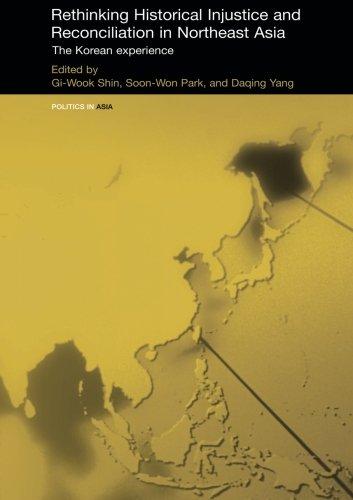 Kyung-yung Bay (2006)
Kyung-yung Bay (2006)From Seoul to Saigon: Gook meets Charlie The Korean experience in Vietnam |
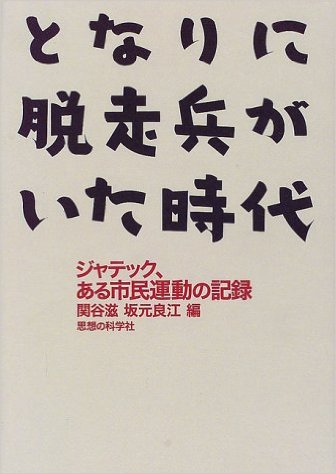 Sekiya and Sakamoto (1998)
Sekiya and Sakamoto (1998)An Era when deseters were next door A chronicle of JATEC, a citizens movement |
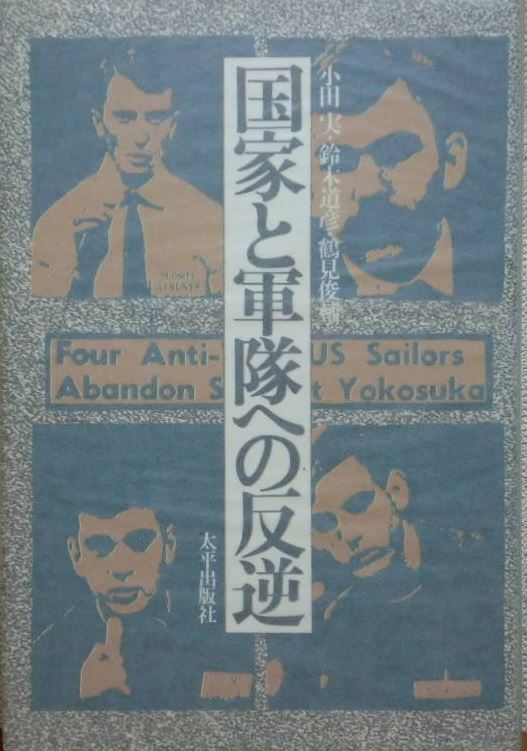 Oda, Suzuki, and Tsurumi (1969)
Oda, Suzuki, and Tsurumi (1969)The thinking of deserters Rebellion toward the state and military Image captured from Yahoo! Auction |
SourcesKyung-yung Bay, From Seoul to Saigon: Gook meets Charlie, Chapter 6, pages 114-130 関谷滋、坂元良江 (編集) Sekiya Shigeru and Sakamoto Yoshi (editors) JATEC -- Japan Technical Committee -- was a group set up by Beheiren (Oda, Tsurumi, et al.) to aid anti-war GIs and facilitate the departure of "conscientious deserters" from Japan. 小田実、鈴木道彦、鶴見俊輔 (編集) Sekiya Shigru and Sakamoto Yoshi (editors) |
||
Kishine and Terry Whitmore (1967)A journey from Memphis to Sweden via Nam and Japan Among the several U.S. military personnel who deserted in Japan rather than return or be sent to Vietname, no one has gotten more attention in Japanese media -- news reports, fiction, movies, historical accounts, and interviews later in life -- than Terry Whitmore (Terii Hoittomoa テリー'ホイットモア d2007).
Whitmore 1971By Terry Whitmore as told to Richard Weber Whitmore 1997Terry Whitmore as told to Richard Weber The shift in the subtitles from "Black American Exile" to "Black Deserter" is interesting. Was "exile" used in the original subtitle to stress a "political asylum" motive in order to avoid the stigma of "deserter"? When the book was first published, Whitmore was still a wanted man. By the time the reprint came out, he had benefited from a presidential amnesty and was free to acknowledge that, yes, he deserted -- and then, if asked why, to explain that he objected to the war on moral grounds. 1975 and 1997 Japanese editions of Whitmore's bookYoshikawa Yūichi (吉川勇一 1931-2015), a member of the Japan Communist Party until parting company with the party in the mid 1960s, was an English teacher, translator, and Beheiren's second administrative director. He was involved in Beheiren's Japan Technical Committee to Aid Anti War GIs (JATEC Han-sen dassō-hei enjo Nihon gijutsu iinkai 反戦脱走米兵援助日本技術委員会), which claims to have facilitated the desertions of some 16 soldiers. Yoshikawa also seems to have been involved in facilitating Whitmore's desertion to Sweden by way of the Soviet Union. His translation of Whitmore's book was first published in 1975 and republished in 1993. テリー'ホイットモア (著)、 ロバート'ウェーバー (編纂) Entire chapters are devoted to "Yokohama, Japan" and "Beheiren" -- the anti-war group in Japan that 16 or so American soldiers desert overseas from Japan (see Beheiren above). 1992 Kanagawa Television documentaryWhitmore's desertion from Kishine Barracks was taken up in a TV documentary called "The Era in which our fathers and mothers lived: A half-century of Kanagawa composed with images" (父と母の生きた時代'映像でつづる神奈川の半世紀), which was produced and aired by Kanagawa Television (TVK) on 5 April 1992. His story was told in a segment that dealt with the relationship between Kanagawa prefecture, U.S. military bases, and the Vietnam War. The network staff succeeded in finding and interviewing Whitmore in Stockholm, Sweden, where he had settled after going from Japan with the help of Beheiren handlers. He reported thanked the Japanese who had helped him and said he'd like to visit Yokohama again, and that apparently on account of this some concerned parties succeeded in inviting him to Japan. Excerpts from 1997 re-issue of Whitmore's bookHere are a few excerpts from the 1997 University Press of Mississippi re-issue of the 1971 Doubleday & Company's 1971 edition of Whitmore's story as told to Richard Weber. The re-issue includes an afterword by Jeff Loeb. The blue italicized text at the end is a slightly reformated version of a promotional blurb from University Press of Mississippi.
Yoshikawa's translation of Whitemore's "Kashini Barracks"Whitmore's single mention of Kishine Barracks as "Kashini Barracks", which he calls simply an "Army hospital", reflects what he probably thinks he heard, and probably himself pronounced, "KHA-she-knee" or even "KAY-she-knee". Yoshikawa Yūichi translates Whitmore's "Kashini Barracks" as "Kashini Kichi" (カシニ基地) rather than "Kishine Kichi" (岸根基地). He thus transforms "barracks" (heisha 兵舎) into "base" (kichi 基地), but literally transliterates Whitmore's "Kashini" as katakana "Kashini" (カシニ). Yoshikawa writes Whitmore's "Mount Fuji" in kanji (富士山) while marking the kanji in katakana that read "Maunto Fuji". This in effect exoticizes the the kanji -- which most readers would read "Fuji-san" rather than "Fuji-yama" -- as though he wants the reader to hear Whitmore's English voice. If so, then it would have made more sense to write the kanji for Kishine (岸根) and mark it in katakana reading "Kashini" (カシニ). Japanese readers would easily have been able to read the kanji for Kishine, but Yoshikawa wanted to be sure they read it correctly, he would have marked the kanji in hirangana reading "Kishine" (きしね), not in katakana. Katakana are most commonly used to transcribe foreign words, and some writers transliterate or otherwise represent the peculiar accents and errors of non-native speakers in katakana -- somewhat in the manner that some writers of English represent the accented English of non-native speakers in order to lend their story an exotic air. Such exotic representation works if well done -- but it is extremely difficult even to represent proper dialects of English in conventional writing. If not well done, it comes across as being clunky or even as mockery. Kishine is far from being a household word in Japan. Most people in Japan have no reason to ever have heard of it, though they would easily be able to read its kanji correctly. Not a few people even in Yokohama will not have heard of it, or even if they have heard of it, they will not know where it is, much less know anything about its history. Whether Yoshikawa knew the proper name for Kishine Barracks but decided that it wasn't important enough in Whitmore's story to correct Kashini to Kishine, or whether he himself didn't know and let it pass, remains a mystery. I would like to suspect the former, but knowing how things sometimes work in translation, the latter is not impossible. James Westheider on WhitmoreJames Westheider weaves parts of Whitmore's story into the following two parts of his study of African American experiences in Vietnam.
Gary Kulik on Terry Whitmore and Nick TurseGary Kulik, who served in Vietnam as a medic in the 4th Infantry Division and in the 61st Medical Battalion, does not take the veracity of Whitmore's Vietnam stories -- and a number of other personal accounts of the Vietnam War -- for granted. He has examined considerable evidence, in the form of other memoirs but also court testimonies and interviews, which suggest that not everything Whitmore and others have alleged is true. Nick Turse Gary Kulik Having read both books, and a number of reviews, I find some of the remarks in Cindy A. Nguyen's review of both books to be very perceptive. Nguyen is a graduate student of Vietnamese history at the University of California at Berkeley, who specializes in Southeast Asia and "Knowledge Systems: History of Information & Colonial Knowledge". Through these two books, Nguyen revisits "the orthodox [Turse] and revisionist [Kulik] schools of understanding the Vietnam War." Their different approaches "demonstrate the cyclical ways in which the field progresses and regresses, circling back to previously debunked arguments." Turse "recycles anti-war and moralistic language of the orthodox school, but also regurgitates the exaggerated and politicized tales of American war crimes without critical examination." In contrast, Kulik's "multidimensional analysis of war crimes" expose the "blind belief in what was essentially antiwar propaganda." Turse's book is "a testament to the power of popular imagination and narrative to live on even when academic reason and evidence points elsewhere." Whereas Kulik "closely examines the ways in which American veterans, politicians, fiction writers, psychiatrists, and journalists contributed to produce the 'narrative' of American atrocities" which amount to "war stories" that constitute "projections of the American anti-war psyche -- examples of cruel, senseless atrocities reinforced in the public eye an image of a gruesome, evil, and unjustifiable war." She finds Kulik's use of the word "frame" as verb, noun, and adjective to be especially useful as a metaphor for showing showing, exhibiting, or displaying something in a way that focuses our attention on particular details selected in order to "emphasize the active reorientation of truth towards a certain political purpose". In many ways, of course, it is the purpose of all "stories" -- even of those I am telling -- to create a narrative that induces a reader or listener or viewer to believe or feel a way about something. The problem, of course, is whether the story teller "frames" a variety of views that allow a person to judge which might be more authentic. Not all "war stories" are "fish stories", but the tendency to "frame" one's personal experiences in an imaginary manner -- to serve an ulterior purpose, whether to entertain or change one's understanding of history -- is very human. See also Gary Kulik and Peter Zinoman, Misrepresenting Atrocities: Kill Anything that Moves and the Continuing Distortions of the War in Vietnam, in the e-journal Cross-Currents: East Asian History and Culture Review, Number 12, September 2014. |
||||||||||
Kenneth Griggs aka Kim Chinsu (1968)
Unlike Kim Tonghui and Kim Hyungsung (above), Kenneth Griggs -- though also from ROK -- was serving in the U.S. Army when he went AWOL in Japan while there on R&R in April 1967.
Kenneth Charles Griggs (b1947) was born Kim Chinsu [Jinsu] (金鎮洙) in Seoul in 1947 when the South Chosen occupation zone of the divided Chosen peninsula was under the control and jurisdiction of the U.S. Army Military Government in Korea (USAGIK). Kim was apparently orphaned during the Korean (Chosen) War (1950-1953), and was adopted in 1958 by an American family named Griggs. He had thus lived in the United States less than 10 years when he was posted to Vietnam as a soldier in the U.S. Army. (Oda, Suzuki, and Tsurumi, Dassōhei no shisō, 1969, page 206)
Griggs sought aslyum at the Cuban Embassy in Tokyo, reportedly after failing to gain the support of the Japan Communist Party and leftist labor unions. Evidently he made contact with Beheiren after reading about the Intrepid 4, which would have been during or after November 1967. By the spring of 1968, he had become one of 6 deserters -- including Terry Whitmore (see above) -- that Beheiren helped leave Japan.
Griggs name, however, appeared in Tokyo-datelined Associated Press reports about the Intrepid 4 in November 1967. Some details about about Kenneth Griggs aka Kim Jinsu were disclosed in a variety of wire service reports based publicity generated in May 1968 about 6 deserters, including Griggs and Whitmore but not the Intrepid 4, who had appeared in Soviet-televised interviews. A sample of such reports follows.
Monday, November 13, 1967, page 9 (excerpts)
|
1992 Task Force Russia data
The following excerts are from a 1992 U.S. government study of information related to POWs and MIAs through information contained in translated Russian documents. The report is posted by the Federal Research Division (FRD), Task Force Russia (TFR) section of the Library of Congress.
|
TASK FORCE RUSSIA -- INITIAL REPORT 17 JULY 1992 INITIAL [BIWEEKLY] REPORT JOINT TASK FORCE RUSSIA (POW/MIA) INITIAL REPORT TO THE U.S.-RUSSIAN JOINT COMMISSION ON POW/MIAs 17 JULY 1992 [ Omissions ] 2. TFR 3-16 is a routing slip to Politburo members dated 15 May 1968. b. Observations: 1. This is a report from Yurii Andropov that the Japanese pacifist organization Bejhejren had three US Army soldiers who had deserted to protest the Vietnam War. The Bejhejren wanted to send them through the Soviet Union to Europe. Unnamed in the letter is another American soldier of Korean heritage who the Bejhejren had sent to Hong Kong in preparation to sending him on to North Korea. The US personnel mentioned are: Corporal I. L. KNEM, Private E. S. ARNEMM [ARNETT], and Private F. E. KOLLIKOM. Note that the Russian romanization of "Beheiren" as "Bejhejren" appears to misconstrue the "Be" (Betonamu = Vietnam) "Bei" (Beikoku = America). 2. One significant statement is contained in the body of the document, "The Committee of State Security should inform the Committee "Peace to Vietnam" IOSOKAVA, that the Soviet Union can not at the present time permit the illegal transfer of American deserters on Soviet transport means." This reflects a change in the Soviet approach from late 1967 when the "Baikal" was used to transport four US Navy deserters from Japan to the USSR. However, the document goes on to say that if the committee is able to find other means (for example, by a Japanese fishing vessel from Hokkaido Island), then the Soviet side will not interpose any obstacles. (See TFR 3-1-13) This refers to the "Intrepid 4" who figure in another Russian document (see Beheiren above). c. Suggested follow-up: Check US files on deserters to determine the possible identity of the unnamed soldier who was supposed to go to Korea. What happened to the other three soldiers? A check of newspaper and magazine articles from the period might assist in determining whether the individuals in question moved to Western Europe, returned to the United States, or returned to the Soviet Union. 3. TFR 3-17 through -20 a. Titles: 1. TFR 3-17 and -18 is a Top Secret memorandum from KGB Chief Yurii Andropov to the Central Committee dated 28 April 1968, in which he discusses the plans of the Japanese pacifist group Bejhejren to transport six American deserters to the Soviet Union. 2. TFR 3-19 and -20 is a Top Secret memorandum from KGB Chief Yurii Andropov and Foreign Minister Andrei Gromyko to the Central Committee dated 13 May 1968 on the actions of the six American deserters in the Soviet Union and plans to exploit them for propaganda purposes. b. Observations: Six military deserters with the help of the Japanese pacifist organization Bejhejren made their way to the Soviet Union and subsequently were sent on to Moscow. Three of the deserters wanted to settle in Finland, one in Sweden, one in Canada. These persons were not identified. One, named as KENNETH GRIGGS (XIM DZHIN SU), who was apparently a Korean-American, expressed a desire to receive a higher education in the Soviet Union or one of the other European socialist countries. He contacted with the North Korean embassy in Moscow. "ZIM DZHIN SU" is the Russian romanization of "KIM JIN SU". c. Suggested follow-up: Who were the other five soldiers? Did KENNETH GRIGGS stay on in school in the Soviet Union? Check with US Department of State and DOD records on the status of these individuals. If unknown, then query the Russians. |
Nagasaki prefecture is southwest of Saga prefecture, which is southwest of Fukuoka prefecture. On 1 October 1950, roughly 3 months after the start of the Korean (Chosen) war on 25 June, the Ministry of Foreign Affairs set up the Hario Detention [reception] Center (Hario Nyūkokusha Shūyōjo 針尾収容所) at the former Hario Reception [detention] Center at the former Sasebo Repatriation Camp [withdrawal relief station] (Sasebo Hikiage Engo Kyoku 佐世保引揚援護局'針尾収容所) in Nagasaki. In December the same year, the Hario facility was moved to the site of the headquarters of the former Navy Aviation Depot at nearby Omura and renamed Omura Detention Center (Ōmura Nyūkokusha Shūyōjo 大村入国者収容所 entrant holding [reception, detention] place). In 1993, having been under the jurisdiction of the Ministry of Justice since 1952, the detention center was renamed the Omura Immigration Center (Ōmura Nyūkoku Kanri Sentaa 大村入国管理センター enter-country control). The outbreak of the war on the peninsula resulted in a sharp increase of Chosenese illegal entrants who came to Japan as refugees.
Article 9, like most of the Constitution, which was adopted on 3 November 1946 and enforced from 3 May 1947, was originally drafted by Americans in GHQ/SCAP. So it seemed disingenuous that a country which appeared to pride itself on a "pacifist" constitution should have made an alliance with the United States, which in effect gave the United States the right to use its bases in Japan to conduct a war in a third country -- whether in Korea or Vietnam.
Shimizu Tetsuo (1968)
"Home" for most U.S. military personnel deployed to Vietnam was America, simply because practically all U.S. military personnel are Americans, and America is the home of most Americans. But America is also the home of greencard holders. Aliens permanently residing in the United States are subject to conscription because they have established a permanent domicile in the United States, which is therefore deemed to be their home. But during the Vietnam War, some aliens who had come to America only to study or work also ended up in the Army.
One such soldier was Tetsuo Shimizu, known in Japan as Shimizu Tetsuo (清水徹雄 b1945). After graduating from high school in 1966, he went to America to study. In 1967 he was drafted into the U.S. Army, and by the spring of 1968 he had been deployed to Camp Evans in Vietnam and participated the war.
Shimuzu was born in Hiroshima and was 5 months old when Little Boy was dropped on the city, instantly killing tens of thousands of people, inflicting burns and radioactive diseases on many more, and leaving the heart of the city a radioactive desert. This and Article 9 of Japan's postwar Constitution would inspire him to refuse to return to Vietnam when, in August 1968, he visited his home in Hiroshima while on an R&R leave in Japan.
Shimizu's story is unique enough purely as a story about desertion. But it is also unique for the role it continues to play Japan in raising questions about the seeming contraditions between Japan's "pacifist" Constitution, and Japan's committment to support U.S. military operations in East Asia and the Pacific, and even -- today -- in the Middle East.
The following article, in Japanese and English versions, were published by Mainichi Shimbun, one of Japan's larger national daily newspapers, on 1 January 2016, as Part 1 of a series of articles related to the 70th anniversary of the promulgation of Japan's postwar Constitutuion on 3 May 1946 (憲法のある風景'公布70年の今/1). 2015 saw the passage of a law that could be used to permit Japan's Self-Defense Forces to directly participate in military conflicts that may break out in North or East Asia or the Pacific, or anywhere in the world -- which many legalists in Japan and overseas argue violates Article 9 of the present Constitution.
Not a few people believe that even the maintenace of the SDF violates the letter and spirit of Article 9. Hence SDF units have been deployed oversees as parts of United Nations Peace Keeping Operations (PKO) so long as their activities are limited to construction and other nominally non-combat contributions. They are to avoid involvement in battles.
For this reason, politicians who favor enabling Japan's military forces to directly participate in combat operations in support of, say, United Nations missions, or missions related to its alliances with the United States and the Republic of Korea, are strongly pushing to amend the Constituton, especially Article 9.
|
See Mainichi Shimbun for 9条に迷い救われ 被爆、渡米、ベトナム戦、脱走 日米の間に生きた毎日新聞2016年1月1日、東京朝刊 米国による広島への原爆投下から70年となった昨年8月6日、広島市の清水徹雄さん(70)は被爆者として妻(67)と平和記念式典に参列した。そろそろ平和について考えてほしいと、初めて小学3年の孫娘も伴った。 約5万5000人の参列者とともに目をつむって祈りをささげた時、自分を心配し続けた亡き母を思った。しかし、今、横にいる妻や孫らにきちんと伝えていないことがある。 憲法9条を持つ国民ながら米兵としてベトナムで銃を撃ったこと、そして帰国後に9条を巡って翻弄(ほんろう)されたこと。 高校卒業後の1966年5月、語学を勉強するため親戚を頼って渡米した。翌年、観光ビザの更新を申請すると、18〜26歳の米在住の外国人男性にも義務づけられる徴兵局への登録を求められた。拒めば更新できないと言われ、やむなく応じた。 当時、ベトナム戦争が泥沼化していた。外国人は徴兵免除を申し出られたのだが、知らなかった。徴兵され、ベトナム兵に模した人形を銃剣で刺す訓練を受け68年4月、ベトナム中部の山岳地帯にある米軍基地に配属された。 ロケット砲攻撃を昼夜受ける最前線。敵の情報があればヘリで急行し、「人影を見たら撃て」と言われ、銃声がした方向に、自動小銃を何度も発砲した。密林の中で相手に当たったかは分からない。ある時は、基地にいた仲間の体がロケット砲で吹き飛んだ。 5カ月後、休暇で広島の実家に帰った。清水さんの行動を知り、母は「もう兵隊に行かないで」と哀願した。戦地に戻るのが当然と思っていたが、母の嘆きは心に響いた。知人に紹介された反戦団体の勧めで「脱走」を決意した。 米軍から脱走兵として身柄確保を要請されれば、日米地位協定に基づく刑事特別法で日本の警察に逮捕されるかもしれない。不安の中、読み返したのが日本国憲法。戦争放棄を明記した9条を繰り返し見て、脱走は間違っていないと自らに言い聞かせた。団体と東京で記者会見して脱走を表明し、9条の意義を読み上げた。 予想外の反応が待っていた。「彼は自ら徴兵に応じた」「戦地で怖くなって急に9条を持ち出すのはひきょうだ」。批判が殺到し、新聞やテレビ、雑誌でもバッシングされた。被爆体験さえ理由となった。「被爆者の気持ちが分からないのか」 一方、東京や広島で「守る会」が結成された。広島で活動した岩谷和夫'広島県立保健福祉大名誉教授(73)は「国民を戦地に行かせない憲法の価値が問われた。支援署名は2週間で5000人分集まった」と振り返る。 東京の滞在先に毎日数十通の手紙が届いた。激励と批判は半々。自分は9条について考えるリトマス試験紙のような存在と思った。68年12月、在日米大使館が清水さんの脱走を不問にすると談話を出し、騒ぎは収まった。 原爆が投下された45年8月6日、生後5カ月の清水さんは畳ごと家の外に飛ばされた。自宅は爆心地から4キロ。顔中血だらけの母が防空壕(ごう)に運び、意識を失った清水さんの背中をたたき、息を吹き返した。この話を母から何度も聞かされた。 脱走騒ぎ後に帰郷した清水さんは両親と広島市中心部でボタン専門店を営み、土日もなく働いた。結婚して家庭を持ち、子や孫に恵まれた。母は約30年前に60歳で亡くなった。 度々講演の依頼があったが全て断り、平和集会やデモにも参加しなかった。社会やマスコミに口を閉ざした。「9条があるのに戦場に行った私が、偉そうなことは言えない」 ただ、ベトナムのことを忘れたことはない。被爆者として、一市民として、家族のため平和を願う思いは年々増している。8月6日は毎年黙とうを欠かさず、灯籠(とうろう)流しにも可能な限りボランティアとして参加する。 安全保障関連法が昨秋成立し、自衛官が海外の「戦地」に近づき、武器使用できる場面も広がった。安保法を巡り、国会は学生や母親らによるデモに囲まれた。でも、8月6日に広島市内各地で行われる平和デモやパレードの参加者は年々減っていると清水さんは言う。平和への思いが社会の隅々まで高まっている実感はない。 昨年暮れ、清水さんは取材に応じ、脱走騒ぎ後で初めてマスコミに詳細を語った。今も鮮烈な記憶として残る戦地のこと、脱走騒ぎ時の胸のうち。話した理由を「今、憲法を考えることが必要と思った」と説明した。 9条があるから脱走し、それ故に批判された。でも自分を救ってくれたのは9条を巡るさまざまな世論の盛り上がりだったと思う。「9条はただ、あるだけではだめなんです」 |
See The Mainichi for For Japanese deserter from U.S. military in Vietnam,
|
Article 9
Japan, as a state, was in a somewhat awkward position regarding the Vietnam War.
During the Occupation of Japan, from 1945 to 1952, the Allied Powers held Japan's sovereignty, and hence they were responsible for Japan's defense. The Occupation was a joint operation, and the original Occupation Forces included military units from most of the Allied Powers that had participated in the Pacific Theater of World War II. Most of the original Occupation Forces were American, and the United States, which had controlled military operations in the Pacific Theater, quickly came to dominate the Allied Occupation of Japan under the Supreme Commander for the Allied Powers (SCAP), who was General Douglas MacArthur until U.S. President Harry S. Truman relieved him of his command in 1951, during the Korean War.
The Korean War began in 1950, but long before this, practically all other Allied forces had left Japan, which contrary to expectations had posed few domestic security problems. Disproportionately more U.S. forces remained, however, partly to continue to support the Occupation of Japan, including the defense of Japan, and partly because the United States had made Japan the base of its Pacific military operations. MacArthur was not only SCAP, but was also the Commander in Chief of the Far East (CINCFE), hence the head of the Far East Command (FEC). And GHQ/FEC was located in the same building in Tokyo as GHQ/SCAP.
By early 1950, many U.S. forces not only in Japan but also in Korea had been demobilized or withdrawn, which was one of the factors that encouraged DPRK (North Korea) to invade ROK (South Korea) in June 1950 in what it considered its mission to unite the peninsula. MacArthur pulled together what he could of units that remained in Japan for deployment to the peninsula in an attempt to prevent DPRK from sweeping ROK off the map.
In 1951, during the height of the Korean War, Japan and the Allied Powers negotiated and signed a peace treaty. At the same time, the United States and Japan agreed to a mutual security alliance that gave the United States the right to continue to operate its military bases in Japan after the Occupation ended, which turned out to be 1952. The Korean War did not end until 1953, and it ended in only an armistice, which continues today.
Renewal of the U.S.-Japan Mutual Security Agreement in 1960 provoked massive public demonstrations in Japan, some very violent. The start of the Vietnam War in 1964, and the quick escalation of the war, fueled anti-war and anti-U.S.-base sentiments in Japan. Much of the ideological combustion took place among radical elements in Japan's universities, which were full of postwar baby-boomers. Japanese youth harbored not only misgivings about the continued presence of U.S. forces in Japan and Japan's participation in America's Asian wars, but were inspired by new-left ideologies that had primed radical student movements in the United States and elsewhere.
Leftists generally and ultrarightists want U.S. Forces out of Japan for different reasons. Ultrarightists would like to replace all U.S. forces with considerably strengthened Self-Defense Forces. Some ultraleftists also dream of revolutionary military might, but leftists are generally pacifists, as are not a few moderate conservatives. Conservatives, though, generally favor a continuation of the U.S.-Japan alliance as the best deal for Japan. Conservative politicians, too, favor falling in line with America's defense strategies vis-a-vis China and North Korea, and hence they support the maintenance of U.S. bases in Japan -- so long as they are not in the backyards of their electoral constituencies.
For many Japanese, however, Japan's military posturing with the United States contradicts the letter and spirit of Article 9 in Japan's postwar Constitution, which holds as follows.
|
第九条 日本国民は、正義と秩序を基調とする国際平和を誠実に希求し、国権の発動たる戦争と、武力による威嚇又は武力の行使は、国際紛争を解決する手段としては、永久にこれを放棄する。 |
Article 9. (1) Aspiring sincerely to an international peace based on justice and order, the Japanese people forever renounce war as a sovereign right of the nation and the threat or use of force as means of settling international disputes. |
Early training and posts
I underwent basic combat training at Fort Ord and medical corpsman training at Fort Sam Houston. After qualifying as a corpsman, I was posted to the 561st Ambulance Company at Fort Ord, where I underwent training in the driving of ambulances and other military vehicles. After a period of supporting field training exercises as an ambulance orderly (as shown on my records), I worked in the company headquarters (not shown) as a clerk. I was then seconded to battalion headquarters (which is shown), where I worked as a clerk. After returning to the ambulance company, I was transferred to the Ft. Ord U.S. Army Hospital, where I worked in the physical exam section. From there I was sent to the Sixth U.S. Army Medical Laboratory at Ft. Baker for training in medical laboratory procedures.
My military records (DA-20) show the following assignments from my induction through my lab tech training. The "Comments" are mine.
| Date | Principal duty | Organization, station, theater | Comments |
| 17 Oct 63 | Basic Combat Tng | Co C 1st Bn 3rd Bde Ft Ord Calif | Completed 20 Dec 63 |
| 4 Jan 64 | Adv Indiv Tng | Co D 2nd Bn USAMTC FSH Tex | Ft. Sam Houston, medical corpsman training |
| 3 Mar 64 | Amb Ord | 561st Med Co (Amb) Ft Ord Calif | Ambulance orderly |
| 29 Jun 64 | Amb Ord | SD/w HHD 58th Med Bn Ft Ord Calif | Seconded to battalion headquarters |
| 22 Oct 64 | Amb Ord | 561st Med Co (Amb) Ft Ord Calif | Ambulance orderly |
| 11 Jan 65 | Med Corpsman | USAH Ft Ord Calif | Medical corpsman, Examination section |
| 24 Feb 65 | Med Lab Sp Stu | Sixth USA Med Lab Ft Baker Calif | Medical laboratory specialist student |
Basic combat training (Ft. Ord)Basic training was a fairly easy ordeal for me. I arrived at Fort Ord with my hair already cropped short, as it had been all summer while I worked on a survey crew with the Tahoe National Forest. I was also in very good condition. The survey crew camped. We sometimes had a trailer for cooking, but even then we pitched sleeping tents or slept outside, and dug latrines. On the job we walked, climed, cleared brush and small trees that blocked our line of sight when shooting angles and elevations. And I got very brown as I took every opportunity to break the rules and shed my hard hat and shirts. And on days off I often went swimming with friends in local rivers, or hiked around mines, even walked across an abandoned railway tressle. When drafted in October 1963, I was assigned to C Company of the 1st Battalion of the 3rd Brigade in training at Ft. Ord. The company had 4 squads, that were billeted in a 2-story wooden barracks, 2 squads to a floor, 1 squad on either side of the long aisle that ran down the middle of the bay of bunk beds. I guess I looked like a leader, because the sergeant in charge of C Company asked me to be one of the squad leaders. I was assigned one of the two squads on the first floor. The squad on the other side of the aisle consisted entirely of guys from Hawaii who had enlisted together with the agreement that they train together. All were Japanese Americans, and their squad leader's name was Norman Nishiki, from Ookala Hawaii. When telling me about the origins of the squad, Norman referred to himself and other squad members as "Buddha Heads". He also dubbed it the "Pinapple squad" and explained both terms to me, as I knew nothing about Japanese Americans, much less Hawaii, which had only recently become a state. Norman was the first Japanese American that I got to know personally, as we shared 2 months of boot camp in the same company, and coordinated out efforts to maintain order and discipline on the 1st floor of the company barracks. Much later, during my tour of duty in the Army, I would meet and befriend other Japanese Americans, who were not from Honolulu. And I would learn that Japanese American experiences considerably varied from place to place within the United States -- Hawaii, Westcoast, Midwest, Northeast, South -- as well as within families and of course individually. Life in the barracks with Norman and his squad was my third most memoriable personal experience with discrimination. The 1st was the admission into my 7th-grade homeroom class at Marina Junior High School in San Francisco of a German boy who had just recently come to America, knew very little English, had red hair and freckles, and was shy. The second was through the stories of black neighbors while living in the Bayview District of San Francisco near Hunter's Point. And the 3rd was the racial consciousness in the U.S. Army, first witnessed during basic training at Ft. Ord. To be continued. |
Medical corpsman training (Ft. Sam Houston)While undergoing corpsman training, I volunteered to do some typing in the orderly room and became familiar with the work of an orderly room clerk. As I recall, I had to go to the orderly room -- the reason escapes me -- and I observed some commotion over some typing that wasn't getting done because they lacked fast typists. Within minutes I was sitting at a desk banging away in lieu of doing the keep-busy duties that others in the training platoon had to do. The typing involved carbon paper, which I had already learned to use, but also stencil cutting, which was new to me. Morning reportsWhen the company clerk was sick for a few days, I learned how to make the "Morning Report", the most important official document in the military. A unit's daily morning report is not only a running history of the unit's operations, but the information provided in this report becomes the basis for information (and misinformation) in personnel and other vital records. Companies and other military units are required to report, everyday, important activities and incidents but also personnel actions. All personnel have to be accounted for. The report is made every day, commonly in the morning but later in the day depending on circumstances, usually by the company clerk under the supervision of an NCO or junior officer, and is signed by the company commander. The report states the strength of the unit while noting the disposition of personnel whose status changes and the causes of the status change. In particular, the report lists the names and particulars of personnel who are away on detached duty, away on leave, away without leave, or in the hospital, or who are sick or were injured, or were wounded or killed or missing in action, as well as those who have been newly assigned to or reassigned from the company. Promotions, and demotions and other disciplinary actions, are also noted. Military authority and literacyAs a squad leader in basic training at Ft. Ord, I learned a bit about the way authority works in the military. While military "command structures" are formally top-down, there are also lateral and even down-top aspects. And "personality" makes a difference in how authority actually works. My orderly room experience at Ft. Sam Houston greatly improved my "military literacy" so to speak. It exposed me to the "inner workings" of military organization, especially to specific regulations and related technical terms and their abbreviations, which had to be cited when preparing morning reports or "cutting orders" for individuals or groups. I'd experienced some of this when working as an engineering aid for the Department of Navy at San Francisco Naval Shipyard. But I found military bureaucracy to be much less "bureaucratic" -- less nonsensical -- than civilian bureaucracy. |
Ft. Ord561st Ambulance Company (Ft. Ord)After completing corpsman training, I was assigned to the 561st Ambulance Company at Fort Ord. I was first trained as a light vehicle driver, then deployed as an ambulance driver and attendant in support of basic combat, infantry, and other training programs that required routine medical support. While in the ambulance company, responding to the First Sergeant's cry for help during a morning call, I volunteered to help the company clerk in the orderly room, and thereby became a stand-in company clerk. For a while, though unofficially, I was the company clerk. I was then asked to write a history of the 561st, after which I was seconded to the headquarters of the 58th Medical Battalion, which oversaw the ambulance company and a medical supply company in the service of the 12th Evacuation Hospital. At the battalion headquarters, I assisted the battalion commander and his officers in their planning of the battalion's participation in Desert Strike, a simulated war game, and also wrote a batallion history. A good and bad soldierI was both a good and a bad soldier. As a good soldier, I attracted and got a lot of attention. Non-coms and officers would turn to me for help because they knew I could get things done. I had all the bearings of a leader. I was punctual, I learned what I was supposed to learn and often more, I did things without being told, and I had no difficulty passing inspections. But I was a loner and didn't socialize or go out of my way to polish anyone's apple. In fact, I bit into a few apples I was not supposed to even notice. I applied in the Army the same principles of survival I had adopted in civilian life -- take the initiative, go first, get the things you don't really want to do over with -- and try your best not to do anything that goes against the grain of what you think is right. This sometimes got me in trouble -- but never into such trouble that I couldn't rebound and keep going. I would volunteer to give my reports in classes first, knowing that I could then relax while others sit in pools of urine waiting for their names to be called. I stammered in ordinary conversation, but when I stood before an audience, I was less likely to trip over words. Something about the tension of being at the center of an audience's attention frees my toungue. I had the habit of wanting to keep talking after my time was up. My way of thinking about putting work before play sometimes backfired. My parents knew that eating things I didn't like first did not mean I wanted more. When eating at the homes of friends and relatives, I'd immediately get served second helpings. "Did you like those peas, Billy? Here, have some more." Doing more than one is toldVolunteering in the Army made me popular with officers but not necessarily with my barrack mates. There were always some guys who bad mouthed anyone who showed initiative. Why would anyone want to do more than they were told? For me, though, volunteering meant getting away from the barracks and the formations and the other "mobs" I'd otherwise be in. Volunteering meant creating a sort of safety zone in which I could do something other than wait for orders. And I could learn things. At Ft. Ord in basic training, I was a squad leader. I didn't have to do KP -- kitchen police -- work in the mess hall. Rather I had to make sure that the men in my squad were up and at the mess hall on time when their name came up on the KP roster. One Sunday Lt. Campbell, the second in command of the training company, was passing through the mess hall and spotted me in the kitchen. "What are doing here, Wetherall." "One of my men's sick." "Why didn't you get someone else to do it?" "They're off at the movies or bowling alley. Anyway, I've never done KP. I thought it would be a good chance to see what goes on in the kitchen." Campbell warned me to watch out for guys who might take advantage of my generosity. Campbell was right about the problem of leaders stepping outside their leadership role. After getting out of the Army, I worked as a party chief on a survey crew for a while. When setting up camp, at a site others had used in past summers, we found a plastic pipe that had been used to bring water to the camp from a nearby spring. It was partly buried in the duff, and so we attempted to free it so we could redirect it. Instead of studying the situation and directing my crew to do this, I impulsively picked up one end of the pipe and whipped it in the way I had done with garden hoses to change their location. This freed the pipe from the duff, but suddenly the other end coiled back and struck a crew member in the face and cut his upper lip. The plastic was hard. It had probably been coiled when it was first placed, and free of the weight of the duff in which it had been buried, it had snapped back as though to recoil itself -- as though the plastic had remembered being coiled. This was all afterthought, though. The crew member's lip was split so badly I had to call the lookout using out field phone (radio), and get the lookout to call the office and tell them I was bringing the member into town to get stitched up. I did this and returned to the camp. The injured crew member went home and stayed until his lip was well. I had to write up an accident report and present it at a monthly safety meeting before all the employees. The report included an analysis of the cause of the accident, in which I admitted that I had been a major factor -- failing to fulfill my supervisory duties. I was not disciplined. It was not that sort of incident. It was an accident for which I was expected to take responsibility, and from which others -- through my example -- were expected to learn something.
How to pass an inspectionAs I said, I always passed inspections. I could easily make a tight bed on which you could bounce a quarter. The folds and pleats were perfect. My footlocker, too, was in perfect order. Everything was in place. Even my bible. "What's this?" the battalion commander said, picking up the book, a 1962 paperback edition of Henry David Thoreau's Walden I had bought at a bookstore in Berkeley before dropping out of college in 1963. It was one of several books I discovered that contributed to my loss of political innocence and alienation with the ways of the world. Most inspections were carried out by the company commander, a 1st lieutenant who was familiar with my reading habits. But that day the battalion commander, a major we rarely saw, did the honors, if that's what they were. "It's a book, Sir," I said. The company commander, standing beside him, looked at me as though to say don't get smart with this guy, Wetherall. It had once fallen to the company commander to reprimand me for failing to salute a lieutenant colonel who had been in the company area. I frankly hadn't seen the colonel before we practically collided, going in opposite directions, and figuring it was too late, I'd said only "Sorry, Sir," and kept walking. The company commander had been with him. I got philosophical. "What am I saluting, the man or his rank? I'd rather salute an oak tree. It's got more leaves, and they're real." The lieutenant leaned into me and said, "Look, Wetherall, the only difference between you and me is that I finished college and was in ROTC. Otherwise I'd never be here. So why don't you just relax and go along with the ritual? And make my life and yours easier?" The company commander shared an apartment in Monterey with another young officer who was serving out his ROTC obligation and did not intend to make the Army a career. Now and then they had parties to which they also invited some enlisted men. They were very much like college parties. Everyone left their ranks at the gates when leaving the base. And we didn't talk about such fraternization on base. When on duty we had to play out our assigned roles and pretend we didn't know each other as real people or friends. "I can see it's a book, soldier," the major said, eyeing me. "But the Soldier's Guide calls for a copy of the Holy Bible or the Soldier's Guide. Or both." "It's my bible, Sir." "Your Bible?" "The Code of Conduct requires me to 'trust in my God and in the United States of America'. I presume that means I can choose my god. And if I can choose my god, can I not choose my bible?" "Thoreau's your God?" "A disciple of nature, I'd say, Sir. I'm inspired by his words." "Including civil disobedience?" "He did what he felt he had to do, Sir." The major silently regarded me, set the book back precisely where it had been in the middle of the top of my locker, and turned toward the next locker. The lieutenant craned his neck to read the cover of the book, gave me a look, and hustled to the major's side. Henry David Thoreau Half a century later I still have it, frayed and shaken, its head bloody but unbowed. And it's still my bible. Summary court martialA few months later, the major presided over a summary court martial the batallion had to convene for my sake because I had refused to accept an Article 15 administered by the second in command in the ambulance company, a 2nd lieutenant who was in the position of having to back my platoon sergeant, who reported me for failing to obey an order that purportedly had originated with the lieutenant. During a one-week bivouac -- I believe at Fort Hunter Liggett, a sprawling combat maneuver area about 80 kilometers southeast of Ft. Ord large enough for division-level training -- I was assigned to the advance squad that preceded the rest of the company in order to find a suitable site for the camp and determine where to pitch the tents, dig the latrine, park the vehicles, and other such details. We also determined the perimeter and pitched a few pup tents for guards -- including my own pup tent, in which I proceeded to sleep the first night. My platoon sergeant, who arrived with the main body, as did the rest of the platoon, was supervising the pitching of the tent in which the platoon would be sleeping. The ground was relatively flat but not like a parade ground. But the sergeant had instructed the men to dig a ditch around the tent a foot or two from the tent. I suggested to the sergeant that, in a heavy rain, there would be run off, and the run off on the up-hill side would not flow up hill into ditch, so it would be better to ditch the slightly higher side of the tent at the very base of the tent, or even just inside the tent. That wasn't in the tent-pitching manual, however, so the sergeant nixed the idea. It would be okay, he said. Besides, it wasn't going to rain. The sergeant ordered all company personnel to sleep in their respective platoon tents. I protested but he said those were the 2nd louie's orders. But I slept in the pup tent I had gone to the trouble to pitch on the perimeter. The next morning, my insubordination drew an Article 15, which was a slap on the wrist. Having worked in the orderly room, I had learned enough about procedure to know that I had the right to refuse to accept an Article 15, which mandated a summary court martial at the battalion level. I told the 1st lieutenant I wanted a summary court martial. He tried to talk me out of it, saying it would go on my FBI record, which would hurt my future employment prospects, et cetera. I persisted, though, and battalion convened a summary court martial. I forget the details of the procedure, but the officer who presided over the court martial read the formal charges, the sergeant who gave me the orders answered questions to confirm the particulars, and I was asked if I had any objections to the charges, When I said no, I was asked how I pled. Without hesitation I said "No contest, sir." And that was it. The proceedings were held in a battalion tent, and many officers and non-coms were there. Article 15s were common, but summary court martials were rare, and I expect many people came because they expected to see some dramatics. Even the officer who represented me was advising me as to how to testify in order to defend myself with the object of mitigating the charges. Insubordination is a serious offense, but the circumstances of my insubordination were arguably not quite as actionable as the sergeant and 2nd lieutenant were certain to allege. As I recall, everything up to and including my plea took about 30 minutes. Another 10 minutes or so was required to determine my sentencing. I was reduced in rank from Private 1st Class (E3) to Private (E2) and restricted to the company area for 20 days (I had thought 2 weeks but it was nearly 3 weeks). I was asked if I understood the sentencing, and I asked if restriction to the company area meant that I couldn't go to the library. Soldiers are restricted to the company area for all manner of reasons, including the need to be immediately available for duty. As a punishment, however, a restriction to the company area is intended to deny the soldier the freedom to use on-base entertainment facilities, much less go off base for enjoyment. My request for library privileges caused the officers to huddle. Their conversation may have gone like this.
Permission to go to the library was granted. The funny thing was, I rarely went off post, and I never went anywhere on post other than to the library. I had even sometimes gone while on duty, when working on the Ambulance Company and Medical Battalion histories. In fact, I spent so much time at the library that I got a part-time job there. So in addition to my Army pay, I got paid to shelve books and occasionally man the check-out counter. My service record reads as follows.
Desert StrikeI figured I'd never see Campbell again when I finished basic training. But by sheer coincidence, after I returned to Ft. Ord and became an ambulance driver, he was assigned to the headquarters of the medical battalion that oversaw the ambulance company. I didn't know this until I was seconded to the battalion HQ to do some clerical work and write a battalion history. He had only recently been assigned to the battalion, and one day he asked me to help him plan the convoy the battalion would make going to and returning from the Desert Strike exercise in the Mohave Desert. Neither of us knew a thing about convoys and convoy discipline. We discovered it was a science unto itself -- the physics of the motions of bodies moving together, in which changes in the motion of one body affects the responses of following bodies. Your friend, walking ahead of you, suddenly quickens her pace, creating a gap you attempt to make up by quickening your pace even more. Then your friend suddenly slows, but your response is delayed and you collide into her. We had to come up with instructions to drivers concerning speed and distance maintenance and signalling. The 58th Medical Battalion, with the 561st Ambulance Company and the 12th Evacuation Hospital, arrived in the Desert Strike exercise area early and left late. Our mission was to participate in the war game not only under the simulated game conditions, but also in reality -- for we had to provide the medical support for all the real illnesses and injuries contracted and incurred during the exercise, which involved quite a few fatalities. The Friday, 5 June 1964 issue of Time Magazine described the exercise like this.
Within just few months, the American military establishment would begin its embroilment in another part of the world that was as different from a desert as a place could be. Many of the units that troubled themselves to train in Desert Strike, including those I was with, ended up on Vietnam. Before they left, however, I had been ordered to undergo medical laboratory training that would eventually take me to Japan where thousands of wounded U.S. military personnel would sent for treatment if not to die. Debriding blistered skinThe Time report did not mention scorpion bites, sunburns, and myriad other medical problems that the medical units had to deal with on Desert Srike. One of my most memoriable experiences during the exercise was to assist a doctor clean, debride (remove damaged or dead skin), and otherwise treat and dress the severely blistered skin of some soldiers who had removed their shirts and fallen asleep -- ignoring warnings about sunbathing in the scorching desert sun. |
Laboratory technician training (Ft. Baker)In the picture to the right, I am flanked on the left (my right) by Lieutenant Colonel Edmund R. Kielman, Medical Corps, the chief pathologist and commander of the Sixth U.S. Army Medical Laboratory at Ft. Baker, and his 1st sergeant, the top non-com, whose name slips me (and I can't make out his tag). I got the honors to cut the cake because I came out on top of the class of about a dozen students. The "Certificate of Training" I received at the graduation ceremony states that I received it on 16 July 1965. That was also the date my military service records state that I began my assignment as a medical laboratory assistant the the U.S. Army Hospital at Ft. Ord. I had been working as a corpsman at the Ft. Ord hosptal when ordered to report to the Sixth U.S. Army Medical Laboratory at Ft. Baker. My service record states that my training at Ft. Baker began on 24 February 1965. I thus began a 20-week course that involved rotations of two students in each of the 6 specialized divisons of the laboratory, for 3 or 4 weeks training in each specialty. Fort Baker, so named since 1897, originated in the 1850s mainly as a site for coastal batteries built to defend the entrance of San Francisco Bay. This remained its primary purpose until World War II, when it also became the site of a hospital. In the 1960s, the hospital facilities were taken over by the Sixth U.S. Army Medical Laboratory, which served as the reference lab for all Sixth Army hospitals except the very largest and completely self-sufficient hospitals like Letterman General Hospital in San Francisco. All smaller hospitals, even the large general hospital at Ft. Ord, where I had been working before being sent to Ft. Baker, depended on the Sixth U.S. Army Medical Laboratory to conduct complicated or unusual laboratory procedures and examine autopsy tissue. To the best of my recollectin, other than a small administrative unit that took care of the grounds and maintained its facilities, the medical laboratory was the only military unit at Ft. Baker when I was there. As it turned out, the fort would be at the very foot of the Marin side of the Golden Gate Bridge when it was completed in 1937. My billets were in the abandoned hospital wing closest to the bridge, and just a few steps from the shore of the bay. The months I spent at Ft. Baker, a short walk from Sausalito, were the best of my three years in the Army. While there, I felt more like a university student than a soldier undergoing military training. In fact, there was nothing at all military about the training. The laboratory was not even a training facility, but was pressed into being one on account of the Vietnam War. The group I was part of was the first to be trained at Ft. Baker, and as far as I know it may have been the last. Each division of the lab was formally headed by a military officer who was a specialist in the field. For the most part, though, the divisions were run by career civilian specialists with the help of civilian and military technicians. The discipline that prevailed in the lab was not a military discipline but one reflected the strict standards demanded by the scientific procedures -- the need to be careful handling biological specimens and chemical reagents, in order to maximize the reliability of the results, minimize contamination and accidents, and absolutely not confuse the name and number identities of the specimens. |
February 1965 issue of EbonyI arrived at Ft. Baker shortly after the publication of the February 1965 issue of Ebony. It featured a story on the 1964 meningitis outbreak at Ft. Ord, which I was familiar with, having been there at the time. The article, to my great surprise, also featured some of the officers who would be my instructors at Ft. Baker. Lieutenat Cohn, Captain Klein, and Lietenant Colonel Kielman -- left to right in the center of the page to the right -- would later sign letters of recommendation to the University of California that I be given credit for the medical laboratory procedures program. The letters were dated the month after I graduated and returned to Ft. Ord. The general letter reads as follows.
Notice that by then I had regained my rank as Private First Class, E3. This happened as soon as I returned to Ft. Ord. The enclosures included letters from both Captain Klein and Captain Simon describing my work in their courses. As I recall there were also letters from Lieutenant Colonel Mandel and Lieutenant Cohn describing my work in bacteriology and chemistry, but I can't find them. The fact that Captain Simon would also be transferred to the 106th General Hospital when it was building strength at Fort Bliss, and would become the top MSC officer of the Pathology Lab, would also prove to be a very important factor in the role I would play in the laboratory at Kishine Barracks. To put it another way -- I was very blessed with some very good training and connections. More significantly for me today -- as I look back on my life at the time -- is that the letters, which I ask Dr. Kielman and my instructors to write for me, show that I was already thinking of what I would study when I returned to college after finishing my term of service in the Army. At the time I finished the program at Ft. Baker, I had about 14 months left on my 3-year enlistment. While at Ft. Baker, I had become very keenly interested in pathology as a field of medicine, especially histopathology (histology with a focus on pathology), and may also embrace forensic pathology. I was considering returning to Cal, where prior to enlisting in the Army I had been majoring in electrical engineering. Changing to a pre-med program would entail transferring from the College of Engineering to the College of Letters and Science, and this posed a few problems. I had more than enough math, chemistry, and physics to meet all pre-med requirements, but I had not taken any biology courses in college, and that would be a handicap. The College of Letters and Science required at least one non-lab biology course as part of its general breadth requirements. A pre-med program, though, would require two or more lab biology courses. The work I did at Ft. Baker would not satisfy Cal's biology requirement, but it might persuade the people I had to convince to let me into a pre-med program, that I was not entirely unfamiliar with subjects related to medicine. By the time I got out of the army, I was also considering bacteriology or parasitology as specialties in a non-pre-med biology program. And to complicate my choice of what to study -- having ruled out returning to the College of Engineering -- I was also contemplating majoring in Oriental Languages, which meant linguistics and literature, either Japanese or Chinese, or both. |
|||||||||||
Letter from VietnamWhen undergoing training at the 6th U.S. Army Medical Laboratory at Fort Baker, I befriended Andrew A. Fountain III, a chemist in the bacteriology and parisotology department. After I left, on account of his knowledge of French, Andy was sent to Vietnam in the guise a "French Linguist" to work as an interrogator. We kept in touch, and after I mustered out, I prompted him to answer a number questions. His answers are the subject of the letter I have fully scanned here. The letter was posted 26 November 1966 from the 191st Military Intelligence Detachment, then attached to the 1st Air Cavalry Division. I was not yet 2 months out of the Army but had kept in touch with Fountain in Vietnam. |
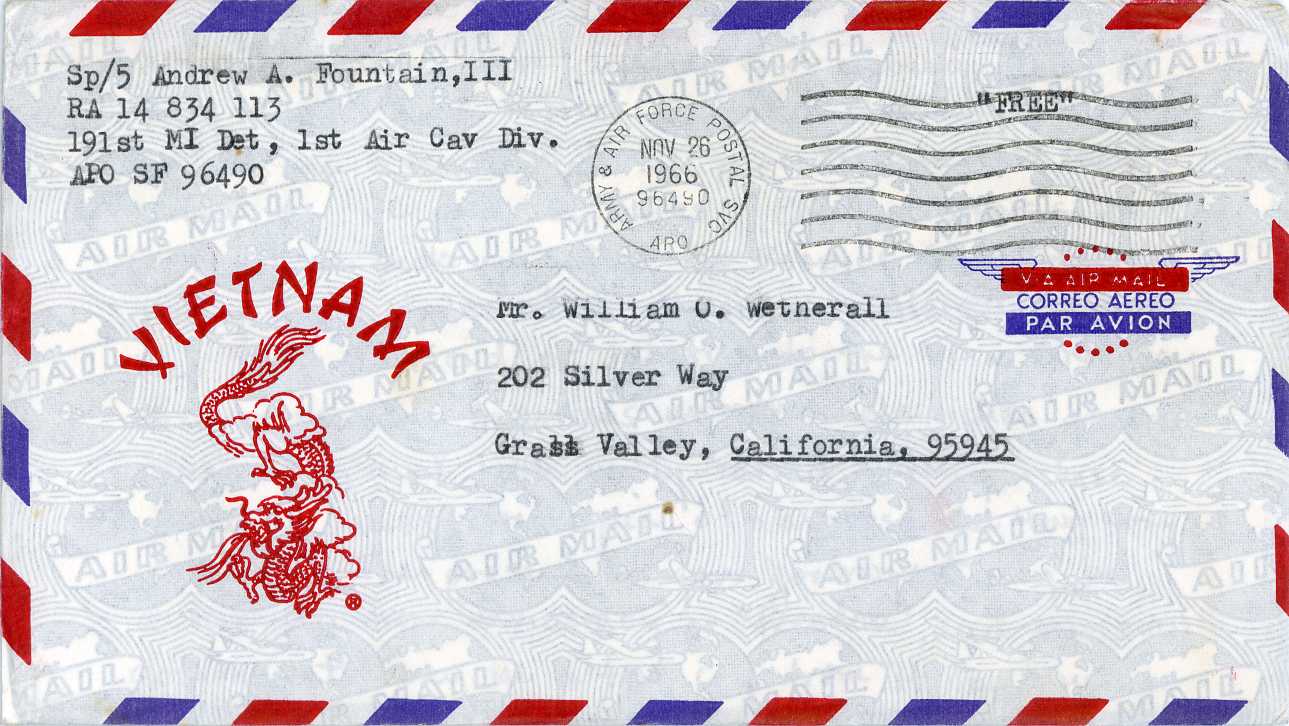
|
|
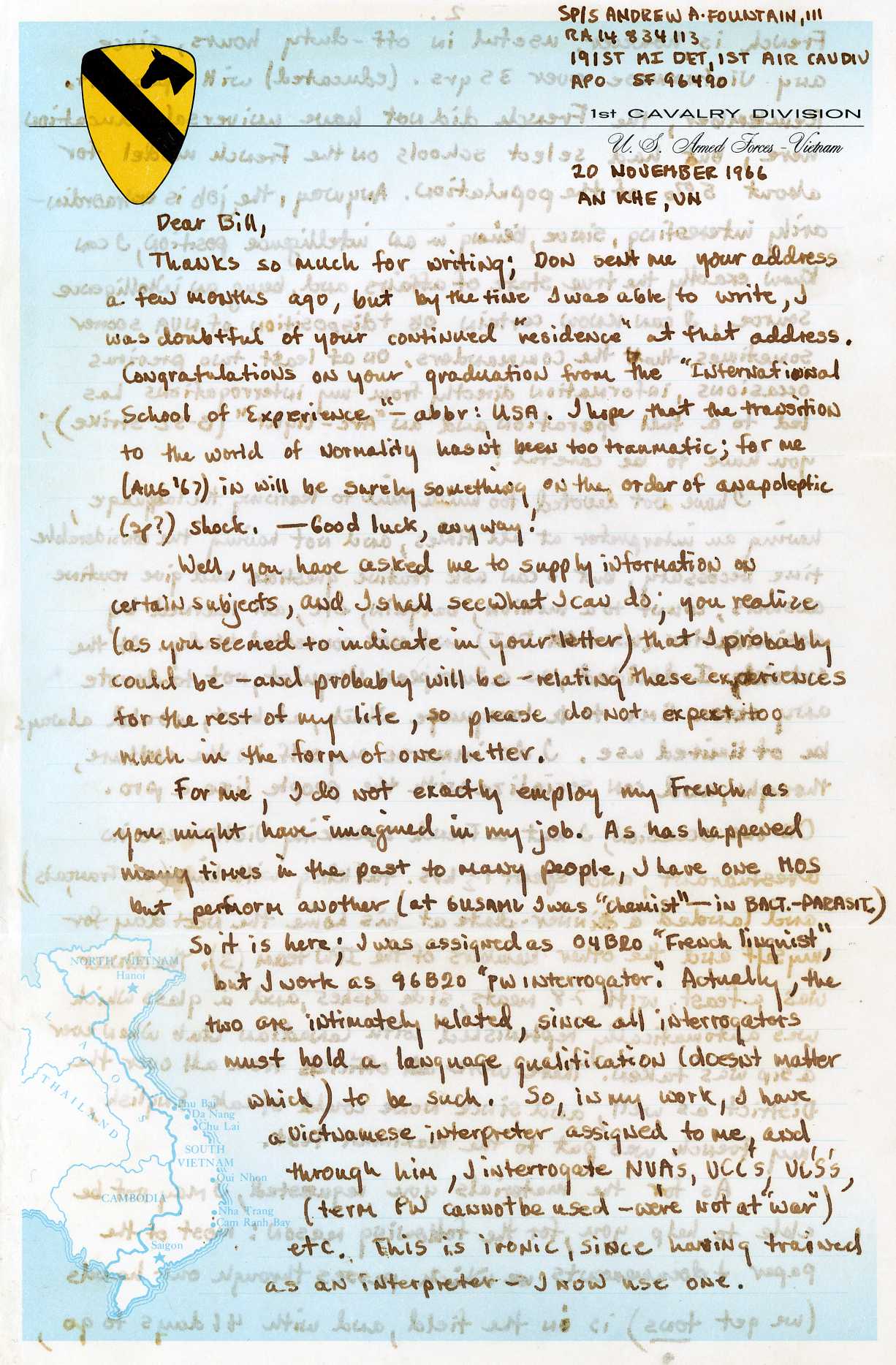
|

|
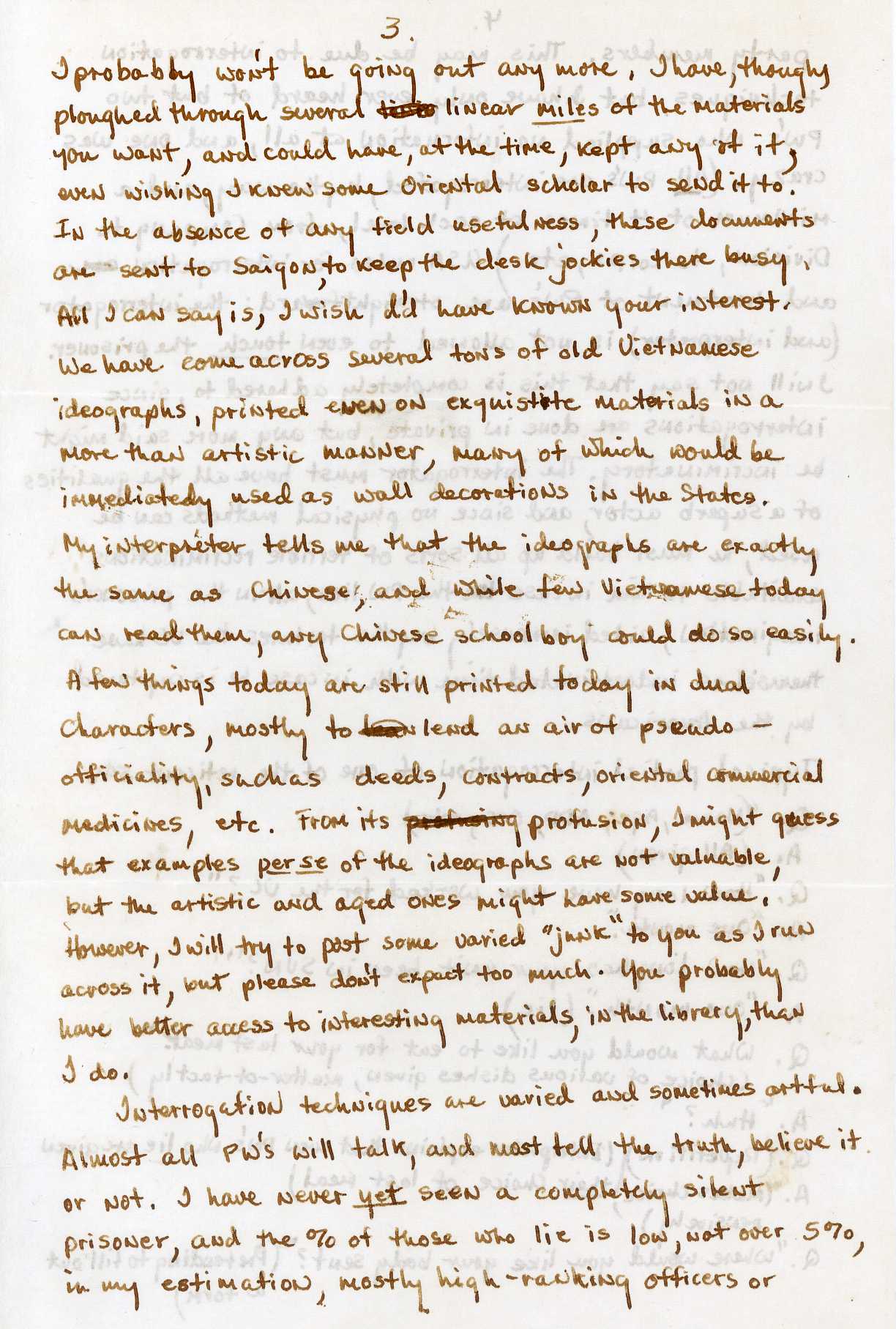
|
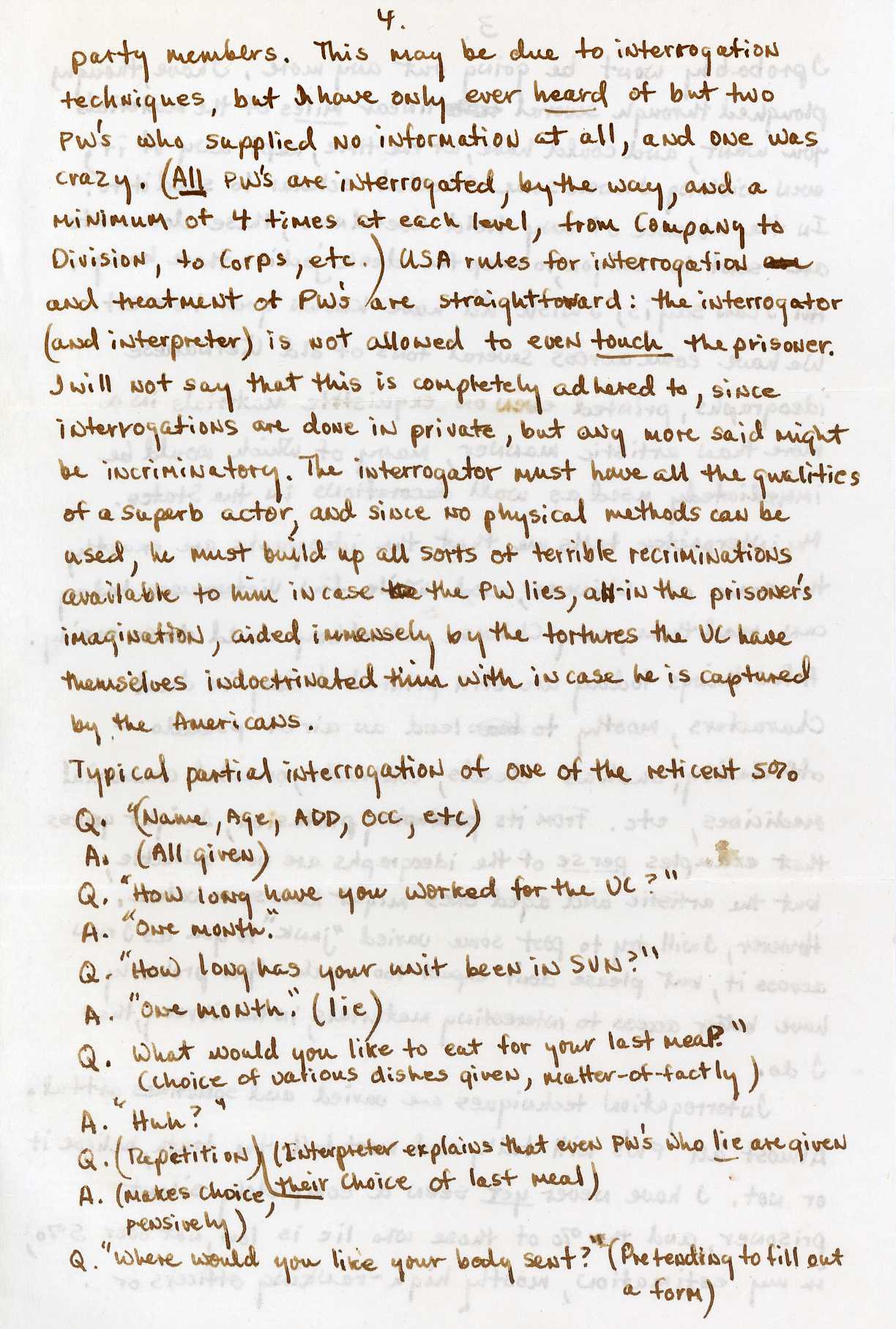
|
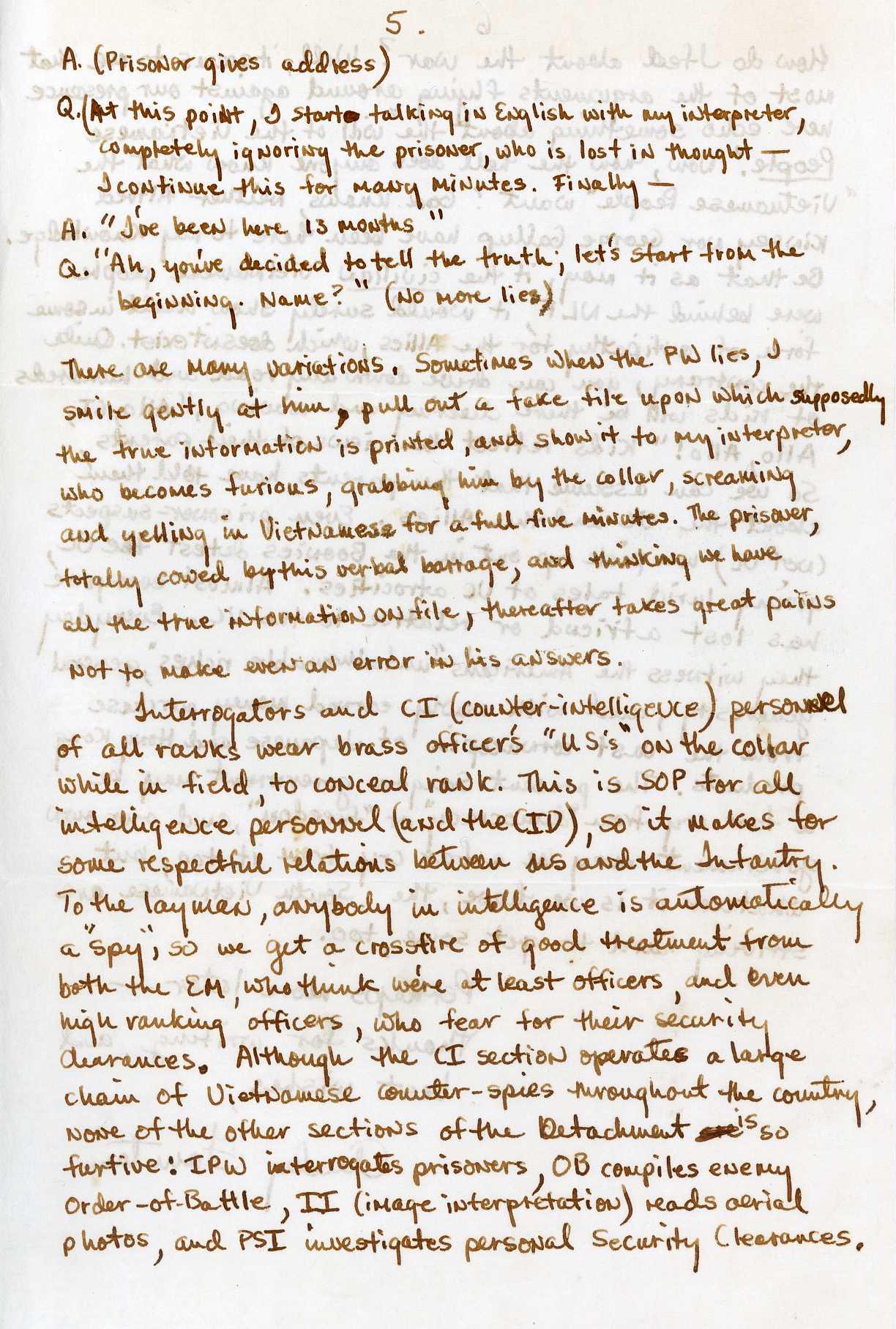
|

|
Lab tech postsAfter completing my lab procedures training at Ft. Baker, I worked as a lab tech at two hospitals in the United States before being posted to the 106th General Hospital in Yokohama. At the U.S. Army Hospital (USAH) at Ft. Ord, in California, I learned the practical aspects of some of the more common procedures I had learned at Ft. Baker, and also became familiar with routine tests that were not performed at Ft. Baker, which specialized in less common tests. At McAfee Army Hospital at White Sands, in New Mexico, a relatively small hospital, I experienced what it was like to be responsible for all aspects of routine lab work on the same shift -- unlike USAH Ft. Ord, where I had worked day after day in the same division before being rotated to another division. My military records (DA-20) show the following assignments after I completed my lab tech training at Ft. Baker. The "Comments" are mine.
These assignments included "Foreign Service" from 15 Dec 65 through 1 Oct 66. |
||||||||||||||||||||||||||||||||
Ft. Ord U.S. Army Hospitalfineartamerica.com www.pinterest.comThe hospital at Ft. Ord, when I was there in the mid 1960s, was a sprawling labarinth of single-story wooden barrack-like wards connected by corridors -- a holdover from first the Pacific War and then the Korean War. In 1972, during the winding down of the Vietnam War, it was replaced by Silas B. Hays Army [Community] Hospital, a multi-story 400-bed ferro-concrete facility designed in 1969 to continue to care for personnel stationed at Ft. Ord and their dependents, as well as for the fairly large population of veterans who had settled in the Seaside and Monterey areas around the base, but also Vietnam casualities. The closure of the newer hospital when Ft. Ord itself waa closed in 1994 had a huge impact on veterans who had come to rely on medical treatment at what became in name as well as in fact a "community" hospital.
The training I received at Ft. Baker was strong on theory and principles, and on procedures of the kind that were routinely performed at the 6th U.S. Army Medical Laboratory. We learned basic hematology and urinalysis at Ft. Baker, but had no opportunity there to pracitice in a clinical setting. The closest we got to a clinic was the single day we took the interpost shuttle bus to the Presideo on the the San Francisco side of the bay to observe the laboratory operation at Letterman Hospital. Letterman's lab had a Coulter Counter, and part of our tour of the lab included a brief hands-on demonstration of the counter. Hematology and urinalysisBecause I took a personal interest in histopathology, bacteriology, and chemistry while at Ft. Baker, I got to spend a lot of time in the labs there doing things that weren't part of the familiarization course. The military and civilian staff were kind enough to let me do as I pleased and at times gave me guidance. But there wasn't even a dispensary at Ft. Baker. Military personnel at Ft. Baker bussed to Letterman for outpatient attention. So I had to wait until I got to Ft. Ord to practice and master routine hematology, urinalysis, chemistry, bacteriology, blood banking procedures. Serology and blood bankingThe same was true of serology. There was no blood blank at Ft. Baker. I learned to do cross matching, but there was no opportunity to manage units of blood that had been drawn for use in transfusions, much less no need to draw such blood. The lab at Ft. Ord oversaw the blood bank, and everyone had to know what to do when on night call and faced with a request for blood, including a type of blood not in the blood bank. At Ft. Ord, though, I never had an opportunity draw blood for transfusion. MorgueFt. Baker received autopsy specimens, and had refrigerators to preserve such specimens, but had no need for a morgue. The 6th U.S. Army Laboratory occassionally received a fetus or very prematurely still-born child, but never a cadaver of a child or adult. Ft. Ord had a morgue for preserving the bodies of in-patients who until their disposition could be determined. I cannot recall whether autopsies were performed at the hospital, or if so who performed them. I can sketch the general layout of the lab, but can't place the hisptopathology section. I recall a room with a refrigerator where we were to place the body of infant who died, but I can't recall the referators for adult cadavers. I do, however, clearly recall the instructions I received concerning what to do if I was on call and had to deal with a cadaver. I was supposed to plug all the orifices, to make sure nothing left or entered the body. It wasn't that I couldn't or woudn't, but merely that I hadn't -- ever -- plugged the orifices of a person whose body was possibly still warm but was no longer living. Or perhaps I should say the person was still living -- some of the person's tissue was still vital -- but the body as a whole was not alive. Is to say that someone is dead akin to saying the someone has ceased being a person? Previous experience with hospitalsBlessed with good health myself in a family generally blessed with good health, I had has very little experience with hospitals. The visit to the lab at Letterman Hospital while training at Ft. Baker to be a lab tech was my first time to see the operations of a hospital other than as a patient or when visiting a patient. And, of course, working as a lab tech at the Ft. Ord U.S. Army Hospital was the first time for me to come into contact with both out-patients and in-patients, of all kinds, as a medical technician. My only hospital experience in a hospital, other than to be born in a hospital, was during my own hospitalization, for about a week, for a hernia operation, while in high school, shortly after I turned 18. I can clearly remember being counted down and out in the surgery room, and waking up in my own room, and I can remember the last few ways on the ambulatory ward of a small and old hospital in Grass Valley. Prior that that, I had twice -- while growing up in San Francisco before moving to Grass Valley when 14 -- needed stitches in my hands. Both cuts were nasty in different ways. The first cut was a very rough and deep laceration in the padding of the tip of the middle finger of my right hand. I got it when, while throwing a rock at a rat near our camp in the redwoods north of San Francisco, my hand hit a tree. I continued (and still like) to throw rocks -- but not while standing beside trees. The second cut was a smother and longer slice on the top knuckle (distal end of the metacarpal) of the index finger of my left hand. I was trying to saw a board with a neighbor's bread knife in the driveway of our home on 33rd Avenue when the blade jumped out of the cut as I was guiding the knife with my hand. I learned that bread knives were designed to cut bread, not wood -- and that the first rule to using any tool was to use it safely. But I knew what blood and pain and stitching was like. And I had a strong interest in medicine and medical care. Ft. Ord was a long way from the battlefields of Vietnam. While most of its patients were young and generally healthy Army personnel, it was a general hospital that for military families and veterans as well. There were deaths at the Ft. Ord Hospital, and lab personnel were prepared to encounter dying and dead patients. So of course I thought about such things. I also thought how fortunate I was to learn so much about the human body and what can go wrong with it -- from natural, accidental, suicidal, and homicidal causes -- without going to Vietnam, to witness serial homicides, even mass homicides -- for most war deaths are homicides. Letters from VietnamBooks and anti-war tracts were not my only reading matter about Vietnam. I corresponded with two people who were there -- Andrew Fountain, who I have already introduced -- but before him, Donald Bakeman, with whom I had bunked and worked in the 3rd platoon of the 561st Ambulance Company at Ft. Ord. Donald Bakeman"as a medic"While in the 561st Ambulance Company, before becoming a lab tech, before the Vietnam War began, I had become a conscientious objector. I was not the only CO at either Ft. Ord Army Hospital or the 106th General Hospital, but no one would know who was a CO unless you had seen personnel records or someone told you. When clerking in the Orderly Room at the 561st Ambulance Company, I saw all personnel records, so I knew everyone who was officially a CO, but most COs didn't hide it. COs were commonplace in medical units. A significant percent of the corpsmen in the ambulance company were Seventh Day Adventists, who submit to the draft or even enlist as COs, who are not required to handle or fire weapons and are usually trained with a medical MOS. The 561st Ambulance Company was once of the first STRAC units at Ft. Ord to go to Vietnam. And one Adventist, who for a while had been my bunkmate and sometimes partnered with me on ambulance duty, wrote me from Vietnam. One of his letters, dated 22 September 1965, was posted from Qui Nhon in Vietnam. The 561st Medical Company, Ambulance, was deployed at Long Binh from 23 August 1965 to 1 October 1970. Long Binh, near Saigon, was the site of the largest U.S. Army post and depot in Vietnam. Qui Nhon was on the coast several hundred kilometers to the north. The following letter was addressed "PFC William O. Wetherall / Hospital Co. USAH Lab. / Fort Ord, California 94211. The return address was PFC Donald L. Bakeman 56367293 / 3rd Plt. 561 Med. Co. (Amb) / APO San Francisco, Calif. 96238" and postmarked "Army-Air Force / Postal Service / Sep 24 / 1965 / 38" with free postage. The letter, hand written on 3 pages of lined letter paper, reads as follows (underscoring in original, highlighting mine). Sept 22, 1965 William O., Due to the perplexing slowness and mishandling of our mail, your letter arrived only a few days ago. There is no censoring of mail here but it does go through a X-ray machine. I am enclosing a few cents worth military Payment Certificates. I would like to have seen this town before the American influence entered. I'm afraid I cannot tell the economic impact of our being here at this late date. I can say that it appears that all prices have been inflated. It is almost impossible to get a 'bargain'. Things are as expensive as in U.S. There are a lot of breeds of buses and motorbikes and bicycles around this area, so it seems that there must be money floating around, although from the appearance of the people and their dwellings -- well I guess its the expected Oriental smell and lack of sanitation and personal hygiene. I would appreciate the language guide [which I offered him] as the one we have I feel is quite inadequate. We don't have a close contact with the natives due to the nature of our job. We do get to go to town to shop periodically, but there is always an element of danger present. I believe we are expecting trouble soon -- trenches being dug quite heavily the last two days. We've been seeing quite a few casualties here (85th Evac. Hosp.) where we've been litter bearers while awaiting our ambulances. Our ambulances are here today from Saigon finally.While I am not about to write a letter to pres. Johnson castigating those who oppose V.N. policy and saying what a great thing we're doing here helping the poor Vietnamese, etc., I am glad to be here in a position to help some of my fellow countrymen. I think this is the biggest change in my attitude since leaving Fort Ord -- I am not sorry to be here as a medic -- although I still would like to be home of course. I better get this in the mail now so you won't think I haven't got your letter. Yours, Don B. |
|||||||||||
106th General Hospital (WBGH Ft. Bliss)My military records (DA-20) show the following assignments.
11 Oct 65 Med Lab Asst 106th Gen Hosp Ft Bliss Texas (Unit PCS) "Unit PCS" meant that the 106th was slated for a "permanent change of station" from "Ft Bliss" to another location. That location turned out to be "APO 96503", a San Francisco Army Post Office Zip code then assigned to the 106th among other USARJ units. My mail address when attached to the 106th General Hospital at Ft. Bliss included the letters WBGH, which stood for William Beaumont General Hospital. All I recall of the hospital is that I pulled KP duty once in its mess hall -- an early morning breakfast stint. Otherwise my activities were confined to the area around the barracks of the 106th General Hospital, and the McAfee Army Hospital at White Sands (see next), where I was seconded while the 106th readied itself for deployment to an unknown destination in Asia. Waiting, working, wonderingThe officers and most NCOs sent to the 106th on the eve of its deployment to an undisclosed destination in Asia busied themselves with planning. Most of the enlisted men remained in the 106th headquarters area, where they pulled various work details, including their share of KP, or lounged around the barracks. Fortunately, I was seconded to McAfee Army Hospital at White Sands Missile Range for at least half of the time I was with the 106th at Ft. Bliss. Consequently, I pulled no "keep'em busy" work details at Ft. Bliss that I can remember, except for one stint of KP -- which I clearly remember -- just before I was sent to McAfee (see next). Petit touristI am not much of a traveller and don't go out of my way to see places of interest to tourists, even in my own backyard. But while billeted at the barracks in the 106th Headquarters area at Ft. Bliss, I joined a group of friends I had made in the barracks to make a long day trip to Carlsbad Caverns, and I spent an evening with another mix of friends drinking beer at a Mexican cabaret in Ciudad Juárez immediately across the border. Carlsbad CavernsCarlsbad was fascinating. I'd seen bats before, and even held baby bats, at the covered bridge on the South Fork of the Yuba River, where I had often gone swimming, near Grass Valley, in northern Calfornia, where I had lived. But I had never seen bats in such great numbers as we saw them at Carlsbad. And I had never seen, nor smelled, bat guano in any amount, much less the mountains of the stuff at the entrance of the carverns at Carlsbad. Cuidad JuarezJuarez today is still haunted by the reputation it gained from the 1990s as a city of drugs and murders, in which hundreds of women disappeared. In 1965, the main concerns for soldiers visiting the city from El Paso were diarrhea and gonorrhea. 1965 marked legislation in Mexico that promoted industrialization along Mexico's frontier with the United States, beginning with Juarez, and inspired the building of factories in El Paso and other border towns on the U.S. side. In the same year, the United States enacted a new Immigration and Nationality Act that impossed immigration quotas on south-of-the-border states beginning with Mexico. Though Mexicans were not as free as before to enter the United States for the purpose of settling, they were allowed to cross the border work. And as cross-border industrialization increased, the number of Mexicans who communted from Juarez to El Paso soared. I have zero memory of the geographical particulars on either side of the border. I recall only that we easily crossed the border on the strength of our military IDs, shown at a gated guard house for pedestrian border crossers. We walked across what I presume was the Santa Fe Street Bridge. I recall very little about the evening in Juarez except that we spent most of the time sitting in a crowded booth in a very large and noisy and smokey cabaret nursing beers and speculating about where we were going, and keeping out eye on the mezzanine, where there were some rooms for short-timers. There was not a great deal of traffic on the stairs. There wasn't a lot of solicitation, but such as it was, like most of the soldiers there, we showed no interest, which didn't mean we were thinking about it. One of the members of our group disappeared for a few minutes. He seemed a bit sheepish when he returned to the table, and got a lot of teasing back in the barracks. In the barracks, we debated all manner of issues, from the war in Vietnam to immigration and the sex trade. The political, moral, and medical pros and cons of life. I'm still debating them. The 106th General Hospital in peace and warThe El Paso Herald-Post carried the following article in its Thursday, 26 May 1964 edition (page 14).
An earlier El Paso Herald-Post article, published on Thursday, 9 April 1964 (page 13), gave the following longer account of the 106th General Hospital at William Beaumont General Hospital.
1945 apprehensions about deployment to PacificGermany's surrender to the Allied Powers in May 1945 meant that some U.S. military units in the European theater would remain to carry out Occupation duties, but most would be demobilized. The war in the Pacific, however, was still raging. The Battle of Okinawa, which had begun in April, would continue into June. An invasion of Japan's main islands seemed inevitable, and hence the prospects that some units which had served in Europe would be redeployed to the Pacfic. The 106th could well have been deployed in Japan from the United Kingdom after the war in the European Theater wound down -- had the war in the Pacific Theater continued. The following excerpts are from a biography of Mable Rumburg and Joseph Meites from the alumni section of the School of Social Work department at the University of Missouri, from which Rumburg had graduated, with a degree in social science and social work, in 1942. Rumburg married Meites in 1943 in what would be an "interfaith" marriage, she being Methodist, he being Jewish. They got married before a justice of the peace because the Jewish chaplain at Jefferson Barracks, where Meites was training for a commission in the Sanitary Corps, would did not condone interfaith marriages. Sanitary Corps The Sanitary Corps was established during the Great War, now called World War I, to oversee everything related to sanitation, food and nutrition, laboratories, venereal diseases, psychology, x-rays, and hospitals and the like. The English term "hygiene" was most broadly used to include sanitation, nutrition, and medical care. The Japanese terms for "mental health" and "medical corpsman" when I began learning Japanese in the late 1960s, and was doing research in mental health in Japan in the 1970s, were "seishin eisei" (精神衛生) and "eisei-hei" (衛生兵). By the 1980s, the term for "mental health" became "seishin hoken" (精神保健) as "hoken" (保険) had become the general word for "health", whereas "eisei" (衛星) remained associated primarily with "hygiene" in the sense of "sanitation" and "cleanliness" as in the term "kōshū eisei" (公衆衛生) meaning "public sanitation" or "public hygiene" -- pertaining to things like cleanliness in restaurants and hospitals and schools, and other aspects of disease prevention. Meites, who had nearly completed a PhD in biology before being inducted, was promoted from private to corporal, but was soon commissioned a 2nd lieutenant in the Sanitary Corps and assigned to Hospital Laboratory Services. By 1944, he was on his way to the United Kingdom with the 106th General Hospital, on the eve of what the world would later know as the Normandy Invasion.
|
McAfee Army Hospital (White Sands)For a month or so sometime between 11 October and 16 December 1965, I worked as a lab technician at McAfee Army Hospital at White Sands Missile Range in New Mexico. It is now called the McAfee US Army Health and Dental Clinic, and as such it is officially part of the William Beaumont Army Medical Center (WBAMC), which oversees primary healthcare in and around Fort Bliss and El Paso. A Facebook article accompanying photographs of the official opening of the present McAfee U.S. Army Health and Dental Clinic on 26 August 2013 states that "The clinic was first dedicated in 1964 as an inpatient facility" (William Beaumont Army Medical Center, White Sands Missile Range-U.S. Army Health and Dental Clinic, 27 August 2013). But A Decade of Progress: The United States Army Medical Department, 1959-1969 states that "McAfee Army Hospital, White Sands Missile Range, N. Mex., a 50-bed hospital, was completed in May 1965 and named in memory of Brigadier General Larry Benjamin McAfee, Deputy Surgeon General of the U.S. Army, 1941-43" (Edited by Rose C. Engleman, et al., Office of the Surgeon General, Washington, D.C., 1971). Whichever date one takes, McAfee Hospital was a brand-new facility when I worked there for about a month in the fall of 1965. The Organ mountains to the west, and the isolation of the spawling and very sparse base in the middle of the desert, made it, for me, an ideal post -- not as nice as Ft. Baker, but better than Ft. Ord, Ft. Sam Houston, and Ft. Bliss. The scenery around Kishine Barracks was incomparable on account of its being exotic. CorrespondenceTwo covers of correspondence with McAfee addresses still survive. One, from a friend stationed with the Enl. Det. U.S. Army Garrison (4006), Ft. San Houston, Texas is addressed to me at McAfee Army Hospital (Lab), PO Box 103, White Sands Missile Range, New Mexico, and is postmarked 14 November 1965. The other, a letter from a friend in the Navy, has a 24 November 1965 USS Boston (CAG-1) postmark, with an FPO, NY, NY address, and is addressed to me at McAfee Army Hospital, P.O. Box 103, White Sands Missile Range, New Mexico, but is also postmarked 30 November 1965, White Sands Missile Range, and marked for forwarding to me at 106th General Hospital, WBGH, El Paso, Texas. Working at McAfee afforded me my first opportunity to be responsible for all aspects of routine lab work on the same shift -- unlike Ft. Ord U.S. Army Hospital, where as a lab tech fresh out of training I had been rotated every week or two to a different division before settling into chemistry and bacteriology. I can clearly recall only three things about my stay at McAfee. I liked to take walks through the sprawling exhibit of vintage rockets and missiles across the road that ran by the entrance to the parking area in front of the hospital. I spent most of my few weekends banging out the final draft of Cybernetics and Semantics, which was published the following year by California Engineer. And I experienced the hospital's response to a staph outbreak.
Staph outbreakMy only memorable medical experience at McAfee Hospital was to witness and participate in the laboratory's response to a staph outbreak in the neonatal ward. For a few days, everyone in the hospital was subjected to a strict sanitation regimen. Access to the hospital was restricted, and entering and exiting required the sort of precautions familiar on isolation wards today though without the sort of mask, glove, and gown dispensers that are commonplace today. In the lab, we poured, inoculated, incubated, and read a lot of blood agar plates and slants as we screened everyone who had had any contact with the ward. It turned out that one of the obstetricians had boils on the back of his neck. The staph outbreak at McAfee was quickly contained. I can't recall whether antibiotics were an issue. Methicillin, a form of penicillin, was introduced in the 1940s to treat staph infections that seemed to resist ordinary penicillin. The term MRSA -- Methicillin-Resistant Staphylococcus aureus -- was coined in the United Kingdom in 1961, but the first case in the United States was not reported until 1968, according to the National Institute of Allergy and Infectious Diseases (NIAID), National Institutes of Health (NIH), U.S. Department of Health and Human Services. Today, methicillin-resistant strains of S. aureus -- and strains resistant to other antibiotics -- threaten patients everywhere with weakened immune systems. Staphylococcus aureus is so named because such bacteria are round (coccus), appear like bunches of grapes (staphlo-) when dyed, and form golden (aureus) colonies when cultured on bright red sheep blood agar, tripticase soy agar (see right), and other culture media. While its appearance on culture media and stained bacterial smears may be beautiful, staph aureus is potentially very deadly. Staph aureus and several other varieties of staph are among the many bacteria that make up normal human flora -- microorganisms that commonly reside in healthy human bodies. Like other such bacteria, staph aureus generally does not cause infections or other problems. However, like a number of other normal flora, it can take advantage of conditions like a cut or wound, or a stressed or weakened immune system, to fester in ways that result in boils or other infections. And all bacteria, but especially staph aureus, become life threatening when they break through capillary walls or other barriers and contaminate the blood stream, thus causing septicemia, and through the blood spreading to internal organs. Mary Ellen (Wetherall) ZweigMRSA struck close to home when my sister, Mary Ellen Zweig, began to have boils on her arms and buttocks, which cultured out as methicillin-resistant staph aureus. The boils were lanced and drained, and she was treated with topical and oral antibiotics. The lesions would heal but soon she'd have more boils. Eventually my sister had to be isolated in a general hospital for observation and tests, to deal with a bout with MRSA that was overwhelming her frail immune system and beginning to invade her bloodstream. The incipient septicemia was thwarted, and she was committed for about 3 months of treatment and rehabilitation to a strictly controlled ward in a local convalescence home. My sister survived her bout with MRSA but remained a MRSA carrier the rest of her life. Born in 1945, she died of other causes in 2017 -- just a year and a few months after her MRSA convalescence ended. One reason my sister's immune system weakened as much as it did appears to have been her habit, when working as a registered nurse, of self-medicating herself with antibiotics and other drugs available to her as samples left by the pharmaceutical company reps at the clinic where she worked for many years. She had developed at least a psychological dependency on a number of drugs. |
106th General Hospital (Kishine Barracks)My military records (DA-20) show that the "Unit PCS" or "permanent change of station" status of my posting to the 106th General Hospital as of 11 Oct 1965 changed to "APO 96503" as of 16 Dec 1965. Whether that was the day we left El Paso, or the day we arrived in Japan, I can't recall. The "Foreign Service" date shows "USARPAC Japan" as the "Oversea Command" effective from 15 Dec 65 to 1 Oct 66. I recall that we flew a chartered commercial aircraft that made a brief stop at Anchorage. An Anchorage stop was then standard for most flights between the western states of the United States and East and Southeast Asia. In any event, we crossed the International Date Line traveling west, which meant we arrived the next day. I also have a vague memory of hearing the pilot or someone anounce that we had crossed the IDL. This meant something to me because in college I had taken a course in astronomy and was familiar with different standards for rekoning time, including time zones and calendars. My military records (DA-20) show my "Foreign Service" as running from 15 Dec 65 through 1 Oct 66. The "Record of Assignments" also shows "16 Dec 65" but the "FSA [Foreign Service Allowance] Code" has 16 Dec 65. This may mean that the main complement of the original party left Ft. Bliss on 15 December and arrived in Japan on 16 December 1965. The communications zoneFacilities like the 106th General Hospital were regarded as part of the "communications zone" between the combat zone in Vietnam and the United States. This metaphor was not familiar to me when I was with the unit in Japan. It still strikes me as an odd way of describing a locality that, while nowhere near a combat zone, was certainly about more than "communication". The term appears in the following paragraphs cited from the following source.
UniformsI can't remember why John was in khakis. He usually wore whites like the rest of us. Perhaps he had just been promoted. I can't recall wearing khakis, much less a dress uniform, in all the time I was in Japan. When on duty in the laboratory, or when making rounds in a ward, I wore whites. When in the lab, I sometimes took off the blouse and worked in a t-shirt. Dressing down to this extent was not acceptable outside buildings, and even inside very few personnel got away with only a t-shirt. As you can see in this picture, Lew and I didn't wear a cunt cap, which in principle we were supposed to wear with our whites when outside. The 106th was fairly lax about such rules. Sometimes, though, someone -- usually an NCO, rarely an officer -- would ask me where my hat was. When off duty, especially when off base, I wore civilian clothes. We were not supposed to wear any military garb off base unless we were on official military duty. When going by military transportation to North Pier or Camp Zama, I wore fatigues. Driver's licenseI also wore fatigues when I took a road test to qualify for driving in Japan. I had been trained to drive an ambulance and other military vehicles at Ft. Ord, and had driven an ambulance there as part of my duties with the 561st Ambulance Company. And someone in the 106th's headquarters, pursuant to an arcane Army regulation, must have determined that I ought to be ready to drive in Japan if required. One day an NCO in charge of qualifying drivers observed me while I took a spin around Yokohama, including North Pier. As I recall, I passed the road test, but I have no memory of receiving a license, or of the qualification being noted on my Army I.D. Card. It is not noted on my military records (DA-20). This was the only time I have ever driven an automobile in Japan, though my children and some friends will tell you that I have done lots of backseat driving. But during my life in Japan I have gone through several bicycles, and also as a pedestrian, I have totally internalized Japanese traffic conventions -- to extent that, when crossing a street, I look first and last to the left, not the right. When visiting the United States, the driving on right of the road seems odd. The first few days of driving were also difficult in that I had to consciously guard against driving in and turning into the left lane. In 2015 I let my California driver license lapse, not because I can no longer driver or no longer have an address in the state, but because I feel my reflexes are now a liability. My father stopped driving when he was 99. Sleeping quartersThe whumps, whops, or thwaks of a helicopter arriving at Kishine any time of the day, but especially at night when I trying to sleep, never failed to remind me of where I was. There was always at least one person in the lab at night, and everyone pulled night duty. But because I literally slept in the lab, I was also the de facto permanent night-call back-up. During the first few weeks, when we were setting up, I left the lab only to eat, sleep, and shower. Like other enlisted men, I had a bunk and locker in the enlisted men's quarters (EMQ), which was Building E. But even when I was not on duty, I was likely to be in the lab, or on base, and more willing to volunteer to help the night-duty technician. A couple of nights there was so much work I just slept on a cot in the lab. The night duty tech had a bed, but there were also a couple of cots. By the time we moved from Building B to the small building beside it, I was already virtually living in the lab. And when we moved, I was allowed to put a bed and locker in the storage room off the bacteriology lab and permanently quarter myself there, rather than in the EMQ, in return for being willing to help the night call tech in a pinch. I can't recall what arrangements I made with the NCO in charge of the EMQ. Someone in each bay was responsible for bunk and locker assignments and otherwise keeping track of who was quartered in the bay. And presumably the people in headquarters had lists of who was staying where. All I recall is that, in time, I never again stepped foot in the EMQ. Today I have all manner of dreams about finding the lockers I've been assigned at times in my life, including student lockers at Berkeley. I would dream of being unable to find the locker, or finding it but not remembering the combination of the lock, or finding an unfamiliar lock. The rule of life in the EMQ was survival of the fittest. People scrambled to get an upper locker close to their bunk. Preference for bunk location -- whether in the middle of the bay, or near the stairs or an exit, or near the latrines and showers -- and preference for upper or lower bunk -- varied with the person. Some were more aggressive than others, but most men accepted what they ended up with. Replacements had little choice but to accept whatever bunk and locker were available when then came. In the beginning, everyone was quartered at Kishine Barracks. Married officers and NCOs were gradually accommodated in military housing elsewhere if their dependents joined them in Japan. Some higher ranking NCOs were billeted in one of the BOQs. And in time some NCOs and officers began living on the economy, in apartments within walking distance or a short commute by bus or train from Kishine. Appointments and reductionsMy Army records (DA-20) show the following appointments and reductions. The "Comments" are mine.
A number of 106th PFCs, including myself and other PFC lab techs, were made Sp4s a couple of days before our departure from Ft. Bliss to Kishine Barracks. Notice that the rank was made permanent (P) the same day it was awarded as a temporary (T) rank. Had I taken the Article 15 instead of insisting on asking for a Special Court Martial in November 1964, I would probably have made Sp4 by the time I was sent to Ft. Baker in February 1965. The reduction from PFC-E3 to PVT-E2 made me the lowest ranking among the lab tech trainees there. This, however, had no effect on my performance. My records say I regained my PFC status on 1 April 1965 while I was at the Headquarters of the Sixth U.S. Army Medical Laboratory (Ft. Baker). But I was still an E-2 Private according to my diploma, which I received in July. And the address I used for correspondence does not include my PFC rank until after I had returned to U.S. Army Hospital at Ft. Ord. In any event, only two promotions were allocated the path lab at the 106th during my time at Kishine Barracks. One, a Sp5, went to me. The other, a Sp6, went to Sp5 Larry Walker, a career soldier, as I recall. The promotions were awarded on the same day, in the same simple ceremony, by Captain Pusch, in the laboratory outside his office in the east wing of the 2nd floor of the small lab building between Buildings B and C. Final days and dischargeMy military records (DA-20) show 2 Oct 1966 as my REFRAD-TRF TO USAR -- Relief From Active Duty, Rransfer to U.S. Army Reserve. I recall being driven in a car to Tachikawa Airbase and flying to Travis Airbase in California, then being bused to the U.S. Army Personnel Center in Oakland, California (Oakland Army Terminal, Oakland Army Base). I recall being at the terminal for three or four days. Separation examinationThe 106th began processing me for separation in July 1966. A chest X-ray on 11 July was normal. An dated urinalysis showed a specific gravity of 1.027 [normal 1.003 - 1.030], negative albumin and sugar, and "Av. Amorph Sed." (average amorphous sediments). A 12 July serology [syphilis test] was no-reactive. The personal separation (ETS) [Expiration Term of Service] examination was administered 106th General Hospital on 25 July 1966. The exam shows a checkmark in the "Abnormal" column for "40. Skin, lymphatics" with a note "40. Dermatitis fungal of groin". The "73. Notes (Continued) and Significant or Interval History" section state "External otitis under Px" and "Fungal dermatitis groin under Px". I was just then recovering from a mild case of "crotch rot" and the second (and milder) of two bouts with otitis I had in the Army. The first bout was a bilateral staph infection in my ear canals when working in the lab at Ft. Ord before going to Ft. Bliss in 1965. The infections at Ft. Ord required lancing a couple of boils in each ear. This continue to rank as the most painful medical procedure I have ever experienced. The "74. Summary of Defects and Diagnoses (List diagnoses with item numbers)" section has a short statement which is illegible owing to the quality of the copy. Re-up sergeantAs I was counting the days to my departure from Japan and good-riddance to the Army, the "re-up" sergeant tried -- but not very hard -- to persuade me to re-enlist. Many of us were getting short around the same time, and so the re-up man was busy. He approached me once and I immediately told him I had no intentions of staying a day longer than ordered. He knew the odds of persuading someone like me to stay in the Army were zero, and he never asked me again. Re-enlistment incentives were established by policy, but there was room for negotiation, especially if you had an MOS (Military Occupational Specialty) in short supply. The incentives were based on the Army's needs, and so soldiers with critical MOSes were offered higher bonuses in addition to other inducements, like choice of next assignment. I recall others talking about "re-up bonuses" of several months pay. In 1966, my monthly pa as a Spec 5 (Sp5, E-5) was about $200. Higher ranking NCOs, practically all of whom were career soldiers already on their 2nd, 3rd, 4th, or 5th enlistments, stood to receive thousands of dollars for re-enlisting. Re-enlistment promotions were more difficult to negotiate, especially for the NCO ranks, which generally means E-6 and higher, but deals could be made. ReservesAs an 3-year enlistee with a 6-year obligation, I was formally transferred from active duty to a reserve status that did not require reserve activities. The Oakland center sent me home with a new dress uniform and overcoat, so as to be prepared if, for any reason, I was called back to active duty during the 3 years I was technically part of the reserves. I had nightmares then -- and still occasionally have dreams -- of being recalled to active duty. But effective 30 September 1969, I was fully discharged from the U.S. Army Reserve. The uniform and overcoat have long since been given away. I wore the khaki dress shirt, though, when working in the woods. Accrued leaveMy DD 214 report of transfer or discharge states that I received a "lump sum payment made for 53 days accrued leave", which indicates that I had used practically none of my authorized paid leave during my 3-year term of enlistment. |
People I knewStanding left to right in the photograph to the right are Lew Goodhart and Bill Harvey, both X-ray technicians, and John Daugherty, a physical therapist. Squatting front and center is yours truly, Bill Wetherall, a path lab tech. Bill, John, and I were part of the original unit. I believe Lew joined us later. Bill and John were the closest and they were more likely to socialize together off base. I joined them and Lew a couple of times, and I traveled with them to Tokyo, Kamakura, and Nikko. I was then, as always, more of a loner, and then, like now, obsessed in my work. Bill was from Clintonville and then Milwaukee, both in Wisconsin. John was from Philadelphia, Pennsylvania, then Palm Beach Shores, Florida. Lew was from Walnut Bottom, Pennsylvania, then Denver, Colorado. I was born in San Francisco, but had moved to Grass Valley, also in Califorina, when 14. In the picture to the right, Bill is off duty. We were all fairly trim, but he was probably the most fit, and I probably had the most subcutaneous fat. Lew Goodhart is wearing the red radiation monitor required by all X-ray personnel. He went on to become a hospital administrator but passed away in 2001 (see 10-year memorial below). Bill Harvey went on to become a doctor specializing in diagnostic radiology, the very field he worked in at the 106th General Hospital (see his own account of his education below). I lost contact with John Daugherty after I left Kishine. We may have exchanged a letter or two, but if we did, nothing survives in the detritus I still have. I do, however, still have his parents' address in Philadelphia and his address at the time in Palm Beach Shores. I have treasured this photo and memories of the camaraderie. |
Friends and colleaguesThe following friends and colleagues, most from the 106th General Hospital, a few from earlier posts, make appearances on this website. They are listed by family name in ABC order, followed by their personal names, though I have forgotten some names. The ranks are those I recall they had when they arrived at Kishine Barracks. The names of those about which I have written a short article, some with photographs, are highlighted as links.
|
||||||||||||||||||||||||||||||||||||||||||||||||||||||||||||||||||||||||||||||||||||
John K. DaughertyMy address card file, which I began in the 1960s, includes a Philadelphia, Pennsylvania address for John's parents and a Pam Beach Shores, Florida address for John. I may have corresponded with him once or twice after I (and later he) mustered out of the Army, but if I did, nothing remains among letters I have kept over the years. The Friday, 24 September 1976 edition of The Palm Beach Post, a West Palm Beach paper, lists "John K. Daughter, 36, of Palm Beach Gardens, and Donna J. Kramer, 23, of Lake Park" under "MARRIAGE LICENSE APPLICATIONS". According to a Florida marriage index, John Kaempfer Daugherty and Donna Joy Kramer married in Palm Beach county on 9 October 1976. A Florida divorce index records that they divorced in Palm Beach on 4 March 1982. Pennsylvania baptism records show that John Kaempfer Daugherty, born on 11 September 1940 to Earnest S. and Helen K Daugherty, denomination Episcopal, was baptised in St. Luke's Church on 8 December 1940. This confirmed my memory that John was a bit older than the rest of us, though not by much. All evidence suggests that John remained in roughly the same area of Florida about 70 miles north of Miami. It appears he moved from Palm Beach Shores (north of Palm Beach) to Palm Beach Gardens (further north and inland), then to West Palm Beach (west of Palm Beach). And he may also have some connections with Hobe Sound (North of Palm Beach) I have pictures of John from a trip our technician gang took to Nikko. During this outing, we met a British engineer named Lance, who was based in Hong Kong, and he joined us on a couple of excursions. The Rolling Stones, The Beatles, the Ventures, and other major British and American bands awed Japan's younger generation during the years the 106th General Hospital was at Kishine. The late 1960s was the age of rock bands in Japan, and the heart of the band movement was the Honmoku area of Yokohama. The Navy Exchange and many U.S. military housing and other facilities were located there. U.S. military personnel constituted a major part of the local patronage of the live music houses, and some of the bands played at bases in the area. John was a huge fan of electric guitars. I do not recall if he played one. But he had totally absorbed instrumentals like "Walk, Don't Run" (The Ventures, 1960). and "Wipe Out" (The Surfaris, 1963), which The Ventures covered during their 2nd Japan tour in January 1965 (their 1st tour was in 1962). John liked to go to live clubs. I wasn't a huge fan of the genre, but I enjoyed the company of John and Bill Harvey and others in our small clique. I recall once going with everyone to a club full of college students and other young enthusiasts, including a few others who seemed to be military personnel. We managed to squeeze our way into stage-side seats. John was in heaven, and back at Kishine, he would "air guitar" some of the riffs. I recall John as saying he had been working with computers when he was drafted. At the 106th General Hospital, he was a physical therapist in the Department of Surgery. I'm sure I heard his story about how he ended up doing such work, but I have no memory of it. I recall once seeing him at work in the gymnasium, where several physical therapists were working with a number of patients recovering from different kinds of orthopedic surgeries, which accounted for most of the hospital's surgeries. I remember John as having a dry and wry sense of humor. When he smiled or laughed you knew he'd been moved. And he liked cigars. This is a reminisence, not an obituary. |
||||
Sgt. Flores (1927-1982)It's 22:15 hours and Sgt. Flores, on night duty, is reading a magazine in the hematology section as it looked in the provisional set-up of the lab in Building B. See Harvey Stuhl and Leroy Parker for other views of the section, which was on the 1st floor the building. What you see on the table was all we had at the time -- a couple of centrifuges (in the corner), Sgt. Flores, as a Sergeant First Class, was the 2nd senior NCO in the lab following Sgt. Urbush, a Master Sergeant. The photo to the right shows Flores reading a magazine during a quiet moment while on night duty. I can't recall why he pushed the bed closer to the working area, or whether this was the general practice of the night man. During the day, the bed was kept out of the way in another corner of the bay. Ramon Vielma Flores was born in Texas on 29 August 1927 the 2nd son and 2nd of at least 4 children of Salome Flores and Maria Vielma. He used his middle name when acquiring a Social Security Number in 1941. He stopped using it, though, and I recall him saying he didn't like it. The 1930 and 1940 federal censuses show his family residing in Seguin, Texas. In the 1940 census, they are living in a section house of the railroad switch yard where his father worked as a section hand in railroad track repairs. Seguin is about 50 kilometers northeast of San Antonio. Flores's death certificate, signed by his wife Esperanza A. Flores, identified him as "Race" (White), "Was the descendnat of Spanish origin?" (Yes), "If Yes, specify Cuban, Mexican, Puerto Rican, etc" (Mexican). The 1930 census identifies everyone in the family as "Mex" (Mexican). In the 1940 census they are "W" (White). Flores's parents were born in Texas, as were his paternal grandparents, but his maternal grandparents were born in Mexico, according to the 1930 census. At the time of his death in 1982 at age 55, Flores had been living in San Antonio with his wife Esperanza Aguilar (maiden name). He died at Brooke Army Medical Center in Fort Sam Houston. The "immediate cause" of death was septic shock, due to or as a consquence of, necrotizing fasciitis of pharynx and mediastinum. "Other significant conditions" included adult respiratory distress syndrome, and oliguric acute renal failure. An autopsy was performed. The Beneficiary Identification Records Locator Subsystem (BIRLS) Death File, maintained by the U.S. Department of Veterans Affairs, states that Flores served two periods of enlistment, the first from 17 December 1945 to 31 October 1947 (2 years), the second from 28 May 1948 to 31 July 1969 (21 years). The 2nd letter I received from Cpt Pusch, dated 10 April 1967 (see below), stated that Flores would be retiring in July or August that year. Apparently he extended his enlistment 2 more years. Flores was buried at Fort Sam Houston National Cemetery on 13 December 1982. His headstone reads RAMON FLORES / SFC US ARMY / WW II KOREA VIETNAM / AUG 29 1927 DEC 8 1982. I recall Flores saying he had served in Korea. I don't recall any mention of World War II. And I can't recall whether he had served in Japan prior to coming with the 106th. He had not been to Vietnam at time he was at the 106th. He may have served threre later. Whether he ever set foot in the battle zones of these wars and conflicts, however, doesn't matter. See Headstone nomenclature: WW II, Korea, Vietnam for an overview of criteria for including such designations on memorial markers or plaques. |
Headstone nomenclature: WW II, Korea, Vietnam
Over the years I've been working on my own family history, and while working on the family history components of this Kishine Barracks webpage, I noted very liberal use of "WW II" and "Korea" and "Vietnam" and so forth on the headstones and other markers of the graves of veterans who served during these wars.
Note that "Korea" and "Vietnam" are used without "war" because the wars there were undeclared.
Note, more importantly, that such inscriptions do not necessarily mean that the veteran served in a combat zone, much less that the veteran was wounded during the war.
For better or worse, the terms "WW II" and "Korea" and "Vietnam" have come to be defined so broadly that the families of anyone in uniform can claim that a deceased family member participated in the named war -- never mind that most people who serve in the military during a war never get close to combat.
When sympathetic with the desires of some people to identify with these wars, I call this "semantic inflation". But when in a critical mood, I call such self-congratulatory impulses "narcissism".
The Veterans Employment Initiative of Office of Personnel Management defines service during "World War II" or "WW II" as any service from 7 December 1941 to 28 April 1952. These dates mark Japan's attack on Pearl Harbor and the end of the Allied Occupation of Japan.
NCA criteria for "Korea" and "Vietnam"
The National Cemetery Administration of the U.S. Department of Veterans Affairs outlines the criteria for including "Korea" or "Vietnam" on headstones and other grave markers or memorials as follows.
Note that the original criterion for the use of "Korea" and "Vietnam" (paragraph one below) required deathas an "in country" standard.
|
The Secretary of the Army approved the placement of the Buddhist emblem as part of the authorized inscription in February 1951. Seven months later, the Secretary of Defense directed The Secretary of the Army to include the word "Korea" as part of the authorized inscription in those instances where members of the United States Armed Forces died in Korea or whose death was attributable to service in Korea. It strikes me as utterly odd that the Secretary of Defense or any other U.S. official should feel it is within their powers to "approve" or "authorize" any religious inscription -- given that, constitutionally, the government is not supposed to be in the business of determining the parameters of an individual's faith, if any. In principle, individuals or their families should be free to decide whatever emblem, if any, they want. The above directive was superseded and reissued on Dec. 1, 1954, to provide for inclusion of the word "Korea" on government headstones and markers for the graves of those members and former members of the United States armed forces who served within the areas of military operations in the Korean Theater between June 27, 1950 and July 27, 1954. Then on Dec. 11, 1964, the Special Assistant to the Secretary of the Army for Civil Functions approved the word "Vietnam" as part of the authorized inscription in those instances where members of the United States armed forces died in Vietnam, or whose death was attributable to service in Vietnam for the duration of current military activities in Vietnam or until such time as the military activities were given an official designation. The inclusion of the word "Vietnam" as part of the authorized inscription was retroactive to 1954. The Special Assistant to the Secretary of the Army for Civil Functions approved the word "Korea" as part of the authorized inscription on the headstones of all military personnel and veterans who were on active duty during the period of June 27, 1950 through July 27, 1954 and on headstones and markers for active duty decedents who lost their lives in Korea or adjacent waters as a result of hostile action subsequent to the 1953 Armistice. The word "Vietnam" was authorized to be inscribed on the headstones and markers of all decedents who were on active duty on or after August 5, 1964 through May 7, 1975. The beginning date has been extended to February 28, 1961, for veterans who served "in country" before August 5, 1964. |
Lewis A. Goodhart (1944-2001)Lew is in several of the strips of 35mm negatives I still have. Some of the photographs, like the one to the right, were taken by William Harvey, who Lew worked with in the radiology section. I believe this picture was one of several taken in front of the original location of the X-ray lab in what was later the Hospital Clinic building beside the Headquarters building. The building in the background was the Golden Dragon Officers Club. My addresses for Lew included Walnut Bottom, Pennsylvania, where his parents resided, and Denver, Colorado. Lew went on to become a vice-president of St. Mary's Hospital in Grand Junction, Colorado.The Daily Sentenial, a local paper, carried the following 10-year memorial on 20 April 2011 according to the version posted as an "obituary" on www.legacy.com. Nikkō tripLew, Bill Harvey, and John Daugherty and I spent a weekend in Nikko. The trip included the usual sightseeing around the town, the Tōshōgu shrine complex, Kegon Falls, Lake Chūzenji, and Irohazaka. We walked a lot, rode the tramway, and bussed around. Nikkō is one of the most popular places in Japan for student excursions, whether day trips from nearby towns to overnighters for graduating middle school students. We encountered, and were sometimes mobbed by, several such groups, and were magnets of attention from children who had never been anywhere near a living alien much less touched one. Maybe it was his smile, or perhaps because he looked like a fashion model or movie star, but Lew got more attention than the rest of us, for which we were mostly thankful.
Lt. HuntThe idea of sterilizing bacteriology material in the same autoclave that was used to sterilize surgical equipment didn't set well with Lt. Hunt, the chief of CMS. She was from the United Kingdom and spoke British English. I happened to be an anglophile when it comes to British English, and so her accent was music to my California ears. My desire to hear her talk -- or yell until she decided that I wasn't bent on polluting her autoclave -- neutralized my fear of the bite that was supposed to come with her bark, but never did. She was short, proud of her status, and defensive about her territory. But her English entranced me, and she was amused when I popped out my tiny Collins English Gem Dictionary to confirm the British pronunciation of a common word. She had me saying "la-BOR-ra-tor-ri" but sometime after I left Kishine I returned to "LA-bor-ra-TOR-ri". To this day, though, I tend to say "ka-PIL-lar-ri" instead of "KA-pil-LAR-ri" for capillary. I never adopted her "naught" for "zero" but her "zet" for "zee" rang bells when I learned the alphabet in Japanese, which follows Bristish usage -- hence "ekkusu, wai, zetto" (エックス'ワイ'ゼット) -- though today, thanks or no thanks to the influence of American English in language education in Japan, a lot of people now say "ekkusu, wai, dzii" (エクス'ワイ'ズィー). My memory is vague as to the arrangements that were finally made for the disposal of contaminated plastic petri dishes. I recall only that I had fewer opportunities to visit CMS, though I continued to encouter Lt. Hunt here and there. By spring her ice had thawed to the point that we could converse in civil tones. She would even stop and talk with me when we passed each other somewhere. We talked about her nationality and as I recall she said she had naturalized. She liked to take day and overnight trips, and she once suggested that I join her and her friends somewhere, but I left before I could take her up on the offer. I took it as an overture to friendship, not romance, which would have been fine with me. I rather liked her spunkiness. Socializing with Lt. Hunt would not have been an unusual instance of off-duty fraternization between officers and non-officers, romantic or otherwise, at Kishine. There were even some marriages between the two military classes. Friendships also formed around common interests, like hiking. I participated in two hikes to Tanzawa with a small group of non-coms and officers who accompanied some teenagers from a Catholic orphanage run by a non-Japanese priest. We left our military identities and ranks behind us when off base, and even on base when off duty. Even on base, military protocol was minimized at Kishine. Non-medical units at Kishine were apt to observe ordinary military discipline, but medical units were more relaxed about being in uniform, wearing hats outside buildings, and saluting. Everyone, though, generally followed protocol when it came to referring to people by their ranks and family names. The lab building, like several other buildings, had a few palm trees by it. The stairs to the second floor rose from the middle of the first floor directly off the entrance. The building had east and west wings relative to the entrance and stairs. The hematology, urology, serology (blood chemistry) sections were in the west wing of the 1st floor, where ambulatory patients could come to have their blood drawn for routine tests, or bring stool and other specimens -- the idea being to get those capable of walking and climbing stairs, out and about. The blood bank and cross-matching section, and supplies, were in the east wing of the 1st floor if I recall correctly.
Looking backCrossing the tees and dotting the eyes of a life half lived half a century agoI am now Japanese. At the time of the events I have written about, it never occurred to me that someday I would settle in Japan and naturalize. Now that I think about it, though, even before I first came to Japan -- by the time I dropped out of college in 1963 and my local Selective Service Board slated me for induction -- the country had already become part of me. From the time I was born, my life had been influenced by Japan more than by any other country outside America. Japan's Imperial Navy attacked Pearl Harbor when I was going on nine-months in San Francisco. I didn't know this until I was older, when I asked my mother about the sirens on the roof of Lincoln High School just up the hill from where we lived on 24th Avenue. I might have been five or six, maybe seven. I recall the sirens were still being tested in the late 1940s. I can only image what we said.
|
|||||||||||||||||||||||||||||||||||||||||||||||||||||||||||||||||||||||||||||||||||||||||||||||||||||||||||||||||||||||||||||||||||||||||||||||||||||||||||

